A Cone Shaped Growth on Back of Hand
Information is preliminary and subject to change. All times are local (unless otherwise noted)
June 1968 (CSLP 11-68)
Explosive activity on 16 June follows two months of lava flows
Notification Report (16 June 1968) Explosive eruption follows two months of lava flows
Eruption accompanied by two sharp earth tremors, clouds of dense black smoke. Additional information obtained from UPI dispatch, 1948 EST: Streams of red-hot lava on Etna for last two months. Today's tremors registered II on XII-point Mercalli scale (with IV registered in some villages) and second tremor, less than two hours later, registered between VI and VII. Eruption location undetermined because of heavy clouds.
Information Report 1 (18 June 1968) Explosions and lava flow from Northeast Crater
"Current Etna activity scarce. Medium explosive activity from Northeast Crater. Seven-hundred-meter-long lava tongue from new opened vent below Northeast Crater."
Information Contacts:
Notification Report (16 June 1968) BBC (via Paul Mohr); UPI.
Information Report 1 (18 June 1968) F. Cugusi, Rome, Italy.
July 1968 (CSLP 11-68)
New lava flow and crater explosions; 16 June activity was a tectonic earthquake, not an explosion
Information Report 2 (17 July 1968) "A new lava flow, accompanied by crater explosions every three seconds, is creeping down the slopes of Mount Etna, but there is no danger to villages on the mountain."
Information Report 3 (24 July 1968) The following report, clarifying the activities of Mt. Etna during the last months, has been received from Dr. Rittman. Seismic activity, reported to have taken place at Mt. Etna on 16 June 1968, actually was an earthquake of tectonic origin and was not related to Etna's activity.
"Since January 1968 Mt. Etna is in persistent activity with the usual fluctuations, due to oscillations of the dynamic equilibrium between the gas tension of the magma and the hydrostatic pressure of the magma column in th eopen vent. The NE-Crater ejects at intervals clots of glowing lava up to 250 m above the crater rim. Sporadically small flows of gas-poor lava issue from small sub-terminal boccas and may reach ont or two km of length. These more or less spectacular events can continue for months and years without reaching any paroxysmal climax.
"In contrast with such persistent activity, real eruptions are short lived violent events followed by a period of exhaustion... On 16th June 1968 there was no eruption at Mt. Etna... (but) a weak precursory shock was registered at 3 o'clock 54 minutes. A second, stronger one at 14h 10m. At 15 o'clock 3 minutes 34 seconds happened the third, very important shock (followed after two seconds by a similar one). The magnitude of this 3rd shock was M = 5.7 to 5.8. Epicenter: at 37.75°N Lat. 14.5°E Long. Hypocenter: at a depth between 50 and 60 kilometers. This earthquake is surely of tectonic origin and has nothing to do with the activity of Mt. Etna which lies more than 40 km to the E from the epicenter. Th islies on the southern slope of the Mts. Nebrodi, about 65 km from Catania and 100 km from Messina.
"Also Mt. Etna was shaken to such a degree that loose material on the inner slope of the crater have glided down into the vent, causing a cloud of dust which has been mistaken for an eruptive ash cloud."
Information Contacts:
Information Report 2 (17 July 1968) A. Rittman, Geophysical Institute of Catania, Sicily, Italy.
Information Report 3 (24 July 1968) A. Rittman, Geophysical Institute of Catania, Sicily, Italy.
July 1969 (CSLP 11-68)
Report of activity during a week of fieldwork at Bocca Nuova
Card 0656 (10 July 1969) Report of activity during a week of fieldwork at Bocca Nuova
Our mission of nine scientists and a 12-man support team, spent 7 days at the Bocca Nuova experimenting new devices to continuously measure and record the values of temperature, pressure and speed of the gases; chemical determinations, closely grouped (separated by the order of 10 seconds from one another), provided curves of the variations of the different constituents of the gas phase. Some figures can be given a indicative of the very rare phenomenon presented by this blow-hole: temperatures varied from ~800 to 1,100°C, speed from zero to ~20% in weight, CO2 content from 4 to 60%. The permanently eruptive state of Mt. Etna is presently characterized by: 1) lava fountaining in the NE crater with "bombs" hurled up to 250 m above the crater rim from any of the three vents opened in the bottom. 2) lava flows being poured out from a fissure opened on the W side of the NE cone; lava supplies vary up to 10 or 12 m3/s the flows do not exceed 1 km in length. 3) lava fountaining in the bottom of the deep (>400 m) main crater pit (so-called "la voragina"). 4) hot (>800°C) gas rhythmic activity at the June 1969 born blow-hole (so-called Bocca Nuova) on the west side of the cone containing "la voragina."
Information Contacts: Haroun Tazieff, Paris, France; Centre National de la Recherche Scientique, France; Commissariat a L'Energie Atomique, France; Office National d'Etudes et Recherches Aerospatiales, France.
October 1969 (CSLP 11-68)
Review of typical activity; diagram of Northeast Crater
Card 0777 (06 October 1969) Review of typical activity; diagram of Northeast Crater
Since January 1967, Mt. Etna (figure 1) is in persistent activity. This activity can be observed if the vent of the volcano is open (the NE Crater of Mt. Etna) and the column of the fluid magma stands high in it. The gases escape through the crater producing intermittent explosions by which spatters and lumps of liquid lava are thrown in the ai sometimes as high as about 200 m. This explosive activity undergoes strong fluctuations in intensity. The intervals between consecutive explosions vary between a few seconds to many hours and even some days. It happens that during a long interval the scories lying on the inner slopes of the funnel glide down and cover the surface of the lava lake within the vent. For a while, only "smoke" issues quietly from the crater, till a new, somewhat stronger explosion throws the detritus our in the form of an "ash clouds" (crumbled scories but no real "ash"), and the usual persistent activity begins again, presenting often impressing spectacle, particularly at night.
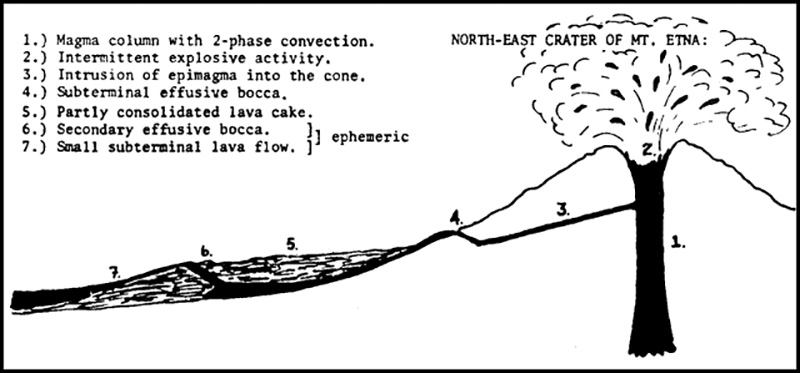 | Figure 1. Sketch showing the Northeast Crater at Etna. 1) Magma column with 2-phase convection; 2) Intermittent explosive activity; 3) Intrusion of epimagma into the cone; 4) Subterminal effusive bocca; 5) Partly consolidated lava cake; 6) Secondary effusive bocca (ephemeric); 7) Small subterminal lava flow (ephemeric). Courtesy of S. Rittman. |
It seems that some tourists observed the opening of a new "bocca" on the lower slopes of the NE Crater and believed that they were seeing the beginning of a new eruption, not knowing that during the normal persistent activity such ephemeral secondary boccas form very often – if the magma column stand high in the vent – and die out in a few days. In this case the degassing takes place at the surface of the magma column where trains of rising bubbles explode at intervals, throwing spatters out of the crater. The degassed epimagma descends along the wall of the vent while the foaming pyromagma rises in its central part. During the 2-phase-convection, the hydrostatic pressure may cause an intrusion of the epimagma between the strata of the more or less welded spatter and cinder cone of the NE Crater. At a certain distance form the vent, the increasing hydrostatic pressure in the downwards tended intruding epimagma becomes higher than the load and the resistence of the overlaying strata which are then uplifted giving way to the epimagma to the surface. A bocca forms without any explosive activity and the lava flows out quietly. Such a subterminal effusion is a common feature of the persistent activity of Mt. Etna. These small lava flows cool down rapidly and are covered by a slightly socriasceous glassy crust, under which the liquid lava continues to flow in a tunnel.
Fluctuations in the supply of epimagma, due to oscillations of the magma level in the vent, cause the formation of new lava channels and the ceasing of the former ones. In time, a great lava cake will form, covered by a consolidated crust. Here and there through this crust new secondary boccas are formed, from which ephemeral small lava flows are poured out. Such an activity may last for months and even for years without any paroxismal climax, i.e., without a true eruption, characterized by its violent character and by a following period of exhaustion with almost only fumarolic activity.
The only particular aspect of the actual activity of Mt. Etna is the existence of a large blow hole at the western part of the central crater from which, at short intervals, roaring gases escape violently. My friend and collaborator, Tazieff, with a team of specialists are studying this event carefully using new equipment which permits measurement of temperature, pressure and the speed and composition of the gases. All the qualities very widely within very short time intervals. The maximum temperature measured was 1070°C. During the night, large flames of burning gases are seen. Tazieff and his team will come to Catania within a few days to continue their research."
Information Contacts: S. Rittman, Institut Internazionale Ricerche Vulcanologiche, Italy.
April 1971 (CSLP 33-71)
New craters, cones, and lava flows; lava surrounds observatory
Card 1167 (06 April 1971) Lava flows from fissure approach observatory
"A fissure opened a little above and halfway between the Volcano Observatory and the water condensation fumaroles. Lava flows, comparatively wide and swift, have almost reached the Observatory. Two points of emission and strong degassing craters on these fissures are delivering huge quantities of scoria and cinders with thunderous noise. The altitude of the activity is approximately 3,000 m. A party of six volcanologists will be there for field investigations on 7 April."
Card 1169 (08 April 1971) Activity from two radial fractures; three new cones built
Mount Etna thundered in new activity on 8 April 1971. Half a million persons watched to see whether it would threaten them. "For now it is not possible to determine whether the phenomenon will pose a threat to the countryside and the cities", said Swiss volcanologist A. Rittman, chief of the Volcanological Institute Center. The University of Catania Volcanological Institute said each of two radial fractures of the volcano's surface opened since 6 April near the 9,700-foot [(2,950-m)] level had 10 or 12 explosive centers hurling burning rock, ash, and steam into the air, and pushing molten lava down the mountainside. A report on 7 April said the more westerly of the two centers of activity already had thrown up three volcanic cones which were about 65 feet high. "It is the center of a violent uninterrupted explosive activity throwing hunks of lava and incandescent rock mor that 650 feet into the air accompanied by thunderous explosive noises." Lava flow from that eruption has surrounded three sides of the Volcanological Observatory, perched a half mile from Etna's main crater at 9,679 feet. The Etna cableway was halted because lava surrounded several of its supporting pillars. Etna's upper slopes are bare or snow-covered, but the rich soil of the lower elevations yields bountiful fruit and vegetable crops and has one of the highest population densities. The triangle between Catania, Nicolosi, and Acierale on Etna's southern flank supports more than 3,200 persons per square mile.
Card 1170 (12 April 1971) Very active lava flows almost surround observatory
Two apparently radial fractures ~200 m apart; the W one 100 m long from 3,000 m elevation, the E one 100 m long from ~3,100 m elevation (figure 2). Presently two lava flows issuing from E fissure proceed ~3 km down W slope of Valle del Bove. One lava flow is presently flowing out lower end W fissure. It is fed by a small fountaining breached spattercone; its speed ~2 m/s, width 10-12 m, thickness up to our knees. One offshoot of western flow is leaning against north, east, and western walls of University of Catania Observatory. Other lava offshoots seriously threaten cableway. Length evening 8 April about 2 km with lava thickness 2-10 m, heights reached by observable molten lumps up to 300 m, speeds up to 200 m/s. Central crater big chasm and usually actively erupting; bocca nordest presently quiet and filled by whitish sulphur oxide smelling fumes.
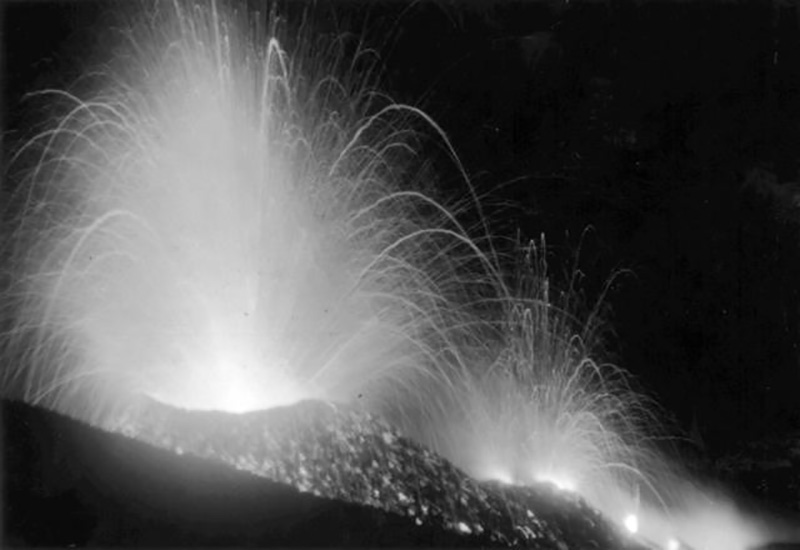 | Figure 2. Photograph of the eastern fracture and lava fountains at Etna, 7 April 1971. Courtesy of Haroun Tazieff. [Originally published in the CSLP 1971 Annual Report]. |
Card 1171 (12 April 1971) About 150,000 m2 were covered by noon on 6 April
Maximum temperature estimated ~1,030°C. volume emitted lava about 10-20 m3/s. Area covered at noon 6 April about 150,000 m2. Prevailing winds were ~100 km/hour in strength from northwest direction carrying volcanic gases plus steam from snow and condensed atmospheric water plus ash from both volcanic and phreatic explosions. 10 April: Activity continues, heavy fog prevents observations.
Card 1173-1174 (19 April 1971) Lava covers 1 km2 by 17 April; observatory and cableway damaged
"This is a report of the eruption between 15 April and 17 April. The two radial fractures are covered by lava flows. On the place of the E fracture, there is a single volcanic cone now 70 m high. There were violent explosions about every 20 minutes. At the foot of the active center there is a small cone delivering hot steam. Some ten meters below there is a vent with a lava flow which was going toward the Valle del Bove with a speed of 1 m/hour. This lava flow stopped Friday morning 16 April. The water condensation fumarole is preserved by the lava. The activity has momentarily stopped on the eastern sector fracture zone.
"On the place of the W fracture there are now two big cones, 40 m high on a N-S direction throwing incandescent rocks more than 200 m high. The southern one has on it flank a vent emitting 1 m3 of lava per second. This lava flow, after having entirely destroyed the observatory, has surrounded four pylons of the cableway, and the cable was broken by the lava Thursday morning, 15 April. The lava flow is still following its way at about 1 meter per hours. It is a typical block lava. Between Thursday evening, 15th and Saturday morning, 17th, the lava has moved about 50 m towards the intermediate station of the cableway which is now about 150 m from the lava. The northern cone stopped activity Thursday morning. According to the local guides it was during the night between 15 and 17 April that the explosive activity was the biggest since the beginning of the eruption. The observatory is surrounded on its four sides by four-meters-high lava products. The lava is threatening the north wall of the observatory and penetrated inside the observatory. The area covered by lava Saturday noon is about 1 square kilometer, and the damage is estimated to be about 1 million dollars."
Card 1183 (30 April 1971) Three new craters formed; lava flows advancing on the S flanks
"Etna activity which commenced 5 April continues. Three craters have formed S of the central crater. Two are currently active with frequency of 25-30 explosions per minute per crater, with ejecta being hurled up to 300 m. Lava flows were advancing to the SE (Valle del Bove - 3 km) and continue to advance to the S (cable car lines - 4 km), and SW (Frumento - 2 km).
"The first chemical analysis of lava indicates a phonolitic tephrite. Gas from active craters shows an excess of CO2 over SO2; gas from lava flows shows an excess of SO2 over CO2. N-S fractures have been observed on the E side of Monte Frumento and between Central Crater and Northeast Crater. Central Crater continues to smoke, mostly white, occasionally brownish-black. Northeast Crater shows no activity. Presently no danger exists for populated area."
Card 1184 (30 April 1971) Observatory surrounded, but not destroyed, by lava flows as of 25 April
The following corrects statements made on cards 1173 and 1174: "The observatory was not 'entirely destroyed' nor lava penetrated neither on April nor ... 25 April, when we last reached it (but to reach it, one has to cross the thick and still hot lava flows which do completely surround the building); the outpour of lava is an average of 25,000 m³ per hour presently emitted, at speeds varying from 0.5 to 4 m/s.; it is not a 'typical block-lava' but a quite typical aa flow with accessory pahoehoe streams."
Card 1185-1186 (30 April 1971) Two new explosive vents on the E fissure; cone growth continues
"The [E] fissure, which was the most active from the start, stopped all explosive and apparently effusive activity (although there are still some small and slow lava flows progressing on the big one which has flowed into the Valle del Bove. On the other hand, the [W] fissure extended upwards (northwards) for about 250 m with two new explosive vents starting on 19 April; they were still very active yesterday when we eventually reached them to collect gases (F. Le Guern). This fissure is now approximately 2.5 km long, extending en echelons from the very base of the central cone (alt. ca 3,050 m) down to the NW foot of Mt. Frumento Supino. Only its upper half km is active. The direction of this open fracture is N10-15°W. It is also the direction of the fault which worked last week (earthquake intensity 6-7 on the Mercalli scale) in the Giarre region, on the E foot of Mt. Etna. Exceptionally, some sort of relationship between an eruption and a tectonic earthquake could perhaps be considered as existing here.
"Presently, explosive degassing is continuously going on at the three lower and two upper main vents left open in the fissure. The lava lumps do not reach higher than about 200 m above crater rims. The cones are steadily growing up. The effusive activity decreased during the third week of the eruption and is more awkwardly estimated, the major part of the lava being now emitted through tunnels within the body of the main flow. This allows the lava keeping its heat content almost intact until its exit point, this meaning it being able to flow further down than the preceding ones in spite of decreased output and temperatures, as compared with the bigger flows of the first week of the eruption.
"R. Romano, assistant to A. Rittmann's I.I.V. magmatological laboratory, Catania, is carrying on daily analyses of emitted lavas. S. Cuccuzza-Silvestri, from the University of Catania, together with C. Sturiale and Riuscetti, also do watch the developments of the eruption. The two physicists of our eruptive gas-investigating group, P. Zettwoog and C. Vavasseur, will join F. Le Guern on 3 May. The violent degassing with related lava bombing, together with the strenuous access over fresh lava-flows, make it somewhat difficult to carry on P, T, and V measurements of the erupting gases as well as chemical analyses. The probes and protecting suits developed so far are suitable for the comparatively mild permanent eruptive activity of Mt. Etna (or Stromboli as well), but do not suffice for more violent eruptions."
[Corrections of fissure locations by H. Tazieff, Card 1229].
Information Contacts:
Card 1167 (06 April 1971) Haroun Tazieff, Paris, France; Sr. Antonio Nicoloso.
Card 1169 (08 April 1971) A. Rittman, Instituto Internationale di Volcanologia, Catania, Italy; David Haskell, UPI.
Card 1170 (12 April 1971) A. Rittman and H. Tazieff, Instituto Internationale di Volcanologia, Catania, Italy.
Card 1171 (12 April 1971) H. Tazieff and R. Romano, Instituto Internationale di Volcanologia, Catania, Italy.
Card 1173-1174 (19 April 1971) M. Krafft, Centre Vulcain, Mulhouse, France; Roland Haas.
Card 1183 (30 April 1971) T. Casadevall, F. LeGuern, and R. Romano, Instituto Internazionale di Vulcanologia, Catania, Italy; CNRS, France.
Card 1184 (30 April 1971) H. Tazieff, Instituto Internazionale di Vulcanologia, Catania, Italy.
Card 1185-1186 (30 April 1971) H. Tazieff, Instituo Internazionale di Vulcanologia, Catania, Italy.
May 1971 (CSLP 33-71)
Additional vents and fissures open; very active lava flows
Card 1195 (06 May 1971) Activity continuing in early May at high levels
"The activity of Etna has shown some increase during the past few days. A new fracture opened ... 4 May at the eastern base of the terminal cone between about 2,870 and 2,840 m above sea level and about 1 km from the crater's rim. Scoria cones were formed. An effusive bocca produced lava flowing with a velocity of about 20 m an hour at 1500 (local time) the 5th of May, along the W slopes off Valle del Bove. Explosive activity at the main focus of the eruption continues with somewhat reduced intensity, but the lava flows continue to be well supplied, the fresh material spewed through units on top of the old lava or sometimes running alongside. The lava is advancing in three main branches. The first south to southwest joined by the second moving south toward the central part of Piano del Lago about 2,880 m above sea level, while the third moving SSE flanks the main flow reaching down to 2,270 m above sea level by 1600 hours, travelling with an average velocity of 150 m an hour. Small lava flows running S or SSW continue to be emitted from the bocca above the principal eruptive focus at the higher level of 3,020 to 3,040 m above sea level."
Card 1198 (10 May 1971) Eruption stops at some locations, but opens new vents and emits more lava flows
"Early on the morning of 7 May activity suddenly ceased at the two eruptive centers above the former observatory, and at the four small bocche situated on a fissure to the E which had opened on 4 May. Towards the evening of 7 May, two new bocche opened to the NNE of the center of 4 May, one at a height of 2,700 m above sea level and the other a little to the N, and ca. 2,580 m. A little later, a third fissure with four orifices opened at ca. 2,540 m. All are emitting lava flows directed toward the Valle del Bove. In contrast to the earlier centers, the rather less explosive activity leads to the formation of hornitos rather than cinder cones."
Card 1200-1201 (13 May 1971) Details of lava-flow activity during early May
"Present volumetric output of lava was estimated this past week as follows: 5 May, ~140,000 m3/hour; 6 May, ~90,000 m3/hour; 9 and 10 May,3/hour. A new fracture system did open on 4 May about 2200 on the E foot of the central main cone of Mt. Etna along a trend perpendicular to the initial N-S one at an altitude of 2,890 m above sea level. High pressure gases without lava fountaining fumed at the upper part of the main new fracture. Intense fountaining, a big spatter cone approximately 30 m high about 100 m downslope, and a lava flow averaging 10 m in width and [a speed of about 9 km/hour] around was discovered on the down slope end of the fountaining crater. These eruptive fissures, perpendicularly opened during one [same] eruption and exactly one month apart, constitute a rather exceptional phenomenon. It is in fact really quite interesting. On 6 May former activity . . . located on the N-S fissure completely stopped and the big chasm in the central crater started emitting big ash-laden puffs. On 7, 8, and 9 May the new easterly trending fissure extended downward towards Pizzi Deneri across the Valle del Leone which is the upper part of the Valle del Bove.
"[Henceforward, explosive activity is concentrated in the new collapse-chasm formed in the E foot of Mt. etna's central cone, at the upper end of the fracture zone. Effusive activity] of 4-6 May stopped at the upper part of this fissure as similar although much lighter activity resumed at altitudes several hundreds of meters lower down.
"We were able to simultaneously make recorded measurements of speed by way of special speedometers, temperature by way of a thermocouple gage, and pressure by way of a special Pitot tube, and make a large series of gas samplings for chemical analyses which are being (analyzed) now. The temperatures were usually about 1,000°C and the speed (it is not yet exactly calculated) was about 400 km an hour. These gas samplings and measurements were made on maybe the best possible place just at the head of the erupting fissure where the degassing of the magma is optimum."
[Corrections of fissure locations by H. Tazieff, Card 1229].
Card 1202 (13 May 1971) Two additional eruptive vents open on 11-12 May
"Two new eruptive vents opened at an altitude of only 1,800 m above sea level S from [Rifugio] Cetelli. The first vent opened ... 11 May at 1137 exactly, and the second vent opened at 0400 [on] 12 May. These two vents have very slight explosive activity and the molten lava lumps are hurled only about 20 m high. The lava flows had already entirely crossed the forest zone and had reached the cultivated areas after having [crossed the road leading to Rifugio] Citelli. So, it's only an effusive . . . type of activity. All other activity stopped several days ago on the volcano, [but for the strong explosive degassing, without any fresh lava but with old ash- and rock-laden puffs at the new chasm, at an altitude of circa 3,000 m on the E foot of Etna's central cone.]
"The fissures system on the upper part of the volcano is always moving, and the fissures are extending, widening, and steam and hot gasses escape from an altitude of 2,670 m up to the very top of Etna at 3,300 m."
[Corrections of fissure locations by H. Tazieff, Card 1229].
Card 1208 (17 May 1971) Lava flow from 11-12 May centers cuts highway
"During the night 11-12 May two new effusive centers opened on a fissure directed NW-SE on the E slope of Mt. Etna at about 1,800 m elevation outside of Valle del Bove. The lower bocca is emitting a big lava flow which in 30 hours reached 1,100 m elevation cutting the highway Fornazza-Cabancitelli (Mare Niri). The effusive centers of 7 May on the inner slope of Valle del Bove are still very active. Up to now, no danger for inhabited places."
Card 1211 (18 May 1971) New fissure on the S flank emits lapilli and fumes
The following report was telephoned to the Center by H. Tazieff. "The fissure system with a trend N63°E is extending on about all the upper part of the E flank of Mt. Etna and at an altitude of 1,800 m above sea level it presently delivers two lava flows: the first one is approximately . . . . . . speed about 4 km/hour and an estimated output of 10,000 m3/hour; the second flow is approximately 8 m wide with a speed of 15 km/hour and an output of 10,000-15,000 m3/hour. Both flows coalesce lower down and proceed with decreasing speed down to 20-40 m/hour . . . . . the town of Formazzo which is still 5 km away from the lava front. Trees are burning and the menace becomes really important now.
"On the other hand, a new fissure opened today at an altitude of 3,000 m above sea level on the S flank just N from the new mountain hut called 'Il Torre del Filosofora' and this fissure starts throwing lapilli and fumes up into the air."
Card 1213 (19 May 1971) Farm houses destroyed by lava flow; strong explosions on 18 May
The following was telephoned to the Center by A. Rittman. "Emission of lava from the bocche near Cabancitelli is continuing and supplying copiously the great lava flow which advances slowly on a front about 700 m large towards the road Fornazzo-Lingualossa. Some farm houses and a vast area of cultivated land have been destroyed. In the early morning of 18 May strong explosions started to open a new sub-terminal crater which at 1000 was already more than 150 m wide and violently emitting dark clouds charged with ashes and white vapor. The new crater is situated at the place where on 4 May a small eruption center had opened on the E slope of Mt. Etna at about 2,900 m altitude. The activity of the bocche in the Valle del Bove continues much reduced; the Central Crater and the Northeast Crater quietly emit white vapor."
Card 1215 (21 May 1971) Summary of activity during 4-12 May
"A flank eruption has occurred on the E slope of Mount Etna, after 30 days of strong effusive and explosive activity located on the upper S zone of the volcano. The eruption started in the evening of 4 May by the opening of a new fissure at the E foot of the Central Crater about 2,900 m above sea level. The discharge of highly fluid lava increased during the night, and the strong and almost continuous degassing throwing lava lumps and incandescent scoriae 250 m began to build an elongated, sharp-shaped cone 30-35 m high. This cone was open toward the E, where a big lava flow was flowing with an initial speed of 10-15 km/hour. in a few hours the new lava reached a zone S of Monti Centenari in Valle del Bove near the 2,000-m level.
"This new activity apparently does not affect the S vents (figure 3), which remained active until 6 May. on this day, however, the explosive and effusive activity was somewhat decreasing. At midnight, the activity of the E vent began to decrease considerably and completely ceased on the 7th of May at 0200. In the morning of 7 May all was quiet on the volcano, excepting small cooling lava flows toward the S and some increased emission of gas from the Central Crater accompanied by rumblings and occasionally throwing brown cinder clouds.
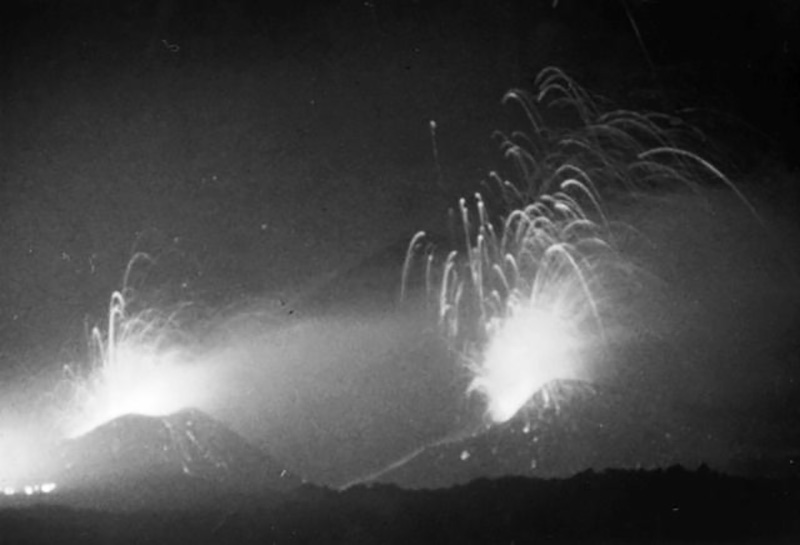 | Figure 3. Explosive craters at the south vents of Etna (elevations 3,000 and 3,100 m), at 1900 on 4 May 1971. Courtesy of J.C. Tanguy. [Not previously published.] |
"By the 8th of May at 0100 we were able to observe a large red glow toward the E on the Valle del Bove, where a flank eruption was starting on the slope between Valle del Leone and Vale del Bove (level 2,700 to 2,400), near the 1950 eruption vents. Six or seven lava flows were vigorously active, but explosive activity was almost negligible. In the 9 May morning at 1100, our team reached the vents. There was a continuous cracking of ground between the now inactive upper E vent and the location of the flank eruption. This flank eruption had broken by two en echelon fissures, the upper being between 2,680 and 2,650 m, and the lower near 2,500 m. Several lava flows were moving at an initial speed of 1-2 m/s, while continuous degassing (but without violent explosions) was building small eruptive conelets (hornitos).
"In the morning of 12 May, the magma erupted at a more lower point by the aperture of a new vent near Rifugio Citelli, around 2,000 m level, and the lavas from this new outbreak could be dangerous for the inhabitants of the Etnean E zone. This flank eruption is of the 1928 eruption type, and is even located approximately on the same fracture line as the 1928 eruption was. The maximum lava temperature recorded by both thermocouple and optical pyrometers is between 1,100 and 1,130°C. The viscosity, as estimated by Jeffreys' formula, appears very low, from 1,000 to 10,000 poises only."
Information Contacts:
Card 1195 (06 May 1971) A. Rittmann and R. Romano, Instituto Internazionale di Vulcanologia, Catania, Italy.
Card 1198 (10 May 1971) A. Rittmann, R. Romano, and F. LeGuern, Instituto Internazionale di Vulcanologia, Catania, Italy.
Card 1200-1201 (13 May 1971) F. LeGuern, P. Zettwoog, C. Vavasseur, and H. Tazieff, Paris, France.
Card 1202 (13 May 1971) F. LeGuern, French Atomic Energy Commission; T. Huntington, Reading University, England; H. Tazieff, Paris, France.
Card 1208 (17 May 1971) R. Romano, C. Sturiale, and A. Rittmann, Instituto Internazionale di Vulcanologia, Catania, Italy.
Card 1211 (18 May 1971) F. Le Guern and H. Tazieff, Paris, France.
Card 1213 (19 May 1971) R. Romano, E. Lo Giudice, and A. Rittman, IIV, Catania, Italy.
Card 1215 (21 May 1971) C. Archambault, F. Gauthier, A. Nicoloso, and O. Nicoloso, Instituto Internazionale di Vulcanologia, Catania, Italy; J.C. Tanguy, Laboratoire de Geomagnetisme du Parc Saint-Maur 94, Saint-Maur-des-Fosses, France.
June 1971 (CSLP 33-71)
Crater enlargements; corrections to previous reports
Card 1229 (03 June 1971) Crater enlargements; corrections to previous reports
"Important developments are the engulfments which recently did enlarge both the central crater's big chasm (la Voragine) and the new eastern chasm, as well as the extent, in length, width, and throw, of the fracture zone which is responsible for the second phase of the present eruption."
[H. Tazieff also submitted a number of corrections to his previous reports and comments about other reported aspects of the eruption. The corrections have been made to cards 1185, 1200, 1201, and 1202, above. Additional comments regarding card 1195 are included below. Comments disputing the interpretation and information presented by A. Rittman in a 3 May 1971 report not published by SI, included on the original card, are not reproduced here.]
Regarding Card 1195 (06 May 1971): "The velocity of the lava flow escaping through the newly opened N63°E fracture was approximately 9 km/hour (see Card 1200) and the mentioned speed of 20 km/hour can only be that of some flow-front."
Information Contacts: H. Tazieff, Paris, France.
September 1971 (CSLP 33-71)
Activity starts again after 100 days of quiescence
Card 1294 (23 September 1971) Activity starts again after 100 days of quiescence
"[After] 100 days [of} complete quiescence, Mt. Etna volcanic activity started again. Lava column raised up to 200 m from Main Crater's rim. Two explosive boccas are located at the bottom of the crater."
Information Contacts: A. Rittman, Istituto Internazionale di Vulcanologia, Catania, Sicily, Italy.
December 1971 (CSLP 33-71)
Periodic explosions from La Voragine crater
Card 1332 (21 December 1971) Periodic explosions from La Voragine crater
"After a few months of complete quiescence -- last activity occurred around the end of September -- Mt. etna activity started again. Two explosive boccas are located at the bottom of the main summit crater named La Voragine. They emit periodically volcanic sands and ashes mixed with fragments of molten lava that reach about 400 m elevation falling into a surrounding area of about 300 m radius."
Information Contacts: R. Romano and L. Villari, Istituto Internazionale di Vulcanologia, Catania, Sicily, Italy.
February 1974 (CSLP 20-74)
W-flank eruption rapidly builds cone; explosions and lava flows
Card 1791 (06 February 1974) First W-flank eruption of this century rapidly builds cone
"The eruption started [on 30 January] at an altitude of 1,800 m on the W flank of Mt. Etna. A new fissure was observed. The activity is essentially explosive. Only very short and thick tongues of lava seep slowly (less than 0.1-2 m/hour) to the E foot of a new rapidly built-up cinder cone about 50 m across the base and 100 m high. After initial, almost continuous lava fountaining which lasted throughout the first day, explosions occurred at the rate of 30-50 per minute. Lumps of a few kilograms were hurled 300-500 m high. Blocks weighing several tons have been observed reaching about 100 m above the crater rim. The lava temperature is estimated to be over 1,100°C in the crater and under 1,000°C in the lava flows. The viscosity is exceptionally high and probably due to a high degree of crystallization. The excepotionally high proportion of pyroxene accounts for the impoverishment of the lava in several magnesium elements and its relative enrichment in alumina and silica.
"Geophysical teams from the IIV in Catania, from the Observatorio Vesuviano, and from the Polytechnical School, Milano, started measurements on 4 February. It is totally impossible to reach the crater due to dense and continuous bombardment. I am presently sampling the eruptive gas phase. No eruption has occurred on the W flank of Mt. Etna this century. Local people called the quickly built-up new cone 'Mt. Rapido.' The latest report states that the 'explosions are stronger but still no lava flow.'"
Card 1795 (12 February 1974) Vigorous and frequent explosive activity from the new crater
The eruption that began on 30 January 1974 on the W slope of Mt. Etna was visited by J.C. Tanguy from 2 to 8 February.
According to Rittmann's classification, this should be an eccentric eruption with little or no relation to the main vent. It is mostly characterized by a highly explosive crater situated at an elevation of 1,680 m, which quickly built a cone over 100 m high. During the first days of activity, a restricted lava flow very slowly traveled about half a kilometer westward.
On 3 February, a very small lava tongue seemed to progress towards the SE, but next morning all effusive activity had stopped. The explosive crater, however, was vigorously active with continuous ejections (40-50 per minute) of big lava lumps and scoriae 400-600 m high. From time to time, the vent was blocked for a few seconds and the successive outbreak was accompanied by a strong air-shock percussion. Impressive also were the numerous earth tremors, especially E of the crater where the cone is partly open. Optical temperature at the vent is about 1,020-1,030°C, but measurements are probably too low as the top of the magma column cannot be observed. Another typical feature of this kind of eruption is the intense seismic activity the preceded the opening of the vent. Numerous earth tremors were felt from 14 January even at Rifugio Sapienza, 1,900 m high on the S flank of the volcano.
On 7 February the eruption was still continuing with some fluctuations. Explosions were 15-30 per minute, somwhat irregular in power and frequency. A new small but thick lava flow issued the day before from the N foot of the cone and is progressing as slowly as the former towards the NW. Earth tremors are persistent E of the crater.
Card 1807 (25 February 1974) Eruption ended on 17 February
"The eccentric eruption on the W slope of Mt. Etna ended on the 17th of February. On 8 February, the explosive activity began to decrease, although exceptionally strong recrudescences occurred from time to time. The outpouring of lava, however, was more important than at the beginning of the eruption. Nevertheless, it was still restricted in area and characterized by the sluggishness of the effusions. A flow starting on 9 February slowly reached a maximum length of about 2 km over the next few days. On the morning of 16 February, the explosions stopped at the vent and all outflow of lava ceased on 17 February.
"A run of lava temperature measurements was made using two chromel alumel thermocouples and a Schneider digital voltmeter. Although the eruption was coming to an end, temperatures as high as 1,075-1,085°C were recorded in both thermocouples. The optical surface temperature was 1,015-1,020°C. It can be compared to the measurements made at the explosive vent during the first phase of strong activity.
"The viscosity was high, but not measured (105 poises?), However, this high value can be partially understood with respect to superficial cooling connected with the slow rate of lava discharge."
Information Contacts:
Card 1791 (06 February 1974) H. Tazieff, Chairman, Science Council, IIV, Catania, Italy.
Card 1795 (12 February 1974) J.C. Tanguy, Laboratoire de Geomagnetisme du Parc Saint-Maur, France.
Card 1807 (25 February 1974) J.C. Tanguy, Laboratoire de Geomagnetisme du Parc Saint-Maur, France; Guy Kieffer, Institute de Geographie, Clermont-Ferrand, France.
March 1974 (CSLP 20-74)
New vent SW of the 1974 cinder cone opens on 10-11 March
Card 1814 (14 March 1974) New vent SW of the 1974 cinder cone opens on 10-11 March
"After 22 days of quiescence, eruptive activities started again on the W flank of Mt. Etna during the night of 10-11 March 1974. A new volcanic vent opened about 200 m SW from the cinder cone built up during the period of the earlier 1974 activity. The area is located about 8 km W of the summit crater. The vent is characterized by highly explosive activity which brought about the formation, during the first two days, of an 18-19-m-high cinder cone. A viscous lava tongue is flowing out [of] the vent very slowly, proceeding westward. The length of the lava flow was about 700 m after 14 hours from the opening of the vent. From an approximate examination of the erupted material the rate of emission during the first 14 hours approached 10-12 m3/s."
Information Contacts: CNR, Instituto Internazionale di Vulcanologia (IIV), Catania, Italy.
October 1974 (CSLP 20-74)
Lava lake drains and lava flows about 1 km
Card 1954 (10 October 1974) Lava lake drains and lava flows about 1 km
"The NE side of the terminal crater that stopped its activity at the beginning of the April 1971 eruption was opened again during the night of 28-29 September 1974 with strong explosive activity. During the night of 9-10 October 1974, following the collapse of the ring on the SW side, the lava lake that had formed in the base began to flow out. After 20 m, the flow changed its direction to the NNW for about 1 km. At the present time the activity is of irregular explosions and a slow flow of lava going for about 2,000 m."
Information Contacts: E. Lo Giudice and D. Condarelli, IIV.
February 1975 (CSLP 10-75)
Eruption on NW flank produces spatter cones and lava flows
Card 2092 (26 February 1975) Eruption on NW flank produces spatter cones and lava flows
An eruption began on the NW flank of Mt. Etna during the night of 23-24 February 1975, 24 hours after normal summit activity stopped. The eruption continues at the present time. Several spatter cones with fountaining activity have formed along the fissure which opened at an altitude of 2,500 m above sea level on the NW slope of Mt. Etna. A lava flow fed by the lowest vent has already reached a length of about 1 km. The front of this lava flow is presently about 10 km from the village of Maletto, to which it seems to be directed at the moment. The NE crater has stopped its activity, while the central crater is erupting dense clouds of ashes and sand.
Information Contacts: D. Condarelli, IIV.
March 1975 (CSLP 10-75)
New eruptive center on the North Rift zone
Card 2124 (19 March 1975) New eruptive center on the North Rift zone
On 24 February 1975, the persistent activity of the NE summit crater (altitude about 3,300 m) shifted towards the North Rift zone of Mt. Etna. Thus, a moderate outpouring of lava occurred at the 2,600-m level, accompanied by weak explosive activity that formed small so-called "hornitos." This new eruptive center was visited again on 13 March. The upper, sharp-shaped hornito (altitude 2,590 m) was continuously emitting white vapors and tiny pieces of scoriae only a few meters above the magma level. The lower hornito was inactive, being partly buried by early lava flows. The liquid lava itself poured out slowly 100-150 m downward from beneath a consolidated crust, forming several short-lived flows that did not exceed a few hundred meters in length. Emanations of gas were occurring also from a fissure near the 2,550-m level on the right edge of the lava field.
A maximum temperature of 1,065°C was recorded on chromel-alumel thermocouples inserted to 60 cm into the lava of the uppermost source. This temperature was nearly the same as those (1,075°C) measured in the lavas of the NE crater before 1971.
At the summit craters system there was on this day a strong continuous emission of dense white vapors from the NE crater and heavy clouds of brown ashes from the "Voragine" (chasm) of the central crater.
Information Contacts: G. Kieffer, Department of Geology, University of Clermont-Ferrand, France; A. Nicoloso, Capo Guida dell'Etna, C.A.I., Catania, Italy; J.C. Tanguy, Laboratoire de Geomagnetisme du Parc Saint-Maur, University of Paris VI, France.
November 1975 (NSEB 01:02)  Cite this Report
Cite this Report
Continuous activity for most of 1975; new lava vent
Continually active throughout most of 1975, lava began flowing from a new opening on the NW side of the volcano on 29 November [originally reported as 21 November].
Further Reference. Pinkerton, H., and Sparks, R.S.J., 1976, Formation of the 1975 subterminal compound lava flow, Mount Etna: JVGR, v. 1, p. 167-182.
Information Contacts: G. Nappi, IIV.
May 1976 (NSEB 01:08)  Cite this Report
Cite this Report
Lava eruption stops in mid-May
In mid-May, Etna [temporarily] ceased erupting lava. For several days prior to 15 May, the volcano's two lateral craters were inactive, and only a thin column of vapor rose from the central crater. A team of scientists, led by Haroun Tazieff, was on the scene conducting investigations.
Information Contacts: IIV, Catania.
June 1976 (NSEB 01:09)  Cite this Report
Cite this Report
Explosions from Bocca Nuova and The Chasm; lava flows on N-flank
Observations were made by the University College group and R. Romano of the IIV, 16 May-4 June 1976. Until this time weather conditions had been very bad on the volcano and reports of activity were sporadic. In the summit region, Bocca Nuova was fuming strongly and had a depth estimated to be in excess of 200 m. This pit was exploding throughout the period of observation, at rates varying from one explosion per 3 minutes up to 2 or 3 explosions/minute. Incandescent material was occasionally thrown above the level of the crater rim and vesicular scoria and Pele's hair fell close to the crater down-wind. The Chasm was also fuming strongly, and although its bottom was not seen, it had a depth of several hundred meters. During the afternoon of 25 May the Chasm started deep violent explosions at a rate of 20-25/minute. No bombs were seen from these explosions, and the activity died down over the next few days. The new pit on the W side of Northeast Crater was fuming quietly but not exploding. The area around this new pit contained large amounts of sublimates and its total depth was around 50 m. The Northeast Crater itself is now inactive, the vent being plugged by scree; but there is still heavy fumarolic activity high on the W inside wall.
The effusive activity during the period was occurring from new vents on the N side of the mountain (near Punta Lucia). A 40-m-high cone formed at about the 2,900 m level. Inside this cone was a conelet from which mild strombolian explosions of fresh gassy lavas were occurring on 26 May, though it was quiet on 31 May. Lava emissions were taking place farther downslope in the new lava field, from a number of boccas with positions that changed from day to day in an area above the 2,500 m contour. The rate of emission from one bocca was measured to be 0.4 m3/sec. and the total emission for the whole field was 2 m3/s.
Information Contacts: J. Guest, J. Murray, S. Scott, and W. O'Donnell, Univ. of London; R. Romano, IIV.
July 1977 (NSEB 02:07)  Cite this Report
Cite this Report
Lava effusion and explosive activity from a new vent
Lava effusion and explosive activity, from a new vent at 3,200 m elevation just N of the Northeast Crater, began during the early morning of 16 July. A small lava lake, first observed at 0400, occupied the new vent, which was the source of two lava flows. The larger moved E into the Valle del Leone, and the smaller to the N. By 18 July, the flows had reached 2 km and 800 m length respectively. Strombolian activity began at 0515 on 16 July and rapidly increased in frequency and power. Ejecta reached 600 m in height and fell over an area ~1 km in diameter. The explosions had ended by 20 July and lava extrusion ended on 23 or 24 July.
Precision leveling two weeks before the eruption by John Guest and co-workers showed a 1-cm inflation of the S flank since September 1976, but strong deflation under aa fields on the N flank.
Information Contacts: J. Guest, Univ. of London; R. Romano, and G. Frazzetta, IIV.
August 1977 (NSEB 02:08)  Cite this Report
Cite this Report
Two eruptions in August generate fountaining and lava flows
"After a period of quiescence since the beginning of this year, Etna erupted again on 16 July. New explosive and effusive boccas opened on the lower flank of the Northeast Crater cone at an altitude of 3,200-3,270 m. The first signs of eruption occurred in early July when a small pit opened on the N edge of the Northeast Crater Cone. Initially this pit emitted high-temperature gas which during the night was seen to be incandescent.
"The first sign of lava emission was seen by a guide at 0400 on 16 July when he observed a small 'lake' of lava in the bottom of the pit. An hour later weak explosive activity started and increased to become stable at about 15 explosions/minute by 1000. Incandescent material was thrown 300 m above the vent, with a maximum height of 500 m. The maximum range of the bombs was 400-500 m. During this early period of explosive activity, a fracture opened at about 3,240 m on the lower slopes of the cone and flows were emitted from the end of the fracture (at 3,220 m), first towards the NE and later to the E. At the same time ephemeral boccas (3,200 m) opened below the main fracture and fed a small flow in a northerly direction. Explosive activity reached its peak during the night of 17 July. During the early hours of 18 July collapse occurred in the Northeast Crater itself, causing great clouds of dust and ash. The explosive activity at the new vent then diminished both in frequency and intensity, becoming extreme1y variable.
"On 18 July the flows had reached a length of 800 m to the N and 2 km to the E. From then onwards the explosive activity continued to diminish, as did the effusion of lava to the N flow. The E flow reached the edge of Valle del Leone and continued as the principal flow, reaching a total length of 4 km by the end of the eruption. The N flow stopped with a total length of 1 km. Explosive activity ended at 1000 on 22 July and the lava flows stopped in the late afternoon.
"The area covered by lava was 0.16 km2, the volume of lava was 4.8 x 105 m3 and volume of pyroclastic material 500 m3. Microseismic activity was noted before and during the eruption.
"The Northeast Crater started erupting again on 5 August at 1430. The activity began with strong explosions from the July vent, with lava fountains being thrown to 400 m in the early stages. One lava flow formed, advancing N from a fracture on the N slope of the Northeast Crater Cone. The fracture was oriented approximately NNE. The lava was fluid and traveled about 3 km. Seismic activity was observed just before and during the eruption, which ended at 0630 on 6 August."
UPI reported that a third eruption began early 14 August and lasted only 14 hours. Fountains or strombolian ejecta rose 200 m above the vent, and two lava flows, each about 200 m wide, moved about 4 km down the volcano.
Information Contacts: R. Romano, G. Frazzetta, and D. Condarelli, IIV; J. Guest, Univ. of London; UPI.
November 1977 (NSEB 02:11)  Cite this Report
Cite this Report
Eruption from the NE crater, the fourth since mid-July
Etna's fourth eruption since mid-July began during the night of 2 November from the Northeast Crater Cone, site of the three previous events. Two lava flows were extruded, but (in contrast to the earlier events) explosive activity was very weak. The larger flow traveled 2.5 km NW from the vent and the smaller 1 km to the N, before the eruption ended about noon on 4 November.
Information Contacts: R. Romano, IIV; J. Guest, Univ. of London.
December 1977 (NSEB 02:12)  Cite this Report
Cite this Report
Frequent eruptions from Northeast Crater continued into January
Frequent eruptions from Etna's Northeast Crater continued through early January (table 1). Since the 2-4 November activity, progressively briefer 1-day eruptions occurred on 7, 22, and 25 November. On 6 December, extrusion of a single lava flow began at about 1100 from a NNE-trending fissure on the N side of the Northeast Crater. The flow traveled 4.5 km down the E flank before the eruption ended at 2200. On 24 December, tephra was thrown 1,000 m above the vent, and renewed activity 5 days later, accompanied by small earthquakes felt in nearby villages, projected tephra several hundred m above the vent. Lava extrusion resumed 2 January and the flow had advanced 1 km on a 150-m-wide front by evening. The eruption was continuing as of the morning of 4 January.
Table 1. Summary of Northeast Crater activity since November 1977. Courtesy of R. Romano.
| Month | Dates of Eruption |
| Nov 1977 | 2-4, 7-8, 22 (10 hrs), 25 (7-8 hrs), 27 (10 hrs) |
| Dec 1977 | 6 (8 hrs), 10-(?)13, 18, 24-25, 29 |
| Jan 1978 | 2-3, 4, 5, 7 |
| Mar 1978 | 25-26, 27-28 |
Information Contacts: R. Romano and L. Villari, IIV; J. Guest, Univ. of London; New York Times; UPI.
March 1978 (SEAN 03:03)  Cite this Report
Cite this Report
New lava flow and ash on 25 March
Etna erupted for the first time since January on 25 March [originally reported as 26 March], extruding a lava flow, destroying trees on the flank, and emitting ash, that was blown S towards Catania (25 km from the summit) by a strong wind.
Information Contacts: UPI.
April 1978 (SEAN 03:04)  Cite this Report
Cite this Report
First SE flank activity since 1971
An eruption began 29 April and continued as of 3 May. Lava was extruded from four new vents, on the SE flank, and had reached the 1700 m level near Monti Centenari, the 1852 cone by the morning of the 3rd. Explosive activity ejected bombs to 300 m above the largest of the vents (near the 1819 crater; figure 4) and built a 50-m cone. Explosions had declined by early 3 May, but vigorous lava effusion continued.
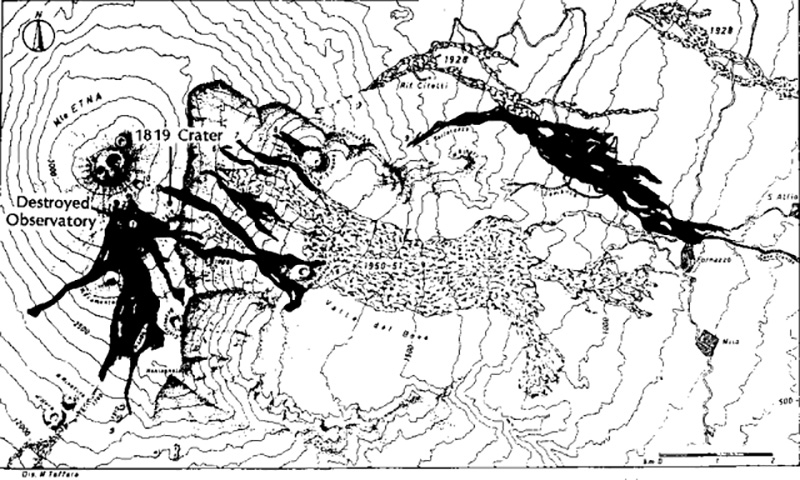 | Figure 4. Map of Mt. Etna, showing 1971 lava flows in black and earlier flows in other patterns. Contour interval, 100 m. From Rittman and others, 1971. |
Frequent brief eruptions from Etna have occurred since July 1977, but all have originated from vents on the Northeast Crater cone. The last SE flank eruption occurred 5 April-12 June, 1971, destroying the Etna Observatory.
Reference. Rittman, A., Romano, R., and Sturiale, C., 1971, L'Eruzione Etnea dell'Aprile-Giugno 1971: Atti della Accademia Gioenia di Scienze Naturali in Catania, Serie Sestima, v.3.
Information Contacts: J. Guest, Univ. of London; R. Romano, IIV.
May 1978 (SEAN 03:05)  Cite this Report
Cite this Report
SE-flank eruption continues through May
R. Romano reported the eruption started on 29 April at about 2000-2030 from bocca 1 (figure 5). Explosive activity built a cone that was 50 m high by 2 May. Lava flowed from the E side of the cone into the Valle del Bovee. Fissures opened, extending into the 1819 crater, where they intersected another fissure set which runs along the wall of the Valle del Bove.
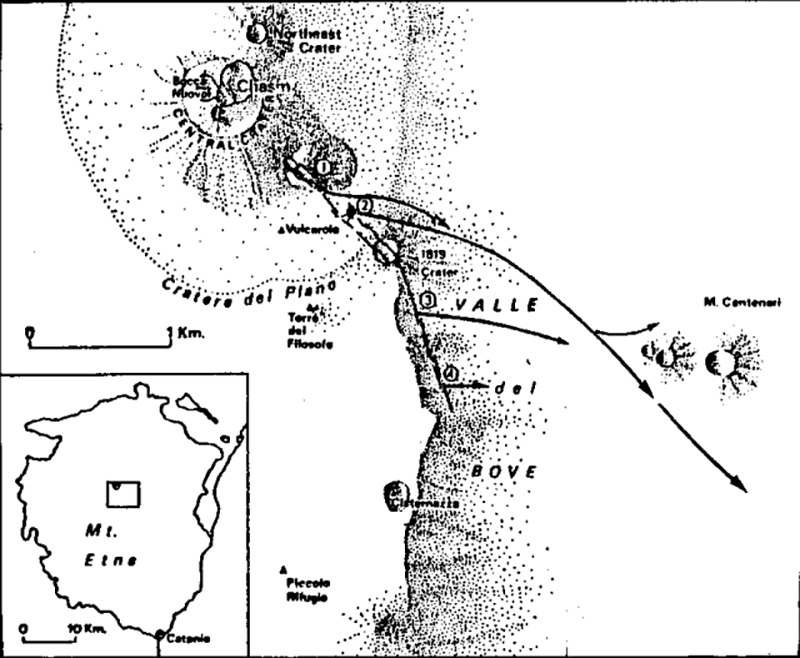 | Figure 5. Map showing locations of vents, fissure systems and lava flows of the April-May 1978 eruption. Bocca Nuova is W of the Chasm in the Central Crater; other boccas are identified by number. Prepared by J. Guest and J.B. Murray. |
"During the afternoon of 1 May new boccas 2 and 3 opened on the existing fissures, then early the next afternoon bocca 4 opened, emitting a small lava flow that stopped the same day. Activity at bocca 1 also ended on 2 May, but the main flow front advanced at 100 m/hour. Bocca 3's activity diminished 6 May and ended by 7 May."
John Guest and J.B. Murray arrived at the volcano on 10 May and reported: "Lava effusion was limited to bocca 2, marked by a hornito 10 m high. The rate of eruption was 10 m3/s through midday 13 May when bomb ejection began at a rate that increased to 40-50 m3/s, but decreased to 20-30 m3/s by the next day and had returned to 10 m3/s by 15 May.
"Although bocca 1 was not emitting lava during this period, there were several collapses in the vent, producing billowing brown smoke. Occasional big explosions began 14 May, throwing bombs as much as 100 m above the vent. Explosions intensified on 27 May, but activity quickly returned to the 15 May level, and the eruption was continuing on 31 May.
"These eruptions have completely changed the Northeast Crater and surrounding area; the highest point on the volcano is now the Northeast Crater. Strong explosive activity during several eruptions has covered much of the summit area with ash, and during the Easter eruptions (March 25-28) there was a light ashfall as far away as Catania (25 km SE). Lava flows were extensive, one reaching as far down as 1,700 m elevation of the NW flank."
Information Contacts: R. Romano, IIV; J. Guest, Univ. of London.
June 1978 (SEAN 03:06)  Cite this Report
Cite this Report
SE-flank eruption ended by 14 June
The eruption of Etna, which began 29 April, had ended by 14 June. [This date was later corrected to 5 June, and the report was removed completely from GV 75-85.]
Information Contacts: J. Guest, Univ. of London.
July 1978 (SEAN 03:07)  Cite this Report
Cite this Report
Persistent SE flank activity resumes 26 May-5 June
Etna's SE-flank eruption, which began on 29 April, stopped for about 12 hours on 26 May, then resumed and continued until the evening of 5 June. When visited by John Guest and others in late July, the main SE flank vents contained glowing red fissures and emitted jets of gas at high pressure. Occasional deep explosions could be heard inside Bocca Nuova (the W vent of the central crater), accompanied by rumbling and frequent collapse activity. The Chasm (the larger E vent of the central crater), normally continuously active, was largely filled with ash and snow, and showed no signs of activity. Steam emission continued from the Northeast Crater, site of a series of brief eruptions between July 1977 and March 1978.
Information Contacts: J. Guest, Univ. of London.
August 1978 (SEAN 03:08)  Cite this Report
Cite this Report
New SE flank eruption
Activity resumed on Etna's SE flank during the night of 24-25 August. The initial activity consisted of ejection of spatter bombs and ash from one of the 1971 eruption craters, at 3,000 m altitude on the SE flank of the summit cone. Lava extrusion from this crater began the night of 25-26 August and had ended by the next morning. Lava flowed eastward into the Valle del Bove, traveling 2.5 km to 2,000-2,100 m elevation. During the afternoon of the 26th, a second vent opened at 2,725 m altitude, on the wall of the Valle del Bove. Its flow moved 3 km in 12 hours, reaching 1,650 m altitude.
The explosive activity that started 24-25 August began to decrease on 27 August, but 7 more vents opened that afternoon on the walls of the Valle del Bove, between 2,800 m and 2,500 m. By 29 August, the number of active vents had decreased to four with a notable diminution of lava effusion, and explosions had ended.
Information Contacts: R. Romano, IIV.
September 1978 (SEAN 03:09)  Cite this Report
Cite this Report
SE flank eruption ends; occasional central crater explosions continue
The SE flank eruption ended on the morning of 30 August. Activity since then has been confined to occasional explosions from Bocca Nuova. Two distinct sets of fissures formed during the eruption. The active vents trended NE-SW, parallel to the 1971 vents. No lava was extruded from the second set, which trended N-S. Fault throws of up to 3 m were observed.
Further Reference. Mackey, M., and Scott, S.C., 1980, The eruption of Mt. Etna in August 1978, in Huntingdon, E.T., and others, eds., 1980, U.K. Research on Mt. Etna; Royal Society of London, p. 43-44.
Information Contacts: J. Guest, Univ. of London.
November 1978 (SEAN 03:11)  Cite this Report
Cite this Report
New SE-flank eruption
A new SE flank eruption began on 18 November. Initial activity consisted of ejection of ash and wallrock from one of the spatterspatter cone cones formed in the August eruption. Ejection of incandescent ash and larger tephra from this cone started during the morning of 23 November, and was accompanied by minor lava effusion on the crater floor. Lava fountains rose 500 m above the August cone during the afternoon of 25 November and lava began to flow eastward into the Valle del Bove. That night, two new vents opened on the wall of the Valle del Bove at about 2,600 m altitude, extruding flows that traveled 4 km E, to an altitude of 1,500 m. Strong ash emission from the August cone was visible from 40 km away on 26 November.
Two more vents opened in the Valle del Bove on 27 November at 1700 m above sea level, and another vent opened nearby the next day, at 1,800 m altitude. Lava flows from these vents had traveled 4 km into the Valle Calanna, a steep valley extending SE from the E end of the Valle del Bove, by the evening of the 27th. A sixth vent opened that night at 1,650 m altitude, extruding lava that advanced slowly toward the town of Zafferana Etna (population 7,000), a few km S of Milo. The eruption ended during the night of 29-30 November.
Information Contacts: R. Romano, IIV; UPI; AP.
July 1979 (SEAN 04:07)  Cite this Report
Cite this Report
Eruption from summit and SE flank
By early July, activity had resumed at the Chasm in Etna's central crater. The Chasm had been continuously active for many years but had become quiescent and largely filled with ash during the 1978 eruptions. John Guest and coworkers arrived at the volcano 11 July and observed small, sharp, strombolian explosions from a small pit that had formed in the floor of the Chasm. When visited again on 27 July, the pit was filled with lava, covered by a thin crust that swelled prior to frequent Strombolian explosions. The lava lake had grown further by the next day. Large blisters formed in the lake, then burst, throwing bombs 200 m or more high. Some fell 50-60 m outside the rim of the Chasm.
Bocca Nuova, adjacent to the Chasm, was quiet on 11 July. However, collapse activity deep in this crater could be heard 27 July, and billowing clouds of dust were emitted.
Guest and coworkers observed the beginning of activity at a third site during the morning of 16 July, when strong gas emission started from a vent at the bottom of one of the 1978 craters on the upper SE flank (figure 5). Ejection of lithic blocks and a little fresh magma soon commenced, with the proportion of juvenile material increasing steadily. By afternoon, strong strombolian activity was occurring from the vent. The next day, bombs from many of the spasmodic explosions rose 200-300 m above the rim of the (100-m deep) 1978 crater. Most bombs fell back inside the crater, but a few landed as much as 50 m outside the rim. Another vent, on the side of the 1978 crater, emitted ash, building a small conecone. Similar activity continued until the night of 22-23 July, when the explosions became stronger and more frequent. The stronger activity continued through the morning of the 23rd, then declined to the more moderate levels of 17-22 July. Six vents were active at various times, two of which were dominant. This activity persisted, with some fluctuations in intensity, through 28 July, when Guest and coworkers left the volcano.
After a series of felt earthquakes 29-30 July, strong explosions from the Chasm began during the night of 3-4 August. Heavy ashfall took place in Catania, closing the airport, and ash fell as far away as Syracusa, about 80 km to the SSE. Unusual lightning accompanied the explosions, which were visible from the mainland, 75 km from Etna. Two fissures opened early 4 August near crater l, at 2950 m and 2875 m altitude. By afternoon, fluid lava from these fissures had traveled 13 km down the E flank, threatening the village of Fornazzo and forcing its evacuation. However, about 300 m from Fornazzo the lava changed direction, and damage was limited to about 1,000 acres of fruit and nut orchards. By late 4 August, summit explosions had apparently ceased.
Several new fissures opened the next day. The first was 1 km long, located at 1,800 m altitude in the Valle del Bove, on the SE flank. Others opened later on the NE flank, producing lava that flowed down two valleys. Lava effusion from some of these vents was continuing as of the morning of 7 August.
Information Contacts: J. Guest, J. Murray, Univ. of London; R. Romano, IIV; UPI; Reuters.
August 1979 (SEAN 04:08)  Cite this Report
Cite this Report
Lava extrusion from several SE flank vents; ashfall to 70 km away
The following report was prepared by John Guest and Romolo Romano from observations by E. LoGiudice, D. Condarelli, and A. Pellegrino.
"In the afternoon of 3 August, lava fountaining up to a height of 300 m started in the 1978 crater, which we are now calling the Southeast Crater. This crater has been active since the middle of July. Ash from this explosive activity fell over the E flank of the volcano, then later that day fell over the SW flank as far as Syracusa, some 80 km away. During the evening of 3 August, an eruptive fissure opened near the 1819 Crater. Lava erupted that night reached Monte Centenari, some 2 km away. Fifty-four earthquakes were recorded with magnitudes up to 3.5-4.
"At 0545 on 4 August, another fissure opened in the Valle del Bove, SE of Monte Simone from 1,800 m to about 1,700 m elevation, 1 km long. Two flows were erupted quietly from the fissure. The flow from the top of the fissure moved SE (towards Rocca Musar-ra). The second, from the lower part of the fissure, traveled along the N wall of the Valle del Bove past Rocca Caora and reached the Torrente Fontanelle by midday. At 1430 the flow front was advancing at 100 m/hour and cut the Rifugio Citelli-Fornazzo road. The flow continued to advance, stopping in the evening 50 m from the N-S road through Fornazzo, just N of the town at 870 m above sea level.
"In the central crater area, large explosions had occurred from the Chasm during the end of July. At 1000 on 4 August, the magma level in the Chasm dropped, and in the Southeast Crater explosive activity was greatly diminished. At 1130 on 5 August there were again large explosions from the Southeast Crater and fountaining resumed at 1345 with heights of up to 400 m.
"At 1615 on 5 August, a new fissure opened just NW of the 1819 Crater, with fountaining. A lava flow from this fissure reached the foot of the wall of the Valle del Bove. At 1715, another eruptive fissure opened SE of the 1819 Crater, again with fountaining, and a flow moved into the Valle del Bove. Ash from this eruption also fell in the region of Catania and Syracusa. At 1730, a fissure with a NE trend opened at 2,500 m above sea level in the Valle del Leone. During the night of 5-6 August, lava from this fissure traveled 3 km.
"Early in the morning of 6 August, many earthquakes of up to M 3.5-4 were recorded until about 1218. In the afternoon, activity increased from the fissure near Monte Simone, which had been active on 4 August, and lava flows overlapped the earlier ones from this vent. The 6 August flow traveled some 1.5 km. At 2030, yet another fissure opened, with an ENE trend, at an altitude of 2,150 m, coinciding almost exactly with the 1928 fissure on the outer flank of the Valle del Bove. A sluggish flow followed the path of the 1928 lava, stopping on 8 August, 50 m from the Rifugio Citelli road, having traveled 1 km. Flows from vents in the Valle del Bove stopped on 9 August."
Information Contacts: J. Guest, Univ. of London; R. Romano, IIV.
September 1979 (SEAN 04:09)  Cite this Report
Cite this Report
Nine killed and 23 injured by explosion
Activity resumed during the night of 1-2 September, with a collapse of part of the wall of Bocca Nuova and small explosions from the neighboring summit crater, the Chasm, the following day. The volcano then remained quiet until a 30-second explosion from Bocca Nuova killed nine persons and injured 23 at 1747 on 12 September. Some of the 150 tourists in the area at the time of the explosion were on the crater rim, and others were at a parking lot 400 m to the NW, where a large number of blocks about 25 cm in diameter fell. The explosion was apparently somewhat directed, because the distribution of blocks was dominantly to the NW of Bocca Nuova and no blocks traveled as far as 200 m in directions other than NW. No fresh magma was ejected by the explosion. The next day, considerable quantities of fine ash were emitted from Bocca Nuova and one or two small deep explosions were heard, but activity since then has been limited to weak emission of vapor containing SO2.
Further Reference. Kieffer, G., 1981, Les explosions phreatiques et phreatomagmatiques terminales a l'Etna: BV, v. 44, p. 655-660.
Information Contacts: J. Guest, Univ. of London; UPI.
October 1979 (SEAN 04:10)  Cite this Report
Cite this Report
Thermal anomaly on SE flank
The following thermal anomaly report is from C. Archambault, J. Stoschek, and J. C. Tanguy.
"The existence of a N-S elongated thermal anomaly about 10 km has been determined on the upper half of Mount Etna, both by field measurements and infrared satellite imagery. It is believed that this high temperature anomaly is symptomatic of storage of magma at shallow depth within the rift zones of Etna. However, the magnitude of the thermal anomaly is expected to change with respect to volcanic activity (four flank eruptions have occurred from this zone during the past 2 years). Since 26 June, ground temperatures have been continuously recorded at the end of the thermal anomaly (figure 6). The results in this part of the volcano are considered the most significant because no volcanic activity has occurred in this zone for 70 years, therefore, the abnormal temperature cannot be due to cooling of residual magma. In order to eliminate the climatic effect, the data are presented (figure 7) as the difference between recordings of the central part of the thermal anomaly (Monte Calcarazzi Station) and those of a "reference station" (Sapienza) located at the same altitude about 1 km outside the anomalous zone.
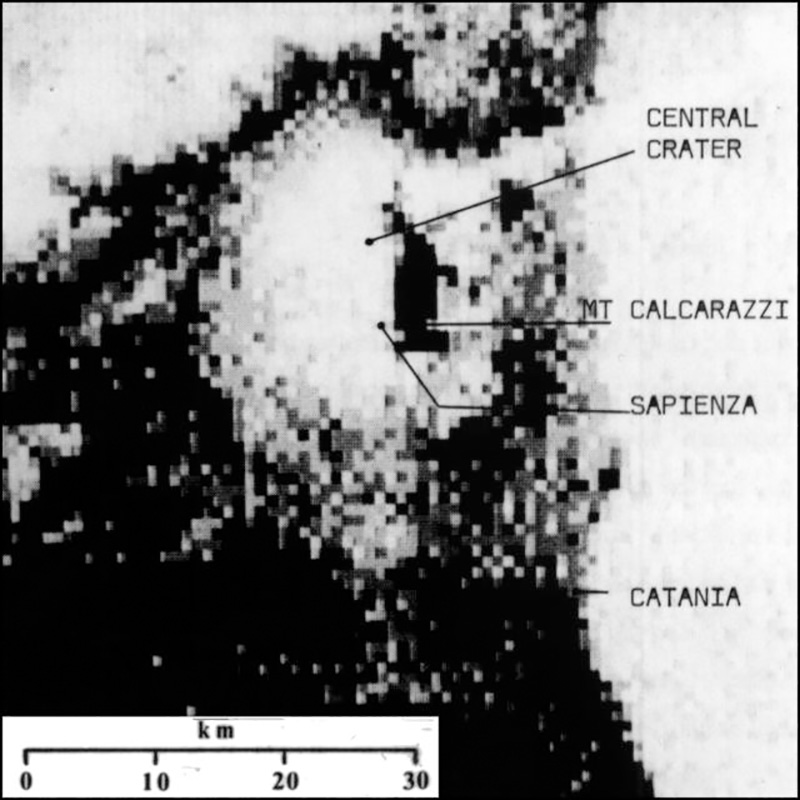 | Figure 6. Infrared image taken 16 September 1978 by the NOAA 5 weather satellite. The thermal anomaly is shown by the dark area around Monte Calcarazzi. |
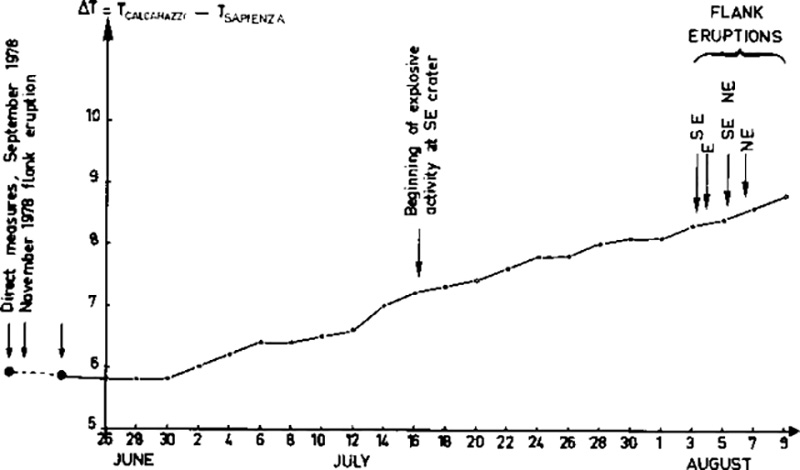 | Figure 7. Graph showing the variation between temperatures recorded at Monte Calcarazzi and Sapienza, September 1978-9 August 1979. |
"There had been considerable temperature increase (3°C) at the Monte Calcarazzi station during the month that preceded the flank eruption of 3 August. On 10 August the temperature at 120 cm depth, checked by direct measurements, was 9°C higher than the normal (Sapienza). Such a variation may be either a transient response to the August eruptive phenomena on the SE, E, and NE flanks, or the indication of magma motion southward - a problem that should be solved in the months to come.
References. Mise en évidence de zones thermiquement anormales sur le massif de l'Etna. 7éme R. ann. Sci. Terre, Lyon, Avril 1979, p. 15.
Mise en évidence d'anomalies thermiques dans la basse zone du secteur Sud de l'Etna, Note technique CNET 110/79.
Etablissement d'une carte thermique du massif de l'Etna à partir des données transmises par le satellite météorologique NOAA V...: Note technique CNET 111/79.
Further Reference. Guest, J.E., and Murray, J.B., 1980, Summary of volcanic activity on Etna, 1977-1979, in Huntingdon, E.T., et al., eds., 1980, U.K. Research on Mt. Etna: Royal Society of London, p. 50-52.
Information Contacts: C. Archambault and J. Stoschek, CNET, France; J. Tanguy, Univ. de Paris VI; PIRPSEF, CNRS-INAG.
January 1980 (SEAN 05:01)  Cite this Report
Cite this Report
Reduced thermal anomaly; small ash eruption
[Some elements of this report were excised at the authors' request.] "Since the August flank eruption, no major volcanic event has occurred on Mount Etna, although on 12 September a moderate phreatic explosion resulted in nine casualties near the W vent Bocca Nuova. On 11 January 1980, ashes were emitted from both Bocca Nuova and the Southeast Crater, where activity has preceded all the flank eruptions for the past two years.
"However, ground temperature measurements made on 21 January in the S part of Etna (Sapienza, Monte Silvestri, Monte Calcarazzi) show that the thermal anomaly has been reduced to a very low level (1-2°C, in contrast to 9°C in August 1979). This is the lowest temperature recorded in this zone since temperature measurements were initiated in September 1978.
Information Contacts: C. Archambault and J. Stoschek, CNET, France; J. Tanguy, Univ. de Paris VI; PIRPSEF, CNRS-INAG.
February 1980 (SEAN 05:02)  Cite this Report
Cite this Report
Red glow in SE crater
During the night of 29 February-1 March, red glow was visible in the Southeast Crater. No glow was reported the next two nights, but cloud cover may have obscured the crater.
Information Contacts: J. Guest, Univ. of London; R. Romano, IIV.
April 1980 (SEAN 05:04)  Cite this Report
Cite this Report
Explosions from summit and SE craters; thermal anomaly on S flank
During the evening of 14 April, explosions began from Etna's summit area and red-hot gases were emitted from the Southeast Crater. Explosions continued for the next several days. Residents of Zafferana, 11 km SE of the summit, saw large explosions on 16 and 17 April that were especially spectacular at night because of incandescence or perhaps lightning. Poor weather prevented observations from the IIV in Catania.
Etna guides who climbed the volcano, probably on 17 April, saw large fresh bombs near the Chasm and Bocca Nuova craters. Bombs were particularly prominent on the N and W sides of the central crater area. On 27 April at 1705, a large summit explosion produced a 3-km-high ash cloud. Renewed explosions began during the afternoon of 29 April and continued through the night from the Southeast Crater.
Information Contacts: R. Romano and L. Villari, IIV; J. Guest, Univ. of London; C. Archambault and J. Stoschek, CNET, France; J. Tanguy, Univ. de Paris VI; G. Scarpinati, Acireale.
May 1980 (SEAN 05:05)  Cite this Report
Cite this Report
Incandescent tephra ejected; temperature anomaly on S flank
"After a 3-month period of stabilization, ground temperatures in Etna's S-flank fissure zones (6 km S of the summit) began to increase again in March (figure 8). However, station 3, only 25 m from station 2, continued to show a nearly constant temperature. Variations in temperature are calculated by comparison with Sapienza reference station 1, located outside the fissure zones, 0.5 km WNW of stations 2 and 3, and 1.25 km from station 5.
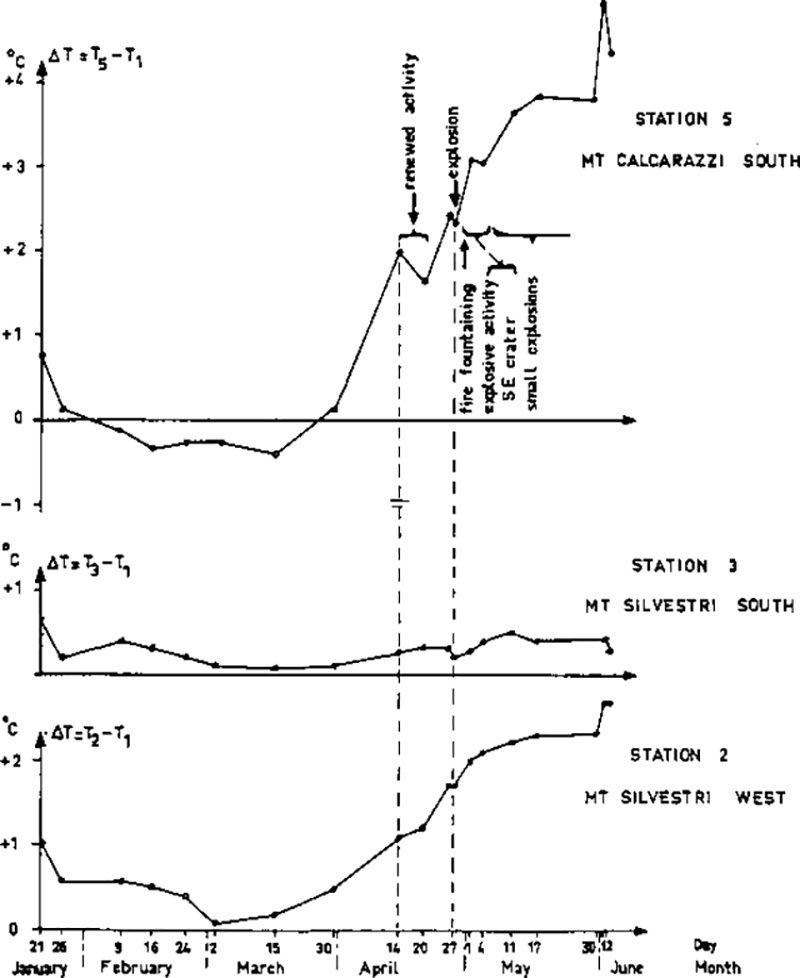 | Figure 8. Differences between ground temperature measured at 120 cm depth at stations 2, 3, and 5, and reference station 1 (T2-T1, T3-T1, and T5-T1) on Etna's S-flank, 21 January-2 June 1980. |
"The increase in temperature preceded renewed activity from the summit crater system. On 14 April, red-hot gases were emitted from the Southeast Crater and on the following days fresh lava lumps were ejected from the Chasm.
"On 20 April, S flank temperatures were stationary or even slightly lower. Between 20 April and 1 May, temperatures strongly increased again. A large explosion on 27 April (probably at Bocca Nuova) and strong lava fountaining on 29 April at the Southeast Crater were followed by moderate magmatic activity until at least 3 May. After a short period of stabilization (1-4 May), temperatures were still increasing, although more slowly.
[Archambault, Stoschek, and Tanguy added the following paragraph to replace explanatory material excised from 5:1]. "It was initially believed that the thermal anomaly fluctuations were related to the reopening of cracks caused by increases in volcanic pressure. Further investigations showed this hypothesis to be incorrect, with the systematic seasonal increase of surficial temperatures being mainly the consequence of a microclimate (Bourlet and Bourlet, 1982). A volcanic effect does occur, but its influence cannot be simple and is probably linked to the circulation of hot waters through the S flank. From this standpoint, a striking example is the rapid temperature increase measured in November 1982 at 6 m depth (figure 8, 08:04), where a climatic effect cannot be invoked. Such a variation was not observed the following years (November 1983 and 1984). It may have resulted from the heating of meteoric waters by an intrusion of magma into the S flank a few months before the March 1983 eruption.
"The Southeast Crater was intermittently active throughout May. On 31 May, two vents were observed inside the crater with moderate ejections of incandescent magmatic material up to 50 or 100 m, with some bursts occasionally reaching 200 m. As of 3 June, activity had increased noticeably, and explosions were stronger and more frequent. The number of explosions per hour reached 165 and the ejecta reached heights of 200-300 m."
References. Bourlet, Y. and Bourlet, F., 1982, Etude microclimatique de 5 stations sur le versant sud de l'Etna: Bull. PIRPSEV, no. 63.
Bourlet, Y. and Bourlet, F., 1983, Etude des anomalies thermiques et hydriques sur le versant NE à Citelli et sur le versant sud à la Montagnola: Bull. PIRPSEV, no. 73.
Information Contacts: J. Tanguy, Univ. de Paris VI; C. Archambault and J. Stoschek, CNET, Lannion, France; G. Scarpinati, Acireale (direct measurements and observations); PIRPSEV, CNRS/INAG, France.
July 1980 (SEAN 05:07)  Cite this Report
Cite this Report
Incandescent tephra ejection; decreased gravity readings
Activity increased gradually between 13 and 20 July in the Southeast Crater, site of lava fountaining in late April, intermittent eruptions in May, and stronger explosions in early June. No information was available on activity between 4 June and 12 July [but explosive activity was persistent from the SE Crater and Bocca Nuova]. In mid-July, many small explosions were observed on some days, while other days were characterized by fewer but larger explosions. After a period of poor weather, renewed observations of the Southeast Crater on 31 July revealed four active vents, located 25 m below the lowest portion of the crater rim. The two larger vents steamed continuously, and exploded about every 2 seconds, ejecting incandescent tephra to heights of 25 m. At approximately 2-minute intervals, stronger explosions sent tephra upward 100 m. A small spatter cone surrounded the vents. The two smaller vents ejected juvenile material only occasionally.
Explosions from deep within Bocca Nuova were heard about every 2 seconds on 31 July. No tephra reached the rim. Since last September, Bocca Nuova's diameter [corrected from radius] has increased by as much as 80 m, bisecting a small crater formed in 1964. Most of the increase occurred during the winter, but further crater growth took place in June.
The Chasm, E of Bocca Nuova, was filled with solidified lava to within 25 m of its rim on 31 July. Large amounts of spatter and many bombs surrounded the crater as a result of activity in April (05:04).
Gravimeter readings made in late July by Tim Sanderson on the S flank yielded values that were significantly lower than in September 1979, indicating a loss of mass on that flank. July 1980 N flank gravity values were very similar to those of the previous September.
Information Contacts: J. Guest, J. Murray, C. Kilburn, and R. Lopes, Univ. of London; T. Sanderson, Imperial College.
August 1980 (SEAN 05:08)  Cite this Report
Cite this Report
Two one-day eruptions
Relatively weak activity similar to that of late July continued through August at Etna. A 1-day eruption on 1 September deposited ash on the E flank and extruded two lava flows.
John Guest climbed the volcano on 18 August. As on 31 July, explosions occurred deep within Bocca Nuova. The Chasm remained quiet. Mild strombolian activity continued from the Southeast Crater, but reportedly weakened the following week. Romolo Romano reported that a swarm of local seismic events began on 21 August.
At 0957 on 1 September, a pale brown plume was seen rising from the Northeast Crater, which last erupted in March 1978 (03:05). By 1130, explosions were ejecting large bombs or blocks every 10-15 minutes. An increase in seismicity at about 1700 was followed at 1730 by stronger explosions that were audible in Fornazzo, 10 km E of the crater. A large black eruption column rose to 6 km above the crater. By 1800, ash was falling on Fornazzo and the entire E flank. Geologists reached the eruption area by about 2000 and saw nearly continuous strombolian explosions from two vents in the Northeast Crater ejecting tephra to 500-600 m above the rim. Lava from the Northeast Crater flowed to the N and NW. By the next morning, the eruption had stopped. Heavy fog made mapping of the two lava flows difficult, but the NW flow had moved past Punta Lucia, about 3/4 km from the Northeast Crater.
A second brief eruption from the Northeast Crater began early 6 September, ending at about 1500 the same day, after an estimated 10 hours of activity. A small lava flow was extruded. No further information was available at press time.
Information Contacts: J. Guest and C. Kilburn, Univ. of London; T. Sanderson, Imperial College; R. Romano, IIV; G. Kieffer, Univ. de Clermont-Ferrand.
September 1980 (SEAN 05:09)  Cite this Report
Cite this Report
Ashfall to coast; lava flow; bombs
The 6 September eruption began at about 0500. Vigorous strombolian activity continued for 10 hours, ejecting bombs to 500 m above the same Northeast Crater vent that had erupted 1 September. Bombs 20 cm in diameter or larger fell as far as 750 m away. A lava flow, extruded from the same vent at a rate of 10-20 m3/s, traveled 2 km to the N, directly over the main lobe of the bifurcated 1 September flow, which extended about 1/2 km farther to the N. Ash fell on the coastal towns of Acireale and Taormina, 20 km SE and 30 km NE of Etna. Observations after the eruption showed the vent completely filled by lava and slumped debris. As of 3 October, no further eruptions had been reported.
Rumbling and deep explosions continued in September from Bocca Nuova. The Chasm remained inactive. Mild strombolian activity at the Southeast Crater stopped in September, with only infrequent gas emission and small collapse events reported.
Tim Sanderson collected gravity data before the 1 September eruption and after the 6 September one. Frequent ground temperature measurements by J. C. Tanguy and associates continue (05:05).
Information Contacts: C. Kilburn, Univ. of London; T. Sanderson, Imperial College.
February 1981 (SEAN 06:02)  Cite this Report
Cite this Report
Explosions and lava flow from Northeast Crater
The IIV reported explosions and extrusion of lava from the Northeast Crater. After a period of ash emission at the end of January and the beginning of February, stronger activity began with intense explosions the evening of 5 February. Lava flowed through a breach in the W-to-NW side of the Northeast Crater cone, forming three lobes that moved W, NW and N, covering the upper NW slope of the volcano. The N lobe, the largest, traveled ~2 km to 2,600 m elevation where it had a 1.2 km front. The eruptive activity stopped the evening of 7 February.
Information Contacts: R. Romano, IIV; J. Guest, Univ. of London.
March 1981 (SEAN 06:03)  Cite this Report
Cite this Report
Large lava flows cause severe damage
An eruption 17-23 March extruded lava from several fissures on the NNW flank. Initial estimates indicate that the main flow reached 7.5 km in length, lava flows covered an area of 6 km2, and 30-35 x 106 m3 of lava were extruded [but later calculations from topographic measurements by Murray (1982) yield 18 x 106 m³] at a rate of 58-70 m3/s. Damage was estimated at about $10 million. Of the 90 historic eruptions of Etna for which location data are available, only three (1614, 1764, and 1918) occurred on the NW or NNW flanks.
Etna began to erupt on 17 March after a 2-day swarm of about 500 earthquakes, including a M 4-5 event during the morning of 16 March. On 17 March at 1337 an eruption fissure opened at about 2,550 m [corrected from 2,250 m] above sea level on the NW flank, trending approximately NW-SE. Lava fountains rose 100-200 m from this fissure and lava flowed rapidly westward. In the next 4 hours, three more fissures opened, the first and third also trending NW, the second WNW. All showed strong lava fountaining and were the source of lava flows. As fissures formed at lower altitudes, those higher on the volcano ceased to be active.
At 1855 on 17 March, another fissure opened at 1800 m elevation on the NNW flank, trending NW at its upper end, but after a short distance changed direction to more directly downslope. A large lava flow that originated from this fissure traveled 5 km within 4 hours, cut a railroad and highway (at 730 m altitude) during the night, and crossed another railway line and road (at 680 m altitude) early on 18 March. The lava destroyed orchards and farm buildings, and passed very close to the village of Montelaguardia, forcing the evacuation of its 250 residents. The fissure propagated downslope to 1,300 m altitude at 1130 on 18 March. The lower section extruded a small lava flow that briefly threatened Randazzo (population 15,000) but did not force its evacuation. By 1630, the center of the main flow was more than 1 km wide and its front had reached 650 m altitude, 100 m from the bed of the Alcantara River.
At 2200, another fissure opened between 1,235 and 1,140 m altitude extruding flows that moved toward Randazzo. By this time, the system of eruptive fissures had a total length of about 7.5 km. The main flow reached the Alcantara River bed (600 m above sea level) on 19 March at 1100, while the flows extruded from the fissure between 1,235 and 1,140 m altitude continued to advance slowly. By noon on 20 March, this fissure was characterized by mild spatter ejection that continued to feed slow-moving lava flows. However, the main flow had nearly halted. Sporadic activity between 1235 and 1140 m continued 21-22 March, finally ending during the evening of the 23rd. The longest flow from this fissure stopped at 900 m elevation, 2 km from Randazzo. More than 25 small earthquakes were recorded on 23 March, centered around the eruption fissures.
Throughout the period of lava extrusion, more or less intense emission of sand-size tephra occurred from Bocca Nuova, enlarging it to the W. Strong winds caused flank ashfalls on 22 March [as the Northeast Crater briefly ejected juvenile cinders; Tanguy and Patané, 1984].
Further References. Murray, J.B., 1982, Les Déformations de l'Etna à la suite de l'eruption de Mars 1981: Bull. PIRPSEV, no. 57.
Sanderson, T.J.O., Berrino, G., Corrado, G., and Grimaldi, M., 1983, Ground deformation and gravity accompanying the March 1981 eruption of Mount Etna: JVGR v. 16, p. 299-316.
Guest, J.E., Kilburn, C.R.J., Pinkerton, H., and Duncan, J.M., 1987, The evolution of lava flow-fields: Observations of the 1981 and 1983 eruptions of Mt. Etna, Sicily: BV v. 49, p. 527-540.
Information Contacts: R. Romano, IIV; UPI; AP.
April 1981 (GV11 81:04)
Photograph from Space Shuttle
The fissures and lava flows on the NNW flank resulting from the March 1981 activity (figure 9) were visible to astronauts aboard the Space Shuttle in April 1981.
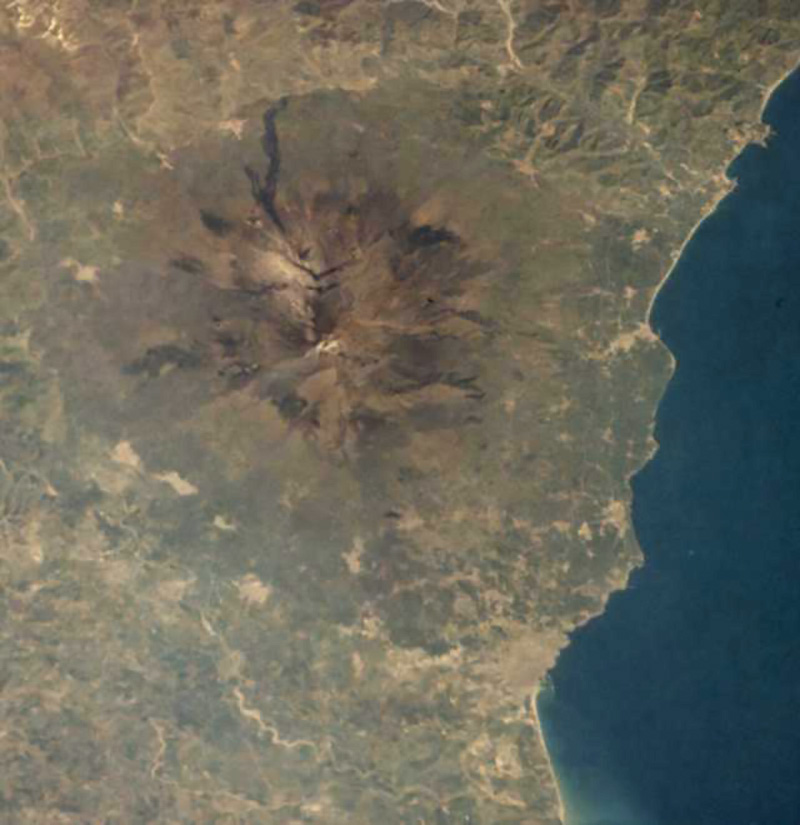 | Figure 9. Photograph of Mt. Etna and vicinity taken from the Space Shuttle in April 1981. North is towards the top of the photo; Catania is SE of the volcano on the eastern coast of Sicily. Photo no. STS 1-13-444, courtesy of Charles A. Wood. |
Information Contacts: Charles A. Wood, NASA Johnson Space Center.
July 1981 (SEAN 06:07)  Cite this Report
Cite this Report
Ash ejection, probably caused by central crater collapse
On 29 July, a dense ash cloud was ejected for more than 30 minutes from Bocca Nuova. The ash emission may have been produced by collapse within the crater; no significant explosions were associated with the activity. Similar events have occurred on several occasions since the March eruption.
Information Contacts: J. Guest, Univ. of London; R. Romano, IIV.
September 1981 (SEAN 06:09)  Cite this Report
Cite this Report
Collapse in the central crater; ash ejection
Collapse activity deep within Bocca Nuova has been frequent since the 17-23 March fissure eruption. No fissuring or other evidence of surface collapse has been observed around Bocca Nuova. Explosions associated with the collapse activity ejected fine ash, caused strong ground vibrations 300 m from the crater, and could be heard as much as 10 km away. Plumes produced by this activity could sometimes be seen on the satellite images returned once daily by the NOAA 7 polar orbiter. Images returned shortly after noon on 3 and 4 October showed narrow, well-defined plumes extending ~75 km downwind from Etna. A smaller, less dense plume extending outward only about 20 km was present on the 6 October image.
Information Contacts: J. Guest, Univ. of London; M. Matson, NOAA.
October 1981 (SEAN 06:10)  Cite this Report
Cite this Report
Small plumes on satellite images
Images returned by the NOAA 7 polar orbiting satellite continued to show occasional plume emission: on 9 October at 1442 plume roughly 75 km long, drifting to the SE, and on 1 November at 1329 a much smaller plume, roughly 20 km long was moving to the SW. No other activity was seen on the almost daily imagery between those dates.
Information Contacts: M. Matson, NOAA.
December 1981 (SEAN 06:12)  Cite this Report
Cite this Report
Collapse continues in central crater; ash plumes
As of mid-January, collapse on Bocca Nuova's inner walls was almost continuous, producing plumes that contained fine ash but no fresh magma. At times of little or no wind, the plumes rose 3-4 km above the crater. There was no evidence of collapse beyond the crater rim. No changes have occurred in seismicity or tilt.
Images from the NOAA 7 satellite showed plumes emerging from the summit area on 4 and 6 January. A plume observed on 4 January at 1431 extended ~80 km to the SE, beyond the coast. Infrared data showed that the plume's apparent temperature was comparable to that of the sea water beneath it, and thus it probably remained at a relatively low altitude. The next image of the area, at 1408 on 6 January, showed a fairly diffuse linear plume ~55 km long, drifting SE. A plume from Etna had last been observed on satellite imagery (available most days for the Etna area) on 1 November.
Information Contacts: L. Villari, IIV; M. Matson, NOAA.
May 1982 (SEAN 07:05)  Cite this Report
Cite this Report
Small central crater explosions follow earthquakes and higher ground temperatures
[Some elements of this report were excised at the authors' request.] Since the fissure eruption of 17-23 March 1981, explosions associated with collapse activity deep within Bocca Nuova have produced small to moderate ash plumes. Magma was observed in the bottom of Bocca Nuova in mid-May, mid-July, and early September 1981, and incandescence was seen there in February 1982. All activity from Bocca Nuova stopped 8 May, but resumed about a week later at around a time of unusual seismic and thermal activity on the NE flank. Incandescent scoria rose above the crater rim 20-22 May.
Seismicity increased during the third week of May and culminated with an explosion, possibly at 1515 on 27 May, when the summit seismometer operated by the Univ of Catania detected a M 3.5 earthquake that was felt by local residents. The next day, geologists found blocks of old lava that had been ejected more than 300 m from the Chasm. Blocks up to 1.5 m across were found in small impact craters at the rim. Many blocks larger than 10 cm occupied elongated depressions, implying relatively oblique impact, oriented radially to the crater. The greatest concentration of blocks was immediately N of the crater, although the pattern of smaller blocks suggested a NW orientation. The depth of the Chasm had increased from ~50 m in March to ~100 m after the explosion, by removal of material that had filled it since 26 May 1980 [explosive activity had begun in mid April], and vents in its walls were steaming. However, activity 28 May was concentrated in Bocca Nuova, where occasional detonations could be heard and the crater floor was obscured by sulfurous steam. On 29 May, Bocca Nuova ejected black ash, containing fresh magma, every 2-3 minutes. Ash clouds rose 200-300 m above the crater rim and were blown a few hundred m to the south. Only fumarolic activity was observed in the Northeast and Southeast craters.
Information Contacts: R. Romano, IIV; M. Malin and M. Sheridan, Arizona State Univ.; J. Sheridan, Tempe, AZ; C. Archambault and J. Stoschek, CNET, France; J. Tanguy, Univ. de Paris VI; R. Basile, S. Scalia, and G. Scarpinati, Gruppo Ricerca Speleologica; M. Cosentino, S. Gresta, G. Lombardo, and G. Patane, Ist. di Scienze della Terra, Catania.
July 1982 (SEAN 07:07)  Cite this Report
Cite this Report
Eruption cloud; lava in main crater
Etna erupted on 8 August, when a black tephra column was emitted from Bocca Nuova and lava rose to 150-200 m below the crater rim. The activity was accompanied by a marked increase in minor earth tremors. Sicilian authorities have restricted tourist access to the volcano.
Information Contacts: J. Guest, Univ. of London; Reuters.
September 1982 (SEAN 07:09)  Cite this Report
Cite this Report
Strombolian activity on central crater floor
Strombolian activity on the floor of Bocca Nuova was observed in September. Fine ash fell on the crater rim. Since summer 1981, continuing collapse activity at Bocca Nuova has widened the crater by nearly 100 m, to 250 m in SW-NE dimension. Poor visibility prevented determination of the crater's depth. Just to the E, vapor emission was continuous from the Chasm, site of an explosion in late May that removed ~50 m of debris that had choked this vent for 2 years (07:05).
Information Contacts: J. Guest, Univ. of London.
November 1982 (SEAN 07:11)  Cite this Report
Cite this Report
Small explosions, but tephra to 12 km
A C-141 cargo plane pilot observed tephra from Etna at ~12 km altitude on 6 December at 1800. Romolo Romano reported there had been many small explosions from Bocca Nuova throughout the day. No eruption plume was visible on the only satellite image of Etna that was available on 6 December, from a NOAA polar orbiter at 1530. Poor weather and heavy snow make access to Etna's summit area difficult during the winter.
Information Contacts: R. Romano, IIV; M. Matson, NOAA.
December 1982 (SEAN 07:12)  Cite this Report
Cite this Report
Incandescent tephra from central crater
Explosive activity of varying intensity continued through early January from the floor of Bocca Nuova. Large ash emissions were sometimes observed. During the night of 24-25 December, intense explosions ejected incandescent tephra. Most of the tephra fell back within the crater, but some was deposited outside the crater rim.
Press sources reported emission of large quantities of gray and white "smoke" from the Northeast Crater but Romolo Romano noted that the Northeast Crater activity was fumarolic and no ash was ejected. The Northeast Crater last erupted in February 1981, producing a lava flow and ash (06:02).
Further Reference. Scarpa, R., Patane, G., and Lombardo, G., 1983, Space-time evolution of seismic activity at Mt. Etna during 1974-1982: Ann. Geophysicae, v. 1, no. 6, p. 451-462.
Information Contacts: R. Romano, IIV; UPI.
March 1983 (SEAN 08:03)  Cite this Report
Cite this Report
Lava from S-flank fissure; central crater enlarged
A destructive S-flank fissure eruption began on 28 March, preceded by a series of strong earthquakes first felt during the night of 26-27 March. At about noon on the 27th, a strong smell of H2S was noted from an old cone (Monte Silvestri) roughly 2 km S of the initial eruption, although H2S is not normally present in that area. Seismicity continued through the following night. At about 0845 on 28 March a NNE-SSW-trending eruptive fissure opened from about 2,450 to 2,250 m altitude, roughly 4 km S (bearing ~170°) of the central crater (between the eruption fissure of 1910 and La Montagnola). The base and E side of this fissure fed several lava flows that initially moved to the SSE and SSW then turned S. Weak explosive activity along the entire fissure ejected modest quantities of lava fragments. By evening, the main flow had cut a road and overrun several buildings.
During the morning of 1 April, vigorous emission of gas, ash, and old lava, accompanied by occasional phreatic explosions, began from two explosion craters upslope at 2,700 m altitude. At the end of the day, explosions from the southern vent ejected lava fragments. On 2 April, nearly constant lava production fed numerous superposed flows that formed a 500-m-wide lava field extending to 1,900 m altitude. As of 3 April, the lava had not advanced below 1,450 m altitude, 3.5 km from the fissure. At least four principal effusive vents were active along the 750-m fissure, and from its upper part strong gas emission with sporadic explosions occurred at about 30 hornitos.
Bands of open fractures, oriented about N-S, extended from the central crater area to the eruptive fissure. A substantial widening was noted at the S rim of Bocca Nuova, site of frequent collapse activity since Etna's last eruption (from N flank fissures in March 1981). Strong vapor emissions from Bocca Nuova sometimes included abundant ash. There was no activity from the Northeast and Southeast craters.
The temperature of the lava was less than 1,100°C and its chemistry (alkali basalt) [corrected from phonolitic tephrite] was similar to that from some of the more recent eruptions. An area of more than 1 km2 was covered by lava and the volume emitted was estimated at about 8-10 x 106 m3. The IIV considered the eruption to be a typical slow subterminal type. The last activity of this type on the S flank was in 1780. As of 8 April, effusive activity had diminished, but the eruption had not yet ended.
The lava destroyed ski lifts [the cable car system originally reported destroyed survived until March 1985] and destroyed or seriously damaged nine privately-owned huts and 11 small buildings owned by local authorities, including restaurants, chalets, mountain refuges, and a first aid station. Lava remained 8 km from the village of Nicolosi, its closest approach to a village or town.
Information Contacts: R. Romano, IIV; M. Krafft, Cernay, France; UPI.
April 1983 (SEAN 08:04)  Cite this Report
Cite this Report
Lava effusion continues; central crater explosions; deformation, temperature and self-potential data
The eruption was continuing as of 6 May. J. C. Tanguy noted that temperature station cables in the S part of the summit zone broke on 27 March between 0530 and 0946, probably because of the opening of the eruption fracture. Fissures extended S from 2,700 m (where two explosion vents formed on 31 March) to 2,450 m, then turned SSW along the trend of the 1910 eruption. Small hornitos and spatter cones formed between 2,450 and 2,350 m. The main effusive vent was at 2,280 m altitude. On 31 March, the temperature of lava at this vent was 1,067°C at 60 cm depth, and the same value was measured in the main flow 30-40 m downslope on 4 April. F. Mousnier-Lompre and G. Scarpinati recorded a lava temperature of 1,078°C on 1 May. J.B. Murray and A. Pullen reported that lava flow surface velocities measured 17-30 April were in the 1.17-3.41 m/s range. Using surface velocities, Murray and Pullen calculated an average effusion rate of 22 m3/s if flow thickness was 3 m and 44 m3/s if the thickness was 5 m.
Romolo Romano reported that lava flowed S and SW, forming a wide, complex field as much as 1 km across and 40 m thick. On the E side of the field, the fronts of the longest flows were about 6 km from the vent and reached 1,150 m altitude before stopping. On 23 April, the principal flow shifted to the W side of the field, and advanced to about 6.5 km from the vent, stopping at 1,100 m altitude only 30 m from a road. On 4 May the primary flow was again moving down the E side of the lava field and had reached 1,450 m altitude as of early 6 May. Lava flowed from the vent at about 2 m/s, a rate of about 10 m3/s, and had a temperature of about 1,030°C [but note 1,067° and 1,078° above]. The rate of advance of the flow fronts was quite variable and dependent on the gradient; estimated velocities ranged from a very few meters per hour to ~60 m/hour. The area covered by the lava was about 4 km2 on 6 May and the volume of lava emitted was ~40 x 106 m3.
Earlier in the eruption, small hornitos and spatter cones had formed above the main effusive vent and small quantities of lava fragments were ejected. Vapor emission continued from this portion of the eruption fissure but no lava fragment ejection has been noted since 10 April. Two explosion vents [not one as originally reported] at 2,700 m altitude ejected ash during the morning of 1 April [not 28 March as originally reported; Tanguy and Patané (1984), Frazzetta and Romano (1984)], but only vapor emission has been observed at this vent since then.
Throughout the eruption, ash was ejected at varying intensity from Bocca Nuova. More vigorous ash ejection 2-5 May sent plumes to 2 km above the crater and caused ashfalls on the mainland (Calabria coast) at least 60 km from the volcano. On 4 May, a polar orbiting satellite image showed the beginning of an ash emission episode at 0453. By the next image at 0606, a narrow plume extended nearly 1,000 km SE from Etna at an altitude of about 7.5 km. Venting was continuing at 0945 but the plume was smaller; at 1603, it was 100-150 km long. Another image, at 0705 on 6 May, showed a plume ~100 km long. From the Chasm, weak emission of gas that sometimes contained reddish ash has been observed during the eruption. In the Northeast and Southeast craters, eruptive activity was limited to weak fumarolic emissions, but new concentrations of large fractures were seen in these craters as well as small internal collapses.
Murray and Pullen reported that vertical ground deformation during 1981-82 was characterized by summit deflation and S flank inflation. Reoccupation of a precise leveling network 20-22 April 1983 showed large changes on the upper S flank (near Piccolo Rifugio) since September 1982: 42 cm of uplift W of the eruption fissure, 12 cm of uplift E of the fissure, and a drop of 126 cm on the fissure itself. Large and complex movements had occurred elsewhere, including deflation of 76 cm above the eruption fissure at about 2,900 m altitude (near Torre del Filosofo). Horizontal measurements across the fissure showed an E-W extension of 1.3 to 2 m since August 1981, with contraction of 17 cm and 6 cm at 500 m and 1 km W of the fissure. A network of 25 dry-tilt stations occupied 24-29 April 1983 showed no general inflation or deflation of the edifice since 1982.
Ground temperature measurements at 6 m depth on the S flank at 1,900 m altitude showed a strong increase in November 1982 (figure 10). In the summit zone, ground self-potential increased at roughly the same time and again in mid-January. A very steep rise occurred in early April, after the start of the eruption (figure 11). Immediately before the eruption a geophone in the S summit zone registered strong seismic activity, up to 134 events/hour during the morning of 27 March.
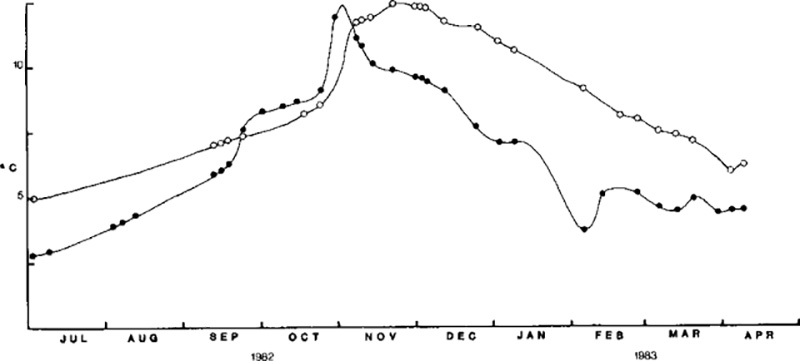 | Figure 10. Ground temperatures measured July 1982-March 1983 at 6 m depth, Silvestri station (closed circles) and Calcarazzi station (open circles), Etna's south rift zone, 1,900 m altitude. |
 | Figure 11. Ground self-potential (top), and temperature (bottom), at 120 cm depth, recorded at Vulcarolo station, south summit zone, 2,965 m altitude. Note that the very steep rise in self-potential occurred in early April, after the start of the eruption. Telemeasurements by ARGOS system. |
Further References. Frazzetta, G., and Romano, R., 1984, The 1983 Etna eruption: event chronology and morphological evolution of the lava flow: BV, v. 47, p. 1079-1096.
Tanguy, J., and Patané, G., 1984, Activity of Mount Etna, 1977-1983: volcanic phenomena and accompanying seismic tremor: BV, v. 47, p. 965-976. (both in Barberi and Villari, eds., 1984, cited after 8:07)
Information Contacts: R. Romano, L. Villari, S. Gresta, and O. Consoli, IIV; J. Tanguy and J. Murray, PIRPSEV; A. Pullen, Imperial College; M. Matson, NOAA; C. Archambault and J. Stoschek, CNET, France; S. Scalia and G. Scarpinati, Acireale; J.Bartaire J. and N. Bartaire, St. Maur des Fossés; R. Cristofolini, M. Cosentino, G. Lombardo, G. Patanè, A. Viglianisi, and P. Villari, Ist. di Scienze della Terra, Catania; P. Mousnier-Lompré, Servizio Sismico Regionale.
May 1983 (SEAN 08:05)  Cite this Report
Cite this Report
Lava production slows; lava partially diverted; central crater explosions continue; self-potential data
The continuing eruption showed signs of a progressive decline on some days. The velocity of the lava flow from the vent at about 2,280 m altitude decreased from ~1.7 m/s on 28 May to <0.5 m/s in early June, with a reduction in the rate of outflow to ~3 m3/s. In early May, the velocity at the vent had been about 2 m/s and the effusion rate was about 10 m3/s. New flows, most of which moved S and SW, continued to add to the S flank lava field that has accumulated during the eruption. On 25 May a flow advanced beyond the edge of the lava field, reaching 1,240 m altitude by the 27th, ~5.5 km from the vent. From 28 May, all of the lava flowed toward the interior of the lava field or approached its W side. In early June, frequent and impressive overflows occurred from both sides of the main lava channel at about 2,200 m altitude. Within the lava field, effusive pseudo-vents at around 1,800-1,980 m altitude have remained numerous. As of 8 June the area covered by lava was estimated at 6 km2 and the volume of lava produced by the eruption was ~75-80 x 106 m3.
Explosions of varying intensity continued, particularly from Bocca Nuova and primarily ejected reddish ash. On 15 May and 1-4 June the explosions were quite large. A NOAA 7 satellite image at 1529 on 15 May showed a strong plume (as large or larger than the 4 May plume; 8:04) that extended 100-150 km to the SE. Pilots reported that the plume had emerged from the summit area at about 1100. on 1 June at 0800, pilots estimated the height of a plume at about 5 km and reported that it was drifting SSE. In May and early June, only vapor emission was observed from an explosion crater at 2,700 m altitude and a fissure between 2,450 and 2,300 m altitude that were active early in the eruption. On 3 June, deep felt shocks (M 3.3) occurred near the active vent; these events continued the next day.
Because the advancing lava flows threatened additional property damage, efforts were made to divert the lava. Explosive charges were detonated at 0409 on 14 May to blast a passage from the W side of the main lava flow at 2,100 m altitude into a previously prepared artificial channel. Initially 20% of the total lava flux was diverted into the artificial channel, but by 16 May lava had ceased to flow in this channel after reaching 700 m length. After the explosions, however, there were numerous substantial overflows from the main natural channel, particularly from the W side, and these slowed the advance of the most distant flow. Artificial embankments have also been constructed E and W of the main natural channel, allowing control of the overflows from this channel that were moving over earlier flows.
Pham Van Ngoc and D. Boyer obtained self potential data during a PIRPSEV mission to Etna 27 April to 3 May. The following is a report from Pham Van Ngoc.
"Five self potential (SP) profiles were carried out from 2,350 to 2,700 m elevation. These profiles straddled the open fissure that trends NNE-SSW below Piccolo Rifugio (at 2,500 m altitude on the S flank) and the N-S fractures above it. The profiles were located upstream from the lava emerging at 2,320 m altitude. Figure 12 shows the results of the SP profiles.
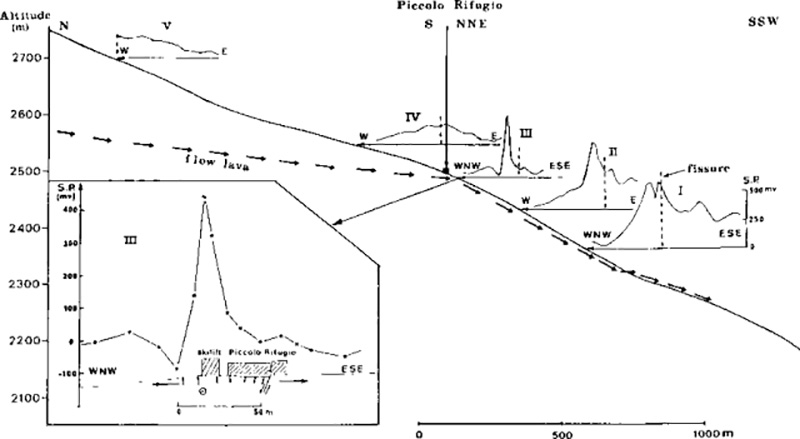 | Figure 12. Results of self potential profiles obtained 27 April-3 May across open fractures that trended N-S above 2,500 m altitude (Piccolo Rifugio) and NNE-SSW (about 200° azimuth) below 2,500 m. The topographic profile (vertical exaggeration 2:01) parallels the fissure trends, changing strike at Piccolo Rifugio. Arrows pointing left show positions of self-potential profiles. Arrows pointing right diagrammatically show the inferred subsurface flow of magma, its emergence from the vent at 2,320 m altitude, and continuation downslope as flowing lava. The inset at lower left details profile III, indicating that the axis of the subsurface flow was under the ski lift building, 40 m W of the open fissure. Here arrows show local stress field and fault movement. Courtesy of Pham Van Ngoc. |
"The shape of the SP anomalies was very different S and N of Piccolo Rifugio. To the S, profiles I, II, and III show huge (more than 50 mV) and sharp anomalies suggestive of superficial origin. it is notable that the maxima of these anomalies were not located just above the open fissure, but 40-50 m westward. The detail of profile III, just below Piccolo Rifugio, indicated clearly that the axis of the underground flow lies 40 m W of the active fissure (under the ski lift building W of Piccolo Rifugio). These results confirm that the pressure exerted by underground flow induced an E-W extension, creating a small graben clearly visible in the area of Piccolo Rifugio. The open fissure corresponds to a normal fault on the E edge of the graben and caused the collapse of the W part of Piccolo Rifugio.
"Above Piccolo Rifugio, profiles IV and V show much smaller Sp anomalies (~250 mV). Furthermore, these anomalies widen, thus indicating a deeper origin. It is notable that the shape of the SP anomalies changed completely from profile III to profile IV in a distance of ~300 m.
"SP results suggest that: 1) above Piccolo Rifugio, the magma flowed deeply in a N-S direction; and 2) level with Piccolo Rifugio (2,500 m altitude), the magma suddenly approached the surface and followed a shallow underground NNE-SSW channel that ran some 50 m W of the open fissure, then came to the surface at about 2,320 m altitude. Arrows in figure 12 indicate the path inferred from the lava."
Information Contacts: R. Romano, IIV; Pham Van Ngoc, Ecole Nationale Supérieure de Géologie; M. Matson, NOAA.
June 1983 (SEAN 08:06)  Cite this Report
Cite this Report
Lava production continues but at lower rate; central crater explosions; lava temperatures
Romolo Romano reported that the velocity of the lava flow from the main vent, at about 2,280 m altitude on the S flank, continued to decrease in early July, from somewhat less than 0.5 m/s in early June, to an estimated 0.1 m/s on 7 July. The rate of outflow, ~3 m3/s in early June, had dropped to ~0.5 m3/s by 7 July. Lava flowed SE, S, and SW onto the S flank lava field that has accumulated since the eruption began, but the flows were smaller than in previous months and reached a maximum length of 1 km. Between 1,800 and 1,950 m altitude, some flows approached the E edge of the lava field and effusive pseudo-vents remained numerous. Moving lava was visible through many small windows. Between the main vent and the lava field, numerous overflows occurred from the E and W sides of the main lava channel from 2,270 to 2,100 m altitude. As of 8 July, the volume of lava erupted since 28 March was estimated at 100-110 x 106 m3.
J.C. Tanguy reported that on 14 June, the temperature of a slow (~0.15 m/s) lava outflow at 2,280 m altitude was determined to be 1,071-1,073°C using both Cr-Al and Pt-Rh thermocouples inserted at 40 cm depth. This temperature was identical to that measured in the main lava flow 12 May by P. Mousnier-Lompre. Lava velocity at the vent began to increase 14 June and reached almost 4 m/s 18-21 June. Gas pressure increased during the same period and new hornitos were built just below the main vent between 2,280 and 2,260 m altitude. Lava overflows occurred in this zone 18 and 20 June. On 21 June, gas pressure decreased and the lava velocity at the vent decreased to <1 m/s. The level of lava in the main channel dropped again, leaving impressive grottoes where gas combustion produced temperatures as high as 1,137°C (thermocouple) - 1,165°C (infrared measurements) on 21 June.
Moderate to violent explosions have continued to occur from Bocca Nuova. Explosions on 20, 24, and 26 June, and 8 July were especially strong. On 24 June, emission of white vapor had been increasing since at least 0700, culminating in an explosion at 1015 that ejected old material, including reddish cinders and large blocks, that fell as much as 250 m from the vent, primarily to the W. A polar orbiting satellite image 26 June at 0606 showed a low-altitude plume that extended ~100 km ESE, and a similar plume, ~150 km long, trended SSE on 4 July at 0640. Larger plumes were seen on satellite images 8 July at 1427 and 1609 (more than 500 km long, to the ESE), 10 July at 0615 (500 km, to the SSE) and 2036 (150 km, to the SE), and 11 July at 0554 (300-500 km, to the SSE). On 12 July at 1415, the U.S. Navy reported a cloud extending 250 km to the SE with a base at 1 km altitude and a top at ~5 km altitude. Only weak vapor emission has been observed from the Chasm, and from vents at 2,700 m on the S flank active earlier in the eruption.
Information Contacts: R. Romano, IIV; J. Tanguy, PIRPSEV; R. Clocchiatti, CEN, Saclay, France; F. De Larouziere, CNRS; R. Cristofolini, M. Cosentino, G. Patane, A. Viglianisi, and P. Villari, Ist. di Scienze della Terra, Catania; M. Matson, NOAA.
July 1983 (SEAN 08:07)  Cite this Report
Cite this Report
Eruption ends after four months of lava extrusion
After 131 days of activity, the eruption stopped during the morning of 6 August. The July activity was similar to that of the second half of June. The main lava channel was almost completely roofed over, but moving lava was visible through four "windows" in the channel roof. Numerous overflows from the upper "windows" produced modest lava flows of short duration during the first 10 days of July. Through the end of the month, lava emerged from scattered short-lived pseudo-vents at about 1,860-1,800 m above sea level and flowed onto the S flank lava field that has accumulated during the eruption (figure 13). These small superposed flows approached the E and W edges of the lava field; one advanced beyond the field's W margin on 13 July but stopped quickly. Efforts to contain the lava flows continued with the construction of new small embankments. None of the July flows moved below 1,600 m altitude.
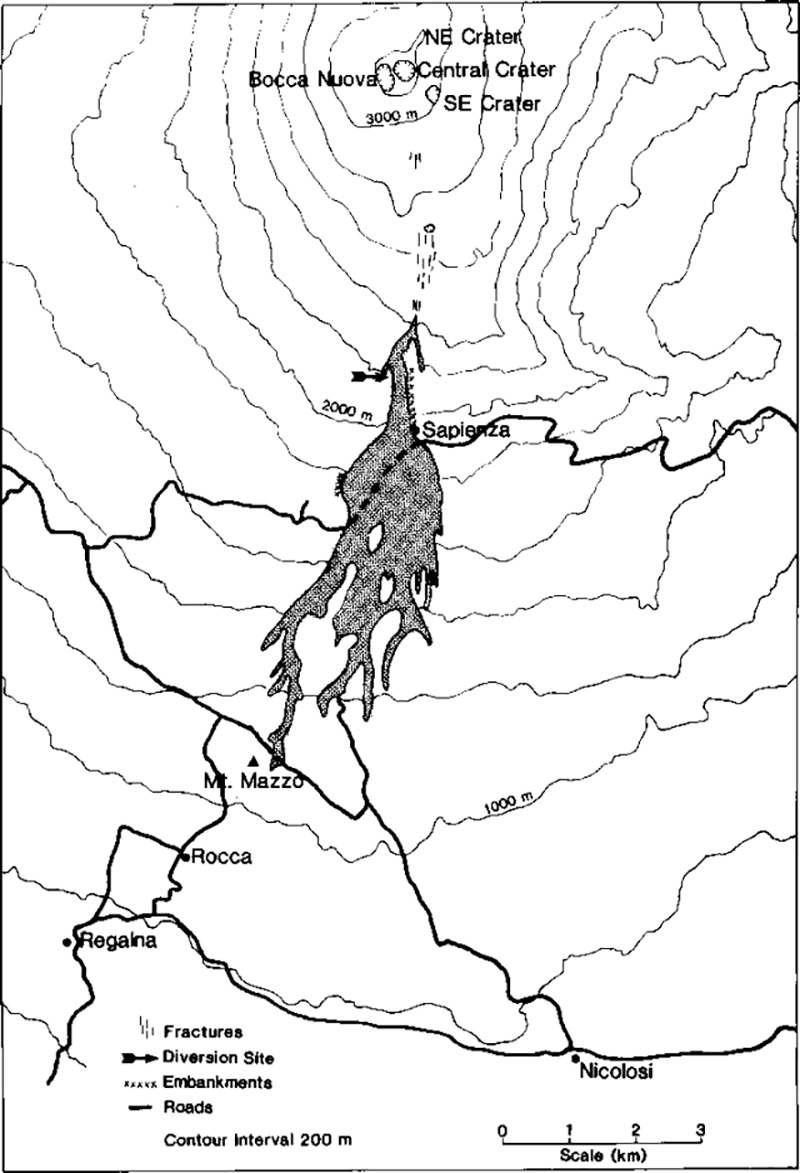 | Figure 13. Summit at S flank of Etna, showing the active vents and lava field of the 1983 eruption. Fractures are shown diagrammatically by short N-S lines. Contour interval 200 m. Large arrow on the upper W side of the lava field indicates the site of the partially successful attempt to divert lava into an artificial channel 14 May (08:05). Embankments constructed to limit the lava's spread are shown by x's. Several roads and villages in the area are shown (Sapienza is an inn, and Mt. Mazzo is an old vent). Nicolosi, Regalna, and Rocca cover larger areas than indicated. Courtesy of Romolo Romano. |
Ash emissions occurred at irregular intervals from Bocca Nuova, but were not as strong as in the previous month. High-altitude winds carried ash to Catania (~30 km to the SSE) on 9, 10, and 11 July. No significant activity stoccurred from other vents.
Preliminary estimates suggest that the 131-day eruption extruded ~100 x 106 m3 of lava, at a rate of 10 m3/s. Lava flowed a maximum of 7 km from the vent, reaching 1,100 m altitude (E of Mt. Mazzo), and covered an area of ~6 km2.
Further References. Kieffer, G., 1983, L'Eruption de l'Etna commencée le 28 Mars, 1983: sa place dans l'exceptionnel cycle eruptif en cours (1971-1983): Comptes Rendus Acad. Sci. Paris, Ser. II, v. 296, p. 1689-1692.
Barberi, F., and Villari, L., eds., 1984, Special issue on Mt. Etna and its 1983 eruption: BV, v. 47, no. 2, p. 877-1177 (22 papers).
Lockwood, J.P., and Romano, R., 1985, Diversion of lava during the 1983 eruption of Mount Etna: Earthquake Information Bull., v. 17, no. 4, p. 124-133.
Information Contacts: R. Romano, IIV.
August 1983 (SEAN 08:08)  Cite this Report
Cite this Report
No new activity
No additional activity has been reported since 4 months of lava extrusion ended 6 August. [Corrections were made to the figure caption from the previous issue; this report was removed for GV 75-85.]
Information Contacts:
January 1984 (SEAN 09:01)  Cite this Report
Cite this Report
Incandescent tephra from central crater; seismicity
"Beginning in December, numerous seismic crises were recorded, mainly connected to the degassing of the magma column through the central vents. In the same period, ejections of reddish ash (old material) or dark ash (fresh material) occurred from the central crater. At times (14, 16, and 28 January) these have been rather significant, depositing thin layers of ash on the E flank. Some nights, pulsating flashes, due to the ejection of incandescent material from Bocca Nuova were observed. Tiltmeter variations were also recorded."
Information Contacts: R. Romano, IIV.
April 1984 (SEAN 09:04)  Cite this Report
Cite this Report
Strombolian activity and small lava flows from Southeast Crater
"During the night of 27-28 April, an eruptive fissure oriented approximately NW-SE opened inside the Southeast Crater, near its NE margin. This crater, which is at ~3,000 m elevation behind the SE side of the central crater, formed in May 1971 and had numerous eruptive episodes in 1978 (April-July, August, November), 1979 (July-August), and 1980 (January-September, explosive activity only).
"Initially, moderate activity was observed from three explosive vents along the fissure, which ejected lava fragments. At the same time, small lava flows emerged from the fissure, remaining inside the Southeast Crater. During the next few days, strombolian activity increased with the ejection of lava fragments to 250 m or slightly more in height. During the morning of 1 May, lava flowed over the NE rim of the crater then turned SE, covering the E side of the Valle del Bove and quickly reaching a length of 2 km. Feeding of this flow was continuous but of variable volume, resulting in numerous superposed and parallel subflows but little advance of the flow front after its initial rapid movement. On 6 May, lava overflowed the SE rim of the crater, advancing NE and later E. This flow, which was fed until the morning of 8 May, reached a length of about 1 km. As of 10 May, both the strombolian activity (which formed a scoria conescoria cone inside the Southeast Crater) and the effusive activity appeared to be decreasing.
"Starting 5 May, strong ash ejections from the Chasm were observed, while from Bocca Nuova only emission of gas under pressure was detected. In the past months, a lava lake 150 m from the rim of Bocca Nuova has been noted."
Information Contacts: R. Romano, IIV.
May 1984 (SEAN 09:05)  Cite this Report
Cite this Report
Continued lava production; Strombolian activity
"The Southeast Crater eruption was continuing in early June. The explosive strombolian activity from the small new cone within the Southeast Crater had been diminishing, and stopped almost completely 13 May. Starting that day, ash ejections have been observed at more or less regular intervals, while slow emission of gas and vapor usually occurred. The strombolian activity started again in late May; at times (25 May and 4 June) it was particularly violent.
"The effusive activity has been continuous, with alternating phases of greater or lesser vigor. The lava field has grown noticeably toward the S (reaching a maximum dimension of more than 500 m) and by early June had in its interior, many ephemeral effusive vents, which generated small lava flows that advanced over earlier ones. The main flows (generally one to the S and another to the N), which originated from convergence of the small flows, barely got below 2,700 m elevation.
"At irregular intervals, more or less violent ejections of reddish ash from the Chasm have been noted, while from Bocca Nuova there have only been gas emissions."
Information Contacts: R. Romano, IIV.
June 1984 (SEAN 09:06)  Cite this Report
Cite this Report
Explosions and lava production continue from Southeast Crater; central crater explosions
Tanguy and Clocchiatti reported that in late May and early June explosions, usually 10-30/minute, ejected lava fragments and scoria to 50-200 m above the inner cone that had formed inside the Southeast Crater. Explosive activity sometimes declined to weak puffs of gas without much tephra, but at other times the ejecta were rich in large fragments of magmatic material. During periods of more vigorous activity, occasional bursts hurled the smallest tephra to 500-600 m height. In contrast, lava effusion occurred at a steady rate of a few (perhaps 2-5) cubic meters per second, significantly lower than in paroxysmal eruptions (>10 m3/s) but probably higher than in typical subterminal persistent activity (1 m3/s). The maximum temperature measured at small effusive vents on 31 May and 5 June was 1,075-1,076°C (at 60 cm depth).
Romolo Romano reported that explosive activity at the Southeast Crater in June and early July was limited to ejection of incandescent tephra at varying intervals, occasionally accompanied by ejection of dark ash. Effusive activity continued, resulting in further enlargement of the lava field, especially to the N. Lava flows did not extend much below the 2,800 m level. During the last 10 days of June, lava overflows occurred from the SE side of the Southeast Crater, but did not flow over the edge of the Valle del Bove. On 4 July, an overflow of very thin (0.5 m thick) fast-moving lava occurred from the still-active SE side of the Southeast Crater. Tanguy and Clocchiatti reported Bocca Nuova was filled with lava to within ~100 m of its rim in April, but by early June the lava column was again very deep (> 300 m) and activity was limited to quiet emission of large amounts of SO2. Romano reported that violent ejection of reddish ash from Bocca Nuova was observed beginning in the second half of June. Recently, the ash has been gray (indicating presence of new material). On 3 and 9 July, violent explosions ejected lava fragments that fell outside the crater rim, especially on the SW flank. During this period, strong emission of gas under pressure was noted at the Chasm.
Tanguy reported that in late April seismicity recorded by Christian Archambault from a geophone about 1 km SSE of the Southeast Crater increased from less than 500 to more than 2,200 events/day (figure 14). A seismic crisis was also recorded January-March, accompanied by lava filling and strombolian activity at Bocca Nuova. The temperature at 3 cm depth at the station about 400 m SSE of the Southeast Crater decreased before the 1983 flank eruption but increased before the current eruption began in April 1984.
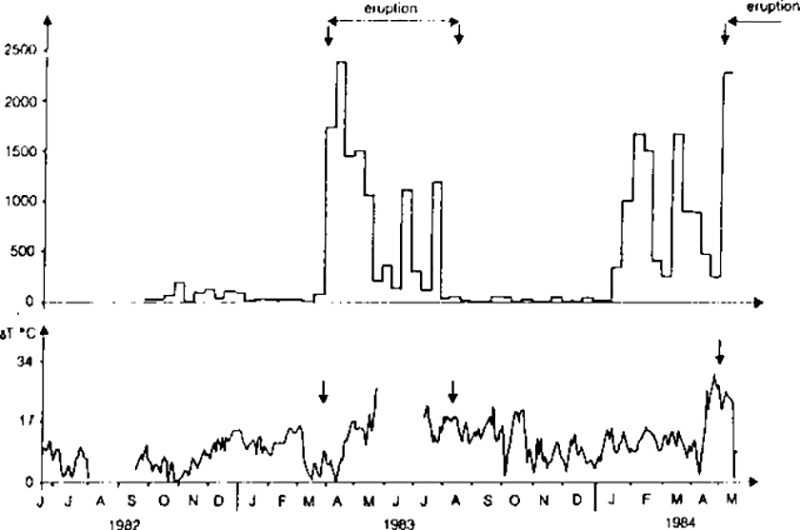 | Figure 14. Number of seismic events recorded per day (averaged over a 10-day period) at the TDF geophone about 1 km SSE of the Southeast Crater (top) and plot of the difference in subsurface temperature (measured at 3 cm depth) between the CC1 (~400 km SSE of the Southeast Crater) and TDF stations (bottom). Arrows indicated periods of eruptive activity. Courtesy of J.C. Tanguy. |
Information Contacts: R. Romano, IIV; J. Tanguy, Univ. de Paris VI; R. Clocchiatti, CEN, Saclay, France; C. Archambault, CNET, France.
July 1984 (SEAN 09:07)  Cite this Report
Cite this Report
Lava production and Strombolian activity continue from Southeast Crater; strong explosions from Central and Northeast craters
"The Southeast Crater eruption was continuing in early August with more or less intense strombolian activity, accompanied at irregular intervals by violent expulsions of dark ash. This activity produced a scoria cone (~50 m high) higher than the rim of the Southeast Crater. The effusive activity took place from vents around 3,000 m above sea level that changed their positions continuously. On 6 August, two effusive vents were active along the old rim of the Southeast Crater, one on the NE edge, the other on the S edge. Some rather well-fed flows originated from these vents. The final flow direction was always E, toward the Valle del Bove. During this period, the lava flows never advanced below 2,600 m. The lava field that formed from this continuous and variable (in terms of intensity and position) effusive activity was larger than 1 km in extent. The volume of lava emitted can be estimated at around 8-10 x 106 m3.
"An increase in central crater eruptive activity was recorded in July. From Bocca Nuova, violent expulsions of gray ash continued at irregular intervals, while on the vent floor, violent and continuous strombolian activity continued. At times, incandescent lava rose higher than the crater rim. The Chasm, after showing activity similar to that at Bocca Nuova in mid-July, was the source of violent activity on 19 July between 1300 and 1700. Very violent strombolian activity ejected incandescent lava fragments about 1 m in diameter to 500 m from the crater rim. The S and N flanks of the central crater were most often impacted by the lava fragments (their average diameter was ~30 m, they fell within an average radius of 300 m)."
The pilot of an aircraft flying near Etna at 1542 on 19 July observed an eruption cloud that reached ~6.5 km altitude. At 1613, the NOAA 7 polar orbiting satellite showed a plume extending 100 km E from Etna.
"After this, the Chasm remained obstructed until 1 August, when it reopened (at 1900) with the expulsion of old material that fell outside the crater rim. On 6 August, this vent was once again obstructed (around 1300) as the result of internal landslides."
"The Northeast Crater, inactive since February 1981, had a violent explosion that ejected old material on 20 July at 1715. Since then, strong emissions of gases occurred from the small vent that formed near the summit."
Information Contacts: R. Romano, IIV; M. Matson, NOAA.
August 1984 (SEAN 09:08)  Cite this Report
Cite this Report
Lava production and ash emission continue
"The Southeast Crater strombolian activity was intense at times (23 August, 1 and 6 September) and almost absent at other times (afternoon of 7 September). Violent expulsions of dark ash still occurred, at irregular intervals. The effusive activity took place through various vents along the edge of the Southeast Crater (around 3,000 m elevation). In August the effusive activity occurred mainly on the SE side producing lava flows variable in number, position, and rate of feeding. At first they were directed toward the S; later they turned E, rarely (on 23 August) advancing below the edge of the Valle del Bove (about 2,700 m elevation). On 31 August, one of these flows advanced to ~200 m from the rifugio Torre del Filosofo at 2,910 m elevation. The flow then turned E and stopped 1 September at 2,780 m elevation.
"August activity from Bocca Nuova was similar to that of the previous month, mainly showing emission of gas and steam. The Chasm remained obstructed by landslides within the conduit. During the first few days of September, isolated expulsions of reddish ash from the Northeast Crater were noted, always in the afternoon. The last one was observed on 5 September. Usually, strong emissions of gas occur from this crater."
On 16 August at 0606, a weather satellite image showed a plume extending ~200 km SE from Etna at about 5.5 km altitude. The next morning at 0726, a similar plume was present on the imagery. Low sun angles in the early morning improve the visibility of eruption plumes.
Information Contacts: R. Romano, IIV; M. Matson and J. Paquette, NOAA.
September 1984 (SEAN 09:09)  Cite this Report
Cite this Report
Lava flows, Strombolian activity and ash emission
Continuing strombolian activity, particularly intense at times (on the 14th and 20th) and very irregular in intensity and duration, marked the activity in September. Beginning 27 September, this activity was nearly replaced by expulsions of reddish ash at irregular intervals, rarely accompanied by the ejection of incandescent material (bombs and incandescent lava fragments). Lava flows, rarely thick (20 September), usually emerged from effusive vents on the S rim of the Southeast Crater at 3,050 m elevation, and were directed mainly SE, E, S, and ENE. A lava flow advanced S to about 100 m from the rifugio Torre del Filosofo. The flows moved across the lava field, rarely advancing below 2,700 m elevation, within the Valle del Bove.
"Strombolian activity occurred at the bottom of Bocca Nuova. The activity was particularly violent at times with ejection of incandescent lava fragments above the level of the crater rim (24 and 27 September). Generally, only gas emissions were observed. The Chasm usually remained obstructed. Rarely (11 and 24 September), incandescent gas under pressure was observed emerging from a small vent. From the Northeast Crater, isolated expulsions of reddish ash continued, but activity was usually limited to quiet gas and vapor emissions."
Michael Matson reported that a weather satellite image on 14 September at 0740 showed a plume at 4.5 km elevation or higher extending SE from Etna. Ejection of the plume was estimated to have begun 1-2 hours earlier. No plume was evident on an image at 0946.
The following report by Christopher Kilburn, is based on observations 25 August-1 October.
"Since the eruption began in late April, a cone has developed inside the upper E rim of the Southeast Crater, roughly coincident with the position of the most northerly vent active in 1979 (figure 15). On 1 October the cone was ~120 x 100 m at its base (the longer axis oriented roughly NNW) and some 30-40 m high. Until 20 September, the strombolian activity consisted of intermittent violent explosions, with peak frequencies of 14/minute and bomb trajectories ranging from subvertical to directed. Lower-angle ejections were mainly to the E and S, but occasionally to the N and W. Bombs of the order of 0.04 m3 had maximum ranges of ~300-400 m. After 20 September, the violence of the explosions markedly decreased. Weak ejections every few minutes or hours were interspersed with periods of inferred internal collapse that generated small convection columns of pale brown ash and dust. This change in explosive behaviour followed a brief period of rapid lava discharge to the E on 20 September as well as a period of heavy precipitation. Enlargement of the vent at the top of the new cone, which occurred sometime between 13 and 24 September, may have been associated with the 20 September lava discharge.
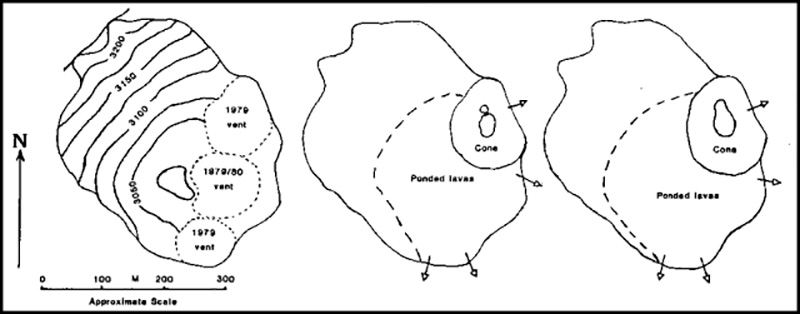 | Figure 15. Morphology of Southeast Crater before the 1984 eruption (left); contours are approximate, in meters above sea level. Morphology of Southeast Crater 11 September 1084 (center) and 1 October 1984 (right); dashed line indicates the approximate extent of ponded lava, arrows the direction of lava discharge. After Murray, J. B., 1982, Sommit del Mt. Etna, Settembre 1981, 1:5000 scale map, Ordnance Survey, Southampton, U.K. Courtesy of Christopher Kilburn. |
"Lava discharge was virtually continuous from ephemeral vents S and E of the base of the new cone. Lava flowed S, SE, and E over low points in the Southeast Crater rim. Activity typically alternated between the S and E vents at intervals of one to several days. The successive aa flows, few of which were longer than 1.5 km with frontal thicknesses rarely exceeding 5 m, created a compound flow field with an estimated area that approached 1.5 km2 by 1 October (figure 16). By 23 September, ponding inside the Southeast Crater had reached a maximum accumulated thickness of more than 45 m, raising the level of its bottom to ~3,065 m above sea level. Assuming a conservative average thickness of 5 m, and including the material within the Southeast Crater, a provisional estimate of the minimum volume of the flow field on 1 October is 8.5 x 106 m3, yielding a minimum average effusion rate of ~0.64 m3/s. Estimates of the eruption rate, made near the vent 17-28 September, were 0.5-1.0 m3/s for lava discharged toward the S. The chief uncertainties in these discharge rates are the velocity profiles across the flow surface and with depth, and the thickness of the flow; for the minimum value, parabolic velocity profiles and a flow depth of 3-4 m have been assumed, the maximum (central) surface velocity and lava channel width being estimated in the field.
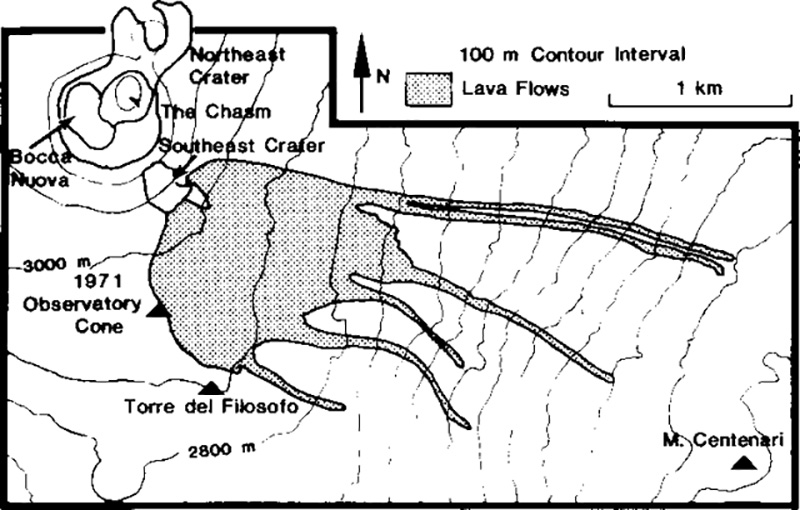 | Figure 16. Provisional sketch map of 1984 lava flows as of 1 October. Courtesy of Christopher Kilburn. |
"The Strombolian activity at Bocca Nuova was accompanied by the emission of large quantities of SO2-rich fumes. Until at least 24 September, magma was probably roughly 100-200 m below the W rim; observations were obscured by fumes. An apparently fresh bomb was found ~20-30 m from the NW rim 24 September, while others, up to 70 cm across, were seen being expelled toward the N and NW 28-29 September to a maximum estimated range of ~100-120 m. It is not known whether ejection of material outside the crater indicated a rise in level of magma within Bocca Nuova or an increase in explosive vigour due to changes in the physical state of the magma, notably in its vesicle content."
Information Contacts: R. Romano, IIV; C. Kilburn, Univ. of London; J. Murray, D. Decobecq, and C. Delmotte, Univ. Paris Sud; P. Briole, PIRPSEV; M. Matson, NOAA.
October 1984 (SEAN 09:10)  Cite this Report
Cite this Report
Earthquake swarm starts as lava production ends
After 172 days of activity, the eruption in the Southeast Crater stopped during the evening of 16 October, although activity continued at the Northeast and central craters. On 17-18 October, only violent ejections of ash at rather long intervals occurred from the small cone that had formed inside the Southeast Crater. The ash ejections stopped completely the morning of 18 October. During the last week of activity from the Southeast Crater, there was a gradual decrease in lava effusion, which was limited to vents along the S rim, and ash ejection from the small cone inside the crater. The lava flows were directed mainly toward the SE, generally stopping after only a few hundred meters.
"During the late morning of 16 October, strombolian activity began from a vent at the bottom of The Chasm. Activity was extremely violent during the evening. At times, lava fragments were ejected above the crater rim, falling back within a 100-m radius. The strombolian activity diminished during the night but continued, with alternating phases, through 17 October. During the morning of 18 October, the crater was obstructed by consolidated lava. It reopened 25 October with the ejection of old lava and ash, and more or less intense emission of gas has continued since then. Bocca Nuova alternated phases of slow emission of gas with periods of intense emission of vapor mixed, at times, with mainly reddish ash.
"Ejections of vapor mixed with reddish ash that had started at the beginning of September from the Northeast Crater intensified during the final phase of the Southeast Crater eruption. During the night of 19 October, weak strombolian activity from the Northeast Crater was recorded at irregular intervals. This activity was succeeded by almost continuous ejection of dark ash, followed during the night of 21 October by the collapse of the crater's summit area. This enlarged the central part of the crater and ejected old lava to a distance of about 500 m, mainly toward the W. Discontinuous and more or less intense emission of vapor mixed with reddish ash started 21 October from this crater, while continuous emission of dense white vapor occurred from a small vent to the N.
"During the afternoon of 16 October a seismic crisis began, with earthquakes mainly occurring in the middle and upper parts of the E flank. The strongest shocks (M ~3.5-4.5), which were felt, were all shallow (around a few kilometers)."
A few of the largest earthquakes in the swarm are described below. Date, time, epicenter, and some casualty and damage data are from Romolo Romano; intensity values and the remaining casualty/damage information are from press sources.
18 October, 1258: centered near Piano Pernicana (15.5 km NE of the summit): Intensity reached MM V-VII, causing ground fracturing and some cracking of roofs and walls.
19 October, 1843: centered near Zafferana Etnea (11.5 km SE of the summit): 1 person was killed and others injured. Intensity reached MM VII-VIII. More than 400 buildings were damaged, including 50% of the historic district, and about 500 people were left homeless. Damage also occurred in Milo (11 km ESE of the summit), Fornazzo (10.5 km E), Santa Venerina (14 km SE), and Giarre (16.5 km ESE).
25 October, 0211: centered near Fleri (14 km SE of the summit), where it reached MM VIII, injured 12-15 people, destroyed 80% of the houses, and left 900 homeless. Ground cracking was observed in the area. Mt. Ilice, a 350-m-high prehistoric cone roughly 1.5 km upslope from Fleri, lost about 20 m of height during the earthquake. The shock was also felt in Catania.
7 November, 0956, centered near Pedara (15.5 km SE of the summit), where a few buildings were damaged.
Information Contacts: R. Romano, IIV; La Stampa, Torino; Corriere della Sera, Milano.
November 1984 (SEAN 09:11)  Cite this Report
Cite this Report
Occasional ash emission; flank seismicity continues
No major eruptive activity has occurred since the Southeast Crater eruption ended in mid-October. From the Northeast Crater, emission of white vapor was more or less continuous and consistent. Sporadic expulsions of reddish ash were observed 27 November and 3 December. Ejection of mainly reddish ash observed at Bocca Nuova was particularly violent 22-24 November. Ash ejected 23 November was mainly dark in color, but on succeeding days was mostly reddish older material that had fallen into the conduit. Ash fell on the lower SE flank. Only weak emission of gas and vapor occurred from The Chasm.
Flank seismicity began as the Southeast Crater eruption ended in mid-October (09:10). Isolated tremors continued in November. Both felt and located events were mainly on the N and NE flanks. No additional damage was reported.
Information Contacts: R. Romano, IIV.
February 1985 (SEAN 10:02)  Cite this Report
Cite this Report
Seismicity, then Strombolian activity and lava flows from Southeast Crater; ashfall on coast towns
Weak strombolian activity started 8-9 March in the Southeast Crater. Lava began to flow from the Southeast Crater the morning of 10 March and advanced E (toward the Valle del Bove), stopping that night as feeding ended. Mudflows were also observed in the Valle del Bove; heavy rains had caused flooding in Sicily during the previous week. On 11 March, fissures opened on the upper S flank (in Piano del Lago Alto). The press reported that temperatures in some of the fissures were high enough to melt plastic at nearby cable car stations. Ash fell on the towns of Acireale and Fiumefreddo (~20 km SE and 20 km ENE of the central crater). During the morning of 12 March, lava emerged from vents that opened at progressively lower elevations (from 2,620 to 2,500 m above sea level) and flowed S and SSW, reaching 2,250 m elevation by the next morning. Numerous mudflows preceded the lava flows.
An 11 March newspaper article citing the National Institute of Geophysics reported that microtremors with epicenters in the W part of the Valle del Bove had been recorded for the past few days. A M 3.4 event near the central crater occurred 9 March at 1523, and a shock with a focus at 5 km depth was felt 10 March at 1101 in the towns of Linguaglossa, Milo, and Sant Alfio (16 km NE, 11 km ESE, and 13 km E of the central crater). No magnitude was reported for the 10 March earthquake but both events were said to reach MM IV-V intensity.
Information Contacts: R. Romano, IIV; Il Progresso, New York; Corriere della Sera, Milano, UPI.
March 1985 (SEAN 10:03)  Cite this Report
Cite this Report
S-flank fissure eruption preceded by seismicity and tilt
The following is a report from Romolo Romano. Additional information about the eruptive activity from French volcanologists has been inserted in parentheses in this section. Their report of seismicity and tilt associated with the eruption is presented below.
"Explosive and effusive activity occurred 8-10 March from the Southeast Crater (French volcanologists noted that a strong but short-lived phase of the Southeast Crater activity started 10 March at 1100, with vigorous lava fountaining and overflow of lava toward the Valle del Bove). After numerous fractures formed 11 March on the upper S flank between 3,000 and 2,600 m above sea level, an exclusively effusive vent opened 12 March at 2,620 m elevation, with no recorded seismic activity. The same day, three more effusive vents opened at lower elevations (2,600, 2,510, and 2,490 m); only the last two (near Piccolo Rifugio) remained active. The lava flows that originated from these vents moved mainly toward the S and SW, giving rise to numerous individual lobes. Near the vent at 2,510 m elevation, weak explosive activity occurred, soon creating several small spatter cones and hornitos.
"On 14 March, the lava flows moving S destroyed two Etna cableway pylons; the cable broke the next day. The longest flow stopped 15 March at 2,080 m elevation. Along this trend, superposing lava flows were noted during the following days, until the effusive activity from the vent at 2,490 m ceased on 23 March.
"The lava flows that moved SW created an extensive lava field (maximum width 500 m). At 2,100 m elevation the lava field split into at least five lobes. The longest (and easternmost) flow had descended to 1,850 m elevation by 4 April, covering a distance of ~3 km.
"As of early April, the main lava channel had become a lava tubelava tube between 2,450 and 2,300 m above sea level. Short-lived effusive vents opened near the lower end of the tubelava tube, with lava flows approaching the E side of the lava field or flowing over it. The velocity of the lava flows varied from a few meters per hour to ~30 m/hour. The surface covered by the lava can be estimated at around 2.5 km2 and the volume of lava at ~12 x 106 m3. The temperature of lava at the vents was around 1,050°C.
"Particularly during the first few days of the eruption, because of the snow cover, several mudflows formed ahead of the lava flows. Phreatic explosions, violent at times (25 March) were also observed. During the eruption, more or less vigorous emission of vapor, gas, and rarely ash occurred from the central crater vents. (French volcanologists reported a strong explosion from the Chasm on 1 April at about 1625). Isolated expulsions of dark ash from Northeast Crater were observed.
"Collection of information on the eruptive activity was possible thanks to the cooperation of the following Italian Alpine Club rescue team guides and volunteers: G. Baglio, A. Cariola, A. Cristaudo, C. Ferlito, A. Nicotra, G. Puglisi, and F. Zipper."
Later newspaper reports described a swarm of about 30 earthquakes, some reaching intensities of MM IV-V, that started 7 April and continued until early on the 9th. The events were felt most strongly in the towns of Santa Venerina, Acireale, and Giarre (14.5 km SE, 20 km SE, and 17 km ESE of the central craters). After the swarm, the rate of lava production increased by a factor of about 1/3.
The following report, on activity monitored through the ARGOS system, is from PIRPSEV, CNRS-INAG, in the context of French-Italian cooperation.
"Two geophones and a Blum pendulum inclinometer, connected with ARGOS for telerecording of the data, operate near the summit (TDF) and on the south flank (SLN) (figure 17). The geophones record both earthquakes and pulses of volcanic tremor as seismic events, and appear to be good indicators of seismic activity linked to volcanism. The eruption was preceded by an increase in seismic activity (mainly tremor energy) as indicated by the two geophones (TDF and SLN, figure 18). However, after the Southeast Crater eruption, the tremor energy returned to very low levels (figure 19), although effusive vents subsequently opened on the S flank.
 | Figure 17. Sketch map of the summit and south flank of Etna, showing locations of geophones at Torre del Filosofo (TDF) and Serra la Nave (SLN), and orientation of the tiltmeter at SLN. |
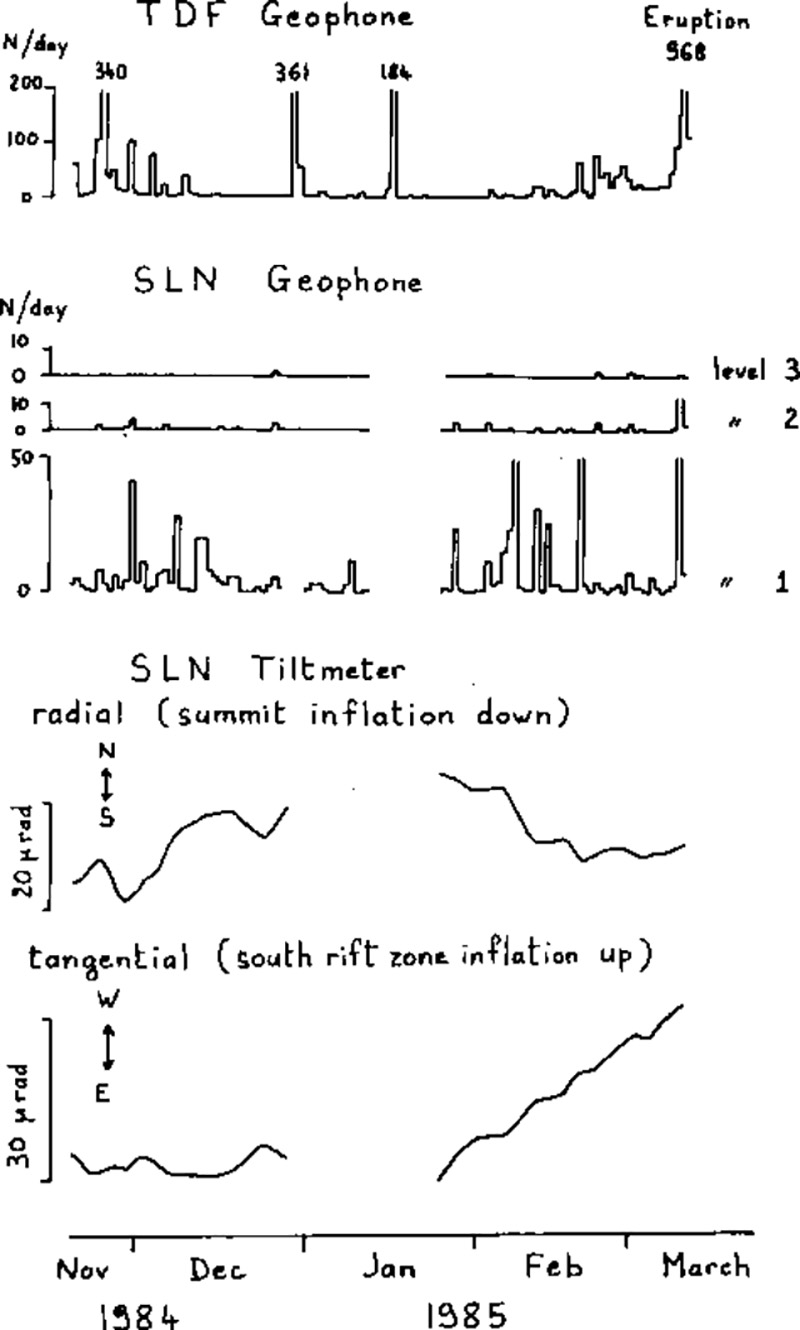 | Figure 18. Seismicity (number of events per day), top, and tilt, bottom, preceding the 10 March eruption, recorded by the geophones at TDF and SLN, and the SLN tiltmeter. The TDF geophone detection level is 6µm/sec, the three SLN levels are 1.8, 9, and 45 µm/s. |
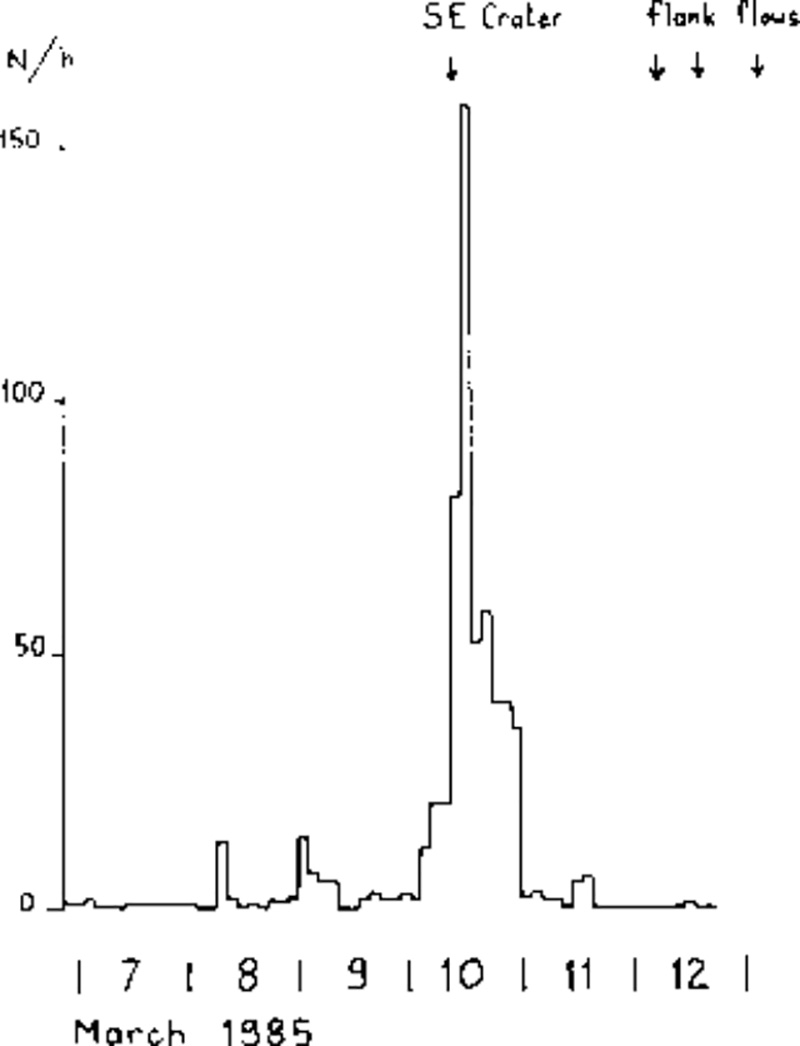 | Figure 19. Number of events per hour recorded by TDF geophone, 7-12 March 1985, showing a strong increase during the Southeast Crater eruption. Arrows at top indicated that eruption and the production of flank lava flows. |
"The SLN inclinometer showed continuous tilt toward the WSW during early February, consistent with inflation on the site of the 1983 (and March 1985) eruptions (figure 18). Since mid-February, however, tilt has been mainly westward (figures 20 and 21), thus indicating inflation lower on the S rift zone. This change appears almost synchronous with the appearance of new frequencies of volcanic tremor (personal communication by S. Gresta)."
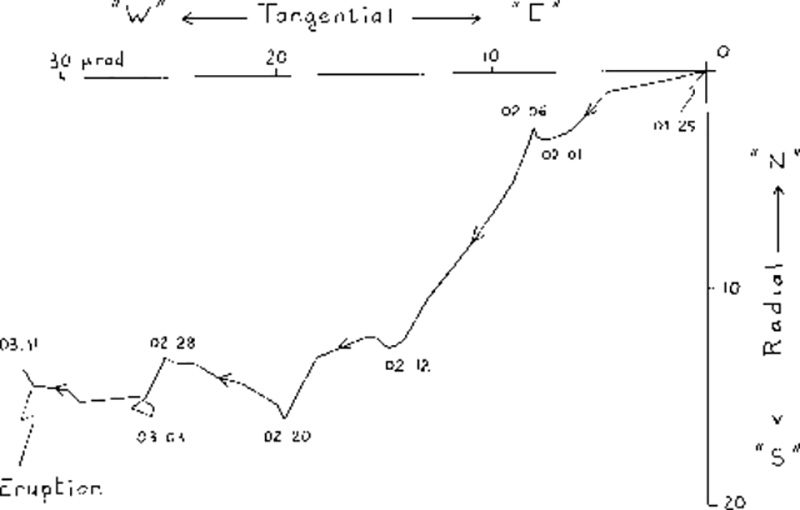 | Figure 20. Tangential vs. radial component of the SLN tiltmeter, 25 January- 11 March 1985 (S rift zone inflation westward, summit inflation southward). |
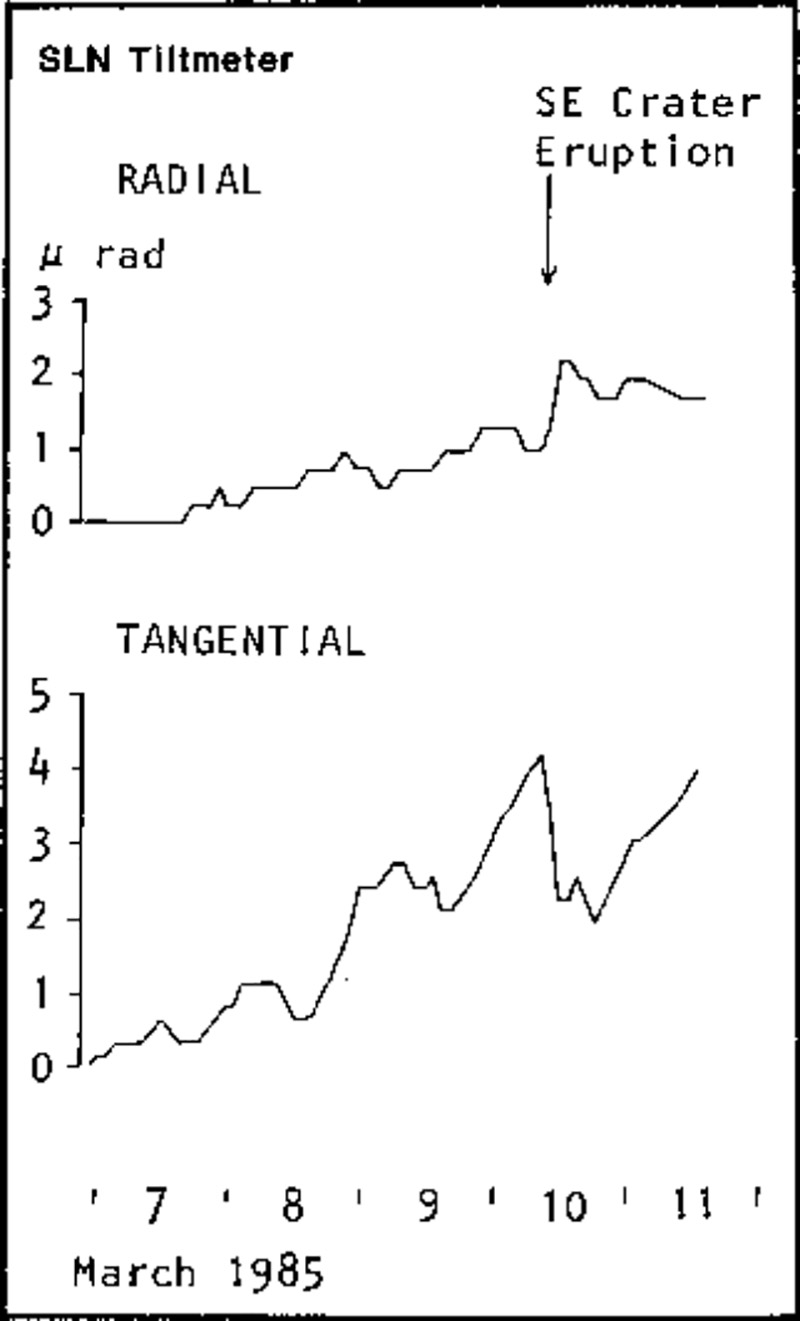 | Figure 21. Small changes in tilt accompanying the Southeast Crater eruption, as recorded by the SLN tiltmeter, 7-11 March. |
Information Contacts: R. Romano, IIV; C. Archambault and C. Pambrun, CNET/PIRPSEV; P. Blum, IPG/PIRPSEV; P. Briole, IIV/IPG/PIRPSEV; G. Kieffer, Centre de Recherches Volcanologiques, Clermont-Ferrand/PIRPSEV; J. Tanguy, PIRPSEV; La Stampa, Torino.
April 1985 (SEAN 10:04)  Cite this Report
Cite this Report
South-flank lava production continues; tremor energy increases
"The S flank activity that began 12 March was continuing in early May. During April, the main lava channel was transformed to a continuous lava tube (with at least three 'windows') from 2,510-2,320 m elevation. Around 2,300 m elevation numerous ephemeral effusive vents formed, variable in number and location, from which several lava flows originated and advanced over the lava field or along its E edge.
"The lava flows, directed mainly SE, S, and SSW, have not advanced much, generally stopping at 2,150-2,050 m above sea level. The lowest elevation reached during this period was 1,950 m (20 April). At times (19 and 21 April and 6 May), because of an increase in the production rate, lava overflows occurred following roof collapses in the upper parts (2,510 and 2,485 m elevation) of the lava tube, giving rise to small lava flows of short duration.
"No gas emission was noted from the mid-April hornitos. More or less intense emission of gas and vapor continued from both of the central crater vents; ash emission was very rare. The Northeast Crater generally emitted vapor and rarely (10 April and 9 May) ejected reddish ash.
"The surface covered by lava can be estimated at around 3 km2 and the volume at ~20 x 106 m3. In this period there has been almost a total absence of earthquakes. However, during the week of 8-14 April, 20 shocks with magnitudes less than 3 were recorded. Afterwards, a variation in the main spectral peaks of the tremor was observed. A gradual increase in the tremor energy was observed during the entire month of April (S. Gresta, personal communication).
"The Etna Guides and volunteers from the Italian Alpine Club rescue team cooperated in the collection of information about eruptive activity."
Information Contacts: R. Romano, IIV.
May 1985 (SEAN 10:05)  Cite this Report
Cite this Report
Lava flows toward SW and SE; strong gas and vapor emissions
"The eruption continued through May without significant changes from last month. The main lava channel has been transformed into a lava tube, between 2,510 and 2,320 m elevation, that has at least four windows through which it was possible to see the lava flow. The lava has maintained a constant velocity during the last few weeks. On 23 May another lava overflow occurred as a result of roof collapse along the upper portions of the lava tube (2,485 m elevation), generating small lava flows of brief duration.
"The numerous short-lived vents inside the lava field (from 2,320 to 2,150 m elevation) were variable, as usual, in number and position. The lava flows that originated from these short-lived vents have increased the size of the lava field on both the W and E sides to a maximum width of ~1.5 km.
"Beginning 10 May the lava moved mainly toward the SW (Monte Rinatura and Monte Nero). Around the beginning of June there were numerous lava flows toward the SE (1910 craters area). Lava continued to flow toward the south (Monte Castellazzi area), but these flows were not strongly fed. None of the lava flows descended below 2,000 m elevation.
"The more or less intense emission of gas and vapor from both vents of the central crater and from the Northeast Crater continue. Emissions of ash are rare and inconsistent. Gas under pressure emerged from a small opening at the southern base of the 1984 cone inside the Southeast Crater (P. Briole, personal communication). R. Clocchiatti conducted temperature measurements with a thermocouple; the temperature ranged between 1053°C and 1,088°C (CEN-SACLAY).
"M. Cosentino and G. Lombardo reported that no particular seismic activity was recorded. Instead, an increase in the average amplitude of harmonic tremor was noticed, probably connected to the degassing of the central and Northeast craters.
"The Etna guides and rescue volunteers from the Italian Alpine Club (A. Cristaudo and A. Nicotra) helped with information on the activity."
Information Contacts: R. Romano, IIV.
June 1985 (SEAN 10:06)  Cite this Report
Cite this Report
Continued S-flank lava production
"After a brief period of quiescence from 11-13 June, the eruption continued. Only one effusive vent remained active (2,485 m elevation) with major lava flows originating from it. From 9 to 11 July, following a brief increase in activity, four effusive vents were present at high elevation (2,490-2,480 m). The velocity of the lava produced in this period ranged from 20 to 7 cm/s, volume 2.5 to 0.5 m3 /s.
"The directions of the lava flows were mainly toward the S, SSE, and SE. In the last few weeks, lava flows of significant size were also present, and were directed toward the SSW, S, and SW. The short-lived vents were still present and numerous, scattered on the lava field from 2,350 to 2,250 m elevation. As usual, they varied in number and location. Recently, the lava field enlarged on the E side, but the lava flows have not descended below 2100 m elevation. The emission of gas continued and was sustained from the central craters, and the Southeast Crater. At times, expulsion of generally reddish ash from Bocca Nuova was noted. From the Northeast Crater, violent expulsions of old material (28 June), and emission of reddish ash (10 July) were observed.
"The temperature of the lava flow at the main effusive vent was around 1,080°C (P. Briole). During this period seismicity remained at low levels. On 12 June at 1848, a seismic event (M 2.5) with an epicenter in the lower E flank (14 km depth) was recorded. On 7 July, three events of low magnitude (<2.8) with epicenters on both the E and W flanks were also recorded.
"On 9 July at 0430, the amplitude of harmonic tremor increased abruptly, coinciding with the increase in effusive activity. During the following 24 hours, the amplitude of the harmonic tremor returned to normal levels (communications with M. Cosentino and G. Lombardo). The Etna guides and rescue volunteers from the Italian Alpine Club have cooperated in the collection of information."
Information Contacts: R. Romano, IIV.
July 1985 (SEAN 10:07)  Cite this Report
Cite this Report
Four-month eruption ends in mid-July
"The eruption ended 13 July. The first phase (12 March-11 June) lasted 92 days, the second phase (13 June-13 July) lasted 31 days.
"The effusive activity that had shown new strength during the last days of the eruption greatly diminished on 12 July. Only one main effusive vent at 2,490 m elevation and two short-lived effusive vents in the lava field (at 2,300 and 2,600 m) remained active. The flows from the upper vent never descended below 2,400 m elevation and those from the lava field vents never below 2,100 m. From preliminary estimates, the area covered by lava was ~2.2 km2 and volume of lava produced was ~30 x 106 m3. The maximum width of the lava field is 1.5 km, the maximum length of flows, 1,830 m (figure 22).
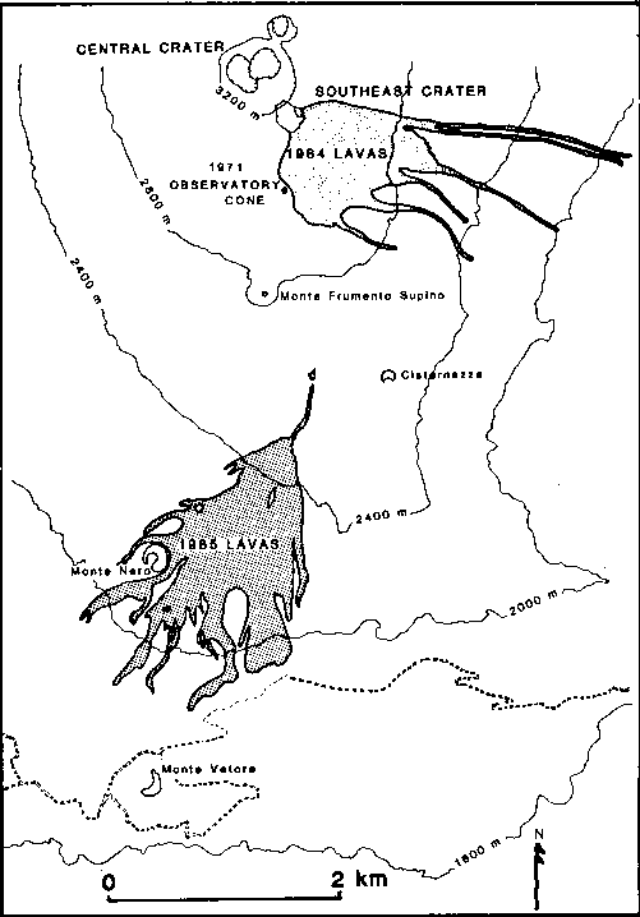 | Figure 22. Preliminary map of 1985 lava field and its relation to the 1984 lavas. Data, provided by Romolo Romano, is provisional and subject to revision. "Bocca Nuova had a relatively sustained gas emission. Inconsistent expulsions of reddish ash were also observed. This activity was related to explosive activity on the floor of the vent (~300 m below the rim), and was limited to the collapse of the vent's internal walls. The Chasm produced only weak gas emission. Collapses of the walls of the Northeast Crater were observed, and starting 22 July, this crater was partially obstructed, with emission of gas under pressure. Except for the isolated seismic events felt in the upper part of volcanic on 19 and 20 July (M 2.8) and 22 July (M 3), the seismicity remained at low levels. [Originally published in SEAN 10:08, without accompanying text.] |
Information Contacts: R. Romano, IIV.
December 1985 (SEAN 10:12)  Cite this Report
Cite this Report
SE-flank fissure eruption follows seismic swarm and deformation
Eruptive activity. (Romolo Romano) "Strombolian activity started from the Southeast Crater on 19 December. The activity occurred at irregular intervals, becoming increasingly intense and continuous in successive days. Since the end of the 12 March-13 July 1985 eruption, more or less intense strombolian activity had been observed from several explosive vents (variable in number and position) on the floor of Bocca Nuova at variable depths (from 100 to 300 m or more from the rim of the vent).
"On 25 December at 0340 an eruptive fissure opened on the W side of the Valle del Bove (on Etna's SE flank), beginning at 2,750 m above sea level. The opening of this E-W-oriented fissure was preceded by a seismic crisis (see below). Strombolian activity soon started along this fissure from at least three explosive vents, while a lava flow began from the lower end of the fissure, covering, in a period of 18 hours, a distance of 1.5 km. The lava flow stopped at a point NE of Monte Centenari, at about 1,700 m elevation, within the Valle del Bove. Eruptive activity from the fissure stopped early the next morning. Activity resumed from the same place early 28 December. This second eruptive phase was characterized by weak strombolian activity from the three explosive vents, and created small spatter cones. The effusive activity decreased; a very viscous lava flow moved ~300 m from the origin, branching at ~2,600 m elevation. The eruptive phase ceased during the early morning of 31 December. A violent expulsion of ash and lapilli from the summit craters (E and W vents of the central crater, Southeast Crater, and Northeast Crater) during the first hours of the eruption was succeeded by more or less continuous and consistent emission of reddish ash.
"The Etna Guides (S. Carbonaro, O. Consoli, A. Mazzaglia, A. Nicotizza, and volunteers of the Alpine Rescue Team of the Italian Alpine Club (A. Cristaudo) have collaborated in collecting information about the eruptive activity.
Seismic activity. (M. Cosentino, M. DiFrancesco, and E. Lombardo) "A seismic crisis began during the early morning of 25 December with shocks located mainly between Piano Provenzana (NE flank) and the Valle del Bove. The shocks were very shallow (2 km or less). At the same time, the amplitude of harmonic tremor increased sharply. The shock that destroyed the hotel Le Betulle at Piano Provenzana, killing one person and injuring seven others, occurred on 25 December at 0338 and had a magnitude of 3.5. During the following 48 hours, about 200 more tremors with magnitudes of 1-4 were recorded. The strongest, M 4, occurred on 26 December at 0334, with its epicenter at Piano Provenzana. Focal depths were 2-3 km. The area of the epicenters remained between Piano Provenzana and Valle del Bove. Beginning 27 December, seismicity decreased in frequency, energy, and number of events, and stabilized to values of ~5-6 shocks/day. Their location was mainly in the eruptive area and on the E and W flanks (especially in early January). Similar activity was continuing on 10 January."
Newspapers reported that continuing seismicity included an event on 12 January at 0037, centered in the Zafferana Etnea area (11 km SE of the summit), that reached MM 6 and damaged some buildings. At least 3-4 minor shocks (one of MM 3) were felt the previous day.
Ground deformation. (G. Nunnari and R. Velardita) "During the second half of December, the tilt stations (Pizzi Deneri, NE flank, elevation 2,850 m; and Serra Pizzuta Calvarina, S flank, elevation 1,650 m) recorded a progressive inflation of the upper E flank. At the Pizzi Deneri station the variation was 13 µrad radially and 22 µrad tangentially between 20 December at 0900 and 23 December at 0900. The same stations recorded a variation of 45 µrad radially and 42 µrad tangentially between 24 December at 0900 and 25 December at 0900. The deformation produced during the first hours of 26 December reached a level that remained substantially unchanged as of 10 January."
Information Contacts: R. Romano, G. Nunnari, and R. Velardita, IIV; M. Cosentino, M. DiFrancesco, and G. Lombardo, Ist. di Scienze della Terra, Catania; La Stampa, Torino.
January 1986 (SEAN 11:01)  Cite this Report
Cite this Report
Strong flank seismicity
Seismicity has continued since Etna's SE-flank fissure eruption in late December. The following is from R. Romano. "Beginning 1 February, a series of shocks occurred on all ... flanks (table 2). The most energetic events occurred 1 and 2 February ~ 15 km SE of the summit (in the Dagala zone, in the area of Santa Venerina and Linera), with magnitudes between 3.0 and 3.6 and depths within 1 km. During the week, 50 shocks were also recorded by instruments, mainly on the E flank."
Table 2. Largest of a series of earthquakes on Etna's flanks, February 1986.
| Date | Location | Distance from summit | Magnitude | Depth |
| 3 Feb 1986 | E of S. Pizzuta | -- | 3.0 | 1 km |
| 4 Feb 1986 | Between Linera and Guardia Mangano | 16 km SE | 2.5 | 1 km |
| 5 Feb 1986 | E of Mt. Pomiciaro | 15 km NE | 3.2 | 16 km |
| 6 Feb 1986 | N flank, E of Malvagna | -- | 3.1 | 4 km |
| 7 Feb 1986 | Between Mt. Pomiciaro and Linguaglossa | 15 km NE | 3.0 | 16 km |
Information Contacts: R. Romano, IIV.
February 1986 (SEAN 11:02)  Cite this Report
Cite this Report
Ash and bombs from Northeast Crater
While spending the night of 5 March at the foot of Northeast Crater, geologists observed ash emission every 5-15 minutes with ejection of glowing red bombs 6-7 times/hour. Bombs reached the base of the crater. Significant degassing occurred from both of the central craters (The Chasm and Bocca Nuova). However, there were no explosions, nor was glow visible at night.
Information Contacts: F. LeGuern, CNRS; Compagnie Republicaine de Securité de Briancan.
May 1986 (SEAN 11:05)  Cite this Report
Cite this Report
Strombolian activity and gas emission
Explosive activity has continued from both central crater vents since the end of the SE flank fissure eruption. Strombolian activity could be seen from within ~ 100 m of the W vent (Bocca Nuova) rim, but ejected lava fragments rarely rose above the crater rim. Active vents within Bocca Nuova varied in position and number. Since the end of April, a vent on Southeast Crater has emitted hot pressurized gas. Northeast Crater has been partially obstructed by internal landslides; weak fumarolic activity occurred along the crater walls.
Information Contacts: R. Romano, IIV.
September 1986 (SEAN 11:09)  Cite this Report
Cite this Report
Strombolian activity and lava flow, then strong explosion
Strombolian activity and lava production, late July-23 September. Strombolian activity began from Northeast Crater at the end of July and continued with periods of greater (19 August) and lesser intensity. In early September, 20-30 explosions occurred/minute, with ejection of bombs and scoria to 100-250 m above the vent. A scoria cone ~ 40 m high formed inside the crater. Strombolian activity increased in the late afternoon of 13 September, and lava overflowed Northeast Crater's W rim early the next morning, feeding a modest-sized lava flow that moved NW. By 16 September, the flow had descended to 2,920 m altitude (~ 1.5 km from the main effusive vent at 3,190 m altitude) after crossing a trail (maintained by the Società Turistica Star). During the following days, small lava flows advanced a few hundred meters NW, NNW, WNW, and W, beside or on top of the first flow. This slow and discontinuous activity built a small lava field, with a volume that was estimated at a maximum of 0.25 x 106 m3. On 22 September, the temperature of the flowing lava near the vent was 1,094°C at 40 cm below its surface. During the effusive phase, Strombolian activity varied in strength but generally remained at rather low levels. While sampling high-temperature gases and measuring oxygen fugacity on 22 September, Patrick Allard and others noted that the floor of the crater oscillated, rising by as much as 1 m with every explosion. During a summit-area leveling traverse the next day, a very strong tremor made automatic level readings difficult. Strombolian activity increased considerably, with bombs rising to 200 m above the vent and falling 300 m away. Strombolian activity also occurred at the bottom of the E and W vents (The Chasm and Bocca Nuova) of the central crater. This activity was of variable intensity, with changing numbers and locations of vents. Only rarely were lava fragments ejected above the vent rims.
Cessation of activity, early 24 September. During the early morning of 24 September, the scoria cone and a portion of the wall inside Northeast Crater collapsed into the vent area, leaving a fuming pit ~50 m deep. Effusive and explosive activity ended almost immediately, between 0600 and 0700. That morning, activity was limited to expulsions of reddish ash and white vapor. Steaming fissures and a small graben (~ 1 m wide and 1 m deep in places, wider nearest the crater) opened to the SW and NE (figure 23), with fissures reaching the Valle del Leone (1.5 km ENE of Northeast Crater) and the Piano delle Concazze, 2 km to the ENE. Activity from Bocca Nuova had also ceased. A leveling team in the summit region and N of Northeast Crater detected some intermittent tremor and measured substantial deflation that had occurred since the previous day.
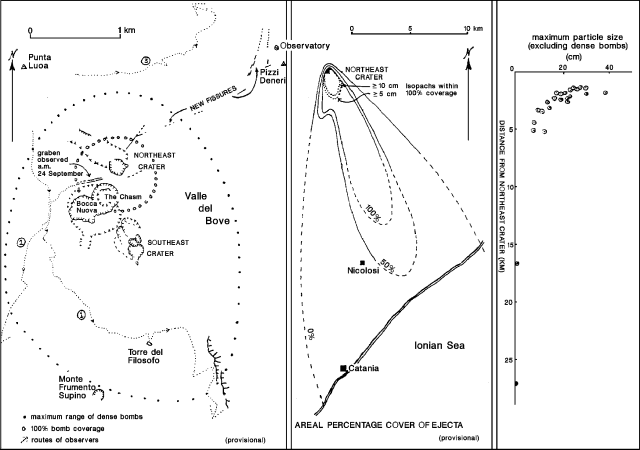 | Figure 23. (left) Sketch map of Etna's summit area, showing the new fissures and graben of 24 September and the area of 24 September bomb fall. Numbers along the route taken by observers show positions of (1) Allard, Benhamou, and Pennisi; (2) Bond, Décobecq, Kilburn, Murray, and Obreski; and (3) Sagot. (center) Provisional sketch map showing depth and percentage of ejecta cover after the 24 September explosion. (right) Maximum particle size with distance from Northeast Crater. Courtesy of J. Murray, C. Kilburn, D. Décobecq, and A. Bond. |
Because of the abrupt cessation of summit activity and the possibility of violent vent-clearing explosions, the summit area was closed to tourists.
Resumption of explosive activity, afternoon of 24 September. A prolonged period of ash ejection accompanied by thunder and lightning started at about 1215, causing a light ashfall on the upper SE flank (figure 23). At 1312, large dark ejecta were seen rising to ~ 40-50 m above the vent, with stronger expulsion of small brown ash clouds, but no discrete explosions were heard. Episodic eruptions continued for the next 3.5 hours. Periods dominated by quiet emission of pink-brown ash alternated with periods characterized by ejection of black cypressoid and columnar ash jets, and expulsion of large tephra to ~200-350 m above the vent (figure 24). Electric discharges were common. Thick white convecting vapor clouds emerged separately from the S part of the vent area, at increasing rates. Continuous tremor and occasional stronger shocks were felt after 1515 by a gas sampling team working ~ 200 m S of Northeast Crater. There was no apparent time relation between the seismicity and eruptive activity.
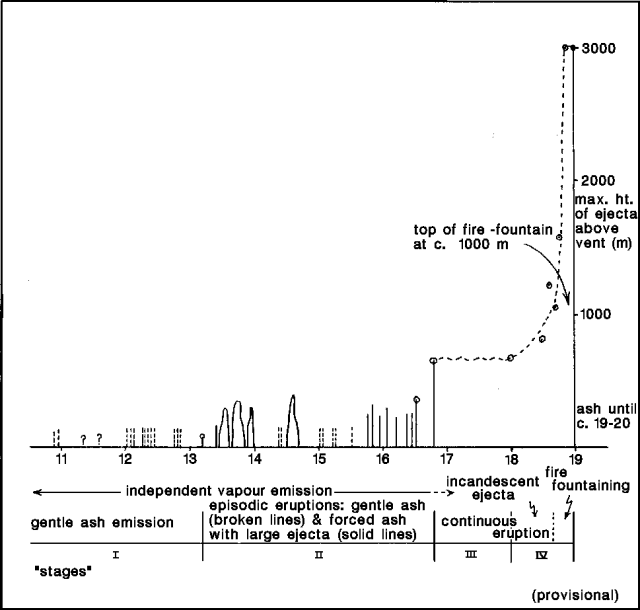 | Figure 24. Evolution of activity from Etna's Northeast Crater on 24 September. Courtesy of J. Murray, C. Kilburn, D. Décobecq, and A. Bond. |
The following preliminary observations have been extensively updated by J.B. Murray.
Ash emission began to increase gradually at about 1645, changing to violent phreatomagmatic explosions. Black clouds, again cypressoid and columnar, initially rose to 400 m above the vent, merging by 1743 to produce a convective cloud that reached a relatively consistent height of ~ 1,000 m. Stronger falls of ash and small lapilli occurred SE of the summit, and bombs reached heights of 600-700 m. No [sounds] were heard, [apart from frequent dry cracks of] electrical discharges in the cloud [and the rushing of air in the rising column]. Incandescent ejecta were first seen at about 1800, and within 40 minutes lava fountains had developed at the center of a much wider column of dark ash. Heat from the fountains could be felt from a distance of ~ 800 m. ... Between 1815 and 1843, bombs fell progressively farther SW from the vent, with maximum ejection distance increasing from ~300 to 700 m, and maximum heights building from ~600 to 1,500 m.
Paroxysmal explosion, evening of 24 September. The paroxysmal phase began about 1845 with continuous louder rumbling and the sudden rise of a vertical lava fountain, ~ 300 m across, to 800-1,000 m. A dense black cloud surged down the E flank of Northeast Crater into the Valle del Bove. [Dense bombs up to 50 cm in diameter fell as far as 2,700 m to the SW, suggesting to Murray that they reached 2-3 km height]. ... The eruption cloud moved SSE, and ... the tephra fallout [rapidly] advanced ~2 km, showering observers [fleeing in vehicles] on the S flank (near the Torre del Filosofo; figure 23) with a dense blanket of ... scoria and ash [with occasional heavy bombs falling from 2-3 km height]. In a short time, the entire SE flank of the volcano was covered by pyroclastic material of sizes that varied with distance from the vent (figure 23). [Differential winds at higher altitude carried some scoria SW as far as Biancavilla (~ 15 km SW), where fragments measuring a few cm fell]. Tephra fall continued for almost 20 minutes.
[Subsequent topographic mapping] showed that pyroclastic material (scoria, lava fragments, and lithic blocks) [reached 4 m thick near the edge of Northeast Crater, and 5 cm thick] at a distance of 2 km (Torre del Filosofo). Scoria and lithic blocks up to a meter in diameter could be found within a radius of 0.5 km; at 2 km, scoria a few tens of centimeters across were observed. Hot scoria 11 cm in diameter melted roof tar 4 km S of the crater (at Piccolo Rifugio); hot lapilli to [7.5] cm across [scratched car windshields at] the tourist complex around Rifugio Sapienza and the base station of the cable car system 6 km from the vent; some scoriae as large as 15 cm were found 7 km from Northeast Crater at 1,700 m altitude (Serra La Nave); and 1.9-[cm] lapilli fell at Nicolosi (17 km to the SSE). Lapilli [0.5 cm in size reached Catania, 27 km away, where light ashfalls also occurred]. Catania airport (35 km from the summit) was closed from that evening until late the next morning.
[Bond, Décobecq, Kilburn, Murray, and Obreski] estimate that the tephra column reached 10-13 km altitude during the paroxysmal phase, in agreement with an independent estimate by Mueller [from Nicolosi. However, photos by J.P. Delouche, approaching the volcano from Siracusa, show maximum column height to be 6-7 km above the summit (9-10 km altitude)]. The press reported that the tephra column was visible from the Aeolian Islands (95 km N), and Agrigento (100 km WSW). At [1900] on 24 September, the explosive activity ceased completely. During the following days, Northeast Crater slowly emitted gas, vapor, and (rarely) reddish ash.
[Nearly 200 depths measured by Murray, Décobecq, and Bond yield a tephra deposit volume of 2.6 x 106 m3, mostly of pumice density, or 0.4 x 106 m3 dense rock equivalent (DRE)]. The volume of material emitted was estimated by IIV geologists at around a few million cubic meters ... . If most of the tephra were assumed to have been erupted during the final phase, the mean paroxysmal eruption rate was [~500] m3 DRE/s (2.7 x 106 kg/s). Kilburn notes that the independently determined values for eruption rate and column height are consistent with the column height model of Wilson et al., 1978. Total energy release was [~9 x 1021] ergs. Vigorous explosive eruptions are relatively uncommon at Etna; [this century only four comparable events have occurred, in 1917, 1940, 1947,and 1960].
Minor activity, late September-early October. Strombolian activity from the two central crater vents, which ended 24 September with the collapse in Northeast Crater, resumed on the morning of 29 September. Gas, at times under pressure, was also emitted from Southeast Crater and a nearby gas vent before, during, and after the paroxysmal explosion. Emission of gas with fragments of old lava and/or incandescent lapilli was observed at times. The frequency of these ejections was very irregular, varying from a few minutes to several hours. As of 9 October, no significant changes in the activity of the summit craters have been noted.
Seismicity. Beginning 13 September, the seismic activity consisted only of explosion earthquakes probably related to the onset of the increased Northeast Crater activity. During the night of 22 September, three isolated seismic shocks with a maximum magnitude of 2.9 were recorded on the NW flank. Minor shocks were recorded until the night of 2 October, when a swarm of 30 events (maximum magnitude 3.3) occurred on the lower NW flank (between Maletto and Randazzo) at variable depths of ~ 20 km. A second swarm started during the morning of 5 October, again on the W flank, at the same depth. The strongest shock (M 3.8) occurred at 1228, and was felt at numerous locations on the volcano. The swarm ended that night, after ~ 40 weak shallow events were recorded on the W flank (Monte Minardo area). Another swarm of ~ 10 shocks occurred the morning of 7 October, also on the W flank, with a maximum magnitude of 3.3.
Harmonic tremor increased during the first phase of Northeast Crater eruptive activity (13 September). Similar tremor energy values were observed until ~ 5 hours before the 24 September eruptive event, when tremor energy began a gradual increase of about an order of magnitude. Energy values returned to normal around 2000 and no significant variations occurred in the following days.
Reference. Wilson, L., Sparks, R.S.J., Huang, T.C., and Watkins, N.D., 1987, The Control of volcanic column heights by eruption energetics and dynamics: JGR, v. 83 p. 1829-1836.
Further References. Amore, C., Giuffrida, E., Scribano, V., Lowenstern, J., and Müller, W., 1987, Emplacement and textural analysis of some present-day pyroclastic deposits of Mt. Etna (Sicily): Boll. Soc. Geol. It., v. 106, p. 785-791.
Murray, J., Décobecq, D., and Bond, A., 1989-90, L'Eruption paroxysmale du cratère Nordest de l'Etna du 24 Septembre 1986: LAVE Bulletin, no. 22, p. 11-23; no. 23, p. 5-18; and no. 24, p. 11-21.
Information Contacts: R. Romano, G. Budetta, T. Caltabiano, D. Condarelli, O. Consoli, and E. Lo Giudice, IIV; G. Luongo, IIV and OV; G. Ricciardi and G. Forgione, OV; S. Gresta, Univ di Catania; R. Clocchiatti, P. Gillot, G. Kieffer, J. Murray, and J. Tanguy, PIRPSEV; P. Allard, G. Benhamou, and M. Pennisi, Centre de Faibles Radioactivites; A. Bond, Univ of Lancaster; D. Décobecq, Univ Paris-Sud; C. Kilburn, Univ di Napoli.
October 1986 (SEAN 11:10)  Cite this Report
Cite this Report
Lava flows and Strombolian activity from SE fissures and crater
A new system of eruptive fissures opened at the base of the central crater on 30 October. The new eruption was marked by vigorous Strombolian activity and intense seismicity. Several new lava flows emerged from the fissures.
The seismic activity observed during the first several days of October continued during the following days. Both shallow and deep earthquakes occurred, mainly on the W flank of the volcano. The deepest earthquakes were at 20 km and maximum magnitude was 3.0.
An intense but brief seismic swarm that included > 40 shocks in one hour began at 2345 on 29 October. The strongest event (M 3.7), centered on the NE flank (at Piano Provenzana), occurred ~1/2 hour later at 0018. Only a few events were recorded during the following days.
Harmonic tremor remained at late September-early October levels until 30 October, when the seismic swarm was joined by a brief, ten-fold rise in tremor amplitudes, between 0000 and 0400, that accompanied the opening of a system of eruptive fissures. The 2-km-long fissure system, oriented ENE, stretched from the base of the central crater to the Valle del Leone (from 2,900 to 2,500 m above sea level (asl), on the W flank of the Valle del Bove). Several explosive vents that formed along the upper part of the fissure system were the source of gas and vapor emission, strong ash expulsions, and occasional phreatic explosions. Weak Strombolian activity occurred from the lower part of the fissure system (~ 2,500 m altitude) and several lobes of lava flowed away from the fissures. Eight hours after the start of the eruption, two main flows were moving SE. The southern flow had advanced ~ 2.5 km and reached the Valle del Bove at 1,750 m altitude.
During the early afternoon the fissure system continued to propagate downslope, creating a new eruptive fissure NW of Mt. Simone, around 2,300-2,200 m altitude, just behind and to the side of the N "wall" of the Valle del Bove. Violent explosive Strombolian activity started immediately, as four eruptive vents formed. Lava flows from the two lower vents coalesced into a single lobe that moved SE. In the late evening, strong lava fountaining began along a few hundred meters of the central part of the fissure system (around 2,600-2,500 m altitude). The ash and lapilli from this activity were transported by the wind 30 km to the SW.
Similar explosive activity was continuing the next morning. Lava formed three main flows (around 2,700 m altitude), that moved SE and ESE. Tremor amplitude decreased significantly, but increases were later recorded during various periods of increased eruptive vigor. Strong Strombolian activity from Southeast Crater began in the early afternoon. Isolated but violent explosions continued until the next day (1 November) when lava overflowed from Southeast Crater and moved SE for a few hundred meters. Southeast Crater lava effusion ended during the morning of 2 November and ash expulsions, sometimes violent, began.
During the first few days of November, violent explosions audible on the entire SE flank marked periods of intense ash expulsion from the new eruptive vents (particularly those around 2,300-2,200 m altitude). The numerous lava flows remained above 1,500 m altitude, forming a large lava field.
Strombolian activity from the bottom of the 2 central crater vents had continued through October. From the beginning of the 30 October eruption, vapor emission of fluctuating intensity alternated with expulsions of significant amounts of dark ash from these vents. Fumarolic activity occurred along the edges of Northeast Crater.
On 3 November a M 3.5 earthquake, the strongest since 30 October, occurred at 0833 in the lower part of the Valle del Bove. As of the morning of 10 November, weak Strombolian activity was occurring from six explosive vents, two around 2,500 m altitude, and four around 2,300-2,200 m. Lava from the two eruptive systems merged and formed a single flow. It advanced 200 m past Rocca Musarra (on the N side) and penetrated farther inside the Valle del Bove than any other flow, to 1,450 m. At least two large scoria cones were forming over the vents.
Information Contacts: R. Romano, G. Budetta, T. Caltabiano, D. Condarelli, and O. Consoli, IIV; G. Luongo, IIV and OV; S. Gresta, Univ di Catania.
November 1986 (SEAN 11:11)  Cite this Report
Cite this Report
Fissure eruption continues
"The eruption ... was continuing in early December. As of 9 December, two eruptive vents were still active, as was a pit crater at ~ 2,850 m altitude (figure 25) that generally showed strong gas emission but at times (15 November) violent expulsions of ash and/or sporadic ejection of incandescent material. A substantial spatter cone has formed at the eruptive vent at 2,600 m altitude, from which strong gas emissions have occurred since mid-November. The main lava channel originated at the base of the cone, and since the end of November has been an essentially continuous lava tube (with at least seven skylights in its roof) down to 1,900-2,000 m altitude, where a few ephemeral effusive vents have formed. Several lava flows fanned out from these vents, rarely going below 1,500 m and remaining within the Valle del Bove. The more active lava flows have generally moved E. On 19 November one of these reached 1,325 m altitude, ~ 5 km from the vent.
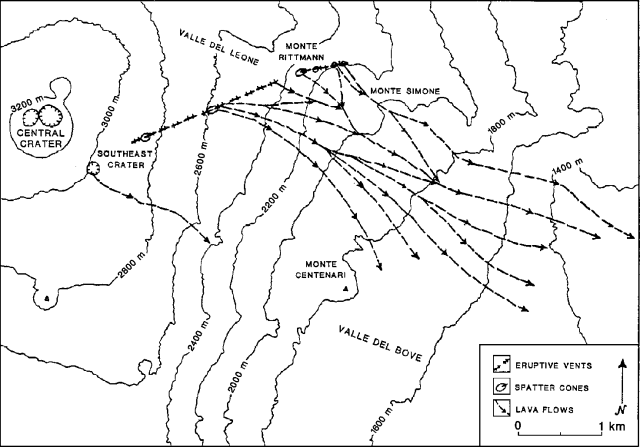 | Figure 25. Sketch map of Etna's summit area and E flank showing new fissures, lava flows, and spatter cones. |
"A large spatter cone (called Monte Rittmann in memory of our beloved teacher) formed around 2,300-2,350 m, and reached a height of ~ 100 m. From its base, a lava overflow started at the beginning of December and fed a flow that advanced ~700 m before stopping behind Monte Simone. Monte Rittmann has shown almost continuous Strombolian activity, more or less violent and often accompanied by strong explosions. Expulsions of ash have also been observed. The eruptive vents at lower elevation have not been active since 25 November. These vents, one exclusively explosive (at ~ 2,250 m altitude) and two primarily effusive (2,200 and 2,190 m altitude) were very active during the first weeks of the eruption, helping to form a large lava field. The flow fronts were generally wide (at times > 100 m) and high (at times > 10 m). An initial estimate, still to be confirmed, suggests that the volume of lava is around 25 x106 m3. It is difficult at this time to evaluate the surface covered by the lava, but it should be > 4 km2.
"From the E vent of the central crater (the Chasm) more or less violent emissions of reddish ash have continued without interruption. Only emissions of gas and vapor were recorded from the other summit-area vents.
"Only a few weak earthquakes were recorded during November and the first few days of December. Volcanic tremor remained at high levels (5-10x normal), with variations related to changes in the eruptive activity."
Information Contacts: R. Romano, T. Caltabiano, D. Condarelli, and O. Consoli, IIV; S. Gresta, Univ di Catania.
December 1986 (SEAN 11:12)  Cite this Report
Cite this Report
Lava flows; Strombolian activity; ash emission
"The eruption was continuing in early January. Strong gas emissions continued from the eruptive vent at ~ 2,600 m altitude. Lava continued to flow into a tube that extended from the base of the vent to ~ 1,800 m altitude, where there were ephemeral effusive vents that varied in number and position. The lava flows that originated from these ephemeral vents did not advance below 1,500 m altitude, and remained in the center of the Valle del Bove.
"The Strombolian activity at Conetto Rittmann (2,350-2,300 m altitude), at times from as many as three explosive vents, included periods of greater or lesser activity, but diminished gradually. From the beginning of January, the Strombolian activity was almost totally replaced by more or less violent explosions of gray ash. Lava flows originating at the base of Conetto Rittmann (recently more than two lobes have been noted) usually reached 1450 m altitude, passing N of Rocca Musarra, where they stagnated. The rate of lava production varied considerably with time. At the pit crater at ~ 2,850 m altitude, only gas emissions were observed. More or less violent explosions of reddish ash continued from the E vent of the central crater (La Voragine) alternating with periods (more rare) of vapor emission. Gas emissions from the other summit vents (Bocca Nuova, and Southeast and Northeast craters) were continuous but of varying strength.
"During this period, no seismic shocks were recorded. Volcanic tremor remained at rather high levels, with sporadic variations associated with the trend of the eruptive activity."
Further Reference. Kieffer, G., and Tanguy, J.C., 1987, L'activité de l'Etna en 1986: Bull. Sect. Volcanol. Soc. Géol. Fr., no. 3 (January 1987), p. 3-6.
Information Contacts: R. Romano, T. Caltabiano, and D. Condarelli, IIV; S. Gresta, Univ di Catania.
January 1987 (SEAN 12:01)  Cite this Report
Cite this Report
Lava flows in tubes; Strombolian activity and seismicity decline
"The eruption ... continues. Gas emission and rarely (12, 13, and 18 January) strong expulsions of ash occurred from the pit crater at ~ 2,850 m altitude. Only gas emission was observed from the spatter cone at ~ 2,600 m altitude, and it appears that lava effusion from its base ceased at the end of January.
"The Strombolian activity from Conetto Rittmann (2,350-2,300 m altitude) has decreased gradually, almost completely replaced since mid-January by more or less violent expulsions of gray ash, and irregular intervals in which only gas emission was observed.
"The effusive activity that originates from the base of Conetto Rittmann continued with alternating phases of greater or lesser intensity. Between 9 and 23 January several lava flows (four at times) were noted. These were fed at a moderate rate and descended to 1,500 m altitude, after passing Rocca Musarra to the N and S. As of mid-February, a lava tube extended from the base of Conetto Rittmann down to 2,000 m altitude. From there, small lava flows originated from many ephemeral vents, variable in location and duration. These flows moved mainly SE and E, covering lava from previous days, but remained inside the Valle del Bove, and never descended below 1,700 m altitude.
"Expulsions of reddish ash were observed at irregular intervals from both vents of the central crater (mainly from the E vent), while from Southeast Crater only gas emission of variable intensity was recorded. Weak fumarolic activity occurred from Northeast Crater.
"During the first two weeks of January no earthquakes were recorded. Tremor remained at high levels until the morning of 16 January, when tremor energy was reduced to 1/4 that of the preceding days. Seismicity resumed 27 January and continued for 5 days with weak, sporadic shocks on the N flank, at ~ 10 km depth. At the same time, tremor energy descended to levels typical of quiet periods at the volcano.
"Two strong earthquakes (M 4.2, depth 20 km) were recorded on 2 February at 1648 and 1659. Epicenters were ~ 40 km NW of the volcano and the events were felt in much of eastern Sicily. No additional significant earthquakes had occurred as of mid-February, and tremor remained at low levels."
Information Contacts: R. Romano, T. Caltabiano, and D. Condarelli, IIV; S. Gresta and C. Sturiale, Univ di Catania.
February 1987 (SEAN 12:02)  Cite this Report
Cite this Report
120-day eruption ends
"The eruption that began 30 October 1986 ceased at the end of February, probably on the 27th, after 120 days. The effusive activity that had originated from Conetto Rittmann diminished gradually. Only two lava flows, poorly fed, were noted around 20 February. These were moving across the lava field that had formed in previous months within the Valle del Bove, and did not advance below 1,800 m altitude. At the end of February, only gas emission, very vigorous at times, was noted at Conetto Rittmann. More or less impressive gas emission, mixed at times with a little ash, occurred from the two central crater vents. Consistent ash expulsion was rare. Gas emission continued from Southeast Crater. During the eruption, Northeast Crater had shown weak fumarolic activity, but emission of gas that sometimes contained a little ash was noted in early March.
"After the two earthquakes of 2 February, no significant shocks had occurred in the area as of 6 March. Throughout February, tremor energy remained at the low levels reached at the end of January. The presumed date of the end of all eruptive activity (27 February) is in accord with a decline in tremor energy, when values reached those typical of quiescence at the volcano."
Further References. Caltabiano, T., Calvari, S., and Romano, R., 1987, Rapporto sull'attività eruttiva dell'Etna nel periodo Gennaio 1986-Febbraio 1987: Bolletino del Gruppo Nazionale per la Vulcanologia, p. 215-231.
Carveni, P., Rasa, R., Scribano, V., and Sturiale, C., 1987, L'Eruzione Etnea del 1986-1987: Aspetti Fenomenologici e Dati Petrologici: Boll. Accad. Gioenia Sci. Nat. Catania, v. 20, p. 197-217.
Information Contacts: R. Romano, T. Caltabiano, and D. Condarelli, IIV; S. Gresta and C. Sturiale, Univ di Catania.
April 1987 (SEAN 12:04)  Cite this Report
Cite this Report
Phreatic explosions from Southeast Crater kills two, injures seven
An explosion from Southeast Crater on 17 April ejected tephra that killed two people and injured seven others.
During the first half of March, Northeast Crater occasionally emitted gas and vapor, sometimes with ash. During the second half of the month only weak fumarolic activity occurred from Northeast Crater, but more or less intense gas emission episodes that occasionally ejected ash occurred from the central crater's Bocca Nuova. Low-level volcanic tremor occurred during the same period but no earthquakes were recorded. Ten microshocks (M 1.0) occurred 23-25 March.
Sudden increases in sporadic tremor, lasting ~ 10-15 minutes, began 1 April. Geologists attributed the tremor to deep phreatomagmatic explosions. Activity increased during the first few days of April, reaching a maximum of 10 episodes of sporadic tremor on the 6th. The episodes lasted 30-40 minutes each and occurred at ~ 2-hour intervals. On 8 April > 50 microearthquakes were recorded. Only weak gas emission occurred from the central crater's E vent through early April. However, on 8 April at 0835 a violent phreatic explosion from that vent fed a 1-km-high eruption column. Abundant tephra was strewn to 300 m from the crater rim, with maximum dispersion to the NE. Geologists believed that similar explosions had probably occurred during the second half of March. The 8 April explosion was followed by a long period of relative seismic quiescence when only weak sporadic tremor was recorded. Beginning 12 April, 4-5 episodes of sporadic tremor were recorded daily.
Following several days of forceful gas emissions from Southeast Crater, tremor duration increased to a maximum of 30 minutes on the morning of 17 April. At 1335 a moderate-intensity phreatic explosion launched tephra SSE, killing two and injuring seven of the ~ 30 tourists who, the press reported, were standing ~500 m from the crater. A similar explosion on 12 September 1979 had killed 9 tourists and injured 23 others near the central crater's Bocca Nuova (04:09). The 17 April ejecta appeared to be older volcanic material. Tephra fragments 150 m from the crater rim reached diameters of 15 cm and at 250 m were a maximum of 5 cm. IIV geologists suggested that conditions for the 8 and [17] April explosions resulted from the collapse of the internal vent walls and subsequent gas accumulation.
Immediately after the [17] April explosion an increase in tremor was noted. The next day, three episodes of periodic tremor were recorded, each lasting ~ 90-120 minutes. Levels of tremor 2-3x normal continued through the end of the month. Only small quantities of gas were emitted from the central crater during the days following the fatal explosion. Weak Strombolian activity [from Southeast Crater] was observed during the night of 25 April and the morning of 26 April [and 10-16 May]. Vapor emission resumed after the end of the Strombolian activity.
Information Contacts: R. Romano, T. Caltabiano, D. Condarelli, O. Consoli, and G. Frazzetta, IIV; S. Gresta and C. Sturiale, Univ di Catania; La Republica, Rome; AP.
March 1988 (SEAN 13:03)  Cite this Report
Cite this Report
Inflation and seismicity
The following is from a joint French (CNRS/PIRPSEV)-Italian (CNR) monitoring program.
Ground deformation and microseismicity data are transmitted by an ARGOS satellite station, 1 km SSE of the central craters at 2,920 m asl (near the Torre del Filosofo). Two tiltmeters and a vertical geophone are installed inside a 50-m-long lava tube.
From November 1987 through January 1988, no ground deformation was detected and microseismicity was at a low level (100 events/day). In February, ~ 3 µrads/day of nearly continuous inflation was measured by the N-S component of the tilt instrumentation, but E-W tilt remained essentially flat (figure 26). Microseismicity remained at a low level until 25 February, when both the number of events and noise amplitude began to increase (figure 27). A sharp (30 µrad) N-S deflation occurred 29 February-1 March, with a further increase in the number of events (to 700-950/day) and noise amplitude.
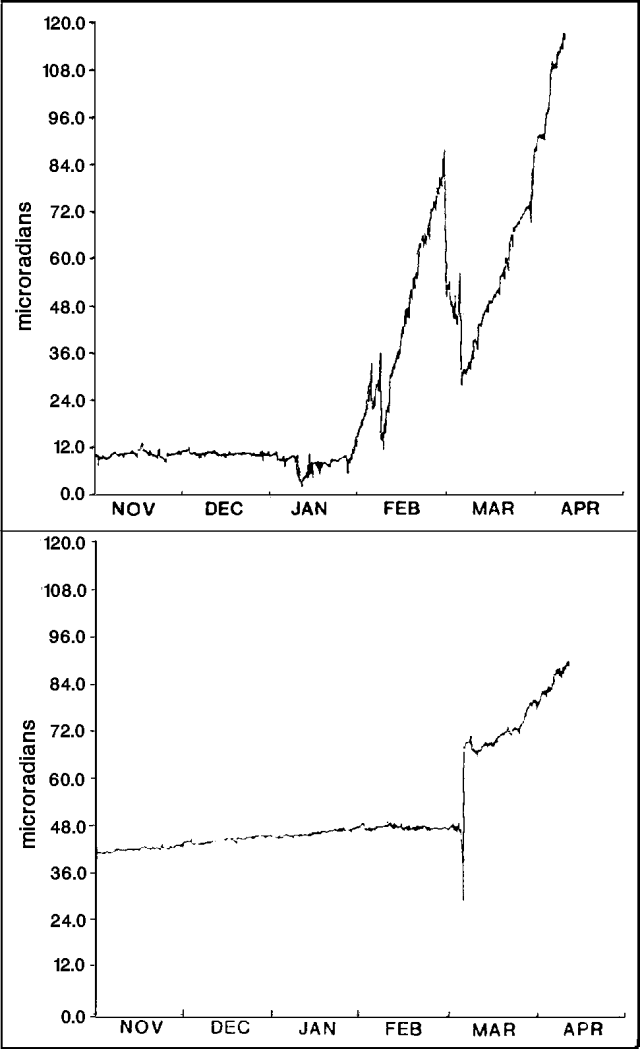 | Figure 26. Summit tilt measured 1 November 1987-10 April 1988 by the N-S (top), and E-W (bottom) components at site TDF, 1 km SSE of the central craters at 2920 m asl (near the Torre del Filosofo). Courtesy of the joint French-Italian Etna survey program. |
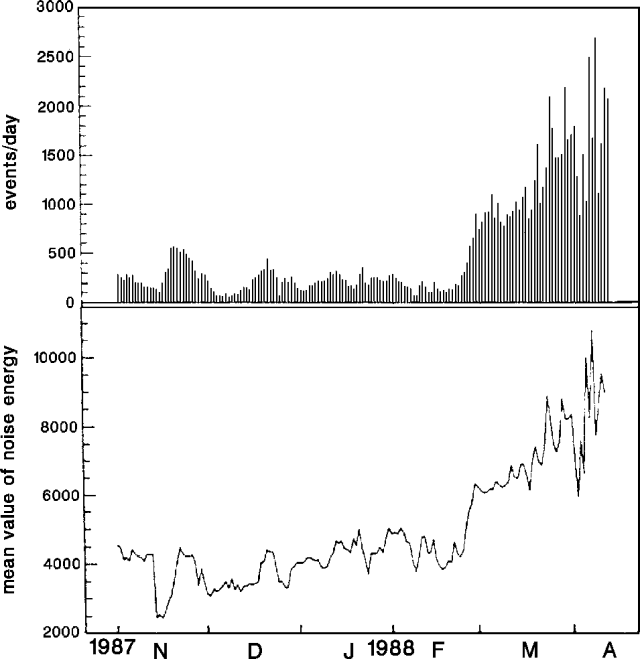 | Figure 27. Number of seismic events/day with amplitudes >4 Nm (top), and daily mean value of noise energy (bottom), measured at site TDF, 1 November 1987-12 April 1988. Courtesy of the joint French-Italian Etna survey program. |
Seismicity continued to build 1-5 March, to 1,100 earthquakes/day. An additional 15 µrad of N-S deflation 5 March was accompanied by the onset of 20 µrad of rapid uplift to the E. From 5 March through early April, NNE-trending inflation has continued at ~ 4 µrad/day, and microseismicity has remained strong, reaching a maximum of 2,700 shocks/day on 8 April. Since the end of February, the 10-station ARGOS seismic network has located many shallow earthquakes in the NE quadrant of the volcano. Local and regional networks have recorded many earthquakes on Sicily's E coast, especially near Etna. Some reached M3 with hypocenters deeper that 10 km. One was felt during the night of 1-2 April by residents of Santa Venerina (15 km SSE of the summit) and Guardia-Mangano (18 km SSE). The ground deformation and microseismicity data suggested to the French/Italian team that significant stress modifications had been located beneath the central craters, and these have since moved to the E flank. No magma had reached the surface as of early April and degassing activity from Bocca Nuova and Southeast Crater remained normal.
Information Contacts: C. Archambault, Centre National d'Etudes des Telécommunications; F. Barberi, Univ di Pisa; R. Basile, Osservatorio Sismologico, Acireale; P. Briole and C. Pambrun, IPGP; J. Glot, IRIGM; J. Liparski, ICSC World Laboratory; O. Nicoloso, Nicolosi.
January 1989 (SEAN 14:01)  Cite this Report
Cite this Report
Strombolian activity from summit craters: inflation
After the October 1986-February 1987 eruption, activity has been confined to the summit craters. In the following report, frequent observations by IIV personnel with help from Italian Alpine Club guides are supplemented by data from geologists who reoccupied ground deformation networks 20 May-24 June and 16 September-7 October.
Bocca Nuova. Since the end of April 1988, Strombolian activity and/or degassing has continued at varying intensity. Explosive vents were active at different points on the crater floor, 150-250 m below the rim. Lava fragments only rarely reached the crater rim. Ash and lapilli ejections were occasionally observed, especially during periods of stronger and more continuous activity. In May and June, small explosions or gas bursts could be heard deep within the crater at a rate of 30-50/minute, with larger explosions about every 5 minutes. Loudness of the explosions varied considerably; they usually were not audible 400 m from the crater, but on 23 June, 4 were heard from Rifugio Sapienza, 5.5 km S, between 1214 and 1226. In September and October, the explosion rate was 30-40/minute. Strombolian explosions from three active vents on the crater floor, roughly 150 m below the rim, were observed about once every 5 minutes. Louder series of explosions were heard up to 3 km away on 23 and 28 September and 1 October. During the night of 1-2 October, a few fresh bombs landed just outside the crater rim and the next day bombs were rising to ~ 10 m below the rim. Violent activity that included lava fountaining was observed from a distance on 31 January 1989 from 1930 to 2100. Bocca Nuova was relatively quiet in early February.
La Voragine. The vent was partially obstructed until July, with activity limited to weak gas emission. Strombolian activity of variable intensity then started at the bottom of the crater, at more than 250 m depth. Ejecta only rarely reached the rim. On 23 August between 1610 and 1650, a series of pyroclastic explosions ejected juvenile material (lava fragments, scoria, lapilli, and ash) to a few hundred meters height. The tephra fell mainly on the E flank, to 400 m from the rim. Explosive activity ceased completely from the end of August until the beginning of September. During visits on 28 September and 6 October, Strombolian explosions were occurring from vents that appeared to be higher in the crater than those at Bocca Nuova. About 30 explosions/minute were counted on the 28th, with ~1/minute strong enough to eject bombs visible to the geologists, who could see 50-80 m into the crater. At night on 2 October, no noises could be heard from the rim, although faint glow was visible. In early February 1989, little activity was occurring from the crater.
Southeast Crater. Gas emission, sometimes under pressure, continued from a vent near the center of this complex of cones and depressions. By 4 October the gas emission had strengthened, ejecting blocks, apparently from the wallrock, and sublimates. Weak and irregular Strombolian activity began in early October. A small new vent opened between 24 and 25 November E of the previous vent, ejecting ash and other tephra. Some of the explosions were fairly vigorous, as on 27 November. The activity changed gradually from ash ejection to a nearly continuous explosive Strombolian activity, with periods of greater and lesser intensity. At times, lava fragments reached 250 m height, falling within a few hundred meters of the crater. Similar Strombolian activity was continuing in early February 1989.
Northeast Crater. Only fumarolic activity was observed until the end of July, varying in intensity with weather conditions. A small vent opened inside this crater on 24 July and grew with time. Very hot pressurized gases emerged, particularly soon after the vent opened. The vent was glowing at night in September. Smoke rings were occasionally emitted in September and October, similar to those observed from Bocca Nuova early in its development.
The following deformation and seismic data are from J.B. Murray.
Despite the increased seismicity and deformation recorded February-April 1988 (13:03), the June levelling traverse showed an unusually small amount of movement since September 1987. Subsidence of recent lava around Northeast Crater was <2 cm, an order of magnitude less than usual and the smallest recorded since the line was installed in 1975. Inflation of 1.6 cm measured 3.5 km NE of the summit was also unusual. Recently active areas generally showed subsidence, with downward movement of slightly > 1 cm at the 1983, 1985, and September 1986 dikes, and isolated larger movements of -6.6 cm at the 1986-87 fissure and -19 cm at the edge of Southeast Crater. The very large amounts of subsidence measured in recent years in the Valle del Leone have diminished considerably.
A very different pattern was measured during the September traverse, with broad inflation centered just SW of Bocca Nuova. Inflation extended over the entire traverse, reaching +5.3 cm at the center when compared to the southern reference station 2.5 km away, or +8.5 cm compared to stations at the N end of the traverse, 5 km away. This inflation was the largest recorded at Etna when no eruption had occurred between measurements. Most dry-tilt stations showed typical small, more or less random, tilts of apparently local origin. However, 4 stations 4-9 km to the SW showed westerly tilts of 20-30 µrad, suggesting that inflation may extend farther in that direction. Murray noted that summit inflation preceding summit eruptions was measured in May 1976, June and September 1977, September 1978, July 1980, October 1983, September 1984, and June 1986. Inflation episodes centered just SW of the summit have tended to precede Southeast Crater activity.
Small local shocks that were apparently related to summit activity were detected optically during measurements of the levelling line and dry tilt stations. Using the automatic level, relative amplitudes were obtained by noting the amount of crosshair movement against the levelling rod and correcting for distance. In June, seismicity was very quiet, with only four events noted in a week of levelling, all within 450 m of Bocca Nuova. The largest had an amplitude of ~ 60 µrad.
In September and October, seismicity had increased dramatically. On 23 September, 73 shocks were noted in 1 hour while levelling W of Bocca Nuova at a mean distance of 330 m from the rim. The shocks were much stronger than in June, with largest amplitudes reaching 250 µrad. Seismic events were detected as much as 4.6 km from the summit. W of Piccolo Rifugio, ~ 3 km from the summit, three shocks were detected in 1 hour, the largest of 35 µrad.
Information Contacts: R. Romano, T. Caltabiano, and O. Consoli, IIV; J. Murray and D. Norman, Dept of Photogrammetry and Surveying, Univ College London; D. Décobecq, Paris; J. Miller, T. Elliott, and B. Van Wyk de Vries, Open Univ; B. Bone, Lancaster.
May 1989 (SEAN 14:05)  Cite this Report
Cite this Report
Explosions from summit craters; small lava flow; high SO2
The following, from IIV, describes activity March-April 1989.
Summit activity. (S. Calvari, M. Coltelli, and M. Pompilio.) Vigorous Strombolian activity at the two central craters (Bocca Nuova and La Voragine), persisted through March and April. At Southeast Crater, Strombolian ejections became strong and continuous during the last 10 days of March, similar to those of 24 December-24 January and 29 January-22 February. Strong explosions continued through April. A small lava flow emerged from the base of Southeast Crater's cinder cone on 15 April at 2300 and flowed over the crater's S rim. Lava effusion stopped early the next morning. Degassing continued at Northeast Crater.
Seismicity. (E. Longo, A. Montaldo, M. Patanè, E. Privitera, and S. Spampinato.) A total of 71 tectonic earthquakes (M >1.0 and S-P <5 seconds) were recorded on the Serra Pizzuta Calvarina seismic station (~ 13 km S of the summit craters) in March, compared to 194 events during all of 1988. The highest seismic energy release and the largest number of events (9, with two of M 2.7) occurred on 17 March. Tectonic events were fewer and smaller (M<=2.7) in April than in the first three months of 1989. Most of the largest events (M>=2) were located on the W flank at depths of ~ 15-25 km. High-energy volcanic tremor episodes were recorded 9-16 April and represent the only seismic evidence of the Southeast Crater eruptive episode on 15 April. After the effusive episode, the spectral amplitude of tremor greatly decreased, but remained higher than in March.
SO2 emissions. (T. Caltabiano and R. Romano.) During the first half of March, SO2 emissions from the summit craters were similar to relatively high February values at ~ 6,000 t/d. During the last half of March, SO2 emissions increased to ~ 8,000 t/d, then decreased to ~2,000 t/d. After the lava effusion of 15-16 April, SO2 emission rates rose to ~12,000 t/d, but decreased to ~3,000 t/d during the remainder of the month.
Ground deformation. (O. Campisi, G. Falzone, B. Puglisi, G. Puglisi, and R. Velardita.) Ground deformation at the Serra Pizzuta Calvarina borehole tilt station showed no significant variations during March and April.
Information Contacts: R. Santacroce, IIV.
June 1989 (SEAN 14:06)  Cite this Report
Cite this Report
Summit explosive activity
The following, from IIV, describes activity May-June 1989.
Summit activity. (S. Calvari, M. Coltelli, and M. Pompilio.) Vigorous activity at the two central crater vents (Bocca Nuova and La Voragine) continued in May. On the 4th, La Voragine ejected bombs and lapilli that fell as far as the rim of Cratere del Piano (roughly 300 m away), choking the crater bottom with tephra. In late May, explosive activity diminished and continued at a normal level throughout June. Discontinuous effusive activity was observed in May within Bocca Nuova, and bombs accumulated in the crater to ~ 100 m from the rim. From late May through most of June, many bombs, some of considerable size, fell outside the crater. This activity suddenly stopped in late June, when the small cone inside the crater collapsed, and was succeeded by sporadic scoria ejection from two vents. Mild Strombolian activity at Southeast Crater in May slightly eroded the scoria cone that had formed in April (14:05). Strombolian activity continued at a medium-low level in June, with occasional pulses ejecting small numbers of bombs over wide areas. The vent on Northeast Crater's floor continued to degas through May and June.
Seismicity. (V. Longo, A. Montaldo, M. Patané, E. Privitera, and S. Spampinato.) The frequency of tectonic seismicity in May and June was generally similar to that of the past year, with occasional seismic swarms. During the last two days in May, low-energy events were detected ~ 10 km below the volcano's central area. A seismic swarm, recorded 19-24 June on the W flank, was 13-15 km deep and included the largest events (M 3.1-3.2) of the month. One of the earthquakes (on the 24th at 0230) was felt by area residents. On 28 June, a small mainshock-aftershock sequence (11 events) was recorded, with the largest earthquake located near the S portion of the Valle del Bove at <5 km depth. From late June to 1 July, events with M 2.5-3.0 occurred 10-15 km beneath the summit. No significant variations in the volcanic tremor pattern were observed during May or June.
Ground deformation. (O. Campisi, G. Falzone, B. Puglisi, G. Puglisi, and R. Velardita.) Ground deformation measured at the Serra Pizzuta Calvarina borehole tilt station showed no significant variation in May or June. Measurements in May using the S trilateration network showed little deformation since l June 1988.
SO2 emissions. (T. Caltabiano and R. Romano.) The average value of SO2 flux in May 1989 was the lowest of the past year, but moderately high values returned in June. SO2 flux was measured 3, ll, 17, and 24 May and 1, 7, 15, 22, and 29 June. Emissions fluctuated in May, with high values on the 3rd and 17th and low values on the 11th and 24th, reaching only 2,500 t/d on the latter date.
Tephra composition. (S. Calvari, M. Coltelli, and M. Pompilio.) January 1989 activity produced hawaiite tephra, with petrography and chemical composition similar to tephra from the previous year. Tephra emitted from Southeast Crater during 1988 had relatively more evolved compositions, but early 1989 tephra was less differentiated than material emitted by the other summit craters.
Information Contacts: R. Santacroce, IIV.
July 1989 (SEAN 14:07)  Cite this Report
Cite this Report
Summit Strombolian activity; little deformation in past year
Geologists observed Strombolian activity at three summit area craters (Bocca Nuova, La Voragine, and Southeast Crater; figure 28) and an incandescent gas vent in Northeast Crater during field work 26 May-1 July. Fresh-looking tephra was abundant W and SW of the summit craters, to 800 m from Bocca Nuova.
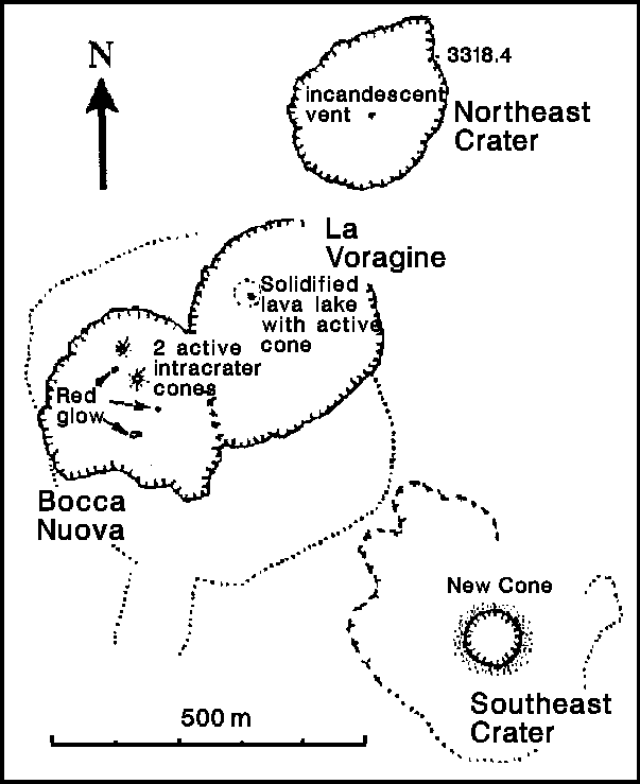 | Figure 28. Sketch map of Etna's summit region, showing features active during field work 26 May-1 July 1989. Courtesy of C. Oppenheimer and J. Murray. |
Bocca Nuova. Vigorous Strombolian activity from two vents on the crater floor, both building cones, was observed 29-30 May, 5, 18, 19, and 30 June, and 1 July. Small explosions and gas bursts averaged ~70/minute. Larger explosions ejected incandescent cowdung bombs, some of which fell 100 m beyond the crater rim. Crater depth was estimated at > 120 m. On 5 June, another glowing vent was visible on or near the flank of the largest active cone. Toward the S end of the crater floor, there was an irregularly shaped area of glowing lava, possibly a ponded flow or passive lava lake. Lava in one of the intracrater vents had a maximum brightness temperature of 1,019°C when measured with a 0.8-1.1 mm infrared thermometer. On 30 June, heat from one of Bocca Nuova's active vents was felt from the observation point on the NW rim.
La Voragine. Strombolian activity occurred from crater floor vents. Loud detonations were heard from the crater rim on 29 May; 17 were counted in 2 minutes. Ejecta were heard falling on the crater floor. During observations the evening of 5 June, four vents were visible, two of which were active. The largest of the 72 explosions counted in a 2-minute period sent bombs to 30 m above the rim. On 1 July, juvenile bombs were ejected by a glowing hornito or small cone on an apparent solidified lava lake. The 0.8-1.1 mm thermometer recorded a peak temperature of 821°C.
Southeast Crater. Strombolian eruptions continued from Southeast Crater's new cone 29 May-30 June, frequently ejecting incandescent tephra above the crater rim. On 4 June, bombs rose to 100 m above the cone. During a 10-minute period around noon, geologists counted 28 eruptions that projected bombs higher than the rim.
Northeast Crater. On 8 June, a vent 2-3 m in diameter was degassing near the middle of the crater floor. A peak brightness temperature of 462°C was recorded by an 8-14 mm infrared thermometer pointed at the vent's inner wall from ~ 50 m distance. Geologists noted that this instrument probably significantly underestimated the gas temperature (see 1 July data). There was no sign of fresh tephra. On 12 June at about 0850, four white "smoke rings" rose slowly from Northeast Crater. On 1 July, glow from the vent was visible during observations in low light shortly after 0600. A 0.8-1.1 mm infrared thermometer yielded a maximum temperature of 644°C, compared to 491° with the 8-14 mm instrument. Eight gas puffs and two more vigorous exhalations were counted in 1 minute.
Geodetic measurements. Very little vertical deformation has occurred since September 1988 (14:01). Slight subsidence was measured E of the summit, with a maximum displacement of 3 cm near the 1987 fissure (relative to a reference station 2.5 km SSW of the summit). A 3.5-cm swelling was measured on the Northeast Rift. A trilateration network on the upper E flank was reoccupied for the first time since June 1988, revealing movements of as much as 4 cm to the NE at stations in the Valle del Leone. The station on Monte Simone (4 km E of the summit) showed an anomalous displacement of 2 cm to the S since September 1987. Stations at Punta Lucia (1.5 km NNW of the summit) and Belvedere (2 km SSE of the summit) were assumed to be stable. Etna's summit elevation was determined at 3,318.4 m, using the base station near Piccolo Rifugio (2,516 m altitude) as a datum. Seismicity was detected optically through the levelling instrument, as in 1988 (14:01). During the early June levelling traverse, 36 shocks were observed, all within 2.2 km of the summit. The largest amplitudes noted were 70 µrad (1.5 km NE of the summit), 111 µrad (near Southeast Crater), and 123 µrad (400 m from Bocca Nuova).
Information Contacts: J. Murray and C. Oppenheimer, Open Univ; A. Jones, Univ of Lancaster; P. Cruddace, Univ of Newcastle; P. Aragno and S. Haefeli, SVG.
August 1989 (SEAN 14:08)  Cite this Report
Cite this Report
Explosions and lava flows; tephra reaches the coast
The following preliminary data is from R. Romano.
Strong Strombolian activity from La Voragine and Southeast Crater was followed by an explosive eruption from La Voragine during the late morning of 10 September. Tephra rose 600-700 m, and the resulting plume, carried E by the wind, deposited ash and lapilli along a narrow, well-defined, path that extended to the coast. After strong explosive activity and lava fountaining, lava spilled over the rim of Southeast Crater early the next morning, forming fluid, fast-moving flows that reached the Piano del Lago (on the upper S flank). During the nights of 11, 12, and 13 September, four more episodes of strong activity occurred, feeding lava flows that advanced SE, S, and SW; these were also very fluid and descended ~ 2 km to 2,640 m elevation. During this period, with brief exceptions, a small lava lake remained visible within Southeast Crater, and was the location of lava fountains that reached average heights of a few hundred meters.
A violent explosive episode that began at about 0900 on 13 September ejected incandescent pyroclastic material to more than 1 km height. Winds again carried the plume toward the E, leaving a narrow band of scoria, lapilli and ash that reached the coast. Press reports said that tephra fall lasted for ~ 15 minutes and some of the lapilli reached walnut size. No injuries were reported, but numerous cars were damaged, and traffic was slowed by nearly 4 cm of ash on the lower flanks. During the explosive activity, felt seismicity on the upper flanks increased substantially but subsided after a few hours.
The plume from the explosion at 0900 was not evident on weather satellite images, but data returned 4 hours earlier, at 0500, showed a plume 15-20 km wide extending ~ 100 km E from Etna. The plume had dissipated by about 0800. During the day on 14 September, no eruptive episodes occurred, and the magma column remained low.
Preliminary estimates suggest that an area of ~0.5 km2 was covered by ~ 5x105 m3 of lava. No estimates of the volume of pyroclastic material were available at press time. Similar activity occurred at the NE crater in 1977-78.
Information Contacts: R. Romano, IIV; A. Brown, NOAA/NESDIS; UPI.
September 1989 (SEAN 14:09)  Cite this Report
Cite this Report
Strong tephra emission; lava fountains >1 km; lava flows
The following supplements the preliminary report in 14:08.
Through 26 September, the eruption was dominated by vigorous Southeast Crater activity that fed upper-flank lava flows and ejected tephra that reached the coast. Fissures opened on the upper E flank 27 September, producing lava flows that advanced ~ 6 km before activity stopped on 9 October.
[Fourteen] strong eruptive episodes that occurred 11-26 September included vigorous explosive activity from Southeast Crater with lava fountains that rose > 1 km. Violent Strombolian activity alternated with periods limited to ash ejection, particularly during the first days of the eruption. Winds initially carried eruptive clouds E and S, then E and NE, with ashfalls reaching Catania (roughly 30 km SSE of the summit). Very fluid lava flows moved S and SSE (Piano del Lago), SE and E (Valle del Bove), and NE (Valle del Leone). The lava flows reached 2,600 m elevation (~ 2 km from the crater) in the Piano del Lago, and the base of the Valle del Bove's W wall at ~2,000 m (3-4 km from the crater).
A team from the Open Univ (P. Francis, C. Oppenheimer, and D. Rothery), the Jet Propulsion Laboratory (L. Glaze and D. Pieri), and IIV (T. Caltabiano) carried out field work 22-29 September. Lava fountaining and Strombolian activity occurred about every 10-12 hours from Southeast Crater. The activity fed many aa flows ~ 100 m long in addition to the more fluid flows that advanced farther downslope. Their detailed chronology of a 24 September Southeast Crater eruptive episode, apparently typical of 23-28 September activity, is shown in table 3.
Table 3. Description of the 24 September 1989 eruptive episode at Etna's Southeast Crater, observed by L. Glaze, C. Oppenheimer, and D. Rothery from 900 m away at the Torre del Filosofo. Temperatures were measured with a Cyclops 33 infrared thermometer (8-14 mm bandpass), but were lower than true values because the 1° field of view always included some air or cold ash.
| Time | Description of activity |
| 0940-0955 | Gray ash clouds rose 50-100 m above the rim every few minutes. The Central Crater was fuming strongly, but produced no ash. |
| 0955-1035 | Sustained gray ash eruption to 100 m above the rim. |
| 1038 | Ash column production ceased, but explosions were audible. Peak column base temperature, 288°C. |
| 1040 | Bombs began to rise above the rim. |
| 1050 | Semi-continuous Strombolian ejection with some red incandescence. No distinct tephra column. |
| 1103 | 50-m lava fountain; maximum temperature of 443°C at its visible base. |
| 1105 | Onset of fine ashfall at the Torre del Filosofo (TDF). |
| 1108 | Continuous noise; fountain to about 80 m above the rim. |
| 1115-1117 | Temperature at the fountain's visible base, 280-882°C. Brown smoke rose E of the crater, probably from lava advancing toward the Valle del Bove. |
| 1120 | Lava fountained to 160 m above the rim, surmounted by a convectively rising ash/scoria column. |
| 1124 | Maximum temperature of the visible column base 693°C with the Cyclops 33, but 983 with a Cyclops 52 (0.3 field of view, 0.1-1.1 micron bandpass). |
| 1126 | Centimeter-size scoria fall began at the TDF. |
| 1129 | Incandescent material rose above the rim from a second western source within the crater. The two sources soon joined to feed a single lava fountain with a sustained height of 250 m above the rim. |
| 1136 | A clast-fed lava flow began on the crater's SW flank. 2-cm tephra fell at the TDF a minute later. |
| 1145 | Brick-size bombs fell 100 m E of the TDF, where 4-cm tephra was falling 2 minutes later. |
| 1200 | Lava fountained to more than 300 m above the rim with jet engine roaring. A convective ash/scoria column rose to considerable (but undetermined) altitude. |
| 1205 | A fissure developed on the crater's SE flank, and lava fountaining from the fissure fed a flow. The fountain's infrared temperature was 614°C at 1211. By 1224, the fissure had become the source of the main column, with incandescent material rising 200-300 m. |
| 1233 | Roaring noise stopped for about 3 seconds, then activity declined and had virtually ceased by 1238. |
Geologists from the Ruhr Univ visited Etna 22-30 September. Eruptive episodes that included lava fountains up to 500 m high, ash emission, and lava flows from Southeast Crater and associated fissures, occurred once or twice daily during their first five days. They provided the following chronology of activity observed from Nicolosi, 15 km to the S.
22 September, 2100-2330: Lava fountains to 500 m height, lava flows mainly directed toward the Valle del Bove.
23 September, 2000-2015: Vigorous lava fountains (probably higher than the previous night) and lava flows to the Valle del Bove.
24 September, 0930-1200: Initial small ash puffs from Southeast Crater were followed by high lava fountains. New fissures opened at the base of Southeast Crater, and lava flows moved S, cutting off the road to the Torre del Filosofo (900 m from Southeast Crater).
25 September, 0530-0900: Lava fountains rose 300 m, a 4-km vapor plume was ejected, and lava flowed into the Valle del Bove. Loud rumblings were heard from Nicolosi near the end of the activity. Strong ash emission from Southeast Crater and Bocca Nuova lasted from 0700 to 0900. 1900-2000: Lava fountained to 300 m height from at least four vents in Southeast Crater and a lava flow advanced toward the Valle del Bove.
26 September, 0600-0710: Lava fountains reached 400 m height and powerful ash ejection fed a column that rose 5-6 km above the summit within 30 minutes. Lava flowed into the Valle del Bove. At 0645, a brown, cauliflower-shaped ash cloud rose from the Valle del Bove, suggesting a possible flank outbreak. However, ash emission from that site ceased after a few minutes and no flank eruption was confirmed by other observers. 1210-1215: A series of ash puffs rose from Southeast Crater, but no additional eruption followed. 2000-?: High lava fountains were ejected, lava flowed to the Valle del Bove, and a new vent formed near Southeast Crater.
27 September, about 1200: Ash emission resumed from Southeast Crater. Dark gray ash clouds rose continuously to ~ 100 m above the vent before being carried E by strong winds. Ash emission continued through the evening. After nightfall, a bright glow was visible above the Valle del Bove and small fountains emerged from Southeast Crater once or twice/minute.
R. Romano reports that in the late evening of 27 September (around 2230) two new sub-parallel eruptive fissures opened on the upper E flank at 2,600 and 2,575 m altitude (between Valle del Leone and Valle del Bove, SE of Pizzi Deneri), preceded by a brief seismic crisis. Strombolian activity, violent at times, was initially continuous along the fissures, forming hornitos and scoria ramparts. Lava flows from the upper fissure did not extend beyond (but generally entered) the main lava channel formed by the primary effusive vent at the base of the lower fissure (2575 m altitude). The lava flows, moving generally SE, passed S of Monte Simone, widening at ~ 1,750 m altitude.
During the morning of 28 September an extensive field of NNW-trending non-eruptive fractures formed in the Piano del Lago, propagating in succeeding days to the W and S wall of the Valle del Bove. The fractures also extended downslope, past the edge of Serra del Solfizio, on a NW trend. By the morning of 2 October new fractures had opened to the Zafferana-Rifugio Sapienza road (route 92) ending around 1,500 m elevation, below the effusive vents of 1792. Total length of the fractures was ~6 km.
Ruhr Univ geologists climbed Etna on 28 September. Ash emission from Southeast Crater remained continuous. Around noon, brown ash plumes rose from the vent in pulses every 3-5 seconds, accompanied by block and bomb ejection. No glow was seen. Dense weather clouds obscured visibility during the afternoon, but a distinct increase in noise suggested the onset of Strombolian explosions. As night fell around 1800, weather clouds dissipated and Strombolian bursts were visible every 5-10 seconds, ejecting bombs and spatter to 300 m height. The lava flow in the Valle del Bove apparently emerged from a fissure in its NW part. The non-eruptive fractures that had opened parallel to and ~ 50 m W of the rim of the Valle del Bove during the morning, had vertical displacements that sometimes exceeded 1 m; some were 1.5 m wide and several meters deep. The next day, ash and bomb ejection from Southeast Crater increased considerably at about 0730, with dark gray columns rising 150-200 m despite a very strong W wind. Large bombs often rose higher, falling on the flanks of the cone that was rapidly growing around the vent. Expulsion of ash and blocks occurred every 5-10 seconds, accompanied by hissing and rumbling sounds. No glow was visible. Numerous impact craters as much as 1 m wide and 0.5 m deep, probably produced by the strong 13 September activity (14:08), were found at the site of the 1971 Observatory cone, 500 m SW of the active crater. At 1900, lava fountains were again visible in Southeast Crater, with bombs and spatter sometimes rising 350 m. Lava continued to flow into the Valle del Bove. Similar activity was continuing late 30 September.
R. Romano reports that during the following days a wide lava channel formed, extending E after passing Rocca Musarra to the S. Lava flows branched from this channel, passing a line connecting Monte Calonna and Monte Fontana on 6 October, and reached ~ 1,100 m elevation (~ 6 km from the fissure vents). The lava flows stopped ~ 3 km from the nearest town (Milo). Lava production from the vigorous effusive vent at 2,575 m altitude was very strong during the first days of its activity (30-40 m3/sec), started to diminish beginning 3 October, and stopped completely on 9 October.
Preliminary estimates indicate that a [3] km2 area was covered by lava, and lava volume was [~24] x106 m3 (within the Valle del Bove). No estimates are available for volumes of pyroclastic material and lava ejected by the Southeast Crater. Information remains preliminary and incomplete, and will be revised in coming months with more detailed reports, geophysical and geochemical data, and maps of the lava flows and fractures.
Information Contacts: R. Romano, IIV; B. Behncke, Ruhr Univ; D. Rothery, Open Univ.
October 1989 (SEAN 14:10)  Cite this Report
Cite this Report
Details of September-October eruption
The following report (quoted sections technically edited by F. Barberi, A. Bertagnini, P. Landi, and R. Rapuzzi) summarizes studies of Etna's recent activity.
Eruption chronology. "The vigorous Strombolian activity at three summit area craters (Bocca Nuova, La Voragine, and Southeast Crater) observed during May, June, and July (14:07) declined during the first 20 days of August, then progressively resumed in the last 10 days of the month. On 29 and 31 August, after some days of Strombolian activity, La Voragine emitted a 700-m-high tephra column with fallout of lapilli and ash that affected the SE flank to the coast, 19 km from the crater.
"In the first days of September, Strombolian activity also increased at Bocca Nuova and in the morning of 10 September an explosive eruption, identical to those of 29 and 31 August, occurred again at La Voragine. Beginning in the early hours of 11 September, Strombolian activity also resumed at Southeast Crater, then progressively evolved into lava fountaining. Lava spilled over the rim of Southeast Crater, forming two fluid, fast-moving flows that traveled ~2 km SE. Explosive activity and lava spillover then suddenly ceased, indicating lowering of the magma column in the conduit. On the evening of the same day, and 12 more times until 27 September (figure 29), new episodes of vigorous Strombolian activity, evolving into lava fountaining with effusion, were observed at Southeast Crater, each suddenly ceasing and giving rise to slow degassing followed by the resumption of less vigorous Strombolian activity. Lava flows emitted during these 14 effusive episodes were confined to the upper S and SE flank area (Torre del Filosofo-Cisternazza) and descended 2.5-3 km S and SE (figure 30)."
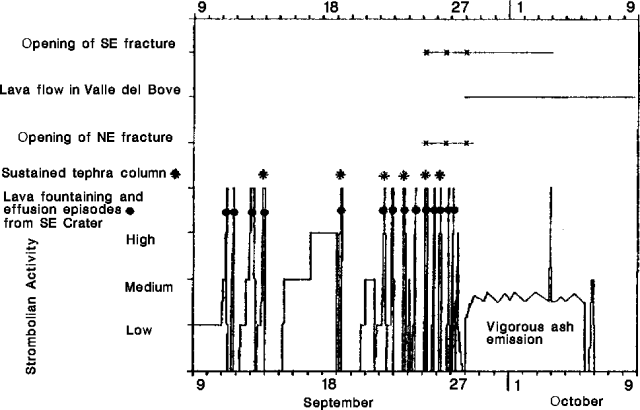 | Figure 29. Schematic chronology of Etna's September-October 1989 eruption. Periods of eruptive activity on the NE and SE fractures are indicated by x's. |
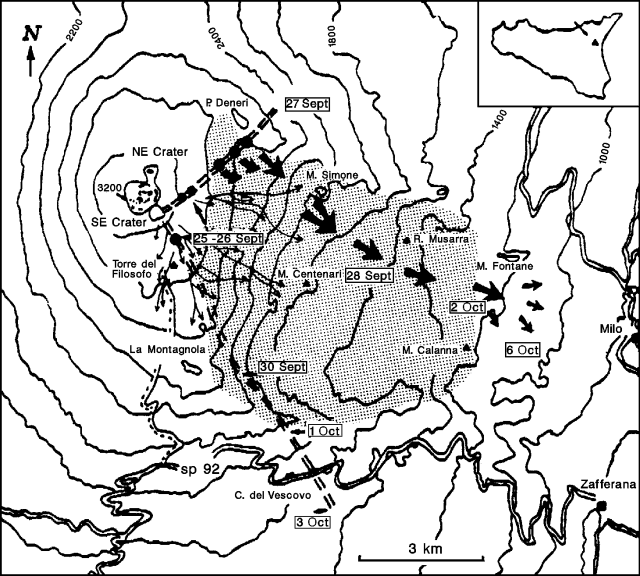 | Figure 30. Topographic sketch map of Etna's summit and upper flanks, showing timing of fracture propagation 25 September-3 October (dashed lines). Thin arrows show paths traveled by 11-27 September lava flows from Southeast Crater and from vents at 2,900 and 2,850 m elevations on the SE and NE fractures respectively. Thick arrows show advance of the lava flows down the Valle del Bove (stippled) through 6 October. Contour interval, 200 m. |
During fieldwork on the 23rd, geologists observed that the area between Southeast Crater and the TDF was covered by fresh aa, in a flow field that had advanced around the TDF and continued southward. The most distal lobes stopped moving on 22 September.
"Near the end of the lava fountaining phase, in at least six cases (13, 19, 22, 23, 25, and 26 September) a sustained tephra column was formed, with consequent lapilli and ash fallout over the E and SE flank to the coast. On [24] September, two fracture systems, trending [N40°E] and N140°E, opened on the flanks of the newly formed Southeast Crater cone, down to elevations of 2,800 and 2,900 m respectively. An appreciable quantity of lava spilled either over the Southeast Crater rim or from the two newly formed fractures on 25 September and in the following two days. In the morning of 25 September a lava flow from the NE fracture descended 3 km in the Valle del Bove, to 1,900 m (M. Simone area, figure 30). The last episode of lava fountaining and effusion at Southeast Crater occurred the morning of 27 September. Since that afternoon the crater has been characterized by Strombolian activity and ash emission."
On the evening of 27 September, the focus of activity shifted to the NE fracture system. "At about 2200 a small fast-moving flow was emitted from the terminus of the NE fracture, and descended 2 km in the Valle del Bove. The Strombolian activity of Southeast Crater then [temporarily] ceased, and between 2300 and 2330 a series of eruptive vents opened at 2,550 m elevation in the Valle del Leone (upper part of the Valle del Bove), preceded and accompanied by a vigorous seismic swarm. These vents were aligned along a N50°E fracture, on the extension of the fracture cutting the NE flank of the SE cone (figure 30). Lava poured from 3-4 vents, where degassing was minor with ejection of lava fragments to only a few meters height. The various lava tongues converged a short distance from the fracture into a main channel, 10 m wide, where lava advanced rapidly. At dawn on 28 September the flow had descended 5 km in the Valle del Bove, reaching Rocca Musarra at ~ 1,650 m elevation.
"That morning, the SSE fracture (extending N140°E from Southeast Crater) was also seen to have progressed downslope. This newly formed part of the fracture system affected a 100-m-wide sector, extending down 2.5 km (to Cisternazza) and to the upper (W) part of the Valle del Bove. Fracture propagation continued on 29 and 30 September, when the S scarp of the Valle del Bove was affected. On 1 October the fracture, accompanied by marked collapses along the fissure system, crossed the Valle del Bove scarp and propagated farther downslope, following the feeding fissure of the 1792 flank eruption. At 1200 on 2 October the fracture cut route SP92 connecting Zafferana to Rifugio Sapienza. The seismic activity that accompanied the entire fracturing process peaked at that time, with ~40 shocks/hour (figure 31). In the following hours, seismic activity rapidly declined and fracture propagation stopped at ~ 1,500 m elevation, 8 km from Southeast Crater. In the following three days only widening of single fissures was observed, with development of consistent compressive structures (uplift folding, reverse faulting) on both sides of the main extensional (open) fissure."
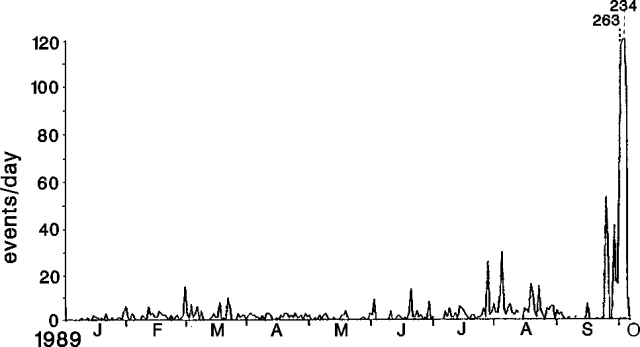 | Figure 31. Daily number of seismic events recorded by station ESP, 1 January-5 October, 1989. |
During fieldwork the night of 1 October (by C. Oppenheimer, M. Pompilio, M. Coltelli, and V. Scribano) the flow near the NE fracture's main vent was ~ 8 m wide, and its center was moving at faster than a walking pace. Blocks of lava tossed onto the flow welded instantly but did not sink. A maximum lava surface brightness temperature of 1,039°C was measured by a 0.8-1.1 mm bandpass infrared thermometer (recording for 10 minutes, 3 m from the flow top).
Guy Kieffer notes that the axes of the two fracture systems that opened during the eruption had both been frequently active during the eruptive cycle that began in 1971: the NE axis in 1971, 1978, 1979, and 1986-87; and the SSE axis in 1971, 1978, 1979, 1983, and 1985 (along a southward extension). The NE axis had also been active during the 1811, 1865, and 1928 eruptions, and the SSE axis in 1792, 1908, and 1910. As in the present eruption, fissures had opened from the SSE base of the central cone in 1874, 1911, and 1923 without producing any lava, while lava was emitted from N flank fissures. The 1989 eruption's SSE fracture had opened ~ 45 cm and had a right-lateral displacement of ~ 15 cm (on 7 October) where it crossed route SP92. Kieffer suggested that the SSE fracture was the result of an offset caused by intrusion below Southeast Crater, added to several years of accrued stresses as part of the E flank is forced eastward.
"Lava outpouring from the Valle del Leone fissure continued until 2 October without significant variation in the effusion rate. From 3 October, oscillations, but with a slow progressive decrease, were observed in the rate of lava effusion. During temporary phases of effusion rate increase, eruptive vents were reactivated at higher elevation on the NE effusive fracture. New hornitos were formed, 50 m above those at the 1,550-m vents, accompanied by a series of lava overflows. The effusion rate decreased further on 6 October and lava emission stopped during the night of 8-9 October.
"During the same period, explosive activity continued at Southeast Crater. After the late morning of 28 September ash-laden clouds were emitted from the crater, which also showed Strombolian activity of variable intensity." When observed by C. Oppenheimer on 29 September, discrete eruptions of ash and blocks about every 30 seconds were superimposed on continuous ash emission. Ballistic trajectories of incandescent bombs that rose >400 m above the crater were visible at night.
"Tephra were dispersed eastward by the wind, causing ash showers on Catania and eastern villages, especially on 3 and 4 October. Limited episodes of lava fountaining last occurred during the night of 3-4 October. Strombolian activity stopped during the night of 6 October, whereas discontinuous weak ash emission continued until 9 October. Southeast Crater appeared almost totally obstructed on 11 October. Ash emission and vigorous degassing continued, since 9 October, only at Bocca Nuova.
Lava flows. "Etna's 27 September-9 October flank eruption produced an aa flow field in the Valle del Leone-Valle del Bove ~ 6.5 km long and 5-10 m thick, with a volume of 10-20 x 106 m3. The flows descended from ~2,550 to 1,100 m elevation. The average effusion rate is estimated at 10-20 m3/second, with peak daily average values during the first 4 days of eruption (until 2 October) of between 15 and 25 m3/second. Combinations of the overall emplacement characteristics (e.g. length-average effusion rate, length-volume, width/length-duration) of the flow fields lie within ranges typical for Etna's historic lavas. Velocity and dimension measurements of active overflows at the feeding vent (Valle del Leone, ~ 2,550 m asl) on 2 and 4 October suggest apparent viscosities for the initial lava of the order of 10,000 Pas, for bulk shear rates between 0.01 and 0.1/s. Thermocouple data yielded a surface temperature of 800°C on the overflow (after it had advanced ~ 50-75 m) on 2 October. Preliminary analysis of infrared data obtained on the ground on 5 October suggests a similar temperature for incandescent cracks in an active flow front ~ 6 km from the vent.
Petrology. "The lavas are porphyritic (P.I. = 30-40) alkali basalts with phenocrysts of plagioclase, clinopyroxene, and olivine, and microphenocrysts of Ti-magnetite. There are only minor differences, in size and relative abundance of phenocrysts, between the Southeast Crater flows and the Valle del Leone lavas. Two representative chemical analyses are shown in table 4. The 1989 lavas are slightly more mafic and magnesian than those of either the last Etna eruptions (1986-87 average) or Southeast Crater in 1988.
Table 4. Chemistry of 1989 lavas from Etna's Southeast Crater (11 September) and the Valle del Leone 93 October). Analyses by X-ray Flourescence at the Dipt. di Scienze della Terra, Univ. di Pisa, except Na2O and MgO (Atomic Absorption Spectrophotometer) and FeO (titration) at IIV.
| Oxide | Southeast Crater | Valle del Leone |
| SiO2 | 47.46 | 46.70 |
| TiO2 | 1.78 | 1.78 |
| Al2O3 | 18.11 | 17.36 |
| Fe2O3 | 2.83 | 4.30 |
| FeO | 7.32 | 7.41 |
| MnO | 0.19 | 0.20 |
| MgO | 5.57 | 5.84 |
| CaO | 10.39 | 10.25 |
| Na2O | 3.45 | 3.51 |
| K2O | 1.99 | 1.81 |
| P2O5 | 0.44 | 0.41 |
| LOI | 0.48 | 0.44 |
Civil Protection aspects. "The lava flow emitted from the SE fractures in the Valle del Leone did not present any serious civil protection problem. Flow fronts advanced very slowly at elevations lower than 1,200 m. The flow was confined within the totally uninhabited Valle del Bove and never threatened villages or lifelines. However, the propagation of the SE fracture system from Southeast Crater downslope caused serious concern. Because of strong seismic activity and marked uplift on that sector of the volcano, route SP92 was closed to traffic 24 hours before it was cut by the fracture. The terminus of the fracture was located in a zone that had been affected by flank eruptions in the past (e.g. in 1792). It was at low elevation (~ 1,500 m) and only 5-6 km from villages (Malpasso, Fleri), a distance that could be traveled by a fluid lava flow in a dangerously short time, considering that magma was at the surface in Southeast Crater vent (3,000 m elevation) and hence there was a very high potential load (1,500 m of lava column) on the fracture apex.
"The more probable paths of lava flow in case of effusion from a vent at 1,500 m elevation were estimated on a morphological basis. People living on the potential lava trajectories were alerted to the potential risk and a plan was established for their prompt evacuation.
"Scientific monitoring at the fracture terminus was expanded and reinforced with a mobile seismic network, precision levelling, microgravimetry, geodimeter lines, and soil gas geochemistry. I gas;sampling Visual observation points (24 hours/day) were established near the fracture apex and along the expected flow path, radio linked with the army units responsible for the emergency plans.
"The alert system was maintained until 16 October. Then, with six days having passed since the end of eruptive activity and without any sign of potential volcanic activation of the SE fracture, the eruption was considered concluded.
Seismicity. "Seismic activity has been monitored since early summer 1989, using both the IIV's permanent array (8 stations) and a temporary array operated by the OV (up to 11 three-component telemetered digital stations). The daily frequency histogram is shown in figure 31.
Pre-eruptive period."Five major seismic sequences were recorded from late July to late August; none of the events exceeded M 3.3. Focal depths, calculated with respect to the highest stations (at 2,900 m asl) ranged from ~ 15 km (3 August, 45 events) to
Eruptive period. "On 23-24 September, a swarm of 84 events (M >3.2) was located at ~20 km depth. Three days later, during a period of large fluctuations in tremor amplitude, intense microseismic activity preceded and accompanied the opening of the eruptive fissures on the E flank. Because of its weakness (only 19 events of M>2), this activity was clearly observed only at the nearest station (PDN, ~ 1 km from the new vents).
"More than 1,000 shallow events (depth
Volcanic tremor. "Volcanic tremor was monitored at stations PDN (hourly analysis) and SLN (real-time analysis). A rapid increase in tremor energy was recorded during the morning of 10 September. The level of tremor remained high for four days, with an estimated daily energy release of 1017 ergs (1010 J), then dropped by about an order of magnitude (figure 32). Between 18 September and 6 October, near-periodic (daily/half-daily) oscillations could be distinguished in the tremor amplitude (minor peaks in energy release on 19, 22, 25, and 27 September, and 4 October). With the end of the eruption on 9 October, tremor amplitude dropped to the pre-crisis level. Energy spectra analysis of 5-minute samples from station SLN shows steady peaks in the 1.4-1.9 Hz band, independent of energy level, while spectral displacements to higher frequencies were occasionally observed at station PDN.
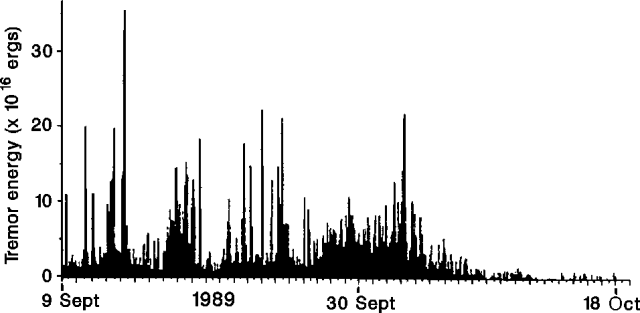 | Figure 32. Daily release of tremor energy recorded by SLN (Serra la Nave) station, 9 September-18 October, 1989. |
Ground deformation - tilt. "Tilt data have been collected at an IIV borehole biaxial tilt station (SPC), located along the SE flank at ~ 1,600 m elevation. Continuously monitored tilt signals indicated a positive variation of the radial component (crater up), clearly exceeding the signal confidence limit, since the beginning of June 1989. The tangential component of the tilt remained practically flat until the beginning of the fracturing phase affecting the SE flank by 2 October. Both radial and tangential tilt underwent a sharp variation by the afternoon of 1 October, suggesting a rapid inflation of the Valle del Bove's S outer flank, where the fracture later propagated. The almost constant ratio between the two tilt components throughout this phase of the deformation process depicts a resultant tilt vector trending approximately N25°E (up) and totaling 14 µrad by the end of the deformation phase.
"Additional tilt data were obtained by two stations (sensor made of a pair of horizontal pendulums) installed by IIV and IPGP. The two automated stations (GIA and TRE) recorded an uplift of the summit area since the first 10 days of June (radial component, figure 33). Marked variations were recorded during the SE fracture propagation, particularly at TRE station, only 200 m from the fracture.
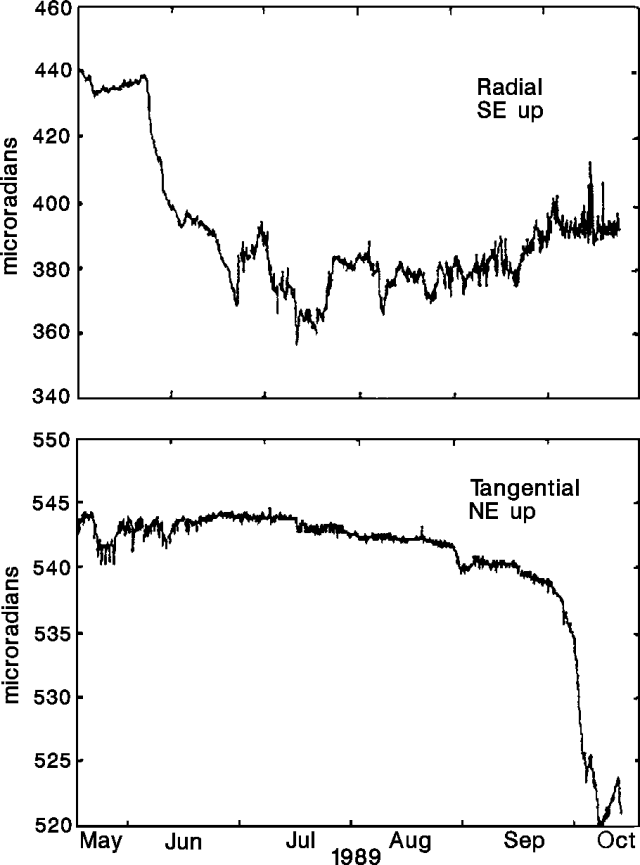 | Figure 33. Radial (top) and tangential (bottom) data from the GIA horizontal pendulum tilt station, 21 May-13 October, 1989. |
Ground deformation - geodimeter. "A trilateration network on the SE flank area had been previously surveyed in 1987, 1988, and May 1989. Daily EDM measurements were made on some of the network benchmarks since 30 September, before the fracture propagated downslope. Horizontal strain solutions for the main deformation phase that occurred on 2 October indicated an overall areal contraction (~152 ppm) with a minimum extension axis of about -206 ± 80 ppm striking N30°E; maximum shear was 260 ppm. Distance measurements across the main fracture system, at ~ 1,700 m elevation, indicated a local extension of up to ~ 1 m between May 1987 and October 1989.
Ground deformation - levelling. "Precise levelling surveys around the circumference of the volcano and across the new fracture system where it cuts route SP92 were carried out 2-16 October. With respect to September 1988, the N part of the volcano had remained stable, while relative sinking had occurred at the station closest to the central crater (20 mm) and across the fault at Piano Pernicana (25 mm; figure 34). Along route SP92, repeated surveys 6-16 October indicated a relative sinking near the new fracture system of ~ 14 mm.
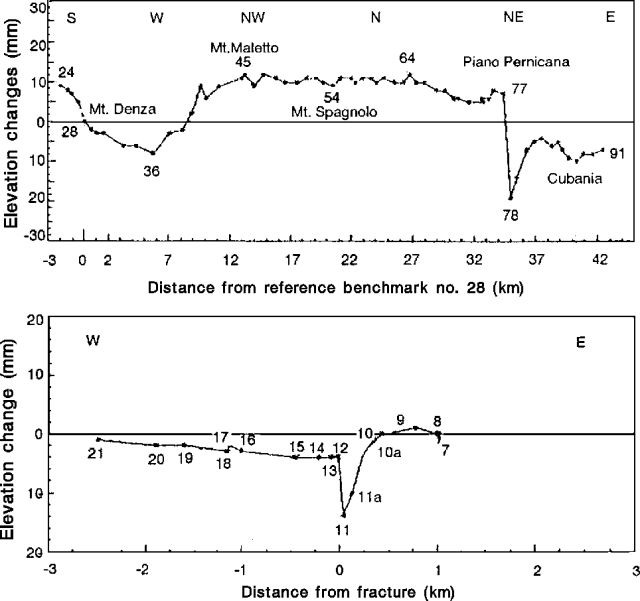 | Figure 34. Top: elevation changes between reoccupations of the level line in September 1988 and on 2-16 October 1989, at about 1,500-2,000 m elevation and 4-10 km from the central crater. Directions from the central crater are shown at top. Bottom: elevation changes between reoccupations of the segment of the level line crossing the SE fracture along route SP92 (figure 30), 6 and 16 October, 1989. |
Microgravimetry. "On 3 October the pre-existing microgravimetric network (OV, IIV) was expanded near the fracture cutting route SP92. A new 2-km-long E-W line was established, with eight stations symmetrically arranged across the fracture, each coinciding with a precision levelling benchmark. Gravity measurements were carried out on 3, 4, 6, and 11 October. Differences from 3 to 4 October (figure 35) show a positive variation of the gravity field with a maximum (18 ± 7 microgal) corresponding to the fracture. Subsequent gravity variations remained mostly within the error range. Correction for levelling data does not appreciably modify these results.
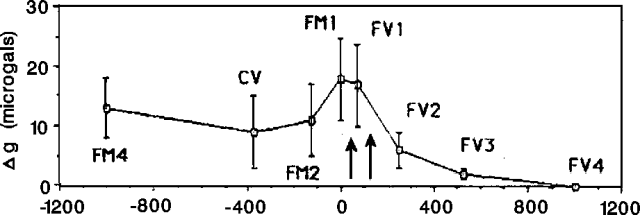 | Figure 35. Gravity changes across the SE fracture (indicated by arrows) along route SP92, 3-4 October, 1989. |
Geochemistry - COSPEC data. "A slow increase in SO2 output from the summit craters was observed in August 1989, with a transition from very low values (1,000 t/d) to medium-high values (~ 7,000 t/d). In the first half of September, SO2 flux remained around medium values. Since 14 September, coinciding with the Valle del Leone effusive phase, SO2 emission increased markedly with oscillation around 15,000 t/d, three times the average Etna values. [Measured rates of SO2 emission exceeded 25,000 t/d on one day around 18 September and reached ~ 23,000 t/d on another day near 1 October].
Geochemistry - soil gases. "From 3 to 14 October, CO2 was measured in the soil close to the terminus of the SE fracture. CO2 concentrations were determined at a soil depth of 50 cm by an IR spectrophotometer, and varied from 0 to 1,500 ppmv, with a clear anomalous degassing at the fracture which showed a progressive decrease with time (figure 36). In addition, CO2 concentration in the soil was measured continuously at one of the points. Two sharp peaks were recorded on 3 and 8 October, while later CO2 concentrations remained quite constant (figure 37).
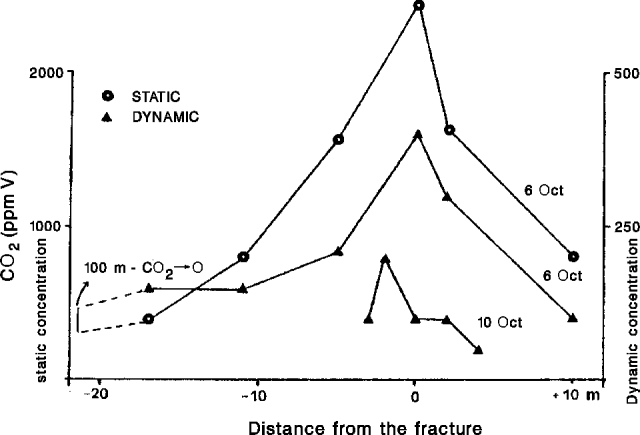 | Figure 36. CO2 concentration in soil across the SE fracture, at 1,600 m elevation (route SP92) 6-10 October, 1989. Dynamic gas samples are taken after pumping; static samples without pumping. |
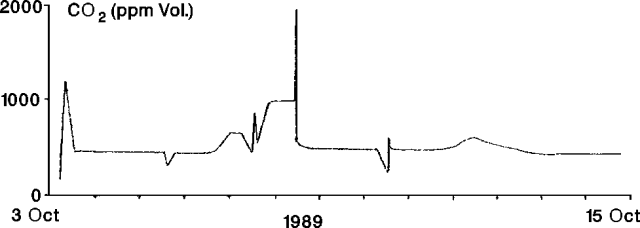 | Figure 37. Data from continuous CO2 monitoring of soil near the SE fracture, 3-15 October 1989. |
"From 9 to 13 October another soil-gas survey was carried out across the fracture. Data from 140-cm soil depths did not show any anomalous H2 and CO degassing but the data from 60-cm depths were significantly higher than atmospheric: they ranged from 3 to 12 ppmv for H2 and 0.3-58.8 ppmv for CO. The meaning of this difference of gas concentration between 140- and 60-cm-deep holes must be further investigated."
Further References. Barberi, F., Bertagnini, F., and Landi, P., eds., 1990, Mt. Etna: the 1989 eruption: CNR–Gruppo Nazionale per la Vulcanologia; Giardini, Pisa, 75 pp. (11 papers).
Briole, P., Nunnari, G., Puglisi, G., and Murray, J., L'Eruption de Septembre-Octoberobre 1989 à l'Etna (Italie): quelques informations quantitatives fournies par la géodesie et l'inclinométrie: Comptes Rendus de l'Académie des Sciences, v. 310, série II, no. 13, p. 1747-1754.
Information Contacts: Many scientists and technicians were involved in the September-October Etna eruption, coordinated by the National Volcanic Group.
Scientific coordination and Civil Protection problems:F. Barberi, Univ di Pisa; G. Frazzetta and R. Santacroce, IIV; F. Innocenti, Univ di Pisa; G. Luongo, OV; R. Mazzuoli, Univ di Cosenza; L. Villari, Univ di Messina.
Volcanological Observations:R. Azzaro, S. Calvari, M. Coltelli, G. Frazzetta, G. Lanzafame, M. Pompilio, and R. Romano, IIV; V. Scribano, Univ di Catania; F. Barberi, A. Bertagnini, F. Innocenti, and P. Landi, Univ di Pisa; C. Kilburn, OV; L. Glaze, JPL.
Petrology:P. Armienti and F. Innocenti, Univ di Pisa; S. Calvari, M. Carà, M. Coltelli, and M. Pompilio, IIV.
Seismicity (24-hour monitoring):E. Privitera, R. Allotta, C. Cardaci, O. Cocina, D. Condarelli, V. Longo, A. Montalto, D. Patanè, A. Pellegrino, S. Rapisarda, S. Spampinato, and O. Torrisi, IIV.
Seismicity (OV mobile network and tremor):F. Ferrucci, G.P. Ricciardi, M. Calì, M. Capello, M. Castellano, U. Coppa, R. D'Alessandro, J. Dorel, D. Ereditato, V. D'Errico, G. Gaudiosi, C. Godano, and G. Milano, OV.
Seismicity – Univ di Catania:S. Gresta, G. Lombardo, and G. Patanè, Univ di Catania.
Ground deformation (IIV tiltmetry and geodimetry):L. Villari, Univ di Messina; A. Bonaccorso, O. Campisi, O. Consoli, B. Puglisi, G. Puglisi, and R. Velardita, IIV.
IIV-IPGP tiltmetry:P. Briole, G. Nunnari, G. Puglisi.
OV levelling:F. Obrizzo, H.A. Ali Naghi, C. Del Gaudio, C. Ricco, V. Sepe, OV.
Microgravimetry:G. Budetta, IIV; M. Grimaldi, OV.
Geochemistry (COSPEC):T. Caltabiano and R. Romano, IIV.
CO2:M. Valenza, G. Capasso, M. Carapezza, W. D'Alessandro, S. Giammanco, S. Gurrieri, J. Hauser, and F. Parello, IGF, Palermo.
H2 and CO:R. Cioni, G. Chiodini, A. Pescia, B. Raco, and G. Taddeucci, IGGI, Pisa, and Univ di Perugia.
Others:G. Kieffer, Univ Blaise-Pascal; C. Oppenheimer and D. Rothery, Open Univ.
November 1989 (SEAN 14:11)  Cite this Report
Cite this Report
Summit tephra emission; strong, fluctuating SO2 emission
The following, from IIV, summarizes the much milder activity in November.
Summit activity. (S. Calvari, M. Coltelli, and M. Pompilio.) November summit activity was limited to discontinuous tephra emission from Bocca Nuova. Tephra emission episodes were frequent during the first two weeks of the month, often associated with deep explosive activity. Tephra emission became sporadic in the second half of November, although continuous activity was observed on the 19th. No juvenile material was ejected. La Voragine and Southeast Crater remained closed, with only weak fumarolic activity on their floors. Degassing from the vent at the bottom of Northeast Crater continued from previous months.
Seismicity. (E. Privitera, C. Cardaci, O. Cocina, V. Longo, A. Montalto, D. Patané, A. Pellegrino, S. Rapisarda, S. Spampinato, and O. Torrisi.) Seismic activity was very low in November. The three most energetic events following the eruption seismicity occurred 31 Oct at 0752 (M 3.0, 9 km depth, in the S. Alfio area, ~ 13 km E of the summit), 10 November at 0319 (M 3.6, 14 km depth, S of the seismic network near Pantano di Lentini, roughly 50 km S of Etna), and 20 November at 0754 (M 2.4, 15 km depth, in the Sciara del Follone area on the N flank). Recorded tremor remained similar to the pattern observed by the end of the eruption.
Ground deformation. (A. Bonaccorso, O. Campisi, G. Falzone, B. and G. Puglisi, and R. Velardita.) No significant variation has been observed in data from a borehole tilt station (SPC) on the SE flank at ~1,600 m elevation.
SO2 flux. (T. Caltabiano and R. Romano.) SO2 flux stabilized at intermediate values (~ 5,000 t/d) at the end of October, but increased in November, reaching 12,000 t/d on the 17th. Rates then declined, to 2,000 t/d on 28 November. A similar fluctuating pattern was observed during the three months (June-August) preceding the recent eruption, and during the same period in 1988 (not followed by an eruption).
Information Contacts: R. Santacroce, IIV.
December 1989 (SEAN 14:12)  Cite this Report
Cite this Report
Southeast Crater explosive activity drops tephra on nearby towns
Summit activity. (S. Calvari, M. Coltelli, O. Consoli, M. Pompilio, V. Scribano.) After only fumarolic emissions from Southeast Crater in November (14:11), renewed activity began on 16 December with continuous ejection of reddish cinders. The activity continued for the following two days, becoming weaker on the 18th. A new vent on the crater bottom, observed 21 December from the rim, exhibited strong explosive activity, but without visible tephra ejection. The activity became somewhat more intense during the following days. Only very small cinders (probably juvenile) reached the crater rim. Strong, deep, explosive activity was noted at Bocca Nuova, but there was no evidence of new tephra on the crater rim. La Voragine was obstructed and characterized by weak fumarolic emissions from the crater bottom. Gas emission from a vent on the floor of Northeast crater continued as before, but reddish cinders and gas were emitted on the 16th.
Seismic activity. (S. Privitera, C. Cardaci, O. Cocina, V. Longo, A. Montalto, D. Patane, A. Pellegrino, S. Spampinato.) Seismic activity in December returned to levels similar to those preceding the July-October seismic and eruptive activity (14:7-11). Five events with M>2 were recorded at 5-10 km depths on the Valle del Bove and the volcano's W sector. The most energetic event (M 2.8) occurred 9 December on the E part of the Valle del Bove at 9 km depth. The number and energy of low-frequency events increased, with maximum activity recorded on 16 December. Tremor amplitude also increased and was characterized by energy fluctuations, especially on the 18th and 19th.
Ground deformation. (A. Bonaccorso, O. Campisi, B. and G. Puglisi, R. Velardita.) Preliminary interpretation of the signal at the SPC borehole tilt station on the S flank showed no significant variation during December. Deformation measured on the NE trilateration network was characterized by shear, with almost equal moduli of the main strain axes. Distance measurements across the fracture on the volcano's S side indicate general stability relative to 7 October and 11 November surveys.
Summit crater SO2 flux. (T. Caltabiano, R. Romano.) Samples collected 7, 20, and 29 December revealed that SO2 flux had stabilized below the mean value of 4,000 t/d. A relatively low value (2,000 t/d) was recorded in late November. December 1989 SO2 flux was slightly higher than the December 1988 trend, probably related to a longer-period flux component.
Early January activity. A seismic phase characterized by fluctuations in the mean amplitude of volcanic tremor began on 4 January at 1950 and was recorded at the ESP station of the permanent Mt. Etna seismic network. Iseismicity;amplitude By 5 January at 0120, the amplitude had stabilized at medium-high values. The most energetic phase was recorded between 0730 and 0922 on several seismic stations. During the following hours, tremor amplitude decreased, but sporadic 1-minute fluctuations brought the tremor amplitude to normal levels. The seismic phase was probably accompanied by lava fountaining at Southeast Crater, but bad weather prevented direct observation. The activity deposited lapilli and small scoria (up to 4 cm) on the NW side of the volcano in the Bronte-Randazzo area, with a dispersion axis oriented toward the town of Maletto (15 km NW of the summit crater). Scoria 13 km from the summit crater was 2-3 cm in diameter. Fieldwork in the following days revealed that a small amount of lava had poured over Southeast Crater's rim, probably due to lava fountaining. The 300-m lava flow, ~ 50 m wide and 1-2 m thick, reached the lowermost 1971 crater. As of 10 January, Southeast Crater showed no explosive activity.
Information Contacts: R. Santacroce, IIV.
January 1990 (BGVN 15:01)  Cite this Report
Cite this Report
Renewed Southeast Crater Strombolian activity; flank tephra fall and small lava flows; increased seismicity and SO2
Summit activity. (S. Calvari, M. Coltelli, O. Consoli, M. Pompilio and V. Scribano.) Eruptive activity that resumed in December at Southeast Crater continued in January, with explosive episodes of Strombolian activity and lava fountaining 4-5, 12, and 14-15 January. The first episode of Strombolian activity deposited 1 to a few cm of ash on the NW flank. Lava poured from the S crater rim, reaching the 1971 eruptive craters (at least 200 m from the vent). A smaller amount of tephra ejected by similar activity on 12 January was carried a few hundred meters WNW by the wind. Lava spilled over the N crater rim, producing a flow 1.5 km long and 20-30 m wide that traveled NE along the September-October fracture system to ~ 2,700 m altitude. When activity ceased, Southeast Crater was completely obstructed by a solidified crust of lava.
The next day, Strombolian activity gradually increased, reaching maximum intensity on the morning of the 15th. Observations from a helicopter on 16 January revealed a new lava flow 50-100 m wide (apparently erupted 15 January) that had flowed over the E crater rim and traveled about 2.5 km SE down the Valle del Bove, stopping at ~2,000 m altitude (S of Sierra Gianicola Piccola).
Sporadic Strombolian explosions with variable intensities resumed 19 January and continued throughout the month. Bad weather prevented field surveys at the other active summit craters, but observations by helicopter showed degassing at the two central vents (Bocca Nuova and La Voragine) and Northeast Crater.
Seismic activity. (E. Privitera, C. Cardaci, O. Cocina, V. Longo, A. Montalto, D. Patane, A. Pellegrino, and S. Spampinato.) January seismicity increased from previous months. Tremor amplitude fluctuated, with increases on 5, 11-12 and 14-15 January, associated with strong explosive activity and lava emission at Southeast Crater. The number of low-frequency events of M<=1 increased from the single shock recorded in December, often becoming more numerous before and after variations in tremor amplitude. A large increase in the number of low-frequency shocks was recorded 19-20 January, but was not accompanied by variation in the tremor amplitude or an increase in energy release. A sequence of 18 events on the NNW side of the volcano at 10-15 km depth had a large energy release. At least nine events reached or exceeded M 2, with 2 main shocks (at 1200 and 1336 on the 28th) reaching M 2.7.
Ground deformation. (A. Bonaccorso, O. Campisi, G. Falzone, B. Puglisi, and R. Velardita.) January tilt recorded at the SPC and CDV borehole tilt stations on the volcano's S flank showed no significant variation from the previous month. EDM surveys across the fracture on the S side (along SP92) and on the N part of the Etna Sud trilateration network showed variations within instrumental error limits.
Summit crater SO2 flux. (T. Caltabiano and R. Romano.) Samples collected from the summit craters on 8, 12, 16-18, 24, and 31 January showed increased SO2 emission preceding eruptive activity. Emissions rose from ~4,000 t/d on 29 December to ~ 26,000 t/d measured 16 January following Southeast Crater explosive and effusive activity on the 14-15th. Emissions returned to moderate values on 17 January (~5,000 t/d) and remained near that level during measurments on 18, 24, and 31 January.
Information Contacts: R. Santacroce, IIV.
March 1990 (BGVN 15:03)  Cite this Report
Cite this Report
Lava fountains and flow then strong block ejection from Southeast Crater
Summit activity. (S. Calvari, M. Coltelli, O. Consoli, M. Pompilio, and V. Scribano.) February activity was characterized by a single strong eruptive episode at Southeast Crater. Summit-area craters generally remained quiet through the rest of February and March. The 1-2 February eruptive episode was similar to several in January. A gradual increase in Strombolian explosions was followed by lava fountaining, and lava flowed over the crater's E rim for 5 hours beginning at 2200 on 1 February. The flow turned toward the Valle del Bove, advancing to ~ 2,000 m altitude, near the terminus of the mid-January flow. During the morning of 2 February, discontinuous Strombolian activity was followed by ejection of scoria that seldom reached a few tens of meters from the rim. Activity changed at about 1330 to energetic, discontinuous explosions that generated rumbling heard at a considerable distance. Blocks more than a meter across fell within a few hundred meters of the crater; much of the slightly vesicular ash was non-juvenile. Similar activity continued until about midnight. After the eruptive episode, the crater was completely obstructed, without any gas emission, until 27 February, when sporadic ejection of dark tephra began from two vents on the crater floor. February activity at other summit-area craters was limited to vapor emission from floors and walls. Emissions were particularly strong from Northeast Crater, where the active vent's walls were strongly incandescent.
Degassing was continuous at the summit craters in March but was not accompanied by Strombolian activity. Degassing occurred from an elliptical vent on the W floor of La Voragine accompanied by sporadic rumbling. Gas was also emitted from two sites on the SE and NW floor of Bocca Nuova. Weak fumarolic activity, from collapse steps that have formed along concentric fractures in Southeast Crater, was strongest from the center of the crater. Degassing also continued in Northeast Crater. On 29 and 30 March, sporadic tephra ejection and incandescence were observed, apparently from a sudden rise in the magma column.
Seismic activity. (E. Privitera, C. Cardaci, O. Cocina, V. Longo, A. Montaldo, M. Patanè, A. Pellegrino, and S. Spampinato.) Volcanic tremor amplitude began a progressive increase on 1 February at 1239, probably associated with increased Strombolian activity at Southeast Crater. Amplitudes peaked at 1940 that day, and at 0048 the next morning as activity was changing from Strombolian to lava fountaining. Other substantial increases in tremor amplitude occurred at 0600-1100, 1855, and 1935. The first of two sequences of discrete earthquakes on 2 February began at 0352. Eight of the events, centered at ~15 km depth on the volcano's N sector, were larger than M 1, the strongest at M 2.6 between 0424 and 0619. The second series of shocks started at 1321, with the two largest events (M 2.8) at 1322 and 1337. Hypocenters were on the Valle del Bove at <1 km depth. From 3 February until the end of the month, seismic activity was at very low levels, with little variation in tremor amplitude or the number of low-frequency shocks. Nine fracturing events exceeded M 1, with a maximum magnitude of 2.5.
Seismic activity in March was characterized by a significant increase in the number of fracturing events. Swarms on 16 and 18 March totaled 124 shocks (M>=1) and brought the month's recorded earthquakes to 153, ~ 3 times as many as in January and February. The 16 March swarm began at 0530 and continued until 0050 the next day. Of the 107 shocks stronger than M 1, 28 were of M>=2 and three of M>=3. The bulk of the most energetic events originated from the central to W part of the edifice at 10-20 km depth, although one (at 1052) was located just NNW of the central crater at ~5 km depth. The strongest shock of the 18 March sequence, which included 17 events, occurred on the SW flank (a few kilometers S of Monte Nero) at ~10-15 km depth. An M 3.3 earthquake on 22 March at 1159 was ~15 km deep, roughly 6 km SSW of the summit (just S of Monte Vetore). The March seismicity was not accompanied by changes in volcanic tremor amplitude, which remained low throughout the month. The number and amplitude of low-frequency events showed little change after 3 February. A new seismic station (PZF) was installed on the lower NW flank (near Maletto), replacing station RCC, stolen in August 1989. With the new site, IIV's Etna network numbers 8 stations.
Ground deformation. (A. Bonaccorso, O. Campisi, G. Falzone, B. Puglisi, and R. Velardita.) Two tilt stations (SPC and CDV) operated during February, both on the S side of the volcano. Data from station SPC generally remained within resolution limits through February and March. A weak anomaly was recorded on the tangential component 18-20 February, then tangential data returned to the normal range. Radial values from recently installed station CDV remained within resolution limits through February, while tangential data began a (negative) excursion on 18 February that totalled 5 µrad by the end of the month. All instruments from this station were stolen on 1 March. Reoccupation of sites that form a triangle along the fracture zone between 1,800 and 1,500 m altitude on the S-SE flank (between benchmarks Bocche 1792, Serra Pizzuta Calvarina, and Mt. Stempato) did not show significant deformation since the previous measurements on 19 January.
Summit SO2 flux. (T. Caltabiano and R. Romano.) Rates of SO2 emission during Southeast Crater's eruptive episode on 2 February were three times mean values. Measurements 7, 14, and 21 February showed considerable variation. The five March measurements yielded SO2 flux of 2,500-14,000 t/d, increasing at the end of the month.
Information Contacts: R. Santacroce, IIV.
October 1990 (BGVN 15:10)  Cite this Report
Cite this Report
Strombolian activity and lava fountaining from central craters; earthquakes and tremor; deformation
The following, from IIV, covers April-September 1990.
Summit crater activity. Eruptive activity was at Bocca Nuova and La Voragine, while only degassing was observed at the SE and NE subterminal craters. At the beginning of July, the mild degassing that had characterized the central vents during previous months evolved to Strombolian activity, sporadically ejecting juvenile products that reached the rim of Bocca Nuova. An intense eruptive episode began at Bocca Nuova on 7 August at about 1130, lasting for ~ 40 minutes. Strong Strombolian activity alternated with lava fountaining, producing a thick deposit (~10 cm maximum) of vesiculated scoria and Pele's Hair that accumulated on the N and NW sides of the crater rim. Wind carried lighter tephra 10 km NE, where it reached the villages of Vena and Presa (figure 38). Weak Strombolian activity followed, stopping early the next day. During the same period, La Voragine was limited to moderate Strombolian activity that stopped on 8 August. Increased tremor amplitude was recorded during the night of 7-8 August (see below), then tremor declined to low levels.
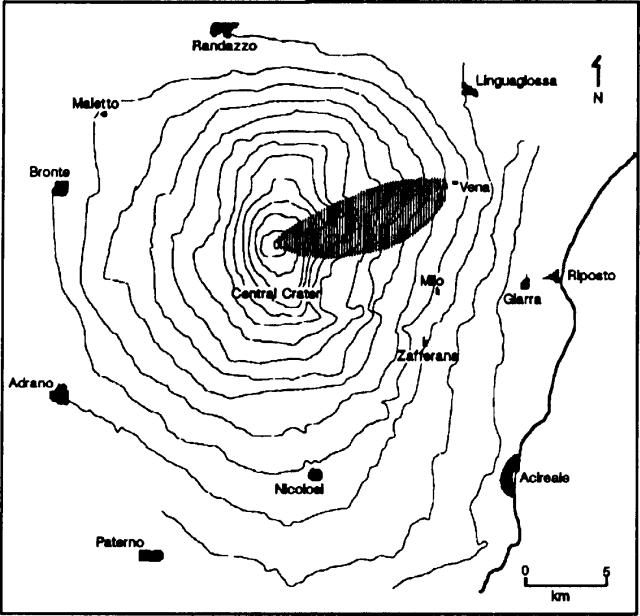 | Figure 38. Sketch map of Etna, showing tephra dispersal during the 7 August Strombolian activity and lava fountaining. |
Collapse of part of the wall between Bocca Nuova and La Voragine 9-10 August produced a landslide deposit that covered pre-existing vents on Bocca Nuova's floor. This deposit was soon penetrated by explosive activity, which formed two new vents characterized by weak Strombolian activity.
Throughout this period, activity at the SE subterminal crater remained limited to degassing. However, a considerable enlargement of the vent was observed in June, accompanied by strong incandescence of the inner walls. The temperature of the fumarolic gas, measured 8 August, reached 615°C. By the end of August, a larger degassing vent (~ 10 m across) had formed on the crater floor where fumarolic activity had previously been most intense. This vent produced only strong gas emission, without explosive episodes. Activity at the summit craters was limited to degassing of variable intensity in September.
Fault seismicity. Seismicity alternated between phases of relative quiet (April-June, September) and moderate to intense activity (July-August).
Moderate activity April-June was broken by four seismic sequences that occurred 25 April, 17-18 May, and 1-2 and 30 June (figure 39b). Seismic energy release (figure 39a) was also moderate (maximum M 3.0 on 17 May) and a total of 101 shocks of M >= 1 were recorded. The April-May seismicity mainly affected the W sector of the volcano, with seismic activity moving to the E (Valle del Bove) and NE flanks in June (figure 40). Average focal depths were ~15 km, except for the 1 June sequence, which had a focal zone at a depth of <=10 km (figure 41).
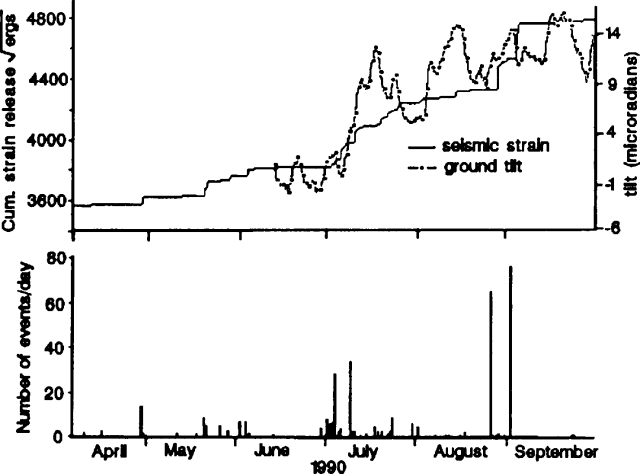 | Figure 39. Top a): cumulative seismic energy release at Etna's S flank ESP station (figure 38) in the square-root of ergs (solid line) and radial component of ground tilt at nearby borehole station SPC (dashed line with squares). Bottom b): number of earthquakes (M³1) recorded at ESP station; April-September 1990. |
 | Figure 40. Epicenters of earthquakes (M >= 2.5) at Etna, April-September 1990. |
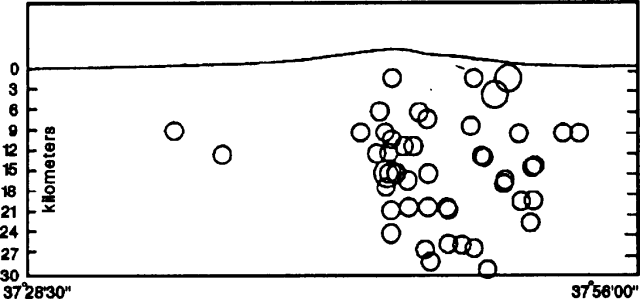 | Figure 41. Foci of earthquakes shown in figure 40, projected onto a N-S cross-section passing through Etna's summit. |
During the next two months, the most significant seismic episodes took place on 3 and 8 July, and 27 August. These sequences plus a general increase in background activity caused a significant change in the slope of the cumulative strain release curve. Energy associated with single events remained moderate, never exceeding M 3.1. The total of 148 events recorded in July decreased to 97 in August. The upper NE flank (10-25 km depth) and the Valle del Bove (6-12 km depth) were the areas most affected.
Another seismic sequence (78 events of M >= 1) occurred on the NW flank on 3 September; the average calculated focal depth was about 24 ± 4 km. Seismic activity then returned to moderate levels for the rest of the month.
Volcanic tremor. During April, May, and the first part of June, volcanic tremor amplitude recorded at a reference station (ESP) on the S flank fluctuated from low to moderate values (7-20 mV/_Hz). Beginning in the second half of June, an amplitude increase was observed (20-30 mV/_Hz) that lasted until 7 August. During the night of 7-8 August, a sudden further increase in tremor amplitude coincided with the violent Strombolian activity from Bocca Nuova (see above). After this episode, tremor amplitude returned to low levels (5-8 mV/_Hz), remaining at similar values until the end of September.
Ground deformation. EDM measurements were performed on two geodimeter networks, on the S and SW flanks. The southern network was measured in June, about a year after the last measurement in May 1989. The area covered by the network includes part of the main fracture system that affected the SE flank during the September-October 1989 eruption (14:8-10). Comparisons between May 1989 and June 1990 data showed significant distance variations, mostly for lines in the higher altitude sector of the network. The resulting deformation pattern was characterized by a significant areal contraction. The deformation ellipse was strongly polarized with the minimum extension axis (contraction) trending approximately N29°E. The southwestern EDM network was reoccupied in July, showing only minor slope distance variations from the previous measurements in June 1989. A weak areal contraction was observed. The calculated deformation ellipse had a minimum extension axis (contraction) striking approximately N7°E.
Tilt data were collected at a biaxial borehole station (SPC) on the S flank, close to the ESP seismic station. Recording was interrupted early April-early June by vandalism. The radial component indicated continuous inflation of the volcanic edifice from the beginning of July until early September, closely paralleling the seismic strain release (figure 39a). During the same period, the tangential component remained nearly flat, showing fluctuations within the confidence limit of about ± 2 µrads.
Information Contacts: IIV.
March 1991 (BGVN 16:03)  Cite this Report
Cite this Report
Periodic summit explosions; brief earthquake swarms; deformation
The following, from IIV, describes activity October 1990-March 1991. Explosive and/or Strombolian activity with strong degassing characterized Bocca Nuova, while the other summit craters generally showed almost continuous mild degassing.
Bocca Nuova. Intense Strombolian activity occurred from 4 or 5 vents that formed on the crater floor between 10 and 15 November. Ejecta only sporadically reached or went beyond the crater rim; most of the pyroclasts were ejected to moderate height, falling within the crater, where they accumulated with minor intracrater lava flows. The activity stopped abruptly on 24 December (associated with a deformation change; see below), and was succeeded that afternoon by strong continuous ash emission that lasted until the beginning of January. Weak Strombolian activity resumed for a few days in early January, ending by the 12th.
Southeast Crater. Typically mild, sometimes pulsating, gas emission was accompanied in December by weak ash ejection during times of the most intense similar activity at Bocca Nuova. A short period of mild Strombolian activity 4-7 January was the first significant eruptive event since the opening of a vent on the crater floor in April 1990.
La Voragine. Only discontinuous Strombolian activity 4-12 January was reported.
Northeast Crater. Frequent explosions occurred, but did not eject any juvenile tephra. Gas emission became intense in October and November, producing continuous incandescence of the degassing vent's inner walls that persisted through the report period.
Only sporadic summit observations were possible during February. These were limited to Southeast Crater, which was characterized by vapor emission. No information about March summit activity is available.
Seismic activity. Seismicity was moderate during October and November. On 7 December, a sequence of 26 events was recorded in a few hours. All were centered on the N flank at 7-24 km depth. Energy release was low, with no shocks exceeding M 2.2. Seven events on 9 January, at ~9 km depth on the SSW flank, were followed by a second swarm (42 events) on 26 January, which was deeper (14-20 km) and distributed over a wider area on the same part of the volcano. A deformation episode was recorded the same day by a nearby tiltmeter (see below). Another, shallower sequence occurred on the SSW flank on 2 February, in the same area as a sharp deformation episode on 24 December. Instrument problems prevented accurate location of a swarm on 8-9 February. A series of moderate earthquakes, on the N flank at ~ 21 km depth, was recorded 19-20 February. Seismicity declined in March.
Tremor amplitude was low in October, but increased 5-6 November, followed by a period of frequent amplitude fluctuations. On 27 November, tremor was strong enough to be detected for a few hours at seismic stations far from the summit craters. It then declined but remained at slightly elevated amplitude. No change in eruptive activity was reported on 27 November. Tremor continued to fluctuate into early December, then remained at low amplitude through March.
Ground deformation. Tilt data were collected at three borehole biaxial stations (SPC, CDV, and MDZ) on the S and SSW flanks. Summit inflation continued from previous months (at SPC), but slowed in November, and had nearly stopped by December. At nearby CDV, no significant radial tilt was detected, but the tangential component showed inflation toward the SW in October that reversed in November and continued on that trend until 24 December. A sharp deformation event was recorded that day on all three tilt stations, and a sudden change from Strombolian activity to continuous ash emission occurred at Bocca Nuova (see above). The pre-24 December trend then resumed at CDV, continuing through January, while similar behavior was shown by the tangential component at SPC.
Another sharp deformation event was recorded 26 January at station MDZ during a seismic swarm centered nearby (see above); a less intense deformation signal was detected at CDV.
Information Contacts: R. Velardita, IIV.
May 1991 (BGVN 16:05)  Cite this Report
Cite this Report
Strong degassing
Nearly continuous degassing was observed ... on 24 May. Northeast Crater's active vent was slightly incandescent and weakly emitting gas. Normal degassing, with sporadic rumbling, occurred at La Voragine, whose elliptical vent E of the central crater floor had reopened. The floors of Bocca Nuova and Southeast Crater were not visible due to their strong degassing.
Information Contacts: H. Gaudru, EVS, Switzerland; Franco Emmi, Etna guide.
July 1991 (BGVN 16:07)  Cite this Report
Cite this Report
Strombolian activity and continued strong degassing
Strong degassing continued .. during fieldwork in June and July. Strombolian activity was reported at a vent in the NE part of Southeast Crater. Small explosions occurred almost continuously, with more powerful blasts ejecting material to the level of the crater rim occurring every 10-15 minutes (in July). Meanwhile, a vent in the center of the crater gently degassed. In June, occasional emissions of small (<20 cm) sublimate-covered lithic blocks and scoria occurred from a 20 x 10 m pit in Northeast Crater. Lava was visible within the vent, which continued to glow through July. The vent widened internally, giving the appearance of a large chamber inclined in the direction of La Voragine. The elliptical vent at La Voragine crater (reopened prior to a 24 May visit; 16:05) showed incandescence in July, but not in June. Degassing continued from numerous fumaroles within the crater. The floor of Bocca Nuova crater was hidden by large quantities of gas in June, but in July two scoria cones were seen gently emitting vapor. At night, a strongly degassing vent on the SE side of the crater emitted tongues of incandescent gas at 15-minute intervals. A fumarole (56°C) was observed on the October 1989 fracture where it crossed the Canalone Della Montagnola at an altitude of ~ 2,200 m.
The following is from Steve Saunders. "A resurvey, in July, of an EDM network (67 lines) on the upper S flank showed a shortening of the majority of the lines (56), suggesting that minor deflation had occurred since the previous survey in July 1990. At that time, length increases along most lines were interpreted as resulting from minor inflation of the upper flanks since November 1989."
Information Contacts: H. Gaudru, EVS, Switzerland; T. De St. Cyr, Fontaines St. Martin, France; S. Saunders, West London Institute of Higher Education; W. McGuire, Cheltenham and Glouster College of Higher Education.
September 1991 (BGVN 16:09)  Cite this Report
Cite this Report
Summit-area Strombolian activity apparently ends; continued degassing
Strombolian activity in Northeast Crater had decreased by mid-July, and was no longer apparent on 23 August. Strombolian activity was observed in Southeast Crater in mid-July. All four summit craters were in a state of almost continuous mild degassing through August.
The following is from a report on activity 10-14 July, by J.P. Kloster in LAVE Bulletin no. 33, p. 4.
A network of curvilinear fissures, up to 2 m wide, covered the N, E, and SE parts of Southeast Crater. In the NW part of the crater, a vent 15 m in diameter emitted puffs of gas roughly every 3 seconds. Every half hour, a more violent explosion ejected lava fragments to 200 m above the vent, covering the walls of the crater and occasionally sending projectiles outside of the crater. The largest projectiles were estimated at around 5 kg, and were fluid enough to deform on impact. Two vents emitted slightly incandescent plumes at night. Each explosion was preceded by ~12 seconds of increased incandescence at the non-exploding vent, and corresponding intensification of glow at the exploding vent. On one occasion, a roughly 100-kg block of lava was ejected to 50 m height.
In the S part of Northeast Crater, a long-persistent vent, 5 m in diameter, emitted puffs of gas. At night, the emission was incandescent to 30 m height, with small lava fragments ejected during the most violent explosions. No projectiles fell beyond the crater rim.
About 70 m below Bocca Nuova crater's S rim, gas was strongly emitted from an E-W fissure, several meters wide and 12 m long, that probably formed in October 1989 (14:10). Explosions were heard emanating from the fissure area, roughly every 4-5 minutes. Night glow was visible at the fissure and at the vents of two coalesced scoria cones in the S part of the crater floor.
Very little activity occurred in La Voragine crater. One 20-m-diameter vent, on a small cinder cone, degassed quietly to several meters, and had night glow. Snow on the cone was largely covered by scoriae, suggesting recent activity.
No Strombolian activity or lava emission were observed during a 23 August visit to the summit by J. Dehn and B. Behncke. The vent in Northeast Crater had strong gas emission, accompanied by loud roaring noises, but no solid material was ejected. A dense continuous gas column was rising from Southeast Crater.
Information Contacts: J. Kloster, LAVE; J. Dehn and B. Behncke, GEOMAR, Kiel.
October 1991 (BGVN 16:10)  Cite this Report
Cite this Report
Minor Strombolian activity from several summit-area vents; little deformation
An 8-19 October resurvey of a 46-line EDM network on the upper S flank showed little movement since July, with maximum line-length changes of ~0.0015%. Activity at the summit craters was more energetic than in July but had the same general characteristics. Continued Strombolian activity in the NE sector of Southeast Crater periodically increased in strength, with large incandescent blebs of lava rising tens of meters above the crater rim. The open vent in Northeast Crater was degassing strongly and incandescent at night, while the two vents on the floor of Bocca Nuova had mild to strong Strombolian activity. E of Bocca Nuova, a single vent on the floor of La Voragine displayed weak Strombolian activity and daylight incandescence.
Further Reference. McGuire, W., Murray, J., Pullen, A., and Saunders, S., 1991, Ground deformation monitoring at Mt. Etna: evidence for dyke emplacement and slope instability: Journal of the Geological Society, London, v. 148, p. 577-583.
Information Contacts: S. Saunders, West London Institute; W. McGuire, Cheltenham and Gloucester College of Higher Education.
November 1991 (BGVN 16:11)  Cite this Report
Cite this Report
Brief SE-flank fissure eruption
Lava emerged from a fissure at 3,000 m altitude, apparently on the SE flank, for about an hour on 14 December. Light ashfalls occurred on small villages below the fissure. The eruption was preceded by hundreds of small earthquakes.
Information Contacts: AP.
December 1991 (BGVN 16:12)  Cite this Report
Cite this Report
Lava from SE-flank fissures covers about 5 km2; barrier constructed
The following, from R. Romano with additional information from J.C. Tanguy, supersedes the preliminary press report in 16:11. Information from Tanguy about the beginning of the eruption was collected thanks to G. Patanè, S. Imposa, R. Cristofolini, A. & O. Nicoloso, and G. Scarpinati.
A SE-flank fissure eruption began near the base of Southeast Crater early 14 December. Activity ended that day from the initial vents, but fissures propagated downslope where more vigorous lava production began the next morning. The eruption produced a substantial lava field and was continuing in mid-January.
After intense Strombolian activity at ... Bocca Nuova and Southeast Crater, eruptive fissures opened during the early morning of 14 December. These extended ~ 1 km SSE from the base of Southeast Crater (figure 42). Strong harmonic tremor was recorded between 0220 and 0420 by Univ di Catania seismometers. Ejection of lava fragments built modest cones and scoria ramparts along the fracture system, while small lava flows were extruded from some vents. More consistent lava production at the end of the fracture system fed a flow that advanced down the W wall of the Valle del Bove, branching into two lobes. These moved E, but did not exceed 1 km in length, reaching ~2,400 m altitude. When chief guide A. Nicoloso reached the area at about 0800, lava production had nearly stopped, although strong gas emission continued at Bocca Nuova and Southeast Crater. Activity from the fissures ceased completely during the morning. Another modest-sized eruptive fissure, oriented NE-SW, opened at the NE base of Southeast Crater, ejecting hot pyroclastic material.
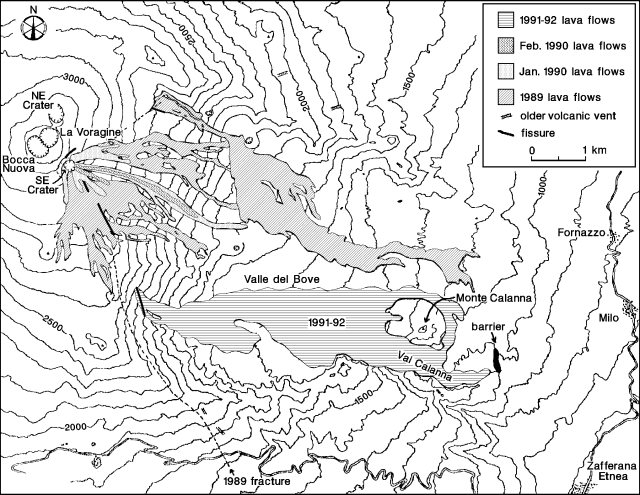 | Figure 42. Topographic map showing the 1989 and 1990 flows, and preliminary locations of the 1991-92 lava, eruptive fissures, and the barrier constructed in Val Calanna. The Piano del Trifoglietto is the broad plain covered by 1991-92 lava in the area of the "1991-92" label. Courtesy of R. Romano, T. Caltabiano, P. Carveni, and M.F. Grasso. |
During the night, the NNW-SSE fissures that had been active the previous morning continued to propagate downslope. A second seismic crisis heralded the opening, at about 0245, of two sub-parallel eruptive fissures. These developed along a non-eruptive segment of the 1989 eruption's SE fracture, on the W wall of the Valle del Bove between roughly 2,400 and 2,200 m altitude, a total length of ~ 400 m. Strombolian activity began immediately along the new fissures and lava flowed E from the fissures' ends, extending ~ 1.5 km along the floor of the Valle del Bove by 0900 (observation by G. Scarpinati). The flows reached the base of the Valle del Bove during the afternoon, and advanced on the Piano del Trifoglietto, a plain at ~ 1,500 m altitude. That evening, at 2103, a strong shock was felt near Etna and to ~ 75 km SE (in the Siracusa area). Other isolated shocks and swarms of events with M <4 were recorded, particularly during the first few days of the eruption.
In the days that followed, Strombolian activity, sometimes intense, occurred from several points along the fissures, building small cones and scoria ramparts. Impressive phreatomagmatic explosions, accompanied by loud detonations, were clearly felt in towns at the foot of the volcano, especially during the eruption's first few days. The effusive activity created a system of lava flows, some with fronts hundreds of meters wide, which generally moved east, in the Piano del Trifoglietto.
By 20 December, lava had reached ~ 1,500 m altitude and superposition of lava flows began to be observed. During the evening of 23 December, a very wide lava front reached the Salto della Giumenta (at the head of the Val Calanna, ~ 4.5 km from the vent) and a few flows descended into it the next morning. Lava flows almost completely covered Val Calanna during the succeeding days, destroying orchards and drinking water facilities. On 2 January, a very wide flow front, ~ 10 m thick, had reached 950 m altitude (~ 5.5 km from the vent) and was advancing slowly. Construction began that day on a containment barrier along the E side of Val Calanna.
An extensive lava field had formed in the Piano del Trifoglietto, with individual lobes frequently superposing and combining. Overflows began from the N part of the lava field about 2 January, forming a separate flow around the N side of Monte Calanna on 5 January and rejoining the stagnant lava front in Val Calanna on the 7th. Flow fronts in Val Calanna had stopped by the morning of 9 January, while active superposed lobes were noted on the lava that had flowed N of Monte Calanna. The most advanced front was at ~ 1,100 m altitude and was tending to move E. The extensive (1-km-wide) main lava field fed numerous breakouts or ephemeral vents, from which modest flows advanced over earlier lava. The main lava channel, originating around 2,200 m altitude, was being vigorously fed and at times was tubed over.
By 14 January, Strombolian activity from the fissure vents had declined notably and explosions were no longer audible. Effusive activity was concentrated at a single vent, feeding a lava channel that subdivided into several flows at ~ 2,000 m altitude (at the base of the Valle del Bove's W wall). These moved onto the lava field formed earlier in the eruption but did not extend beyond 1,550 m altitude. The area covered by new lava had not grown since 9 January, but numerous ephemeral flows appeared on its surface. The containment barrier at the end of Val Calanna had not been tested as of 14 January, since the nearest flow had stopped ~150 m away (~6 km from the vent). As of 21 January the eruption was continuing, although apparently at a reduced rate.
Degassing from the summit craters has continued since the beginning of the eruption. Activity was sometimes intense, but ash was rarely mixed with the gas. Strombolian activity that was vigorous at times continued from various vents at the bottom of Bocca Nuova.
Romano noted that the activity has the characteristics of a classic "slow eruption" (Romano and Sturiale, 1982) and is very similar to the 1819 eruption that occurred in the same area of the Valle del Bove.
Preliminary estimates indicated that ~40 x 106 m3 of lava had been ejected as of 9 January, with an effusion rate of around 15-18 m3/s. Measurements of the effusion rate on 11 January yielded a value of around 9 m3/s from the lava channel at 2,000 m altitude.
Reference. Romano, R., and Sturiale, C., 1982, The historic eruptions of Mt. Etna (volcanological data): Memoirs of the Geological Society of Italy, v. 23, p. 75-97.
Information Contacts: R. Romano and T. Caltabiano, IIV; P. Carveni and M. Grasso, Univ di Catania; J. Tanguy, Univ de Paris.
January 1992 (BGVN 17:01)  Cite this Report
Cite this Report
Lava production continues from SE-flank fissure but explosive activity declines
The following is from R. Romano. The SE-flank fissure eruption that began on 14 December was continuing as of early February. No notable decrease in the rate of lava effusion has been observed. Explosive activity along the eruptive fissure, which has been highly variable in intensity and duration, has mainly declined to sporadic ejections of lava fragments, limited expulsion of dark ash, and rare phreatomagmatic explosions. Strong gas emission was generally evident. Seismic activity has declined to isolated weak events.
The lava field in the SE flank's Valle del Bove has grown considerably, reaching a maximum width of 1.5 km in a few places, as flows from the N (dominantly) and S merged. Most of the lava was carried through a complex system of tubes originating at the main effusive vent, and emerged onto the lava field surface through numerous ephemeral secondary vents. These varied daily in number and position, and were concentrated in the middle of the lava field (around 1,550 m asl), but some have recently appeared at ~ 1,450 m altitude (at the base of Monte Zoccolaro, just before the break in slope at the Salto della Giumenta). Lava flows from the secondary vents generally advanced along the Salto della Giumenta, and were sometimes relatively continuous. In early February one of these reached, but did not surpass, the front of the eruption's longest flow, at 1,000 m elevation (in Val Calanna, ~6 km from the active fissure). Preliminary estimates indicate that > 6 km2 has been covered by ~55-60 x 106 m3 of new lava, an average volume for Etna's "slow eruption" type (Romano and Sturiale, 1982).
The summit craters remained open, emitting gases from small vents. High-temperature gas release was sometimes observed (as at the central crater's E vent, La Voragine, on 11 February). A little dark ash was recently emitted from the central crater's W vent (Bocca Nuova).
Information Contacts: R. Romano and T. Caltabiano, IIV; P. Carveni and M. Grasso, Univ di Catania.
February 1992 (BGVN 17:02)  Cite this Report
Cite this Report
Continued flank lava production
The following is from a report by the Gruppo Nazionale per la Vulcanologia (GNV) summarizing Etna's 1991-92 eruption.
1. Introduction and Civil Protection problems. After 23 months of quiet, and heralded by ground deformation and a short seismic swarm, effusive activity resumed at Etna early 14 December. The eruptive vent opened at 2,200 m elevation on the W wall of the Valle del Bove, along a SE-flank fracture that formed during the 1989 eruption.
Since the eruption's onset, the GNV, in cooperation with Civil Protection authorities, has reinforced the scientific monitoring of Etna. Attention was focused on both the advance of the lava flow and on the possibility of downslope migration of the eruptive vent along the 1989 fracture system. The progress of the lava flow has been carefully followed by daily field inspections and helicopter overflights.
Because of its slow rate of advance, the lava did not threaten lives, but had the potential for severe property destruction. The water supply system for Zafferana (in Val Calanna; figure 43) was destroyed in the first two weeks of the eruption ($2.5 million damage). On 1 January, when the lava front was only 2 km from Zafferana, the Minister for Civil Protection, at the suggestion of the volcanologists, ordered the building of an earthen barrier to protect the village. The barrier was erected at the E end of Val Calanna, where the valley narrows into a deeply eroded canyon. The barrier was conceived to prevent or delay the flow's advance, not to divert it, by creating a morphological obstacle that would favor flow overlapping and lateral expansion of the lava in the large Val Calanna basin.
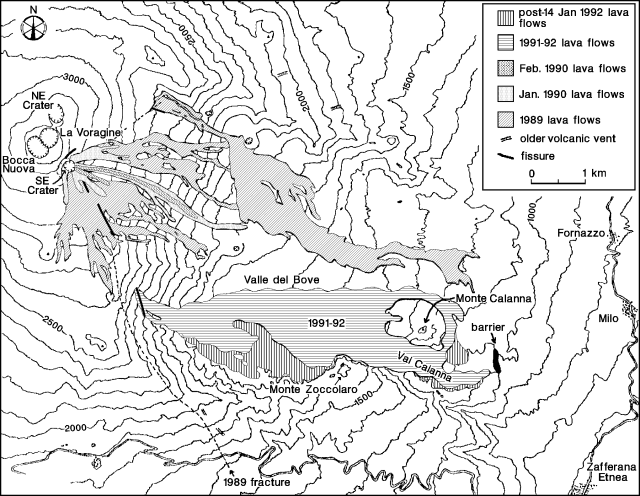 | Figure 43. Topographic sketch map showing Etna's 1989 and 1990 lava flows, with preliminary locations of the 1991-92 lava, eruptive fissures, and the barrier constructed in Val Calanna. The area covered by lava since 14 January is shown in a separate pattern. The GNV report, received near press time, included a map that differed somewhat in detail from this map, which was prepared by R. Romano, T. Caltabiano, P. Carveni, M.F. Grasso, and C. Monaco. See pg.4 of Barberi et al., 1990 for a map of the 1989 lava flows, fissures, and monitoring network. |
The barrier, erected by specialized Army and Fire Brigade personnel in 10 days of non-stop work, is ~ 250 m long and ~ 20 m higher than the adjacent Val Calanna floor. It was built by diking the valley bottom in front of the advancing lava and accumulating loose material (earth, scoria, and lava fragments) on a small natural scarp. On 7 January, the lava front approached to a few tens of meters from the barrier, then stopped because of a sudden drop in feeding caused by a huge lava overflow from the main channel several kilometers upslope.
A decrease in the effusion rate has been observed since mid-January. There is therefore little chance of further advance of the front, as the flow seems to have reached its natural maximum length. The eruptive fracture is being carefully monitored (seismicity, ground deformation, geoelectrics, gravimetry, and gas geochemistry) to detect early symptoms of a possible dangerous downslope migration of the vent along the 1989 fracture, which continues along the present fracture's SE trend. Preparedness plans were implemented in case of lava emission from the fracture's lower end.
Many scientists and technicians, the majority of whom are from IIV and the Istituto per la Geochimica dei Fluidi, Palermo (IGF) and are coordinated by GNV, are collecting information on the geological, petrological, geochemical, and geophysical aspects of the eruption.
2. Eruption chronology. On 14 December at about 0200, a seismic swarm (see Seismicity section below) indicated the opening of two radial fractures trending NE and SSE from Southeast Crater. Very soon, ash and bombs formed small scoria ramparts along the NE fracture, where brief activity was confined to the base of Southeast Crater. Meanwhile, a SSE-trending fracture extended ~ 1.3 km from the base of the crater (at ~3,000 m asl) to 2,700 m altitude.
Lava fountaining up to 300 m high from the uppermost section of the SSE fracture continued until about 0600, producing scoria ramparts 10 m high. Two thin (~ 1 m thick) lava flows from the fracture moved E. The N flow, from the highest part of the fracture, stopped at 2,750 m altitude, while the other, starting at 2,850 m elevation, reached the rim of the Valle del Bove (in the Belvedere area), pouring downvalley to ~ 2,500 m asl. At noon, the lava flows stopped, while the W vent of the central crater (Bocca Nuova) was the source of intense Strombolian activity.
The SSE fracture system continued to propagate downslope, crossing the rim of the Valle del Bove in the late evening. During the night of 14-15 December, lava emerged from the lowest segment of the fracture cutting the W flank of the Valle del Bove, reaching 2,400 m altitude (E of Cisternazza). Degassing and Strombolian activity built small scoria cones. Two lava flows advanced downslope from the base of the lower scoria cone at an estimated initial velocity of 15 m/s, which dramatically decreased when they reached the floor of the Valle del Bove.
The SSE fractures formed a system 3 km long and 350-500 m wide that has not propagated since 15 December. Between Southeast Crater and Cisternazza, the fracture field includes the 1989 fractures, which were reactivated with 30-50-cm offsets. The most evident offsets were down to the E, with right-lateral extensional movements. Numerous pit craters, <1 m in diameter, formed along the fractures.
Lava flows have been spreading down the Valle del Bove into the Piano del Trifoglietto, advancing a few hundred meters/day since 15 December. The high initial outflow rates peaked during the last week of 1991 and the first few days of 1992, and decreased after the second week in January. Strombolian activity at the vent in the upper part of the fracture has gradually diminished.
Lava flows were confined to the Valle del Bove until 24 December, when the most advanced front extended beyond the steep slope of the Salto della Giumenta (1,300-1,400 m altitude), accumulating on the floor of Val Calanna. Since then, many ephemeral vents and lava tubes have formed in the area N of Monte Zoccolaro, probably because of variations in the eruption rate. These widened the lava field in the area, and decreased feeding for flows moving into Val Calanna. However, by the end of December, lava flows expanded further in Val Calanna, moving E and threatening the village of Zafferana Etnea, ~2 km E of the most advanced flow front. This front stopped on 3 January, on the same day that a flow from the Valle del Bove moved N of Monte Calanna, later turning back southward and rejoining lava that had already stopped in Val Calanna. Since 9 January, lava flows in Val Calanna have not extended farther downslope, but have piled up a thick sequence of lobes.
Lava outflow from the vent continued at a more or less constant rate, producing a lava field in the Valle del Bove that consisted of a complex network of tubes and braiding, superposing flows, with a continuously changing system of overflows and ephemeral vents.
3. Lava flow measurements. An estimate of lava channel dimensions, flow velocity, and related rheological parameters was carried out where the flow enters the Valle del Bove. Flow velocities ranging from 0.4-1 m/s were observed 3-7 January in a single flow channel (10 m wide, ~ 2.5 m deep) at 1,800 m altitude, ~ 600 m from the vent. From these values, a flow rate of 8-25 m3/s and viscosities ranging from 70-180 Pas were calculated. Direct temperature measurements at several points on the flow surface with an Al/Ni thermocouple and a 2-color pyrometer (HOTSHOT) yielded values of 850-1,080°C.
4. Petrography and chemistry. Systematic lava sampling was carried out at the flow fronts and near the vents. All of the samples were porphyritic (P.I.»25-35%) and of hawaiitic composition, differing from the 1989 lavas, which fall within the alkali basalt field. Paragenesis is typical of Etna's lavas, with phenocrysts (maximum dimension, 3 mm) of plagioclase, clinopyroxene, and olivine, with Ti-magnitite microphenocrysts. The interstitial to hyalopitic groundmass showed microlites of the same minerals.
5. Seismicity. On 14 December at 0245, a seismic swarm occurred in the summit area (figure 44), related to the opening of upper SE-flank eruptive fractures. About 270 earthquakes were recorded, with a maximum local magnitude of 3. A drastic reduction in the seismic rate was observed from 0046 on 15 December, with only four events recorded until the main shock (Md 3.6) of a new sequence occurred at 2100. The seismic rate remained quite high until 0029 on 17 December, declining gradually thereafter.
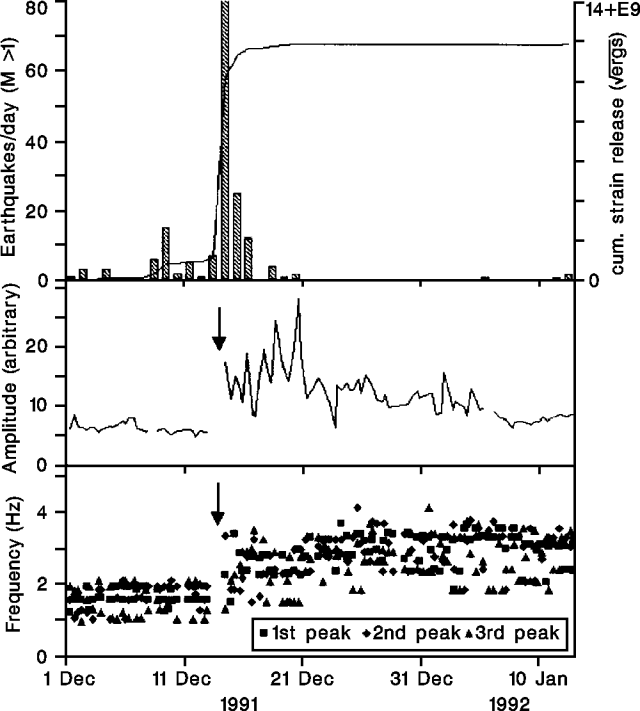 | Figure 44. Daily number of recorded earthquakes and cumulative strain release (top), with amplitude (middle) and dominant frequency peaks of volcanic tremor (bottom) at Etna, 1 December 1991-mid-January 1992. Arrows mark the eruption's onset. Courtesy of the Gruppo Nazionale per la Vulcanologia. |
At least three different focal zones were recognized. On 14 December, one was located NE of the summit and a second in the Valle del Bove. The third, SW of the summit, was active on 15 December. All three focal zones were confined to <3 km depth. Three waveform types were recognized, ranging from low-to-high frequency.
As the seismic swarm began on 14 December, volcanic tremor amplitude increased sharply. Maximum amplitude was reached on 21 December, followed by a gradually decreasing trend. As the tremor amplitude increased, the frequency pattern of its dominant spectral peaks changed, increasing within a less-consistent frequency trend. Seismicity rapidly declined and remained at low levels despite the ongoing eruption.
6. Ground deformation. EDM measurements and continuously recording shallow-borehole tiltmeters have been used for several years to monitor ground deformation at Etna. The tilt network has recently grown to 9 flank stations. A new tilt station (CDV) established on the NE side of the fracture in early 1990 showed a steady radial-component increase in early March 1991 after a sharp deformation event at the end of 1990 (figure 45), suggesting that pressure was building into the main central conduit. Maximum inflation was reached by October 1991, followed by a partial decrease in radial tilt, tentatively related to magma intrusion into the already opened S branch of the 1989 fracture system, perhaps releasing pressure in the central conduit.
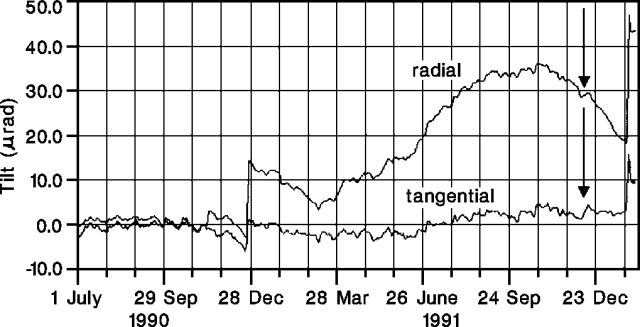 | Figure 45. Radial and tangential components measured by the CDV borehole tilt station on the NE side of Etna's 1989 fracture, 1 July—mid-January 1992. The signal has been filtered for daily and seasonal thermoelastic noise. Arrows mark the eruption's onset. Courtesy of the Gruppo Nazionale per la Vulcanologia. |
The eruption's onset was clearly detected by all flank tilt stations, despite their distance from the eruption site. The signals clearly record deformation events closely associated in time with seismic swarms on the W flank (before the eruption began) and on the summit and SW sector (after eruption onset). The second swarm heralded the opening of the most active vent on the W wall of the Valle del Bove.
S-flank EDM measurements detected only minor deformation, in the zone affected by the 1989 fracture. Lines crossing the fracture trend showed brief extensions in January 1992.
The levelling route established in 1989 across the SE fracture was reoccupied 18-19 December 1991. A minor general decline had occurred since the previous survey (October 1990), with a maximum (-10 mm) at a benchmark near the fracture.
7. Gravity changes. Microgravity measurements have been carried out on Etna since 1986, using a network covering a wide area between 1,000 and 1,900 m asl. A reference station is located ~ 20 km NE of the central crater. Five new surveys were made across the 1989 fissure zone during the eruption (15 & 18 December 1991, and 9, 13, and 18 January 1992). Between 21 November and 15 December, the minimum value of gravity variations was about -20 mGal, E of the fracture zone. On 9 January, the gravity variations inverted to a maximum of about +15 mGal. Amplitude increased and anomaly extension was reduced on 13 January, and on 18 January gravity variations were similar to those 9 days earlier. Assuming that height changes were negligible, a change in mass of ~2 x 106 tons (~2 x 107 m3 volume), for a density contrast of 0.1 g/cm3 was postulated. However, if gravity changes were attributed to magma movement, a density contrast of 0.6 g/cm3 between magma and country rock could be assumed and magma displacement would be ~ 3 x 106 m3.
8. Magnetic observations. A 447-point magnetic surveillance array was spaced at 5-m intervals near the fracture that cut route SP92 in 1989. Measurements of total magnetic field intensity (B) have been carried out at least every 3 months since October 1989. Significant long-term magnetic variations were not observed between February 1991 and January 1992, although the amplitude of variations seems to have increased since the beginning of the eruption.
9. Self-potential. A program of self-potential measurements along an 1.32-km E-W profile crossing the SE fracture system (along route SP92 at ~ 1,600 m altitude) began on 25 October 1989. Two large positive anomalies were consistently present during measurements on 5 and 17 January, and 9, 18, and 19 February 1992. The strongest was centered above the fracture system, the second was displaced to the W. Only the 5 January profile hints at the presence of a third positive anomaly, on its extreme E end. The persistent post-1989 SP anomalies could be related to a magmatic intrusion, causing electrical charge polarizations inside the overlying water-saturated rocks. A recent additional intrusion was very likely to have caused the large increase in amplitude and width of the SP anomaly centered above the fracture system, detected on the E side of the profile on 5 January 1992.
10. COSPEC measurements of SO2 flux. The SO2 flux from Etna during the eruption has been characterized by fairly high values, averaging ~ 10,000 t/d, ~ 3 times the mean pre-eruptive rate. Individual measurements varied between ~6,000 and 15,000 t/d.
11. Soil gases. Lines perpendicular to the 1989 fracture, at ~ 1,600 m altitude, have been monitored for CO2 flux. A sharp increase in CO2 output was recorded in September 1991, about 3 months before the eruption began (figure 46). Measurements have been more frequent since 17 December, but no significant variation in CO2 emission has been observed. Samples of soil gases collected at 50 cm depth showed a general decrease in He and CO2 contents since the beginning of January. Soil degassing at two anomalous exhalation areas, on the lower SW and E flanks at ~ 600 m altitude, dropped just before (SW flank—Paternò) and immediately after (E flank—Zafferana) the beginning of the eruption, and remained at low levels. A significant radon anomaly was recorded 26-28 January along the 1989 fracture, but CO2 and radon monitoring have been hampered by snow.
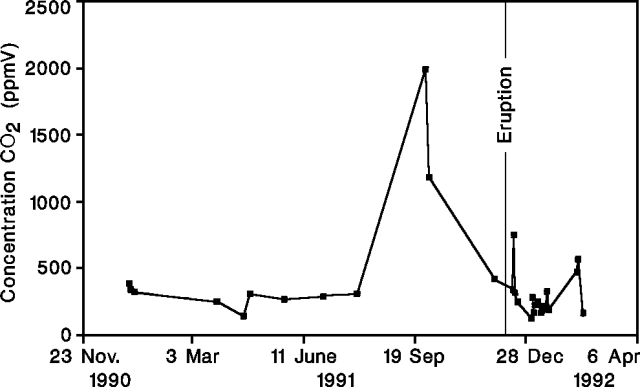 | Figure 46. CO2 concentrations measured along Etna's 1989 fracture, late 1990-early 1992, showing a strong increase about 3 months before the December 1991 eruption. Courtesy of the Gruppo Nazionale per la Vulcanologia. |
The following, from R. Romano, describes activity in February and early March.
The SE-flank fissure eruption was continuing in early March, but was less vigorous than in previous months. An area of ~ 7 km2 has been covered by around 60 x 106 m3 of lava, with an average effusion rate of 8 m3/s. The size of the lava field (figure 43) has not increased since it reached a maximum width of 1.7 km in mid-February.
Lava from fissure vents at ~ 2,100 m asl flowed in an open channel to 1,850 m altitude, then advanced through tubes. Flowing lava was visible in the upper few kilometers of the tubes through numerous skylights. Lava emerged from the tube system through as many as seven ephemeral vents on the edge of the Salto della Giumenta (at the head of the Val Calanna, ~ 4.5 km from the eruptive fissure). These fed a complex network of flows in the Salto della Giumenta that were generally short and not very vigorous. None extended beyond the eruption's longest flow, which had reached 6.5 km from the eruptive fissure (1,000 m asl) before stopping in early January. Ephemeral vent activity upslope (within the Valle del Bove) ceased by the end of February. Lava production from fissure vents at 2,150 m altitude has gradually declined and explosive activity has stopped. Degassing along the section of the fissure between 2,300 and 2,200 m altitude was also gradually decreasing.
Small vents were active at the bottom of both central craters. Activity at the west crater (Bocca Nuova) was generally limited to gas emission, but significant ash expulsions were observed during the first few days in March. High-temperature gases emerged from the E crater (La Voragine). Collapse within Northeast Crater, probably between 26 and 27 February, was associated with coarse ashfalls on the upper NE flank (at Piano Provenzana and Piano Pernicana). After the collapse, a new pit crater ~ 50 m in diameter occupied the site of Northeast Crater's former vent. Activity from Southeast Crater was limited to gas emission from a modest-sized vent.
Seismic activity was characterized by low-intensity swarms. A few shocks were felt in mid-February ~ 12 km SE of the summit (in the Zafferana area).
Reference. Barberi, F., Bertagnini, F., and Landi, P., eds., 1990, Mt. Etna: the 1989 eruption: CNR-Gruppo Nazionale per la Vulcanologia: Giardini, Pisa, 75 p. (11 papers).
Information Contacts: GNV report:F. Barberi, Univ di Pisa; L. Villari, IIV. February-early March activity:R. Romano and T. Caltabiano, IIV; P. Carveni, M. Grasso, and C. Monaco, Univ di Catania.
The following people provided information for the GNV report. Institutional affiliations (abbreviated, in parentheses) and their report sections [numbered, in brackets] follow names.
F. Barberi (UPI) [1, 2], A. Armantia (IIV) [2], P. Armienti (UPI) [2, 4], R. Azzaro (IIV) [2], B. Badalamenti (IGF) [11], S. Bonaccorso (IIV) [6], N. Bruno (IIV) [10], G. Budetta (IIV) [7, 8], A. Buemi (IIV) [4], T. Caltabiano (IIV) [8, 10], S. Calvari (IIV) [2, 3], O. Campisi (IIV) [6], M. Carà (IIV) [10], M. Carapezza (IGF, UPA) [11], C. Cardaci (IIV) [5], O. Cocina (UGG) [5], D. Condarelli (IIV) [5], O. Consoli (IIV) [6], W. D'Alessandro (IGF) [11], M. D'Orazio (UPI) [2, 4], C. Del Negro (IIV) [7, 8], F. DiGangi (IGF) [11], I. Diliberto (IGF) [11], R. Di Maio (DGV) [9], S. DiPrima (IIV) [5], S. Falsaperla (IIV) [5], G. Falzone (IIV) [6], A. Ferro (IIV) [5], F. Ferruci (GNV) [5], G. Frazzetta (UPI) [2], H. Gaonac'h (UMO) [2, 3], S. Giammanco (IGF) [11], M. Grasso (IIV) [10], M. Grimaldi (DGV) [7], S. Gurrieri (IGF) [11], F. Innocenti (UPI) [4], G. Lanzafame (IIV) [2], G. Laudani (IIV) [6], G. Luongo (OV) [6], A. Montalto (IIV, UPI) [5], M. Neri (IIV) [2], P. Nuccio (IGF, UPA) [11], F. Obrizzo (OV) [6], F. Parello (IGF, UPA) [11], D. Patanè (IIV) [5], D. Patella (DGV) [9], A. Pellegrino (IIV) [5], M. Pompilio (IIV) [2, 3, 4], M. Porto (IIV) [10], E. Privitera (IIV) [5], G. Puglisi (IIV) [2, 6], R. Romano (IIV) [10], A. Rosselli (GNV) [5], V. Scribano (UCT) [2], S. Spampinato (IIV) [5], C. Tranne (IIV) [2], A. Tremacere (DGV) [9], M. Valenza (IGF, UPA) [11], R. Velardita (IIV) [6], L. Villari (IIV) [1, 2, 6].
Institutions: DGV: Dipto di Geofisica e Vulcanologia, Univ di Napoli; GNV: Gruppo Nazionale per la Vulcanologia, CNR, Roma; IGF: Istituto per la Geochimica dei Fluidi, CNR, Palermo; IIV: Istituto Internazionale di Vulcanologia, CNR, Catania; OV: Osservatorio Vesuviano, Napoli; UCT: Istituto di Scienze della Terra, Univ di Catania; UGG: Istituto di Geologia e Geofisica, Univ di Catania; UMO: Dept de Géologie, Univ de Montréal; UPA: Istituto di Mineralogia, Petrologia, e Geochimica, Univ di Palermo; UPI: Dipto di Scienze della Terra, Univ di Pisa.
March 1992 (BGVN 17:03)  Cite this Report
Cite this Report
Lava production continues from SE-flank vent; town threatened by lava flow
Most of the following is from R. Romano.
The fissure eruption ... was continuing in mid-April. Lava production from the main vent at 2,100 m altitude (in the W wall of the Valle del Bove) has remained almost constant, accompanied by degassing of varying intensity. By mid-April, 85 x 106 m3 of lava that had emerged at an average rate of 8 m3/s was estimated to cover an area of >7 km2.
From March through mid-April, lava from the main vent immediately entered a complex tube system, reappearing through ephemeral vents ~ 5 km downslope, below the Valle del Bove. The vents formed on the edge of the Salto della Giumenta, at the head of the Val Calanna a few kilometers from Zafferana Etnea, population ~ 7,000 (see figure 43). No ephemeral vents or lava overflows have been observed since the end of February in the wide lava field that had developed in the S part of the Valle del Bove.
On 14 March, lava reached the base of the barrier constructed in early January at the bottom of the Val Calanna. During the second half of March and the first few days of April, lava from the ephemeral vents gradually filled the area from the base of the Salto della Giumenta to the barrier. On 3 April, vents began to form within the Salto della Giumenta, feeding flows inside the Val Calanna. By the morning of 7 April, lava was only a few meters from the top of the barrier, with an active front along the barrier's entire length. That afternoon, lava flowed around the S side of the barrier and began to advance along the access road in the Val Calanna. The next afternoon, lava spilled over the central part of the barrier, and began to move down the gorge of the neighboring Portella Calanna valley. Lava advanced rapidly, aided by the steep slope, covering 1 km in 5 days. At least six earth barriers were built to contain the lava, but none were successful. By 14 April, lava was overflowing the last barrier, at ~ 780 m elevation, 1.5 km from the inhabited center of Zafferana Etnea and 7.5 km from the main vent.
Efforts were also made to slow or halt the advancing lava by disrupting the feeder tube system. Experiments with directed explosives, designed to blast holes in the lava field and encourage lava breakouts, began on 13 April in the upper Valle del Bove and Val Calanna. Lava destroyed two isolated houses above Zafferana on 14 April and covered nearby orchards, but the lobe threatening the town had virtually stopped by the next day and evacuation plans were postponed. New lava approached Zafferana over earlier flows in the succeeding days, and was again within a kilometer of the town by 20 April.
Degassing from the summit craters has gradually decreased following the collapse episode in Northeast Crater at the end of February (17:02). Additional Northeast Crater collapses 21-29 March triggered ash ejections accompanied by distinctive seismicity. Moderate gas emission from the summit vents observed by B. Behncke on 21 March was punctuated around 0900 by several low-energy ash emissions from Northeast Crater. At 1230 on 24 March, a dark-gray, convoluted ash plume rose to ~ 1 km above the summit within ~ 5 minutes, and also appeared to spread laterally at its base. The plume gradually dissipated during the following 30 minutes, depositing tephra to the E.
Information Contacts: R. Romano, T. Caltabiano, and M. Porto, IIV; P. Carveni and M. Grasso, Univ di Catania; B. Behncke, GEOMAR, Kiel; Il Mattino, Napoli; AP; UPI; Reuters.
April 1992 (BGVN 17:04)  Cite this Report
Cite this Report
SE-flank fissure eruption continues; lava diversion attempted
Lava has emerged from a SE-flank fissure in the W wall of the Valle del Bove since 15 December, covering an estimated 7.3 km2 with ~ 100 x 106 m3 of lava. A well-developed tube system carried lava downslope, threatening the town of Zafferana Etnea and prompting attempts at lava diversion (figure 47). The lava production rate, as observed through numerous skylights along the main lava tube, has remained relatively constant, but distal flow fronts advanced at varying rates. The apparent intensity of gas emission from the eruptive fissure changed with weather conditions. During the last 10 days of April, fumarolic activity was observed in the W wall of the Valle del Bove, extending upslope from the eruptive fissure along its NNW trend. This zone was active on 14 December during the initial phase of the eruption.
 | Figure 47. Topographic sketch map showing Etna's 1989-92 lava flows, with preliminary locations of the 1991-92 eruptive fissures, and the barrier constructed in January in Val Calanna. Areas covered by lava since 14 January and 10 March are shown in separate patterns. Asterisks mark sites of lava diversion experiments in April and May. Courtesy of R. Romano, T. Caltabiano, P. Carveni, and M.F. Grasso. |
Lava overwhelmed a series of barriers in early April, and advanced 1 km down a gorge (within the Valle di Portella Calanna) toward Zafferana during the second week in April. This flow stopped on 15 April at 750 m elevation, roughly 1.5 km from the inhabited center of Zafferana. Numerous ephemeral vents began to form below 1,000 m elevation on 19 April (on the E edge of Val Calanna, in which a barrier had been built in early January). Flows from these vents covered lava from previous days along the gorge below Portella Calanna. The longest stopped during the evening of 25 April at 755 m altitude, ~ 7.5 km from the eruptive fissure and 1.5 km from the center of Zafferana. Lava flows originated from a large ephemeral vent at the head of Val Calanna in the beginning of May, passing Portella Calanna atop previous flows on 6 May and reaching 850 m asl that evening.
Ephemeral vents also developed upslope, within the wide lava field that had formed in the S part of the Valle del Bove during previous months. The first formed around 1,900 m altitude (at Monte del Rifugio Menza) on 22 April, and a second occurred near the center of the lava field, at around 1,550 m elevation (near Poggio Canfareddi) on 25 April. Flows from these vents were not very substantial and were no longer active a few days later. On 5 May, only a modest active vent at the N edge of the lava field (around 1,600 m elevation) was observed.
Experiments with the use of explosives, cement blocks, and, more recently, lava blocks continued at skylights in the main lava tube (in the upper Valle del Bove, at around 2,100 m altitude, on 17, 21, and 29 April, and 4 May) and at ephemeral vents (near Portella Calanna on 15 April and in Val Calanna on 6 May). These were designed to cause lava overflows and thus reduce the amount of lava carried in tubes toward inhabited areas. As of early May, it was difficult to evaluate whether these experiments had favorably affected the course of the eruption. On 4 May an overflow began from a skylight in the main lava tube at around 2,100 m altitude, where blocks of cement had been dropped and explosives detonated on previous days. The modest overflow moved over the lava field that had formed in the preceding months. However, during this time, numerous ephemeral vents, varying daily in number and location, remained active above Zafferana at the head of Val Calanna (in the Salto della Giumenta).
Slow, weak degassing continued through early May from the summit craters. Weak ash ejections, caused by internal collapse, were observed only from Northeast Crater, on 22 April. Early April-early May seismic activity was much reduced from previous months.
Information Contacts: R. Romano and T. Caltabiano, IIV; P. Carveni and M. Grasso, Univ di Catania.
May 1992 (BGVN 17:05)  Cite this Report
Cite this Report
Fissure eruption continues; lava diverted; lava field described
The following is from R. Romano. Lava production from the fissure ... was continuing without noticeable variation in mid-June. Gas emission, from four explosion vents between 2,335 and 2,215 m elevation, has diminished along the upper part of the fissure. The main lava channel has roofed over, but lava was visible through a skylight beginning at 2,205 m elevation, where the effusion rate was estimated at 6-8 m3/s and the flow velocity at ~ 1 m/s on 7 and 13 June. Three more skylights were open along the main channel to 2,020 m asl. An overflow occurred on 12 June from one of the skylights, at 2,075 m altitude, but lava advanced only a few meters before returning to the main channel. This overflow was still active the next day. Ephemeral vents from the main tube remained active through the end of May: in the Valle del Bove; below the Valle del Bove in Val Calanna; and near the distal end of the flow field, along a deep gully under Portella Calanna (figure 48). Lava flows emerged more or less continuously from the latter vents, but did not descend below 800 m altitude. The total volume of lava produced by the eruption is estimated at 150 x 106 m3.
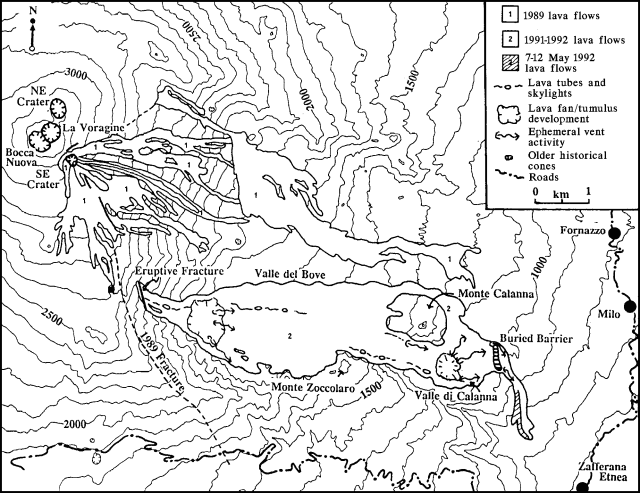 | Figure 48. Status of activity within Etna's flow field on 18 May 1992, after 153 days of activity. Modified by Hughes and Bulmer from map by Romano in 17:4. Contour interval, 100 m. |
Lava diversion. An earthen barrier built in a valley above the town of Zafferana Etnea in early January was breached by lava on 7 April. Lava overran a series of additional barriers the following week but stopped before reaching the town. Subsequent hazards efforts focused on reducing the lava supply to the end of the flow, by obstructing the main lava tube near the vent and disrupting lava production at ephemeral vents (17:3-4).
F. Barberi and L. Villari report successful lava diversion from the main tube, at a site 500 m downslope from the primary eruptive vent. In this area, at ~ 2,000 m elevation on the W wall of the Valle del Bove, lava was carried through a single tube locally broken by skylights. On 27 May, about 2/3 of the tube's lava was diverted into an artificially excavated channel by blasting through the 2-3-m-thick wall of the right levee. Two days later, bulldozers obstructed the natural channel by pushing large blocks of lava into it. By 1815 that day, all of the lava output (~30 m3/s) was flowing into the artificial channel. In effect, the diversion returned the active flow front to its position a few days after the onset of the eruption. Lava was moving downslope along the same path as the earlier main flow, but was > 6 km upslope from its previously most advanced front.
Flows generated by lava diversion efforts. R. Romano reports that as of 13 June, a vent remained active at the site of the first lava diversion. Although the vent has been shrinking, it continued to feed a flow that has advanced over lava from previous months, forming tubes and various ephemeral vents, many of which were near the S wall of the Valle del Bove. The ephemeral vents produced two lava flows, one near the S wall of the Valle del Bove at around 1,700 m elevation, the other in a more central position, at ~ 1,800 m asl on the main lava field. The lava flows that formed after the first diversion advanced more than a kilometer over the center of the lava field. Flows that followed the second diversion remained predominantly near the S wall of the Valle del Bove, passing and encircling a site at 1,575 m asl (Poggio Canfareddi), 2 km from their point of origin, on 3 June. This lava front stopped advancing on 5 June and several superposing lobes began to develop.
Seismicity and summit activity. Weak seismic activity began on 29 May, followed by an increase in volcanic tremor on 31 May that continued until the next day. Ash emissions, sometimes voluminous, occurred from the central craters at irregular intervals on 31 May and 1 June, first from the W vent (Bocca Nuova) then from the E vent (La Voragine). Only weak degassing preceded the ash ejection, but gas emission became more consistent beginning 2 June. COSPEC measurements yielded SO2 flux values of ~ 10,000 t/d. Flashes from the summit craters were observed during the evening of 7 June from the W flank. Fieldwork on 12 June revealed that Northeast Crater was obstructed, with only fumarolic activity along the walls.
EDM data. S. Saunders reports that four lines of an EDM network on the upper S flank were remeasured on 7 May, showing a 138-ppm contraction that was interpreted as deflation during the eruption. Between July and October 1991, total extensional strain along these lines was 88 ppm, indicating pre-eruption inflation. Strain along these lines has returned to near pre-eruption levels.
Landsat Thematic Mapper data. The following is from D. Rothery. "The 1991-92 sustained lava eruption of Etna provides an opportunity to study lava flow development by remote sensing. The first cloud-free Landsat Thematic Mapper (TM) image of the eruption was recorded on 2 January at approximately 1000 (figure 49). Landsat repeats its coverage on a 16-day cycle; the next cloud-free acquisition was on 22 March and we are still awaiting receipt of those data. By manipulating radiance measurements in two wavebands, we hope to be able to constrain the surface temperature distribution of this flow along its length. The most noteworthy aspects of the 2 January data are: 1) There is a narrow 700-m length near the source that is radiant in TM band 4 (0.76-0.90 mm wavelength). As far as we know, this is the first time that thermal radiance in TM band 4 has been reported over a volcano. Field observations (A. Borgia) on 2 and 3 January show that this feature corresponds to a 10-15-m-wide open channel at the source of the flow. 2) The entire 6.5-km-long active flow is radiant in TM band 7 (2.08-2.35 mm wavelength). At least some of the areas that are also radiant in band 5 (1.55-1.75 mm) occur when the flow spills down a steep slope, breaking apart the raft of blocks and crust that otherwise blanket the underlying lava at near-magmatic temperatures."
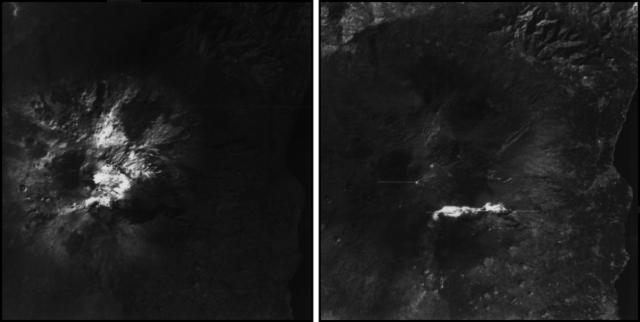 | Figure 49. Extracts of Landsat TMr images of Etna, 2 January 1992, in band 4 (0.76-0.90 mm wavelength, left) and band 7 (2.08-2.35 mm wavelength, right) at pixel sizes of 30 x 30 m. In band 4, much of Etna is snow-covered (white), while the active lava flow is the darkest land feature because of its very low reflectance in this part of the spectrum (very-near infrared). Thermal radiance is confined to a narrow channel near the source and is not evident at this scale. In band 7, the active flow is radiant through most of its length. Bright lines are caused by sensor overload. Courtesy of D. Rothery. |
Lava field characteristics. The following is an excerpt from a preliminary report by Wyn Hughes and Mark Bulmer, describing the eruption as of 18 May.
Lava leaving the eruptive vent advanced through a tube system that extended downslope to the foot of the western backwall of the Valle del Bove at 1,850 m asl. Several skylights were spaced at intervals along it. At the break in slope, numerous active ephemeral vents issued new lava-flow units onto the surface of the flow field (figure 48). These did not travel far from their source. Surface activity was otherwise absent within the Valle del Bove; lava was being efficiently transported through tubes toward the flow front. One tube system (with skylights and fume) could be traced through the center of the flow field in the Valle del Bove, toward Val Calanna. At the distal end of the Valle del Bove, several pressure ridges were visible, oriented perpendicular to the underlying ground slope.
Most of the surface activity was occurring in Val Calanna, where intense ephemeral vent activity was issuing new lava-flow units onto the flow-field surface. Lava was being supplied to this area through a series of tubes that descended from the Valle del Bove. Most of the activity in Val Calanna appeared to be supplied by a major tube system that could be traced (by skylights and fume) descending the backwall along its S margin (Salto della Giumenta). A smaller tube system probably supplied some ephemeral vents on the N margin of Val Calanna (S foot of Mte. Calanna).
In Val Calanna, effusive activity was mainly concentrated along the S margin of the flow field, where lava had ponded along the S wall of Val Calanna, and behind the man-made earthen barrier. From there, ephemeral vents in the crust fed numerous new lava-flow units, supplying three regions. Where lava moved directly NE, these were progressively widening the flow field at 1,050 m altitude. Flows that initially moved NE, but then changed to a more easterly direction, were supplying units that flowed around the N margin of the buried man-made barrier. Near the barrier, although active aa-textured flow fronts and channel-fed flow units could be traced on the surface of the flow field, most of the activity that contributed to its widening was supplied from tubes in the previous days' flow units. Ephemeral vents at 1,000 m elevation on the N margin of the buried man-made barrier supplied new flow units that were widening the field to the NE. However, these flow units were abutting the distal levee of the 1852-53 flow field, which was largely hindering the widening. On 18 May, some of these slow-moving tube-fed lavas managed to flow out of Val Calanna, and began the steep descent towards Zafferana. This activity was occurring on the NE side of the flow field. Three ephemeral vents had opened just below the S margin of the man-made barrier. A short distance downslope, flows from these vents combined to feed a front that advanced quite rapidly down the SW side of the flow field on the night of 17 May. By the next morning, and after destroying an abandoned dwelling during the night, the rate of advance had decreased, with the front at ~ 870 m asl. All of these active regions were being channel/tube-fed by lava from along the S wall of Val Calanna, which in turn was being supplied by tubes that descended from the Valle del Bove.
Flow-field morphology. Although the flow field was widening somewhat towards the NE end of Val Calanna, the activity was dominated by ephemeral vents extruding new flow units onto the surface of the original field. This was mainly occurring at ~ 1,800 and 1,050 m altitude, where the backwalls of the Valle del Bove and Val Calanna give way to their respective floors (figures 48 and 50). The surface activity was rapidly burying aa channel-fed flow units from early in the eruption. They could only be seen among the flows that had gone around the N margin of Mte. Calanna, and as isolated inliers on the floor of Val Calanna.
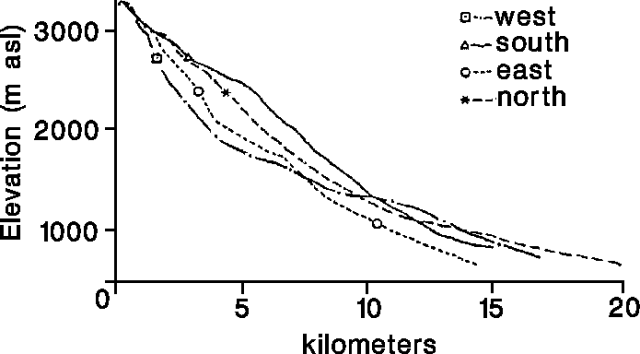 | Figure 50. Profile of the pre-eruption terrain in the 1991-92 lava field at Etna. Sites of ephemeral vent activity and zones of lava tubes and channel-fed units are shown diagrammatically. Courtesy of J.W. Hughes and M. Bulmer. |
New flow units from ephemeral vents generally emerged with pahoehoe surface textures, in contrast to the early activity whose products had entirely aa textures. The flow-field surface on the floor of Val Calanna, as already occurred in the Valle del Bove, was slowly becoming dominated by pahoehoe textures. Small-scale pahoehoe textures, similar to those described by Pinkerton and Sparks (1978) for the sub-terminal 1975 flow field, prevailed around the ephemeral vents in Val Calanna. However, among the more active vents, pahoehoe slab textures that characterized the near-vent surfaces of new channel-fed flow units progressively changed to aa with increasing distance from the vent area.
Comparison with historical flow fields on Etna. The current ephemeral vent activity within the 1991-92 flow field is consistent with the pattern of historical eruptions that lasted > 100 days (Hughes, 1992). By then, the early channel-fed aa activity that characterized the lengthening and widening phases in the flow field's growth had given way to a tumulus-building phase at the vent area — for example, 1865 (Fouque, 1865); or at a break in slope below the vent area — for example, 1950-51 (Cumin 1954) and 1983 (Frazzetta and Romano, 1984). Important in the emplacement of the 1983 flow field was the evolution of the main supply channel near the vent into a lava tube. By the eruption's 60th day, the tube formed a continuous link between the vent and the lava mound that had accumulated around the break in slope at 2,000 m altitude. The hydrostatic pressures generated within the lava tube were then sufficient to lift and fracture the roof of the lava mound, allowing the escape of lava through ephemeral vent activity. This sequence of events signified the early stages of tumulus development. The present activity occurring at 1,800 m altitude within the Valle del Bove is similar.
The second area of ephemeral vent activity away from the vent area and initial break in slope appears, however, to be unique to the 1991-92 flow field; a similar phenomenon has not been documented for Etna flow fields of the last 250 years. For most, the concave profile of the volcano's flanks (figure 51) meant that once the lava had descended from the steep upper slopes it only encountered progressively gentler gradients. However, the terrain over which the 1991-92 lavas have flowed is much more irregular, with a terraced appearance. The steep terrain around the vent in the upper Valle del Bove is duplicated downslope in the upper reaches of Val Calanna. The morphologic positions of the ephemeral vent activity within the Valle del Bove and Val Calanna are similar (figure 50); both occur at the foot of a steep slope down which lava is transported through tubes. It must be concluded that conditions favoring tumulus construction have also been duplicated within Val Calanna.
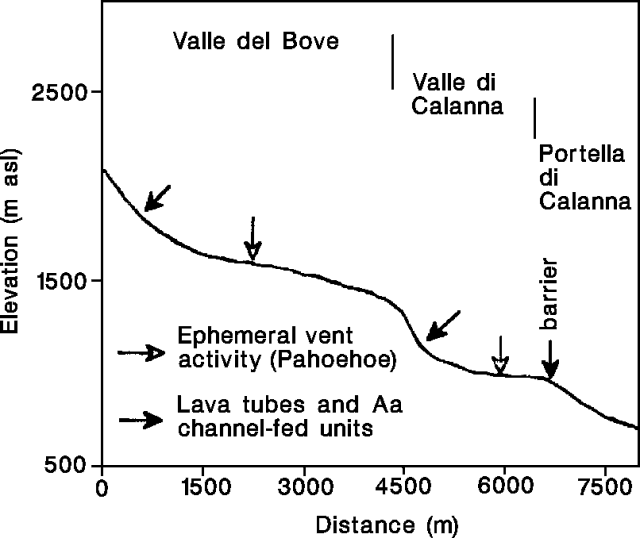 | Figure 51. Profiles of the N, S, E, and W flanks of Etna. Courtesy of J. W. Hughes and M. Bulmer. |
References. Cumin, G., 1954, L'eruzione laterale del Novembre 1950-Dicembre 1951: BV, v. 15, p. 3-70.
Fouque, F., 1865, Sur l'eruption de l'Etna du 1st Fevrier 1865: C. Rend. Acad. Sci. Paris; v. 60, p. 1331-1334; and v. 61, p. 210-212.
Frazzetta, G., and Romano, R., 1984, The 1983 Etna eruption: event chronology and morphological evolution of the flows: BV, v. 47, p. 1079-1096.
Hughes, J.W., 1992, The Influence of volcanic systems on the morphological evolution of lava flow fields: Ph.D. dissertation, University of London, 255 p.
Pinkerton, H., and Sparks, R.S.J., 1976, The subterminal lavas, Mount Etna: a case history of the formation of a compound lava flow field: JVGR, v. 1, p. 167-182.
Information Contacts: F. Barberi, Univ di Pisa; L. Villari, IIV; R. Romano and T. Caltabiano, IIV; P. Carveni, M. Grasso, and C. Monaco, Univ di Catania; W. McGuire and A. Morrell, Cheltenham and Gloucester College of Higher Education; S. Saunders, West London Institute; D. Rothery, A. Borgia, R. Carlton, and C. Oppenheimer, Open Univ; J. Wyn Hughes and M. Bulmer, Univ College London.
June 1992 (BGVN 17:06)  Cite this Report
Cite this Report
Continued flank lava production
Lava production continued from the fissure that opened in the W wall of the Valle del Bove on 15 December. Gas emission from 4 vents in the upper part of the fissure (2,215-2,235 m altitude; figure 52) fluctuated daily, probably with changes in weather conditions. However, gas emission has diminished since the eruption's initial months.
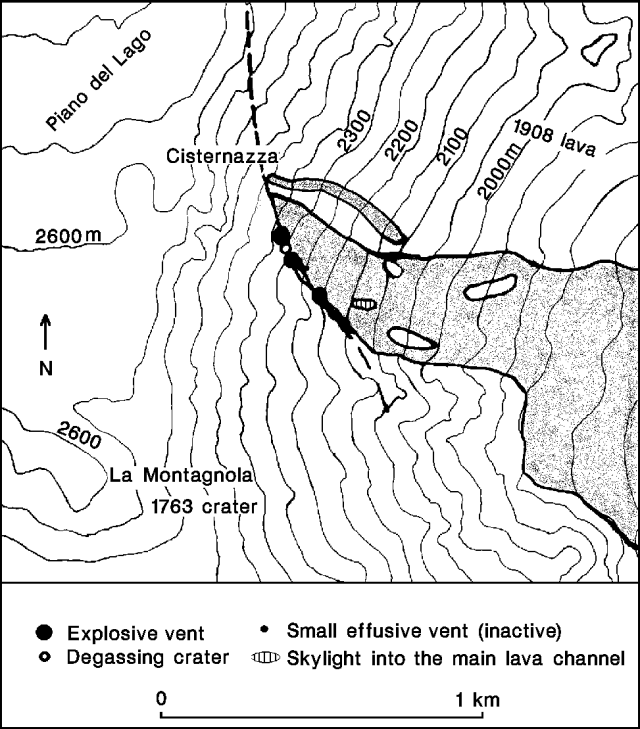 | Figure 52. Sketch map of the fissure system and the upper part of the lava field at Etna, June 1992. Contour interval, 50 m. Courtesy of Romolo Romano. |
No variation was evident in the movement of lava visible through a skylight high in the main channel, at 2,205 m altitude. Lava was also seen flowing through a skylight in lava tubes that formed in June along the channel into which lava was artificially diverted on 27 May (~ 1,980 m elevation) (17:05). From there, lava advanced through a complex series of tubes past the field that had formed in recent months. Lava again reached the surface around 1,800 m altitude from a changing number (generally 3-4) of ephemeral vents at varying locations representing tube bases. Lava flows extruded from these vents have generally been modest, have remained in the center of the lava field, and have not advanced beyond 1,600 m asl. As of the morning of 9 July, only one flow was active within the Valle del Bove, near the center at around 1,670 m altitude, with a fairly well-fed front. The volume of lava produced during ~7 months of eruption is estimated to be around 165 x 106 m3.
Seismic activity during the period was characterized by low energy release. Significant increases were observed 8-9 July, when events of 2-4 Hz were recorded. The most significant perturbations were detected on 8 July at 1554, for 180 seconds, and at 1601 for 130 seconds. Tremor was almost nonexistent, obscured by seismic noise that characterizes periods of low activity at the volcano.
More or less voluminous gas emissions occurred from two vents at the bottom (~100 m from the rim) of the two central craters (Bocca Nuova and La Voragine). Incandescence caused by superheated gases (>1,000°C) from the vent in La Voragine was sometimes visible. Gas also emerged from a vent that has opened in Southeast Crater. Northeast Crater appeared to have been completely obstructed by internal collapse. COSPEC measurements of SO2 flux from the summit crater showed relatively high values of ~ 8,000 t/d.
Information Contacts: R. Romano and T. Caltabiano, IIV; P. Carveni, M. Grasso, and C. Monaco, Univ di Catania; G. Luongo, OV.
July 1992 (BGVN 17:07)  Cite this Report
Cite this Report
Continued lava production from SE-flank fissure; lava diversion summarized
The following, from R. Romano, describes activity from early July through early August.
Early July-early August activity. The eruption ... was continuing after ~ 8 months. Gas emission from the upper part of the fissure has greatly diminished lately, although abundant white vapor was often observed, probably because of weather conditions. Fieldwork on 5 August revealed no notable changes in effusive activity from previous months. The lava flow was visible through a skylight at the beginning of the main lava channel (at 2,205 m asl) and through two smaller skylights at 2,100 m altitude. From there to ~ 1,800 m, lava flowed through a complex system of tubes, resurfacing from numerous ephemeral vents that varied in number (generally about 10) and location (mainly in the center of the lava field). From these ephemeral vents (all between 1,800 and 1,700 m elevation) very modest lava flows emerged. These advanced a few hundred meters at most, never moved past 1,600 m altitude, and remained within the pre-existing lava field. The total volume of lava produced by 234 days of activity was estimated at 170 x 106 m3.
No significant changes were observed at the central craters, where gas emission continued. The more active vent in early August was at the W crater (Bocca Nuova). Northeast Crater has remained obstructed for a few months, with only weak fumarolic activity on the inner walls. Internal collapses continued to occur. Gas emission from Southeast Crater was unchanged.
Seismic activity was low, with only 22 recorded events from early July through early August. The majority of the seismicity was characterized by swarm sequences in the summit area. The most significant, on 11 August, consisted of four shocks with a maximum magnitude of 2.5. Harmonic tremor was of very low energy and showed no variation over time.
The following is from a report by L. Villari.
Civil Protection problems and lava diversion. An earthen barrier was erected at the E end of Val Calanna by the beginning of January 1992, to prevent or delay the advance of lava into a narrow valley leading directly to the nearby (~ 2 km downslope) village of Zafferana Etnea (17:02). Lava expanded into the large Val Calanna basin in February and March, and began to accumulate against the inner wall of the barrier on 14 March. By the end of the month, lava almost completely filled the Val Calanna basin and rose slowly up the barrier's inner wall. Several lobes successively reached the barrier, and the lava field progressively grew and thickened, reaching the barrier rim by 7 April. Lava first overflowed the barrier, along its N sector, during the evening of 8 April, quickly followed by other lobes along the S and central part of the barrier's rim. Lava covered ~ 1 km during the first few hours, merging downslope into a single stream that advanced quickly toward the village. The flow's confinement in a narrow valley favored more rapid progress downslope. Three minor earthen barriers were rapidly constructed along the valley (10-11 April, 830 m asl, 110 m long, 12 m high; 11-12 April, 810 m asl, 90 m long, 6 m high; 13-14 April, 770 m asl, 160 m long, 12 m high) to slow the advancing flow. The barriers were built, like the major one at the E end of Val Calanna, by digging the valley bottom in front of the advancing flow and accumulating the loose material on a small natural scarp. Because the valley is narrow, the confined basins were only able to contain small volumes of lava, and the flow's advance was only briefly delayed (for hours to a day). The front reached <1 km from Zafferana (at Piano dell'Acqua) on 16 April, ~1.5 km from the major barrier and 8 km from the eruptive fissure (figure 53).
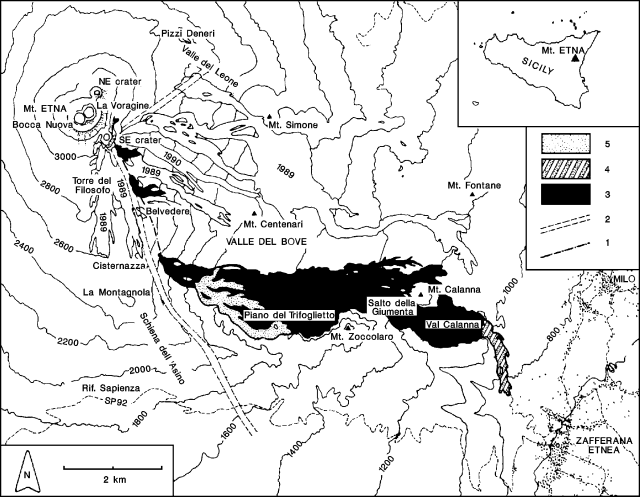 | Figure 53. Sketch map of the 1991-92 lava field at Etna. 1. 1991-92 eruptive fissure; 2. 1989 fracture system; 3. 1991-92 lava flows; 4. lava flows downslope from the barrier at the E end of Val Calanna; 5. lava flows fed by the diversion. Dots mark individual houses in the Zafferana and Milo areas. Courtesy of L. Villari. |
At that time, morphologic conditions prevented any other local intervention to slow the lava advance. The creation of any possible artificial obstacle to the advancing front would divert the flow toward inhabited areas not necessarily threatened by the natural flow path. Diversion efforts were therefore concentrated far upslope, near the eruptive vent.
Attention was primarily on a skylight in the main lava tube at ~ 2,000 m altitude on the W wall of the Valle del Bove, a few hundred meters from the active vent. The diversion's early focus was blockage of the main tube carrying lava to the active front, by sliding solid rocks and concrete blocks into the flowing lava. Access problems required transport of solid materials to the site by helicopter, to be directly unloaded into the lava stream, or accumulated around the skylight's rim for later use. Lava tube blockage was also assisted by blasting large volumes of solid lava and welded scoriae forming the flow levees. This was partially successful and contributed to slowing the advance of the active front by several days.
Despite these efforts, on 5 May, a major new flow emerged from Val Calanna atop the 10 April flow, reaching Piano dell'Acqua on 11 May, 120 m beyond the 16 April flow and ~ 500 m from the outskirts of Zafferana. On 22 May, a further attempt to divert lava from the main natural tube to an artificially excavated channel high in the Valle del Bove produced a vigorous lobe that traveled 1 km in a few hours. Only 1/3 of the lava was spilled into the artificial channel, and the new flow roofed over within two days, with a significant loss of supply from the main natural flow.
A four-phase intervention plan was then defined (figure 54): a) digging an artificial channel to drain the main natural tube; b) cutting the lateral tube wall to a minimum thickness (2-3 m) that could be blasted through with a single charge; c) blasting the lateral wall; d) blocking the natural tube to divert all of the lava into the artificial channel.
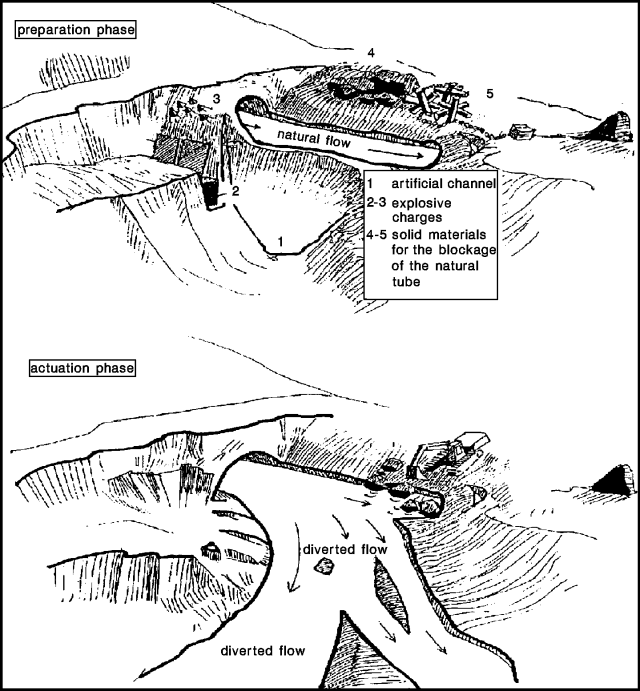 | Figure 54. Sketch of the lava diversion carried out at Etna, 27 May 1992. Courtesy of L. Villari. |
Phases a and b were accomplished in about a week. A 7-ton charge, set off in a single explosion on 27 May at 1636, opened a large breach in the natural tube and caused spillage of ~ 80% of the flowing lava. The natural tube was progressively blocked by sliding solid materials into it during the next two days, and the flow was totally diverted into the artificial channel by 29 May. The artificially channeled flow went down the W slope of the Valle del Bove and remained confined inside the valley. The diversion effort stopped the most advanced front that had been moving toward Zafferana, by removing its source of supply.
The artificially channeled lava flow had extended to 1,550 m asl in the S part of the Valle del Bove (at Piano del Trifoglietto) by 30 May. Lava output from the ephemeral vents in Val Calanna quickly decreased, and molten lava was not evident within a few days.
The effusion rate from the eruptive fissure decreased sharply 31 May-1 June, causing the active flow front to be confined within the Valle del Bove, as activity resumed in the central craters. Several hours of continuous ash emission occurred from the W crater (Bocca Nuova) on 31 May, and an incandescent blowhole formed in the E crater (La Voragine) following gas blasts on 1 June. Noisy gas emission continued from La Voragine in succeeding days.
During June, lava flowing in the artificial channel expanded within the Valle del Bove to ~ 1,650 m elevation, overlapping the lava field that had formed since January. The effusion rate was reduced ~ 50% by the end of June, and the upper part of the artificial channel became a tube. The longest flow did not extend more than 1.5 km from the diversion point at 2,000 m altitude. At the end of June, the newly generated lava field, overlapping the old one, covered ~ 0.8 km2.
Northeast Crater. Repeated inner-wall collapses have been observed in Northeast Crater since February. They became quasi-continuous from 26 February through mid-March, associated with explosive activity that ejected blocks and caused a little fine reddish ashfall. From the end of March until 23 May, the collapses were limited to episodes lasting only several hours each, associated with only minor fine ashfall. The crater bottom dropped ~70 m, leaving a pit ~100 m across in place of the previous funnel-shaped depression.
Lava flow measurements. Lava-channel dimensions, flow velocity, and related rheological parameters were observed at a skylight along the lava tube at 2,000 m altitude, and at ephemeral vents in the Val Calanna area, 7 km downstream at 1,000 m elevation. Flow velocities at the exit of the lava tube (~ 4-5 m wide and 5 m deep) in May and the beginning of June were 0.5-1 m/s; flow rates and viscosities were 15-25 m3/s and 100-300 Pas. At the ephemeral vents and the single-channeled flows (1-4 m wide and 1-2.5 m deep), March-May flow velocities were 0.1-0.3 m/s. The calculated flow rate ranged from 0.1 to 4 m3/s, with a corresponding viscosity of 150-1,300 Pas. (See the report by Murray, below, for velocities and flow rates from late June through mid-July).
Direct measurements in June along the main channel (10-40 cm below the lava surface) at 2,000 m altitude, using an immersion thermocouple (Pt-PtRh) yielded temperatures of 1,053-1,068°C. Values were similar (1,030-1,068°C) at several ephemeral vents (10-60 cm inside the lava flow) in the Val Calanna area from March until the end of May.
Petrography and chemistry. Analysis of lava sampled near the vent and at the flow fronts showed no significant variations in chemical or petrologic composition (17:02). All are porphyritic hawaiites (Mg## 52-54), with phenocrysts of plagioclase (15-25 volume %), clinopyroxene (7-10%), olivine (2-3%) and minor (~ 1%) Ti-magnetite.
Seismicity. Low-level seismic activity characterized February-June, despite the continuing eruption. The daily rate was quite low, with only 24 fault-derived earthquakes of M >1 recorded during the period, a rather low value for Etna. No variations were evident in the daily rate or the cumulative strain release (figure 55). Most of the recorded shocks were centered on the SE flank. Maximum local magnitude was 2.8. There were no significant changes in the pattern of volcanic tremor amplitude. Two short episodes of increasing amplitude, on 31 May and 1 June, had maximum overall amplitudes slightly lower than during the December 1991 eruptive phase.
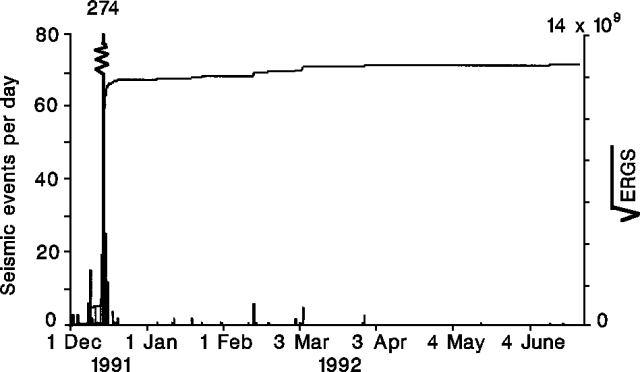 | Figure 55. Daily number of seismic events (M >1) and cumulative seismic strain release recorded at Etna, December 1991-June 1992. Courtesy of L. Villari. |
From 26 February until May, seismic stations on the upper flanks recorded many shocks characterized by an emergent onset and low frequency content. At least three waveform types were recognized. All of the shocks were located near the summit craters at <1 km depth. At the same time, morphologic changes were noted within Northeast Crater, associated with the emission of non-juvenile tephra. Most of these shocks were believed to be linked to rockfalls within Northeast Crater. Some explosion shocks were recorded during the same period. These phenomena were most common in February and March, then gradually decreased, disappearing entirely by 23 May.
Ground deformation. Continuous monitoring of ground tilt in a shallow borehole network showed only minor variations since the eruption began in December 1991. No sign of the expected deflation of the volcano was noted, despite the large volume of magma that has been erupted.
EDM networks on the S, SW, and NE flanks, previously surveyed in 1991, several months before the eruption began, were re-measured in late spring and early summer. Contraction was observed, mostly on the SW and NE flanks, while the S flank did not show any appreciable change in line length. The overall deformation pattern of the volcano appears consistent with shallow magma injection into the eruptive fissure, trending roughly NNW-SSE (figure 56). GPS surveys in April-May 1992 detected significant contraction of lines, mostly on the W flank, compared to previous surveys in June-July 1991 (figure 57).
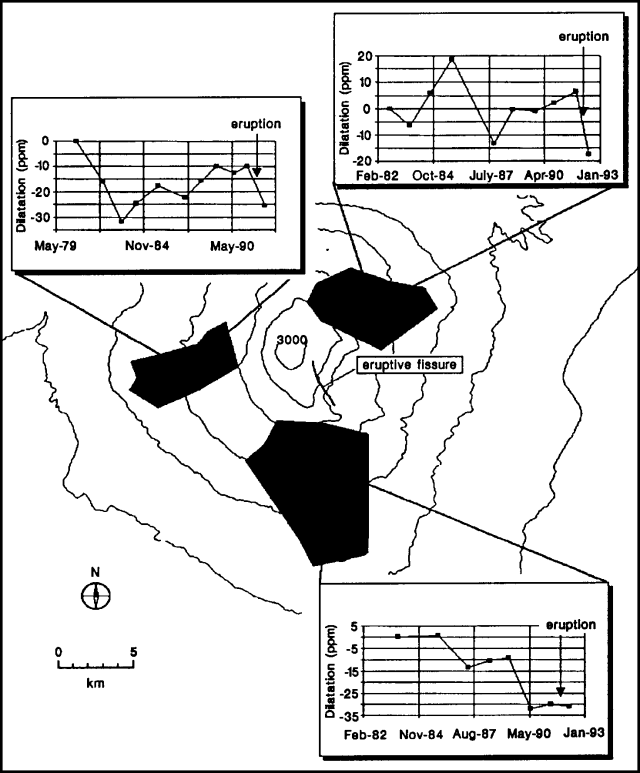 | Figure 56. Cumulative areal dilation measured at 3 EDM networks on the flanks of Etna, 1981-92. Courtesy of L. Villari. |
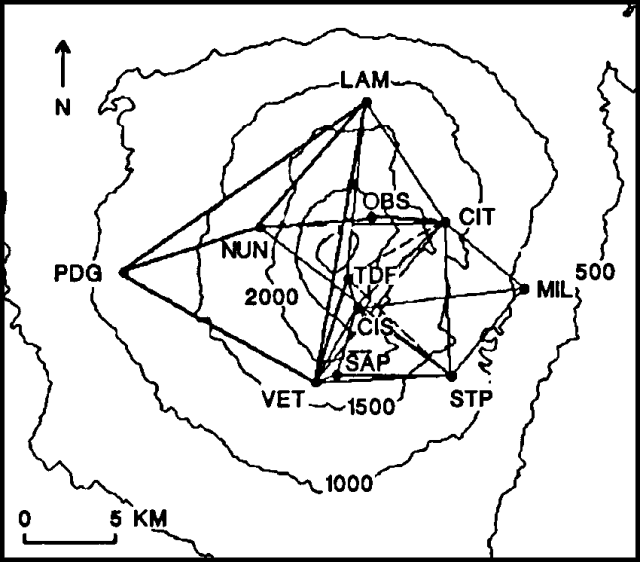 | Figure 57. Variations in slope distance between GPS measurements at Etna in 1991 and 1992. Heavy lines show contraction, dashed lines show extension. Courtesy of L. Villari. |
The following, from J.B. Murray, describes eruptive activity and the results of deformation studies, 9 June-14 July.
Lava flows. The rate of lava production from the vent in the W wall of the Valle del Bove was much lower than in April. Active flows were visited on 28 June, and 7, 10, 12, and 13 July. Central flow speeds of 2-10 m/minute (depending on slope), widths of 1.5-6 m, and a rate estimated at around 0.3-0.4 m3/s were noted at a single flow on 28 June. A flow about twice as big was seen to the E, suggesting a total discharge of the order of 1 m3/s. Flow fronts were only advancing to ~ 1.2 km from the vent on 28 June, but discharge seemed slightly increased during July visits to the fronts, which were about 2.2 km from the vent on 7 July, and 2.6 km by 13 July.
Summit activity. Continued collapse was occurring around the edge of Northeast Crater, with rockfalls every few minutes or so. Particularly big collapses were seen on 8 July between 1556 and 1610. Southeast Crater had strong high-temperature fumaroles, but no Strombolian activity.
The floors of the two central craters both had single vents that continuously discharged hot gas without any explosions. The vent in La Voragine was ~3 x 10 m, glowed bright red in daylight, and beginning 10 June emitted gas in voluminous puffs from which radiant heat could be felt. There were no signs of fresh bombs or scoriae around the vent. The depth of Bocca Nuova was estimated at ~160 ± 20 m.
Vertical movement. A 25-km levelling traverse, and heights derived from trigonometric levelling during trilateration, yielded details of vertical displacement of 241 stations across the summit and upper flanks since September 1991. Subsidence occurred along a narrow strip extending SSE from the summit, with maximum movements reaching just over 1 m (at two stations between Cisternazza and Belvedere). This central strip is flanked by a swelling to the W of 3-7 cm, and a much larger swelling to the E that reaches 37 cm (at Serra Giannicola Piccola). Southeast Crater has dropped 87 cm and Northeast Crater 48 cm, and the NE rift has risen another 3.4 cm (near Monte Pizzillo). These movements are similar to displacements seen over eruptive dikes in 1989, 1986, 1985, and 1983, but the swelling to the E is higher and broader than any previously recorded.
Horizontal movement. The summit trilateration network shows E-W extensions of 1-1.5 m since September 1991 across the graben and fissures leading S to the eruption site. It is clear that the main feeder dike passes between the Torre del Filosofo and Belvedere, and probably crosses into the Valle del Bove just E of Cisternazza (figure 53). Movements of this magnitude are not unusual during Etna's flank eruptions, and are similar to those recorded during the four eruptions mentioned above.
After network adjustment, some individual station vectors showed unexpected movements. Many of the stations E of the summit also show large eastward displacements, with two (near the Serra Giannicola Piccola) showing 1.3 m of eastward movement, and much of the Valle del Leone having moved 0.5 m ENE. The region at the top of the valley's E wall is cut by new N-S fissures, and SE of Southeast Crater is a region of complex fissuring N of a new cinder cone.
Dry-tilt data. Results from the 30 dry-tilt stations confirm that this eruption is a major one among recent eruptions. In addition to the expected large tilts near the eruptive fissures (192 µrad near Cisternazza), unusually large post-September 1991 tilts of 115 and 92 µrad occurred ~ 4 and 5 km SW of the summit (at Monte Palestra and Monte Vituddi). Unexpectedly large tilts were also recorded ~ 7 km NW and 4.5 km WNW of the summit (at Monte Maletto and Monte Nunziata), and both the Punta Lucia and Pizzi Deneri stations have abruptly increased their tilt to the E, as after the 1981 eruption.
The observed dry tilts are exceptional and suggest that something fairly fundamental has occurred. Only the 1981 eruption had tilts of this size at distant stations. That eruption marked a major turning point in Etna's deformation. After 1981, five stations that had previously been stable, even during flank eruptions, tilted during the next few years by amounts that eventually totalled as much as 1,000 µrad.
Information Contacts: L. Villari, R. Romano, and T. Caltabiano, IIV; P. Carveni, M. Grasso, and C. Monaco, Univ di Catania; G. Luongo, OV; J. Murray, Open Univ.
August 1992 (BGVN 17:08)  Cite this Report
Cite this Report
Increased lava emission from break in main tube
The eruption ... appears to have become more vigorous in early September. Until 2 September, activity was similar to previous months, with lava flowing through a complex system of tubes and resurfacing from ephemeral vents of varying number (recently about 4) and location. Lava flows from the ephemeral vents were generally of modest size, advancing only a few hundred meters and remaining within the pre-existing 1991-92 lava field. Gas emission from the upper part of the fissure has remained similar to past months, with modest variations linked to weather conditions.
The roof of the main lava tube broke open late in the evening of 2 September, near a former skylight at ~2,150 m altitude and above the site of artificial lava diversion in May (at ~2,000 m elevation; 17:07). The flow from the broken tube first moved ENE above the lava field, then along its S side over terrain not previously covered by lava from this eruption. Lava advanced ~ 1 km to 1,700 m altitude by the next morning, then slowed to a stop during the succeeding days, reaching ~1,650 m elevation. The main lava tube, with two fuming skylights, remained active on 4 September below 2,000 m altitude. The only large ephemeral vent was at around 1,700 m asl, in the central part of the lava field. Another overflow occurred during the morning of 9 September at around 1,980 m altitude, below the lava diversion area. The flow advanced across the central part of the lava field, quickly reaching 1,650 m elevation. The total volume of lava produced by 272 days of activity was estimated at 190 x 106 m3.
Activity from the central crater's two vents remained similar to previous months, with continuing gas emission, strongest from the W vent (Bocca Nuova). Gas, sometimes voluminous, also continued to emerge from two small vents in Southeast Crater. Northeast Crater remained obstructed by debris. Landsliding persisted from the walls, particularly in the N and S parts of the crater. Very weak fumarolic activity occurred from Northeast Crater's inner walls. SO2 flux from the summit craters, measured by COSPEC, remained at relatively low levels (~ 2,000 t/d) during August, but measurements in early September yielded higher values, ~ 5,000 t/d.
From 15 August through 11 September, 176 seismic events were recorded, characterized by low energy release. The most significant activity was a sequence of 43 summit-area events 6-7 September, with a maximum magnitude of 3.2. Harmonic tremor has been nearly absent.
Information Contacts: R. Romano and T. Caltabiano, IIV; P. Carveni, M. Grasso, and C. Monaco, Univ di Catania; G. Luongo, OV.
September 1992 (BGVN 17:09)  Cite this Report
Cite this Report
Lava flows from tube system remain within 1991-92 lava field
The SE-flank fissure eruption ... continued relatively unchanged in September and early October 1992. Gas emission from the upper part of the fissure was similar to previous months, varying with weather conditions. Lava continued to flow through a complex tube system, emerging from ephemeral vents at frequently changing locations. The resulting lava flows were generally modest-sized, advancing only a few hundred meters over the pre-existing lava field. This pattern of activity changed only when a substantial increase in the amount of lava moving through the main tube caused an overflow through a skylight. On 3 October at about 1830, lava began to emerge from a skylight at 2,150 m altitude, preceded by vigorous emission of white vapor. The overflow remained active on 8 October, and lava had advanced about 1 km. A similar episode occurred from the same location in early September. During 8 October fieldwork, numerous ephemeral vents were also active. Three were in the area of May's artificial lava diversion around 2,000 m altitude, three at ~ 1,800 m elevation (around Serra Pirciata), and 3-4 others near 1,700 m asl. Flows from the ephemeral vents remained modest in size, did not advance beyond 1,650 m altitude, and stayed within the Valle del Bove. Total lava volume from 300 days of activity was estimated at around 210 x 106 m3.
Gas continued to emerge from two small vents on the floor of the central craters, at ~ 100 m depth. Gas emission generally occurred under pressure from the W crater (Bocca Nuova). A small vent on the S edge of Southeast Crater continued to emit gas. Northeast Crater remained obstructed by debris, with landslides still occurring in its N and S parts.
SO2 emission, measured by COSPEC, continued to increase. During the first 10 days of October, values exceeded 10,000 t/d, twice Etna's average SO2 flux.
Seismicity remained at low energy between 11 September and 13 October. About 230 microearthquakes were recorded, centered mainly in the summit area. The largest (M 3.0) occurred on 16 September at 0650 and was felt in nearby towns. On 27 September, a brief sequence of 7 events occurred on the W flank. The strongest shock (M 3.7), at 1255, was felt to ~ 70 km away (in the Siracusa area). Tremor has been nearly absent.
Information Contacts: R. Romano and T. Caltabiano, IIV; P. Carveni, M. Grasso, and C. Monaco, Univ di Catania; G. Luongo, OV.
October 1992 (BGVN 17:10)  Cite this Report
Cite this Report
More vigorous lava production and gas emission
The eruption ... appears to have become slightly stronger in recent weeks. A small increase in the effusion rate was apparent during the report period (13 October-12 November) at the main vent (2,210 m asl) after lava production had remained relatively constant for the previous several months. Lava initially moved through a single tube, with a surface trace marked by four skylights from 2,210 to 2,150 m altitude. The lava resurfaced (beginning at ~1,780 m elevation) within the lava field formed in past months. Three large ephemeral vents fed wide, thick flows, some of which advanced more than a kilometer within the lava field. On 11 November, the front of one flow was at 1,600 m altitude, in the center of the lava field. Small flows also emerged from tens of minor ephemeral vents, with locations that changed daily. Characteristic cumulo-domes formed in areas with high concentrations of ephemeral vents. The total volume of lava produced by 334 days of eruption was estimated at ~ 240x106 m3.
Gas emission from the upper part of the eruptive fissure was also a little stronger than in previous months. Fluctuations in the apparent gas emission rate remained linked to weather conditions. Vigorous degassing continued from Southeast Crater and from the central crater's two vents. Rare, modest ash ejections occurred from the W vent of the central crater (Bocca Nuova). Weak fumarolic activity continued from the walls of Northeast Crater, still obstructed by debris. SO2 flux, measured by COSPEC, remained high, ranging from 5,000 to 10,000 t/d, typically around 8,000 t/d.
Seismicity remained at low levels 13 October-12 November. About 100 events were recorded, mainly in the summit area, with magnitudes of 1.1-3.4. A large proportion of these occurred during the first week in November. The 34 events detected 3-4 November included a swarm of 15 summit-area shocks between 0500 and 0537 on the 3rd; the strongest, at 0500, had M 3.0. Of the four summit earthquakes recorded between 1220 and 1249 on 9 November, three had magnitudes exceeding 2.5, including the strongest of the report period, M 3.4, at 1249. Harmonic tremor has been nearly absent.
Information Contacts: R. Romano and T. Caltabiano, IIV; P. Carveni, M. Grasso, and C. Monaco, Univ di Catania; G. Luongo, OV.
November 1992 (BGVN 17:11)  Cite this Report
Cite this Report
Lava emerges from tubes onto 1991-92 lava field; small summit ash ejections
Lava production became more vigorous during the first half of November, but seemed to be decreasing in early December, a year after the SE-flank eruption began. After emerging from the vent, lava initially flows through a single tube, with a surface trace (from ~2,210 to 1,980 m altitude) marked by at least five skylights. Lava then continues into a complex of tubes, emerging from numerous ephemeral vents (which varied daily in number and location) onto the extensive lava field that has developed in past months. On 9 December, the ephemeral vents formed a linear zone between 1,700 and 1,600 m altitude, feeding small flows that did not advance below 1,580 m. The larger flows advanced NNE on the N side of the lava field, while other flows moved mainly toward the E. After 361 days of activity, the eruption's total lava output was estimated at 255 x 106 m3.
Gas emission from the upper part of the eruptive fissure was less vigorous than in early November, with fluctuations linked to weather conditions. Small ash ejections from the central crater's W vent were observed, particularly during the first few days of December. Degassing from the summit craters was otherwise unchanged, and Northeast Crater remained obstructed. SO2 flux, measured by COSPEC, remained at high levels, ranging from 6,000 to 10,000 t/d and averaging ~8,000 t/d.
Between 13 November and 8 December, 140 microshocks were recorded at Etna, mainly in the summit area. Energy levels remained low and magnitudes did not exceed 2.9. Several small seismic swarms occurred. The most vigorous, on 28 November between 0624 and 0858, included 10 events of M 1.7-2.9 centered in the summit area. The number of shocks increased briefly 28-30 November, when 62 were recorded. No harmonic tremor was detected.
Information Contacts: R. Romano and T. Caltabiano, IIV; P. Carveni, M. Grasso, and M. Porto, Univ di Catania; G. Luongo, OV.
December 1992 (BGVN 17:12)  Cite this Report
Cite this Report
Continued lava production; summit degassing
The eruption ... continued without major changes through early January 1993. Lava frequently flowed NE and NNE, and by early January there had been a notable expansion of the upper part of the lava field toward the NE. A new lava overflow was observed at the end of 1992 and the beginning of 1993 along the main lava tube above 2,000 m elevation. The overflow fed three distinct lobes that advanced a few hundred meters, to ~ 1,900 m asl. Lava continued to flow through the main tube, and was visible in early January through three skylights between 2,210 and ~ 1,900 m elevation. From there, the main tube divided into a complex tube system, from which lava emerged onto the surface at ~1,700 m altitude through small ephemeral vents. On 8 January, about six ephemeral vents were visible, feeding small flows that advanced NNE and E over the lava field formed in previous months. The NNE flow reached 1,650 m elevation, the E flow 1,600 m. The volume of lava produced by 394 days of activity was estimated at ~ 270 x 106 m3.
Gas emission from the upper part of the eruptive fissure was not very intense. Apparent fluctuations were linked to weather conditions. Summit-crater degassing was similar to the previous month. Northeast Crater remained obstructed, with only weak fumarolic activity on the inner walls. SO2 flux, measured by COSPEC, was still relatively high at ~ 7,000 t/d.
Of the 83 seismic events recorded 9 December-11 January, 51 occurred in four swarms, all located in the summit-crater area, with magnitudes of 1.5-3.3. The most significant swarm, on 2 January, had 17 events, with the strongest (M 3.3) at 1342. This swarm was accompanied by a slight increase in the amplitude of tremor, otherwise nearly absent during the period.
Information Contacts: R. Romano and T. Caltabiano, IIV; P. Carveni, M. Grasso, and M. Porto, Univ di Catania; G. Luongo, OV.
January 1993 (BGVN 18:01)  Cite this Report
Cite this Report
Continued lava production extends lava field; summit degassing; low seismicity
The eruption ... is now Etna's longest flank eruption of the 20th century, surpassing the 372 days of E-flank activity in 1950-51. However, dominantly effusive eruptions from the summit area's Northeast Crater have persisted for many years (May 1957-February 1964; January 1966-April 1971; and September 1975-January 1977) and intermittent explosive activity from the central crater has continued since 1979.
The most active flows advanced NE and NNE, extending the upper part of the 1991-93 lava field toward the NE. On the morning of 4 February, lava flowing in the main tube was visible through two skylights, and emerged from small ephemeral vents on the N and S sides of the lava field. The approximately five northern ephemeral vents, between ~1,900 and 1,600 m elevation, were the most impressive, and fed the strongest flows, to the NNE. The small S vents, two of which were very close to the S wall of the Valle del Bove at 1,550 m asl, were the sources of very modest flows that moved E. Flows from both sets of vents advanced over the pre-existing lava field, and did not extend beyond elevations of 1,600 m (N vents) and 1,550 m (S vents). The volume of lava produced by 429 days of activity was estimated at 280 x 106 m3.
Gas emission from the upper part of the eruptive fissure has declined notably, and as of mid-February only the former explosive vent at the fissure's lower end (2,215 m elevation) remained active. Degassing from the summit craters was similar to previous months. Modest ash emissions, caused by internal rockfalls, occurred rarely from the central crater's W vent. During the early morning of 3 February, phreatic explosions from Northeast Crater ejected old lava fragments to tens of meters W of the rim. A modest ashfall occurred on the E side of the crater, and ash was still visible on the snow during the following days. Northeast Crater was obstructed again after this activity, and the next day only vigorous fumarolic activity was noted on the crater floor. SO2 flux, measured by COSPEC, declined from ~ 7,000 t/d in December to 5,000-6,000 t/d in January, about average at Etna.
Seismicity remained at low energy levels during the report period (12 January-15 February). All of the 125 seismic events (M 0.7-3.4) recorded during the period were centered in the summit-crater area. The seismicity included only one swarm (23 events, maximum M 3.4) on 3 February between 0527 and 0623. All were low-frequency events (1-5 Hz) and occurred as wave-trains that resembled spasmodic tremor. With that exception, volcanic tremor was absent.
Information Contacts: R. Romano and T. Caltabiano, IIV; P. Carveni, M. Grasso, and C. Monaco, Univ di Catania; G. Luongo, OV.
February 1993 (BGVN 18:02)  Cite this Report
Cite this Report
Lava flows continue; volume estimates reported
The following information, based on the report of the IIV, covers the period December 1992 through February 1993.
The eruption ... continued as lava gently flowed from the vent on the W wall of Valle del Bove, significantly expanding the flow field formed after the flow diversion of May 1992 (17:05). Lava moved to Piano del Trifoglietto through a forked lava tube, emptying through several ephemeral vents located mainly on the N and S sides of the flow field (figure 58). In the first half of December, lava escaped mainly through the S vents. Many small flows gradually covered Poggio Canfareddi Hill, previously isolated by flows moving E toward Mt. Zoccolaro. In the second half of December, activity shifted to the N vents, expanding the flow field over a flat area that had not been covered by lava from the current eruption. Using data from a GPS survey done in January, the total volume of lava erupted through 1992 was estimated to be 198 ± 40 x 106 m3. The lava covers an estimated 6.7 x 106 m2 and the mean rate of lava production is 6m3/s.
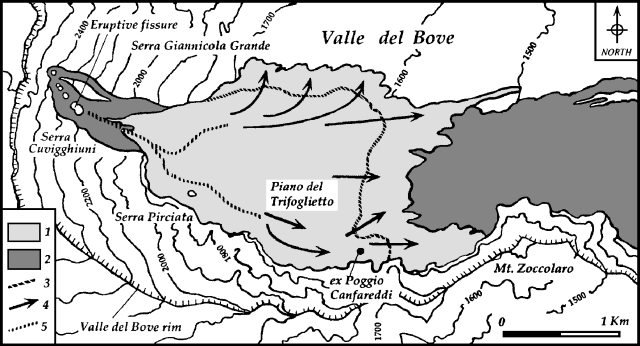 | Figure 58. Topographic sketch map of the active portion of the 1991-93 lava flow field; 1. Flow field formed from 27 May 1992 through February 1993; 2. Flow field before 27 May 1992; 3. Limit of active lava flows by November 1991; 4. Directions of the main active flows December 1992-February 1993; 5. Lava tubes. Courtesy of IIV. |
By January 1993, lava flows from the S vents advanced to the Poggio Canfareddi area and a complex network of minor flows reached the foot of Mt. Zoccolaro at 1,530-m elevation. Lava continued to flow from the N vents, expanding the field 400 m to the N. On 27-29 January, a fast-moving lobe of lava flowed to the NE, reaching 1,500 m elevation, 4 km distant from the eruptive fissure.
Effusive activity declined in February, ceased at the S vents by 8 February. Flow from the N vents was less than in previous months and shifted to vents on the northern-most side of the flow field. The new flows did not expand the flow field.
The seismic network recorded five swarms of long-period events. Fourteen events with M >1 occurred on 1 December, 14 events on 23 December, five events on 25 December, 51 events on 30 December-2 January, and 26 events on 3 February. No event exceeded M 3. The swarms were located in a small focal volume between the summit craters and Pizzi Deneri (~2 km NE) at depths asl. Volcano-tectonic seismicity during the period remained low (only three events) comparable to that observed throughout 1992.
The 9-station bore-hole tiltmeter network recorded no significant deformation except for a sharp event 18-19 December. Steady degassing from the Etna summit craters was observed and a weak ash emission occurred on the morning of 3 December from the Bocca Nuovo vent. Minor landslides repeatedly affected the E inner wall of the NE crater until January. The crater floor had sunk by early morning on 3 February.
The following report from geologists at the IIV and the Univ di Catania with seismic information from G. Luongo, updates and complements the official IIV report above.
A lava flow, at least a few hundred meters wide, has formed on the NE side of the lava field that has been building since 27 May 1992 (figure 58). The flow, in the vicinity of Monti Centenari (2 km NE of the active fissure), is completely independent from the old field and is moving E in the middle of Valle del Bove. The lava of this flow is visible from between 2,205 and 1,700 m through a series of skylights on the main tube. Lava is surfacing through 4-5 ephemeral vents at ~1,500 m elevation; the vents active in the past on the N, S, and central parts of the old lava field have closed. On the morning of 12 March, the most advanced flows had reached 1,425 m elevation and were moving over lava of previous eruptions. By 1300 on 14 March, the lava front was at 1,400 m elevation, ~ 5 m wide, 1 m high, and moving at an estimated 1 m/h.
The estimated volume of lava produced after 458 days of activity is 295 x 106 m3. This estimate was calculated using the same method as previous estimates reported in the Bulletin, but is ~ 50% higher than the GPS value reported above. No significant changes in degassing of the summit craters were noticed. Northeast crater is still obstructed, with very active fumaroles along the inside walls. COSPEC measurements of SO2 flux remained normal (5-6 x 103 t/d), except in early March when measured values were 12.5 x 103 t/d.
Between 12 February and 15 March, 169 events of M 1.2-2.9 were recorded, mainly in the summit crater area. The majority of events appeared to be related to active degassing at the surface, with characteristic frequencies of 1-6 Hz. Volcanic tremor was completely absent.
Information Contacts: IIV. The last three paragraphs are fromR. Romano, T. Caltabiano, M. Grasso, and M. Porto, IIV; P. Carveni and C. Monaco, Univ di Catania; G. Luongo, OV.
March 1993 (BGVN 18:03)  Cite this Report
Cite this Report
1991-93 eruption ends
The following, based on the report of the IIV, describes activity in March.
The 1991-93 eruption ended on March 30 after 473 days of continuous lava flows. Lava stopped flowing to the S side of the flow field in mid-February, but continued to flow from several vents at 1,700-1,650 m elevation on the N side of the field, covering previous flows from the current eruption. Shortly after 8 March, an overflight revealed a thin flow that had traveled 0.5 km from an ephemeral vent at 2,020 m elevation. On 11 March a large lava flow moved toward the Valle del Bove over an area not yet covered during this eruption. Flowing 1.5 km from a large ephemeral vent at the end of a tube at 1,550 m elevation, lava spread down some gullies, stopping after 3 days at 1,390 m elevation, 5 km from the eruptive fissure (figure 59).
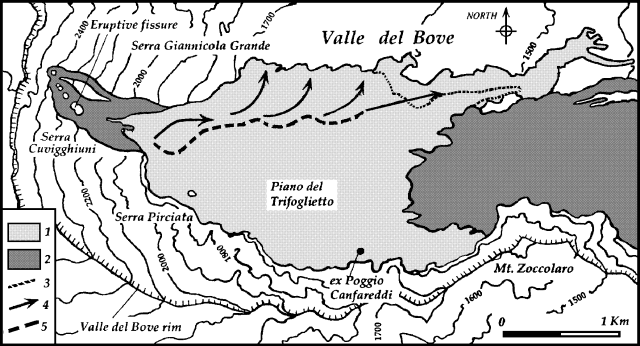 | Figure 59. Topographic sketch map of the active portion of the 1991-93 lava flow field; 1. Flow field formed after 27 May 1992 through March 1993; 2. Flow field before 27 May 1992; 3. Limit of active flows through February 1993 ; 4. Directions of the main active lava flows in March 1993; 5. Lava tube. Courtesy of IIV. |
Lava flows declined in the second half of March. On 21 March a vigorous flow emerged from a vent at 1,850 m elevation and traveled several hundred meters NE in a few hours before slowing and finally stopping within two days. The remaining ephemeral vents gradually disappeared and the last small lava flow was observed on the morning of 30 March. In the following days, fieldwork at the eruptive fissure and along the upper lava tube revealed that no molten lava remained in the tube and that the delivery system was cooling.
Steady degassing continued through March at the summit craters. The floor of Northeast crater dropped another several meters. Seismicity remained low, especially from 1-10 March. For the month, 65 long-period events and 8 volcano-tectonic events (maximum M 2.4) were recorded. The only notable swarm occurred on 28 March when 10 events were recorded in two minutes. There were no significant variations in the volcanic tremor amplitude. Four of the 9 bore-hole tiltmeters recorded a sharp deformation event of moderate amplitude at the beginning of March.
The 1991-93 eruption began on 15 December 1991 and lasted 473 days. It was probably the largest eruption at Etna in the last 300 years, covering ~ 7 km2 with >250 million m3 of lava.
The following information compiled by volcanologists at the IIV, Univ di Catania, and OV complements the official IIV report above.
The lava flow that had reached 1,400 m elevation on 14 March (18:02) stopped on 17 March. At about 1700 on 21 March a modest lava flow escaped through a skylight on the main lava tube just below 2,000 m elevation. It was accompanied by intense degassing from the upper part of the eruptive fissure. Through 25 March lava was observed flowing inside the main vent at 2,205 m and small, short-lived flows issued from ephemeral vents in the N part of the lava field at ~ 1,900 m elevation. Poor weather prevented detailed observation of the last days of the eruption.
Degassing (vapor and gas) from the upper part of the eruptive fissure declined. By 20 March it was difficult to observe from a distance. Degassing increased at the summit craters (especially from the central crater) during the final phase of the eruption. Through 9 April, the NE crater, where recent rockfalls had occurred, continued to be obstructed and weak fumarolic activity was present along the walls. COSPEC measurements of SO2 flux revealed a sharp increase during the last half of March (>16 x 103 t/d on 23 March). Measurements in April indicated the flux was returning to a normal level of 6-8 x 103 t/d.
From 16 March to 19 April, 337 seismic events were recorded. They ranged from M 1.0-3.0 and showed characteristic frequencies of 1-6 Hz. All were located in the summit crater region except a M 2.7 at 0649 on 14 April that was located low on the E flank. Volcanic tremor was totally absent.
During the 1991-93 eruption an estimated 300 x 106 m3 of lava flowed from the fissure on the W wall of Valle del Bove at an average rate of 7.3 m3/s.
Information Contacts: The first section is from the official report of theIIV. The second section is fromR. Romano, T. Caltabiano, M. Grasso, and M. Porto, IIV; P. Carveni and C. Monaco, Univ di Catania; G. Luongo, OV.
April 1993 (BGVN 18:04)  Cite this Report
Cite this Report
Steady degassing; seismicity low
Steady degassing from the summit craters followed the end of the 1991-93 eruption on 30 March (18:03). Increased gas emissions were noted at the central (Voragine) and SE craters (see figure 59) in April, but no morphological changes were detected. The floor of Northeast Crater sank a few meters in early April and remained obstructed by fallen material.
Seismic activity was low with only two volcano-tectonic events recorded. The highest magnitude event (M 2.7) occurred 14 April on the SE flank of the volcano at ~ 10 km depth. Long-period events were similar to those recorded in March, but fewer in number. There was also a decreasing trend in volcanic tremor spectral amplitude. No major changes were recorded by shallow bore-hole tilt stations on the slopes of the volcano.
Information Contacts: IIV.
May 1993 (BGVN 18:05)  Cite this Report
Cite this Report
Steady degassing continues; seismic swarm
Following the recent eruption's end in March, steady degassing was observed in May from all of the summit craters except Northeast Crater, which remained obstructed by debris in the bottom. Seismicity increased from two volcano-tectonic events in April (18:04) to 23 in May (M 1-3.2). Most of the events occurred between 1206 and 2039 on 24 May. At the same time, an earthquake swarm with 21 discrete events occurred below the NNW flank of the volcano at 13-26 km depth. The number of long-period events also increased compared to the last two months, but tremor amplitude and frequency were unchanged. Inflation was detected at one shallow bore-hole tilt station, but no other tilt variations were recorded.
Information Contacts: IIV.
March 1994 (BGVN 19:03)  Cite this Report
Cite this Report
Summary of activity since the end of the 1991-1993 eruption
Only steady degassing has been observed at Bocca Nuova, Voragine, and Southeast summit craters following the December 1991-30 March 1993 eruption. Northeast Crater, obstructed by debris that fell from the inner wall, has not shown appreciable degassing.
On 3 August 1993 the Bocca Nuova bottom sank ~30 m during one hour of strong degassing and ash emission that produced an ash column hundreds of meters high; small blocks and a few fresh bombs fell close to the vent. Unusually strong noise was heard and ground vibration was felt at the summit area during this explosive activity. These phenomena also enlarged the unstable crater rim, causing rockfalls for several weeks. Activity did not change significantly through the end of 1993; continuous degassing activity was observed at all craters except Northeast Crater, where reddish ash emissions in early October were probably related to release of overpressurized gas.
A slight renewal of seismicity was observed after the end of the eruption. Fracturing was the probable cause of 83 events (M >1); 14 of them were M 2.5. The cumulative strain-release trend was almost flat throughout the entire period, the only significant episode was a seismic swarm on 24 May 1993 (twenty-one M 1 shocks; Mmax = 3.2). The seismic activity was mainly located on the N and SE sides of the volcano; the N events had hypocentral depths of 12-26 km, whereas the SE events were <10 km. Volcanic tremor amplitude remained low during 1993; a moderate increase was recorded in July. Also, 27 long-period earthquake swarms were recorded in 1993. The best constrained hypocentral locations revealed a source volume below the summit area at a depth of <=3 km.
Tilt recorded at most of Etna's bore-hole stations showed a continuous small deflation of the radial component that started during the 1991-93 eruption. This tilt was confirmed by general contraction measured by the three EDM networks.
The following report is from S. Saunders and W.l McGuire. An EDM network high on the S and E flanks has been reoccupied 13 times between 1981 and 1993. Measurements have revealed >5 m of lateral displacement associated with four rifting events. The network was at least partly re-occupied in April, July, and November 1993. All three surveys came after the cessation of effusive activity in March 1993 (18:03). Compared to the immediately preceding measurements, 1993 data showed that N-S trending lines, broadly parallel to the eruptive fracture and the W rim of the Valle del Bove, lengthened by small amounts (30-60 ppm). Lines trending E-W, perpendicular to the fracture zone, showed no significant length changes between November 1992 and November 1993. These data confirm that the rifting process is contemporaneous with the initial propagation of the feeder dike for the 1991-93 eruption, with little additional dilation-related lateral displacement during the later stages of activity or following the end of lava effusion.
Information Contacts: IIV; S. Saunders, West London Institute; W. McGuire, Cheltenham & Gloucester College of Higher Education.
July 1994 (BGVN 19:07)  Cite this Report
Cite this Report
Explosive degassing from La Voragine; fumarole temperatures reported
The following describes [fieldwork] on 1-27 June and 10-18 July 1994.
"As during visits in June-July and September-October 1993, Northeast Crater was blocked and inactive, but collapse was continuing around the edge with minor rockfalls every few minutes or so. Southeast Crater was also little changed from 1993, with a quietly degassing vent under the SE rim, but no indication of gas coming out under pressure. There was strong high-temperature fumarolic activity around the crater rim, temperatures being generally highest in the cracks.
"The Chasm (La Voragine) had a single vent in its floor measuring ~ 8 x 10 m, discharging gas continuously under pressure in rhythmic puffs at a rate of ~ 30 puffs/min. On 17 June and 12 July only, distinct explosions could be heard at the rate of 1-8/min. These were the first signs of explosive activity since the end of the 1991-93 eruption, and an indication that the Strombolian degassing that has characterized the summit over the past few hundred years is resuming.
"Bocca Nuova vent was degassing almost totally silently from two vents, one to the SE and one to the W; however, on 27 June when the weather was calm, 13 very faint gas puffs/min could be heard. The SE vent seemed similar to last year, measuring ~ 10 m in diameter, but the W vent had collapsed and enlarged considerably, now measuring perhaps as much as 50 m in diameter. On the early morning of 16 June a reddish tinge to the plume above Bocca Nuova was first noticed. Upon closer inspection on 17 June, the SE vent was seen to be pouring out thick clouds of red dust, apparently a result of internal collapse within the vent, while the W vent continued to emit white fume only. Dust emission intensified in the following days, causing the downwind side (S through W) of the summit to become a striking red color. The activity was continuing in mid-July.
"The levelling traverse showed comparatively small vertical movements since September 1993. The area near Belvedere, and other areas over the dyke intruded during the 1991-93 eruption, had subsided by up to 2 cm, as had the NE rift zone near Monte Pizzillo. During the same period, a small area ~1 km SW of the summit inflated by just over 1 cm. Horizontal movements measured since October 1993 showed generally small or insignificant changes, with nearly all lines recording changes of >1 cm. Only two stations appear to have moved by more than this; a station on the E edge of Southeast Crater had shifted 3 cm E relative to nearby stations, and a station close to the NW edge of the Bocca Nuova had moved 2 cm W. These movements are consistent with expansion of the central magma column as it refills.
"Surface temperatures were measured between 1 and 27 June at four active fumarole areas with a Minolta/Land Cyclops Compac 3 hand-held radiometer (8-14 mm). Temperatures were not corrected for spectral emissivity, so all radiant temperatures are given here as brightness temperatures. On the NE rift zone, nine areas of fumaroles were observed near the N edge of the 1966-67 lavas (between 2,450 and 2,500 m altitude). Temperatures for fumaroles at the two lowest of these areas ranged between 33 and 50°C. Another area of fumaroles observed at the upper rim of the W wall of the Valle del Bove around Belvedere, above the 1991-93 dyke, had temperatures in the 57.5-84.7°C range. Temperatures measured at fumaroles and cracks in the still-cooling 1991-93 lava-flow field in the Valle del Bove were between 85 and 221°C. The locations and temperatures of fumarole areas measured in the vicinity of the summit craters are given in table 5. Temperatures of the vents within the central craters were also measured from the crater rim: 342°C for the Chasm vent, and 159 and 81.5°C, respectively, for the SE and W vents of Bocca Nuova. Active fumaroles were observed, but not measured, along the 1991-93 fissure zone and 14 December 1991 cones and flows between Southeast Crater and Belvedere, along the October 1986 fissure zone, and in the Valle del Bove below Monte Simone."
Table 5. Fumarole temperatures in the vicinity of Etna's summit craters, measured on 18 and 27 June, and 14 October 1994. Courtesy of Andrew Harris, Open University.
| Date | Fumarole / Rift Locations | Temperature (°C) |
| 27 Jun 1994 | NE Crater - at N rim | 50.4-65.0 |
| 27 Jun 1994 | NE Crater - rifts at NW rim | 56.0-141 |
| 27 Jun 1994 | NE Crater - at dip in NW rim | 45.5-97.4 |
| 27 Jun 1994 | NE Crater - at E rim | 51.4-85.6 |
| 18 Jun 1994 | Bocca Nuova - on N slope | 40.5-75.6 |
| 18, 27 Jun 1994 | Bocca Nuova - inside N rim | 42.2-54.3 |
| 27 Jun 1994 | Bocca Nuova - rifts at N rim | 52.0-74.4 |
| 18 Jun 1994 | Bocca Nuova - at SW rim | 52.0-65.7 |
| 18, 27 Jun 1994 | Central Craters - at S rim | 40.6-82.6 |
| 27 Jun 1994 | Between central and SE Craters | 59.1-81.3 |
| 18, 27 Jun 1994 | SE Crater - rifts and fumarole at N rim | 51.2-312 |
| 27 Jun 1994 | SE Crater - rifts and fumarole at W rim | 60.0-208 |
| 14 Oct 1994 | NE Crater - fumarole at N rim | 39.2-77.4 |
| 14 Oct 1994 | NE Crater - rifts at NW rim | 153-246 |
| 14 Oct 1994 | NE Crater - fumarole at W flank | 50.4-74.2 |
| 14 Oct 1994 | NE Crater - fumarole at W rim | 41.0-210 |
| 14 Oct 1994 | NE Crater - fumarole at S rim | 50.5-221 |
| 14 Oct 1994 | Bocca Nuova - fumarole at N flank | 50.1-75.5 |
| 14 Oct 1994 | Bocca Nuova - rifts and fumarole at N rim | 47.3-74.5 |
| 14 Oct 1994 | Bocca Nuova - fumarole at SW rim | 50.0-72.4 |
| 14 Oct 1994 | Central Craters - fumarole at S rim | 49.2-82.4 |
| 14 Oct 1994 | Fumarole between central and SE craters | 50.2-82.8 |
| 14 Oct 1994 | SE Crater - rifts and fumarole at N rim | 57.5-482 |
| 14 Oct 1994 | SE Crater - rifts and fumarole at NW rim | 56.4-218 |
| 14 Oct 1994 | SE Crater - rifts and fumarole at W rim | 46.8-99.5 |
| 14 Oct 1994 | SE Crater - rifts and fumarole at S rim | 49.9-88.0 |
| 14 Oct 1994 | SE Crater - rifts and fumarole at E rim | 68.5-180 |
| 14 Oct 1994 | SE Crater - rifts and fumarole at NE rim | 52.2-121 |
Information Contacts: J. Murray and A. Harris, Open Univ; L. Platt, Sheffield Univ; D. Renouf, UK.
October 1994 (BGVN 19:10)  Cite this Report
Cite this Report
Minor explosive degassing and higher fumarole temperatures
The following describes [fieldwork] between 23 September and 14 October 1994.
"There are continuing signs that activity is increasing. At the Chasm (La Voragine), 1-4 very low rumbles/min were heard, but on 14 October six explosions much louder than those heard in June/July (19:07) were heard in 10 minutes. The Bocca Nuova was also producing around one distinct long explosive blast per minute, as opposed to the faint gas puffs heard in the summer. However, no audible explosions were heard when the Chasm was active on 14 October. Northeast and Southeast craters were quiet as in June/July, but temperatures more than 100°C higher were measured at the fumaroles on their outer slopes. Another sign of increasing activity was that during the five days of levelling (25-30 September), 22 earth tremors were detected by the shaking of the instrument. This is > 10 times higher than 1993, and the largest total of tremors noted in this way since September 1991, before the 1991-93 eruption.
"The levelling traverse showed a slight subsidence of the summit since June 1994, the maximum value being just under 3 cm compared to the Piano Provenzana, 6.5 km NNE of the summit. The subsidence is more or less concentric around the summit, with the exception of some stations on the upper E flank and over the 1991-93 dyke, which have subsided nearly a centimetre more than those nearby.
"On 14 October the areas of active fumaroles measured during June were visited. These were measured again using a Minolta/Land 330 hand-held radiometer (8.5-14.5 mm). Temperatures were not corrected for spectral emissivity, so all radiant temperatures are given as brightness temperatures (table 5). At the N, W, and S rim of Northeast Crater, maximum fumarole and rift temperatures were 105-135°C higher than those measured in June. H2S was also smelled in the vicinity of these high-temperature fumaroles. Higher maximum temperatures were also measured from rifts at the N rim of Southeast Crater, these being up to 170°C higher than those measured in June. It is stressed that these rises in temperature may be the result of different fumaroles being measured on the two dates, though in view of the thorough coverage in June this seems unlikely. Elsewhere, fumarole temperatures were similar to those measured in June. Fumarolic activity only was observed on the floor of Northeast Crater, which was measured from the rim at 40.1°C. The bocca on the floor of the Chasm was measured from the crater rim at 339°C. At the Bocca Nuova, a temperature of 173°C was measured for the SE bocca and of 40.7°C for the NW floor; these were measured from the crater rim. At Southeast Crater, fumaroles decreased in temperature and number around the W and E rims, such that fumaroles were few and cool on the S rim."
Information Contacts: J. Murray and A. Harris, Open Univ.
June 1995 (BGVN 20:06)  Cite this Report
Cite this Report
Small explosions in May followed by larger ash plumes in June
The following report from the Istituto Internacionale di Vulcanogia (IIV) describes activity from December 1994 to June 1995. Additional information came from Open University geologists, from Henry Gaudru (SVE), and fromaviation notices. Fumarole temperatures measured by Open University geologists in the vicinity of the summit craters increased at Northeast Crater (NEC) between June and October 1994 (table 6). Temperature increases were greatest at the fumarole field on the S rim of the crater, and decreased towards the N rim.
Table 6. Changes in maximum fumarole temperatures measured at Etna's summit craters between June and October 1994. Courtesy of Open University.
| Crater Area | Location | June 1994 Maximum Temp (°C) | October 1994 Maximum Temp (°C) | Temperature increase (°C) |
| NE Crater | Fumaroles at N rim | 65 | 77 | 12 |
| NE Crater | Rifts at NW rim | 141 | 246 | 105 |
| NE Crater | Fumaroles at W rim | 97 | 210 | 113 |
| NE Crater | Fumaroles at S rim | 86 | 221 | 135 |
| Bocca Nuova | Fumaroles on N flank | 76 | 76 | 0 |
| Bocca Nuova | Fumaroles and rifts (N rim) | 74 | 74 | 0 |
| Bocca Nuova | Fumaroles at SW rim | 66 | 72 | 6 |
| Central Craters | Fumaroles at S rim | 83 | 82 | -1 |
| Central Craters | Between S rim and SE crater | 81 | 83 | 2 |
| SE Crater | Fumaroles and rifts-N rim | 312 | 482 | 170 |
| SE Crater | Fumaroles and rifts-W rim | 208 | 218 | 10 |
After several months of steady degassing from the summit craters, Bocca Nuova produced a short sequence of mild explosive events on 10-12 December 1994, characterized by brownish columns of non-juvenile ash rising
In January 1995 several ash puffs from NEC were observed. They were more frequent between 31 January and 3 February, but continued all month, forming a thin ash layer around the crater rim. The most significant activity from NEC in the following two months was strong steam degassing, sometimes with ash.
An intense episode of ash emission from NEC occurred at 1000 on 9 May. Red-brown ash and accretionary lapilli fell on Milo, a village on the middle slope of the volcano. No block fallout was observed near the crater rim, and steam emission continued unchanged.
On 23 May at 1605 a new NEC explosion ejected lithic blocks; most of them were affected by fumarolic alteration that changed hard lavas and scoriae into very brittle materials with vivid white, yellow, purple, and reddish colors that were very easy to recognize on the discontinuous snow mantle. The area of fallout was ~0.2 km2 and the maximum block volume reached 0.2 m3, however, most of the blocks were only a few centimeters in size. No juvenile material was found among the fall products and the event resembled to a pure phreatic explosion that ejected very altered material picked up from the walls of the December 1994 degassing vent and the NEC crater bottom. On the morning of 26 May an explosion visible (by SVE members) from the N flank at 1,800 m elevation generated a gray ash-and-vapor plume above NEC. When the SVE group reached the summit area, small blocks were visible around NEC and near the lower slope of Bocca Nuova.
On 30 May a weak, ash-bearing plume was observed from an airplane by J.B. Murray. Stronger activity from the vicinity of Bronte was noted on 8 June, when thick ash clouds up to 70 m high were reported late in the morning. On a 12 June summit visit, scattered wall rock (lying
The IIV reported gas explosions and inner-crater wall collapses from Bocca Nuova in June. Gas emission came from two vents on the crater bottom, the northernmost of which produced some small phreatic explosions that threw several centimeter-size lithic-lava blocks up to 50 m NE beyond the crater rim. Some ash emission from NEC was observed during June. Murray reported that as of mid-June guides had stopped taking tourists to the crater edge because of the danger from explosions. The situation reminded Murray of the activity following the 1983 eruption (SEAN 08:04), when a series of sudden, large non-magmatic explosions occurred from the NE crater.
Aviation notices (SIGMETs) were issued for Etna on 21 June when an ash cloud reportedly rose 4,200 m. Another notice on 25 June described an ash cloud ~18 km E from the central crater at an altitude of 2,100-4,200 m. IIV video surveillance showed no eruptive columns during 21-25 June 1995, although on 21 June the camera was out of order and on the afternoon of 23 June foggy conditions obscured the upper slopes. On 22 June light ash from NEC fell on the IIV high-mountain observatory at Pizzi Deneri (2,850 m elevation), NE of the summit craters.
Information Contacts: Mauro Coltelli, CNR Istituto Internazionale di Vulcanologia, Piazza Roma 2, 95123 Catania, Italy; John B. Murray and Andy Harris, Department of Earth Sciences, The Open University, Milton Keynes MK7 6AA, United Kingdom; Nicki F. Stevens, Department of Geography, University of Reading, Whiteknights, P.O. Box 217, Reading RG6 2AH, United Kingdom; Henry Gaudru, Societe Volcanologique Europeenne (SVE), C.P. 1 - 1211 Geneva 17, Switzerland.
July 1995 (BGVN 20:07)  Cite this Report
Cite this Report
Gas-and-ash explosions followed by sustained Strombolian activity in late July
Eruptive activity from Etna's summit craters continued in July. Sustained Strombolian activity resumed in Bocca Nuova vent on 29 July. Details will be provided next month.
At Bocca Nuova crater, a degassing vent in the N part of the crater floor produced very frequent gas explosions followed by collapses inside the vent, and then by red ash emissions. Ash emissions started on the morning of 25 July, and ash formed a thick carpet inside the crater. Ash plumes rose ~100 m above the crater rim and caused ashfall on the W flank. A small percentage of juvenile material was identified in the ash. Another vent at the SE margin of the crater floor produced only gas explosions with no ash. The interior of Bocca Nuova had vertical walls and a nearly flat zone in the SE part of the floor, ~100 m below the crater rim, that gently sloped NW. The flat zone occupied 40% of the crater floor, the remaining part being covered by collapse debris. The inner part of the collapsed zone had sub-vertical walls and a floor sloping NE.
In the SW corner of the Northeast Crater floor a vent produced strong gas emissions with occasional inner collapses and red ash expulsions. Samples of ash showed an increase in juvenile component compared to May. Northeast Crater was pit-shaped, with sub-vertical inner walls covered by red ash. The floor was ~150 m deep and had a step oriented NE-SW, which separated the flat zone of the NW sector, gently sloping SE, from the SE portion sloping SW. Activity at the funnel-shaped Voragine (Chasm) consisted of continuous, weak gas emission from the central vent with neither explosions nor ash emissions. Southeast Crater produced only a weak degassing activity.
Information Contacts: Sonia Calvari, Istituto Internazionale di Vulcanologia, Piazza Roma 2, I-95123 Catania.
August 1995 (BGVN 20:08)  Cite this Report
Cite this Report
Magmatic activity resumes in Bocca Nuova and Northeast craters
Strombolian activity resumed at Bocca Nuova vent on 30 July and in Northeast Crater on 2 August. Etna's last magmatic activity within its summit craters stopped 3 years and 7 months earlier, two days after the beginning of the 1991-93 flank lava flow eruption (BGVN 16:12). During that 15-month-long eruption and the following 28 months, the four summit craters exhibited continuous steam emission with frequent non-juvenile ash puffs, several collapses, and some strong phreatic explosions from Northeast Crater and Bocca Nuova. No morphological changes were observed in August at either Voragine or Southeast craters, where gas and steam emissions continued as in previous months.
On 30 July the first red spatters were observed inside Bocca Nuova, but bad weather prevented an evaluation of the intensity of this new magmatic activity. Observations the next day revealed that the vent was located in a new pit crater (20-30 m wide and ~50 m deep) on the N part of the crater floor. That part of the crater floor collapsed in June 1994, and probably dropped again in June 1995 when some phreatic explosions occurred (BGVN 20:06). The vent was a few meters across, and magma was sometimes visible during pulsed degassing episodes frequently interrupted by mild Strombolian explosions. The most energetic events were lava jets lasting 15-20 seconds that threw large spatters 120-130 m above the vent to the crater rim. The activity climaxed on 2 and 3 August when lava jets frequently rose up to a few tens of meters above the crater rim. Strombolian activity stopped abruptly on the night of 4 August, leaving a thick tongue of lava on the pit floor. During the Strombolian phase no spatter fell beyond the crater rim; most fell close to the vent inside the inner pit. In the days following 4 August, several ash emissions were observed at Bocca Nuova, which gradually resumed its quiet degassing. No further activity at Bocca Nuova was observed through the end of August.
Until 2 August, no lava emissions had been observed from Northeast Crater since September 1986 (SEAN 11:09); only scoria was ejected on 13 May 1991 (BGVN 16:07). Strombolian explosions during 2-3 August issued from a small vent in the lowest part of the crater, ~150 m below the crater rim. Almost continuous spatter ejections never reached the crater rim. During 3 August the activity gradually changed to puffs of black ash that continued in the following days. After ash emissions decreased, three incandescent degassing points on the crater floor were seen for several days. On 18 August, Strombolian activity resumed and during the night some incandescent bombs rose above the crater rim. Ash emission the following days prevented observations inside the crater, but no blasts were heard. On 29 August, another 1-day phase of Strombolian activity was followed the next day by ash emissions that marked the end of this eruptive episode.
Information Contacts: Mauro Coltelli, CNR Istituto Internazionale di Vulcanologia, Piazza Roma 2, 95123 Catania, Italy.
September 1995 (BGVN 20:09)  Cite this Report
Cite this Report
Ash emissions and another episode of Strombolian activity from the summit craters
A strong episode of black ash emission from Northeast Crater (figure 60) during the late morning of 13 September lasted only a few minutes, sending an ash plume 100 m above the crater rim. Red ash emissions from Bocca Nuova and Northeast Crater continued until about 20 September, but explosions of variable frequency and intensity were heard from both throughout the month. Voragine (Chasm) and Southeast Crater exhibited only weak degassing in September. Poor weather prevented internal crater observations.
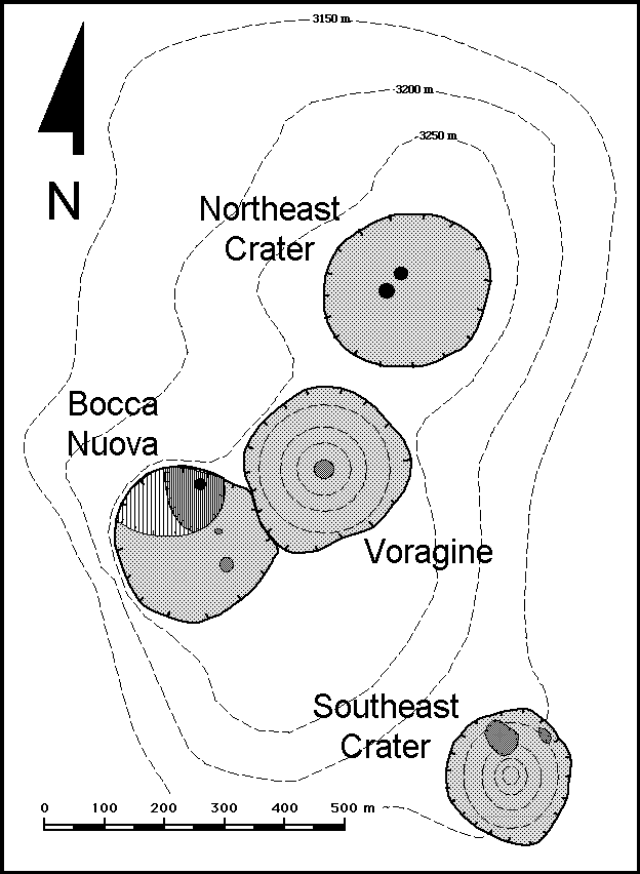 | Figure 60. Topographic sketch map of Etna's summit craters (stippled), September 1995. Shaded areas within the craters indicate collapsed, degassing pits, and solid points are active boccas producing Strombolian activity. Within Bocca Nuova, the hatched area indicates the deepest part of the crater floor. Courtesy of the Istituto Internazionale di Vulcanologia. |
On the evening of 2 October explosive Strombolian activity resumed at Northeast Crater from two small vents, aligned NNE-SSW in the lowest portion of the crater floor, ~150 m below the crater rim (figure 60). During observations the next morning, loud vigorous explosions were almost continuous, throwing scoria above the crater rim. A slight decrease in the frequency and energy of the explosions occurred that afternoon, although some incandescent bombs fell on the outer crater slope. Activity continued to decline during the night, and on the morning of 4 October Strombolian explosions were restricted to a single vent ejecting bombs up to a few tens of meters above the crater floor. By the evening of 5 October only incandescent degassing vents were present. During the same period, Bocca Nuova exhibited frequent red-brown ash emissions alternating with normal degassing. Ash emission was occasionally accompanied by incandescent bomb ejection. The ash puffs, more copious on the morning of 3 October, were produced by the same partially collapsed vent that was the site of Strombolian activity in August (BGVN 20:08).
Bombs collected on the crater rim (the first accessible material since the end of the 1991-93 eruption) were geochemically comparable with the 1991-93 lavas. The bombs were porphyritic hawaiite with phenocrysts of plagioclase (~16 volume %), clinopyroxene (~4%), olivine (~1%) and Ti-magnetite microphenocrysts in an intersertal groundmass.
Information Contacts: Sonia Calvari and Massimo Pompilio, CNR Istituto Internazionale di Vulcanologia, Piazza Roma 2, 95123 Catania, Italy.
October 1995 (BGVN 20:10)  Cite this Report
Cite this Report
Frequent Strombolian explosions and ash emissions from Northeast Crater and Bocca Nuova
The Istituto Internazionale di Vulcanologia (IIV) report below provides an overview of activity during October. IIV reports generally summarize the temporal evolution of volcanic phenomena during the whole month, skipping some trivial details, and frame the ongoing activity in the context of phenomena over a period of years.
Reports detailing activity during short visits made by visiting volcanologists provide a different perspective on the volcanism. One such report for some days in October was provided by a team led by Open University (OU) volcanologists conducting routine deformation measurements during 9 September-14 October. Short visits to the summit craters on 7, 12, and 14 October were also made by Boris Behncke, with additional observations from Carmelo Monaco and Marcello Bianca (University of Catania), Maria Felicia Monaco (Bari University), and others.
Review of July-September 1995 activity. Strombolian activity resumed at Bocca Nuova on 30 July and in Northeast Crater on 2 August (BGVN 20:08). On 30 July spatter was observed inside Bocca Nuova from a new pit crater on the N part of the crater floor. The activity climaxed on 2 and 3 August, when lava jets rose above the crater rim, then stopped on the night of 4 August. Strombolian explosions during 2-3 August issued from a small vent in the lowest part of the crater. Two more Strombolian episodes occurred on 18 and 29 August. A strong explosion from Northeast Crater on 13 September sent an ash plume 100 m above the rim. Ash emissions from Bocca Nuova and Northeast Crater continued until about 20 September, but explosions were heard throughout the month (BGVN 20:09). The OU team noted light ashfall 2-3 km away in the third week of September, and heavier ashfall 50 m from the Bocca Nuova rim on 27 September.
Overview of October 1995 activity from IIV. After a short period of Strombolian activity at Bocca Nuova and Northeast Crater at the beginning of October, alternating mild Strombolian activity and ash emission characterized their activity for the rest of the month. On 8 October almost continuous rumbling noises (like roaring jets) were heard from both craters. On the morning of 12 October intense ash emissions took place from both craters. Bocca Nuova displayed small short-lived ash puffs (5-7/hour), while from the Northeast Crater a dense ash column rising as high as 900 m developed repeatedly (2/hour). IIV field parties working in the summit area reported that the ash emission were accompanied by falling rock noises. However, successive surveys observed neither juvenile nor lithic blocks on the crater rims.
After 12 October Strombolian activity progressively resumed at Northeast Crater and continued with variable intensity until the end of the month. On 19 October Strombolian activity was relatively vigorous and the scoria ejections, up to few tens of meters from the crater rim, were almost continuous. A survey on 25 October revealed an appreciable decrease of the explosion frequency. Bocca Nuova exhibited intermittent ash emissions after 12 October. As during previous activity, they originated in a depressed area of the NW crater floor. Explosions observed on 19 October were accompanied by ejection of a black (lithic?) block to a few tens of meters above the crater floor, but neither glowing at the vent or ejection of incandescent bombs were observed. After 19 October intermittent ash emission progressively decreased, and in the last week of the month weak Strombolian activity resumed at Bocca Nuova. Significant eruptions on 9 and 14 November will be reported in the next Bulletin.
Deformation measurements. Preliminary results from the OU team indicate little ground deformation since October 1994 over most of the network. Summit levelling showed insignificant movement (-5 mm near the summit, +7 mm on the N flank) apart from the area above the 1991-93 dike, which between the W side of Cisternazza and Belvedere showed a fairly consistent subsidence of 17-24 mm. Preliminary GPS computations suggested a radial expansion about the summit of ~15 mm. Dry-tilt stations showed no large tilts.
Details of 1-7 October activity. Observations from the Northeast Crater rim on the afternoon of 1 October by the OU team revealed two faintly glowing vents, ~3-5 m across, on the crater floor. The following night, bright summit glow was seen from Nicolosi (15 km S), and on the morning of 3 October loud explosions from Northeast Crater were heard from the trail 800 m W, which had been covered with a thin layer of red ash overnight. Explosions were again heard late in the afternoon from ~7 km away, and light ash fell near Monte Corbara (5 km NW). While approaching the crater at 1815 on 3 October, two guides and an Italian TV camera crew returning from the rim warned of bombs falling outside the crater. As the OU team moved towards the high ground behind the crater, a large explosion sent brightly-glowing juvenile bombs just over the rim, rolling toward them. A few seconds later a single bomb ~20 cm across landed 10 m away, 100-200 m from the rim. Similar bomb ejections to smaller distances occurred about every 2 minutes until the team descended at 1845. On 7 October, Behncke noted a dense steam-and-gas plume from Northeast Crater. Most of the plume and occasionally some ash rose from the SSE part of the crater floor; falling stones were frequently heard.
Detonations from within Bocca Nuova heard by the OU team on 1 October were only audible from the rim. One vent on 4 October was explosively exhaling gas, and the other was collapsing, producing brownish ash clouds. Behncke observed small Strombolian explosions from Bocca Nuova on 6 October, but only ash emissions the next day. On the 7 October visit, Behncke observed frequent ash plumes from Bocca Nuova accompanied by rumbling noises and the sound of falling stones; Strombolian explosions were frequent.
The Chasm (La Voragine) quietly emitted fumes on 1 October. On 4 October the OU team climbed into Southeast Crater to the edge of the vents, which emitted gas quietly and not under pressure, apart from one area just below the S rim. On 7 October, Behncke heard small explosions, but no ejections or incandescence were seen after sunset.
Details of 12-14 October activity. Between 0800 and 0900 on 12 October a series of collapses within Northeast Crater generated a thick ash cloud. Pulses of rapidly rising ash plumes resulted in a vertical column 800-1,000 m above the summit. After 0900, a dilute gas plume rose from Northeast Crater while Bocca Nuova sent frequent ash emissions 200-300 m above the summit. When Behncke reached the crater rim shortly after 1230, there were vigorous steam emission and explosions from Northeast Crater.
Behncke saw incandescent spots in the central Northeast Crater floor that gradually increased in number and intensity. Pyroclastic ejections became more frequent and vigorous, and soon the incandescent areas were hidden by gas and dilute ash plumes. The ash plumes first rose slowly to ~100 m above the crater floor, but gradually rose higher and became more heavily ash-laden. About 5 minutes after the onset of ash venting, dense convoluting ash clouds began to rise above the rim. Bomb and ash emission steadily increased. The high-pressure gas emission noise at the beginning of this activity changed to a dull rumbling connected with the ash emission. Short pulses of bomb emissions every 5-10 seconds were followed by a dark ash puff. After ~10 minutes, the ash puffs merged into a continuous column that rose hundreds of meters above the rim. Around 1345 vigorous emissions ejected black ash plumes ~1 km above the summit. Periodic ash emissions from Northeast Crater gradually became less vigorous before ceasing that evening.
On 12 October (0800-0900), the OU team heard detonations from Bocca Nuova, mainly from a vent on the E side of the floor, but the larger vent on the NW side occasionally threw 20-cm-diameter lithic blocks 30-50 m high. Ash emissions seen by Behncke after 1230 occurred every 2-5 minutes from the pit on the NW crater floor. Each emission began with block and/or bomb ejections followed by a dense ash plume. The bombs and blocks rose out of the ~50-m-deep pit but remained ~100 m below the rim, whereas the ash plumes rose 100-500 m above the summit. An open vent in the SE crater floor displayed continuous gas emission with occasional explosions that ejected dense gas clouds.
Shortly after 1700 on 14 October Behncke saw a central glowing vent in Northeast Crater. Vigorous high-pressure gas emission produced a roaring noise, and the plume was almost vapor-free. During the first 30 minutes of the visit, glowing spatter was occasionally ejected from the vent. As degassing increased, numerous incandescent spots became visible, aligned more or less concentrically around the vent. After the first half hour, Strombolian bursts became more vigorous, ejecting bombs ~50 m above the pit. About 10 minutes later, the explosions again intensified, and the crater floor around the vent, which appeared more funnel-shaped, was covered with incandescent bombs. Ejections rose ~100 m above the vent but remained far below the crater rim.
Information Contacts: Massimo Pompilio, CNR Istituto Internazionale di Vulcanologia, Piazza Roma 2, 95123 Catania, Italy; John B. Murray and Fiona McGibbon, Dept. of Earth Sciences, The Open University, Milton Keynes MK7 6AA, United Kingdom; Nicki Stevens, NUTIS, Reading University, Whiteknights, P.O. Box 227, Reading RG6 2AB, United Kingdom; Phil. Sargent, Sue Elwell, and Sarah Cooper, Civil Engineering Dept., Nottingham Trent University, Burton Street, Nottingham NG1 4BU, United Kingdom; Boris Behncke, Dept. of Volcanology and Petrology, GEOMAR, Wischhofstr. 1-3, 24148 Kiel, Germany.
December 1995 (BGVN 20:11)  Cite this Report
Cite this Report
Six lava fountaining episodes from Northeast Crater
On 2 August 1995 explosive activity resumed at Northeast Crater (NEC) (BGVN 20:08). In August and September the activity was sporadic and low in intensity (BGVN 20:09), but after 2 October a vigorous Strombolian phase was observed (BGVN 20:10). Explosive activity occurred again during 19-22 October.
On 1 November there was vigorous spattering and bubbling of magma in a 15-m-wide pit on the NEC floor. Magma degassing formed large bubbles that burst, throwing spatter to the crater rim. In the following days the activity was discontinuous and less intense.
Lava fountaining episodes, 9-14 November. At 0014 on 9 November there was a sudden increase in volcanic tremor, but bad weather prevented summit observations. Between 0105 (at Trecastagni) and 0110 (at Catania, 30 km SSE) ash and lapilli fallout covered the SE flank (figure 61), eventually reaching as far as Siracusa, 75 km from the vent. The episode lasted only a few minutes and the material on the lower slope amounted to a few tens of grams per square meter, although rare dense lapilli broke some skylights and car windows. Fieldwork the next morning revealed that the NEC eruption produced a lava fountain followed by a strong phreatomagmatic blast. Part of the S rim collapsed inside the NEC and was later ejected. A welded spatter deposit several meters thick mantled the upper slope of the NEC cone and was overlain by a few centimeters of ash and lapilli. The bombs varied from 2-3 m close to the vent, to 25 cm at 2.5 km downwind. Several large accidental lithics (up to 1 m) occurred in the very proximal deposit. A large amount of spatter fell into the crater, raising its floor by several tens of meters. The crater appeared completely sealed, with wide red cracks on the crust of the spatter pile. The total volume of tephra from the 9 November eruption was ~1.5 x 106 m3.
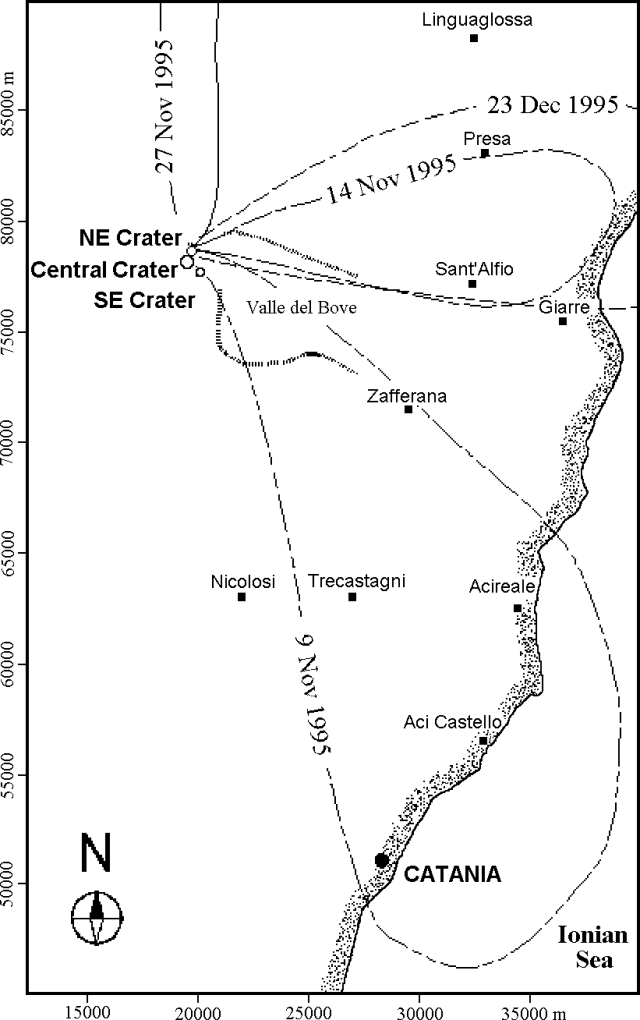 | Figure 61. Map of the Etna area showing areas affected by ashfall on 9, 14, and 27 November, and 23 December 1995. Courtesy of IIV. |
On 10 November a new lava fountain episode at NEC was observed from Catania around 0400-0530. Pulsating magma jets climbed up to 300 m above the crater rim; some were expelled up to 500 m. An ash-and-lapilli column ascended ~5,000 m and was blown SE. The spatter deposit was limited to the upper part of the volcano and in a narrow strip extending ~3 km SE; little ash fell on the middle slopes. The estimated volume of the pyroclastics was a few tens of thousands of cubic meters.
A third episode took place around 0600 on 14 November, and lasted ~3 hours. Between 0800 and 0900 the paroxysmal phase sent dense black ash columns through a white cloud covering the summit until they reached 5,000 m altitude. During the entire episode a non-continuous sustained eruptive column was observed and each ash puff contributed to a plume bent downwind that reached its buoyancy level at 6-7 km altitude. Ash and lapilli rained on the NE flank down to the coast (figure 61), leaving only a few grams of material per square meter on the middle and lower slopes. The proximal spatter deposits, mapped two days later, partially covered the previous ones on the cone and extended ~2 km NE in a band a few hundred meters wide. Lithic blocks and ash were less abundant than in deposits from the 9 November episode. The crater bottom was sealed by back-fallen welded spatter and was ~50 m below the crater rim, 100 m higher than before 9 November. The total volume of tephra from the 14 November eruptions was ~350,000 m3.
The volcano remained quiet after the 3rd episode. Within NEC, only a few large cracks on the welded spatter crust emitted fumes. Bocca Nuova crater showed a normal continuous degassing; Southeast and Voragine craters continued their steam emission.
Lava fountaining episodes, 22-27 November. Late on 22 November continuous glows were observed at NEC and some bangs were heard on the lower slopes. Beginning around midnight, two hours of fire fountaining and intense red glow was visible from Catania. The lava jets remained fairly low (~100 m above the crater rim) so the proximal spatter deposit mantled only the upper part of the cone, whereas the fine material fell on the SE flank as far as the coast. However, the total volume of the erupted material was limited to a few tens of thousand cubic meters, close to that of the second episode.
After the 22 November episode the vent was closed again by material that fell back into the crater. Three days later some bangs were heard at NEC and glow was observed during the night of 26-27 November. That morning seismic tremor rose suddenly and at 0715 an ash-and-lapilli column rose from the volcano. Cloud cover prevented direct observations. Ash and lapilli were carried by strong winds and fell on a narrow band of the N flank down to its foot (figure 61). Lapilli fallout ended around 1000, but the explosive activity continued for several hours. The thickness of the scoria-fall deposit varied from decimeters close to the vent to ~1 mm at 12 km away. The total tephra volume from this 5th eruptive episode was estimated at 0.4-0.5 x 106 m3.
Fieldwork two days later revealed that the proximal spatter deposits of the 22 and 26 November episodes were thinner than earlier ones. Lithic blocks were less abundant than in the 9 November deposits, but large ballistic scoriaceous bombs were found up to 500 m from the vent. The crater floor was completely sealed by fall-back spatter, but every 40-60 minutes a gas pocket broke the solid crust and a single lava bubble burst. These phenomena were observed for a few more days.
Activity during December. In the first half of December the summit craters were quiet, with continuous steam emissions, except for NEC, which had no open vent. A short explosive phase was reported on the night of 6 December. Poor weather conditions prevented observations until 16 December, when continuous Strombolian activity was seen at a small vent on the crater floor; a cone grew within a few days. The activity was characterized by the bursting of single magma bubbles alternating with degassing jets and spatter lasting from tens of seconds to a few minutes. This intense Strombolian activity continued for several days.
Around 1100 on 23 December strong bangs were heard from skiers on the upper slope. Very soon the bangs became frequent and black ash puffs were observed from NEC. Between 1215 and 1220 the first jet of magma rose above the crater rim, followed shortly by several pulses of magma jets and a large eruptive column. Between 1235 and 1305 the paroxysmal phase occurred, with jets of magma that rose 500-600 m (measured on the video record of the surveillance camera at La Montagnola, 2,700 m elevation on the S flank). Fragments from the top of the jets fed an eruptive column that reached 9.5 km altitude (6.2 km above the summit). Clear weather allowed observation of the column from many places on Sicily, as far as the city of Palermo 190 km away. Abundant ash and lapilli fell on a wide band of the NE flank down to the coast (figure 61). A brownish ash plume was emitted by Voragine during the entire paroxysmal phase of the eruption. Around 1330 the eruption quickly declined, but isolated explosions occurred until the evening. This episode was the most energetic among the six at NEC during November and December 1995.
The proximal deposit mantled the NEC cone with meters of welded spatter. In the W and E saddles between NEC and the Central Cone, spatter formed two thick lava flows a few hundred meters long. The E flow was still active during the night of 23-24 December; downslope movement of fluid material in the core produced continuous collapses of large incandescent blocks at the flow front. Crater modifications included the thick new scoria bank and widening and lowering of the S crater rim. Ballistic clasts had been thrown up to 600 m from the vent and landed as cow-pie bombs up to 2 m in diameter. The distal deposit from the eruptive column was made of scoriaceous bombs and lapilli up to 10-15 km from the vent, and from lapilli and a minor ash up to the shoreline, 22 km away. The bombs were very brittle, flat, and up to 30 cm in diameter at 6 km from the vent (observed while still in the air). The scoria-fall deposit formed a continuous band from the vent to the coast, damaging fruit plantations, vehicles, and buildings. The Messina-Catania freeway had to be cleared of a scoria deposit along a 4-km-long stretch. The deposit thickness along the dispersal axis was 6-7 cm at 6 km, 3-4 cm at 13 km, 3 cm at 16 km along the freeway, and 1-2 cm at 20 km near the coast. The estimated total volume of pyroclastics erupted on 23 December was ~3 x 106 m3.
On the days after 23 December eruption only a few blasts were heard from NEC, but on the nights of 27 and 28 December discontinuous glow was again seen, sometimes similar to those produced by mild Strombolian explosions. No further activity was reported at NEC or the other craters through the end of the year.
Tephra characteristics. Bombs and lapilli erupted during the November-December 1995 episodes are highly vesiculated and show glassy and smooth surfaces. Only in the volcanics erupted on 9 November are both vesicles and surfaces filled by reddish, fine-grained non-juvenile material. Juvenile ash consists of: 1) poorly vesiculated tachylitic (glassy) grains; 2) highly vesiculated clasts with glassy, smooth surfaces, and many Pele's hair and shards in the finer fraction; and 3) loose crystals covered in some cases by a thin film of glass.
Generally rounded grains with variable alteration form the non-juvenile fraction. In the ash fraction of all deposits, juvenile material is always the most abundant (60-100%), and preliminary investigation indicates that it increased with time. The juvenile fraction is ~60% of the 9 November ash, ~80% of the 14 November ash, and ~100% of the ash erupted during the following episodes (23 and 27 November, 23 December). The proportions of different juvenile components also changed during the eruptive sequence.
Scoria erupted during the November-December explosive episodes are, like most of Etna's historical volcanics, porphyritic hawaiites with phenocrysts of plagioclase, clinopyroxene, and olivine, and microphenocrysts of Ti-magnetite in a hyalopilitic groundmass. The scoria are more vesiculated and slightly less porphyritic than those erupted in October 1995. The chemical composition of November-December scoria is rather homogeneous even if the 9 and 14 November material is slightly more differentiated than those erupted after 23 November. Overall, the composition of the November-December volcanics is comparable to those of the Strombolian activity at NEC during the first half of October, and to the products erupted in the first days of the 1991-93 eruption.
Seismicity. Seismicity recorded by the permanent seismic network (12 stations; figure 62), during November-December 1995 was characterized by remarkable phases of increased volcanic tremor amplitude. Earthquake activity stayed at very low levels. A few tens of shocks took place and the only significant episode occurred on 24 December when a minor swarm (6 events; Mmax=3.2) was located near Mt. Maletto (NW slope of the volcano) at a depth of ~15 km.
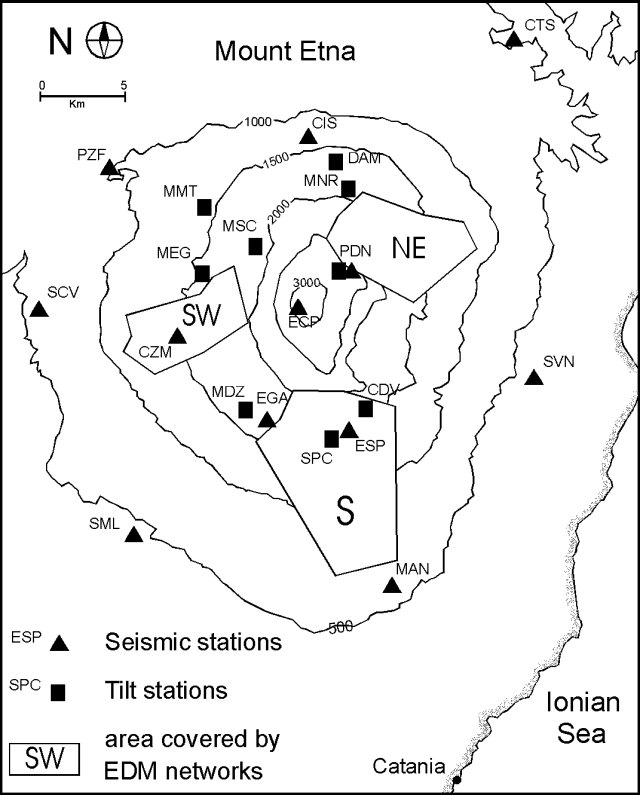 | Figure 62. Map of Etna showing locations of seismic stations, tilt stations, and EDM networks maintained by the Istituto Internazionale di Vulcanologia as of December 1995. Courtesy of IIV. |
Since the end of August 1995 volcanic tremor recorded at Pizzi Deneri (PDN: ~2 km from NEC, 2,820 m elevation) and Serra Pizzuta Calvarina (ESP: ~7 km from NEC, 1,590 m elevation) stations has shown an increasing trend. This pattern became more evident in late September, when some increases in tremor amplitude were recorded for durations ranging from tens of minutes to a few hours. The most relevant increases in tremor amplitude occurred on 22-23 September, 2, 3 and 21 October, 9, 10, 14, 22-23, and 27 November, and 23 December. This tremor amplitude pattern correlated with visually observed NEC eruptive activity.
The volcanic tremor spectral amplitude temporal pattern at PDN and ESP stations showed a clear amplitude increase. Spectral amplitude peaks were superimposed on the increased trend and corresponded to the episodes listed above. Dominant peaks in tremor spectra recorded at PDN and ESP stations showed a high-frequency (~3.5 Hz) trend coincident with the high tremor amplitude. Each amplitude increase showed similar characteristics.
Ground deformation. After the end of the 1991-93 eruption deformation was dominated by steady inflation, mostly affecting the W and NE slopes. Positive trends of areal dilatation, cumulating at ~14 ppm, were clearly apparent on the SW and NE flank EDM networks (figure 62) following the 1991-93 eruption, while the S network was characterized by a flat trend of areal dilatation for several years. Both the SW and NE networks followed comparable trends, only differing in the recent sharp positive gradient variation (10 ppm) shown by the latter between August and October.
The shallow bore-hole permanent tilt network (figure 62) indicated a progressive increase (starting by the second half of 1993) in the radial tilt component recorded at the stations on the W flank (MSC: 50 µrad) and on the N flank (MNR: 10 µrad), while the S slope showed no appreciable positive variation until July 1995. The eruptive activity resumed at the summit craters by late July-early August, and the renewed ejection of magma appeared to be strictly related in time to the positive variation of the radial tilt at SPC (~15 µrad) and the sharp increase of areal dilatation in the NE sector. Radial tilt at PDN was affected by a sharp negative variation (35 µrad) at almost the same time.
September EDM survey on the S flank. J. Moss noted that reoccupation of a different S-flank EDM network in September 1995 showed only minor line extension since eruptive activity resumed in August. Significant extensions of lines perpendicular to the Valle del Bove accompanied dike emplacement prior to the 1991-93 eruption. However, the July 1995 survey showed only minor changes since July 1994. Over 80% of the lines measured between those two surveys showed extension, suggesting a pattern of broad edifice inflation. The small strain rates suggest that no magma was intruded into this part of the S rift zone prior to September 1995.
Information Contacts: M. Coltelli, M. Pompilio, E. Privitera, S. Spampinato, and S. Bonaccorso, CNR Istituto Internazionale di Vulcanologia (IIV), Piazza Roma 2, 95123 Catania, Italy (URL: http://www.ingv.it/en/); Jane L. Moss, Cheltenham and Gloucester College of Higher Education, Francis Close Hall, Swindon Road, Cheltenham GL50 4AZ, United Kingdom.
February 1996 (BGVN 21:02)  Cite this Report
Cite this Report
Two additional significant eruptive episodes during January-February
After the sixth eruptive episode at Northeast Crater (NEC) on 23 December 1995 (BGVN 20:11/12), continuous steam emission was observed at the other summit craters in early January. After sunrise on 4 January, ash puffs were observed at Bocca Nuova crater (BN). The abundant black ash emissions were apparently not linked to explosive activity; the frequency of ash puffs ranged between 2 and 5/minute and slowly declined during the afternoon. The next day only a white plume was present. A few small ash puffs observed on 5 and 9 January came from BN and NEC.
In the early morning of 17 January, a strong explosion from NEC ejected lithic material. Intermittent blasts (up to 15 minutes apart) were heard during the day, but no ejections were observed. Fieldwork two days later revealed that Strombolian explosions with ash puffs had occurred from two vents in the NW part of the Bocca Nuova crater floor, in the same place where activity resumed at the end of July 1995 (BGVN 20:08). The Voragine crater produced unusually strong gas blasts, but no sign of eruptive activity was observed. NEC produced a strong explosion at 1010, but then remained quiet without any gas emission. A 20 January explosion at NEC had similar characteristics. Explosive activity on 21 January was more intense and caused ash emission mainly from BN, but some strong blasts also came from NEC during the day.
Seventh eruptive episode. During the night of 24 January, red glows were intermittently observed at NEC, and after 0600 on 25 January lava jets inside a dense ash cloud were observed by the surveillance video camera at La Montagnola (3.5 km from the summit). This seventh eruptive episode, 33 days after the start of the previous one, probably began around 0130 when a strong increase in tremor amplitude was recorded by the summit stations of the IIV seismic network. A pulsating ash column developed around 0430 and was flattened down to the ground by strong winds. The lava jets were fairly low (~100 m above the crater rim) so the spatter deposit mantled only the upper part of the NEC cone, whereas fine material was blown onto the NE flank. Lapilli fallout ended around 1045, but the explosive activity continued for several hours. The lapilli-fall deposit covered a sector of the volcano >20 km long and 3.5 km wide at 12 km from the vent, where the thickness of the deposit was 1-2 mm. The volume of the pyroclastic material erupted during this episode was estimated at ~500,000 m3.
During the night of 26-27 January several strong blasts from the summit were heard in the nearest villages and strong red glows were sometimes observed at the summit. This activity was marked by short periods of high tremor amplitude. At sunrise two intense ash emissions from NEC were observed by the video surveillance system. Aerial observations revealed that one or more short lava-fountaining episodes occurred at NEC during the night. A hot spatter deposit covered a wide band on the upper SE flank down to 2,500 m elevation; no fine distal deposit was observed. Ash puffs and blasts were observed and heard from BN and NEC in the following days (in particular on the morning of 28 January) up to around 1000 on 30 January when tremor amplitude increased and ashfall was reported by skiers on the S flank. However, these phenomena vanished in the afternoon.
The summit craters remained quiet in early February, showing continuous steam emission sporadically darkened by minor ash. However, tremor amplitude fluctuated above background levels. On 8 February copious ash emitted by BN thinly covered the snow on the S flank.
Eigth eruptive episode. Another fire fountaining episode at NEC began at 2335 on 9 February and ended around 0115 the next day. Pulsating lava jets reached 200 m above the crater rim. Lapilli fallout covered a narrow band (1-3 km wide) from the vent to the shoreline (25 km away) on the SE flank (figure 63). A light ash fallout reached the town of Catania. However, the estimated volume of eruptive products was the estimated volume of eruptive products was < 300,000 m3.
 | Figure 63. Map of the Etna area showing zones affected by ashfall in November-December 1995, 21 January 1996, and 9 February 1996. Coordinates are UTM. Courtesy of IIV. |
Minor eruptive activity continued until 0145-0200 on 10 February. A strong explosion at 1022 ejected a large amount of material from NEC. Several ash puffs occurred during the day at NEC and BN craters. In the late evening the ash emission at BN increased and Strombolian activity resumed at NEC, marked by increased tremor amplitude that decreased again during the night. At dawn on 11 February several ash puffs were observed at BN; this activity decreased during the day but around 1700 the tremor amplitude increased again and strong Strombolian activity resumed at NEC. Eruptive activity continued through 2130 and then dropped.
On 12 February numerous ash puffs were observed at both BN and NEC. At 0030 the following day strong Strombolian activity was observed at NEC by the surveillance camera. The intensity of explosions grew up to 0130 when another sharp tremor amplitude increase was recorded. Strombolian explosions often threw incandescent bombs up to 200 m above the crater at a rate of ~5/minute until 0200. Strombolian activity gradually decreased and after 0300 was seldom observed. At sunrise several black ash puffs were observed at both BN and NEC craters and ash emissions became less frequent at 1100.
Ash puffs were next observed on 14 February, becoming more frequent on 17-18 February and during the morning of 19 February when BN produced almost continuous ash emissions for periods of up to tens of minutes. At sunrise on 21 February the snow was covered by a thin ash layer. At 1757 pulsating red glows were visible above NEC; at 1830 the glow became continuous until sunrise the next day (22 February). Higher intensity glow occurred for up to a few tens of minutes when bomb ejections were recognized.
During 22 February activity was apparently low, with only a few ash puffs from NEC. At 0240 on 23 February red glows resumed at NEC and continued through sunrise. Red glow resumed at 1820, alternating between a few tens of minutes of strong activity and longer periods of reduced activity. The same phenomena occurred the following night but poor visibility prevented good observations.
Good visibility on the night of 24-25 February permitted detailed observations of the Strombolian activity at NEC. It was continuous all night and produced by two vents; the rate of explosions ranged between 1 and 5/minute, and ejecta rose to a maximum of 150 m above the crater. During daytime no evidence of this activity was recognizable from the surveillance camera, but the next night (25-26 February) the two vents were often active simultaneously and their frequency of explosions exceeded 5/minute; moreover, the strong explosions at the start of each higher intensity phase threw bombs up to 300 m above the crater.
Poor weather conditions after the morning of 26 February prevented regular observations. Decreasing tremor amplitude in late February suggested that the period of quasi-continuous Strombolian activity at NEC ended during daylight on 27 February.
Information Contacts: Mauro Coltelli, CNR Istituto Internazionale di Vulcanologia (IIV), Piazza Roma 2, Catania, Italy (URL: http://www.ingv.it/en/).
March 1996 (BGVN 21:03)  Cite this Report
Cite this Report
Intermittent ash emissions and Strombolian activity from two summit craters
Adverse weather conditions that prevented observation of the summit in late February (BGVN 21:02) continued throughout March. Ash puffs from Bocca Nuova crater (BN) were seen during some clear periods on 1 and 5 March, and on the morning of 6 March several black ash emissions were observed. Between 1200 and 1300 a sequence of ash puffs was produced from Northeast Crater (NEC). At 1530, another dense black ash puff was emitted from BN. At sunset the snow mantle was discontinuously covered by a thin ash layer. Ash emissions were again observed during some clearings on 7 March.
On 11 March around 2300 a one-hour long increase in tremor amplitude was recorded at the summit stations. During the afternoon of 12 March the weather improved and after sunset pulsating red glows were observed above NEC by the surveillance camera. Glow produced by the Strombolian activity after 1730 was almost continuous until changing to pulses at 1840 and disappearing at 2100. At the climax, red tracks of volcanic bombs were recognizable up to 150 m above the crater rim. The eruptive episode was marked by increased seismic tremor amplitude similar to that of the previous night.
On the morning of 14 March weather conditions became worse and the video link was interrupted. The video link was restored on 21 March and some minor ash emissions were observed. The observations by the video camera remained intermittent due to the poor weather. Around 2000 on 30 March a remarkable increase in low-frequency events and explosion earthquakes was recorded at all stations of the seismic network; poor weather prevented visual confirmation. The phenomena continued until 2100 on 31 March and during the daytime strong pulsing steam emissions, sometimes with ash, were observed at NEC and BN.
Strombolian activity that began the day after the eighth fire fountaining episode (9-10 February) continued in April, building several nested spatter and scoria cones on the NEC floor; these rose as high as the crater rim.
Information Contacts: Mauro Coltelli, CNR Istituto Internazionale di Vulcanologia (IIV), Piazza Roma 2, Catania, Italy (URL: http://www.ingv.it/en/).
June 1996 (BGVN 21:06)  Cite this Report
Cite this Report
Crater glow, gas emissions, and mild Strombolian eruptions
Visiting scientists made observations of eruptive activity during late May and June. The observations revealed continued activity similar to that previously described for this eruptive phase (BGVN 20:06-20:11/12 and 21:02-20:03).
Observations during 26 May-3 June. Activity at the summit craters was described by Marco Fulle following visits on 26 and 30-31 May and on 1 and 3 June.
Bocca Nuova was filled by thick steam on the afternoon of 26 May, but there were many strong explosions. A vent on the SE side of the crater was emitting steam jets. A vent with a lava pond on the crater floor was ejecting meter-sized lava clots 20 m high. When the pond level was close to the bottom, Strombolian explosions rose 50 m. Northeast Crater (NEC) erupted thin ash and black bombs, but later produced Strombolian explosions every 10-50 seconds that sent a few bombs 50 m above the rim directed towards the E. No bombs fell outside the crater.
Observations of NEC beginning in the late afternoon of 30 May were made for 18 hours from Pizzi Deneri and the W rim of NEC. Strombolian explosions ejected black bombs 100-200 m above the rim at 1-40 second intervals. On the morning of 31 May many meter-sized incandescent bombs were ejected well beyond the SW crater rim due to a strong wind. After 30 minutes, this activity changed to predominantly ash eruptions. Eruption intensity soon increased again, ejecting lava clots and dark bombs well above the rim.
For two hours on the evening o f 1 June observers watched from the W rim of Bocca Nuova and Voragine. Bocca Nuova contained two vents with active lava ponds aligned N-S. The N vent produced Strombolian explosions 50 m high every 10-30 minutes. The S vent produced Strombolian explosions 10-30 m high every 5-20 seconds. A third vent in the SE side of the crater produced steam eruptions every 2-10 minutes with red glow during the steam ejections. Voragine produced steam jets when NEC was inactive. During five hours of observations at NEC from the W rim on 3 June, Strombolian explosions every 2-50 seconds rose 100-200 m.
Observations during 1-20 June. While making GPS measurement of a deformation network on the volcano's upper S flanks on 1-20 June, J.L. Moss and co-workers observed summit activity.
During 1-5 June, no explosions or ash clouds were observed, but the summit vents were vigorously steaming. On 6 June, local guides reported explosive activity at NEC. On 9 June steam degassed strongly from the summit craters, and yellowish fumes escaped from Southeast Crater.
On the night of 10 June Bocca Nuova exhibited two strongly glowing vents on the crater floor, each producing mild Strombolian explosions every 5-10 seconds and ejecting material to heights of a few meters. Larger explosions took place about every minute, but no material was ejected above the crater rim. At La Voragine crater (the Chasm), a single glowing vent on the crater floor produced mild, audible, Strombolian explosions every 5-30 seconds that ejected material a few meters high.
At NEC Moss's group felt radiant heat and saw intense heat shimmering above radial fractures around the crater rim. Very strong gas emissions prompted them to wear gas masks. The crater was filled with dark (non-glowing) solidified lava; it formed a fractured dome from which a dense gas/water mixture escaped. No Strombolian activity was observed.
During 13-17 June, loud explosions were heard in the Valle del Bove, up to 3 km from the summit. Black ash clouds periodically rose 100 m above NEC.
Information Contacts: Marco Fulle, Osservatorio Astronomico, Via Tiepolo 11, I-34131 Trieste, Italy; J.L. Moss, Centre for Volcanic Research, Cheltenham & Gloucester College, Francis Close Hall, Swindon Road, Cheltenham GL50 4AZ, United Kingdom; S.J. Saunders and V.A. Buck, Brunel University, Department of Geography & Earth Science, Borough Road, Isleworth, Middlesex TW7 5DU, United Kingdom.
July 1996 (BGVN 21:07)  Cite this Report
Cite this Report
Crater glows, Strombolian eruptions, and two fire fountaining episodes
During June eruptive activity was very strong. Two episodes of fire fountaining occurred at Northeast Crater (NEC), the first on 6 June and the second on 25 June.
On 2-3 June there were many Strombolian explosions at NEC. After two days of quiescence, the 9th episode of fire fountaining since November 1995 was recorded at 2015-2110 on 6 June by the seismic network and surveillance video camera. Poor weather conditions prohibited clear observations. Volcanic tremors increased after 0550 on 6 June, with tremor amplitude reaching a maximum at 1944 and returning to normal around 2300. Lapilli and ash dispersed NW up to a few kilometers from the vent (figure 64).
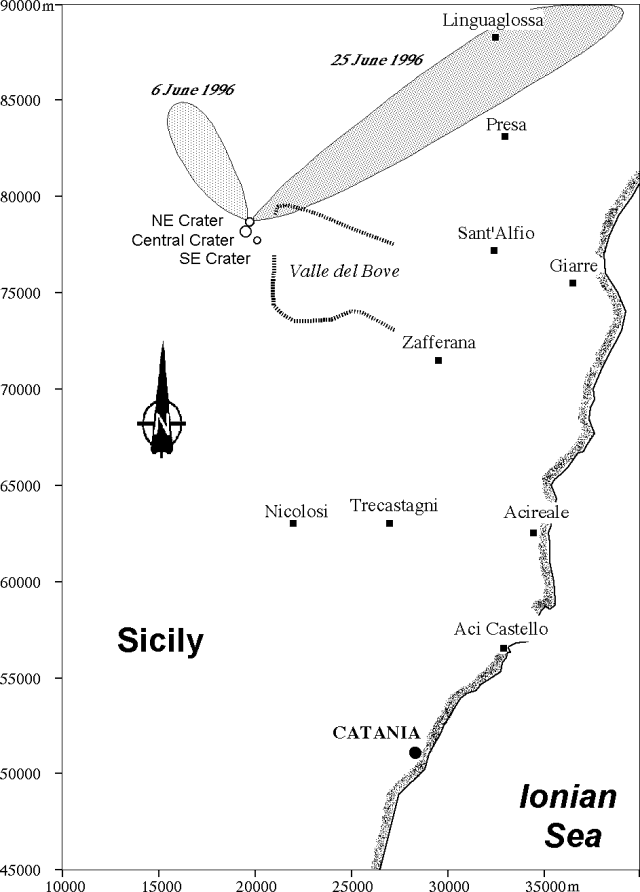 | Figure 64. Areas covered by lapilli and ashfall deposits formed by the 9th (6 June) and 10th (25 June) lava fountaining episodes. Coordinates are UTM. Courtesy of IIV. |
Red glow appeared above NEC around midnight on 7 June. From 0200 to 0400 on 8 June, there were almost continuous strong Strombolian eruptions. Between 2240 on 8 June and 0355 on 9 June, and on the evening of 9 June (2020-2200), the "La Montagnola" surveillance video camera recorded red glow above NEC and weak Strombolian activity inside the crater. On the nights of 10 and 11 June, red glows lasted a few minutes. During 0400-1200 on 12 June, ash explosions took place at NEC at intervals of 10-20 minutes. On the early morning of 13 June Strombolian activity at NEC resumed for ~20 minutes, and during 1755-1900 on 13 June there was almost continuous ash emission. The video camera system was not operational during 14-17 June. Explosions took place at NEC during 2317-2350 on 17 June, and during 0004-0300 on 18 June strong and continuous Strombolian activity was recorded. From 18 to 24 June Strombolian activity was low and sporadic.
At 2347 on 25 June, the 10th episode of fire fountaining began. The paroxysmal phase lasted for 35 minutes (0015 to 0050), and at 0055 on 26 June the episode ended. The fire fountains rose ~300 m, and a column of lapilli and ash reached several kilometers above the summit. The lapilli fell on the NE flank of the volcano (figure 64) and extended as far as Taormina, 28 km from the vent. Ashfall was also observed in Messina, 70 km away. An increase of volcanic tremors with oscillation of amplitude was recorded after 2200 on 24 June. The maximum amplitude of volcanic tremors was reached at 2230 on 25 June and lasted for more than one hour.
After the 10th eruptive episode, NEC remained quiescent until the morning of 28 June. At around 1700 that day, strong ash explosions opened a new vent on the W side of the crater floor that had been sealed by fire-fountain spatter. In the last week of June, Strombolian activity also resumed at Bocca Nuova crater (BN). Several red bombs were thrown up to the crater rim.
Beginning on 2 July, the surveillance camera recorded continuous red glow during all the nights in July, indicating persistent Strombolian activity inside NEC. During the first ten days of July, explosive activity at NEC was relatively low, then gradually increased and became vigorous on the early morning of the 14th. On 16 July Strombolian activity abruptly decreased. The next day several black ash puffs were observed, eruption intensity increased again, and a second vent inside the crater began to erupt. During 18-20 July, Strombolian activity was very strong and the magma level inside the vents was high. Jets of magma rising up to 200 m resulted in the fast growth of two cinder cones.
Two eruptive fissures formed on the W and S flanks of the cone at NEC on the morning of 21 July. The fissure on the W flank (N70°W, 40 m long, ~3,220 m elevation) issued a lava flow that was active until that afternoon and produced a small lava tongue, which was 100 m long, 10 m wide, and 2 m thick. The W lava flow continued until 22 July. A lava flow from the S fissure moved on the flank of NEC that borders the Voragine crater at ~3,230 m elevation.
On the morning of 23 July, lava spilled from an ephemeral vent on the lowest portion of the E rim at NEC (at an elevation of ~3,250 m). The vent drained a crusted lava flow field that had formed in the previous days and covered the E side of the crater floor. The lava overflow traveled E for more than 1 km inside the Valle del Bove, and its front reached an elevation of ~2,650 m, above the hornitos chain from the 1986 eruption. Close to the vent, the lava flow was ~2 m deep and ~1 m wide, but at a few tens of meters away from the vent, it was up to 10 m in width. On the morning of 25 July, a preliminary estimate of the lava output rate was 0.3 m3/s. Direct thermocouple measurements of the lava flow temperature gave a maximum value of 1,080°C. On 28 July the lava issuing from the E side of NEC crater rim stopped, resumed a few hours later, then stopped on the morning of 29 July.
The lava erupting inside the Voragine crater stopped on the morning of 30 July, and resumed a few hours later. On 31 July the lava flow and gas emission continued, and lava filled the degassing vent of the Voragine crater at a rate of ~0.5 m3/s.
On 1 August eruptive activity increased very quickly, and on the night of 3 August three lava flows poured from the NEC crater rim and moved down the E slope of the summit cone into the Valle del Bove. Explosive activity continued at NEC and threw large bombs up to 300 m above the crater rim.
Information Contacts: Mauro Coltelli and Paola Del Carlo, CNR Istituto Internazionale di Vulcanologia (IIV), Piazza Roma 2, Catania, Italy (URL: http://www.ingv.it/en/).
October 1996 (BGVN 21:10)  Cite this Report
Cite this Report
Southeast Crater resumes activity after five-years
The following summarizes the monthly reports of the Istituto Internazionale di Vulcanologia (IIV) for the period August-7 November 1996.
Activity during August. Strombolian activity continued from two vents in the cinder cone on the W border of the Northeast Crater (NEC) rim. There were almost continuous explosions; bombs and lapilli were thrown up to several tens of meters above the crater rim. Lava flowed from the NEC effusive vent on the S flank down into Voragine crater.
On 3 August an ash emission lasted three hours and three lava flows produced by ephemeral vents on the E rim of NEC moved toward the Valle del Bove. Activity increased on 4 August at 2045 and continued until the morning of 8 August without interruption. During these days explosions were heard in the villages Zafferana Etnea and Nicolosi (15 and 10 km from NEC, respectively). Three to four new vents emerged; they were aligned roughly N-S, produced Strombolian explosions, and modified the shape of the cinder cone from circular to elliptical.
Activity increased again on the morning of 14 August when several blasts from the middle flank of the volcano were heard. Two vents erupted together throwing lapilli and bombs up to 300 m above the NEC. An aa lava flow from the E slope of the cone moved into Valle del Bove, and sudden high lava jets were observed at the vent in front of the Voragine crater.
On 15 August some ash emissions occurred, and red glow was observed continuously during 15 and 16 August. During the night of 16-17 August the Strombolian activity suddenly decreased. On 17 August a few explosions ejected both incandescent and dark material. During the night of 17-18 August the lava flow in Valle del Bove stopped. On 19 August the lava flow in the Voragine also stopped and overall there was no eruptive activity. Poor weather conditions prevented clear observations.
On 21 August from 1040 to 1130 small Strombolian explosions occurred at NEC. On 28 August from 0700 to 1230 several ash explosions coincided with collapse of the cinder cone inside the NEC.
Activity at Bocca Nuova crater was characterized by mild and discontinuous Strombolian eruptions from vents in the N part of the crater floor. The other two summit craters, Southeast Crater and Voragine, produced only steam emissions. Although the degassing vent in the Voragine crater was filled almost continuously by lava from 21 July to 19 August, it remained open and degassing for the whole period.
Activity during September-October. Gas and steam were continuously emitted from the summit craters during September. On 17 September at 2100, weak Strombolian activity was observed at NEC for one hour.
On 1 October at 2100 Strombolian activity resumed at NEC with an explosive sequence. Initially the explosions occurred every 5 minutes; from 2230 the glow of the explosions became continuous and stronger, lasting all through the night. During the daylight of 2 October, puffs of black ash were observed until midday. Bad weather condition prevented observation for some days, and when the summit craters became visible they emitted only gas and steam.
Another short period of Strombolian activity occurred during 13-14 October, beginning around 1200 on 13 October with several small black ash puffs every 10-20 minutes. Weak red glows observed at night on NEC indicated low Strombolian activity. The following morning ash puffs were still emitted at NEC; eventually during the day the ash emissions became less frequent and then disappeared.
On 18 October a single ash explosion occurred and on 20 and 23 October several ash puffs were noted. These explosions opened a large pit crater on the E side of the intracrater cinder cone built during the strong eruptive activity of July and August.
On the N floor of Bocca Nuova (BN) during October, an incandescent hole produced sporadic weak Strombolian activity. The occurrence of ash in the plume after 24 October marked an increase in explosivity. Voragine had no eruptive activity in October; only quiet steam emission and some puffing were observed at the large hole on the lower part of the crater floor.
Activity during 1-7 November. On 2 November some intense red flashes were reported from BN and NEC at 0045; within the next 20 minutes larger explosions produced stronger glows at BN. Strombolian emissions at BN resumed during 0125-0130 and during 0205-0210, but ejecta reamined within the crater and minor emissions continued until 6 November when one ash puff reached 1 km above the summit. The emission came from an old degassing vent located on the inner wall, on the SE side of the crater. The associated explosion enlarged the vent and caused debris from the inner walls to cover a wide portion of the S crater bottom. A few small lava blocks fell on the S crater rim and a brown, totally non-juvenile ash deposit covered the E sector of the summit cone of the volcano down to a few km from the crater.
These events preceeded the resumption of activity at Southeast Crater (SEC), ending five years of complete inactivity (quiet since Autumn 1991, shortly before the beginning of 1991-93 eruption). On 6 November, after the large phreatic explosion at BN, very low Strombolian activity was reported from two vents on the floor of SEC. The close temporal occurrence of these phenomena and the alignment of the Strombolian vent of BN, the phreatic vent of BN, and the Strombolian vent of SEC, suggested that a very shallow magma intrusion moved from BN toward SEC and triggered its Strombolian activity. However, such interplay is normal among the Etna summit craters when the magma level reaches a very shallow depth. During the evening of 6 November some very low glows were observed above the SEC. In the following days SEC eruptive activity remained at very low levels of intensity.
Overflights of the summit craters on 5, 6, and 7 November confirmed that Strombolian activity occurred at BN almost continuously from one or more closely spaced vents on the top of the intracrater cone.
Information Contacts: Mauro Coltelli and Paola Del Carlo, CNR Istituto Internazionale di Vulcanologia, Piazza Roma 2 Catania Italy (URL: http://www.ingv.it/en/).
February 1997 (BGVN 22:02)  Cite this Report
Cite this Report
Summary of activity since November 1996
The following summarizes the activity observed at Etna from November 1996 through March 1997.
Activity during November 1996. On 2 November both Bocca Nuova (BN) and Northeast Crater (NEC) produced Strombolian activity lasting all night. On 6 November an old degassing vent on the inner wall on the SE side of the crater emitted one ash puff that reached 1 km in height. The associated explosion enlarged the vent and caused debris from the inner walls to cover a wide portion of the S crater bottom. A few small lava blocks fell on the S crater rim and a brown, totally non-juvenile ash deposit covered the E sector of Etna's summit a few kilometers down from the crater. The same day Southeast Crater (SEC), quiet since Autumn 1991, began very low Strombolian activity from two vents on its floor. During the evening of 6 November glow was seen above the SEC, but in the following days eruptive activity remained very low.
Overflights on 5-7 November confirmed that Strombolian activity occurred at BN almost continuously from one or more closely spaced vents on the intracrater cone. Besides almost continuous ash puffs produced on 10 and 11 November at BN, there were two large ash explosions on 16 and 18 November.
The surveillance video camera captured intervals of night glows over NEC (from 0110 to 0130 on 23 November; from 1812 to 2100 on 24 November; and for a half-hour during the night of 27-28 November). At SEC between 23 and 28 November weak Strombolian activity occurred sporadically. BN produced several discrete Strombolian explosions from 2005 to 2140 on 28 November.
Activity during December 1996. The summit craters erupted infrequently in the first half of December and more frequently in the second half. On 15 December Strombolian activity was reported at both craters during 2340-0200. At NEC episodes of Strombolian activity occurred on 17 December (1730-2140), 18 December (0150-0438, 1830-0045), 19 December (1740-1747, 2125-2215), and 21 December (0400-0540, 1730-1800).
During the morning of 16 December some ash explosions occurred at BN; in the morning of 19 December there was both an ash plume and ash puffs. A small wall collapsed on 21 December at BN's S vent adding particulate to the summit plume.
Between 22 and 24 December some short periods of Strombolian activity were recorded at both NEC and BN. At SEC during December there were no available video records; however, direct observations revealed only very weak and discontinuous activity.
Activity during January 1997. BN's Strombolian activity was reported at multiple times: 1800-2100 on 7 January; 2348-0102 beginning on 9 January; during several ~1-hour intervals, 11-13 January; and as weak, continuous activity, 14-24 January. More episodes occurred at 1940-2130 on 27 January; at 0800- 1400 on 29 January; at 0800-0900 on 30 January; and at 0400-0500 on 31 January.
NEC's Strombolian activity took place at these times: 2000-2100 on 7 January; several ~1-hour episodes between 11-13 January; and sporadic weak episodes, 20-22 January. Later, from 25 January until the end of the month, the eruptive vigor rose; ash emissions occurred during 0800-1400 on 29 January and eruptions could be watched from a distance from sunset until 2200 on 30 January.
On 25 January, at 1920 SEC began one hour of very weak Strombolian activity. The activity of SEC had formed a small cinder cone inside the crater and some short fan-shaped aa lava flows departing from the cone.
Activity during February-5 March 1997. The first half of February was characterized by the continuous emission of ash from BN; bomb and lapilli ejections inside the crater were reported on 11 February. There was strong degassing from NEC but weak emissions from Voragine Crater. Inside SEC the small cinder cone spattered continuously, though weakly. During the second half of February both BN and NEC plumes frequently contained ash.
A field survey on 5 March revealed that some cinder cones formed in BN. One of these cones threw bombs up to the crater rim and a vent in the SE part of the crater gave off strong emissions of gas and red ash. Fresh lava tongues were identified on 5 March at the W edge of the SEC cinder cone. A later image of SEC (11 March) is shown in figure 65. Voragine crater only degassed whereas NEC collapsed slightly as indicated by minor debris in the crater.
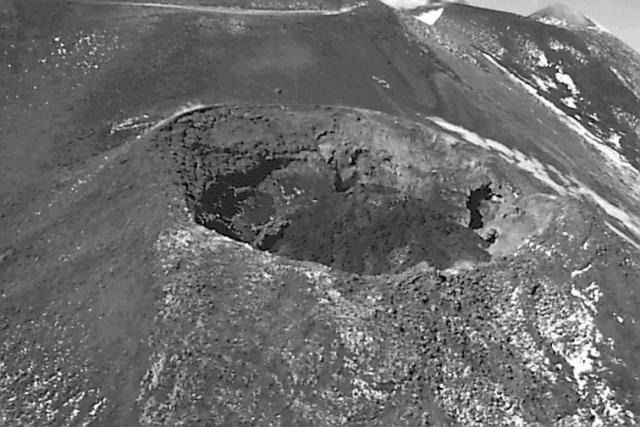 | Figure 65. Aerial view of SEC on 11 March 1997 showing the intracrater cinder cone and the small lava flow first seen on 5 March. Photo by A. Amantia; provided courtesy of CNR-Istituto Internazionale di Vulcanologia. |
Information Contacts: Mauro Coltelli and Paola Del Carlo, CNR Istituto Internazionale di Vulcanologia, Piazza Roma 2, Catania, Italy (URL: http://www.ingv.it/en/).
May 1997 (BGVN 22:05)  Cite this Report
Cite this Report
New map of the craters Voragine and Bocca Nuova
A map prepared from observations carried out on 11 April of Voragine and Bocca Nuova craters is presented in figure 66. The position and altitude of the points shown by stars were measured with ranging binoculars (model 1500 DAES; on loan courtesy Leica-France) from two observation points (circles) on the rim of the craters. Photos of the crater interior were also used to draw the map.
 | Figure 66. Map of the Etna craters prepared using LEICA binoculars. Courtesy of P. Briole, O. Consoli, C. Deplus, and J-L. Froger, IPGP. |
Bocca Nuova crater measured ~170 m deep and had two active cones on the crater floor. The N cone, 25 m above the crater floor, was the most active. Its Strombolian activity threw ejecta close to Monumento, a spot on the crater's N rim. The S cone, 35-40 m above the crater floor, appeared composed of two coalescent cones, and was less active then the N one.
The depth of the Voragine crater measured ~150 m. Quiet steam emission was observed escaping from the large hole on the lower part of the crater floor.
Information Contacts: Pierre Briole, Orazio Consoli, Christine Deplus, and Jean-Luc Froger, Institut de Physique du Globe de Paris, Case 89, 4 place Jussieu, 75252 Paris Cedex 05, France.
June 1997 (BGVN 22:06)  Cite this Report
Cite this Report
Summary of April-June 1997 activity
During April the mild Strombolian activity of Southeast Crater (SEC) continued at the same level as in previous months (BGVN 22:02). Every night the surveillance video camera at "La Montagnola" recorded episodes of Strombolian activity that lasted from a few minutes to an hour, with some isolated explosions. Direct observations on 11 April revealed that the small SEC cinder cone had changed its shape and was still producing new lava flows from the breaks on its flanks. Strombolian activity occurred also at Bocca Nuova (BN) with spattering as high as the crater rim. On the N side of the crater floor a cone was spattering from one of its numerous vents. On the SE side a new vent opened near an older one; both were strongly degassing and mildly spattering. Strong degassing was observed both at Voragine and Northeast Crater (NEC). In addition, the collapse of NEC's floor was indicated by debris in the crater. Field surveys during the second half of April revealed no variations in the volcanic activity or in the craters' appearance.
During May, Strombolian activity at the N and S vents of BN varied daily in intensity from low-level degassing and minor eruptive activity to magma boiling on the crater floor and almost continuous Strombolian explosions. Volcanic bombs were thrown as high as the crater rim, but none fell out of the crater. SEC continued to produce minor, almost continuous gas explosions and some spattering from the dome-shaped cone. Lava emissions generally lasted for a few hours. This hornito-style activity was eventually interrupted by sudden vigorous explosions caused by temporary blockage of the conduit. Examination of bombs and lava blocks that had fallen beyond the SEC rim confirmed that the magma was more crystal-rich and viscous compared to the scoriaceous material erupted by BN. No explosive activity was reported at NEC except a few small brown ash emissions, probably caused by collapse of the degassing vent's walls. Enlargement of the pit-shaped vent was seen during a survey with a Civil Protection helicopter.
During June the explosive activity gradually increased at both BN and SEC. In particular SEC's hornito-style activity was frequently interrupted by intense explosions, but there was no appreciable variation in lava emission. BN activity remained within the crater boundaries with minor lava flows; eventually bombs thrown out of the crater fell on the cone's upper N slope.
Information Contacts: Mauro Coltelli and Paola Del Carlo, CNR Istituto Internazionale di Vulcanologia, Piazza Roma 2, Catania, Italy (URL: http://www.ingv.it/en/).
July 1997 (BGVN 22:07)  Cite this Report
Cite this Report
Continued activity from three craters through mid-July; crater descriptions
The following summarizes observations, organized by crater (figure 67), made by Boris Behncke of the activity and morphology of Etna's summit craters during visits on 14 June, 11 July, and 16 July 1997. Additional observations of activity through 18 July are reported.
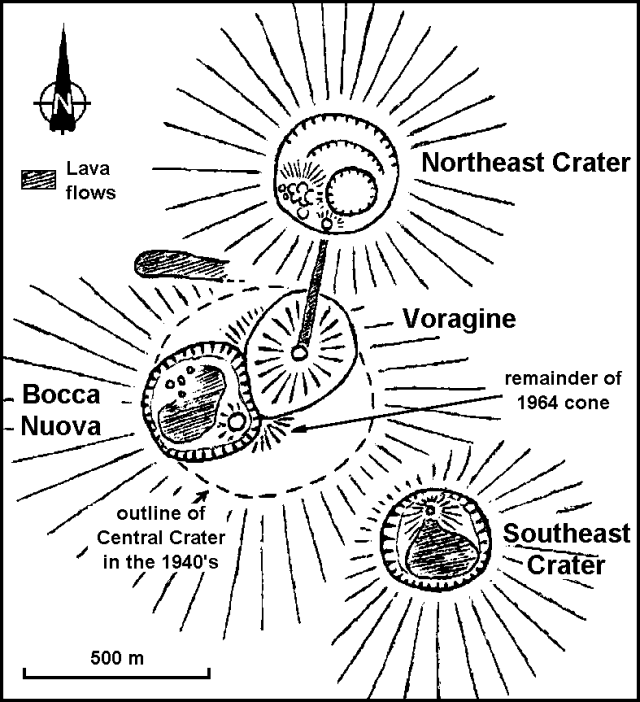 | Figure 67. Sketch map of Etna's summit craters as of July 1997. Locations of eruptive vents and recent lava flows are indicated. Courtesy of Boris Behncke. |
Voragine. This crater was degassing from a central pit during visits in October 1995 and September 1996. Lava effusion from nearby Northeast Crater into Voragine in July-August 1996 did not fill the pit. However, during 14 June the pit was obstructed, with only wisps of steam escaping from its E rim. The 1996 lava flows from Northeast Crater had been almost completely removed by collapse. On 13 July the crater reopened. Mountain guides reported ejections of ash and possibly fresh scoria.
Northeast Crater. After the activity of late 1995 to late 1996, Northeast Crater became Etna's highest summit, surpassing the remains of a 1964 cone on the SE rim of Bocca Nuova. The 1995-96 activity and subsequent collapse completely altered the crater, which had a deep pit with vertical walls in early October 1995. The SW part of the crater contained a cluster of small cones and partially overlapping craters; none were active on 14 June. The N part of the crater was occupied by a lava platform which filled the crater in June-July 1996. The W edge of this platform was made of large tilted slabs. A lower platform covered by a lava flow from the cone cluster partially encircled a deep ~100-m-wide pit that was the site of Strombolian activity. Loud roaring from the pit on 14 June preceded emissions of dense yellowish ash-bearing gas plumes at intervals of 1-2 minutes. Activity on 11 July (when viewed from Bocca Nuova) appeared similar; there were no incandescent ejections after sunset.
Bocca Nuova. Since the resumption of magmatic activity in July 1995, two principal eruptive centers have been active in the ~150-m-deep pit: one vent at the base of the SE crater wall, and a group of vents in the NW sector of the crater. The former only emitted gas during the past two years; the latter exhibited periodic Strombolian activity and lava effusion. On 14 June the SE vent had Strombolian explosions every 10-15 minutes, with fragments rising 50-70 m; on 11 July explosions reached the crater rim (>100 m above the vent) and fresh bombs were found to the SE outside of the crater. The NW vent cluster consisted of three boccas aligned NW-SE on 14 June that generated nearly continuous small Strombolian bursts and lava emission from an area to their E. At times the northern vent filled with bubbling lava. On 11 July three vents were aligned E-W; lava effusion occurred from vents to their E or SE.
During a visit on 16 July, a large spatter cone with a crater 20-30 m wide had formed in the NW area of activity, where there had been three small vents only five days earlier. The crater of this new cone was filled with vigorously boiling and spattering lava. Explosions from the SE eruptive vent occurred about every 3-5 minutes, at times ejecting bombs high above the SE rim (~150 m above the vent). Similar activity continued through 18 July.
Southeast Crater (SEC). On 14 June noises characteristic of Strombolian activity were heard ~2 km S of the crater, but no ejections rose above the crater rim. Daily observations from Catania (~30 km S of the summit) began on 7 July, coinciding with a slight intensification of activity from SEC. At night, nearly continuous Strombolian bursts were visible. During the following evenings activity appeared more discontinuous, with periods of activity up to 20 minutes separated by up to several hours. A visit to the crater on the evening of 11 July found that a cinder cone in the N part of SEC had almost risen as high as the crater rim. Strombolian activity, in cycles lasting ~15-20 minutes separated by intervals up to 20 minutes, sent bursts as high as 150 m above the vent. An incandescent lava flow from a vent ~20 m below the cone's summit moved down the S flank of the cone, extending ~200 m to the S base of the inner wall of SEC. Slightly older flows around the active lobe still had incandescent spots. Despite the episodic explosive activity, effusive activity appeared reasonably constant. Night observations from Catania during the following days disclosed continuing explosive activity from SEC.
The floor of Southeast Crater, gradually being filled by a growing cone and lava flows, had risen to within <10 m of a low point on the SE crater rim by 16 July. As of 18 July the cone in SEC's N half was as high as the crater rim (~50-70 m above the lowest part of the crater floor). Lava flows issued more or less continuously from boccas on the upper S and SE flanks of the cone, forming a complex lava field to the S, SE, and E. At night, explosive activity from the cone's summit is visible from Catania.
Information Contacts: Boris Behncke, Istituto di Geologia e Geofisica, Palazzo delle Scienze, Corso Italia 55, 95129 Catania, Italy.
August 1997 (BGVN 22:08)  Cite this Report
Cite this Report
Strombolian activity and lava overflows; all four summit craters active
The following report, jointly submitted by scientists from the Università di Catania and the Istituto Internazionale di Vulcanologia, expands on information from the first half of July (BGVN 22:07) and adds observations of activity at each crater through the end of the month. A review of the eruption since July 1995 places the current activity into context. Between 19 and 31 July, moderate eruptive activity continued from the summit craters, including occasional small overflows from Southeast Crater (SEC). Magmatic activity began at the Voragine in mid-July, followed by continuous Strombolian activity from a central pit in Northeast Crater (NEC) at the end of July (after about eight months of relative quiet). A visit on 5 August revealed magmatic activity from all four summit craters (figure 68).
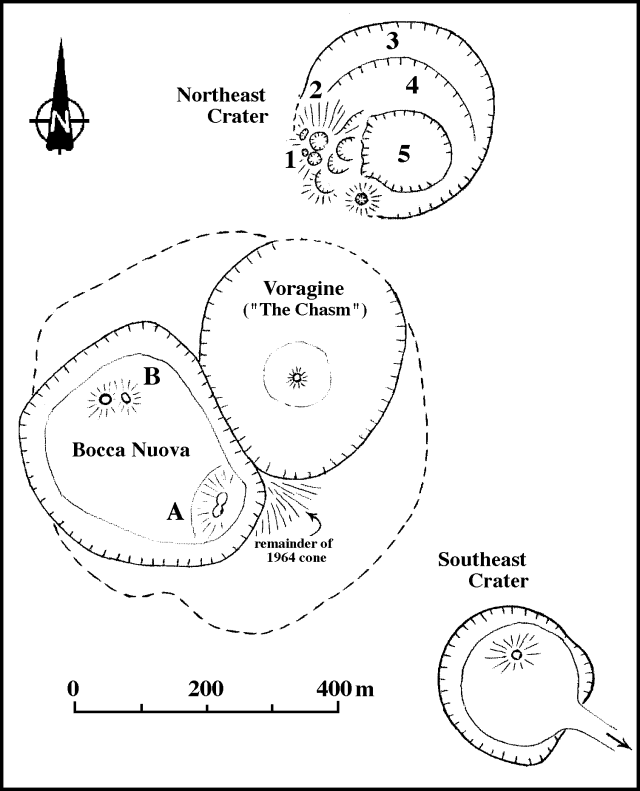 | Figure 68. Sketch map of Etna's summit craters as of late July 1997, showing vents active in 1996-97. For Bocca Nuova, locations A and B indicate eruptive centers. Numbered features in Northeast Crater identify: 1) the cluster of cones and craters active in July-August 1996 (the two westernmost craterlets are collapse structures formed after that activity); 2) tilted slabs of lava and agglutinate; 3) the outer platform; 4) the inner platform covered by lava flows from the cones; and 5) a collapse pit over the central conduit. Courtesy of Boris Behncke and IIV. |
Review of activity since July 1995. Magmatic activity resumed in Etna's summit craters in July 1995, more than two years after the end of the voluminous 1991-93 E-flank eruption in Valle del Bove. Initially this activity was limited to Bocca Nuova (BN), the westernmost of Etna's four summit craters, but it soon extended to nearby NEC. During November 1995-August 1996, NEC was the site of spectacular explosive and effusive activity, including ten episodes of high lava fountaining (BGVN 20:11/12, 21:02, 21:03, 21:06, 21:07, and 21:10), while BN continued to emit pyroclastics and small intracrateral lava flows on a moderate scale. In early November 1996, magmatic activity resumed at SEC, which had been inactive since late 1991 (BGVN 21:10). SEC activity was initially very mild, gradually building a small intracrateral cone. In late January 1997 it began to emit minor lava flows that were confined to the ~200-m-wide crater. Activity at SEC and BN continued through late June 1997 without major modifications. Etna's fourth summit crater, Voragine (also known as The Chasm), has been actively degassing from a pit on its floor without the emission of any juvenile material in past years.
Voragine. The central degassing pit was obstructed by talus on 14 June, with only minor wisps of steam escaping from the pit's rims. Apparently, a lava flow erupted into the Voragine from NEC in July- August 1996 had partially collapsed, covering the pit. On the evening of 13 July 1997 dense gas clouds possibly containing some ash were seen rising from the Voragine for about 15 minutes. On 18 July, the Voragine was found in a state similar to previous years, but the day after, fluid lava had risen to the lip of the central pit. A small cone (~5 m high) began to grow over the former pit on 24 July; this cone was the site of mild but continuous Strombolian activity, throwing incandescent bombs to several tens of meters above the vent. Similar activity continued through 28 July, but a visit to the crater on the following day revealed that eruptive activity had stopped and only weak steaming occurred from the new conelet.
Northeast Crater (NEC). The intense activity of 1995-96 and subsequent collapse completely altered the morphology of NEC, which was a single deep pit until early November 1995. The WSW part of the crater was occupied in July by a cluster of partially overlapping craters and small cones, some being minor collapse features (figure 68, number 1). The northern part of NEC contained an outer platform ~30-50 m wide (figure 68, number 3) of agglutinate that filled the crater in June-July 1996. The W edge of the platform was marked by large craggy slabs of lava (figure 68, number 2), which were tilted upwards as the lava fill subsided. A lower inner platform in the central northern part of NEC (figure 68, number 4) was covered by late lava flows erupted from the cone cluster. In the southern central part of the crater there was a collapse pit (figure 68, number 5) ~100 m across that showed vigorous degassing and possibly deep-seated Strombolian activity. During a 20-minute visit to NEC on 14 June loud roaring noises were followed by pit emissions of dense yellowish gas plumes containing some ash at intervals of 1-2 minutes. On 14 July ash emissions occurred from the crater, a day after similar emissions from the Voragine. During the last week of July, there was a gradual resumption of Strombolian activity, which had become continuous by the 31st. Most of this activity was confined to the pit, but occasional larger explosions ejected incandescent bombs high above the summit of NEC.
Bocca Nuova (BN). Since the resumption of magmatic activity in 1995, two principal eruptive centers have been active in this crater, one at the base of its vertical SE wall (figure 68, location A) and another in the NNW sector of BN (figure 68, location B). Throughout July, Center A consisted of two closely spaced vents that built a large half-cone against the crater wall, ~30 m above the crater floor. While one of the vents at times displayed quasi-continuous small Strombolian bursts, the other produced very violent explosions at intervals ranging from 30 seconds to 5 minutes, often ejecting bombs >150 m above the vent. These explosions were accompanied by detonations that could be heard several kilometers away. During some of the largest explosions bombs fell on the SE rim or outside BN to the S in the area of the former summit crater platform.
Center B had a highly variable number of explosive and effusive vents that formed a complex cone surrounded by a lava field covering almost the entire crater floor. Between early June and about 15 July, Strombolian activity occurred from several closely spaced vents with diameters not exceeding 10 m each while lava issued from vents at some distance from the explosive ones. By 16 July there was one large vent ~30 m across at the top of a broad cone. The vent was filled with vigorously boiling and fountaining lava, with some fountains ejecting spatter as high as the crater rim (~100 m above the vent). By late July, a second cone was growing on the E side of the first one; both exhibited lava splashing and fountaining while lava issued from vents at the base of the cones. The floor of BN underwent repeated and rapid resurfacing during this time and the maximum depth of the crater was 114 m (determined with laser rangefinder) at the end of July.
A 5 August visit revealed four erupting vents, two in the northern eruptive area and two on the half-cone growing in the SE corner of the crater. Bursts of bombs and spatter often rose significantly higher than the crater rim, reaching heights of up to 200 m above the SE vents. Large explosions from these vents at times ejected bombs onto the SE rim of BN and over the S flank of the central cone, making this area very dangerous.
Southeast Crater (SEC). This crater is gradually being filled by the growing intracrateral cone and lava flows, and lava has spilled onto its outer slopes. Explosive and effusive activity occurred at variable intensity from vents varying continuously in size, number, and location. The main focus of activity was at the summit of the cone (~20 m above its N base and ~40 m above its S base) in the central northern part of SEC (figure 69), but effusive activity often took place on the flanks of the cone, either from small hornito-shaped cones or from wedge-shaped purely effusive vents. More rarely, lava flows were directly emitted from the explosive summit vents.
 | Figure 69. Development of the intracrateral cone and lava flows at Southeast Crater of Etna during July 1997. Active flows are indicated as white areas; recent but inactive flows by a dark pattern. "Fortino" is a small stone shelter built on the highest point of the W crater rim. Courtesy of Boris Behncke and IIV. |
Activity increased in early July, and explosions became visible from Catania (~30 km S) at night. During the following days Strombolian activity was discontinuous, occurring in cycles that lasted 10-15 minutes separated by quieter periods of similar duration. Visits to the crater once or twice per week, and helicopter overflights, documented shifts in eruptive vents and development of lava flows (figure 69). By 11 July the level of the intracrateral lava field had risen to within a few meters of the lowest part of the crater rim (on the SE side of SEC; figure 69a); late on 19 July a small lava tongue spilled over the SE crater rim, advancing ~30 m downslope before stopping. On that evening, the intracrateral cone had three explosive vents; the most vigorous one was the lowest and easternmost (figure 69b). Lava issued in surges from that vent, forming a high lava ridge with several steep-sided pinnacles on the SE flank of the cone. A second minor overflow onto the SE flank occurred on 22 July, forming a second lava lobe on top of the first one, but without reaching farther downslope. During the following days, Strombolian activity became continuous.
On 25 July the intracrateral cone had grown by ~10 m since 19 July, and two explosive vents on its summit ejected bombs ~100 m high. Lava effusion from a hollow-shaped vent fed a flow that advanced towards a low point on the NE crater rim (figure 69c). Effusive activity occurred in pulses coinciding with periods of increased explosive activity at the cone's summit. Larger volumes of lava began to spill onto the outer SE flank of SEC on 27 July, forming a black tongue ~150 m long and 50 m wide. On the 29th, lava effusion occurred both on the NE and SE sides of the cone (figure 69d), but the lava field showed little growth because the flows on the SE flank apparently overlapped rather than extended downslope. Continuous explosive activity from a single summit vent ejected bombs ~200 m above the vent, and pyroclastics fell onto the high W rim of SEC, in the area of a small stone shelter ("Fortino" in figure 69d). During the night of 31 July-1 August, another overflow formed a new lava lobe on the N side of the earlier flows, and advanced some 30 m farther downslope.
Activity at SEC on 5 August continued in the same manner as in previous weeks with vigorous explosions at an intracrater cone and lava effusion from its eastern flank. Several small overflows from the SE rim had spilled onto the cone's flank almost every day in early August, and a small overflow had occurred onto the NE flank.
Information Contacts: Boris Behncke, Istituto di Geologia e Geofisica, Palazzo delle Scienze, Università di Catania, Corso Italia 55, 95129 Catania; Mauro Coltelli and Paola del Carlo, Istituto Internazionale di Vulcanologia, Piazza Roma 2, 95123 Catania, Italy (URL: http://www.ingv.it/en/).
September 1998 (BGVN 23:09)  Cite this Report
Cite this Report
Summary of summit eruptive activity during August 1997-January 1998
The following report summarizes activity observed at each of the four summit craters of Etna from August 1997 through 15 January 1998. Events through 8 January 1998 at Bocca Nuova, Southeast Crater, Northeast Crater, and Voragine are described below separately. A seismic crisis during 9-12 January was followed by a brief decrease in activity at all of the craters. Significant eruptive episodes after mid-January 1998 will be described in future issues.
Information for this report was compiled by Boris Behncke at the University of Catania and published on his internet web site. The compilation was based on personal visits to the summit, telescopic observations from Catania, monitoring of images posted on the internet from the camera maintained by the Istituto Internazionale di Vulcanologia (IIV), and other sources.
Visits to the summit craters in late September and early October 1997 revealed continuing vigorous activity from Bocca Nuova and Southeast Crater while more sporadic activity was occurring at the Voragine and Northeast Crater. This pattern continued through November and December. The overall activity on 8 January 1998 at Bocca Nuova, Northeast Crater, and Voragine was notably diminished; it was the lowest observed in six months.
Activity at Bocca Nuova. During late August, lava ejections from Bocca Nuova (BN) became significantly more vigorous. Both eruptive centers in this crater often ejected lava bombs outside the crater, with many falling on its S rim. Occasional explosions ejected bombs on the lower S flank of the central cone. The number of active vents in Bocca Nuova increased to seven on 28 August, but was down to five just two days later. The bombardment and explosions led to collapse on the E side of Bocca Nuova, lowering the septum between BN and Voragine (informally named "diaframma" among local volcanologists), and eroding the remains of a 1964 cone.
Visits to the summit in late September and early October revealed continuing activity. As of 14 October, Bocca Nuova's activity was gradually increasing, and the crater was being filled in. The northern of its two eruptive centers had a broad cone with a crater 50-100 m wide, which at times was completely filled with fountaining lava. Fountains often sent spatter and bombs high above the rim, and large ejecta fell outside the crater up to 100 m away. Bombs as large as 40 cm in diameter fell onto the area where the best views of the erupting cone in BN are obtained. Explosions in the SE eruptive center at times sent pyroclastic material all over the S flank of Etna's summit cone.
On 6 November the northern eruptive center was vigorously active. The cone at that site had grown to ~50 m below the NW crater rim. The SE eruptive center was much less violent than in previous months; on the crater wall above it a large overhanging hollow had been carved out by explosions. On the evening of 6 November, Strombolian explosions occurred at intervals of 1-5 seconds, with some jets rising up to 200 m above the cone's summit. An episode of spectacular lava fountaining from BN occurred on 25 November when huge bursts of incandescent bombs developed into a continuous fountain from the SE eruptive center. On 28 November the clouds over the mountain cleared, permitting the view of a huge vapor column rising almost vertically to about 1,500 m above the summit. This unusually large plume was due to an approaching cold front that led to increased condensation.
Explosive activity and gas emissions within BN accompanied a lava flow from Southeast Crater during 9-11 December. Intermittent activity on 12 December, stronger than during the previous 17 days, ejected high bursts of incandescent bombs from BN's southeastern vents. Activity through 15 December was very vigorous, and eruptions continued through 21 December. Glow was visible above BN's two eruptive centers on 26 December and over the E part of the crater on 31 December.
On the evening of 7 January, several jets of incandescent bombs rose over the SE crater lip, and a few bombs fell onto the remains of the 1964 cone. As of 8 January the large cone in the N part of the crater floor had partially collapsed, creating a crater ~150 m in diameter. Frequent rockfalls occurred within this crater. Subsidence of the cone and the adjacent crater floor had created a set of circumferential fractures several meters wide. The most recent activity at this eruptive center appears to have been the extrusion of a lava flow that covered the E and SE sides of the BN floor. The vents at the SE eruptive center were the site of weak Strombolian explosions every 10-15 minutes. Most, if not all, activity occurred from the lowermost vent in the SW part of the eruptive center. A complex cone around these vents had grown notably since the visit on 6 November 1997, with the rim of the highest vent being at about the same elevation as the N rim of Bocca Nuova. Large parts of the crater wall above the SE eruptive center had collapsed, probably before the most recent cone growth (all collapse debris was buried).
Activity at Southeast Crater. Strombolian and effusive activity continued from Southeast Crater (SEC), whose intracrater cone could be seen on 1 September through a gap in the NE crater rim from coastal areas to the E. During a visit on 30 August, lava fountains rose up to 150 m above the cone, and three vents were active. There had been significant infilling of the deep southern part of SEC since effusive activity shifted to the cone's NW flank sometime before 11 August. Before then, lava had repeatedly spilled onto the SE flank of the cone.
Visits to the summit craters in late September and early October revealed continuing vigorous activity. While effusive vents were active on the W base of the cone from 10 August to mid-September, lava again issued from E-flank vents in late September, causing renewed overflows onto the outer SW flank of the cone. By mid-October the cone within SEC had grown to about the height of the highest point on the crater rim. Explosive activity was the same as during previous months, and lava effusion continued from the flanks of the cone.
At dusk on 2 November there were continuous Strombolian bursts from SEC. A visit on 6 November revealed very weak and erratic Strombolian activity. For the first time in many months there was no lava effusion at SEC, although guides at Torre del Filosofo reported that a small lava flow had spilled over the low SE rim of the crater three days earlier. After sunset on 6 November, Strombolian bursts from SEC could be seen from Catania (Palazzo delle Scienze).
Telescope observations from the roof of the Palazzo delle Scienze in Catania on 3-4 December revealed vigorous Strombolian activity at SEC and significant growth of its central conelet, which stood much higher than the surrounding crater rims. Activity on the evening of 5 December was documented with the IIV camera until bad weather hid the summit. At dusk, activity at SEC increased, and strong explosions heralded lava emission to the NE side of the intracrater cone. A more significant lava flow was erupted from SEC on the late afternoon of 9 December, accompanied by vigorous explosive activity at the intracrater cone and within Bocca Nuova. The SEC lava flow overrode previous flows on the SE flank of the cone.
The 9 December lava flow was visible on 11 December, contrasting against freshly fallen snow. Seen from Palazzo delle Scienze, this flow extended much farther downslope than previous flows on the SE flank of the cone, but its front was still several hundred meters from the steep W flank of Valle del Bove. The flow had apparently stopped (no steam was visible at the contact of the lava with the snow). Two smaller lava lobes were erupted onto the SE flank of SEC's cone, about two-thirds of the way down the cone's flank. The active central cone appeared to have lost some height during the strong explosions; Strombolian activity was still vigorous and at times accompanied by weak ash emissions. Vigorous activity at SEC, with some large explosions, continued during 12-15 December, with lava flows spilling over the SE rim and some SE-flank lava extending far beyond the base of the cone. The new flow passed only about 600 meters NE from the Torre del Filosofo mountain hut, ~1 km from SEC. As of 17 December the lava flows erupted from SEC during the previous few days were still confined to the SE flank of the cone. None of the new flows had extended as far as those on 9 and 12-13 December. Over 20-21 December, nearly continuous explosive activity at the SEC intracrater cone sent lava onto its SE and SSE flanks. The cone regained the height lost after 5 December. A 22 December afternoon episode of vigorous lava fountaining as high as 200 m from SEC lasted about 1 hour. A lava flow erupted onto the SE flank of SEC appeared to be no longer than ~200 m.
Activity at SEC in late December and early January was spectacular. On 25 December, continuous Strombolian activity occurred from the central conelet and lava flowed down the SE flank to its base, covering previous flows. Three active lava flows were visible on the SE flank on the 26th. Sometime between early 29 and early 30 December, more lava flows spilled down the S flank of SEC, and a peculiar flow moved down on the SW flank, bifurcating on the lower slope. On the evening of the 30th, active flows were visible on the S flank while the SW flow only showed incandescence in its upper part. On the evening of 31 December, incandescent lava was visible on the lip of SEC in many places while active flows were descending on the S flank. On 7 January the SW flow was incandescent along its full length, with the W lobe extending to the base of the SEC cone.
On 8 January Southeast Crater gave off continuous Strombolian explosions from two vents at the summit of the intracrater cone and lava emission from its SE base. The summit of the cone was distinctly (~5-7 m) higher than the highest point ("Fortino") on the NE rim of SEC. Lateral growth of the cone was most significant in the N and NE parts of SEC where all lava flows and effusive vents active between July and September 1997 had been buried. The lava field surrounding the central cone had risen significantly, causing overflows on the E, SE, S, and SW sides. Only a segment of the NE crater rim stood a few meters above the lava fill; the W and NW part of the rim stood 20 m above the lava field and the cone's base. Three craters were present on the central cone, two of which were erupting. Activity would occur from one vent at any given time while the other was silent. The N vent ejected bombs and scoriae onto the N and NW crater rim and beyond. The S vent produced loud bangs and showered the E and SE flanks of the cone with pyroclastics. The effusive vent on the SE side of the cone had crusted over, and lava issued only on the SW rim of SEC where it overflowed, forming a narrow (1.5 m) flow with distinct lateral levees extending to the base of the SEC cone. The flow bypassed a cone formed in 1971 on its E side; when reaching the almost horizontal plain below the steep SW flank of SEC, it broadened and thickened notably and advanced slowly in the direction of the 1971 "Observatory cone." Within 3.5 hours on 8 January, the flow front advanced ~15 m through thick snow, forming an offshoot on the W side of the ~20-m-wide lava front. None of the other flows on the S flank of SEC showed any signs of movement or incandescence. The distance from the Torre del Filosofo mountain hut to the nearest flow front was ~1 km; the active flow did not threaten this structure.
Activity at Northeast Crater. During the second half of July Northeast Crater (NEC) occasionally ejected incandescent bombs from a deep pit in the central part of the crater; fine ash fell outside the pit. Visits to the summit craters in late September and early October revealed sporadic activity. NEC frequently emitted ash plumes during the first week of October, and on the evening of 10 October, incandescent ejections rose as high as 50 m above the crater rim. Strong gas emission was occurring from NEC on 11 December. NEC was essentially quiet on 8 January, with only light steam emissions from its central pit and some of the June-August 1996 vents in the SW part of the crater. Steam emission was more abundant, and at times pulsating, from a collapse pit in the S part of the crater. This pit was also the site of frequent avalanching and rockfalls that generated plumes of brown ash. No fresh magmatic products were found in the vicinity of the central and southern pits.
Activity at Voragine. A small cone began to form on the floor of Voragine in late July, and Strombolian activity was observed on 5 August. On 30 August, the cone was mildly steaming, and the surrounding deposit of black scoriae was partly covered by blocks that had collapsed from the septum between Voragine and Bocca Nuova. The first effusive activity from the Voragine in many years occurred in late September, forming a small lava field on the crater floor. Strombolian activity was weak on 28 September but very vigorous on 9 October; one day later it was again weak. The Voragine was explosively active from the central conelet on 6 November, and another weakly explosive vent had formed at the SW base of the diaframma between the Voragine from Bocca Nuova.
The cone in the central part of the Voragine was quiet on 8 January, with only slight emission of bluish gas. Its horseshoe-shaped crater was open to the SE; a small lava flow had issued from the open side of the cone. The vent on the SW side of the crater floor, which was first observed on 6 November 1997, had enlarged and was surrounded by a low half-cone leaning against the base of the diaframma. This vent produced weak explosions that mainly expulsed hot gas and a few pyroclasts. When viewed from the E rim of the Voragine, the conduit of this vent was seen to be inclined SW, diving below the diaframma.
Seismic crisis of 9-12 January 1998. The most intense seismic crisis during the current eruptive cycle occurred during 9-12 January and caused widespread media attention. From the afternoon of 9 January through 11 January about 200 earthquakes occurred in an area on the W and SW flanks of the volcano. The strongest shock (M 3.7) damaged a church in Biancavilla. No other damage or injuries were reported. Most epicenters were between Monte Nunziata and Monte Palestra, two ancient cones on the W flank. Seismicity diminished late on 10 January.
Strong ash emissions from BN on the morning of 11 January indicated further collapse in that crater, caused by earlier subsidence of the magmatic column. It is assumed that the magma intruded into a new fracture within the W side of the volcanic edifice. On 12 January ash emission from BN was almost continuous, but strong ash emissions also occurred from NEC. Activity at SEC continued with Strombolian bursts and emission of lava flows onto the SW, S, and SE flanks of the cone. The peculiar SW flow seemed to be waning; during the previous few days it had formed several minor lobes adjacent to the main one; the flow front seemed to have reached the base of the 1971 "Observatory cone."
Another seismic swarm occurred below the W flank on the afternoon of 12 January, with twelve earthquakes in 20 minutes, the strongest being M 3.1. Epicenters were closer to the summit craters than those of the preceding swarm, clustering 2-3 km E of Monte Palestra. Focal depths were ~4 km below sea level; no damage was reported. No significant change was noted in the eruptive activity at Southeast Crater, which had three active flows moving down its SW, S, and SE flanks.
Summit activity during 13-15 January 1998. Strombolian activity on the evening of 13 January at the intracrater cone in SEC was vigorous, while active lava was only visible near the crater rim in three places. A very faint glow reappeared at the SE eruptive center in BN. Strong ash emissions occurred from BN throughout the day. Seismic and eruptive activity were low on 14 January. The only visibly active crater was SEC, which was vigorous on the 13th but showed a marked diminution of activity towards midnight. At nightfall on 14 January SEC had very few and weak explosions, and there was no active lava flow on its outer flanks. No glow was visible above BN. This was the lowest level of activity observed in about a year. Seismic activity resumed late on 14 January with a series of about ten weak earthquakes below the W flank (Monte Palestra area) and several shocks beneath the SW slope, some 5 km above Biancavilla. Hypocenters were ~6 km below the surface on the W flank but much shallower on the SW flank. Activity at SEC dropped to very low levels: very few and weak explosions from the intracrater cone were observed on 14 January and no active lava was visible on the outer flanks of the crater.
Information Contacts: Boris Behncke, Istituto di Geologia e Geofisico, Palazzo delle Scienze, Università di Catania, Corso Italia 55, 95129 Catania, Italy.
October 1998 (BGVN 23:10)  Cite this Report
Cite this Report
Summary of eruptive activity from summit craters during January-May 1998
The following report summarizes activity observed at each of the four summit craters of Etna from 15 January through May 1998. Southeast Crater was active throughout this period, with explosions and lava flows both within the crater and on the flanks of the cone. Activity at Bocca Nuova alternated between ash emissions from collapses and vigorous magmatic eruptions until early April. Voragine exhibited intermittent low-level activity. Northeast Crater had a lava fountaining episode in late March, its first significant activity since August 1996. Additional summit crater eruptive episodes after May 1998 will be described in future issues.
Information for this report was compiled by Boris Behncke at the University of Catania and published on his internet web site. The compilation was based on personal visits to the summit, telescopic observations from Catania, and other sources.
Seismicity on the W flank. Seismic activity resumed on 15 January with weak tremors ~6 km below the W flank (Monte Palestra area) and several shallow shocks on the SW slope. Seismicity was low but a tremor occurred on the W flank, and another directly below the summit craters, on 19 January. After about two weeks of relative seismic quiet, earthquakes occurred again below the W flank on 31 January and below the summit craters on 1 February. Mild seismic activity was occurring again on 9 February in the Monte Palestra area (W flank at around 2,000 m), in the same area that has been affected repeatedly by seismic activity since late December.
Activity at Southeast Crater. On 16 January, explosive and effusive activity resumed at Southeast Crater (SEC). On 18 January there were three active lava flows on the southern slopes of SEC. A lava flow which moved towards the W rim of Valle del Bove stopped shortly on 20 January. After two days of weak or absent eruptive activity, SEC resumed Strombolian activity on 22 January. On 28 January a lava tongue extended to the W rim of Valle del Bove; at dusk there was vigorous explosive activity and two small lava flows were visible. During the evening of 29 January, Strombolian activity occurred from the intracrater cone while a lava flow was overflowing down the SE flank.
Clear weather on 4 February revealed fresh lava flows on the S and ESE flanks of SEC. Explosive activity continued on 9 February while small lava flows moved down its SE flank. On 10 February, SEC was the site of continuous powerful Strombolian explosions that dropped bombs and scoriae beyond the crater rims. Activity alternated between two vents, only one erupting at any given time. The S vent produced fountains that showered the whole southern sector of SEC with bombs. The N vent sent vertical fountains of bombs up to 200 m high. Some bombs that fell on the W crater rim were up to 30 cm long. Smaller projectiles even fell at the lower slope of the main cone, 100 m from the erupting vent. Lava flowed from a vent on the SE side of the intracrater cone. A lava tongue spilled over the crater rim on its ENE side. Other recent lava tongues had extended just beyond the base of the cone; the longest flow to the ESE (produced in mid-December 1997) had advanced to within ~50 m of the W rim of Valle del Bove. The only significant remainder of SEC's former rim is on the W and NW side where it stands 15 m above the lava field surrounding the central cone. In all other areas the crater is filled and has overflowed in many places. The appearance of the crater's interior is that of a low lava shield topped by a cone that is 30-40 m high.
By 11 February, growth on the NW side of the intracrater cone had raised its summit by at least 1 m since the day before. Two vents were active in its summit crater, and for the first time these were seen to erupt simultaneously. The vigor of the activity increased notably after 1930, when jets of bombs frequently rose up to 250 m above the vent. Lava from the vent on the SE base of the intracrater cone rapidly covered the SE sector of the crater floor and began to spill down the upper outer flank of SEC. By 2000, it had extended some 50-100 m downslope. Activity continued at similar levels through 15 February.
Strombolian activity was intermittent on 17 February, and degassing alternated with bomb ejections while a lava flow slowly moved down the SSE flank of the SEC cone. New lava flows from the intracrater cone covered ~25% of the crater floor, and a new lava lobe began spilling down the outer flank of SEC adjacent to the still-active SSE flow. A lava flow on the SW flank of SEC during 20-25 February appeared to be flowing on the NW side of the January flow. Strombolian activity occurred on the night of 25 February, and a very minor lava lobe spilled over the SE crater rim.
The eruption continued on 5 March with lava effusion on the flanks of SEC. As of 11 March lava continued to spill down the SE flank of SEC. Around 16-19 March, SEC appeared to be the only center of eruptive activity with weak Strombolian activity accompanied by minor overflows of lava. Lava flows began moving down the SSW flank of SEC on 20 and 21 March, but explosive activity was weak. During the Northeast Crater episode of 27-28 March, SEC was intensely active, with vigorous and continuous Strombolian bursts, and a lava flow spilling down the SW flank of the SEC cone. Moderate Strombolian activity continued, but effusive activity on the SW flank ceased sometime during 29 March.
Significant morphologic changes were noted on 6 April that had occurred since the previous visit on 17 February. The summit of the intracrater conelet had collapsed or been destroyed in late March. A depression on the lower E flank of the conelet was the site of a new effusive vent. The effusive vent area that had been active for many months in the S and SE sectors of the conelet's flank was inactive. Lava had buried the old rim of SEC on all sides except the W and NW where the old rim stood a few meters above the lava field. Lava had overflowed onto the northern outer flank of SEC, forming a short lobe. On the SW flank of SEC a lava flow active from mid-February until early March had extended to near the base of the 1971 "Observatory Cone".
The new effusive vent on the eastern base of the conelet had apparently formed only shortly before the visit because the depression around it had not yet been filled. Extrusion at this site had been preceded by subsidence at the base of the conelet. Meter-sized slabs of older lava had been uplifted and tilted, and fresh lava was being squeezed through the cracks, accompanied by high-pressure gas venting. A more vigorous flow issued from a U-shaped vent, similar to ephemeral vents seen on other occasions. Yet another flow began to issue from below an upheaved slab of older lava with spectacular lava stalagtites on its bottom. These two flows spilled 150 m down the NE flank of SEC.
Explosive activity on 6 April occurred from two vents within the crater of the central conelet, but they never erupted simultaneously; one vent was very noisy while the other erupted silently. SEC continued to erupt on 27 April, with small Strombolian explosions and lava effusion. Scientists who visited the crater on 14 May reported that lava was overflowing onto the flanks, and Strombolian activity was occurring from the summit of the conelet.
Vigorous explosive and continuous effusive activity as well as morphological changes were observed at SEC during a visit on 21 May with students from North Dakota State University. The central conelet was observed at close range, and the main effusive vent could be approached amidst a rain of light scoriae. Strombolian activity occurred from a single vent in the NW summit area of the conelet. Explosions occurred incessantly, and many ejected bombs 200 m above the vent. As on many other occasions, a distinct periodicity could be noted in the activity, each cycle culminating in a series of powerful Strombolian blasts heavily charged with meter-sized bombs. Overlapping lobes on the E side of the conelet had built a low shield, and the depression which had formed at the E base of the conelet was completely filled.
Vigorous explosive activity occurred on 24 May from the central conelet of SEC, and two flows were descending the SE cone. Some explosions ejected incandescent bombs at least 200 m high. Giovanni Sturiale and Boris Behncke, both of Catania University, visited SEC on 28 May; the central conelet was somewhat higher in the vent area than on 20 May. The main vent at the E base of the conelet was issuing lava that spilled over the E rim of SEC (buried under at least 30 m of lava since July 1997). Most flows stop at the base of the cone and are followed by the formation of new flows. Vigorous explosive activity dropped bombs on the N side of the central conelet. The current activity is known as Etna's "persistent summit activity" which became famous from descriptions of Northeast Crater which in the 1950's to 1970's produced similar activity.
Activity at Bocca Nuova. Very dense gas emissions were occurring from Bocca Nuova (BN) on 19 January; some contained ash. Explosions from BN were audible 8 km from the summit on 20 January, but magmatic activity alternated with collapses, generating dense ash plumes. Bright glow was visible on 22 January. BN was emitting white steam with some dark ash plumes derived from crater wall collapse on 28 January. On 28-29 January periods of intense incandescence indicated vigorous but intermittent activity at both the SE and the N eruptive centers.
Intense glow was again visible at BN on 4 February, indicating vigorous intracrater activity. Activity on 8 February continued without significant changes; there were emissions of dark ash indicating collapse of the crater walls. Magma again withdrew from BN (as indicated by internal collapse) on 9 February. Later that day collapse in BN ended; at nightfall, bright incandescence was visible.
The overall appearance of BN on 10 February was similar to before the collapses that accompanied the seismic crises on the W flank. The collapse had affected only the summit areas of the two large cones, and the N cone had subsided several meters. Activity had resumed at both cones. Jets of bombs, at times mixed with ash, rose tens of meters above the vents, and occasional explosions ejected bombs. Eruptive activity from the northern cone had resumed at a new vent close to the center of BN. A vent in the deepest part of the ~150-m-wide crater of the cone was vigorously degassing. A third vent rarely produced spectacular ash emissions. The main eruptive vent (on the S rim of the cone) was in constant eruption, with powerful bomb ejections about every 2 seconds. Many ejections rose above the W rim of BN, which stands 70-80 m above the vent. Every 5-10 minutes, this vent would produce larger eruptions, ejecting continuous fountains mixed with ash.
Activity in BN increased notably when seen on 11 February. Activity was continuous at both cones. During the afternoon, periods of near-continuous ash emissions were accompanied by powerful explosions. At night, both eruptive areas produced intense continuous glow. Occasional larger explosions ejected bombs up to 150 m above the SE rim of Bocca Nuova. The eruption in BN continued on 15 February without significant modifications. There were vigorous bomb ejections, many of which dropped bombs on the outer slopes of the main summit cone.
During another visit on 17 February, both eruptive centers of BN were active. One vent, 30-35 m in diamater, was ejecting continuous lava fountains and occasional large jets to above the crater rim. The northern eruptive center was the site of continuous very narrow incandescent fountains, and a small lava flow. Occasional violent explosions occurred from the vent on the southern rim of the collapse structure which had been the most active vent in this area one week earlier. Activity in BN during 20-23 February was characterized by low-level bomb ejections with occasional larger jets of bombs. Virtually continuous ash emissions began at BN on the afternoon of 24 February. The ash emissions were followed that evening by vigorous magmatic activity, probably from the SE vents, that caused a bright fluctuating glow until daylight.
BN continued to erupt in early March, although the activity appeared to decrease. On 5 March there was weak activity at BN. As of 11 March sporadic night glow was visible at BN. This crater was completely inactive during a 6 April visit. Wholesale collapse had occurred at the N and SE eruptive areas. A vast collapse depression had formed at the former, leaving only the N part of the large cone that had grown there until the end of 1997. Explosion sounds heard on 27 April possibly came from BN. The local mountain guides reported on 21 May that there had been no recent activity at BN. Activity resumed from BN at the end of May after several months of little activity.
Activity at Voragine. Eruptive activity reportedly included the Voragine on 20 January, but it was inactive during a summit visit on 10 February. During a 6 April visit, the first to this crater since 10 February, a few minor morphologic changes were noted. The most significant was the formation of a new crater <10 m in diameter on the central conelet. Some growth had occurred, and the crater floor was covered with finer-grained tephra. The SW vent at the base of the septum between Voragine and BN had enlarged to ~40 m in diameter. This vent was the only site of eruptive activity within the crater during the visit. Large explosions every 3-5 minutes ejected bombs tens of meters high, some of which flew into BN. Scientists at the summit on 14 May reported vigorous activity from the vent in the SW part of the Voragine and numerous fresh bombs. Loud detonations on 24 May indicated explosive activity; some were accompanied by dense vapor and gas plumes.
Activity at Northeast Crater. In one of the most spectacular eruptive events of the past few years, Northeast Crater (NEC) produced a 2-hour episode of lava fountaining during the night of 27-28 March. The event marks a resumption of more vigorous activity at NEC, which has displayed only weak activity since August 1996.
Volcanic tremor was registered by seismic stations in the summit area early on 27 March. At about 1000, Northeast Crater began to emit ash plumes that continued until shortly after 1600. By nightfall, sporadic ejections of incandescent bombs sometimes rose several hundred meters above the crater. The Strombolian ejections gradually increased in intensity and became virtually continuous by 2200. Shortly before midnight, the ejections merged into a continuous pulsating fountain rising 300-350 m above the rim of the active vent within the collapse pit in the S-central part of the crater. Large bombs fell onto the lava platform and into the adjacent Voragine and BN craters, some fell 1 km S and SW of the vent. Loud detonations were heard on the E and SE flanks where hundreds of thousands of people watched the display at a safe distance. By about 0130, the activity began to decline and was virtually over after 0200. This eruption appears to be another episode of lava fountaining similar to those at the same crater between November 1995 and June 1996, and many times during the late 1970's and early 1980's. The next day, NEC emitted a few ash plumes several hundred meters above the summit, but there was no evidence of renewed Strombolian activity.
When the crater was visited on 6 April, centimeter-sized, highly inflated scoriae were abundant a few hundred meters S of the 1971 "Observatory Cone," and the deposit was nearly continuous on the W side of that cone, with maximum clast sizes exceeding 5 cm. Closer to SEC the deposit was no longer continuous, but clasts up to 10 cm long were found. Close to NEC, little fallout was found. A few impact craters were seen in the N part of the Voragine floor while on its N wall bombs had formed a nearly continuous cover. On the S and SE rim of NEC the deposit was at most a few meters thick. The inner terrace surrounding the central pit, previously 5-10 m below the outer terrace, had subsided at least 10 m, exposing huge caverns in the vertical scarp along which subsidence took place; these were formed during the summer of 1996 when the crater was filled with lava which crusted over and later drained. The dimensions of the central pit had changed little, but its floor had risen to within ~50-60 m of the lowest point on the rim. There was no evidence of fresh ejecta around these vents indicating that no significant eruptive activity had taken place there since the 27-28 March eruption.
Local mountain guides reported on 21 May that there had been no recent activity at NEC. However, on the morning of 1 June there was a series of ash emissions.
Information Contacts: Boris Behncke, Istituto di Geologia e Geofisica, Palazzo delle Scienze, Università di Catania, Corso Italia 55, 95129 Catania, Italy.
November 1998 (BGVN 23:11)  Cite this Report
Cite this Report
Summary of eruptive activity from summit craters during June-September 1998
The following report summarizes activity observed at each of the four summit craters of Etna (figure 70) from June through September 1998. In early June, Northeast Crater was quiet while Bocca Nuova, Southeast Crater and Voragine were displaying the highest level of activity seen in many months. Generally high levels of activity continued until a major explosive eruption from Voragine on 22 July. Strong Southeast Crater explosions on 15 September destroyed the intracrater cone, which was soon replaced.
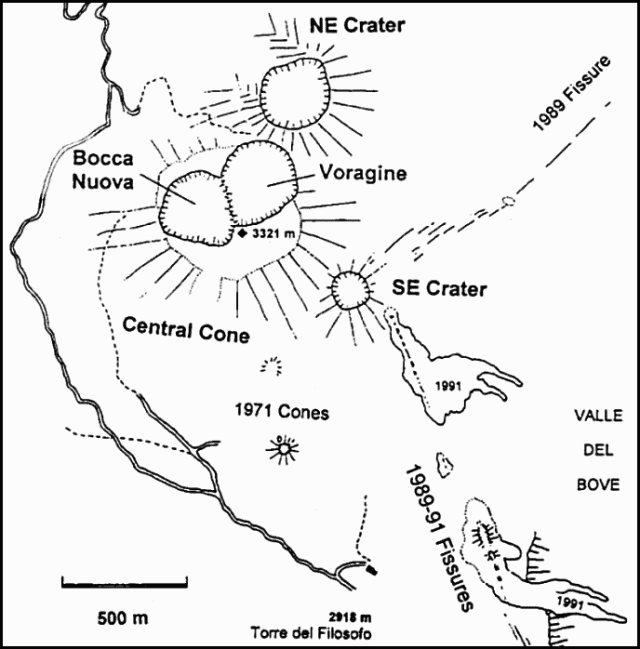 | Figure 70. Map of the summit craters of Mount Etna, 10 July 1998. Courtesy of J.C. Tanguy and G. Patanè. |
During early July all four craters were erupting simultaneously, a fact never recorded since their birth; only the Central Voragine has degree of permanence; Northeast Crater (NEC) appeared in 1911, the Bocca Nuova (BN) in 1968 and the Southeast Crater (SEC) in 1971.
Most of the information for this report was compiled by Boris Behncke at the Istituto di Geologia e Geofisica, University of Catania (IGGUC), and published on his internet web site. The compilation was based on personal visits to the summit, telescopic observations from Catania, and other sources. Additional separate reports were provided by Tanguy and Patanè (10-14 July observations) and Murray, Stevens, and Craggs (15 September observations). Aviation notices were issued by the Toulouse (France) Volcanic Ash Advisory Center.
Activity at Southeast Crater (SEC). There were at least three explosive vents on the intracrater cone during 4-5 June. Activity usually alternated between the N and S vents. When both exploded simultaneously, a third NW vent produced weak incandescent projections. Vigorous growth around the vents elevated the summit to 20 m above the SEC rim. Lava flowed towards the NE flank where it spilled down to the base of the SEC cone. During a visit on 11 June, SEC had the usual two vents active, and fresh bombs scattered over the crater floor. Recent flows had built a high mound on the E side of the cone; an active flow issued from the vent area. By the morning of 15 June the lava flow at SEC had reached its southern base and was advancing slowly.
Explosive activity on 22 June occurred from three vents on the intracrater cone, and lava issued from a vent halfway up the S flank. Explosive Strombolian activity occurred in distinct cycles separated by quiet periods of up to one hour, although lava effusion persisted. The beginning of each cycle was marked by a flame of burning gas at the summit. More vigorous bursts would then follow at a larger vent. Explosions would become increasingly frequent and rise higher (up to 150 m above the vent), showering the southern part of SEC with bombs. Activity would then shift back to the SW vent where each Strombolian burst was accompanied by a gas flame. Intermittent explosive and effusive activity continued on 24 and 28 June.
During a summit visit by Behncke and members of L'Association Volcanologique Europeenne (LAVE) of Paris on 4 July, explosive activity at SEC was intense, with bombs falling outside the crater. Activity from the top of the intracrater cone sent jets of bombs and scoria up to 150 m. Lava issued from three vents, one feeding a flow over the SW crater rim. On the evening of 7 July LAVE members reported that the active lava flow on the SW flank of SEC was ~200 m long. The summit visit on 13 July was made by Giovanni Sturiale, Sandro Privitera, and Behncke (IGGUC), and Jürg Alean. At SEC, Strombolian activity was vigorous, bombs fell frequently outside the crater, and lava emission was continuing. Recent lava had filled the SW part of the crater to within 1-2 m of the rim. In all other areas the pre-1997 rim of SEC has been buried by overflowing lava. Jürg Alean visited on 14 July and reported that SEC continued to produce Strombolian activity. From the Torre del Filosofo hut a small lava flow could be seen descending the SE flank of SEC; incandescent blocks frequently detached from the flow front.
Vigorous activity occurred at SEC during the 22 July Voragine episode, and during the days after activity was limited to SEC where vigorous lava fountaining and effusion occurred. On 24 July, Sturiale and Privitera observed vigorous Strombolian activity, with many bombs falling outside the crater. However, SEC activity declined and virtually ceased by the end of July.
As of the night of 17-18 August, there had been no resumption of the SEC eruption. The crater was seen erupting later on 18 August by Privitera. When Monaco and Behncke visited on 20 August, virtually no activity was observed. As of 26 August SEC appeared quiet, although the activity in July had built the intracrater cone to 40-50 m higher than the crater rim. Bombs were scattered all over the crater area and beyond. Two post-22 July lava flows had spilled onto the S and NE flanks. No activity occurred during a visit by Behncke and Sturiale on 9 September.
Explosive activity from SEC was observed by scientists from Open University (Murray and Stevens) and the University of London (Craggs) on the morning of 15 September. Several ash clouds erupting from the summit between 0745 and 0800 were seen from 10 km S. At 0815 bomb-laden ash clouds were observed from near the Piccolo Rifugio (4.5 km S of the summit craters). At 0822 an exceptionally large explosion sent meter-sized bombs ~300-400 m above the crater rim. One more minor explosion was observed before the summit was obscured at 0826. Observation recommenced at the Pizzi Denieri volcano observatory. The summit was usually obscured by clouds, but five explosions during 0928-0936 were audible above gale-force winds and engine noise. Ash clouds were seen from Mt. Nero on the NE rift (6 km from the summit craters) at 1003, and at 1006 an explosion was heard.
Explosions continued all afternoon, causing ashfall in inhabited areas on the E flank. During the afternoon, while conducting fieldwork 50 km S of Etna, Behncke and Sturiale saw black ash fountains piercing weather clouds above the summit. These pyroclastic jets rose several hundred meters above the summit before drifting E. Observations by Behncke on 19 September revealed that the explosions ejected lithics and fresh bombs, which were abundant in the saddle between SEC and the main summit cone. Some of the bombs were up to 5 m across and had flattened upon impact. Bombs tens of centimeters in diameter formed a continuous deposit on the NW side of the crater. Most of the intracrater cone was destroyed, and a crater ~80 m across formed in its place (figure 71).
 | Figure 71. Sketch drawing showing Southeast Crater of Etna as seen from the NW on 19 September 1998. The former intracrater cone has been replaced by an explosion crater that contains a small new cone with two erupting vents, and a small non-eruptive vent that lies below the major breach in the crater wall in the left center. Lava that had overflowed the SW crater rim until July 1998 is shown in a dark pattern at right. Courtesy of Boris Behncke. |
Vigorous activity on 17 and 18 September ejected bombs described as having been "several meters across" by a group of British geologists led by J.B. Murray working in the area. The beginning of a lava flow down the NE flank of SEC is not known, but it was reported by mountain guides to have been moving on 17-18 September. During a 19 September visit by Behncke, Strombolian bursts occurred from two vents in the explosion crater, around which a small cone had begun to grow. Lava emission from a vent high on the SEC cone was feeding a flow that advanced towards Valle del Leone.
Activity at SEC was continuing on 21 and 25 September with intense Strombolian activity; incandescent bombs jetted 150-200 m high. Continued vigorous activity during the last week of September caused rapid growth of the intracrater cone until ti was higher than ever before, having almost entirely covered the remains of its predecessor.
Activity at Bocca Nuova (BN). Eruptive activity during 4-5 June was occurring at both previously active areas. Night incandescence and bomb ejections were seen in a deep pit within the SE eruptive area. Noisy activity occurred at the NW eruptive area, at the bottom of the collapsed cone that had grown in 1997. At least five vents were producing explosions and lava fountains accompanied by bursts of burning gas. Several lava flows extended over the crater floor.
Observations were made for 30 minutes on 11 June from the crater rim. The SE vents had fountains of ash and bombs rising ~50 m. At the NW eruptive area, three vents were active, and the collapse pit was filled with pyroclastics and recent lava flows. Two large (30 and 50 m diameter) vents were in the central part of the filled pit while a smaller vent (~5 m in diameter) lay 50-70 m S; this latter one produced weak lava sputterings, building a low hornito. The two larger vents showed a repetitive eruptive behavior for the first 15 minutes of observation, then erupted simultaneously in a series of ash-free lava fountains. For about ten minutes there were bomb ejections from both major vents. Centimeter-sized scoria and Pele's hair were deposited all over the SE sector and on SEC.
Activity was less intense on 15 June; during a 1-hour stay in the summit area, strong explosions from the large cone ejected ash-rich jets of bombs up to 100 m above the crater rim. Visits to BN are dangerous due to frequent blasts of large quantities of meter-sized bombs. Most blasts observed on 22 June lasted up to 10 minutes. The source vent lay in the partially collapsed 1997 cone at the N eruptive area; it produced almost continuous minor explosions between the large detonations, ejecting large clots of fluid lava. A small vent to the south ejected minor sprays of meter-sized bombs. Continuous lava fountaining occurred from a SE vent. During the 22 June visit the central vent was the site of pulsating gas jets, and vigorous lava fountaining occurred at the larger SW vent. A large asymmetrical cone leaning against the thin wall between the Voragine and BN had grown around the vent. Vigorous activity was continuing on 24 and 28 June.
During a summit visit by Behncke and members of LAVE on 4 July, all four summit craters were active. The summit visit on 13 July by Sturiale, Privitera, Behncke, and Alean showed low levels of activity; a small cone had grown around the main vent. The N eruptive area was the site of Strombolian bursts every 5-10 minutes. A fairly large cone had grown at this vent, the first time that significant cone growth had occurred in BN since late 1997. Lava had covered the S crater floor.
A visit by J.C. Tanguy and G. Patanè during 10-14 July revealed that, with respect to the preceding year, the bottom of BN had raised considerably owing to the tephra deposition, so that the strongest explosions from the NW vent (figure 72) sometimes showered the external slope with bombs. By 12 July the explosions were reduced in strength and frequency. Jürg Alean visited on 14 July and reported that the N cone produced fountains heavily charged with bombs; many fell on the crater rims and in the Voragine.
 | Figure 72. Sketch of the Bocca Nuova and Voragine craters at Etna, 10 July 1998. Courtesy of J.C. Tanguy and G. Patanè. |
Vigorous activity occurred at BN during the 22 July Voragine episode. On the afternoon of the 23rd, Carmelo Monaco (IGGUC) saw bright incandescence in BN even in bright daylight from an airplane approaching Catania. Activity was noted on 25 July and increased the following day according to Claude Grandpey (LAVE); activity at the NW area occurred from a small vent while the SE area had three vents emitting gas and bombs. In late July and early August, numerous vents erupted explosively at the NW area; subsidence of the central crater floor by a few meters occurred on 1 August. The SE vents displayed spectacular lava cascades from one vent into the other, the lower vent filling until an explosion cleared it. Kloster (LAVE) reported a lava lake in this area on 7 and 10 August, but during the following days there was only Strombolian activity.
On 20 August Monaco and Behncke observed moderate eruptions at the N vent area. Besides the summit vent, there were at least four smaller flank vents which had erupted recently. On 26 August frequent ash emissions were occurring. Growth of a small cone above the diaframma (septum between the craters) culminated in the fracturing of this cone and a cascade of lava into BN in late August.
A visit to the summit by Behncke and Sturiale on 9 September revealed that one vent at the summit of the NW cone was the site of Strombolian bursts alternating with bomb and ash emissions. Four smaller vents on the flanks on the cone were weakly degassing. Weak Strombolian activity occurred from two SE vents where a small cone was growing in a collapse depression. Behncke saw activity at similar levels on 19 September. As of 25 September there was low-level activity.
Activity at Voragine. On 3 June, near-continuous cannon-shot like detonations were heard kilometers away, and Marco Fulle (Osservatorio Astronomico, Trieste) observed magma bubbles within the vent burst at the onset of fire-fountaining episodes. When observed during 4-5 June, the vent in the SW crater floor had enlarged notably since 6 April and shifted away from the diaframma, and a low pyroclastic cone had grown around it. On the evening of 4 June, activity at the Voragine was observed for about 4 hours. A sustained fountain jetted from the vent, showering the SW part of the crater floor with bombs; many also fell into BN. This fountain lasted about 75 minutes, followed by pyroclastic material sliding from the inner walls of the vent into its throat. After a few minutes, a small vent opened below the inner SE rim of the vent and emitted jets of incandescent lava. Ejections soon resumed at the main vent, and a flame of burning gas persisted at the subsidiary vent accompanied by weak pyroclastic sprays. A new period of fountaining at the main vent resulted in the continuous fall of bombs into BN. The subsidiary vent was soon buried. At times, portions of the inner walls collapsed, causing ash-rich fountains.
The Voragine was not visited on 11 June, but very strong explosive activity was heard more than 10 km S, and high fountains contained meter-sized bombs. On 15 June the focus of activity had shifted to the central vent, previously active between July and December 1997. This vent ejected continuous lava fountains while a lava flow covered the E half of the crater floor. Fountains played up to 200 m above the vent, with all bombs falling back into the crater. At times, the magma level dropped, and the character of the activity changed to discrete explosions. The SW vent exhibited noisy gas emissions alternating with ash emission and lava fountaining. Vigorous activity was continuing on the evening of 24 June. During a summit visit on 28 June, Monaco observed fountaining from the central vent; the SW vent was less active and mostly ejected ash.
A scoria deposit extending SE, produced by a Voragine lava fountaining episode on 1 July, was examined by Behncke and members of LAVE on 4 July. Both vents in the Voragine were in vigorous, alternating activity. Eruptive cycles at the SW vent produced jets of fragmented pyroclastics. As activity waned at this vent, projections of large bombs would initiate at the central vent, increasing in frequency and height into a pulsating fountain at least 100 m above the crater floor.
Stefano Branca (IGGUC) reported that frequent explosions were audible throughout 6 July at Viagrande, a village at the SE flank of Etna; air concussions associated with the explosions shook windows and rattled doors. The explosions probably originated at the Voragine, the site of recent noisy activity. On 7 July explosions were still audible but less intense. Members of LAVE observed activity that evening from the SW vent that dropped bombs as far as the S rim of NEC.
A visit by J.C. Tanguy and G. Patanè during 10-14 July revealed activity at the large SW cone (figure 72) near the diaframma and from a central cone. By 12 July the two vents hurled large lava lumps and bombs in a fountain-like manner, some of which fell outside the crater. On 13 July this activity was stronger. That afternoon activity decreased, but two flows began from a fissure NE of the central cone. Lava rapidly invaded the northern, lowest part of the Voragine. During the peak effusive activity the two lava flows reached a speed estimated at 3-4 m/s. On the morning of 14 July, only the SW vent showed Strombolian explosions. Lava flows had entirely disappeared under a layer of tephra erupted during the night.
During a visit on 13 July by Sturiale, Privitera, Behncke, and Alean, the most vigorous activity occurred at the Voragine. On 12 July, lava fountains roared up to 200 m above the crater rim for three hours from the SW vent. Powerful jets of bombs mixed with ash were also ejected. The cone around the SW vent was higher in places than the diaframma; the vent was 30-50 m across. Activity varied from isolated powerful explosions to long-lasting lava fountains. At times dense ash plumes with large bombs rose from the vent. Explosions from the central cone blasted lava in all directions. Small lava fountains and ash emissions occurred from two fissures. On at least 20 occasions during 90 minutes of observation the magma surface in the vent domed up, forming a huge bubble that exploded. Explosions later ejected meter-sized bombs to 200 m or higher; many fell into BN, outside the Voragine, or on the E slope of the main summit cone not far from SEC. Jürg Alean visited on 14 July and reported that both vents showed intense activity. The SW vent was filled almost to the rim by lava which was fountaining vigorously. The central vent displayed a similar eruptive behavior as on the previous visit, but no lava bubbles were observed. On 20 July lava fountaining from the Voragine was common.
A major eruptive event began from the Voragine at about 1835 on 22 July. The following is based on preliminary information from scientists of the IGGUC (mainly Giovanni Sturiale and Sandro Privitera) and others who visited after the event as late as 20 August. According to eyewitnesses on the SW side of the main summit cone, huge lava fountains rose from the Voragine, and heavy tephra falls began in the summit area. A large mushroom-shaped tephra column rose up to 10 km above the summit. The plume was then driven S and SE, and widespread ashfalls occurred more than 30 km away. Sand-sized tephra fell in Catania, leaving a deposit about 1 mm thick. For the first time since 24 September 1986 (when NEC had a powerful explosive eruption) the Fontanarossa airport of Catania had to be closed (it was reopened after 15 hours). The Toulouse (France) Volcanic Ash Advisory Center issued 17 aviation notices warning pilots about the ash during 22-29 July. The tephra falls caused traffic problems on roads and highways. Close to the summit, a thick scoria deposit buried the dirt roads leading to the Rifugio Torre del Filosofo and around the western base of the main summit cone. Sturiale and Privitera reported that at Torre del Filosofo the thickness of the scoria deposit was about 50 cm.
It appears that both vent areas produced lava fountains and a tall tephra column. Rapid accumulation of ejecta in the saddle on the NW rim led to a lava flow between the NEC and the main summit cone (figure 73). The flow covered the road connecting the N and S flanks of Etna, and eroded a deep scar into the the S flank of the NEC cone. Continuing pyroclastic activity produced a thick scoria and bomb deposit, with bombs up to 5 m in length. A scoria fan extended 1-1.5 km NW. In the area of the diaframma a lava flow covered the crater floor to several meters depth. On the E flank of the main summit cone a thick pyroclastic deposit formed. In towns on the E and SE flank, the tephra deposit was a few millimeters to a few centimeters thick. Morphological changes within the Voragine consisted mainly of a large amount of filling of the crater followed by subsidence. Parts of the SW crater rim also collapsed.
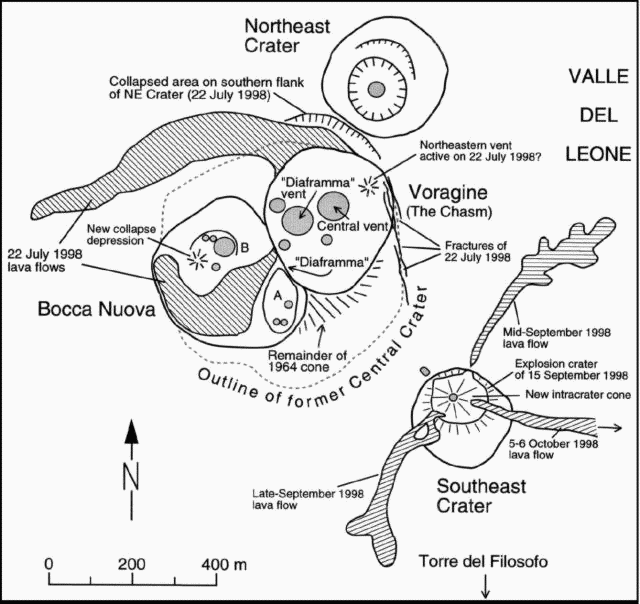 | Figure 73. Sketch map of Etna's summit craters showing features frequently mentioned in the updates, and approximate extent of recent lava flows as of 5 October 1998. Active vents are indicated as gray dots in the craters. Courtesy of Boris Behncke. |
Vigorous activity occurred simultaneously at BN and SEC on 22 July Voragine event, indicating that the episode affected much of the central conduit system at some depth, possibly due to the rise of a batch of fresh gas-rich magma. Lava fountaining from the Voragine continued intensely through the night of 22-23 July.
According to Grandpey (LAVE), the Voragine appeared "full of materials" on 25 July with no trace of the former intracrater cones. No further activity occurred until 3 August when Kloster (LAVE) saw explosions ejecting bombs. Two days later, three vents erupted in the center of the Voragine. On 7 August small flows on the crater floor were followed by explosive activity. Powerful Strombolian activity with bomb ejections and ash emission caused light ashfall on the SE flank on 18 August, reaching the outskirts of Catania.
On 19 August explosive ash emissions sent small plumes up to several hundred meters above the summit. When Monaco and Behncke visited on 20 August, vigorous activity occurred from two vents. Very light ashfalls on 21 and 24 August reached Catania; ash emissions were also produced on 26 August. A number of reports indicated continued activity through the end of August.
On 6 September bombs fell on the outer W slope of the Voragine and on 7 September ash emission occurred throughout the day. A visit to the summit by Behncke and Sturiale on 9 September revealed continuous moderately strong Strombolian activity from a SW vent; sporadic explosive activity from the vent next to the diaframma sent bombs over the crater rim. At least three other vents were quietly degassing. Similar activity was continuing as of 19 September. On 30 September strong ash and gas emissions rose hundreds of meters.
Activity at Northeast Crater (NEC). Deep-seated Strombolian activity within the central pit resumed in mid-May according to Vittorio Scribano (Istituto di Scienze della Terra, Catania University). Night glow was observed on the evening of 22 June from 3 km NE. During a summit visit by Behncke and members of LAVE on 4 July, all four craters were active; for the first time since 28 March eruptive activity was observed directly at NEC. The eruption site was a 30-m-diameter vent in the NW part of the central pit while a SW vent (~15-20 m in diameter) emitted dense vapor plumes. Small Strombolian bursts from the larger vent occurred every 2-5 minutes, with most ejecta falling back into the pit.
A visit on 13 July by Sturiale, Privitera, Behncke, and Alean revealed mild Strombolian activity from the central pit that ejected bombs. When Monaco and Behncke visited on 20 August, NEC was degassing quietly. Strong fumarolic activity was occurring on 26 August and 9 September.
Information Contacts: Boris Behncke, Istituto di Geologia e Geofisica, Palazzo delle Scienze, Università di Catania, Corso Italia 55, 95129 Catania, Italy; J.C. Tanguy and G. Patanè, University of Catania, Istituto di Geologia e Geofisica, 55 Corso Italia, 95129 Catania, Italy; John Murray and Nicki Stevens, Department of Earth Sciences, Open University, Milton Keynes, United Kingdom; Emma Craggs, Geology Dept, Royal Holloway College, University of London, United Kingdom; Volcanic Ash Advisory Center (VAAC) Toulouse, Météo-France, 42 Avenue Gaspard Coriolis, F-31057 Toulouse cedex, France (URL: http://www.meteo.fr/vaac/)
December 1998 (BGVN 23:12)  Cite this Report
Cite this Report
Episodic eruptions from Southeast Crater during October-December
The following report summarizes activity observed at each of the four summit craters of Etna from October through December 1998. Bocca Nuova and Voragine exhibited some explosive activity during this period, but Northeast Crater was quiet. Southeast Crater had 15 distinct eruptive episodes. Most of the information for this report was compiled by Boris Behncke at the Istituto di Geologia e Geofisica, University of Catania (IGGUC), and posted on his internet website. The compilation was based on personal visits to the summit, telescopic observations from Catania, and other sources.
Activity at Southeast Crater (SEC). Poor visibility precluded observations after 30 September, when intense activity was rapidly building the intracrater cone and a new lava flow was spilling down the SW flank of the SEC cone (figure 74). On the evening of 1 October, no incandescence was visible at the crater, and brief glimpses of the summit during the following days revealed that no further growth of the intracrater cone had occurred. A group encamped ~800 m S of SEC reported that on 4 October there were no eruptions, but that activity renewed during the night.
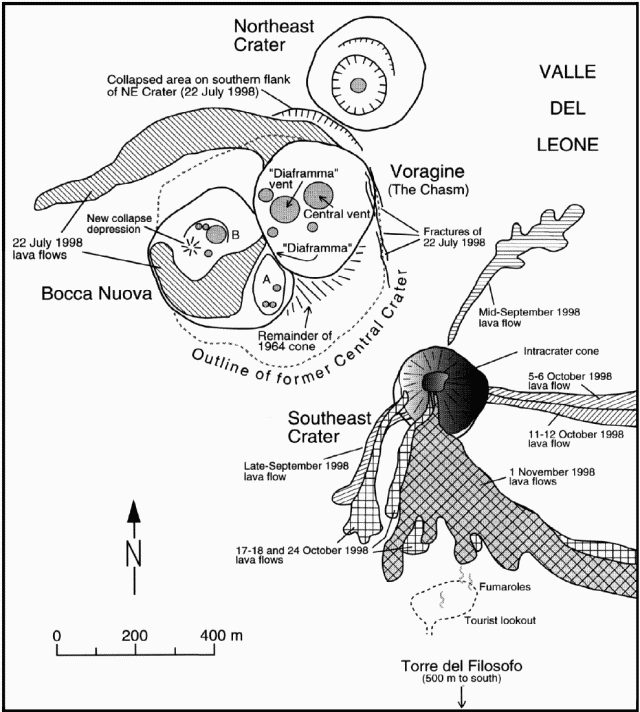 | Figure 74. Sketch map of Etna's summit craters showing recent eruption products as of 1 November 1998. The approximate extent of recent lava flows from Southeast Crater has been added. This map is not completely accurate regarding the distribution of the new flows, but locates some frequently mentioned features. Courtesy of Boris Behncke. |
The summit was visited on 5 October by a group including Boris Behncke and Giovanni Sturiale (IGGUC), Marco Fulle (Trieste Astronomical Observatory), and Jürg Alean (Stromboli On-line). Strombolian bursts hurled incandescent bombs up to 200 m above the vent. A small conelet a few meters high that had grown around this vent was destroyed by explosions around 1300, and the active vent widened to 8-10 m diameter, with a low pyroclastic mound around it. Meter-sized lava blobs jetted continuously from the vent, and bombs showered SEC and its N flank. Many explosions were caused by the bursting of magma bubbles. Although the intracrater cone had grown significantly, it did not entirely fill the 15 September explosion crater. Alean stayed on the summit until the late evening of 5 October and returned the next afternoon. Strombolian activity culminated in a paroxysmal eruptive episode (the sixth since the crater resumed its activity on 15 September) on the evening of 5 October when fluid lava moved ~1 km down its E flank within a few hours. Strombolian activity at the intracrater cone was weaker, but increased slightly during the evening.
Vigorous eruptive activity resumed on the evening of 11 October at SEC, which had shown only low levels of activity during the preceding days. The renewed activity (the eighth eruptive episode) consisted of lava fountains and a lava flow that extended ~700 m downslope adjacent to the 5 October flow. Strombolian activity at the intracrater cone continued the next morning. Fulle reported "zero activity" at SEC on 13 October.
The episode of lava fountaining and lava emission during the night of 11-12 October was the seventh at SEC since the reawakening of the crater on 15 September. The activity had established a repetitive pattern of periods of relative calm or very low-level activity that lasted up to several days, followed by episodes of very intense Strombolian activity that culminated in lava fountains and short-lived, rapid effusion of lava flows for 1-2 days. The same crater displayed a series of episodes in September 1989 that marked the uprise of a voluminous batch of fresh, gas-rich magma, and culminated in a flank eruption in Valle del Leone. That eruption was accompanied by the formation of a non-eruptive fracture system down the SW flank to about 1,600 m elevation, close to one of the most densely populated areas on Etna. The new eruptive episodes at SEC, however, were of much smaller magnitude and occurred at greater intervals, and there was no geophysical evidence that magma was intruding at shallow levels into the fracture systems that radiate from the central conduit system.
Strombolian activity at SEC resumed on the evening of 16 October, after three days of no eruptive activity. According to Fulle, who witnessed the resumption of activity, there were first some high-pressure gas emissions during the late afternoon, without the ejection of pyroclastics. Strombolian activity had initiated sometime before 1900. Remote observation with binoculars from 5 km N of Catania by Sturiale during the night of 17-18 October revealed that the intracrater cone fractured on its southern side and issued lava. While Strombolian activity from the summit vent of the intracrater cone culminated in about nine hours of paroxysmal activity with lava fountains several hundred meters high, the new lava flow advanced in up to five lobes a few hundred meters downslope, slowing at the base of the SEC cone. Further flows spilled down the E and W sides of the cone. According to Sturiale, the most intense activity occurred around 0300; the episode ended at around 0630. The intracrater cone had merged with the N outer flank of the pre-1997 SEC cone; the summit of the cone was conservatively estimated to stand at 3,220 m, 30-40 m higher than the highest pre-1997 rim of SEC.
On 24 October SEC produced its ninth eruptive episode since 15 September. Activity began to intensify at around 1700 and was at its climax between 1900 and 2100 when Strombolian bursts jetted hundreds of meters above the cone. At times several vents appeared to be active. The main lava flow advanced to the base of the intracrater cone where it bifurcated into at least five lobes that spilled down the S flank. As of 2100, these active lobes had reached the base of the cone, and movement appeared to be slowing. Another lava flow spilled down the SW side of the SEC cone. Like the previous episode, the 24 October eruption was preceded by about 24 hours of weak Strombolian activity on the evening of 23 October. The paroxysmal event itself lasted only a few hours but was very intense, with about 2 hours of near-continuous lava fountaining. The lava flows on the S flank came close to the tourist lookout ~500 m N of the Torre del Filosofo hut, and then turned SE towards Valle del Bove, reaching ~1 km in maximum length. The SW lava flow did not extend beyond the base of the SEC cone. By 2300 all activity was over, but a brief revival of Strombolian activity occurred at around 0200 the next morning.
The tenth eruptive episode from SEC in seven weeks took place on the early morning of 1 November. In a characteristic pattern established during the recent episodes, the 1 November event was preceded on 31 October by the resumption of very mild Strombolian activity, and an increase in seismicity. While no effusive or explosive activity was evident until shortly after midnight (observation by Sturiale), lava began to spill down the S flank of the SEC cone before 0030. Low fountains began to play in the summit vent by 0130, and continued through at least 0430. The culminating phase began at around 0500 and lasted two or three hours; during this phase lava fountains continuously jetted hundreds of meters above the erupting vent, and numerous lava lobes spilled down the S flank of the SEC. Two lobes stopped about 100-150 m short of the tourist outlook, but other lobes turned SE at the base of the cone and reached ~600 m from the crater. Loud explosion noises were audible in towns on the lower flanks of Etna. It appears that initially the magma rose within the conduit and overflowed quietly without being accompanied by vigorous degassing, and this relatively quiet phase lasted a few hours. The 24 October episode was also reported to have initiated with the quiet overflow of lava prior to vigorous fountaining.
Behncke and Carmelo Monaco (IGGUC) visited the summit craters starting on 1300 on 1 November, roughly six hours after the end of that morning's eruptive episode and cessation of all lava outflow. Mild Strombolian activity continued through 1700, but there was no active or incandescent lava and Behncke was able to approach the spillover point on the S side of the intracrater cone, walking on still-hot but stagnant lava emplaced that morning. The spill-over area was a narrow channel, ~10 m deep, whose upper sides were plastered with large spatter; this channel extended to the base of the intracrater cone where it divided into two major channels that fed the lava flows on the outer S flank of the SEC cone. About 20-25 m farther W a similar spillover channel partly filled with 1 November ejecta was probably active during the 24 October episode.
The most striking effect of the five eruptive episodes since 5 October was the growth of the intracrater cone, which had become an imposing structure occupying almost all of the former SEC depression. A crater ~25-30 m wide occupied the summit of the intracrater cone.
Weak and infrequent Strombolian activity began again on the evening of 6 November; the next morning, SEC produced eruptive episode 11. Strombolian activity gradually increased through the night of 7 November and early morning, and the culminating phase of the episode began around 0830 on 8 November. By 1100, vigorous fountaining from the summit was accompanied by lava outflow onto the S flank. Shortly after 1330 the main phase of the episode was over, and no active lava was visible.
As of 16 November there had been no significant activity since 7 November, as revealed by seismic data (information from G. Patanè of the Osservatorio Sismologico di Acireale and IGGUC) and the lack of morphological changes to the summit cone. Sandro Privitera (IGGUC) reached the Torre del Filosofo hut on 15 November and witnessed a single ash emission from the cone before clouds hampered observations.
After 11 days of silence SEC produced its 12th eruptive episode in nine weeks on 18 November. After several days of weak seismicity, earthquakes began to increase in frequency during the late afternoon of 17 November (information from Patanè), and weak Strombolian activity began sometime around 2000 (information from J.C. Tanguy). This activity continued throughout the night, gradually increasing in vigor. The most intense activity occurred around 1030-1130 with high lava fountains, frequent ash emissions, and lava overflow onto the S flank. By 1230, most pyroclastic activity had ceased, and lava movement apparently stopped, although vigorous steaming from the new lava continued, and intense seismicity persisted for some time.
The 13th episode occurred on 29 November, again after a quiet interval of 11 days. Due to bad weather conditions, the activity could not be observed, but loud detonations were audible 25-30 km from the summit. The effects of this episode were studied during a visit on 3 December by Behncke. Lava had spilled through the breach in the S crater rim and reached the base of the cone. The summit of the newly formed cone at SEC was climbed to observe the vent that had produced all the recent activity; there was no eruptive activity, and only weak gas emissions occurred. The summit crater was ~50-80 m wide, its rim being highest on the SE side. The crater floor was relatively flat and had a central pit ~15 m wide in its center. From the crater rim it was possible to see that the summit of SEC was only about 20 m lower than the rim of the former summit crater (elevation 3,260 m), and thus SEC has grown at least 60-80 m since mid-1997.
It was SEC more than 14 days later that SEC began its fourteenth eruptive episode in three months, on 13-14 December. As usual, Strombolian activity began some 24 hours or so earlier. Carmelo Monaco (IGGCT) heard explosion sounds at Montagnola from the direction of SEC, but clouds prevented observations. However, at about 1930 the summit became visible from Catania, when Strombolian bursts occurred every few seconds. Between 2000 and 2030 a growing incandescent spot became visible below the fountain. During the next two hours, lava spilled down the S flank, and pyroclastic ejections became gradually stronger. The culminating phase began at about 0430, marked by strong seismic activity (information from Patanè). Tephra was carried S, leaving a dark streak on the snow. On 14 December, when viewed from Catania, the cone of SEC was covered with new pyroclastics and appeared to have grown; activity had returned to low levels.
The fifteenth eruptive episode from SEC occurred on 29 December, after the longest quiet interval between two episodes observed so far, and was essentially similar to the preceding episodes, with vigorous lava fountaining, tephra emission, and small lava flows.
Activity at Bocca Nuova (BN), Voragine, and Northeast Crater (NEC). The summit craters were visited on 5 October by Behncke, Sturiale, Fulle, and Alean. NEC was limited to forceful gas emission from a 30-m-wide vent on the floor of its about 80-m-deep central pit. Activity in the Voragine occurred in one vent in its SW part, which was ~100 m wide, tens of meters deep, and ejected bombs in near-continuous bursts; four other vents in the Voragine were degassing quietly. Within BN, both the NW and SE vent areas produced Strombolian activity. At the former, two vents in the W part of the cone were the sites of continuous minor bomb ejections culminating in fountains ~100 m high every 5-15 minutes. Only very few bombs fell outside the crater, but abundant fresh-looking bombs indicated that stronger activity had occurred within the preceding two days. Extensive fracturing of the lava flow that had entered the Bocca Nuova on 22 July indicated that minor subsidence had also affected a wider area. At the SE vents continuous Strombolian activity occurred from two vents in the collapse depression formed in early 1998.
Alean reported that activity in the Voragine and the SE vents in BN was stronger on 6 October. Fulle indicated that low-level activity persisted through 10 October and that during his observations on 12 and 13 October there was ongoing eruptive activity in BN and the Voragine. Eruptions from the SW vent in the Voragine ejected bombs into BN. An increase in the vigor of the ejections of the NW vent in BN was noted by Fulle on 15-16 October; explosions from that site ejected large (up to 1.5 m) black bombs onto the NW and N crater rims. On the morning of 25 October there was a dense gas plume issuing from BN.
Behncke and Monaco observed activity at BN and the Voragine on 1 November. In the former, the NW cone did not produce visible eruptions although explosion sounds could occasionally be heard. In the SE eruptive area three vents were the site of Strombolian activity. For the first time since the 22 July eruption it was possible to enter the Voragine, which was much shallower than before that event. Only the large SW vent was erupting, but that activity was very deep-seated, and only on one occasion did bombs rise above the lip of the vent. Very little degassing occurred from the large central vent, and the general impression was that the Voragine was quieter than at any time during the past six months. A weak gas plume was seen rising from the NEC central pit. There was continued weak activity in BN and Voragine through at least 10 November.
Information Contacts: Boris Behncke, Istituto di Geologia e Geofisica, Palazzo delle Scienze, Universitá di Catania, Corso Italia 55, 95129 Catania, Italy.
February 1999 (BGVN 24:02)  Cite this Report
Cite this Report
Extensive lava flows discharging from a 4 February fissure on the SE flank
The following report summarizes activity observed at Etna from January through February 1999. Bocca Nuova exhibited minor explosive activity through early February, but Northeast Crater and Voragine were quiet. Southeast Crater had seven distinct eruptive episodes between 5 January and 4 February; the latest was accompanied by the opening of a new eruptive fissure at its southeastern base. The information for this report was compiled by Boris Behncke at the Istituto di Geologia e Geofisica, University of Catania (IGGUC), and posted on his internet web site. The compilation was based on personal summit visits, observations from Catania, and other sources cited in the text.
Activity at Southeast Crater (SEC) until 23 January. After one week of relative quiet, the sixteenth eruptive episode of SEC since 15 September occurred shortly before noon on 5 January; this was preceded by weak Strombolian activity that started around midnight. The paroxysmal phase was characterized by vigorous fountaining, and lava flowed towards the northeast while tephra was driven southwest by the strong wind. Loud detonations were audible in towns on the flanks of Etna.
Episode 17, during the night of 9-10 January, was preceded by mild Strombolian activity; the paroxysmal phase occurred shortly after midnight. Lava presumably flowed NE again and tephra fell NE; Fiumefreddo, ~8 km SW of Taormina, received a light showering of ash. Loud detonations during the final phase were audible over a wide area, and clear weather conditions permitted many in the Catania area to watch the spectacular display.
After the shortest repose interval observed since early in the current eruptive sequence in September, episode 18 took place on the morning of 13 January, between about 0630 and 0930. Visibiliby was hampered by clouds, but loud detonations were audible in a wide area around the volcano. Ash fell as far as Giarre, ~15 km E.
The next eruptive episode occurred on 18 January, shortly after 0800, and lasted ~ 45 minutes. Minor Strombolian and effusive activity had occurred earlier during the night. As in preceding episodes, the culminating phase was characterized by initial strong lava fountaining which gradually became more ash-rich, generating a dense eruption column. Due to calm conditions, the column rose several kilometers above the summit (3 km as estimated from Catania) and attained a spectacular mushroom shape visible in the morning sky from all around the volcano. At the SEC cone itself, the heavy fallout and rapid accumulation of pyroclastics led to frequent avalanches, especially on the steep eastern side. After 0830, dull explosion sounds were audible to as far as Catania, accompanying the rhythmic uprush of dark ash. The activity declined rapidly at 0845, but ash emissions became again more forceful after 0900 and continued sporadically for several hours, accompanied by sliding of hot pyroclastics from the steep E side of the cone. No information was available about lava flows although it is likely that they occurred, possibly on the NE side of SEC.
SEC erupted again after only two days and four hours of inactivity, shortly after noon on 20 January. Increased gas emission began at ~ 1215, and by 1240 a lava fountain appeared at the vent of the SE Crater cone. This fountain rapidly rose to a height of several hundred meters, and the column which rose above it became more and more ash-rich. Less than 15 minutes after the onset of the eruption there occurred the first slides of hot pyroclastics from the upper part of the cone, and five minutes later the whole cone and part of Etna's main summit cone were veiled by a black curtain of falling bombs and scoriae. By 1300, the vertical eruption column had risen several kilometers above Etna's summit. Ten minutes later the activity began to decline rapidly, and by 1315 the eruptive episode was essentially over, with only a few ash puffs being emitted during the following 30 minutes.
During a summit visit by Boris Behncke and Giovanni Sturiale (IGGUC) on 21 January, the crater was completely quiet, and only a few weak fumaroles played on the SW and E crater rims. The cone at SEC had grown higher than 3,250 m, about as high as the rim of the former Central Crater (filled by lavas and pyroclastics in the 1950's and 60's). While its flanks were steep and regular on most sides, obliterating any trace of the pre-1998 crater rim, a deep V-shaped notch was present in the northern crater rim through which lava had spilled onto the cone's flanks during recent eruptive episodes. These lavas had formed a fan-shaped lava field on the northeastern base of the cone, extending to the rim of Valle del Bove.
Behncke and Sturiale also investigated the pyroclastic deposits of the recent eruptive episodes which extended in relatively narrow fans from SEC in various directions. During the 18 and 20 January epidsodes, most fallout had occurred in a radius of <1 km from the cone, mainly on the SE side of the former Central Crater where 0.5-1 m of pyroclastics had accumulated since late 1998. Meter-sized bombs had fallen up to 500 m from SEC, creating spectacular impact craters. Among the most peculiar features of the recent eruptive products was a small lahar on the southwestern side of SEC which extended ~300 m from the base of its cone; this was probably produced during the 5 January episode. Records of lahars are relatively rare in the recent history of Etna, the most notable occurring in 1755.
On the morning of 23 January, SEC was the site of yet another eruptive episode that began at about 0630 and probably lasted less than one hour. Due to the absence of wind, an eruption column rose several kilometers above the summit then drifted slowly SE. In Catania, the ashfall was not dense, but people in the streets felt particles entering in the eyes; these particles were less than 1 mm in diameter and left a thin, discontinuous film on the ground. More serious effects were caused by the fallout in the upper southern parts of the mountain where skiing was rendered impossible by scoria on the snow. The repose period between this and the previous eruptive episode was two days and 18 hours.
There appears to have been no significant seismic or eruptive activity between 23 January and 4 February; the few clear views during that period revealed no morphological changes.
The January eruptive episodes continued to build the SEC cone, which has changed beyond recognition from its mid-1998 appearance. The large crater formed in 1990 at the summit of the SEC cone was completely filled, and a new, tall summit grew over it, burying any trace of the 1990 crater and much of the lava flows erupted from mid-1997 to late July 1998. After the 23 January episode the cone's new summit was at ~ 3,270 m elevation, almost 90 m higher than the highest point of the 1990 crater rim in 1997.
New eruptive fissure opens on 4 February. A new eruptive episode from SEC began at 1600, producing a spectacular eruption column visible from Catania and all around the mountain. Like previous episodes, this event was characterized by vigorous fire-fountaining, tephra emission, and lava, and was preceded by a gradual increase in gas emissions and then mild Strombolian activity. The activity began to culminate at around 1600 when a tall fountain jetted from the summit crater of the cone, and lava spilled through the breach in the N crater rim.
Sometime around 1630, the SE side of the cone fractured, and a new vent opened about halfway down the cone's flank, producing a tall lava fountain 250-350 m high and feeding a dense, ash-laden eruption column. An eruption column rose ~ 2-3 km above the summit before being driven SE, dropping fine ash on the flanks. Lava soon began to flow SE from this vent (figure 75). At about 1640, a row of incandescent spots appeared below the newly formed vent, indicating that a fissure had begun to propagate downslope from the base of the SEC cone. Vigorous lava fountaining and tephra emission from the new vent on the SE flank of SEC diminished rapidly shortly after 1700, but activity continued at the smaller vents on the fissure below that vent, at ~ 2,950 m elevation, and lava advanced rapidly towards the rim of Valle del Bove. At nightfall, both this lava flow and the lava erupted at the beginning of the episode onto the northern side of SEC were brightly incandescent and well visible from towns on the eastern side of the volcano, causing rumors of the opening of fractures on both sides of the cone. However, the northern flow soon stagnated and cooled, and no further lava emission occurred on that side for the remainder of February.
 | Figure 75. Sketch map showing Etna's summit craters SEC, Voragine (V), and Bocca Nuova (BN). The approximate extent of lava flows emitted during the 4 February eruption are in medium gray and those following the 4 February eruption are in black. Flows erupted from 1971 to 1993 are shown in light gray. Courtesy of Boris Behncke. |
On 5 February, lava had begun to spill into Valle del Bove, forming a cascade on its steep western wall. The flow advanced very slowly, and had not yet reached the valley floor (at ~2,000 m elevation) on the next day when the new eruptive fissure was visited by Behncke and Giuseppe Scarpinati (L'Association Volcanologique Européenne, LAVE). Mild explosive activity was building several hornitos in the upper part of the ~100-m-long, SE-trending fissure at the base of the SEC cone while lava was issuing from numerous vents along the whole length of the fissure, feeding several channellized flows and some minor a`a flows. The effusion rate was estimated at 5 m3/s or more, significantly higher than during previous mainly effusive eruptions near Etna's summit craters (mainly at NE Crater in the 1970's) and similar to the effusion rates of some of Etna's flank eruptions. Pahoehoe lava was abundant around the effusive vents. The cone of SEC was found to be fractured from its summit down to its base, but only the main 4 February vent appeared to have produced significant eruptive activity while only minor spatter and scoriae were found in the part of the fracture between that vent and the still-active fissure.
On 15 February, Behncke and Scarpinati again visited the eruptive fissure and observed its activity for about 4 hours. By that day the lava spilling into the Valle del Bove had reached ~ 2,000 m elevation. There was no sign that the activity was diminishing, and the effusion rate remained perhaps as high as 5 m3/s.
Lava continued to issue from a number of effusive vents on the active fissure, forming at least two main rivers and several smaller and short-lived flows. In the course of a few hours Behncke and Scarpinati saw some of the lesser flows cease and others reactivate, forming blocky a`a while the more vigorous and long-lived flows moved in well-defined channels and showed no significant flux variations. Numerous short lava tubes, well-developed flow channels, and secondary vents had formed. Most effusive activity occurred ~50-100 m downslope from the upper end of the fissure, but several vents were also higher upslope. In the uppermost part of the fissure, numerous hornitos had formed, most of them concentrated in three clusters, and this area had countless incandescent vents producing high-pressure gas emission accompanied by a persistent hissing noise. The largest hornitos formed thin, vertical spires up to 3 m high while others were small humps a few tens of centimeters high. There was little explosive activity; only one vent in the uppermost hornito cluster rarely ejected incandescent pyroclastics.
Similar activity continued through the end of February. Lava flowed into the Valle del Bove, forming numerous lobes that moved on top or adjacent to earlier flows, and the farthest flow fronts did not extend much beyond 2,000 m elevation, remaining above the Monti Centenari, a cluster of cones formed during the 1852-53 eruption on the floor of Valle del Bove. The flow field gradually widened to ~500 m on the rim, and flows were issuing from numerous ephemeral vents on the W slope of the Valle.
Activity at Bocca Nuova (BN), Voragine, and Northeast Crater (NEC). Little significant activity occurred at these craters during January-February 1999 except for a brief resurgence of activity at BN during the week preceding the 4 February SEC events. During the 21 January visit by Behncke and Sturiale, spattering and Strombolian activity occurred deep within the large crater in the southeastern part of BN, accompanied by dense gas emission.
The cone in the northwestern part of BN produced violent noisy explosions every few minutes which ejected fountains of bombs high above the crater rim; ejecta frequently fell outside the crater, mostly to the W but in a few cases also SW and S. Between the explosions, deep-seated minor activity occurred within the 50-80-m-wide crater of the cone. No effusive activity had taken place in BN since it was invaded by lava from Voragine on 22 July 1998.
Bright crater glow was visible above BN in the first nights of February, the first time in about five months. This glow persisted during the night of 3-4 February but was much weaker on the evening of 4 February, indicating a drop of the magma level, probably related to the opening of the eruptive fissure on the SE base of SEC earlier that day. During the following week, only infrequent weak glows were visible above BN and then vanished altogether.
Very little activity except profuse steaming was observed within the Voragine during the 21 January visit by Behncke and Sturiale, who were able to descend into this crater and arrived at the "diaframma," the septum that separates the Voragine from Bocca Nuova. The floor of the crater was very flat in its eastern part, while a cluster of four craters with low cones occupied its central-western portion. The central crater, ~50 m wide and 30 m deep, was completely quiet; on its W side a much shallower, ~20-m-wide crater contained a 2-m-wide degassing hole with overhanging walls on whose floor numerous incandescent spots could be seen. A small crater with a diameter of less than 20 m, and ~ 10 m deep, lay on the SE side of the central crater. The largest crater in the Voragine was in the SW part of the Voragine and was between 70 and 100 m wide and more than 50 m deep with very steep and unstable walls, so that its floor could not be seen. Eruptive activity occurred at depth; as could be judged from the noises this was similar to the activity observed in the southeastern BN vents on the same day. A fifth vent that was active in August and early September 1998 on the crest of the "diaframma" appeared to have collapsed into the large SW vent, and only a part of its cone remained standing.
Information Contacts: Boris Behncke, Istituto di Geologia e Geofisica (IGGUC), Palazzo delle Scienze, Università di Catania, Corso Italia 55, 95129 Catania, Italy.
March 1999 (BGVN 24:03)  Cite this Report
Cite this Report
Additional details of mid-October 1998 activity at Southeast Crater
This report provides additional details of activity during 10-15 October 1998, along with a map of the lava flows emplaced at that time. These events were the seventh episode in a cycle of activity beginning on 15 September 1998. The cycle was characterized by periods of low or no activity interrupted by intense Strombolian fountains and lava flows at Southeast Crater (SEC) (BGVN 23:12). Observations of SEC between 1900 and 1920 on 10 October revealed Strombolian explosions which sent ejecta ~100 m above the crater rim approximately twice every 10 minutes. By 1800 on the 11th, observations from Nicolosi, ~15 km from SEC, indicated that Strombolian activity was increasing, with 16-17 explosions/minute sending ejecta to heights of ~200 m. By nightfall on the 11th, glow from the lava flow extending E from SEC was observed. Upon arrival at Torre del Filosofo (~1 km S of the SEC) at 1930, the explosions had increased to roughly one every 3 seconds and channelized aa lava proceeded down the E flank of SEC. Ejecta reached 100-300 m, typically landing within 300 m of the rim. By midnight, Strombolian activity was near-continuous. The lava fountaining was not Hawaiian in style because discrete explosions could be discerned.
By the morning of 12 October activity had declined to 6-12 explosions/minute, and by the morning of 14 October no explosions were observed. On 14 October, Harris, Sherman, and Wright mapped the flow emplaced during the night of 11-12 October (figure 76). The flow was a single-unit, ~750 m-long aa flow with distinct channelized and leveed portions in the proximal and medial sections. The distal section extended ~100 m into the Valle del Bove. Flow thicknesses were typically ~2 m, but levees were up to ~5 m high. Temperatures measured in cracks varied from 70 to 457 °C. The flow followed the S margin of another recent flow. The latter flow was presumably emplaced during 5-6 October and the highest temperature obtained on it was 55°C (BGVN 23:12). Measurements taken at this time indicated a length of ~500 m for the 5-6 October flow (figure 76).
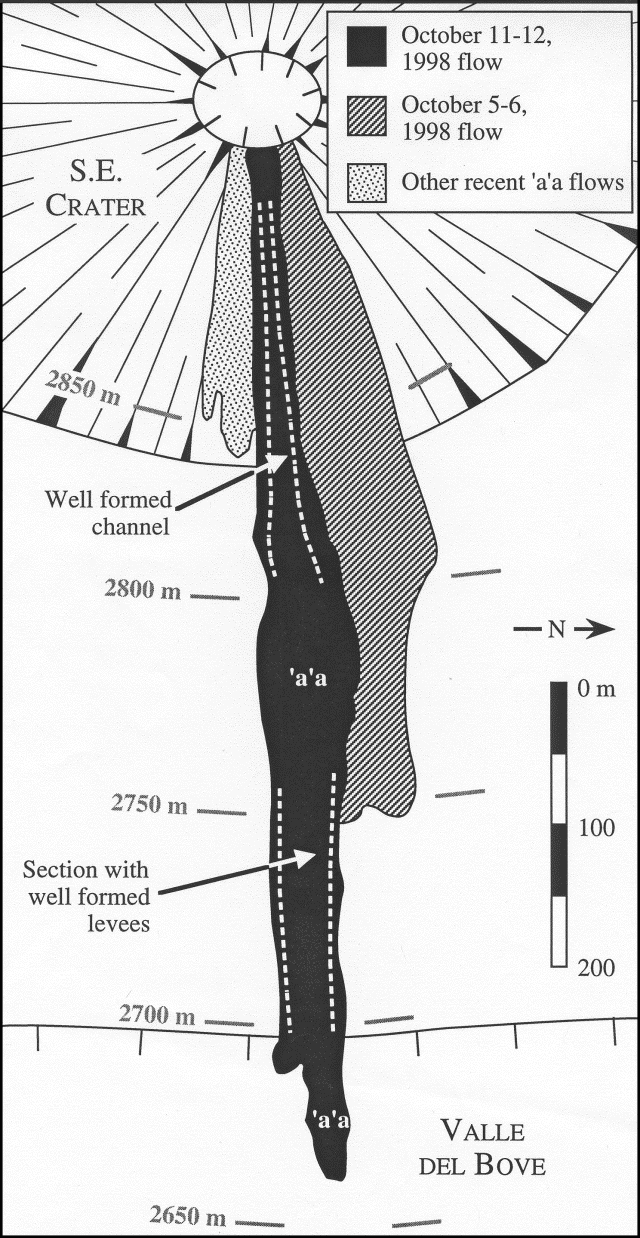 | Figure 76. Sketch map of Etna showing E-directed aa flows from Southeast Crater (SEC), 14 October 1998. The North arrow points towards the right. The lavas were emitted during 5-6 and 10-11 October 1998. The map was created based on field measurements made by Andrew Harris, Sarah Sherman, and Robert Wright. |
Information Contacts: Andrew Harris, HIGP/SOEST, University of Hawaii, 2525 Correa Road, Honolulu, HI 96822 USA; John Murray and Robert Wright, Department of Earth Sciences, The Open University, Milton Keynes, MK7 6AA, UK; Andrew George, Gwel an Bendra, Penhale Lane, St. Cleer, Liskeard, Cornwall, PL14 5EB, UK; Jon Hearn, 20 Ringwood Rd., Twerton, Bath BA2 3JJ, UK; Sarah Sherman, 3015A Alencastre Pl., Honolulu, HI 96816, USA.
May 1999 (BGVN 24:05)  Cite this Report
Cite this Report
Lava emission continues through May from Southeast Crater into the Valle del Bove
The following report summarizes activity observed at Etna from March through May 1999. The information for this report was compiled by Boris Behncke at the Dipartimento di Scienze Geologiche (formerly Istituto di Geologia e Geofisica), University of Catania (DSGUC), and posted on his internet web site. The compilation was based on personal visits to the summit, observations from Catania, and other sources cited in the text.
Almost all activity has been limited to the eruptive fissure that became active on 4 February at the southeastern base of Southeast Cone (SEC). During early March, lava continued to flow into the Valle del Bove, forming a lava field (figure 77) composed of numerous lobes. The activity was visible from Catania and other locations on 5 March, with the flow field incandescent over its length from the W rim of Valle del Bove down to ~2,000 m elevation.
 | Figure 77. Sketch map of Etna showing the Valle del Bove and the area of lava flow-field that has developed since 4 February 1999, as of 4 June 1999. The lavas erupted during 1989-93 are shown in various shades of gray, previous flows (since 1971) are shown in lighter shades. 1995 to early 1999 lavas are not shown. Key: NE=Northeast Crater; V=Voragine; BN=Bocca Nuova; SE=Southeast Cone; TDF=Torre del Filosofo; MO=Montagnola; RS=Rifugio Sapienza; MC=Monti Centenari. Courtesy of Boris Behncke. |
Observations on 3 March. On 3 March, the area of activity was visited by Giovanni Sturiale and Boris Behncke (DSGUC), and Christophe Baudin, a visitor from Belgium. The most recent lava to flow through the notch in the N rim of SEC, on 4 February, was covered with a thin layer of reddish ash and showed no heat emission. The inclined floor of the notch was ~3-5 m wide and covered with rubble; the width at its rim was 15-20 m. Only a few glimpses were caught of the interior of the crater, but at several tens of meters depth there was an inner terrace surrounding a narrow central pit. The width of the crater at its rim was at most 50 m. Gas and vapor escaped from several fumarolic areas on the SW and E crater rims. On the SE side of the crater there was a fuming pit ~15-20 m wide. Below this pit, on the outer flank of the cone, a vigorously steaming fissure segment extended ~100 m downslope; below this was the oval-shaped main vent of the 4 February episode.
Eruptive activity from the 4 February fissure consisted of very weak, and intermittent, ejections of pyroclastics, and quiet outflow of degassed lava. A cluster of about 10 hornitos at the upper end of the fissure were covered with sulfur. Relatively regular observations during 27 February-3 March (information from Giuseppe Scarpinati, Carmelo Monaco, and Christophe Baudin) indicated irregular activity at the hornitos. There was vigorous spattering at one of the main hornitos on 27 February, a new hornito began to grow on 28 February about 70-80 m downslope from the main group, and on 2 March a short-lived lava extrusion occurred from the base of one of the uppermost hornitos. On these occasions the hornitos were the site of high-pressure gas emissions that produced loud hissing.
During the 3 March visit, all hornitos were unusually quiet. High-pressure gas emission occurred from a few locations 50-80 m downslope. No flowing lava was visible, but a row of skylights lay 100-150 m downslope from the hornitos. About 100 m farther downslope the lava appeared at the surface in a well-defined flow channel. Several other lava flows were slowly moving across the lava field. At the rim of the Valle del Bove one main flow spilled into this vast depression, forming a pronounced ridge where it disappeared in another lava tube. Lava resurfaced a few hundred meters further downslope through numerous ephemeral vents, forming narrow flows that extended to the floor of the Valle. The farthest active lava was at ~2,000 m elevation, above the Monti Centenari, a cluster of 1852-53 cinder cones of which only the summits now protrude (figure 77).
The mean output was several cubic meters per second; the volume of lava produced in one month of activity was between 5 and 10 x 106 m3. Although this is a very rough estimate, with an error of ~50%, it indicates more production than other long-lived effusive eruptions in the summit area, which had effusion rates of < 1 m3/s.
Observations on 11 and 13 March. A group of DSGUC geologists (Behncke, Mariangela Porravecchio, Giuseppe Paradiso, and Antonella Lentini) visited the eruptive fissure at the base of the SEC on 11 March. Above the rim of Valle del Bove, all lava was flowing in tubes. There are apparently two main lava tubes ~30 m apart at the rim of Valle del Bove. The more southerly tube ended just above the crest of the Valle where the lava appeared at the surface, and two ephemeral vents emitted lava further downslope. The northerly lava tube extended much further into the Valle, and surface flows appeared halfway down its W slope, at ~2,500 m elevation. The active flow-fronts appeared to be somewhere above 2,000 m elevation. No activity had occurred at the hornitos in the uppermost part of the fissure, but degassing occurred from several incandescent fumaroles. Geologists from Palermo University measured temperatures of ~1,030°C in one of these fumaroles.
There appeared to be little activity elsewhere, although something that appeared to be a phreatic steam explosion came from Bocca Nuova's southeastern vent area. It formed a convoluted cloud but contained little or no ash, and it produced no sound.
On the late afternoon of 13 March the eruptive fissure was again visited by DSGUC geologists (Behncke, Monaco, Betty Giampiccolo, and Marcello Bianca). There were only minor changes compared to two days earlier. The southern lava flow sent numerous branches spilling over the rim of Valle del Bove. Little had changed at the northern lava flow. The output was still as high as 5 m3/s, and the effusive episode that began on 4 February was estimated to have produced >15 x 106 m3 of lava, an amount typical of a "slow" flank eruption (Etnean flank eruptions are generally classified into those with relatively low effusion rates, such as the 1983 and 1991-93 eruptions, and high-effusion rate eruptions like those of 1981 or 1989).
During late March lava continued to flow into Valle del Bove. While a major flow issued from an ephemeral vent about halfway down the W slope of Valle del Bove, several smaller lobes were visible on the crest of the Valle on the evening of 24 March.
Observations on 7 April. Effusive activity continued in early April, though at a slightly diminishing rate. Lava flows continued to spill into the Valle del Bove, but their fronts stopped before reaching the base of the steep slope. A visit was made on 7 April by Behncke and geologists of Catania and Switzerland together with Marco Fulle (Trieste Astronomical Observatory) and Roberto Carniel (Stromboli On-line). Numerous small surface flows were active in two areas above the rim of Valle del Bove, one about halfway between the rim and the hornitos at the upper end of the 4 February fissure, and the other just above the rim. In the lower area, three or four small flows slowly advanced a short distance from their vents, which lay around spectacular tumulus, or pressure ridges, formed as magma pushed from below, raising blocks and slabs of older lava up to 5 m. The constant effusion since 4 February had formed an impressive, delta-like ridge on the Valle del Bove rim.
The upper area of activity, at ~2,850 m elevation, had five or six vents around a smaller tumulus. Two vents produced voluminous flows that descended tens of meters and had spectacular cascades. A small vent produced a flow that moved in a 20-cm-wide, S-shaped channel; this vent froze over in less than two hours, and a new ephemeral vent became active 20 m downslope. Strong gas emission occurred from two places in the upper part of the 4 February fissure. The cluster of hornitos at the end of the fissure was quiet while profuse steaming occurred from the upper part of the fracture that split the southeastern side of SEC on 4 February. On the W wall of the Valle del Bove, lava issued from a number of ephemeral vents about halfway down the slope, feeding flows that advanced a few hundred meters.
While lava effusion continued unabated, the rate of lava production appeared lower than during the first six weeks of the eruption, possibly in the range of 1-3 m3/s. The volume of lava produced thus far exceeded 20 x 106 m3.
Observations on 14 April. Decreased lava effusion from the 4 February fissure was observed by Behncke and a German television team on 14 April. Near the W rim of Valle del Bove, lava came to the surface in a few places and produced very small flows. Halfway between the Valle del Bove rim and the hornitos, two main vents fed chanellized flows. Activity was more vigorous than the lower area, but had decreased markedly since one week before.
A notable feature is the formation of pressure ridges, tumuli, and small-volume extrusions from cracks in older lavas. Most of this was caused by very slow intrusion of lava from tubes towards the surface once the tube was blocked or slowed, forcing the lava upwards. Lava oozed through the cracks and formed new flows, but in many cases the lava formed bulbous protuberances which often resembled the lobes of pillow lavas forming underwater.
Observations on 30 April. Behncke and others descended into the Valle del Bove on 30 April. One main effusive vent, at ~2,700 m elevation (~100 m below the rim of Valle del Bove), was feeding several flows which in part disappeared into lava tubes and resurfaced tens of meters downslope. The mean effusion rate appeared to be around 1 m3/s or slightly less. The maximum flow length was ~300 m. The farthest flow fronts were stagnant above the floor of the Valle del Bove. There was no explosive activity around the effusive vents. Only one feeder tube appeared to be active, located in the central part of the field on the W slope of Valle del Bove.
Observations on 12 May. During early May, little significant change affected the activity. Lava flowing from the area of the 4 February fissure through a lava tube appeared at the surface at ~2,600 m elevation on the W wall of Valle del Bove. Active lava fronts did not extend below 2,000 m.
On 12 May, Behncke and Scarpinati visited the summit area, including Bocca Nuova and SEC, and entered the Valle del Bove. The summit craters were quiet, apart from near-continuous passive emissions of light brown ash from the NW vent of Bocca Nuova. This activity, which was most likely caused by internal collapse, was entirely noiseless and ash plumes barely rose above the crater rim. A deposit several centimeters thick covered the S, SE, and E sides of the main summit cone.
After descending from the main summit cone to the saddle which separates it from the SE Cone, Behncke climbed to the summit of the SEC. The crater was practically gas-free, so it could be seen that its floor had collapsed and the conduit was no longer open. There was, however, some gas and vapor emission from the upper part of the fracture which had split the SE flank of the cone on 4 February.
There was no visible activity anywhere above the Valle del Bove rim, the only surface flows appearing ~200-250 m below the original eruptive fissure, in Valle del Bove. Lava was issuing from two ephemeral vents on the N and E sides of a large tumulus. It was ~10-15 m across and consisted of uplifted, tilted, craggy blocks of older lava and minor volumes of more recent smooth-surfaced pahoehoe. The N vent fed a small well-channelized flow while from the vent on the E side of the tumulus lava was squeezed out like toothpaste.
Behncke and Scarpinati heard continuous cracking and knocking sounds from below, and small rockfalls from the sides of the tumulus were frequently observed; rocks at the surface of the tumulus were slowly fracturing. It was evident that magma was forcefully pushing from below, and lava was rising slowly within cracks between the blocks at the surface. After about 15 minutes of observation, Behncke and Scarpinati left the unstable tumulus area and continued their observation from 15 m upslope. For another 20-30 minutes, the tumulus gradually extended in all directions. Fracturing on the slope above the tumulus indicated a larger volume of magma arriving at the end of the feeder tube and nearing the surface.
After about 35-45 minutes of observation, the large blocks of older lava began to fall apart while ever larger rockfalls and collapses occurred on the flanks of the tumulus. After this, the entire tumulus area became highly mobile, and its E and SE sides, perched above the steep Valle del Bove slope, began to slide downhill, producing spectacular cascades of incandescent blocks and exposing the fluid, incandescent interior. The most dramatic phase, which lasted no longer than 5 minutes, saw the virtual unfolding of the whole structure as older blocks slipped into the Valle del Bove. Where the observers had walked only 30 minutes before, an incandescent chasm 15 m wide and 5-6 m deep opened, and lava slowly flowed from draining lava tubes. Fresh lava welled up at the W end of the collapse depression, rapidly filling it and spilling over its SE rim, causing further rockfalls. Some rocks at least 20 m3 in volume fell, with fresh incandescent lava attached to them. The overflowing lava appeared to be more voluminous than that which had previously issued from the two vents.
The previously active flows, cut off from their supply, soon stagnated, and small lava tubes with still-incandescent walls became visible. Fresh lava spilled down in a southeasterly direction, forming two branches which traveled 100-150 m in about 30 minutes.
Observations on 15-19 May. Surface activity resumed at the 4 February fissure on 15 May, after about a month of lava flowing through tubes to the Valle del Bove. A luminous spot in the hornito area was sighted through binoculars on the evening of 15 May by Giuseppe Scarpinati from his home in Acireale. Earlier that day Harry Pinkerton (Environmental Sciences Division, University of Lancaster) and others working in the area had noted no active lava. The next day (16 May), lava was slowly extruded from three small vents. The rate of emission increased during the following two days, and a larger vent fed sluggish flows that advanced across the N part of the flow-field.
On 19 May, Behncke, Antonella Lentini, Mariangela Porravecchio (DGSUC), Valentina Giambarresi (Catania University), and others visited Etna's summit area and the effusive vents. A part of this group climbed to the SEC summit. Since the previous visit by Behncke on 12 May, all emissions of vapor from the obstructed crater floor had ceased. The crater floor was ~70 m below the W rim, and the crater walls were vertical in most places. Fumarolic activity was occurring from numerous locations around the crater rim.
While the group stayed on the SEC summit, ash emissions from Bocca Nuova and Northeast Crater produced dilute plumes ~100-150 m above the respective crater rims. Rumbling sounds came from the direction of the Voragine or (less likely) Northeast Crater. No visible emissions were associated with the noise, and no more sounds were heard when everybody had returned to the hornito area.
The new vent 80-100 m below the hornitos lay in a drained channel ~3 m wide in its central portion. The shift of the currently active vent downslope was evident in the form of a ridge built by a series of crusted-over vents. The emission of lava was frequently accompanied by strong degassing, indicating that the lava here was more gas-rich than that issuing from the ephemeral vent on the Valle del Bove slope. Some 20 m downslope from this active vent, one of the initial three vents (of 16 May) was still extruding small amounts of bulbous lava, forming a tumulus.
The visit to the ephemeral vent on the Valle del Bove slope was highly instructive regarding the properties of effusive vents and lava channels. Lava was still flowing from two vents on the floor of the depression formed during the 12 May collapse of the large tumulus. Flow fronts did not extend to the Valle del Bove floor. Four or five well-channelized flows ~1 m wide were moving down the slope; towards their fronts two of these flows were seen to thicken and broaden to 2-3 m height and 5 m width.
The floor of the depression left after the tumulus collapse was partially covered with new lava, mostly aa with one small lobe of very smooth pahoehoe, and the main effusive vent had shifted ~2 m downslope. A second effusive vent 4-5 m downflow produced a small volume of lava.
Investigation of what remained of the collapsed tumulus revealed that the two effusive vents observed on 12 May had not been completely destroyed. Vent 1 lay on the N side of the tumulus, and while still active it had fed lava into a well-defined channel. Vent 2, on the E side of the tumulus, had squeezed out lava much like toothpaste, which had spilled down the steep E face of the tumulus. Both vents were cut off from lava supply as the tumulus collapsed, and when the area of vent 1 was observed shortly thereafter, lava was still draining from the flow channel. Observation on 19 May revealed that the channel had completely drained, its depth being ~1.5 m (compared to a width of 0.8-0.9 m). This is a much higher depth-width ratio than in most other lava channels on Etna and many other volcanoes, but normally lava channels are not drained as completely as in this case since the supply of lava decreases gradually, allowing some of the lava to remain and "freeze" on the channel floor.
Vent 2, one week after the cessation of its activity, was a roughly circular hole open towards the downslope side, and evolving into a thoroughly drained flow channel that had been hidden under the lava when observed before the tumulus collapse. Like at vent 1, this flow channel was deeper than wide. The vent 2 channel is on much steeper terrain, but this apparently had no effect on the depth and width of the flow channel. The vent itself, ~1.5 m wide at its rim, widened at depth to a subcircular cavity from whose floor some bulbous lava had oozed, probably, at some stage of the tumulus collapse. This indicates that there had been a lava pocket ~1 m below the vent. Vent 2 was surrounded by peculiar lava features. There was something like a "basal" lava type, of chocolate brown color, and with a very smooth ripply surface, onto which patches of black, scoriaceous lava were attached. Many of these features are almost certainly related to the frequent and rapid shifting of the locus of extrusion, and the shearing of actively extruding lava along solidified lava on the vent or flow channel walls.
Effusive activity from the 4 February fissure continued at a slowly decreasing rate through the end of May. This decrease was accompanied by an apparent increase of activity in the summit craters, possibly caused by the rise of the magma in the central conduit system below these craters, as less magma escaped through the 4 February fissure. A new surge of activity at this fissure occurred in mid-June; more detail will be provided in a future Bulletin.
Information Contacts: Boris Behncke, Dipartimento di Scienze Geologiche, Palazzo delle Scienze, Università di Catania, Corso Italia 55, 95129 Catania, Italy.
June 1999 (BGVN 24:06)  Cite this Report
Cite this Report
Lava-flow temperature measurements
During the winter of 1998-99, Southeast Crater underwent a series of short eruptions. On 4 February 1999 a similar outbreak led to fracturing of the SE cone with subsequent lava flows to the NNE and SSE (observation by Giuseppe Scarpinati). The SE flow developed a lava field between 2,900 and 2,800 m elevation on the rim of the Valle del Bove (BGVN 24:05), with numerous branches that nearly reached its bottom at about 2,000 m elevation. This mild effusive activity was characterized by very small and slow degassed lava flows coming from ephemeral vents through the superficially congealed crust of the field.
Temperature measurements were carried out on lavas from several of these effusive vents during the first days of April. Special thanks are due to Antonio and Orazio Nicoloso and the Etnean Guides for assistance in the field. Consumable "Temtip" Pt / Pt-10%Rh thermocouples were used following a procedure described in Archambault and Tanguy (1976). The maximum lava temperature recorded at depths of 40-60 cm within the fluid lava was 1,085 ± 5°C (figure 78), slightly higher than that measured during the last two major flank eruptions of 1983 and 1991-93 (1,070-1,080°C). As already shown in Archambault and Tanguy (1976), such small lava flows showed a strong thermal gradients, so that measurements made at 5-15 cm depth give results 10-15°C lower than the true internal temperature (figure 79). This means that devices reaching only the superficial parts of the flows are unsuitable for such temperature measurements.
 | Figure 78. Histogram showing the number of Etna lava measurements at each temperature; the 16 measurements were taken at depth on fluid lava. |
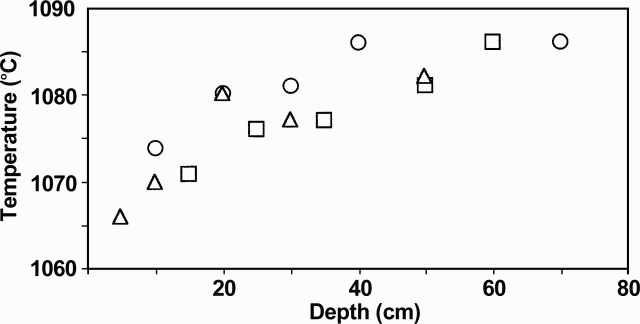 | Figure 79. Lava flow temperatures measured at Etna during early April plotted versus depth. Different symbols (circles, squares, and triangles) represent different sets of measurements. |
Although relatively low for a trachybasalt (or basaltic hawaiite) lava, the temperature of 1,085°C is consistent with their high crystal content of ~40% phenocrysts. As usual in recent Etna lavas, these phenocrysts consist of plagioclase, clinopyroxene, olivine and titanomagnetite lying in a glassy alkaline groundmass.
Reference. Archambault, C., and Tanguy, J.C., 1976, Comparative temperature measurements on Mount Etna lavas: Journal of Volcanology and Geothermal Research, 1, 113-125.
Information Contacts: Roberto Clocchiatti, Lab. Pierre Sue, CEA Saclay, France; Charles Rivière, CGE, France; Santo La Delfa, Giuseppe Patanè, and Jean-Claude Tanguy, University of Catania, Italy.
September 1999 (BGVN 24:09)  Cite this Report
Cite this Report
Summary of June-September activity; powerful eruption from the Voragine on 4 September
The information for this report was compiled by Boris Behncke at the Dipartimento di Scienze Geologiche, University of Catania (DSGUC), and posted on his internet web site. The compilation was based on personal visits to the summit, observations from Catania, and other sources cited in the text. Additional information was provided by Jean-Claude Tanguy (DSGUC), mostly about the activity during September.
Mild eruptive activity resumed at Etna's summit craters (figure 80) in early June, and gradually increased through late August before culminating with a powerful eruptive episode from the Voragine on 4 September. During the same period, lava continued to flow from fissures at the base of Southeast Crater (SEC), and occasional phases of mild lava spattering built hornitos and spatter cones at the eruptive vents.
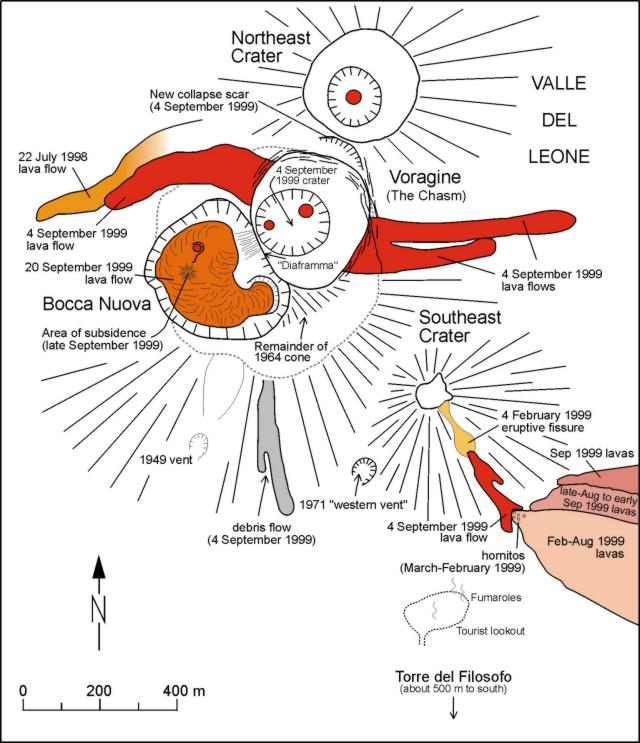 | Figure 80. Sketch map of the summit craters of Etna, based on fieldwork between 7 September and 1 October 1999 by Behncke and others. Courtesy of Boris Behncke. |
Activity during June 1999. During early June, lava emission from the 4 February fissure on the SE base of SEC continued at a low rate. Lava issued from ephemeral vents and flowed for a few hundred meters towards the W face of the Valle del Bove (VdB).
The following information regarding activity from 30 May to 2 June was provided by John Guest (University College London, UK) and Angus Duncan (University of Luton, UK). Several explosions were heard from the summit craters on 30 May. On 1 June a brief bright red glow was seen over Bocca Nuova (BN). The active lava pile in the vent area at the foot of SEC on 2 June had increased in thickness since 30 May. Fresh lava now partly buried the 'old' tumulus of altered lava blocks, but a new tumulus had formed a few meters downflow. On 3 June Sandro Privitera (IGGUC) observed three emissions of reddish gray ash to more than 500 m above the crater.
On 4 June the two main sites of activity were generally the same as on 19 May (BGVN 24:05): an effusive vent ~25 m below the hornitos at the upper end of the fissure that became active on 4 February, and a cluster of vents at about 2,600 m elevation on the W slope of the VdB. The upper site had shifted ~30-40 m upslope. During the 16 days between the two visits, the site of lava emission had shifted frequently, sending lava flows in various directions. By 4 June lava flows had covered most traces of the tumulus collapse depression formed on 12 May. It appeared that the effusion rate had remained nearly constant for about 2 months (at ~1 m3/s). About 25-30 x 106 m3 of lava had accumulated since 4 February on the western VdB rim and the slope below.
A brief visit on 10 June by Behncke and Francesca Ghisetti (DSGUC) revealed that the output of lava from the 4 February fissure had increased. The active vents were ~10-20 m below the hornitos at the upper end of the fissure. One vigorous vent was on the fissure, but lava also issued from within and on the margins of recent flows on the SW side of the lava field. A flow down the N side of the lava field appeared to have spilled over the rim of VdB. One vent continued to emit lava on the western VdB slope.
Weak explosive activity at the 4 February fissure resumed in mid-June, accompanied by an increase in the lava output. According to Giuseppe Scarpinati (L'Association Européenne Volcanologique, LAVE), an intermittent glow in the eruption area was visible from Acireale (SE of Etna) on the evening of 16 June. This glow was also clearly visible from Catania on the following evenings, and lava was seen extending from the glow area.
By the afternoon of 19 June one large and several smaller hornitos had grown on a large lava shield, ~50-80 m below the cluster of hornitos built during February-March 1999. Two lava rivers extended a few hundred meters in the direction of the VdB. The effusion rate had increased to 2-3 m3/s (it had been less than or equal to 1 m3/s during the previous month), and the volume of lava emitted since 4 February exceeded 30 x 106 m3.
Between 19 and 23 June there was a notable decrease in activity at the eruptive fissure. After a visit on 26-27 June, Scarpinati reported that variable emission of lava from the 4 February fissure continued. Scarpinati also noted that the Voragine produced explosions, but made no direct observations.
On the evening of 29 June Behncke noted that the 4 February fissure had one eruptive site that produced mild lava spattering and two lava flows. Spattering from three closely spaced vents threw blobs of lava up to 3 m away. A partially drained lava tube containing incandescent but stagnant lava was seen 50 m downslope from the vents. The output was estimated at 1-3 m3/s. The SW ("diaframma") vent in the Voragine produced loud explosions every 2-10 minutes that ejected incandescent bombs above the vent.
Activity during July 1999. Another summit visit by Behncke on 1 July benefitted from perfect viewing conditions and very little wind. The generally flat floor of NEC had changed little since 5 October 1998, but now contained a large pit emitting a high-pressure gas plume charged with SO2. There were periods lasting a few minutes when the noise level increased notably, and the plume became much denser; one time it contained brownish ash. BN had its usual two large eruptive centers, one in its NW part and the other at the base of its SE rim. While the latter periodically emitted plumes of grayish-brown ash, the former was the site of alternating ash emission and magmatic degassing.
The Voragine, according to a guide, had intensified its activity on 26 May. On the morning of 1 July explosions occurred at the SW vent every 1-10 minutes. Explosions at the SW vent started with a noise followed by large bombs that rose tens of meters above the vent, and sometimes even tens of meters above the crater rim itself, and then by a brownish ash plume. A few fresh vesicular bombs were found on the outer SW slope of the Voragine.
Claude Grandpey (LAVE) visited the eruptive fissure on 2 July and observed vigorous lava emission. The next day, lava emission had decreased. Activity was intense at the SW vent of the Voragine, with explosions ejecting bombs outside the crater on the northern side. Many bombs also fell into BN. The central vent in the Voragine had periodic gas and ash emissions. In the BN, noisy activity occurred in the SE vents (which during the 1 July visit only emitted ash), while the NW vent was relatively quiet.
The summit area was visited on 6 and 7 July by Behncke, Peter Ippach, and Eduard Harms (German Volcano Museum, Mayen, Germany). During the first of these two visits there was strong gas emission from the central pit of the NEC, and every 10-45 minutes there were explosive ejections of rocks and ash emissions. In the Voragine, explosive activity at the SW vent had decreased, and only one explosion was observed during two hours. However, the central vent was the site of Strombolian eruptions every 1-10 minutes. Incandescent bombs were ejected but only in one case rose as high as the rim of the vent, which was estimated to be at least 35-40 m deep and had a pit about 5 m wide in its floor. Recently ejected bombs up to 1.5 m long littered most of the Voragine floor.
The 7 July visit to the fissure disclosed continuing activity from two major effusive vents, one located in the area of the hornitos that formed in the past few weeks, while the other lay ~100 m downslope at the end of a lava tube. During four hours of observations, explosion sounds coming from the Voragine (and maybe also from BN) were heard every 5 to 45 minutes.
On 9 and 10 July, Behncke, Ippach, and Harms visited the summit area again, and additional information about the activity on 10-11 July was provided by Scarpinati and Charles Rivière (of Tremblay-en-France, France). Observations were restricted to the area of the 4 February fissure, but Rivière visited the summit craters early on 10 July. At the fissure, three vents were active at the tumulus ~150 m downslope from the uppermost February-March hornitos. Several lava flows were active during 9-10 July, and incandescent lava was seen in many places on the lava field. Lava also issued from several vents along the N margin of the flow-field.
Rivière, who visited the summit craters during the forenoon of 10 July, reported continuous pyroclastic activity deep within the pit of the NEC. In the Voragine, Strombolian activity occurred from the central andSW vents, with bombs at times rising high above the crater rim; Rivière noted that explosions occurred about every two minutes.
Scarpinati and Alain Catté (LAVE) observed the activity from the late afternoon of 10 July through the next morning. Shortly after 1800 on the 10th, the tumulus where the main vent had been emitting lava was seen to "inflate rapidly, and then lava came down on all its sides, forming three lava rivers." On the next morning, none of the vents on the tumulus were active, but a new vent had formed 30 m SE, burying the tourist path to the vent area; lava effusion diminished later that morning. Between 13 and 24 July lava continued to flow from the 4 February fissure, but the amount was relatively small, and short-lived flows extended only a few hundred meters downslope.
On 16 July Grandpey noted clouds of brownish ash from NEC. The Voragine was quiet, but Grandpey learned that the SW vent was active earlier during the week (around 12 or 13 July) with explosions, while lava was visible at the bottom. The NW vent inside BN was quiet, and parts of it had collapsed. Strong explosions heard every few minutes in the SE vent had been audible throughout the night.
Activity was particularly intense in the Voragine on 18 July when Rivière filmed the SW vent. Lava had again risen to ~20 m below the rim, and a small, dome-shaped mound of lava produced numerous small explosions. The mound was partly incandescent and was blown to pieces in some of the larger explosions, then rose again. During the days preceding 24 July, however, Rivière observed a diminution of activity in the Voragine, but there was explosive activity within BN.
The summit craters were visited again on 28 July by Behncke, Carmelo Monaco and Angelita Rigano (DSGUC), and others. Deep within the central pit of the NEC there were near-continuous detonations. Within the BN, explosive activity occurred deep within the two main vents. The SE vent produced near-continuous emissions of brownish ash. The Voragine central vent produced powerful explosions and at times prolonged fountains of incandescent bombs, some of them up to 1 m across. Some of the explosions ejected bombs to ~100 m above the crater rim. Many eruptions were accompanied by high-pitched roaring noises indicating high-pressure gas emission from the top of the magma column in the vent, which had risen by tens of meters since last observed directly by Behncke and others on 6 July. At the 4 February fissure, lava emission continued at a low rate. One area of effusive activity lay on the NE side of a large tumulus ~100 m downslope from the upper hornito cluster. The effusion rate was ~1-2 m3/s, and the volume of lava emitted since 4 February was estimated to exceed 35 x 106 m3.
1 August-3 September 1999. Axel Timm from Germany visited on 15 and 16 August and made the following observations. There was little activity in the BN on 15 August, with quiet degassing at the NW vent, while dilute ash clouds were emitted at intervals of several hours from the SE vent. In the Voragine there was only gas emission from the SW vent, but minor eruptions occurred at intervals of 5-60 minutes from the central vent. Rumbling noises and dense gas emissions came from deep within NEC. Several small lava flows issued from the hornito area at the upper end of the 4 February fissure.
On 16 August the SE vent continued to quietly emit ash to 50-100 m above the vent at intervals of about 30 minutes. Voragine eruptions every 10-30 minutes from the central vent varied from noisy gas emissions to explosions that ejected bombs and scoriae far beyond the rim of the vent.
Grandpey reported that lava effusion from the 4 February fissure decreased notably around 20 August. Activity ceased on 25 August, and no effusive activity occurred thereafter for two days. Grandpey noted that the end of the effusive activity corresponded to a increased activity inside the Voragine. On 24 August he saw explosions from two small vents on the N rim of the SW vent. On 26 August Grandpey observed the central part of the Voragine inflate over a surface ~50 m in diameter, followed by an explosion that disrupted about half of that area, ejecting large pyroclasts. A few minutes later a much stronger explosion sent bombs as far as the center of BN and all over the W slope of the Voragine. Similar explosions followed through the next day. When Grandpey returned on 27 August, a new "cavity" had formed at the center of the Voragine and explosions were occurring near the SW vent.
The cessation of activity from the 4 February fissure on 25 August was followed two days later by the opening of a ~50 m long fissure located 40-50 m N of the hornitos. Mild Strombolian activity occurred during the following days and a small lava flow moved along the rim of the lava field.
4 September 1999 eruption from the Voragine and SEC activity. Scarpinati was observing the effusive activity at the new vents at the SE base of the SEC cone at around 1700 on 4 September and noted a hissing sound at around 1745, which gradually increased until it was "like a jumbo jet taking off." Guides at the Torre del Filosofo hut heard a loud detonation at about 1810, and saw intense red glow above the main summit cone ("the BN was incandescent all over"). Strong continuous incandescence between the Voragine and NEC suggested that lava was flowing down the E side of the main summit cone. At about the same time, Scarpinati saw through a gap in the clouds that gas and ash were rising from the summit area. Shortly afterwards he heard the crashing of impacting blocks and bombs, and retreated to the Piccolo Rifugio at about 2,500 m elevation. The climax of the eruption probably occurred between 1900 and 1930, judging from the audible detonations.
Bad weather during most of 4 September precluded observations, but a relatively clear view from Piano Provenzana (on the N flank, ~6 km from the Voragine) revealed the sudden uprise of a dark, ash-laden column that was bent eastwards. Observers at the Piano delle Concazze, about 2,600 m elevation on the N flank and ~2.5 km from the Voragine, enjoyed a splendid view of the eruption. By the time of their arrival, probably between 1830 and 1900, a huge lava fountain was rising hundreds of meters above the Voragine, and a pitch-black, tephra-laden eruption column rose ~2 km high before being blown E by winds. Large bombs fell onto the upper slopes of the NEC, which continuously emitted a dense brown ash plume, and onto the W side of the fountain. At the climax of the activity, the fountain roared to at least 1,500 m above the Voragine, an unprecedented height in the recent history of Etna.
At 1945 the cloud cover lifted, and the group at Piccolo Rifugio saw "an awesome spectacle of gigantic explosions" occurring at intervals of about 2 minutes, one of which was described by Scarpinati as "the biggest I have ever seen" (he has climbed Etna more than 500 times in the past 35 years), and which showered the main summit cone with meter-sized bombs. Some of this late activity may have come from the BN.
By 2045 all activity on the main summit cone had ended, but explosive activity began from the SEC summit vent consisting of dark "smoke" emissions mixed with incandescent pyroclasts. Ten minutes later the activity became purely Strombolian with 20-25 explosions per minute. Observations from the Piccolo Rifugio continued until about 2200 and were curtailed by bad weather; later that evening lava began to spill from the lower part of the fissure on the SE flank of the SEC cone. Lava supply increased at the vents that had become active on 27 August, and on early 5 September, a lava flow ~1 km long was observed by J.-C. Tanguy and local guides.
Effects of the 4 September 1999 eruptions. Soon after the beginning of the eruption, loud detonations were audible in villages and towns around the volcano. This was followed by a fall of scoriaceous lapilli on the E flank, extending to the coast near the town of Giarre, more than 15 km from the summit (figure 81). Many of the lapilli were walnut-sized, and some, in the area of Fornazzo, were up to 10 cm long (observation by J.-C. Tanguy). Eyewitnesses reported that some of the larger fragments were still hot when falling near the villages of Milo, Fornazzo, and Sant'Alfio, but not hot enough to set vegetation afire. Larger clasts broke windshields and seriously damaged vineyards and fruit gardens. In a narrow sector from the Milo-Fornazzo area towards the coastal strip near Giarre the pyroclastic deposit was several centimeters thick, and traffic was disrupted due to scoriae on roads. On the beach of the Ionian Sea between Riposto and Fondachello, scoriae 5-6 cm in diameter were not rare. Press reports put the damage to agriculture and infrastructure at several tens of billions of Lire (several tens of millions of US $). According to the Catania-based newspaper "La Sicilia," ~1 x 106 m3 of pyroclasts fell on Giarre alone, while the full volume of pyroclasts was given as 5 x 106 m3, a value that fits well with observations by Behncke and others.
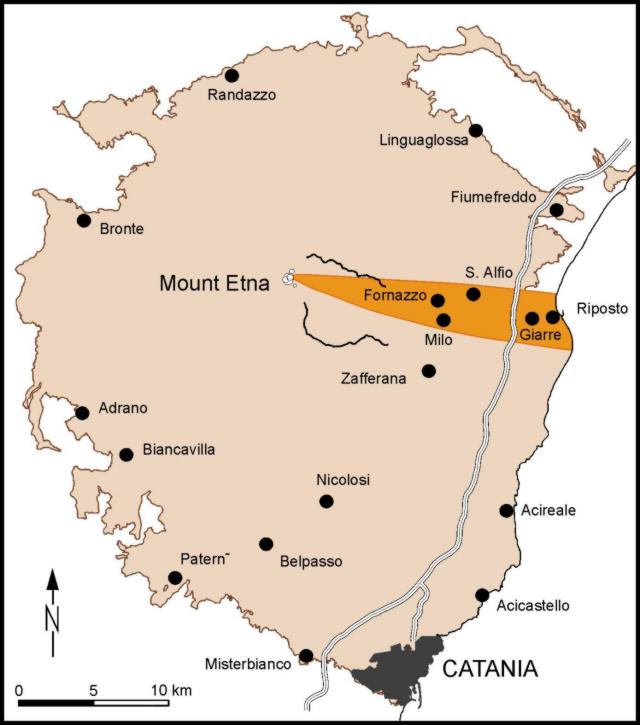 | Figure 81. Sketch map showing the distribution of pyroclasts from the 4 September 1999 eruption of the Voragine, based on field work during the week following the eruption. Courtesy of Boris Behncke. |
Field investigations were made by Behncke and Werner Keller (Proyecto de Observación Villarrica/Internet) in the area of Milo, Fornazzo, and Giarre on 6-8 September, and during a summit visit on 7 September. Measurements were made of the thickness of the deposit in various locations before heavy rainfall swept part of it away, and when the cleaning of roads was still in an initial stage. During the afternoon of 7 September visibility was hampered by clouds, but the effects of the eruption were striking. The cones of the summit craters were hit by countless bombs up to 5 m in largest dimension and lithic blocks up to 1 m across. Many bombs and some blocks had fragmented upon impact, and others were found up to 10 m outside the craters created by their impact. Projectiles had arrived on both fairly flat and vertical trajectories. Some of the larger bombs were still warm about 60 hours after their emplacement.
On the S flank of the main summit cone the accumulation of juvenile scoriaceous pyroclasts had apparently been so rapid that the deposit began to slide down the steep flank, forming something like a dry debris flow that extended ~500 m down the slope to its base. In its distal portion the flow ended in two distinct lobes ~1 m thick. About 80% of this deposit consisted of juvenile clasts 10-30 cm in diameter whose edges were rounded while sliding down the slope, the other 20% were older, slightly smaller clasts (reddish scoriae and gray lithic blocks).
Brief glimpses through the clouds permitted a view on the Voragine from ~500 m W of the crater rim. The heavy fallout close to the crater almost healed the large scar cut into the S flank of the adjacent NEC cone during the 22 July 1998 Voragine eruption (BGVN 23:11). On the SW crater rim, the rapid accumulation of fluid ejecta formed a lava flow ~300 m wide and 250-300 m long. Two similar fountain-fed flows were emplaced on the E side of the Voragine, the longer of which traveled ~700 m towards the VdB. Guides on the N flank indicated that another fountain-fed lava flow cascaded into the Bocca Nuova.
On the lower E flank the lapilli deposit extended in a narrow strip E towards the coast near Giarre. Five communities (including Milo, Mascali, and Giarre) suffered heavy fallout. Going northwards from Zafferana, on the SE flank, the southern margin of the fall deposit was in the forests between Petrulli (~2 km N of the center of Zafferana) and Milo, where isolated scoriaceous lapilli with 1-3-cm diameters occurred. Closer to Milo (1.5 km farther N) the number of clasts per square meter increased as did their mean diameter, and on the southern margin of the village the deposit became continuous. Most of the deposit consisted of lapilli-size scoriae, with little ash mostly coating leaves and grass. The largest clasts found in the S part of Milo were 7 cm across, and many reached 5 cm. In the N part of Milo, the thickness of the deposit exceeded 5 cm, and many leaves were damaged. In the S part, ~1.5 km from Milo, the deposit was 5-6 cm thick, and the largest clasts were up to 10 cm across. Residents reported that larger clasts fragmented upon impact. Going north, the deposit thinned gradually and ended with a relatively sharp margin ~2 km N of Fornazzo. Downslope, near the town of Giarre, the area of fallout was ~5 km wide in N-S extension, and up to 5 cm thick in its central portion. Most of the deposit here was composed of fragments with diameters of a few millimeters to 3 cm. The N and S margins of the deposit were strikingly sharp, it seemed that only very little fine ash fell beyond the margins of the lapilli deposit.
Comparison with the (relatively poor) descriptions of the fall deposit produced by an eruption from the Voragine on 17 July 1960 allows the conclusion that the 4 September 1999 eruption was less voluminous but similarly violent, and therefore among the largest explosive eruptions at Etna's summit craters during the past 100 years. The 1960 eruption produced ~10 x 106 m3 of pyroclasts, and clasts more than 5 cm in diameter were reported.
The activity at SEC on the evening of 4 September had many minor effects. The most impressive changes since 28 July were the presence of the new lava lobe that had issued from the lower part of the 4 February fissure, and the collapse of part of the E crater rim.
Activity after 4 September 1999. During the week following 4 September activity continued at the summit craters, but observations were hampered by bad weather. Intense explosive activity occurred each day at the BN, and at times bombs were ejected onto the outer slopes of the main summit cone. The Voragine remained active, and vigorous seismicity indicated that the most intense activity occurred between 0100 and 0400 on 9 September. During their summit visit on 7 September, Behncke and Keller reached the area of activity near SEC and saw two small lava flows issuing from vents 15 m below the spatter cone formed after 27 August that extended onto the W slope of the VdB after a few days. Mild Strombolian activity occurred from a new cluster of hornitos near the effusive vents.
During the evening of 11 September Scarpinati observed lava flowing from a vent ~200-250 m farther downslope to the E of the SEC effusive area. The next morning a new double spatter cone ~200-250 m E of the previous cone issued fluid lava, at an estimated rate of at least 1 m3/s, that moved along the margin of the flow-field. The new vents were on terrain not covered by lava during the previous months, and it appeared that this was a true new eruptive fissure.
Mild magmatic explosions were observed by guides every few minutes early on 18 September. On the next day, Rivière observed vigorous lava splashing from the NW cone of BN. Strombolian activity was relatively weak until early the next morning. At 0445, Tanguy observed the eruption from Trecastagni (on the SE flank). Continuous jets of incandescent material illuminated a gas plume rising more than 500 m above the crater rim. A bright glow in the area of the effusive vents at the ESE base of the SEC was noted, and weak incandescence was seen in the area of the Voragine. Tanguy arrived at the Piccolo Rifugio at about 0545, by which time the most energetic phase was over, although some incandescent bombs still rose up to 300 m above the crater rim. The activity had virtually ceased by 0630.
During the early morning hours of 20 September, vigorous lava fountaining occurred at the BN, mostly from the vents in the NW part of the crater where a broad cone had been the site of weak degassing for several weeks; previous reports noted that the area of this cone had remained virtually unchanged even during the 4 September Voragine eruption. The episode covered almost the entire floor of the BN with lava to thicknesses of several meters to tens of meters. A lava tongue invaded the depression that had previously hosted the SE vents, and only an irregularly shaped depression was left at the site of the NW vents. Explosive activity was again observed on the evening of 20 September, and a brief surge of activity occurred on late 21 September, after which BN became silent for about two weeks.
Effusive activity from the vents on the ESE base of the SEC was intense on the morning of 20 September when visited by Tanguy; lava issued from a vent that had opened the previous afternoon near the large spatter cone built after 27 August, and mild spattering occurred from this cone itself. A new vent had also formed at the fissure that had become active on 12 September. Vigorous effusive activity was continuing at the 12 September vents.
During the week following the 20 September eruptive episode at BN, the most persistently active summit crater was NEC, which had Strombolian activity in its central pit. A visit by Behncke on 28 September revealed that NEC cone had received heavy fallout of bombs on 4 September, and the footpath on its W side had vanished under a continuous cover of bombs, some up to 1.5 m in diameter. While the collapse scar on the SW flank of the cone had been largely healed by bomb fallout, a portion of the cone's flank farther to the ESE had collapsed, leaving a similar scar. Activity within the central pit consisted of near-continuous expulsions of dark ash. Good views obtained by Rivière on 25 September showed that the pit continued to a depth of several hundred meters with vertical walls.
On 28 September, good panoramic views of the Voragine from the S rim of NEC revealed that the former SW and central vents had merged into one large ~200-m-wide crater, but it appeared that there were still two eruptive centers. On the SW rim a wide U-shaped gap had formed in the former "diaframma" (septum) through which the floor of BN could be seen. Eruptive activity within the Voragine on 28 September consisted of frequent loud explosions.
Sub-concentric fractures were present on the outer ENE and E rim of the Voragine and on a ridge which now constitutes both the SE flank of the NEC cone and the NE rim of the Voragine. A fountain-fed lava flow that had formed during the 4 September eruption on the W side of the Voragine was up to 150 m wide in its upper part but narrowed to ~30 m in its distal portion where it formed a lobe along the N side of the 22 July 1998 flow; the new lobe, however, was shorter than its predecessor. Two fountain-fed lava flows also formed on the E side of the Voragine. The longer of these flows extended about halfway to the W rim of the Valle del Bove.
Rivière visited SEC on 24 September and reported that discontinuous effusive activity continued from the new vents (first seen by Scarpinati on the morning of 11 September) near the 4 February fissure. Lava flows extended ~1 km and spilled down the W face of the VdB.
Vigorous eruptive activity resumed in the BN on 30 September, ejecting large bombs hundreds of meters beyond the crater rim. At the same time, activity increased at the NEC. On 29-30 September, near-continuous Strombolian activity ejected bombs tens of meters above the crater rim, and larger bursts reached heights of up to 150 m, dropping bombs all over the crater floor and onto the flanks of the NEC cone.
Information Contacts: Boris Behncke and Jean-Claude Tanguy, Dipartimento di Scienze Geologiche, Palazzo delle Scienze, Università di Catania, Corso Italia 55, 95129 Catania, Italy.
November 1999 (BGVN 24:11)  Cite this Report
Cite this Report
Vigorous eruptions at Bocca Nuova send lava flows 5 km down the W flank
Following the gradual reactivation of the summit craters since June 1999 and eruptive episodes at the Voragine on 4 September and at the Bocca Nuova (BN) on 20 September, the activity shifted to the Northeast Crater (NEC) and then to the BN in early October. During the second half of October, the BN crater produced spectacular Strombolian activity, episodes of high lava fountaining, and lava overflows onto the W flank of the volcano, the first flows in that area since 1964. Lava flows on the W flank interrupted two dirt roads and burned a small portion of forest, but presented no threat to inhabited areas downslope. After 3 November, the activity declined to low levels.
The information for the following report, covering October-November 1999, was compiled by Boris Behncke at the University of Catania (DSGUC), Marco Fulle, Roberto Carniel, and Jürg Alean. Additional information was provided by Jean-Claude Tanguy. The compilation is based on personal visits to the summit, observations from Catania, and many other sources cited in the text.
Vigorous Strombolian activity occurred at the NEC during the first week of October. When the summit area was visited by Behncke, Roberto Scandone and Lisetta Giacomelli (Dipartimento di Fisica, Università "Roma Tre"), and Angelo Amara (Catania University) on 1 October, strong explosions ejected bombs up to 100 m above the crater rim, and ash emissions were frequent. Similar activity was observed during a summit visit by Behncke and others on 6 October. Brownish-gray ash plumes were frequent, and some of the Strombolian bursts were densely charged with small bombs.
Eruptive activity resumed within the BN on the afternoon of 5 October, after about two weeks of relative calm. After nightfall, Giuseppe Scarpinati (Italian correspondent of L'Association Volcanologique Européenne, LAVE) observed strong explosions from his home in Acireale (~18 km SE from the summit). Huge incandescent bombs were ejected to halfway down the S flank of the main summit cone. Scarpinati noted fluctuating glow at the NEC and increased effusion at the ESE base of the Southeast Crater (SEC) cone. Powerful explosions from the BN were continuing the next morning as Behncke and two students from the University of Trier visited Piano Provenzana on the N flank (~6 km from the BN). Explosions occurred at intervals of ~10 minutes, with minor activity between the explosions. Many bombs were ejected far beyond the crater rim. The source of this activity was probably at the SE eruptive center, which had been buried under lava on 20-21 September.
Vigorous eruptive activity continued at NEC and BN through 11 October. Dark ash-laden plumes commonly rose every few minutes from the NEC. Bombs were ejected from the BN to a distance of several hundred meters, and some bursts rose more than 300 m above the crater. Eruptive activity resumed within the Voragine and continued at least through the following day (information from Sandro Privitera, DSGUC, and Jean-Claude Tanguy).
On the afternoon of 12 October Behncke and Amara were ~250 m from the W rim of the BN, where activity was vigorous, with ejections of dense jets of bombs to hundreds of meters above the crater rim. Eruptive activity occurred from at least four locations within the crater. At 1830 there was the first in a series of powerful detonations that ejected abundant lithics along with incandescent bombs and a tephra-laden plume to ~500 m above the crater rim. The explosions initiated about 30 minutes of more intense activity from three locations in the W and NW part of the crater.
NEC emitted dark dense ash plumes almost continuously. After nightfall only ~10 percent of the emissions ejected incandescent bombs; other emissions appeared to eject mainly lithics. While near the front of the 22 July 1998 lava flow on the dirt road that connects the N and S routes to the summit (named "summit road" in the following paragraphs), several explosions from the Voragine were heard. At the ESE base of SEC cone lava was still issuing quietly after more than 8 months. The effusion rate was estimated at ~1 m3/s; during the previous four weeks, ~2.5 x 106 m3 had been added to the more than 40 x 106 m3 of lava emitted between 4 February and early September 1999.
Strong ash emission from the NEC on the morning of 13 October continued in a pulsating manner into the early afternoon of the following day. At the BN, however, near-continuous ejections of incandescent bombs caused rapid filling of the crater. On the evening of 15 October, vigorous eruptive activity occurred at the Voragine and loud detonations were audible as far as Catania.
Lava was fountaining in BN on the evening of 16 October, but strong explosions resumed the next morning (17 October). Fulle watched the activity from the summit road and reported that continuous lava jetting to several hundred meters above the crater rim occurred from several vents, and bombs dropped onto the outer flanks of the main summit cone. Sometime around 2015 a small portion of the W rim collapsed, allowing lava to move rapidly down the steep slope, crossing the summit road. On the early morning of 18 October, the farthest flow front had reached ~1,900 m elevation and stopped before reaching the Forestale dirt road (figure 82). Lava was reported to flow vigorously through the breach on the W side of the BN on the evening of 18 October, but the fronts did not extend as far downslope as the first major flows.
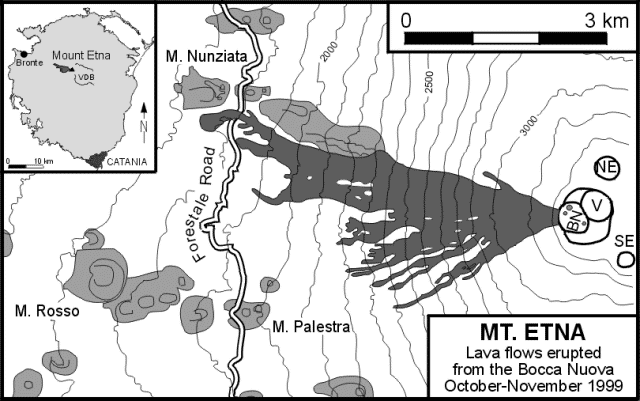 | Figure 82. Sketch map of the lava flows emitted from the Bocca Nuova during October-November 1999, based on photographs taken after the end of the activity from various locations. Main vents of the Bocca Nova (BN) are shown as dots. The other summit craters are the Northeast Crater (NE), Voragine (V), and Southeast Crater (SE). Inset at upper left shows the entire Etna area with the location of the new lavas and the towns of Bronte and Catania. VDB in the inset is Valle del Bove. Courtesy of Boris Behncke. |
At about noon on 19 October, Behncke and Scarpinati reached the summit area and observed near-continuous ejections of large bombs high above the rim of the BN. Movement of the lava flow on the W flank had slowed significantly, and only the central portion of the flow was moving. The lava field had many overlapping flow units with a total width of ~100 m at the summit road crossing. Between 1200 and 1230 activity increased until fountaining from the more southerly of the two vents became virtually continuous; frequent large blasts from the other vent dropped bombs up to 150 m beyond the crater rim. A short time later a new flow with a front ~3 m high advanced rapidly through the central flow channel, on top of the still-moving earlier lava. From points along the N margin of the lava field the summit of a pyroclastic cone growing within the BN could be seen rising above the crater rim. Explosive activity consisted of only a few ash-rich emissions between 1630 and 1730. After sunset the active flows were brightly incandescent over their entire length, and BN produced bursts of huge incandescent bombs every 2-10 seconds.
After continuing vigorously until the early morning of 20 October, the activity from the eruptive vents in the W and NW part of the BN ceased, and the lava overflow through the notch in the W crater rim stopped. Sometime near dawn, forceful expulsions of ash began from the SE vent, which had shown little activity the previous week. The low levels of activity permitted volcanologists from the U.K. to reach the rim of the BN and observe at least three vents with mild Strombolian activity and sizeable pyroclastic cones around them. On 21 October at 0300, intense eruptive activity apparently resumed, with renewed lava overflow onto the W flank. A new lobe on the S margin of the flow-field covered more of the summit road and extended to ~2,400 m elevation.
On the morning of 22 October, Scarpinati, from his home in Acireale, observed mild Strombolian activity (one explosion every 15-20 seconds) at the BN and more vigorous spattering at the vents on the ESE base of the SEC cone. By 1130 another episode of high lava fountaining and overflow from BN was in progress. From Catania jets of incandescent material to several hundred meters above the crater rim were visible, and a dense, ash-poor column of yellowish gas rose at least 4 km above the summit. Fulle witnessed the activity from a distance of a few hundred meters, and reported that a N-S fissure ~200 m long in the W part of the BN ejected a virtually continuous sheet of very fluid lava with jets rising up to 500 m high. A torrent of lava ran halfway down the W flank of the main summit cone at a speed of ~50 m/minute, carrying incandescent blocks more than 10 m across. An overflow may have also occurred on the NNW side of the BN. After 1230 the activity and the volume of overflowing lava diminished, but sporadic explosions threw large bombs hundreds of meters beyond the crater rim until 1700. Between 2000 and 2100 Behncke and Scarpinati visited the ESE base of the SEC cone where lava emission from at least three vents continued, and incandescent gas was emitted forcefully from two large hornitos that had grown earlier that day. Flowing lava was seen ~500 m NE and E from the active vents.
On 23 October another episode of high lava fountaining at the BN and overflow onto the W flank began at about 1000. This activity culminated at about 1045 but was less intense than the episode of the previous day. Relatively mild Strombolian activity persisted through the evening of 24 October, and small volumes of lava flowed onto the W flank. During the afternoon, Fulle and Carniel observed explosions (mostly ash) from four vents on the fissure in BN, and from a vent in the SE sector of the BN. During the night loud explosions at intervals of several minutes rattled windows and doors in towns 24 and 28 km NE.
On the morning of 25 October ash was emitted sporadically from BN until by about 1130 continuous fountaining was in progress. Broad jets of lava generally rose 100-200 m above the crater rim, but occasional jets soared to 500 m height. Lava again descended the W flank. A large pyroclastic cone near the vent that produced most of the fountaining (in the NW part of the BN) was ~30 m above the NW crater rim. Fulle and Carniel observed that the activity occurred from a number of vents along a N-S trending fissure in the W part of the BN. At 1145 Fulle observed that lava was overflowing the rim near the SW vent, covering the southern edge of the previous lava field.
From 1235 to 1300 the flank of the BN was affected by intense deformation, with the opening of several fractures and a series of collapses. Within a few minutes (peaking around 1320) a wide sector of the WNW crater rim was pushed up and out by lava within the crater. Minor collapses occurred for about 30 minutes while vigorous lava fountaining continued. The avalanches resulting from the collapses spilled several hundred meters down the W flank and produced brownish plumes. Movie clips taken by Carniel of the deformation and avalanches are available at Stromboli On-line. Lava flowing through the new breach was repeatedly covered with debris but continued to flow, carrying boulders up to 20 m in diameter. On the N side of the BN the mass of fluid bombs transformed into a rootless lava flow that advanced along the flow emplaced on 22 October, but extended farther downslope. The episode ended by about 1630, but was followed by a series of strong isolated explosions. By 1900, the main vent in the BN produced frequent Strombolian bursts, and lava flow through the breach in the crater rim continued at a reduced rate.
Observations made that evening revealed that a new lava flow with at least seven active branches had descended the W flank, and the farthest flow front had extended to ~1,900 m elevation. By about 1810 the front of the longest branch began moving through a small patch of forest a few hundred meters above the Forestale Road. The new lava flow was slightly N of the flows produced during the preceding week, with the longest branch extending almost 5 km from the BN, thus being one of the longest flows ever produced by a summit eruption.
On the morning of 26 October, the activity consisted mostly of isolated ash-rich explosions from the southernmost fissure vent in the W part of the BN. Towards the evening the activity became more continuous and there was mild Strombolian activity. Fulle and Carniel reported that up to five vents along the fissure were active. Explosions also occurred from two vents in the SE part of the BN where little activity had been observed the previous week.
On 27 October jets of lava rose tens of meters above two main vents in the W part of the BN, and a new large pyroclastic cone was growing around the northernmost vent. Lava continued to overflow on the W side of the crater, with active flow fronts to ~2,600 m elevation. Between 0015 and 1045, Fulle, Carniel, and Tom Pfeiffer (University of Arhus) observed intense activity, mostly in the NW sector of the BN. From 1230 onwards the explosions of the NW vent of the BN became increasingly stronger. Between 1400 and 1415 some of the largest explosions showered bombs over the whole main summit cone, and a scoria fall was noticed at the Torre del Filosofo mountain hut. At 1433 strong explosions of dark ash occurred at the NEC. The activity of the BN remained strong all afternoon. New lava spilled down the W flank, and at about 1700, the farthest flow front cut the Forestale road at about 1,800 m elevation, immediately S of Monte Nunziata (the main scoria cone of the 1843 eruption), and entered a patch of dense forest. Early the next morning the front of the main flow had extended ~200 m below the Forestale road, to ~1,730 m elevation; by 29 October the flow had stopped.
Vigorous lava jetting from the BN was observed at about 0600 on 29 October by Giovanni Sturiale (DSGUC). Activity observed by Sturiale, Behncke, Pfeiffer, and Vincenzo Polizotto (University of Catania) later that day included incandescent bombs from the NW vent, forceful ejections of dark gray ash and blocks from the SE vents, and vigorous Strombolian activity at the NW vent where the top of the new pyroclastic cone was projecting a few tens of meters above the crater rim. A variety of lava flows were seen on the W flank. Vigorous pulsating lava jetting from the NW vent was continuing at about 2230.
On 30 October, Pfeiffer revisited the summit area and reported that relatively mild Strombolian activity continued throughout the day. The entire Voragine area was covered with bombs, and the Voragine itself "had ceased to exist" because the 4 September 1999 crater was filled to within ~40 m of its rim. The active cone at the NW vent in the BN was very close to the location of the former "diaframma," of which no trace was visible. Emission of blocks and ash from the SE vents in the BN continued. During an overflight by Tanguy at about 1300, a bright red vent lay in the middle of the NW-trending BN fissure. Small lava flows were seen on the upper W slopes and a scoria cone was being built around the NW vent. NEC and SEC emitted a moderate white plume. After sunset a large red glow on the W flank indicated renewed strong effusive activity.
On the evening of 31 October, Scarpinati observed from Acireale that vigorous lava spattering had resumed at the ESE base of the SEC cone, while Strombolian activity at the BN was continuing. Scarpinati visited the area on 1 November and described voluminous lava flows running towards the Valle del Bove, and spattering from a group of hornitos. Effusive activity at the ESE base of the SEC cone showed a marked decrease after 2 November. On the 6th, Scarpinati observed trickles of lava flowing from these vents, but none thereafter.
On 1 November, Behncke and others climbed to the SW side of the BN where vigorous Strombolian activity continued from the NW vent, and occasional weak Strombolian bursts occurred from a vent farther S. Lava again extruded from below the uplifted block of 25 October. The southernmost of the three active lava lobes ran along the S margin of the lava field, cutting another 10 m of the summit road. Explosive activity at the NW vent produced jets up to 300 m high, but ~90 percent of the bombs fell back into the crater, enlarging the pyroclastic cone. On the evening of 3 November BN produced continuous jets of lava up to 300 m high, the last major eruptive episode of the sequence initiated on 5 October. Activity ceased after 0400 on 4 November, and after that the BN produced only weak intermittent Strombolian activity through about 15 November.
The volume of lava erupted from the BN between 17 October and 3 November is probably in the range of 15-20 x 106 m3. Tanguy estimated that the lava flows of 27 October alone amounted to ~5 x 106 m3, and similar flows were erupted on at least three other occasions. This places the October-November activity from the BN among the largest summit eruptions recorded at Etna during the past 200 years. The BN, which had been a 400-m-diameter pit about 150 m deep in 1995, was completely filled, and a sizeable pyroclastic cone was built in its N part, partly burying the "diaframma," the former wall separating this crater from the Voragine. Post-eruption collapse and subsidence caused the partial destruction of this cone and the formation of two pits at the main NW and SE vents of the BN, and the lava-covered plateau filling the former crater subsided by several meters towards its center. On the W side of the main summit cone, the accumulation of new lava caused a considerable buildup of this flank. The Voragine was largely filled by pyroclastics from the NW vent of the BN, with only a shallow depression remaining in its central part.
Information Contacts: Boris Behncke, Dipartimento di Scienze Geologiche, Palazzo delle Scienze, Università di Catania (DSGUC), Corso Italia 55, 95129 Catania, Italy; Roberto Carniel, Dipartimento di Georisorse e Territorio, Università di Udine, Via Cotonificio 114, 33100 Udine, Italy (URL: http://www.swisseduc.ch/stromboli/); Jürg Alean, Kantonsschule Zürcher Unterland, CH-8180 Bülach, Switzerland; Marco Fulle, Osservatorio Astronomico di Trieste, Via Tiepolo 11, 34131 Trieste, Italy; Jean-Claude Tanguy, Université Paris 6 and IPGP, Observatoire de Saint-Maur, 4, avenue de Neptune, 94107 Saint-Maur des Fossés Cedex, France.
March 2000 (BGVN 25:03)  Cite this Report
Cite this Report
Frequent eruptions in early 2000 discharging lava flows at new vents and fissures
Etna showed relatively low levels of activity during December 1999 and through 25 January 2000. In contrast, on 26 January, Southeast Crater (SEC) started a new series of strong eruptive episodes, and from then until the end of March, 46 episodes occurred at that crater (table 7). Episodic eruptive activity continued into April. The information for the following report, covering December 1999 to March 2000, was compiled by Boris Behncke at the University of Catania, with additional information from Marco Fulle, Roberto Carniel, and Jürg Alean of Stromboli On-Line. The compilation is based on personal visits to the summit, observations from Catania, and other sources cited in the text.
Table 7. Chronology of eruptive episodes from the Southeast Crater at Etna, 26 January-24 March 2000. Courtesy of Boris Behncke.
| Episode Number | Date | Approximate Time | Comment |
| 1 | 26 Jan 2000 | 0100-1300 | Lava flows until late evening, flow about 2.5 km long. |
| 2 | 29 Jan 2000 | 0845-0900 | Lava flows until nightfall; less voluminous than 1st episode. |
| 3 | 01 Feb 2000 | 0900-1000 | Light ashfall on Catania. |
| 4 | 02 Feb 2000 | 0800-0830 | -- |
| 5 | 03 Feb 2000 | 0800-0900 | -- |
| 6 | 04 Feb 2000 | 0950-1020 | -- |
| 7 | 05 Feb 2000 | 0010-0030 | Lava emission from N flank fracture heralds this episode. |
| 8 | 05 Feb 2000 | 1200-1230 | -- |
| 9 | 06 Feb 2000 | 0430-0500 | -- |
| 10 | 06 Feb 2000 | 2300-2330 | -- |
| 11 | 07 Feb 2000 | 1650-1710 | Spectacular fountains from multiple vents at SEC summit, and eruption column ~5 km high. |
| 12 | 08 Feb 2000 | 1130-1145 | Observed from 3 km distance. |
| 13 | 08 Feb 2000 | 2000-2015 | -- |
| 14 | 09 Feb 2000 | 0700-0800 | -- |
| 15 | 10 Feb 2000 | 0020-0100 | -- |
| 16 | 10 Feb 2000 | 1330-1345 | -- |
| 17 | 10 Feb 2000 | 2130-2300 | -- |
| 18 | 11 Feb 2000 | 0530-0550 | Four spectacular 400-m-high fire-fountains from the summit of SEC, and eruptive fracture on N flank. |
| 19 | 11 Feb 2000 | 2200-2220 | -- |
| 20 | 12 Feb 2000 | 0350-0430 | -- |
| 21 | 12 Feb 2000 | 0945-1030 | Strong ash emission from upper N flank at end of episode. |
| 22 | 13 Feb 2000 | 0030-0050 | Occurred during very bad weather and poor visibility. |
| 23 | 13 Feb 2000 | 1240-1300 | -- |
| 24 | 14 Feb 2000 | 0300-0330 | -- |
| 25 | 14 Feb 2000 | 1600-1630 | Oblique cauliflower-shaped plume; ashfall 50 km away. Observed from 900 m distance. |
| 26 | 15 Feb 2000 | 1800-1820 | The most violent episode of the sequence, with fountains to 800 m. Observed from ~1 km distance. |
| 27 | 16 Feb 2000 | 0640-0700 | -- |
| 28 | 16 Feb 2000 | 1605-1615 | Observed from 1 km distance. |
| 29 | 17 Feb 2000 | 0500-0530 | -- |
| 30 | 17 Feb 2000 | 1310-1330 | -- |
| 31 | 17 Feb 2000 | 2130-2200 | -- |
| 32 | 18 Feb 2000 | 0730-0800 | -- |
| 33 | 18 Feb 2000 | 1640-1700 | -- |
| 34 | 19 Feb 2000 | 0900-0945 | -- |
| 35 | 20 Feb 2000 | 1700-1820 | -- |
| 36 | 23 Feb 2000 | 0245-0435 | Activity less violent than during earlier paroxysms; buildup phase lasts much longer than in previous events. |
| 37 | 27 Feb 2000 | 0645-0950 | -- |
| 38 | 28 Feb 2000 | 1630-1730 | Activity begins to concentrate at eruptive center S of the SEC ("Sudestino"). |
| 39 | 04 Mar 2000 | 0400-0450 | -- |
| 40 | 08 Mar 2000 | 0745-1030 | -- |
| 41 | 12 Mar 2000 | 1300-1415 | Activity mainly concentrated at the Sudestino. Lava flows pass close to Torre del Filosofo. |
| 42 | 14 Mar 2000 | 0710-0740 | Activity at the Sudestino. Lava reaches Torre del Filosofo and piles up on two sides of the building to about two-thirds of its height, burns wooden hut. |
| 43 | 19 Mar 2000 | 0100-0330 | Activity at the Sudestino. Ashfall in Catania. |
| 44 | 22 Mar 2000 | 1945-2100 | Activity returns to SEC; lava emitted from fissures on S and N flanks of the SEC cone. |
| 45 | 24 Mar 2000 | 1940-2035 | Very similar to episode 44. |
Activity at Southeast Crater, 26 January-29 February 2000. Eruptive activity resumed early on 26 January at the summit vent of SEC (figure 83), after 4.5 months of quiet, and 2.5 months after the cessation of lava emission from fissures at its SE base. Initially the activity was Strombolian, but at about 0500 the activity changed to fire-fountaining, followed by the opening of a fissure on the S flank of the cone. Fountaining continued intermittently until about noon, but lava continued to flow from the lower end of the fissure until the late evening, advancing ~2.5 km into the Valle del Bove along the S margin of the 1999 lava field. Field inspections later revealed that numerous blocks of older lava and welded scoriae from the upper part of the cone fell up to 500 m from the summit of the cone.
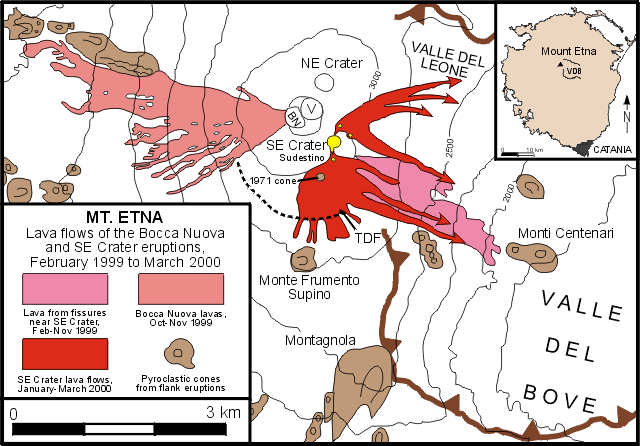 | Figure 83. Map of the summit area of Etna showing the approximate extent of lavas erupted from the Southeast Crater (SEC) between late January and March 2000. Flows terminating in arrows indicate the flow direction rather than its length. Lavas erupted from fissures near SEC between February and November 1999 and from Bocca Nuova in October-November 1999 are shown for comparison. The broken line extending from TDF (Torre del Filosofo) to the W is the margin of the Piano caldera, presumably formed during a powerful explosive eruption in 122 BC. V is the Voragine and BN is the Bocca Nuova. Courtesy of Boris Behncke. |
The second eruptive episode, on the morning of 29 January, lasted about 15 minutes. As during the preceding episode, the cone fractured on the S side, and lava flowed for a few hundred meters to the SSE and SE. After the cessation of lava fountaining, lava continued to trickle from the fissure until the evening.
Beginning on 1 February, eruptive episodes occurred at ever shorter intervals. For the next four days, these events were separated by quiet intervals of 20-24 hours. They essentially resembled the second episode, with initial mild Strombolian activity followed by lava fountaining at the summit vent. Fountaining continued for a few minutes before the S flank of the cone fractured and small fountains rose along the fracture, while lava flowed from its lower end. Activity continued for up to 10 minutes and then ceased.
During these days intermittent minor lava effusion occurred from vents on the lower N flank of the SEC cone, feeding short flows. On the evening of 4 February the lava output gradually increased. Mild Strombolian activity began sometime before 2330 from a vent high on the SSW flank. By this time lava apparently spilled over the N rim of the crater. The volume of lava running down the N flank increased, and explosive activity at the summit vent (and possibly at the SSW flank vent) became increasingly vigorous. Shortly after 0010 on 5 February the activity culminated with lava fountains and voluminous lava emission. After only ten minutes the activity began to diminish.
Between 5 and 18 February, eruptive episodes occurred at a rate of 2-3 events/day, separated by quiet intervals of 5.5-26 hours. During the first ten days of this period, lava slowly issued from the vents on the N flank of the SEC cone. Before each episode the volume of lava output gradually increased, followed by the onset of lava spattering at the same vents and increasing gas emission from the summit vent. The spattering soon graded into a continuous fountain of very fluid lava, jetting obliquely from the N-flank vents, and then the activity would extend to one or more vents at and near the SEC summit. At the height of the activity, an eruption column mainly consisting of white vapor rose several kilometers, and ash fell up to 40 km downwind. Towns at the base of the volcano, mostly in the E and SE sectors, received light rains of ash and lapilli.
During several episodes a fracture opened progressively across the N flank from the base up to the summit vent, with small fountains, while Strombolian bursts began at the summit vent. This activity rapidly culminated in high lava fountains from one or more summit vents. During an eruption late on 11 February, four fountains rose up to 400 m high, while a continuous line of smaller fountains played along the N-flank fracture. Lava flowed copiously from the lower end of that fracture, while a new vent high on the S flank fed a lava flow which reached the base of the cone. The activity became intermittent after 10 minutes of fountaining and ended shortly thereafter, while lava continued to flow at diminishing rate from the lower end of the N-flank fissure.
An eruptive episode on the afternoon of 14 February was observed from less than 1 km away by Behncke and Giuseppe Scarpinati (Italian delegate of the Association Européenne Volcanologique), who had arrived shortly before the onset at a spot SE of the cone. Like on other occasions, the activity started with increasing gas emission from the vents on the lower N flank. By 1600 a broad, dull red fountain roared to a height of ~100 m, and gas emissions increased rapidly on the upper N flank. Small rockfalls occurred on the SE flank.
Soon after 1605 a huge jet of glowing bombs from the summit formed a rapidly expanding eruption column. Shortly thereafter, a densely tephra-charged, cauliflower-shaped plume burst obliquely upwards from the S side of the summit. At the same time, incandescent pyroclastics fell far beyond the base of the cone, but none hit the area from where Behncke and Scarpinati were located. Instead, the curtain of falling ash and scoriae rapidly extended southwards, towards Torre del Filosofo, a mountain hut ~1 km S of the SEC. Scoria clasts up to 30 cm long fell around the building. Lapilli-sized scoriae fell abundantly up to 5 km to the S, and ash fell up to 50 km away. The continuous loud rumbling of the fountains mixed with the pattering noise of large clasts impacting the snow near Torre del Filosofo. Lava could be seen flowing down the S flank in a broad stream a few minutes after the onset of explosive activity. At about 1620, the activity began to wane, although lava trickled from a vent high on the S flank for several hours.
The next day, after 26 hours of quiet, the most powerful episode of the sequence was observed from Torre del Filosofo by a group including Marco Fulle of the Astronomical Observatory of Trieste, Italy. The event was heralded by increased gas emission from the summit vent shortly before 1800, followed by mild Strombolian activity. For about 10 minutes there was a gradual buildup of the activity, with Strombolian bursts from at least two vents. As the activity became more continuous, incandescent pyroclastics were thrown to ever greater distances, mainly onto the E flank. Shortly after 1800, a glowing spot appeared immediately below the S lip of the summit vent in a deep notch. A small pulsating fountain from this new vent gained rapidly in height and vigor. Eruption noises began to change from the intermittent gushing of the Strombolian activity to a continuous loud noise similar to heavy surf.
Within 1-2 minutes after the appearance of the S-flank vent, huge jets of fluid lava rose from that vent and from vents at the summit. The volume of lava from the S vent increased rapidly, at times generating surges overriding earlier flows. The upper part of the cone was soon covered by incandescent pyroclastics; most fallout occurred on the E side due to a strong wind from the W. Activity escalated when a huge incandescent jet burst obliquely from the S vent in the direction of the Torre del Filosofo, and within a few seconds it rose to a height of ~1,000 m. The noise soon became dominated by thousands of bombs crashing on the ground at rapidly growing distance from the cone. The observers fled under a side roof of the Torre del Filosofo building a few seconds before bombs began falling around and beyond the building. Some of them had diameters of tens of centimeters, and many were seen bouncing and bursting into fragments. This rain of bombs lasted about 20 seconds, after which activity stabilized with lava jetting vertically from S-flank and the summit vents.
As was evident from video filmed by British cameraman David Bryant, the largest fountain came from the summit, and from the video as well as from estimates made by other observers, including Behncke (in Catania) and Scarpinati (in Acireale), the fountain height was consistently 500-600 m with bursts reaching 800 m above the summit. The entire cone was covered with incandescent material, some of which developed secondary flowage, while a broad lava flow ran down the S flank.
About 10 minutes after the onset of violent fountaining, the fountains from the cone appeared slightly weaker, although the continuous uprush continued for some time. Then the fountains stopped abruptly, while thousands of incandescent projectiles continued to fall onto the cone. After a few seconds, new lava jets appeared that were short-lived and much weaker. At the end of the activity, dense ash from the summit vent blew E as far as Acireale. Lava continued to run out of a fracture on the S flank, and the gradual sinking of the lava level in the fracture indicated that the conduit was subsiding.
On the afternoon of 16 February, Fulle observed another eruptive episode from the Torre del Filosofo. This event included lava fountaining from a vent about halfway down the S flank of the SEC cone. The activity then extended to the summit vent, continued vigorously for about 10 minutes and ended abruptly.
Eruptive episodes began to diminish in frequency and intensity after 18 February. The near-continuous effusive activity at the N-flank vents stopped. During the last 10 days of the month, five episodes occurred. On the early morning of 23 February, an episode lasted more than 1 hour, but consisted mainly of strong Strombolian explosions. The last two episodes of February, on the 27th and 28th, involved significant activity from vents near the S base of the cone. In both events the activity lasted for several hours, and erupted more lava from the S vents than during earlier episodes. During some of the episodes lava was apparently also produced from N-flank vents.
Activity at Southeast Crater during March. Episodic eruptive activity at the SEC continued in March and became more focused at the vents at the S base of the SEC cone, where a cone began to grow. This cone was informally named "Sudestino" (little Southeast), following the example of the "Nordestino," a lava shield crowned by a large hornito that formed in 1970 at the NE base of the Northeast Crater. In late March, the main focus of activity returned to the SEC, and episodes became very similar to those of early- to mid-February, with lava emission mostly from fractures on the N and S flanks of the SEC cone.
The initial March activity began on the late afternoon of 3 March. At first the activity consisted of slow lava effusion from Sudestino. Loud detonations became audible in Acireale and other towns in the SE and E sectors around 0400 on 4 March, marking the period of strongest explosive activity. Scarpinati, who observed the activity from his home in Acireale, noted that even in the moments of strongest activity, no sustained lava fountaining occurred, but all activity consisted of discrete powerful explosions. When the activity began to diminish (at about 0430), a fountain of very fluid lava in the area of the Sudestino rose ~30 m. The episode ended at about 0500, but after 0430 most activity appears to have come from Sudestino. Minor outflow of lava continued for about two days from Sudestino. Another episode on 8 March was preceded by slow lava effusion from Sudestino. During a summit visit by Behncke and others on 11 March, the SEC and Sudestino were quiet.
Sudestino erupted again shortly after noon on 12 March. The activity began with increased gas emission, and by about 1300 a lava fountain rose to a height of several tens of meters. Ash was expelled from the crater lying a short distance further up the S flank. Later a densely ash-laden plume was emitted from the summit. Lava flowed abundantly from Sudestino, mainly to the S and SW. A lava flow passed only a few tens of meters W of the Torre del Filosofo and extended ~100 m down the steep slope, burying a section of the dirt road that leads to the building.
The Sudestino vent erupted once more on 14 March with a brightly incandescent lava fountain and emission of a voluminous lava flow that advanced to the S with a front hundreds of meters wide, reaching Torre del Filosofo sometime after 1100. Eyewitnesses reported that by about 1100 the lava front was still ~50 m from the building, but presumably the lava reached and encircled it on two sides shortly afterwards. The wooden shack next to the building, used as a souvenir shop by mountain guides during the summer, was burnt by the lava, melting the snow which had covered the shack. Lava flowed ~100 m further down the slope to the W of Torre del Filosofo. A new dirt road built on this flow two days later allowed monitoring and communication equipment to be salvaged prior to the building's destruction.
Lava fountains were visible at the Sudestino around 0130 on 19 March, by which time lava had already begun extending down the flanks. The activity continued vigorously until about 0300, and generated significant ash that fell in Catania and surrounding areas. A large volume of lava was emplaced on the plain SW of the SEC, and several flow lobes extended as far as the N base of Monte Frumento Supino, a prehistoric cinder cone (figure 83).
Sometime after 1800 on 22 March, mild Strombolian activity began at the summit vent, and by 1945 there was a pulsating lava fountain. A new vent burst open high on the SSW flank at about 2010, emitting a lava flow and producing a small fountain. The activity progressively increased at both vents until another vent opened at about 2025 near the NE base of the cone. At this vent, a lava fountain rapidly began to rise several tens of meters high, while two lava flows spilled into the adjacent Valle del Bove. The lava fountain from the summit began to diminish, and ceased shortly before 2100. Lava continued for some time from the flank vents. The southern flow rapidly reached the WSW base of the cone and turned W or WSW, in the direction of the 1971 "Observatory cone." About 500 m NW of Torre del Filosofo the flow turned SW and reached the slope near Monte Frumento Supino, where it advanced up to 100 m. On the NE side of the SEC cone, the two lava flows advanced several hundred meters into the Valle del Bove.
Lava effusion from the vents on the NE side of the SEC cone increased during the late afternoon of 24 March. Mild spattering and intermittent glow at the summit indicated the onset of Strombolian activity. This activity graded into a lava fountain shortly before the new year (2000), and a second, smaller fountain played at the effusive vent on the NE side of the cone. Lava flowed into the Valle del Bove, reaching a length of possibly more than 1 km. Sometime after the new year began, a vent opened on the upper S flank of the SEC cone, feeding a minor flow. The activity was still vigorous at around 2030, when loud rumbling noises could be heard in Catania, and windows were vibrating in Acireale and other towns nearer to the volcano. The strongest activity apparently ceased by 2100, but at 2230 there was still vigorous effusive activity.
The last significant activity of the reporting period occurred on the evening of 29 March, after five days of quiet, the longest repose period of the eruptive sequence. Lava effusion from vents on the NE side of the cone became evident after nightfall and gradually increased, accompanied by the weak Strombolian activity at the summit vent. By 2000, the Strombolian bursts had become more frequent, and soon blended into a continuous pulsating fountain. A new vent high on the S flank emitted a lava flow that rapidly spilled to the base of the cone, then was deflected to the SW by the Sudestino. During the following 30 minutes, at least three smaller vents opened at progressively lower elevations on the S flank in the direction of Sudestino. After the opening of the first S-flank vent, activity at the summit became weaker and discontinuous. Sometime around 2120 large fountains from vents on the N flank sent lava flows NE towards the Valle del Leone. Fountaining ceased at around 2200, but lava continued to flow from the N vents, feeding several lobes, the longest of which advanced ~2 km into the Valle del Leone. On the S side, lava extended ~1-1.5 km SW to the N base of Monte Frumento Supino.
Activity at Bocca Nuova, Voragine, and Northeast Crater. During December 1999-25 January 2000 Bocca Nuova produced intermittent mild Strombolian activity that at times ejected bombs outside the crater. Ash emissions were frequent in late December and early January.
Activity at Bocca Nuova during the eruptive episodes at SEC continued at relatively low levels. During a summit visit on 2 February, Behncke and Scarpinati observed frequent small explosions from the E part of the crater, but all ejecta fell back into the vent. Six days later, Behncke and Scarpinati entered the crater from the SW – this had become possible due to the filling of the crater in October-November 1999 – and approached the vent which was the source of intermittent night glow for most of February. Activity consisted of vigorous gas emission, punctuated by strong blasts of incandescent gas, but no pyroclastic ejections. When standing on the edge of the vent, Behncke and Scarpinati saw an incandescent hole ~2 m across on the floor of the funnel-shaped vent which was the source of the gas ejections. Scarpinati noted that the activity was similar to that observed during the first year of the life of the Bocca Nuova, when it was only a small vent ~8 m wide.
The same activity was observed in early March by Charles Rivière (from Tremblay-en-France, France). In late March activity was the same as in early February, consisting of jets of incandescent gas without pyroclastic ejections. A small amount of strongly altered, fine-grained lithics were sometimes contained in the gas jet. It appeared that no ejections of fresh magmatic material had occurred within the Bocca Nuova since at least early February.
The other two summit craters remained essentially quiet during the reporting period. Northeast Crater occasionally produced emissions of thick gas plumes, at times charged with a little lithic ash. No eruptive activity is known to have occurred at the Voragine. When seen by Behncke on 8 February, the crater emitted only wisps of vapor from the large pit formed during the 4 September 1999 eruption.
Information Contacts: Boris Behncke, Dipartimento di Scienze Geologiche, Palazzo delle Scienze, Universitá di Catania, Corso Italia 55, 95129 Catania, Italy; Roberto Carniel, Dipartimento di Georisorse e Territorio, Universitá di Udine, Via Cotonificio 114, 33100 Udine (URL: http://www.swisseduc.ch/stromboli/); Jürg Alean, Kantonsschule Zürcher Unterland, CH-8180 Bülach, Switzerland; Marco Fulle, Osservatorio Astronomico di Trieste, Via Tiepolo 11, 34131 Trieste, Italy.
June 2000 (BGVN 25:06)  Cite this Report
Cite this Report
Frequent Strombolian eruptions and high gas emissions March-June 2000
Between March and June 2000, Etna's activity was characterized by several Strombolian eruptions and high gas emissions predominantly at the Southeast Crater (SEC). Sixty-four strong eruptive episodes have occurred since the new eruptive series began on 26 January 2000 (BGVN 25:03), with 19 episodes between March and June. The information for the following report is based on official weekly monitoring reports posted on the Poseidon website.
Activity during 29 March-April. Through March lava flows and ash emissions occurred frequently, and on 29 March at about 1900, lava flows were generated on the S sector of the SEC. Shortly after 0730 on 1 April intermittent ash emissions rose to ~3 km and fell on the E flank. An episode on 3 April produced strong rumblings that were felt in the area of Zafferana Etnea, with ashfall in the area of Giardini (NE sector). On 6 April, between 1010 and 1130, explosive activity produced a lava fountain and lava flows. Over the following days the only activity at the volcano was abundant emissions of steam from Bocca Nuova (BN).
On 10 and 11 April, modest Strombolian activity was observed at BN, which became more sporadic in the following days then quieted on the evening of 14 April. On 15 April, at about 1700, weak effusive activity resumed from the vent at the S foot of SEC. At 0928 explosive activity recommenced with abundant lava emission. Ash also erupted from SEC's summit and reached 2 km altitude. Intense but irregular explosive activity was also present at the BN. Activity peaked at 1235 with an eruptive column that enveloped the SEC and rose to an estimated height of 6 km; the column produced abundant fall of ash and lapilli on the E slope. The episode ended abruptly at 1250. During this time Voragine (VOR) exhibited slow steam emission.
At 0545 on 26 April, intense Strombolian activity began and was followed at 0637 by an ash emission that rose several kilometers. In addition, a series of lava flows occurred from the SEC. Beginning at 0723, explosive activity diminished and had ended by 0740. In the following days there were no further eruptive events except for occasional, and sometimes intense, gas emissions from the BN.
Activity during May 2000. During 1-7 May, there was strong gas emission. On 5 May, a strong new gas emission phase began at the SEC, representing the 52nd episode since 26 January 2000. A dense eruptive column rose several kilometers over the volcano's summit and deposited several centimeters of ash on local villages to the SE. At about 1800 the volcanic tremors and eruptive column waned, leaving weak Strombolian activity that ended around 1824. After 5 May, the SEC returned to a state of quiet. The Northeast Crater (NEC) showed intense gas emission, with varied ash content. Weak Strombolian activity persisted at the BN.
Eruptive activity during 8-14 May consisted of abundant steam emissions, mainly from BN and NEC. The BN was the most active crater, emitting copious amounts of steam from at least two vents. The NEC also had abundant steam emissions with varied ash content. Meanwhile, VOR emitted modest amounts of gas and SEC virtually nothing.
During 15-21 May there were four strong gas emissions from the SEC. During the first strong episode, on 15 May, tephra covered the E flank of the volcano. A second episode during the night of 15-16 May consisted of a violent emission of tephra from 2100-2150 that covered the SE flank. The third episode began with Strombolian activity at the SEC then changed rapidly to well-developed lava fountains between 2240 and 2300. Activity abruptly decreased and ended completely within the space of a few minutes. A fourth strong episode occurred about 2145 on 19 May with increased activity from the lava flow on the N flank of the SEC. Violent gas emissions occurred shortly after 2200 and ended within an hour. Significant eruptive activity continued from the NEC, though more discontinuous than during the preceding weeks. The abundant emissions of ash increased significantly beginning 17 May, continuing for several hours. The ash emissions from the NEC were independent of the concurrent increase of volcanic tremors and activity of the SEC, except for occasional temporal coincidence. Steam emissions from the BN were also intense, sometimes associated with weak Strombolian intracrater activity. Slow gas emissions appeared from the VOR.
Two strong episodes occurred at SEC on 23 and 27 May. Activity at the other craters consisted of above normal ash emissions from NEC, intense gas emissions at BN, and weak fumarolic activity at VOR. The 57th eruptive episode of the series began on 23 May with strong explosive activity between 0301 and 0329 accompanied by lava flows down the S flank of the volcano. An episode on 27 May was obscured by poor meteorological conditions.
Activity through June 2000. Two eruptive episodes occurred at SEC on 1 June. First, at 0814, sustained lava fountains began, with some reaching an altitude of 600-700 m before ending around 0832. The column of ash and steam rose for several thousands of meters over the summit and produced a fall of fine pyroclastic material over much of the countryside on Etna's S slope, as far as Catania. At 1930 on 1 June another episode began with a considerable increase in the flow of lava.
On 5 June a strong gas emission at SEC went on for about thirty minutes, during which an ash-and-steam cloud rose to ~3-4 km. The ashfall covered an ample sector of the SE and S region, extending to the Plain of Catania and creating difficulties in air traffic to and from Fonatanrossa and Sigonella airports. As with preceding episodes, the gas emissions were associated with lava flows, primarily on the N slope of the SEC. Just after 1230 on 8 June, an increase in this same lava flow announced another strong gas emission phase beginning with a Strombolian eruption. There was a progressive increase in the explosive activity which reached its peak between 1356 and 1426. The fallout from the eruptive cloud was distributed toward the N.
Another strong gas emission began on 14 June at about 0700 with Strombolian characteristics. Ash emissions reached a climax between 0920 and 0940. On 24 June the 64th episode of activity at SEC occurred when a strong gas emission issued from NEC and VOR. This episode began with an increase of lava flow activity from the fracture on the N flank of the SEC. Later, Strombolian activity at the SEC's summit crater made a transition at about 2130 to a more violent, continuous gas emission phase which reached a peak about 2144, before ending shortly thereafter. After the 24 June activity there were no eruptions the rest of the month, but sporadic ash emissions occurred at all summit craters, particularly at BN and VOR.
Information Contacts: Sistema Poseidon, a cooperative project supported by both the Italian Government and the Sicilian Regional Government, and operated by several scientific institutions (URL: http://www.ct.ingv.it/en/chi-siamo/la-sezione.html).
September 2000 (BGVN 25:09)  Cite this Report
Cite this Report
Additional descriptions of April-May eruptions and an aircraft damaged by tephra-fall
Activity at Etna during March-June 2000 was previously reported with a focus on the overall eruptive pattern (BGVN 25:06). Additional details about the eruptions on 16 April, 26 April, 5 May, and 15 May provided here by J-C. Tanguy and colleagues present a different perspective on the activity. Following the 26 April eruption a commercial aircraft encountered fallout from the plume; Boris Behncke compiled a summary of this event based on local observers and news sources.
Southeast Crater eruption on16 April. In the late afternoon of 15 April, Etna guides noticed increased fumes, and at 1920 observed a small lava flow from the Sudestino, the large spatter cone at the southern base of the SE cone. Views of the upper S flank from the summit craters were obscured by heavy fumes, but by about 2300 the lava flow could be seen barely extending to a few tens of meters E. It increased during the night to an approximate length of 500-600 m, without explosive activity at the vent. On 16 April, fumes from Sudestino continued to increase, becoming thicker with a very dense, whitish color. At about 1115 a brilliant red lava fountain 20-30 m high supplied lava flows that traveled W and E. A calm wind allowed the bluish fumes of the lava flows and the white plumes from the Sudestino and Bocca Nuova to rise more than 1,000 m above the summit. At 1255 the Sudestino lava fountain stopped, although the lava outflow continued, and loud rumblings from the SEC main vent were accompanied by the crashing of bombs.
At 1305 a strong detonation and column of brownish ash (probably old material) rose ~1,500 m above the SE cone. Shortly afterwards the Sudestino lava fountain reappeared with a considerable increase of effusive activity. Lava flows spread rapidly W and E, and the whole summit zone became obscured by bluish fumes, as well as the increasing amount of dust rising from the flanks of the main SE cone from the impact of falling bombs and detritus. During the following hour there was a succession of increasing explosions at the SEC with dark jets of pyroclasts accompanied by loud rumblings, and periods of lower, though still significant, explosive activity. A sustained lava fountain rose 30-40 m high at the Sudestino.
At about 1430 the culmination began, which lasted less than 20 minutes. Some powerful jets of cinders and large bombs from the SEC shot obliquely to the SW while a large eruption column rose ~5 km above the summit. At one point, a small pyroclastic surge extended very rapidly toward the 1971 cone but stopped before reaching it, and the whole central cone suffered a heavy rain of large bombs, some of which reached the Torre del Filosofo building, forcing several bystanders to retreat hastily. At probably the same time, the SEC opened on its NE side (concealed by ashfall and dust), where still larger pyroclastic surges and lava flows were seen (also observed by the guide Alfio Carbonaro). The climax seems to have been reached during the following ten minutes (figure 84), with larger pyroclasts hurled to a maximum of 1,000-1,500 m above the vent. At 1450 explosive activity decreased and ceased within a few minutes. Lava flows continued to spread as large tongues several tens of meters across and 30-40 cm thick, notably to the S and the SW (a flow to the NE could not be observed). These flows were still advancing at a fast rate around 1600 (0.5-1.0 m/minute), but had stopped by nightfall. Activity at that time consisted of very small rare lava bursts at the Sudestino and a continuously glowing point near the E summit of the SE cone, probably fumaroles.
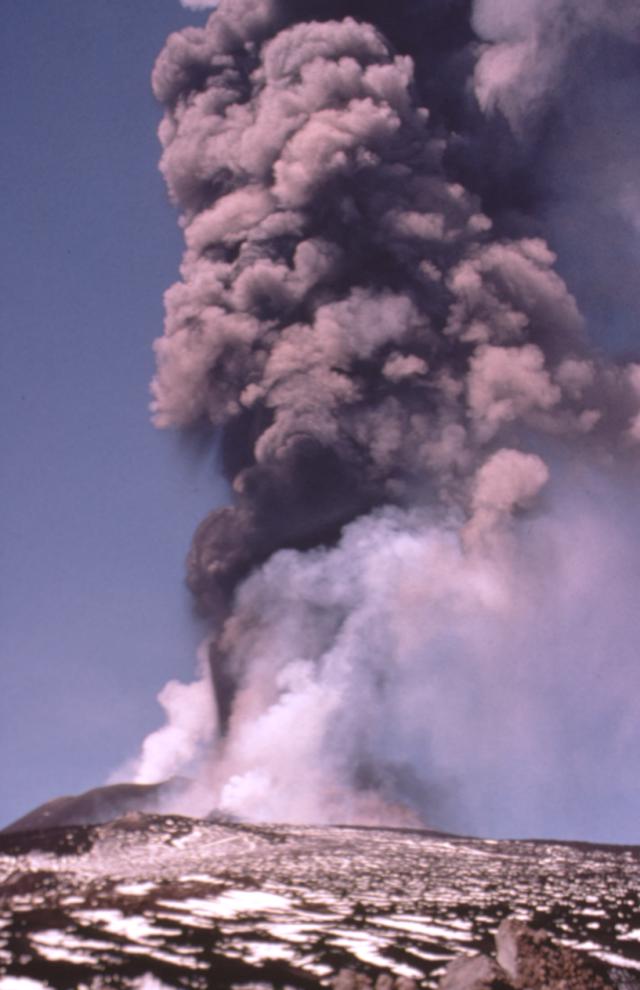 | Figure 84. Eruption column from the Southeast Crater of Etna at about 1437 on 16 April 2000. White plumes are coming from Bocca Nuova on the left and the Sudestino spatter cone in the middle foreground. The Southeast Crater cone is completely obscured by the dark eruption plume. Photo courtesy of Jean-Claude Tanguy. |
Southeast Crater eruption on 26 April. On the morning of 25 April, whitish fumes occurred intermittently at the SEC, changing after 1340 to small emissions of brownish ash. At nightfall a small glow was seen at the N foot of the SE cone, heralding a sluggish lava flow that had slightly increased after midnight. At 0615 on 26 April the SEC showed strong emissions of white vapors and brownish ash, and a new eruption began at 0655. It culminated towards 0705 with lava fountains several hundred meters high, and ended at 0720. Although the jet of material was apparently vertical, bombs up to 0.5-1.0 m in diameter fell S of the Torre del Filosofo refuge. The fissure on the S flank of the SE cone reopened and emitted a fast lava flow that rapidly reached the area around the 1971 cone and was still active at 0845, but the Sudestino vent remained inactive. A large plume of cinders and juvenile ash drifted towards Monterosso and Fleri on the SE flank.
Aircraft encounters tephra-fall on 26 April. Additional information about this eruption was furnished by Charles Rivière and Robert Clocchiatti, who witnessed the event from a small distance, Giuseppe Scarpinati, who lives in Acireale on the SE flank, and other sources. According to Rivière, the strongest portion of the eruption began at 0655, when lava fountains rose hundreds of meters. A tall eruption column rapidly rose several kilometers above the summit, forming a dark mushroom-shaped cloud of gas and ash. The plume was then carried to the SE, in the direction of Viagrande (which received a heavy shower of scoriaceous lapilli) and Acireale (where abundant pea-sized lapilli fell). From Catania the plume passing just slightly to the N filled about half the sky and blotted out the rising sun.
At 0739 on 26 April, shortly after the end of the main eruptive phase, an Air Europa Airbus 320, which had departed from the Fontanarossa International Airport of Catania in the direction of Milan, entered the fallout zone of the plume at an altitude of ~1,000 m. Apparently the aircraft received windshield damage (scratches but no breaks) caused by impacts of scoriaceous lapilli and was forced to return immediately to the airport in Catania. Passengers told news reporters that it seemed that the airplane entered a zone of turbulence, causing it to vibrate strongly, and then it seemed as though something was scratching one of the side windows, "as if it were hit by a sharp object." According to some news reports the pilot soon informed the passengers about a "technical problem" and told them everything was under control, and that they were to return to Catania. Other sources reported that the passengers did not note anything unusual until the pilot advised them of the return. It is not clear why the airliner ended up under the plume. The eruption had been visible from the airport as well as from all over eastern Sicily, and it occurred quite some time before departure. The pilot said that he did not see the plume ("It was invisible, certainly not a black cloud"), and to his knowledge it had been drifting in the opposite direction. However, the plume was reportedly quite dark as seen from Catania by residents.
This incident is the first of its kind reported at Etna, which is mainly known for low-explosivity emission of voluminous lava flows during flank eruptions. Summit activity on the other hand, is often much more explosive, and this has been the case particularly during the past five years, a period of intense summit activity. In this period nearly 100 episodes of powerful explosive activity generating significant tephra columns have occurred at all four summit craters. SEC generated 51 in the previous three months.
Southeast Crater eruption on 5 May. In the early morning of 5 May, the gaseous emissions of the SEC occurred in pulses similar to those preceding the previous emission. After a small brownish cloud erupted at 1050, weak Strombolian explosions began deep within the SEC main vent, throwing bombs 30-40 m above the crater rim. Soon after 1700 the explosions gradually increased in strength, sending bombs 100 m high. Lava fountains rose to more than 600 m between 1940 and 1955, burying the entire cone under a layer of incandescent material. The eruption stopped abruptly a few minutes later. Lava flows appear to have erupted only on the N side. The tephra fall covered a large sector of the SE part of the mountain. Most of the largest bombs, up to 1 m across, fell in a direction 120° from the SE cone as revealed by a field study of impacts of ballistic projectiles. The Belvedere zone on the rim of the Valle del Bove depression, at 2,760 m elevation and 2 km away from the SEC, was covered by a 10-cm-thick layer of lapilli, cinders, and bombs up to 30-40 cm in diameter. According to R. Basile, bystanders near Monte Zoccolaro, ~7 km from the SEC, had to protect their heads from scoriae, some of which exceeded 10 cm in diameter.
Southeast Crater eruptions on 15 May. According to Etna guide Alfio Ponte, lava began again to flow from the N side of the SE cone late in the evening of 14 May, while Northeast Crater (NEC) displayed Strombolian activity. A fissure seemed to have opened between the NEC and SEC in the early morning of 15 May. At about 1200 the SEC erupted lava fountains for 20 minutes. In the meantime and afterwards the NEC continued its Strombolian explosions mixed with brown ash clouds. Later on 15 May the SEC erupted again at about 2200, with activity culminating about 2315 and then decreasing during the following hours. Lava fountains and flows occurred on the N side. As of 23 May, other eruptions were known to have occurred during the nights of 17-18 May (about 2300-2400), 19-20 May (2200-0300), and 22-23 May (0300-0535), with lava mainly flowing N from the SE cone (observations by Boris Behncke and Giuseppe Scarpinati).
Information Contacts: Jean-Claude Tanguy, Université de Paris 6 and IPGP, Observatoire de Saint-Maur, 4, avenue de Neptune, 94107 Saint-Maur des Fossés Cedex, France; Giuseppe Patané and Santo La Delfa, Università di Catania, Corso Italia 55, 95129 Catania, Italy; Roberto Clocchiatti, Lab. Pierre Sue, C.E.N., Saclay, France; Charles Rivière, C.G.E., France; Boris Behncke, Dipartimento di Scienze Geologiche, Palazzo delle Scienze, Università di Catania (DSGUC), Corso Italia 55, 95129 Catania, Italy.
December 2000 (BGVN 25:12)  Cite this Report
Cite this Report
Summary of July to November 2000 notes small lava flows, Strombolian eruptions
This summary of Sistema Poseidon reports covers the period from July to November 2000. The summit craters discharged several minor lava flows, some Strombolian eruptions, and frequent degassing. The Bocca Nuova (BN) vent was particularly active.
During July and well into August the summit craters displayed comparatively low activity. During July at BN three different vents were degassing. During July at NEC emissions came from one primary vent. Emissions were robust on 18 August, and commonly bore light-brown ash.
During late August, Southeast Crater (SEC) renewed emission of a weak lava flow from a fracture on the N side. The lava stream, which flowed into the Valle de Bove, persisted throughout 27 August, and increased progressively on the night of 27-28 August.
At 0135 on 28 August fairly sustained degassing occurred at SEC with initially violent Strombolian emissions. Beginning at about 0600, the explosive Strombolian activity changed rapidly to violent lava fountains, which generated an eruptive cloud rising thousands of meters above the summit. Ash and lapilli fell on the Etna's E slopes. This phase lasted about one hour, and was analogous to what had been observed during episodes in the first half of 2000.
The lava flow, despite appearing larger during the more violent degassing phase, moved little on its farthest-advanced fronts, which along the W face of the Valle del Bove reached to about 2,200-2,300 m elevation. Rather, the flow tended to widen in the zone between 2,800 and 2,700 m. The lava emission rate at the vent appeared to be drastically reduced at the end of this degassing phase.
A new degassing episode was confirmed on 29 August. This was characterized by its brevity and by the way in which it manifested itself, producing explosive Strombolian blasts (rhythmic expulsion of pyroclastics) rather than true lava fountains.
As frequently observed for the last episode, this one also started with a glimmer of light on the N flank of the SEC announcing the beginning of a new lava emission. Eruptive activity increased between 22 and 28 August, while the volcanic tremor first showed a modest increase at 0339 on 29 August, when sporadic explosions from the SEC summit crater began. Only after 0530 did the explosive activity reach a continuous intensity. It concluded at about 0610. Peak activity did not reach the same levels as the preceding phase, but ejected pyroclastics ~200 m above the crater rim. The finer portions were carried several hundred meters and dispersed E, without reaching residential areas.
Observations at the conclusion of the late-August explosive phase showed the new lava flow still spreading over the N flank of the SEC, but new lava had ceased venting. This new flow overrode the one from 28 August, and descended to ~2,100 m on the W face of the Valle del Bove.
The other craters in the volcano's summit area chiefly slowly emitted gas vapors, with the exception of one of BN's vents, which frequently ejected brown ash. The emission of ash from this vent intensified during the week. As September began, BN continued to produce abundant steam and ash emissions, which at times seemed aided by elevated atmospheric humidity and by infiltration of recent precipitation. This effect continued later into September.
In mid-September, BN produced generally mild degassing. During 19, 22, and 23 September nearly continuous ash emission took place. Primarily dark gray and sometimes brownish colored plumes were visible for many kilometers. For the preceding weeks these plumes had vented at two distinct crater cavities on the inside of the BN. The larger cavity lies in BN's center and discharged gaseous blue-white emissions. The smaller cavity lay near BN's internal SW wall, and it expelled ash. During this same time, as in past weeks during the month, the Voragine and Northeast Crater continued to emit abundant steam. The SEC weakly degassed from fumaroles.
October activity continued as in past months with ash emissions at the BN. These were particularly visible on 3-6 October. At night it was possible to observe light coming from the crater cavity on the inside of the BN, suggesting weak Strombolian activity. Mid-October behavior included explosive Strombolian eruptions from both crater cavities; incandescent bombs occasionally fell outside of the crater. Milder episodes occurred on 17 and 21 October. Between 24 and 29 October two stronger episodes took place.
At the Voragine and the NEC, the early days of October showed rather sustained steam emissions, in part accentuated by the first snowfalls and by the elevated humidity on the summit. The SEC displayed mostly fumarolic activity. Later, the Voragine gave off copious steam, but at the SEC and NEC weak degassing occurred.
The last days of October and the early days of November were distinguished by a decline of the explosive Strombolian activity from the two emission points within BN. Strombolian activity sent tephra ~100-150 m high, which still frequently fell outside of the BN crater.
During November, BN continued to produce modest explosive Strombolian activity that sometime spewed incandescent material of moderate size outside the crater walls. Observers continued to note two distinct cavities in BN.
In the early hours of 29 November observers noted the presence of a small lava flow at the base of the SEC. Upon close viewing, observers found that the flow gushed from the base of a fracture on the N sector of the cone at the SEC and continued downslope for ~200 m. Although lava continued to flow in the succeeding days, atmospheric conditions obscured later views of this area. No relevant activity aside from a constant steam emission occurred either at the Voragine or at the NEC during this time.
Information Contacts: Sistema Poseidon, a cooperative project supported by both the Italian and the Sicilian regional governments, and operated by several scientific institutions (URL: http://www.ct.ingv.it/en/chi-siamo/la-sezione.html).
May 2001 (BGVN 26:05)  Cite this Report
Cite this Report
Strombolian activity and lava flows during January-April 2001
As reported by Sistema Poseidon, activity at Etna (figure 85) during December 2000-8 April 2001 was characterized by episodic Strombolian blasts, steam and ash emissions, and lava flows.
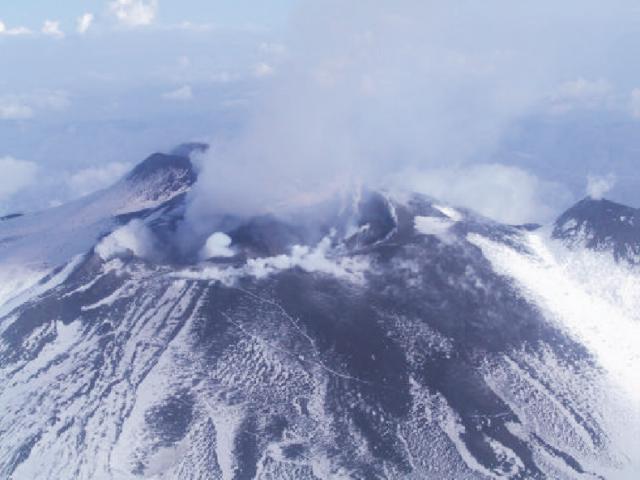 | Figure 85. Aerial photograph of Etna looking E towards the Bocca Nuova vent within the central crater on 6 December 2000. Northeast Crater is also partially visible (in the left background), as well as Southeast Crater (right). Courtesy of Sistema Poseidon. |
Minor activity during December 2000 through mid-January 2001. Low-intensity gas emissions dominated activity during this period. Observations on 6 December revealed three distinct cavities in the interior of the Bocca Nuova (BN) vent. The two near the center of the crater trended NW, were deep and full of material, and were delineated by pit-craters. The smaller cavity to the SE was encircled by a high wall of scoria; it weakly emitted light brown ash, possibly due to internal collapse. White steam emissions from BN in early January were visible during the early morning hours, and became more evident as each day progressed due to increased humidity. Sporadic ash ejections also occurred.
At the end of December, adverse atmospheric conditions prevented detailed observations, but during rare periods of visibility observers saw snow covering the W flanks of the central crater and Southeast Crater (SEC). A weak intermittent fumarolic emission emerged from the base of the fracture that runs from the SEC to the lava cairn at its base. The SEC also produced weak fumarolic emissions in early January from the W edge of the crater's summit. On the evening of 14 January a weak, diffused illumination was observed at SEC, likely coming from the E edge of the crater, where during recent months there was visible night incandescence.
Increased activity during mid-late January 2001. The BN vent produced abundant steam during the middle of January. Brown ash was weakly emitted on 16 and 19 January; darker ash ejections occurred on the 18th and 21st. Ash fell on the E flank of the volcano for five hours during the morning of the 18th, and weak illumination was visible for 30 minutes that night coming from BN. Ash-and-gas emissions increased toward the end of January. Isolated night glow suggested weak explosive Strombolian activity confined to inside the central crater. Activity alternated between visible degassing and intense phases of ash emission; one particularly acute phase occurred on 31 January.
New activity initiated from SEC on the evening of 15 January. Low-energy Strombolian eruptions were seen at night by distant observers. Activity increased in frequency during 16-17 January, reaching a maximum on 18 January when explosions occurred every 3-4 minutes, interspersed with high-energy episodes that repeated at variable intervals of ~1-2 hours. Ejected material from these events reached ~50 m high on the edge of the SEC, falling back into the crater. Strombolian activity continued through 19 January. Lava began to flow from the radial fracture cutting the N flank of the SEC beginning during the day on 21 January and persisting discontinuously until the end of the month. Intermittent flows formed several finger-like fronts. The flow reached down to ~2,800 m elevation, and remained confined to the Valle del Leone.
Strombolian explosions at Bocca Nuova during February-April 2001. During the nights of 1 and 4 February, frequent illumination was observed in the BN vent. Strombolian activity continued from BN throughout February. As during January, strong degassing and dark gray ash emissions were sporadic. High ambient humidity during morning hours made gas plumes distinct, especially on 10 February; activity was particularly consistent during 20-22 February. The fixed Montagnola camera captured images of frequent flashes from the crater interior, but activity did not extend beyond the crater area.
The BN vent produced increased explosive activity during March from two vents (W and E) inside the depression. The W vent exhibited Strombolian explosions; during some periods these were continuous and sent incandescent material just above the crater rim. A small number of lava fragments fell outside of the crater and rolled down its flanks. Explosive activity at the E vent did not eject material above the crater rim. Alternating degassing and dark gray ash emission continued as in February. Fine-grained material blown by wind fell as far as 2 km from the summit. Activity was more intense on 6 and 28 March when BN emitted copious amounts of ash from the NW and SE sectors of the crater. The Montagnola camera detected almost continuous night illumination of the crater, suggesting Strombolian activity from multiple vents. Strombolian activity also occurred from Northeast Crater, although it was rarely visible.
Strombolian activity and ash emission from BN continued throughout April. On the evening of 4 April an intense phase at the S zone of the central crater included ejection of some incandescent material above the crater rim. During 7-8 April, a slight increase in the frequency of ash emissions was observed, while night-time incandescence was sporadic.
Lava flows from Southeast Crater during February-April 2001. Early in February lava emission from the N-flank of SEC diminished; it produced modest regular lava flows for the rest of the month. On 4 February observers saw intense flashes that indicated explosive lava ejection from the fracture. Flashes and illumination visible in camera footage evidenced erratic SEC effusive activity throughout February. One early February lava flow from a vent at 3,100 m continued for several days. Bubbles frequently burst from the lava, indicating high gas content within the magma. The lava flow was ~2 m wide near the source, grew to 5 m wide toward the base, and reached an elevation of 2,900 m. During mid-February a vent at 3,150 m elevation produced a flow down a 2-m-wide canal. The flow ran N initially, but ~100 m downslope it headed E and formed a lava tube about 20-25 m wide. The flow moved toward the Valle del Bove, in the direction of Monte Sinome; it continued through the end of the month and reached 2,600 m elevation.
Through mid-March lava continued to flow from the fracture at 3,080 m elevation on the SEC's N flank. Near the vent the flow was ~1 m wide and ~80 cm deep. After having flowed less than 2 m it divided into two forks that ran roughly parallel to each other. The principal flow retained a width of ~1 m and headed N for ~100 m before deviating toward the NE and reaching an elevation of ~2,800 m. The secondary flow was about half a meter in width; it traveled at ~4 m/s near the fork and ~2 m/hour near the flow front where it spread to ~5 m across at an elevation of about 2,970 m. Effusive activity appeared to diminish on 23 March. The vent observed three days before was no longer active. A single flow was fed by a new vent about 5 m below the previous vent. A steep slope at the vent's mouth produced flow velocities of ~6 m/minute. This flow reached down to an elevation of 2,950 m, where it traveled at 1 m/hour over the flows of three days before. The flow front measured 5 m wide and 1 m high. On 30 March conspicuous white vapor issued from the SEC.
A 4 April survey of the flows revealed a moderate flow from the N flank of SEC. The vent had built up a small cone ~6 m tall at 3,095 m elevation. Two flows, each ~1 m wide and 1-2 m deep, traveled away from the cone and joined together 20-25 m away, flowing E. The flows in the two channels moved at a speed of ~0.1 m/s and an estimated 0.2-0.4 m3 of molten material emerged each second. The maximum length of the overall flow was ~350 m. During the evening of 8 April strong, persistent illumination from the E base of SEC probably indicated a new lava flow. The incandescence was distinctly visible as it reflected off of a steam plume from the summit crater.
Information Contacts: Sistema Poseidon, a cooperative project supported by both the Italian and the Sicilian regional governments, and operated by several scientific institutions (URL: http://www.ct.ingv.it/en/chi-siamo/la-sezione.html).
June 2001 (BGVN 26:06)  Cite this Report
Cite this Report
9 April-13 May activity punctuated by Strombolian eruption on 9 May
As reported by Sistema Poseidon, activity at Etna during 9 April-13 May 2001 was chiefly characterized by typical episodic Strombolian blasts, ash emissions, and modest lava flows. The larger lava flows that emerged from new vents and grew during June and July will be discussed in later reports.
Activity during mid- to late-April 2001. During this time interval ash escaped at the Bocca Nuova (BN) vent. The weather thwarted direct observations of summit activity; however, later information was obtained through outings to intermediate elevations and from La Montagnola surveillance camera.
Lava continued to flow from a vent low on the NNE flank of the Southeast Crater (SEC) cone, as it has since approximately 20 January 2001. This lava flowed down the SEC's NE flank. During the nights of 18 and 21 April observers noted that the SEC produced flashing, denoting effusive activity. The SEC also continued to give off gray-colored gas from both the fumarole on the crater's edge and from the pit-crater in the crater's interior. Later in April the SEC's N flank vent continued to emit lava variably, but generally weakly, and beginning 26 April, the flow became visible principally from the volcano's NE quadrant. During 26-28 April degassing increased at SEC, yielding abundant clouds of white steam that diminished on 29 April.
Observations on 27 April revealed two hornitos (at 3,085 m, ~3 m high, and aligned N-S). They produced steady emissions, sounds of pressurized gas, and discontinuous expulsion of vitreous and blistering lava fragments which fell within a few meters of the vents. The more northerly hornito produced a lava flow within a confined channel. At about 3,000 m elevation, this lava river divided into two branches before rejoining just above 2,900 m. In late April, the flow rate was estimated at 2-3 m3/s.
A party viewing the base of BN's crater saw two prominent, steep-sided fissures that were ~100 m in length and at least 30-50 m deep. At a shelf inside the N fissure a small pyroclastic cone gave off dense brown and reddish clouds visible from the slopes of the volcano. The fissure in the SW quadrant also degassed intensely, and both fissures gave off almost continuous noise associated with magma inferred to reside at depth. A field of semi-circular fissures was observed nearby running S and W from this depression. Observers also noted fumaroles emitting bluish gas. Until at least early May, Voragine and Northeast craters continued weak degassing.
When seen on 3 May SEC's N hornitos had grown by almost 1.5 m compared with the preceding week. The lava canal had also widened to about 2 m, corresponding to a significantly increased flow rate, 5-10 m3/s. Two small lava flows developed on the E and W sides of the hornitos.
Strombolian eruptions starting on 7 May. Strombolian activity began again at the SEC late on the morning of 7 May. When seen on 9 May these eruptions were almost continuous, as frequent as about 45-50 explosions per minute, including some strong ones that sent lava fragments 20-30 m above the crater. Lava fragments as big as a meter in diameter were thrown up to 50 m above the crater rim.
Beginning at 1400, along with a new increase in tremor, the Strombolian activity evolved into a more violent phase at 1520-1540. Ballistics landed at elevations as low as ~3,000 m, reaching the spatter rampart at the S base of the cone. At about 1630 modest lava fountaining was observed from the fracture on the N flank of the SEC. Jets of magma reached ~100 m high. The fragments emitted from the lava fountain fell mostly in the SW sector of the volcano.
At the same time, the Montagnola camera began to register frequent ash emissions from the cone's summit; Strombolian activity and ash emissions continued until midnight in a discontinuous manner and with variable intensity. Observations on 10 May showed a substantial decrease in the activity at the SEC summit. Weak explosive activity was observed from the N fracture.
The lava emission from the fracture cutting the N flank of SEC continued with more or less intense phases. On 9 May, the cessation of lava fountaining was followed by a repeat of effusive activity, still within the same area of emission, which gave rise to finger-like flows ~1.5-2 km long. On 10 and 13 May, short lengths of the active branches of the flows were observed. The outburst led to a considerable plume that impacted local air traffic.
Bocca Nuova continued to issue brown-reddish ash emissions, presumably ongoing ash-bearing eruptions from one of the fissures described above. On 9 May a new fumarolic field was seen in the S part of the Bocca Nuova, extending from the rim to half way down the cone.
Information Contacts: Sistema Poseidon, a cooperative project supported by both the Italian and the Sicilian regional governments, and operated by several scientific institutions (URL: http://www.ct.ingv.it/en/chi-siamo/la-sezione.html).
August 2001 (BGVN 26:08)  Cite this Report
Cite this Report
Strombolian activity during May and June 2001
During 14-20 May 2000, lava emission continued from the N fissure of the Southeast Crater (SEC). At about 1900 on 17 May there was an increase in the intensity of Strombolian activity and lava began to flow in several directions, forming two sub-parallel tongues toward the E. On 18 May observers noted that the lava flow emerged from a single vent at 3,156 m elevation, with an effusion rate of 2.5-4.5 m3/s. A short distance below the effusive vent, the flow divided into three branches: one to the NE, whose front flowed at about 2,700 m and reached a distance of about 1 km from the vent; the central branch flowing to the E, widest of the three with some points wider than 20 m; and one to the S, flowing below 3,000 m elevation at about 700 m from the vent. The farthest lava front was estimated to reach ~2,700 m elevation, 1.2 km from the vent. During this period, the Bocca Nuova (BN) crater continued to degas, accompanied by occasional emissions of brown ash. Also noted were a further deepening and widening of the internal crater in the BN's SE quadrant.
During 21-27 May, lava flows from the N fissure of SEC continued intermittent and variably intense Strombolian activity. Sporadic emissions of brownish-reddish ash came from the N crater of BN. Problems with surveillance cameras precluded continuous observation of the summit craters; however, on the morning of 24 May, renewed explosive activity was seen. Observations from Belevedere showed three hornitos on the N flank of the SEC, which emitted pulsing pressurized gas. The lava flow was active and well fed, with branches of ~1.5-2 km in length.
Activity at SEC increased considerably during 28 May-3 June. On 28 May, the presence of a small cinder cone, possibly having formed slowly over recent months, was discovered at the base of Northeast Crater (NEC), occupying about 2/3 of the crater floor and at least 20 m high.
At SEC, evidence of Strombolian activity was masked by discrete flows of gas and steam. The active lava field on the N flank, emerged from a main vent at about 3155 m elevation, which fed two principal flows, one to the E and one to the NE (then turning E). The latter flow formed a lava tube and then re-emerged ~100 m downstream from a small tumulus from which spewed other lava flows, the longest of which extended more than 1.5 km. The S-most branch also initially flowed partly inside a lava tube.
During the evening of 28 May, between 2222 and 2242, Strombolian activity at SEC rose sharply, with ejecta reaching as high as 50 m above the crater rim and with materials occasionally falling on other flanks of the cone. Lava flow rates on 29 and 30 May were estimated at 6-8 m3/s. Temperatures measured using a K-type (Cr/Al) thermocouple showed a maximum temperature on the inside of an expansion bulb to be of 1,065°C at 5 cm depth. Intense degassing continued at SEC for the next several days.
On the evening of 3 June two sub-parallel lava flows descended to the E, of which the northernmost was the longest and reached at least 2,600 m elevation. A few hundred meters ahead of its front, a small branch flowed N but stopped soon after. The other flow was directed toward the Valle del Bove and its advances were discontinuous. Further deepening of the two interior Voragine vents was observed. Eruptive activity was not continuous.
The W rim of BN had a very warm fissure that ran to the N. The N vent was much widened, but it was not possible to observe the base. During observations, gas explosions occurred about every 15 minutes, but it was not possible to observe the fall of ejecta. The S vent had also widened and deepened. On its SE flank, a small semi-circular vent emitted rumbling explosions every 3-10 minutes, accompanied by mostly blue-colored gas mixed with brown ash.
Although intense degassing did not permit views of the interior of the NEC, an apparently recent fissure on the N side of the cone was very warm.
During 4-10 June, two episodes of lava fountaining occurred at the SEC. The first began during the night of 5-6 June, with modest Strombolian activity at the SEC's secondary vent. At 2136 on 6 June, Strombolian activity at the secondary vent reached a frequency of about one explosion per minute, which in successive hours included the main vent as well. The activity eventually climaxed at 0145 on 7 June, when the secondary vent produced a lava fountain whose altitude reached 50 m. Falling to the ground, the stream of lava formed a primary lava flow, which immediately divided into three branches and stopped at about 3,000 m elevation. A second stream flowed to the N before turning E, reaching 2,600 m and superimposing in part on earlier lava flows. The eruptive episode concluded about 0340, with copious ash emissions from the SEC and the BN.
On the night of 8-9 June, a new eruptive episode occurred at the SEC, also beginning with Strombolian activity at 2011 at the principal and secondary vents. The activity evolved into lava fountains which reached a maximum altitude of about 200 m at the principal vent and about 80 m at the secondary vent. The strong activity continued until about 0322 and was accompanied by sustained lava emissions from the secondary vent, which gave rise to two flows which spread to the E and N respectively, superimposing themselves over preceding lava flows.
Activity at the other craters during this period was characterized by continuous degassing at the Voragine and NEC, accompanied, as in the case of the BN, by frequent ash emissions in the SE sector of the crater.
Information Contacts: Sistema Poseidon, a cooperative project supported by both the Italian and the Sicilian regional governments, and operated by several scientific institutions (URL: http://www.ct.ingv.it/en/chi-siamo/la-sezione.html).
September 2001 (BGVN 26:09)  Cite this Report
Cite this Report
Strong June eruptions, a M 3.9 earthquake, copious July-August flank lavas, and a new cone
Although Etna's early June 2001 eruptions were unusually vigorous (BGVN 26:08), still more energetic behavior followed. An earthquake swarm took place in mid-July, and large SSE-flank eruptions vented lavas in late July and early August on a scale not seen since 1983.
This report covers mid-June through early August 2001. During this interval, the highest cited lava fountains reached heights of ~ 0.7 km; ash plumes rose 3 km; lava flows stretched ~ 6 km from their source vents (largely, though not exclusively traveling due S); and people constructed earthen berms to constrain lava flows. Etna repeatedly made international news during this period. Outstanding photographs appeared widely; some may be seen on the website of Tom Pfeiffer, who graciously provided several for this report.
The text of this report came from two key sources: 1) reports by Sistema Poseidon covered the interval from 11 June-8 July; 2) a report by Jean-Claude Tanguy, Roberto Clocchiatti, Santo La Delfa, and Giuseppe Patanè for 17 July-early August. The latter group acknowledged the valuable insights from Giovanni Frazzetta of Sistema Poseidon and from local guides, particularly Alfio Mazzaglia, Antonio and Orazio Nicoloso, Alfio Carbonaro, and Giuseppe Mazzaglia. The group also received valuable contributions from Charles Rivière and Giuseppe Scarpinati.
Activity during 11 June-8 July. In the weeks of middle to late June the N-flank of the secondary vent at Southeast Crater (SEC) was very active. There were four eruptive events there during 11-17 June. Between these episodes volcanism was limited to degassing at all of the summit vents and lava outpourings from the SEC N-flank vent. Lava flows reached a length of just over 2 km, descending to elevations of 2,600 m or lower. Some lava fountains were accompanied by brown ash emissions for periods of 10 minutes to several hours. Each fountaining episode commenced with 5-11 hours of buildup, followed by more intense events lasting ~1 hour. Observers in a helicopter on 17 June saw a widening of the interior of Bocca Nuova (BN), primarily in the W sector extending ~20 m back from the former crater rim.
During 18-24 June SEC's N-flank vent produced three vigorous eruptive episodes. The first episode began about 1700 on 19 June and increased gradually in intensity. At 2040 the lava fountains reached ~ 700 m high; these diminished at about 2110, and after 2130 the episode ended.
A second N-flank SEC episode began at about 1700 on 22 June. At 1730 lava fountaining reached a height of ~ 200 m accompanied by brown ash, possibly indicating that the vent had widened. At about 1750, the lava fountain at the secondary vent produced jets up to 10-20 m and lava spattering from the N base, which ultimately widened the lava field. During this time the lava fountain from SEC increased to 300-400 m high. The associated reddish ash plume rose 1-2 km above SEC. At 1800 on 22 June lava fountaining became almost continuous, but without a continuous ash column. At 1810 the ash plume rose to over 3 km, with the quantity of ash in the plume increasing gradually; lava emissions from the secondary vent increased simultaneously. The event diminished rapidly after 1835.
The third episode began on 24 June with a small lava emission at the base of SEC. Unlike the preceding two episodes, this one began with consistent ash emissions from Northeast Crater (NEC), beginning about 1654 on 24 June with pressurized pulses that formed a plume ~1 km high at about 1700. Ash emissions continued for the next few hours and at 1815 Strombolian eruptions began again at SEC. At 1930 explosive activity began at the secondary vent on the N flank of SEC. At 2000 the explosive activity spread to the whole fissure. Lava emissions increased rapidly, and at 2015 lava fountains reached 200 m high. Lava flows at 2045 reached a length of ~ 2-3 km. The episode peaked at about 2030, diminished visibly at 2115, and had ended completely by about 2250.
SEC generated its tenth eruptive episode of the month on 27 June. The strongest part of that event took place during 2120-2200, with Strombolian activity becoming more intense and lava fountains at the summit reaching 400-500 m high. This event ended about 2300. Another event at SEC took place on 29 June, with flashes coming from the NE flank. At NEC, mixed ash and gas emissions continued. A continuous plume was produced over the summit of the volcano, variable according to the wind intensity and extending for a few hundred meters.
During 2-8 July, explosive Strombolian episodes continued at SEC. The periods between events were calm. An eruptive episode on 4 July began with slow lava emission from the N-flank secondary vent, followed by increased Strombolian activity at the summit. Explosions were discontinuous but violent, with fragments of incandescent magma ejected 150-200 m above the crater rim. The secondary N-flank vent produced less explosive activity. The intensity peaked at about 2100 when lava emerging from the summit vent of SEC reached a height of 50-60 m, and explosions sent ejecta to a height of ~400 m. At this time, a lava flow reached a length of ~2 km to the E, heading toward the Valle del Bove. Beginning at 2150 on 4 July, the Strombolian explosions became progressively less frequent although at that time the lava flow was being vigorously fed.
A few days later, tall ash plumes appeared. Activity began on 6 July with the reactivation of the then slow-moving lava flow emerging from SEC's N-flank secondary vent. At about 0600 copious degassing was seen at the SEC, accompanied by sporadic Strombolian explosions. At 0745 an ash-rich eruptive cloud containing lapilli rose 500-600 m. The plume blew E and SE and continued to ascend to 1.5-2.0 km above the crater area. One of the larger outbursts during the reporting interval, the eruption produced widespread ashfalls in the areas of Milo and Zafferana Etnea to Aci Castello and the northern limits of Catania. At about 1000 the explosions became progressively less frequent and strong. The lava flow continued to be well-fed and reached a maximum length of more than 2.5 km. The lava front reached nearly to the base of the W face of the Valle del Bove, not far from Monti Centenari. From 1050 on, the explosive phase diminished, although the lava flow was well-fed until about 0700 on 7 July.
Early on 13 July the 14th SEC event was accompanied by an impressive earthquake swarm, which included a M 3.9 shock felt to the SE, particularly in the coastal town of Acireale. More than 2,000 shocks were recorded during the following two days. Meanwhile, fissures appeared and gradually enlarged on the upper S flank along the 1989-91 fracture zone, a place where unusual fumarolic activity had previously been observed.
Activity during July-August 2001: S-flank fissures. On 17 July another strong eruption from the SEC was followed by lava venting from a fissure near 3,000 m elevation. This spot lay just below the "Sudestino," a small parasitic vent that had appeared last year at the S base of the SE cone, and where incandescence had persisted at a depth of a few tens of centimeters. Weak explosive activity quickly formed small hornitos, and lava flows proceeded SE towards the Valle del Bove depression. In the afternoon of the same day new vents appeared between 2,800 and 2,700 m elevation, along a trend oriented SSW. These vents emitted lava fragments and moderate lava flows that began to invade the area of the upper cable-way station at 2,500 m elevation.
On 18 July at 0120 another new vent opened to the S at 2,100 m elevation. This vent appeared just beside the Sapienza refuge and the lower cable-way station, ~ 200 m upslope from the famous Mt. Silvestri (cinder cones born in 1892 and subsequently visited by millions of tourists). This vent produced a low lava fountain. A sluggish lava flow gradually grew and traveled W of Mt. Silvestri, threatening a restaurant and cutting the SP 92 road. This became the main lava flow that headed S in the direction of Nicolosi, a village 10 km away at 700 m elevation.
On 19 July at about 1800 an explosive vent appeared near 2,600 m elevation above the Montagnola (a large cinder cone born in 1763, which still dominates the landscape and towers over the Sapienza tourist complex). The Montagnola vent area sometimes contains a small ephemeral crater lake that is variously called "Cono del Lago," "Cratere del Lago," and "Montagnola 2" (M2). M2 is ~3 km S of SEC. On 19 July the M2 vent released dense clouds of fine ash that disturbed people on Etna's E and S sides.
On 20 July the fracture zone extended northward, cutting across and beyond the SEC summit. Where it descended the other side of the mountain, it formed a strange, curved fissure that opened at 2,650 m elevation, forming a vent. The fissure followed the northern base of the Valle del Leone depression. This vent emitted a moderate lava flow and built a small hornito.
The climax of the eruption was reached on 21-23 July when phreatomagmatic activity from the M2 vent fed an impressive and continuous ash plume (figure 86). The plume interrupted air traffic at Catania airport and caused disruptions as far away as Syracuse, 100 km S of Etna. By this time the main lava flow from the 2,100-m vent (figures 87 and 88) had reached 1,030 m elevation, ~ 6 km from its source and 4 km from Nicolosi. However, no concern was raised for the little town as the lava fronts had practically stopped advancing on the gentle slope and the effusion rate remained moderate (5-10 m3/s).
 | Figure 86. An overview of the scene at Etna during the 2001-eruption climax, which took place on 21-23 July. The upper ash column rises from M2 at the far side of Montagnola. The lower, smaller series of plumes rise from the 2,100-m vents and associated lava flow. This shot was taken on 23 July from astride the 1983 lava flow (foreground) and the Sapienza tourist complex, a facility that sits at ~ 1,900 m elevation on the S flank (buildings on the right). The camera was aimed towards the N to NE. Courtesy of J.C. Tanguy. |
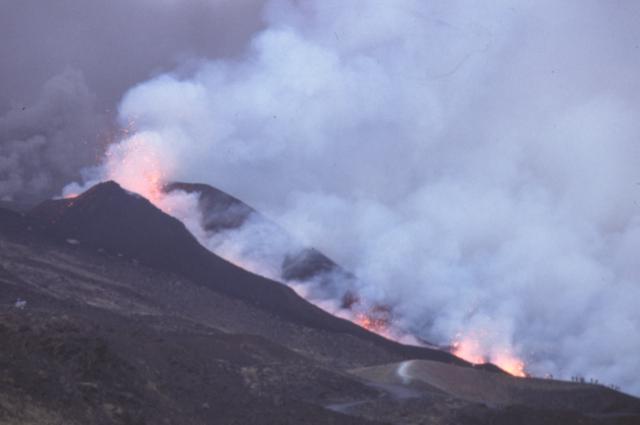 | Figure 87. A fissure vent erupting at Etna after sunset on 23 July. The venting occurred at 2,100 m elevation and remained moderate. The scale can be appreciated by noting the row of photographers silhouetted by the plume in the photo's lower right corner. View is towards the E. Courtesy of J.C. Tanguy. |
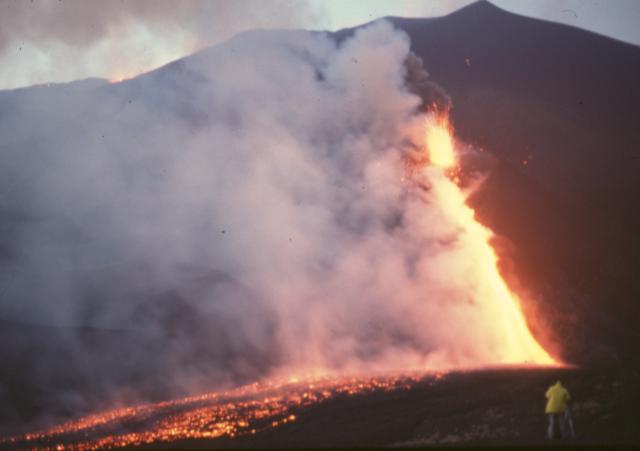 | Figure 88. The main lava flow from Etna's 2,100-m vents. Montagnola lies in the background. The photo was taken from Mount Silvestri with the camera pointed N. Courtesy of J.C. Tanguy. |
The Sapienza complex at 1,900 m elevation was more seriously threatened by lava flows. Some of these flows had originated at the 2,700 m vents, and later from effusive vents at the lower base of M2 (near 2,580 m elevation on 26 and 31 July). Earthen barriers protected the buildings; however, the complex was left in a vulnerable hollow between the new lava flows on the E and the 1983 flows on the W.
The highly explosive M2 vent at 2,600 m elevation created a big show beginning with black ash mixed with a few incandescent materials forming jets with the elongate shapes of Cypress trees (figure 89). On 25 July the activity turned magmatic, quickly building a scoria cone ~ 97 m high (based on post-eruption range-finder and altimeter measurements that yielded summit and lower SW base elevations of 2,674 ± 3 m at 2,577 ± 5 m, respectively).
 | Figure 89. This scene of a ~ 200-m-tall fountain of lava and associated plumes appeared at Etna at about 1600 local time on 24 July 2001. The fountain emerged from a 150-m-wide crater formed along a fissure at ~ 2,500 m elevation near the summit of the new cone called "Cono del Lago" or "Montagnola 2" (M2). The viewpoint was the cable car station at 2,600 m elevation that was destroyed in an earlier eruption. The photographer was ~ 400 m SE of M2; he used a 90 mm lens. Copyrighted photo provided courtesy of Tom Pfeiffer. |
A second climax was reached on 28 July when powerful explosions hurled car-sized lava lumps in a radius of over 500 m. These seriously damaged the upper cable-way station and rattled windows all around the volcano (figure 90).
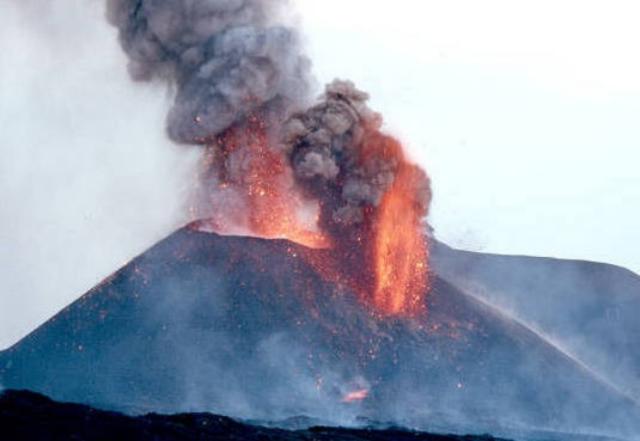 | Figure 90. At Etna, a photo taken on 28 July captured the newly formed M2 cone discharging molten material from two vents. One vent was at the summit; the other was on M2's NW flank. The next day, Tom Pfeiffer and other photographers saw at least five points of simultaneous discharge. Copyrighted photo provided courtesy of Tom Pfeiffer. |
The eruption's waning stages began 1 August. Ash became more and more abundant from the M2 vent, but was driven by considerably decreased pressure. Effusive activity had practically stopped at the 2,580-m-elevation vents. On 2 August both explosive and effusive activity ceased at the 3,000-m-elevation hornitos, and activity began to decrease along the 2,700-m-elevation fissure, except for the lava flow, which remained well fed and headed SW. At the M2 vent ash emissions practically ceased on 6 August and at the 2,100 m vents the last lava flow was observed on 8 August.
This eruption appeared quite unusual in a number of ways. The flank fissure always remained active throughout its entire length, from 2,100 m to 3,000 m elevation and above (small lava flows were seen several times on the NE side of the SEC at 3,100 m elevation, for example, on 24 August. The explosivity of the M2 vent was exceptionally high for Etna. The lavas emitted in the upper region are almost aphyric, whereas products from the M2 and 2,100 m vents are rich in large phenocrysts, including amphibole, and contain numerous inclusions from the sedimentary basement (sandstones). Although further detailed study is needed, this fact led several scientists to suggest that the 2,600-2,100 m part of the fissure represents a separate eruption triggered by upslope activity.
Information Contacts: Sistema Poseidon, a cooperative project supported by both the Italian and the Sicilian regional governments, and operated by several scientific institutions (URL: http://www.ct.ingv.it/en/chi-siamo/la-sezione.html); Jean-Claude Tanguy, University of Paris 6 and IPGP, 94107 St. Maur des Fossés Cedex, France; Roberto Clocchiatti, CNRS and CEN Saclay, 91191 Gif sur Yvette Cedex, France; Santo La Delfa and Giuseppe Patanè, University of Catania, 55 Corso Italia, 95129 Catania, Italy; Tom Pfeiffer, Department of Earth Sciences, University of Aarhus, C.F. Møllers Allé 120, DK-8000 Aarhus C, Denmark (URL: http://geo.au.dk/).
October 2001 (BGVN 26:10)  Cite this Report
Cite this Report
Amphibole megacrysts from the 2001 S-flank eruption
On 18 July a new vent opened on the S flank at 2,100 m elevation (BGVN 26:09). Lava from that vent contained exceptionally large crystals of amphibole (Pargasite-kaersutite) reaching to 6-8 cm along the c axis and less than 1 cm along the b axis (figure 91). These megacrysts, apparently blown loose by Strombolian explosions, were weakly adhering to the scoriaceous part of the flow, most of them found as isolated crystals practically free of lava. More rarely, amphibole is not elongated and may be confused with pyroxene.
 | Figure 91. Photograph of amphibole megacrysts found in the lavas emitted during the July 2001 S-flank eruption at Etna. Courtesy of Roberto Clocchiatti. |
Acicular amphibole crystals 2 or 3 cm long were also common. In thin section, their central part contains spherical voids, which seems to indicate that the mineral grew in contact with gas bubbles. Gas present in fluid inclusions probably consists of water vapor at low density. The crystals often occur in areas with elevated silica. We presume that these areas resulted from siliceous inclusions, perhaps from sandstones, which clearly occur as inclusions elsewhere in the host lava. Other minerals included within amphibole consist of plagioclase (An85-76), olivine (Fo75), pyroxene (Wo45-En42-Fs13), Fe-Ti oxides, and numerous iron and copper sulfides. These sulfides do not resemble those from immiscible sulfur liquids within silicate melts, but are aggregates or trapped within fluid inclusions, and their compositions, mostly pyrite or copper pyrite, suggest an origin from magma cooling in a shallow reservoir.
The amphibole megacrysts are practically unzoned. They sometimes show a thin reaction rim of rhonite and fassaite within a melt strongly enriched in Si, Al, and alkalis. Microprobe analyses show that their composition is roughly that of a kaersutite close to pargasite or ferropargasite (table 8). Although kaersutite is occasionally found in ancient Etnean products, it has never been observed as phenocrysts in lavas during the past 2,000 years, let alone as such large crystals. The 2001 host lava is a K-trachybasalt whose chemical composition is practically identical to that of the lava with elevated K, Rb, and Cs content that first appeared in 1974 and started a period of stronger activity, probably linked to selective assimilation of rocks from the sedimentary and metamorphic basement (Tanguy and Kieffer, 1976, Clocchiatti and others, 1988).
Table 8. Amphibole microprobe analysis for megacrysts of the July 2001 S-flank eruption at Etna. Number of analyses was 60; oxide total was 98.79 wt. %. Courtesy of Roberto Clocchiatti.
| Amphibole | SiO2 | TiO2 | Al2O3 | FeO | MgO | CaO | Na2O | K2O |
| Oxide Percentage | 39.59 | 3.76 | 14.07 | 11.15 | 13.50 | 12.17 | 2.36 | 1.09 |
| Std Deviation | 0.36 | 0.29 | 0.29 | 0.31 | 0.20 | 0.16 | 0.07 | 0.08 |
In the present case, the amphibole megacrysts are closely linked to the early products of the 2,100 m vent, which also display numerous white sandstone inclusions sometimes reaching the size of a human head. Amphibole as well as sandstone inclusions are less frequent in the products from the 2,600-m vent and are not found in lavas from the upper vents (2,700-3,000 m elevation). Although investigations are still in progress, it may be hypothesized that the amphibole developed under high water pressure at a later stage of crystallization, probably near the sandstone roof of a small, shallow magma chamber. The recent origin of the amphibole megacrysts is also testified by their K-content, which reflects the higher K contents of magmas from the past 30 years (figure 92).
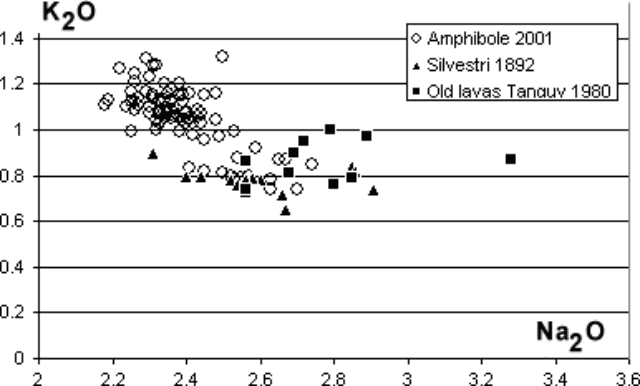 | Figure 92. A plot of K2O versus Na2O for various amphiboles found at Etna. Courtesy of Jean-Claude Tanguy and Roberto Clocchiatti. |
References. Tanguy, J.C., and Kieffer, G., 1976, The 1974 eruption at Mount Etna: Bulletin of Volcanology, v. 40, no. 4, p. 239-253.
Clocchiatti, R., Joron, J.L., and Treuil, M., 1988, The role of selective alkali contamination in the evolution of recent historic lavas of Mt. Etna: Journal of Volcanological and Geothermal Research, v. 34, p. 241-249.
Information Contacts: Roberto Clocchiatti, CNRS and CEN Saclay,91191 Gif s/ Yvette cedex, France; Jean-Claude Tanguy, University of Paris 6 and IPGP, 94107 St. Maur des Fossés cedex, France.
March 2002 (BGVN 27:03)  Cite this Report
Cite this Report
Overview of Etna's much-photographed July-August 2001 flank eruption
The last flank eruption at Etna occurred in 1993, but eruptive activity has been nearly continuous in the summit area since late July 1995. Unusually vigorous eruptions in early June 2001 (BGVN 26:08) were followed by still more energetic behavior. An earthquake swarm took place in mid-July, and large SSE-flank eruptions vented lavas in late July and early August on a scale not seen since 1983 (BGVN 26:09). Though this activity has been reported in previous Bulletin reports, what follows is a more detailed description of the summer 2001 activity.
Precursory phases. During the first half of 2001 most activity occurred at the Southeast Crater (SEC), starting with very slow lava extrusion from a vent on the NNE flank of its cone in late January. During the next three months the lava emission rate progressively increased and, in late April, weak ejections of lava fragments began to build small spatter cones (also known as hornitos) in the vent area. Strombolian activity resumed at the SEC's summit vent on 7 May, followed by an episode of vigorous Strombolian activity and lava fountaining two days later.
The activity then returned to lower levels, but for the next two months the SEC was the site of very picturesque continuous and persistent activity, with mild, discontinuous Strombolian explosions from the summit vent and vigorous lava emission (at times accompanied by lava spattering) from vent(s) on the NNE flank. At this spot, a large, steep-sided cone consisting of overlapping lava flows and spatter began to grow, and it was informally named "Levantino." From Levantino (figure 93, upper part), lava flowed NE (toward the Valle del Leone), E, and SE (toward the Valle del Bove), forming a composite lava field with numerous overlapping flow lobes. The longest flows extended up to 2 km from the vent(s). From late May to early June the continuous and relatively harmless activity attracted many visitors.
 | Figure 93. Inset map (upper left) and sketch map showing Etna's July-August 2001 lava flows, fissures, and related features. The 1983 lava flow-field on the S flank (lighter shading) is shown for comparison. The legend is also linked to numbers near the vents and fissures, as a way to indicate the sequence of activity. The pattern of activity lacked a simple spatial progression. For the time citations, note that the eruption occurred during daylight saving time (UTC + 2 hours). The sketch map is preliminary; it is a composite based on both fieldwork by Behnke and others, and already available maps appearing on the web, including those on the site of INGV-Sezione di Catania. Courtesy of Boris Behnke and Marco Neri, INGV. |
The prelude to the main eruption began in early June, with the first strong phase on 7 June, which was mostly confined to lava fountaining at the Levantino, whereas only mild Strombolian activity occurred at the SEC summit vent. During the following six weeks the vigor of the eruptive episodes gradually increased and at times culminated in true lava fountaining from the summit vent. Fourteen such episodes occurred between 7 June and 13 July (7, 9, 11, 13, 15, 17, 19, 22, 24, 27-28 and 30 June; 4, 7 and 13 July), ending with the most violent outburst of the series. Immediately after its cessation, vigorous seismicity began, including shocks that were felt as far as the cities of Acireale and Catania (figure 93 index map).
Between the early mornings of 13 and 17 July, about 2,600 tremors, mostly unfelt, were recorded instrumentally. During this same time interval, severe ground cracking and faulting occurred in various places on the W rim of the Valle del Bove and near the "Cisternazza" pit crater on the Piano del Lago ("PDL," figure 3), a flat area at ~2,500 m elevation to the N of the Montagnola. Press sources cited local volcanologists saying that magma was rising through a dike and stagnating about 1 km below the surface. Steaming was observed at some of the new fractures, but as of the late evening of 16 July no magma had reached the surface. Seismicity continued at a slightly decreased rate.
Shortly after midnight on 17 July, yet another paroxysmal episode occurred at the SEC. This was similar to its 13 July predecessor, with vigorous lava fountaining from the summit vent and the Levantino. It was the last event that could be considered part of the prelude to the main eruption. Figure 93 shows a sketch map of the lava flows that ultimately resulted from the July-August 2001 eruption. The inset at upper left shows the 2001 lavas and locations of various towns on Etna's S, SE, and E flanks.
Eruption of 17 July-9 August 2001. As defined here, the main eruption lasted nearly 24 days, from early 17 July to late 9 August 2001. It began a few hours after the last paroxysmal eruptive episode at the SEC.
An eruptive fissure opened at about 0700 on 17 July at the SSE base of the SEC at ~ 2,950 m elevation (point 1 on figure 93). Vigorous lava spattering occurred at a number of vents, while lava flows advanced toward SE, in the direction of the Valle del Bove rim. Several hours later, at 2200, another fissure opened at an elevation of ~ 2,700 m (point 2 on figure 93), a bit to the W of a panoramic point on the W rim of the Valle del Bove known as "Belvedere," and lava began to extend S from there, across the Piano del Lago, and in the direction of the cable car and ski lifts (shown by the vertical dotted line just beneath PDL on figure 93).
At 0120 on 18 July, a third eruptive fissure became active on the S flank of the Montagnola at ~ 2,100 m elevation, slightly uphill of the Monti Calcarazzi (point 3 on figure 93). Activity at this fissure was initially weak, and a sluggish lava flow began to move from the lower end of the fissure toward the Monte Silvestri superiore, a large complex cinder cone formed in 1892. During the day, the activity gradually increased; lava flowed around the W side of the Monte Silvestri, crossed the road (which connected the Rifugio Sapienza-cable car area with the town of Zafferana) and passed close to buildings. By late evening on 18 July the flow front was at 1,800 m elevation. On 19 July, the lava flow fed by the vents at 2,100 m elevation continued to pass between numerous older cinder cones along the E margin of the 1983 lava flow-field. At the same time eruptive activity continued unabated at all eruptive fissures.
On the evening of 19 July at about 1900, a new vent opened on the Piano del Lago at ~2,570 m elevation, ~ 500 m N of the Montagnola (point 4 on figure 93; "Montagnola 2", "Monte del Lago" or "Cono del Laghetto", unfortunately, all three names are in common usage). The activity was characterized by violent phreatomagmatic explosions that produced a black, ash-laden column and ejected large blocks of older volcanic rocks. This phreatomagmatic activity might have been the result of magma-water interactions with shallow ground water. (The name, Piano del Lago, the "plain of the lake," derives from the fact that frequently during the spring snow-melt a small meltwater lake had formed in that area.) To observers familiar with footage of the 1963 Surtsey (Iceland) eruption, the steam-and-ash columns rising from the new vent appeared strikingly similar. After nightfall spectacular lightning flashed through the plume and ash fell over inhabited areas including the NE, E, SE, and S flanks. Close observation of the vent at 2,570 m elevation revealed a simple, though constantly eroding, pit. Rumors spread that the pit would eventually "make the Montagnola cave in;" however, it remained intact.
The front of the lava flow emitted at 2,100 m elevation (point 3 on figure 93) was at 1,350 m late on the evening of 19 July. It still advanced vigorously, though at reduced speed (~45 m/hour). Soon after, authorities declared a state of emergency.
By the evening of 20 July the front of the lava flow had reached 1,220 m elevation, but it had slowed in a gently sloping area. Nonetheless, the threat to Nicolosi had become international news. The main risk now came from forest and bush fires. Helicopters began to drop large quantities of water onto the burning forest (not onto the lava flow, as was widely reported). Fortunately, no fires broke out. By late 21 July the lava flow's front had reached 1,050 m elevation.
During the night of 19-20 July, the SEC reactivated, and lava began to issue from the NNE side of the Levantino, forming a small flow that advanced in the direction of the Valle del Bove.
At about 1100 on 21 July, yet another eruptive fissure formed (point 5 on figure 93). It emerged on the NE flank, far away from the earlier fissures (below the Pizzi Deneri on the floor of the Valle del Leone). Figure 93 portrays the impressive arcuate fracture system that developed. The lava first issued from the fissure's uppermost portion at ~ 2,700 m elevation, then from its eastern extension ~50 m further downslope. A fracture system formed between this northeasternmost fissure and the E side of the summit crater area, and fissures up to 1 m wide opened on the slope between the Bocca Nuova and the SEC, and began emitting dense vapor plumes.
The large pit crater on the Piano del Lago at 2,570 m elevation continued to produce dense, ash-laden plumes. In late July ash fell over the area between Zafferana and Acireale (inset, figure 93).
On 21 July, the eruption continued with unabated vigor at all eruptive fissures. Late that day, the lava from the vents at 2,700 m had not further advanced on the steep slope above the tourist complex of the Rifugio Sapienza area (shown as Rif. Sapienza, figure 93).
The next day, 22 July, a shift in the wind direction drove the dense ash plume produced by the phreatomagmatic vent at 2,570 m elevation directly over the Catania area, paralyzing the city's Fontanarossa International Airport, and dropping large amounts of fine, black, sand-sized tephra over streets and buildings. Eruptive activity continued without significant variations at all fissures, although the main lava flow directed toward Nicolosi had slowed significantly and advanced only a few meters per hour, still 4 km from the outskirts of the town. That evening, minor, though fast-moving lava tongues fed by the vents at 2,700 m elevation spilled down the steep slope above the tourist complex, destroying part of the ski lifts and threatening to overwhelm some of the poles of the cable car. However, none of these flows made it further than about halfway down that slope. Vigorous Strombolian activity continued at the fissure at 2,100 m elevation, and a cone about 20-30 m high had formed around the largest of its vents, while minor lava spattering from four vents in the lower part of the fissure was building a low-spatter rampart. The lava flow from this fissure moved as a single, broad unit (point 6 on figure 93). Throughout 23 July the activity showed little variation.
On 24 July it became clear that something was changing at the Piano del Lago crater, which until then had displayed only phreatomagmatic activity. Loud detonations came from the Piano del Lago vent on the morning of 25 July, as the activity there had now become purely magmatic.
A new cone was growing on the former Piano del Lago on 26 July produced near-continuous explosions accompanied by loud detonations that could be heard ten's of kilometers away. The cone received bombs ejected from at least three vents within it. Lava began flowing from vents on its S and N sides, spilling around the N and NW sides of the Montagnola and down the steep slope on the W side of that cone toward the Rifugio Sapienza. The new lava flow passed E of the lower cable car station, covered another portion of the road and advanced a few hundred meters further. Vigorous eruptive activity continued on 26 July at the eruptive fissure at 2,950 m elevation, while the fissure at 2,700 m elevation continued to emit lava but pyroclastic activity there had ended. Weak activity continued at the Valle del Leone fissure, with lava flowing toward Monte Simone (in the N part of the Valle del Bove), and the fissure at 2,100 m elevation showed no significant changes in its activity with respect to the previous days.
During 27-30 July the eruption produced some outstanding displays (figures 94 and 95) and caused the greatest impact on human structures. While the fissure in the Valle del Leone showed ever-lower levels of activity and the fissures at 2,900, 2,700, and 2,100 m elevation continued to erupt in a manner almost identical to the previous days, the Montagnola 2 cone and several nearby vents not only provided a show, but vents on its N and S flanks delivered vigorous lava flows that spilled down the steep slope to the W of the Montagnola in surges, presenting a continuous threat to the Rifugio Sapienza area.
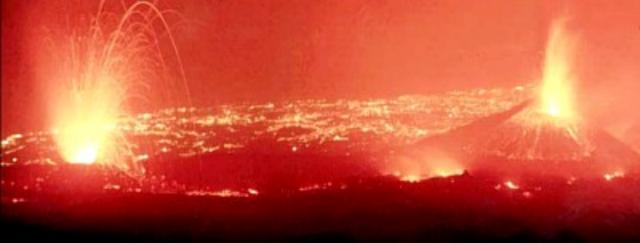 | Figure 94. At Etna, a night view taken from high on the S flanks near Torre del Filosofo documenting the erupting vents at 2,700 m elevation (left) and a lava fountain at the Piano del Lago cone (right), probably taken on 30 July 2001. The camera was aimed SE. Lights of towns between Acireale and Giarre are visible in the background. Photo was published in the 1 August 2001 issue of the "La Sicilia" newspaper. |
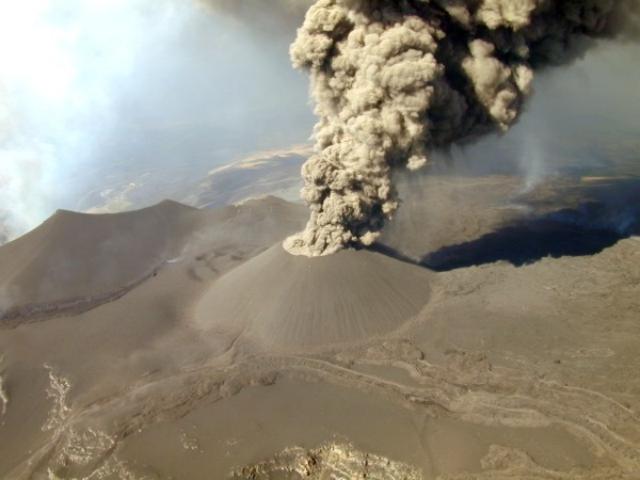 | Figure 95. Spectacular aerial view of the largest cone formed in Etna's eruption during July-August 2001, built on what used to be the "Piano del Lago" at ~ 2,500 m elevation on the S flank. View is to the SW. Most of the cone grew in a few days in late July; this photo shows the waning phase around 2 August when only ash was emitted. After the end of the activity the summit of the cone stood nearly 100 m higher than its base, but then partially collapsed leaving the cone ~ 80 m higher. To the left of the cone is the 1763 Montagnola crater. Between the two lies a fuming vent; it emitted one of the latest lava flows in the area (black ribbon extending to the left margin of the photo). Other lava flows that were emitted from vents at ~ 2,700 m elevation (out of the photo to the right) can be seen in the right foreground. Yet another lava lobe extends toward the lower left corner of the photo; it emerged at the E base of the Piano del Lago cone. Photograph by volcanologists of the INGV (National Institute of Geophysics and Volcanology); published on 6 August 2001 in the "La Sicilia" newspaper. |
A lava flow from the southern base of the Piana del Lago cone on 27 July remained active for about 2 days (point 7 of figure 93). This cone produced three distinct lava flow units from three different vents on its SW, S, and NW sides; those from the SW vent were the most damaging. On the evening of 30 July, the eruption claimed the upper cable car station, which burst into flames as a tongue of lava invaded its interior. Behind it, the rapidly growing cone of the Piano del Lago sent its lava fountains hundreds of meters into the sky, producing ground-shaking detonations.
During late July, the rate of lava emission in the direction of the Rifugio Sapienza area diminished as a new vent opened on the S side of the Piano del Lago cone, from which a lava flow spilled over the crest of the Valle del Bove and flowed to the bottom of the Valle, covering a portion of lava erupted in 1991-1993. The Valle del Leone fissure ceased emitting lava. The Montagnola 2 had become a large cone. It again shifted from magmatic to phreatomagmatic activity. Although the level of activity at this cone was decreasing, ash columns developed, and the wind carried the ash again in the direction of Catania, again closing the Fontanarossa airport. Vigorous eruptive activity continued during the first days of August at the fissure at 2,100 m elevation, but the lava effusion rate had dropped, and only the central portion of the original flow remained active, feeding a flow that advanced on top of the larger earlier flow from the same fissure. Strong phreatomagmatic explosions occurred from time to time at the upper vents on this fissure. Lava also continued to pour from the fissure at 2,700 m elevation, and numerous active flow lobes extended SE toward Monte Nero.
Beginning on 3 August the activity at the fissure at 2,100 m elevation showed a marked decrease. During the last week of the eruption (4-10 August) lava continued to flow from that fissure at a rapidly diminishing rate, explosive activity ended, and the fissures at 2,950 and 2,700 m elevation ceased erupting. Ash emission from the Piano del Lago cone ended around 6 August. Lava was last seen flowing from the fissure at 2,100 m elevation on late 9 or early 10 August. The eruption ended after almost 24 days, much earlier than its vigorous onset had suggested.
Products of the eruption and morphological changes. The July-August 2001 eruption emitted at least eight distinct lava flows which mostly affected the S and SSW flanks of Etna. The most damaging flows came from vents near the Piano del Lago cone at 2,570 m elevation. This cone produced most of the pyroclastic material, of which the most fine-grained portion (ash) caused widespread distress.
Petrographically, the lavas fall into two main groups, one of which is essentially similar to the historical products of Etna (porphyric hawaiites with phenocrysts of plagioclase, clinopyroxene and olivine), while the other shows characteristics not seen in any Etnean lavas during the past millennia (alkalic basalts).
Several major pyroclastic edifices grew during the eruption. The largest, the Piano del Lago cone at ~2,570 m elevation, is a nearly symmetrical cone, ~80 m high, which grew mostly between 25 and 31 July. It is crowned by a large crater ~150 m across and 50-60 m deep with near-vertical walls. During a visit on 30 August a few fumaroles located on the SEC walls emitted vapor and gas without forming a visible plume. A spectacular dike was exposed at the base of the E crater wall, and a less conspicuous dike was visible at the base of the WNW crater wall. Several faults or groups of faults were visible in the E and NE crater walls; a narrow graben developed on top of the E crater wall dike. The second-largest pyroclastic edifice lies in the upper part of the fissure at 2,100 m elevation.
Extensive (non-eruptive) fracture systems formed between the various eruptive fissures. Some of them began to form before the eruption, others developed during its first week. Many of these fractures are arranged in an en echelon pattern, which is especially notable in the Valle del Leone, between the northeastern (2,600 m) vents and the SEC. Other spectacular fractures opened between the Piano del Lago cone and the eruptive fissure at 2,100 m elevation. However, the most impressive fractures developed on the E side of the former Central Crater (now occupied by the Voragine and the Bocca Nuova), where they attained widths of more than 1 m. These fractures were vigorously steaming when visited in late-August and mid-September 2001. Fracturing also affected the southern face of the SEC cone.
About 5.5 km2 of Etna's upper and middle slopes were covered with new lava (compared to 7.6 km2 in the 1991-1993 flank eruption). The total volume of lavas and pyroclastics emitted during the eruption is ~ 30-35 x 106 m3 (25 x 106 m3 of lava and 5-10 x 106 m3 of pyroclastics, all calculated as dense rock equivalent), which makes this eruption a relatively modest-sized one for Etna (the 1991-1993 eruption had produced ~ 235 x 106 m3 of lava). Yet the fairly high proportion of pyroclastic material distinguishes this eruption from most other recent Etnean flank eruptions.
The most productive vents were those at 2,100 m elevation, which produced the longest (~ 7 km) and most voluminous (slightly less than 14 x 106 m3) single lava flow. The average combined effusion rate at all eruptive fissures throughout the eruption was ~11 m3/s, with peak rates of 14-16 m3/s. It is assumed that much of the magma that accumulated in one or more reservoirs below the base of the volcano in the years preceding the eruption was not erupted and remains available for future eruptions.
Information Contacts: Boris Behncke, Dipartimento di Scienze Geologiche (Sezione di Geologia e Geofisica), Palazzo delle Scienze, Corso Italia 55, 95129 Catania, Italy.
April 2002 (BGVN 27:04)  Cite this Report
Cite this Report
Nine months of relative quiet follow mid-2001 flank eruption
This report discusses Etna following the July-August 2001 eruption and through 25 April 2002. According to Boris Behncke, the chief source for this report, this 9-month interval was an unusually quiet one and marked the longest quiet interval since 1995.
A visit to the summit craters on 30 January 2002 revealed low levels of activity and no evidence of energetic outbursts. Loud explosions occurred at intervals of 5-30 minutes within the NW pit of Bocca Nuova, but no solid material was ejected. The rims of the pit were covered with brown lithic ash (which had been emitted in December-January) but there were no blocks or fresh scoriae indicating recent ejections. The pit appeared much the same as in September 2001, with a crescent-shaped flat terrace surrounding a deep, degassing vent in the SE part of the pit.
Most of the present degassing at the summit craters is occurring from a vent in the SW part of the Voragine, which had been much less active during the past 1.5 years. Northeast Crater emitted a fairly dilute plume, and at Southeast Crater, fumarolic activity was concentrated at its W rim where numerous degassing vents lie in a fracture. Mechanized access remained limited after the demise of the cable car and the ski lifts on the S flank during the July-August 2001 eruption (BGVN 26:08 and 27:03). In order to access the summit area one has to hike from ~1,900 m elevation, a trip that takes several hours and leads across the July-August 2001 lava fields.
Numerous small earthquakes, some of which were felt by the local population, were recorded on the S flank (in the area of the largest of the July-August 2001 lava flows), and were interpreted to result from the cooling of the lava. Near-continuous, pulsating emissions of reddish-brown lithic ash began around 9 March at the NW vent of Bocca Nuova, generating a plume that trailed for dozens of kilometers downwind. The same source vent has been the site of deep-seated explosions during the past six months. The emissions may have been caused by collapse within the conduit, which occurred repeatedly after the end of the July-August 2001 eruption, and does not necessarily indicate an intensification of eruptive activity or uprise of fresh magma. On the other hand, the volcano had been quiet for some 8 months at this time, and renewed magmatic activity at the summit was to be expected in the near future.
During the third week of March, emissions of lithic, pink-colored ash continued at Bocca Nuova. These were accompanied by voluminous degassing from Northeast Crater and minor fumarolic activity from Voragine and Southeast Crater. During days without strong wind, these emissions rose vertically to form a spectacular plume that might easily create the impression of true eruptive activity at the summit. However, there is no evidence that fresh magma has risen to near the surface, because no incandescence can be seen at night.
A mid-March summit visit by Giovanni Tomarchio, a cameraman of the Italian television RAI (who is responsible for much of the television footage of Etna in recent years), revealed frequent loud explosions at the SW vent of Bocca Nuova. Although the floor of this vent was not visible, it seemed that the explosions originated somewhere immediately below the visible part of the pit. All recent ejecta were fine lithic ash, which accumulated to form a thick, soft deposit in the summit area. Similar emissions occurred for months at Bocca Nuova during the spring and summer of 1999, prior to the vigorous eruptions at Voragine and Bocca Nuova during September-November of that year.
In late March, after nearly three weeks of ash emissions from Bocca Nuova, Northeast Crater began to emit dark brown to gray ash. The emissions appeared to follow a series of small SE-flank earthquakes during 24-25 March. At least three of the shocks were felt by the local population. On 27 and 28 March the ash emissions from both Bocca Nuova and Northeast Crater rose as distinct puffs to several hundred meters above the summit and seemed more energetic, denser, and darker than during the previous weeks. To a passing airplane pilot they appeared so spectacular that he sent out a warning of an eruption. On 28 March, light ash fell over the S flank as far as Catania (~25 km SSE).
Whether Etna is back in magmatic eruption is the subject of debate. The ash that came from the two craters consisted of fine-grained fragments of rock and was derived from the conduit walls and thus contained no new magmatic material. The ash that fell in Catania on 28 March was distinctly darker than the ash that fell in the summit area during the previous weeks and may contain a certain proportion of juvenile magmatic material, although microscopic examination has not been conducted to confirm this. No glow has been seen so far at the summit during night observations, so it seems unlikely that magma has reached the surface. On 29 March two impressive columns bearing dark ash rose nearly continuously from the two craters to several hundreds of meters (~800 m at one point) above the summit. Shifting winds carried the plume E, S, and W.
During late March through 2 April ash emission continued without interruption from Bocca Nuova, while at Northeast Crater it had apparently stopped. Light ashfalls occurred in downwind areas, at times extending as far as Catania. The emissions took the form of billowing brown plumes, which at times rose several hundred meters above the summit. No incandescence was seen at night. Weather prevented observations after the afternoon of 2 April.
The summit became visible again on 6 April. Bocca Nuova continued to produce weak expulsions of brown-colored (probably lithic) ash, while Northeast Crater emitted only white vapor. Two small (M ~3) earthquakes occurred under the SE flank on 4 April. On 13 April two earthquakes (M 2.7-3) were felt by residents on the SE flank (between the towns of Zafferana and Santa Venerina), their epicenters lying in an area named "Salto della Giumenta," located ~5 km NW of Zafferana. Press sources citing scientists of the Istituto Nazionale di Geofisica e Vulcanologia of Catania gave focal depths of ~4 km below the surface. Numerous earthquakes had occurred within the past few weeks in this area, although their correlation with magma movement within the volcano remained unclear.
Ash emissions continued almost constantly at Bocca Nuova. On 14 April these appeared to be dark gray, and at times were emitted forcefully enough to form plumes several hundred meters high. No incandescence was seen during night observations. A dense plume of brownish-gray ash drifted from Etna's summit across the E sky of Catania as Bocca Nuova emitted pulverized rock from its SE vent. Voragine and Northeast craters gave off dense steamy plumes.
In late April heavy snow fell on Etna; snow-cover reached down to ~1,400 m elevation and access to the summit area was reduced. The snow provided a good opportunity to observe the hot areas at the summit and to confirm that no recent lava outflows have taken place. Snow was melting rapidly on the cones of the summit craters and along the fracture that extends NNE from Southeast Crater. Since 23 April, Bocca Nuova's ash emissions, which had been nearly continuous since early March, decreased markedly. The only visible summit activity during 24-25 April consisted of apparently ash-free gas emissions, mostly from Bocca Nuova and Northeast Crater. Nine months after the climax of its most recent flank eruption, Etna continues its unquiet slumber.
Information Contacts: Boris Behncke, Dipartimento di Scienze Geologiche (Sezione di Geologia e Geofisica), Palazzo delle Scienze, Corso Italia 55, 95129 Catania, Italy.
August 2002 (BGVN 27:08)  Cite this Report
Cite this Report
Generally weak activity at summit craters during mid-May through July 2002
This report discusses activity at Etna during mid-May through July 2002.
Northeast Crater (NEC). During mid-May, weak degassing continued at NEC with sporadic mass wasting along the inner crater walls. There were abundant fumaroles on the crater floor and Strombolian activity was also confirmed. Intermittent degassing occurred during 3-9 June and, during the following week emissions of ash continued with intervening brief periods of light-colored gas emission. Ash emission ceased on 23 June and observations by the thermal telecamera from the Civil Protection helicopter indicated that the NEC's intracrater-floor fumaroles reached temperatures of 200-250°C. Unusually high temperatures (max. 50°C) of emitted ash were seen, suggestive of Strombolian activity. The 23 June observations indicated higher temperatures than earlier results in April 2002.
On 26 June, observers again confirmed emissions from deep within the NEC. The base of the crater was not visible, but was believed to be ~100-150 m below the rim of the intracrater floor. During one of the more vigorous outbursts, tephra spattered over the internal rim of the crater, allowing visitors to take a sample. Outbursts on 1 July threw fragments of incandescent lava outside of the crater walls. Similar ejections occurred at NEC again on 5, 6, and 7 July and continuing into the following week. The most intense explosions could be heard at the base of the cone and were accompanied by pulsing clouds of fine ash. On 9 July, ash emissions diminished significantly. On 11 July there were puffs of ash at the NEC. The rim of the crater and the high outer western slope of the cone was littered with bombs. Some bombs close to the crater rim reached dimensions of ~50 cm across. The steam and ash hindered visibility of NEC's interior. During the third week of July, ash emission stopped for the first two days of the week. Helicopter observations on 20 July found that NEC contained copious fresh ash. During the last week of July, continuous and sometimes intense white steam emissions occurred.
Bocca Nuova (BN). During mid-May, BN degassed normally, in a pattern that continued intermittently through mid-June and later. At times, emissions were dark-ochre colored. While the S vent degassed, the N vent emitted ash. On 26 June, ash emissions interfered with visibility of the two internal craters as well as the crater floor, but the activity was not accompanied by audible gas releases. During the first week of July there was an almost continuous and significant increase in the amount of ash emitted but again no rumbling. On 9 July, ash emissions diminished significantly, and remained at these levels, albeit with oscillations. Two days later, at the W crater, degassing was accompanied by a weak emission of ash. The crater had a diameter of 150-200 m and was more than 180 m deep, dropping the initial 70 m from the rim in a steep step. Fresh material could not be found near BN's rim. The E crater had a diameter of ~150 m and a depth of more than 160 m. On the same day, thermal measurements of the fumaroles on the rim between the Voragine and BN's E crater saw temperatures oscillating at ~450°C. During the third week of July, ash emission stopped for the first two days of the week but returned by 20 July.
Voragine. During mid-May, the two interior vents, one central and the other on the rocky division between Voragine and BN, degassed in a continuous and pulsating way and the Voragine's crater rim showed more intense fumarolic activity in the NW and S. During 3-9 June, Voragine's emissions were weaker than NEC and BN, consisting of steam, with rarer darker emissions of fine ochre- and black-colored ash. In mid-June, the two vents showed continuous and pulsating degassing. The rim of the crater displayed more intense fumarolic activity in the NW and S sectors. Snow-covered areas were still present inside Voragine through late June.
Discontinuous ash emissions occurred during the first week of July. On 9 July, ash emissions diminished significantly, and remained at these levels, albeit with oscillations. During the second week of July, the Voragine continued to degas while accompanied by a pulsating emission of ash from the vent in the most depressed part of the crater. Minor ash emissions were observed through 20 July, but by the last week of July, no Voragine emissions were visible from the Milo telecamera.
Southeast Crater (SEC). SEC, the origin of the strong eruptive episodes of July and August 2001, showed virtually no activity during the current reporting period; the interior was reported to be completely obstructed. In early June, there were localized fumaroles with white emissions on the rim of the crater. Otherwise, there was no degassing, except for some weak fumaroles in the NW portion of the crater rim noted in mid-June. In late June, weak fumarolic activity persisted at the edge of the crater summit and along the fracture running N-S on the flanks of the pyroclastic cone of the SEC. In the last week of July, the Milo telecamera revealed only weak gas emission from the SEC's border fumaroles.
Thermal images of summit craters. Thermal images registered at dawn on 20 July by helicopter surveillance without solar radiation interference showed a midbase temperature (max. 100°C) at all the fractures surrounding the summit craters. The field of the fracture that extended S from the NEC, skirting the Voragine before reaching the SEC, appeared enlarged and extended also to the N flank of the NEC. However, no significant thermal anomalies were noted in this field.
Information Contacts: Istituto Nazionale di Geofisica e Vulcanologia, Sezione di Catania, (INGV-Catania), Piazza Roma, 2, 95125 Catania, Italy.
October 2002 (BGVN 27:10)  Cite this Report
Cite this Report
A flank eruption started on 27 October; lava vented at N- and S-flank fissures
At 2225 on 26 October 2002 a swarm of earthquakes was recorded by the seismic network of the National Institute of Geophysics and Volcanology (INGV) in the Catania sector. Three hours after the swarm began, Etna started a new flank eruption. Until 1 November, ~500 shocks registered. The seismic swarm preceded and accompanied explosive activity in the summit area.
A survey at 0400 on 27 October found that two eruptive fissures had opened on Etna's N and S flanks; they were still propagating up- and down-slope when observed. Fire fountains escaped at both fissures.
At that time, lava flows started to pour from the lower part of the N-flank fissure, causing concern on Etna's N flank around Piano Provenzana. At the lower end of this fissure, two major flows spread NE and E. The NE flow stopped on 31 October after having traveled 2 km, behavior congruent with an observed decline in the effusion rate.
The E flow slowed down until 1 November, but it continued moving and crusting over in the middle portion of the flow field until 3 November. Scientists from INGV-CT conducted a helicopter-based aerial survey, using helicopters from the Civil Protection, and deploying a FLIR TM 695 thermal camera. Survey results showed a few sectors of solid crust and suggested the initial formation of a lava tube on this lava flow, which completely stopped on 5 November. The ski station and tourist shops on Piano Provenzana were first destroyed by the earthquakes, and then surrounded by lava flows. The flows also caused fire that engulfed parts of the pine forest. Flow mapping (shown on the INGV website) was limited by both the presence of fire around the flow fronts and ash clouds masking most of the flow field, and only the use of the FLIR TM 695 thermal camera allowed views of the active lava flows.
The N fissure opened between 2,500 and 2,350 m elevation, an area close to the fissure developed in the year 1809. The current N-flank fissure is a few kilometers long and expanded NE following the NE Rift Zone.
A lava flow from the S-flank fissure started ~12 hours after the N one. It spread SW and split in two branches around Monte Nero, following the same path as one of the 2001 lava branches. The S flows stopped on 31 October, having reached a total length of about 2 km. Fire fountains and phreatomagmatic activity decreased in intensity with time and disappeared at the N fissure, but were still continuing on the S fissure.
The S fissure, which opened at 2700 m elevation, traveled N20°W, and occurred a few hundred meters W of the 2001 S-fissure field, between Monte Frumento Supino and Cisternazza (a map appears at the INGV website, see below). Spatter falling around the S-fissure's vents formed two cinder cones at about 2,030 m elevation. Fire fountains from these vents were initially 100-300 m high, producing an ash plume and abundant ashfall on Etna's S flank. In 3 days the city of Catania received ~2.5 kg/m2 of ash due to strong winds from the N. This disrupted the local airport and caused problems with travel.
The high amount of gas released by the summit vents and at the 2,750-m cone (up to 25,000 tons/day), and the continuing explosive activity at the S vent, suggest a long duration for this eruptive event (figure 96).
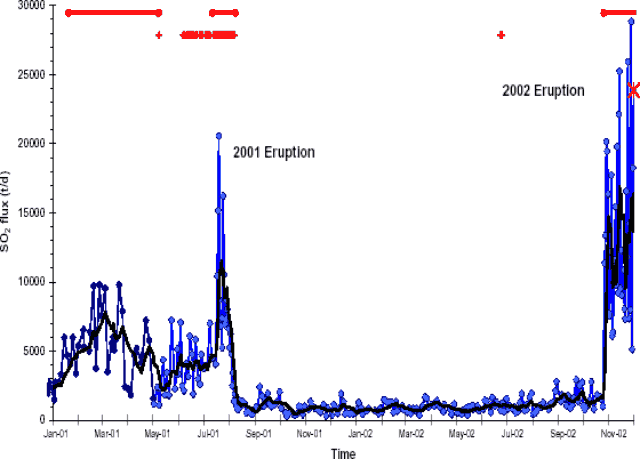 | Figure 96. SO2 released from Etna during January 2001-1 December 2002. Courtesy INGV. |
Editor's note: Summaries of Etna activity from recent issues of the Bulletin have been prepared by our staff without the benefit of crafted summaries in English. As such, the contributors found them deficient in clarity of translation. For greater clarity and more technical details consult journal publications and the INGV website.
Information Contacts: Sonia Calvari, Istituto Nazionale di Geofisica e Vulcanologia Sezione di Catania, Piazza Roma 2, 95123 Catania (URL: http://www.ct.ingv.it/).
November 2002 (BGVN 27:11)  Cite this Report
Cite this Report
Witnesses saw N- and S-flank eruptions begin at around 0200 on 27 October
After the violent flank eruption of July-August 2001, Mount Etna was rather calm for more than 10 months, except for usual fumes from the four summit craters [and minor ash emissions]. In the first days of July 2002 weak magmatic activity resumed sporadically at the NE Crater with ejection of bombs that fell on the outer slopes of the cone. On 12 September explosions occurred every 2 or 3 minutes and were violent enough to throw large spatter as far as the northern rim of the Voragine (Central Crater). However, there were many days without explosive activity and, at other times, the NE Crater emitted large clouds of brownish ash. Although a magnitude 3.7 earthquake had struck the northern flank of the volcano on 22 September, subsequent days were so calm that, to these contributors, the following events came as quite a surprise.
As the National Institute of Geophysics and Volcanology (INGV) previously reported (BGVN 27:10), a seismic swarm began to shake Etna late during the evening of 26 October 2002. One observer, Maurice Aubert, happened to be in a hotel on the northern flank (at Piano Provenzana, 1,816 m elevation). There the seismic shocks were distinctly felt after midnight and rapidly reached hazardous levels. Hours later, at 0205 on 27 October, lava fountains began to play along a fissure 1-2 km up slope, but decreased at 0220 when lava flows expanded downwards.
The seismic intensity of earthquakes felt the night of the 26th ranged from II to VII or perhaps VIII. The approximate timing and seismic intensity was recorded as follows at 0030, II; at 0140, VI; at 0200, VI; at 0320, VII; and at 0343, VII or VIII. Maurice Aubert and his group hastily retreated shortly after 0320, exiting while cracks were developing through the mountain road. The last of the above-reported intensities was felt during their departure, when a strong earthquake shook their car.
Vents at ~2,700 m elevation on the southern flank (on the Piano del Lago) are here called the S2700 vents. These new S-flank vents lay just SE of the ancient cone of Monte Frumento Supino and ~800 m NW of the Laghetto cone, which appeared in 2001.
Watching the S2700 vents, Giuseppe Scarpinati saw two lava fountains develop after 0200, together with a large ash plume that drifted S. The eruptive phenomena were accompanied by strong detonations and rumblings together with continuous earthquakes that were felt in Acireale, a town at Etna's southeastern foot.
Lava flows from the northern vents invaded and over ran the flat area containing tourist facilities at Piano Provenzana and proceeded as two branches downwards through the pine trees towards Linguaglossa, a village ~10 km to the NE. The greatest damage was not the loss of all tourist facilities at Piano Provenzana, but was instead due to heavy ashfall S of the volcano, which led to closing of the Catania airport on the afternoon of 27 October.
On the morning of 28 October the S fissure had developed at least three explosive vents. A 100-to-200-m-high lava fountain, ~200 m downslope, fed lava flows that extended by more than 2 km toward the uninhabited area of Monte Nero degli Zappini (figures 97 and 98). During the day, however, the effusive activity significantly decreased, and on 29 October the lava fronts virtually stopped on the southern side, although violent degassing at the upper end of the fissure continued unabated. Sustained release of high pressure gas fed a voluminous SE-directed ash plume that reached to more than 5 km altitude. At the same time on the 29th, a large plume of white vapor was emitted at the summit from the central crater vents (Bocca Nuova, Voragine) and the NE Crater. The SE crater, the main site of the 2001 eruption, remained entirely calm.
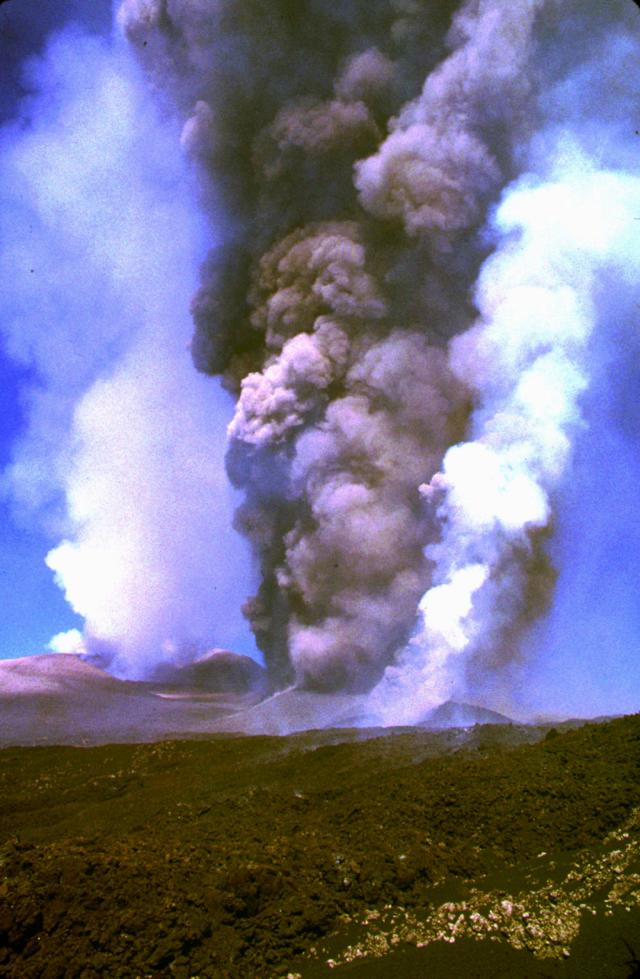 | Figure 97. Southern vents of Etna at 2,700 m elevation as seen during daylight on the morning of 28 October 2002 (taken from 2,500 m elevation looking N). The white plume on the right comes from the lava vent, and the plume in the left background is from the summit craters. Courtesy of J.C. Tanguy. |
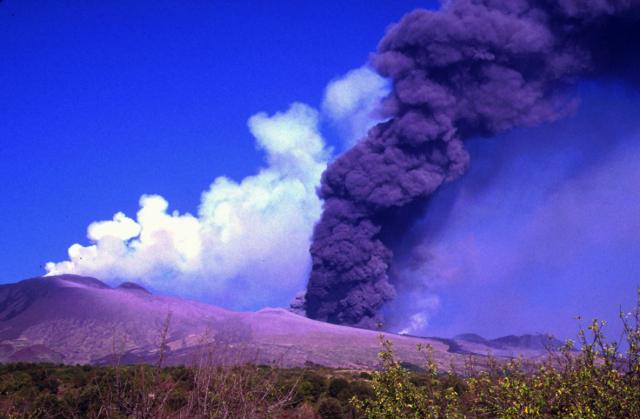 | Figure 98. Southern vents of Etna as photographed from the SW in the early afternoon of 28 October 2002. From left to right the image shows the summit craters emitting white vapor, the cone of Mt. Frumento Supino, the S2700 explosive vents giving off a dark column, the lower lava vent emitting a faint white plume, new lava flows (dark narrow band), 2001 cone, and Montagnola cone. Courtesy of J.C. Tanguy. |
Strong earthquakes on 29 October caused damage on the lower E flank of the mountain, particularly at Santa Venerina where some 1,000 people were left homeless. The main shock was recorded by Jean-Claude Tanguy in the SE region of the volcano (Trecastagni) at 17 seconds after 1102 (± 5 sec). Horizontal ground motions there lasted 7 to 8 seconds. The INGV reported the seismic event as M 4.4, located 8-9 km beneath Santa Venerina. Other strong shocks at 1739 and 1814 (M 4.0 and 4.1) caused walls to collapse along the road between Zafferana and Milo.
On 30 October soon after midday the Bocca Nuova vent began to emit large clouds of brownish ash. This activity culminated between 1310 and 1320, and the ash cloud merged into the still large, dark ash plume from the southern lateral vents. However, Strombolian explosive activity was still vigorous at the main explosive center, which included a group of about six vents near 2,000 m elevation (called the N2000 vents). These vents, which produced photogenic activity into the night (figure 99), lie just to the E of an old cinder cone known as Monte Ponte di Ferro (at 2,040 m elevation). Here the accumulation of pyroclasts had built a spatter rampart ~200 m long and 30 to 40 m high, the upper part of which reached 2,035 m elevation (± 5 m, measured from Mt. Ponte di Ferro using both altimeter and inclinometer).
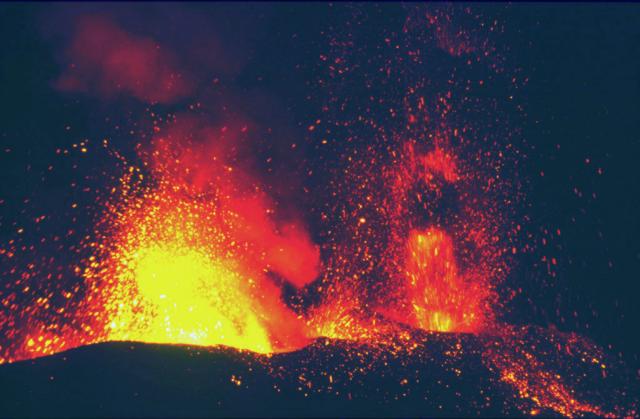 | Figure 99. A night photograph of Etna's N2000 vents showing the brilliant glow of lava fountains and associated spatter. Taken on 30 October 2002 from Mt. Ponte di Ferro looking E. Courtesy of J.C. Tanguy. |
On 31 October the wind gradually shifted from the N to the W and then SW, so that ashfall from S2700 vents affected localities NE of the volcano including Reggio di Calabria, whose airport also had to be closed. At the northern vents the lava effusion was on a waning stage, but violent explosions from the two upper vents of the N2000 group threw blocks of ancient material amid juvenile tephra (figure 100).
 | Figure 100. Outbursts began to wane at Etna's N2000 vents on the evening of 31 October 2002, but substantial explosions continued at the upper two N2000 vents. The photograph was taken looking southward, towards Etna's summit, from the lower NE rift zone at the eastern base of the northern Monte Nero (crater of the 1646 eruption at 2,049 m elevation; but easily confused with the S-flank feature of the same name). On the photo's right-center area lies a more brightly lit uplands region that leads to the summit of NE Crater, which is emitting a dense plume of white smoke. From left to right in the darker foreground lie the new spatter ramparts, with incandescent lava lumps at the middle vent, and dark ash and block explosions at the two upper vents, and the upper part of the eruptive fissure (small white fumes, far right) located between about 2200 and 2500 m elevation. Courtesy of J.C. Tanguy. |
On 1 November all activity ceased on the northern side except for very small residual lava flows, but the S2700 upper vent appeared to enter a phase of sustained explosive activity resembling a small subplinian column that continued to cause disruptions around the volcano. It was not until 12 November at 1340 that the activity abruptly changed to typical Strombolian explosions of liquid lava clots with loud detonations. On 13 November at about 1600 a small lava flow began to trickle from the lower base of the S2700 cone. The lava effusion increased on 14 November, expanding downwards along the 27-28 October flows. Meanwhile ash emission recommenced at the S2700 crater.
This kind of eruption style is quite unusual at Mount Etna. The authors suggest that it could indicate that a considerable amount of magma has intruded into the S rift zone, which would account for strong degassing without any significant lava effusion between 2 and 13 November.
Information Contacts: Jean-Claude Tanguy, University of Paris 6 & Institut de Physique du Globe, 94107 St. Maur des Fossés, France; Maurice Aubert, University of Clermont-Ferrand, Department of Geology, 63038 Clermont-Ferrand, France; Roberto Clocchiatti, CNRS-CEN Saclay, Lab. Pierre Süe, 91191 Gif sur Yvette, France; Santo La Delfa and Giuseppe Patané, University of Catania, Department of Geological Sciences, Corso Italia 55, 95129 Catania, Italy; Giuseppe Scarpinati,via Muggia 7, 95024 Acireale, Italy.
December 2002 (BGVN 27:12)  Cite this Report
Cite this Report
Late October 2002 earthquake swarm signals start of new flank eruption
On 26 October 2002 at 2225 a swarm of earthquakes was recorded by the seismic network of the Catania Section of the National Institute of Geophysics and Volcanology (INGV-CT). This signaled the start of a new flank eruption that has formed fissures on the N and S sides of the volcano.
The lava supply from the main vents were cut off by 3 November. At that time both the N and S fissues stopped producing lava flows, although the S fissure continued to discharge fire fountains. After that, 20 m of downslope movement was observed at the most advanced flow front near Piano Provenzana on 5 November. This late movement was caused by channel emptying, and occurred when lava emerging at the main vent, ~5 km upstream, was completely crusted over. No further advancement of the lava flows was observed on the S or N flanks of the volcano after this date. However, while explosive and effusive activity stopped at the N fissure by 5 November, as of 11 November fire fountaining continued at the S vent located at 2,750 m elevation, near Torre del Filosofo. All data (gas emission, volcanic tremor, composition of the ash) suggested a steady state at this vent. Ash fallout caused intermittent disruption at the Catania airport and damage to buildings.
The eruption continued into December 2002. Lava flows and Strombolian activity continued on the S flank from vents at 2,750 m elevation. Ash emission from the 2,750 m cinder cone significantly declined on 17 December, allowing the local airport of Catania to reopen.
The two vents, which opened at the SE base of the 2,750 m cinder cone on 9-10 December, fed four major lava flows spreading S and SW. A lava flow spreading S on 13 December approached the Rifugio Sapienza and eventually crossed a road on 17 December. An overflow from the main lava channel covered a building and caused a strong explosion in the Rifugio Sapienza area during the night of 17 December, injuring 32 people. The explosion was not directly caused by the eruption, but by vaporization of oil or water inside the building while it was covered by the expanding lava flow. The effusion rate from the two vents gradually decreased, eventually causing the closure of the western vent and then the lack of supply to the lava flows spreading SW towards Monte Nero.
A new vent opened on 17 December at the S base of the 2,750 m cinder cone, a few meters W of the previous vents. A lava flow soon started from this vent, spreading SW towards Monte Nero. The new vent cut supply to the flows expanding S towards Rifugio Sapienza and formed a fan of thin lava flows spreading S, SSW and SW. The lower lava output produced shorter flows, which spread up to 2.5 km from the vent, without threatening the tourist facilities at Rifugio Sapienza. Lava flows spreading from the 17 December vent slowed down and crusted over on 22 December, when a new vent opened at the SW base of the 2,750 m cinder cone. A flow, again directed SW towards Monte Nero, originated from this vent and was expanding in this direction on 23 December.
SO2 emission measured daily during the eruption had significantly decreased as of 1 December, when the previous values of about 20,000 tons per day decreased to about 7,000 tons per day (figure 101). The lower gas output, the decrease in effusion rate, and the lower emission of ash from the summit, suggested a declining stage of the eruption.
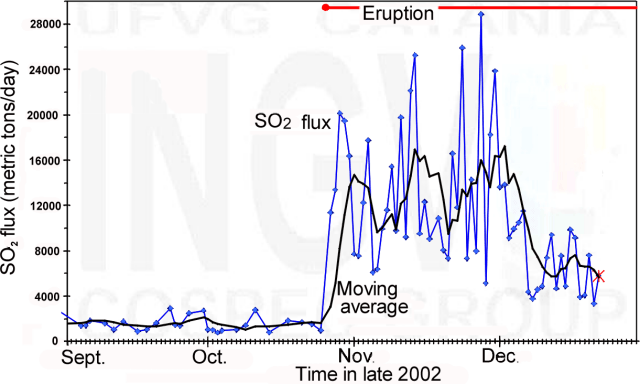 | Figure 101. A plot of SO2 flux at Etna during September-December 2002. Courtesy of INGV-CT. |
Updated maps of the lava flows, and reports of the eruptive activity, gas emission and ash composition (in Italian), can be found on the INGV-CT website.
Information Contacts: Sonia Calvari, Istituto Nazionale di Geofisica e Vulcanologia (INGV), Sezione di Catania, Piazza Roma 2, 95123 Catania (URL: http://www.ct.ingv.it/).
January 2003 (BGVN 28:01)  Cite this Report
Cite this Report
Flank eruption that began in October ends on 28 January
After three months of activity, the flank eruption at Etna that began on 27 October 2002 finished on 28 January 2003. Lava flows and Strombolian explosions in January were confined to the S-flank vent located at 2,750 m elevation. Lava flows formed a fan and covered the previous lava flow field. A decrease in effusion during January was suggested by the shorter lava flow lengths of less than 2 km, which formed a complex flow field with small lava tubes. Strombolian activity from the 2,750-m cinder cone significantly declined on 27 January and disappeared on 29 January. Lava flows slowed on 27 January, and were no longer fed by the 29th, and thus cooled down. At this time SO2 output decreased significantly, reaching the lowest value of 2,000 tons/day on 29 January 2003. Volcanic tremor amplitude showed a marked decrease on 27 January, and on 28 January at 2240 it returned to background levels, signaling the end of the eruption.
Information Contacts: Istituto Nazionale di Geofisica e Vulcanologia (INGV), Sezione di Catania Piazza Roma 2, 95123 Catania (URL: http://www.ct.ingv.it/).
February 2003 (BGVN 28:02)  Cite this Report
Cite this Report
Petrographic and geochemical comparison of 2001 and 2002 lavas
On 27 October 2002 Mount Etna opened on both its northern and southern sides (BGVN 27:10-27:12), erupting lava from vents about 2,500-1,800 m elevation on the NNE flank and 2,800-2,700 m on the S flank. The N vents emitted two flows that stopped after a few days, the longer of which stretched ~5 km. The S vents erupted lighter intermittent lava flows, but showed much stronger and sustained explosive activity that developed two large cinder cones at 2,750 and 2,850 m elevation.
The northern lavas are similar to the tephra erupted from Northeast Crater during the summer of 2002 and, more generally, to the trachybasalts that characterized Etna's activity during the past centuries (Tanguy and others 1997, and references therein). They are typically porphyritic (30-40% phenocryts), containing numerous millimeter-sized crystals of plagioclase (An 86-65/Or 0.4-2.1), clinopyroxene (En 42.3-37/Fs 11.7-15.5), and fewer ones of olivine (Fo 76-71) and titanomagnetite (Usp 35-43). The silica content is about 47-48% with a "normal" MgO content of about 5% and "low" CaO/Al2O3.
The southern lavas are significantly higher in MgO (~6.5%) and CaO/Al2O3 with fewer phenocrysts that comprise barely 10% of the rock. Olivine crystals are decidedly more magnesian (Fo 82-76), although other minerals are much like those described above, with plagioclase An 80.8-63.8/Or 0.8-1.3, clinopyroxene En 42-34/Fs 12-15.7, and titanomagnetite Usp 37-42.7. It must be pointed out, however, that plagioclase and titanomagnetite are here almost entirely confined within the groundmass, a characteristic that is uncommon in Etnean lavas and characterizes some of the most basaltic samples.
A particularity of the southern 2002 lavas is the presence of destabilized amphibole crystals, together with quartz-bearing inclusions (sandstones) surrounded by a reaction rim of pyroxene and embedded in a rhyolitic matrix. These characteristics are quite similar to those already found in the 2001 lavas emitted at 2,100 m elevation on this same flank (BGVN 26:10). The 2002 amphibole is present in rarer and smaller "megacrysts" that do not exceed 2 cm in length and display a reaction rim composed of rhonite, anorthitic plagioclase, and olivine within a silicic and potassic glass. Its chemical composition is similar to that of the 2001 amphibole.
Orthopyroxene was found in a southern flow emitted at the very beginning of the eruption (27 October). The average of 16 microprobe analyses is as follows (Centre de microanalyse Camparis, University of Paris 6): SiO2, 53.18; TiO2, 0.23; Al2O3, 0.79; Cr2O3, 0.04; FeO, 19.43; MnO, 0.80; MgO, 23.52; CaO, 1.72; Na2O, 0.05; Total, 99.75. The composition is thus hypersthene close to bronzite, typical of basalts or basaltic andesites. Hypersthene here occurs as crystals 0.5-0.7 mm in length, always surrounded by clinopyroxene. The two minerals are not in equilibrium as indicated by their different Mg values (0.69 for Opx, 0.71 to 0.78 for Cpx). This is the first time that such large crystals of orthopyroxene have been observed in lavas of the last tens of thousand years. Orthopyroxene is very rare at Etna, being previously found on only two or three occasions in pre-Etnean basalts about 200,000 years old.
Olivine separates from both N and S lavas (~100 crystals each) were microprobed, showing a single distribution for the N flank of Fo 69-70 for 65% of the crystals. The S lavas have a twofold behavior with Fo 78-81 for 37% of the crystals and Fo 73-75 for 45% of them. These results are similar to what was found between the upper southern 2001 lavas (including the NE flank below Pizzi Deneri) and those emitted at lower elevation (S 2,600 m and S 2,100 m). It is worth noting that the 2,600 m S vent of the 2001 eruption is close (~1 km) to the 2,700 m S vent of the 2002 eruption.
Based on these preliminary results, the low porphyritic index added to the whole rock chemical composition and that of the olivine crystals, a common origin is suggested for the southern 2002 lavas and those emitted low on the S flank during the 2001 eruption.
Reference. Tanguy, J.C., Condomines, M., and Kieffer, G., 1997, Evolution of the Mount Etna magma: Constraints on the present feeding system and eruptive mechanism: Journal of Volcanology and Geothermal Research, v. 75, p. 221-250.
Information Contacts: Roberto Clocchiatti, CNRS-CEN Saclay, Lab. Pierre Süe, 91191 Gif sur Yvette, France; Jean-Claude Tanguy, Univ. Paris 6 & Institut de Physique du Globe de Paris, Observatoire de St. Maur, 94107 St. Maur des Fossés, France.
August 2003 (BGVN 28:08)  Cite this Report
Cite this Report
Ash emissions during April from Bocca Nuova; volcanic seismicity and ash puff on 11 August
Activity at Etna since the end of the last flank eruption on 28 January 2003 (BGVN 28:01) was characterized by intense degassing at the Northeast Crater (NEC). In April, ash emission was observed from Bocca Nuova crater (BN), and ash fell for about 1 hour on E-flank villages. On 17 April a helicopter survey, aided by use of a thermal camera, revealed a cinder cone within the S pit of BN with a hot vent at its top. However, no degassing was taking place from this vent, and the pit appeared mostly obstructed by debris from the crater walls. Rare explosions from the vent caused little emission of juvenile material on the crater floor. Another helicopter-borne thermal survey in May showed that the summit craters were mostly obstructed.
Only a hot crack within the S pit of BN was observed during a June field survey. A new vent on the N rim of the Voragine (VOR), detected during a June field survey, was ~0.5 m wide, and the temperature measured through a thermal camera was ~500°C, much higher than the two vents within the crater. Given the presence of hot features within the summit craters and the obstructions observed inside BN, Southeast Crater (SEC), and VOR, it is possible that renewal of explosive activity at these summit craters could be accompanied by sudden, unpredictable gas explosions.
On the afternoon of 11 August an increase in volcanic tremor at the summit seismic stations lasted about 15 minutes and was followed by about 30 minutes of strong explosion earthquakes recorded at all summit stations of the INGV-CT seismic network. This was the first such event recorded at Etna since the end of the flank eruption. The INGV-CT web camera at Milo (~11 km from the summit) showed a puff of red ash from the summit of NEC. Red glows from the same crater were reported that night. A field survey on 14 August did not reveal any explosive activity or sounds of explosions from the crater. There were no explosion earthquakes or increased volcanic tremor between 11 and 16 August.
Periodic measurements of the gas plume from the summit using both COSPEC (SO2 flux) and FTIR (SO2/HCl and HCl/HF ratios) showed decreases in all three values since the end of the flank eruption. This suggests a general decreasing trend in gas output from Etna's summit craters.
Information Contacts: Sonia Calvari, Istituto Nazionale di Geofisica e Vulcanologia, Piazza Roma 2, 95123 Catania, Italy (URL: http://www.ct.ingv.it/).
December 2003 (BGVN 28:12)  Cite this Report
Cite this Report
September-November 2003 volcanism low; web camera and satellites depict small plumes
BGVN 28:08 reported ash emission at Etna during April 2003, and seismicity and ash emission during August 2003. A 12 September 2003 report noted that volcanic activity remained low at Etna's summit, with abundant SO2 and steam emissions at the NE and Bocca Nuova craters. An M 3.3 earthquake occurred on 14 September. It struck beneath the Ionian sea well offshore of Sicily's southeastern-most point. The reported epicenter (36.74°N, 15.60°E) was ~ 120 km SSE of Etna's summit. A Volcanic Ash Advisory noted activity depicted by web camera starting at 0500 on 25 September, with an ash-and-steam plume drifting to the W and visible below 4.5 km altitude. No ash cloud was visible on satellite imagery at 0530.
On 9 November, aviation sources and web camera observations detected an ash-and-steam plume moving S from Etna. The plume rose to ~ 4 km altitude.
Information Contacts: Sonia Calvari, Istituto Nazionale di Geofisica e Vulcanologia (INGV) Sezione di Catania, Piazza Roma 2, 95123 Catania, Italy (URL: http://www.ct.ingv.it/); Toulouse Volcanic Ash Advisory Center (VAAC), Météo-France, 42 Avenue G. Coriolis, 31057 Toulouse, France (URL: http://www.meteo.fr/).
January 2004 (BGVN 29:01)  Cite this Report
Cite this Report
Additional details and interpretation of the 2002-03 eruption; space-based photographs
Although Etna's 2002-3 eruption was previously discussed in BGVN 27:10-27:12 and 28:01, Boris Behncke subsequently posted a report to his website highlighting some further observations and interpretations. His report presented many photos, including two taken by astronauts aboard the International Space Station (figures 102 and 103). His report drew on published or soon-to-be published material (Acocella and others, 2003; Behncke and Neri, 2003; Branca and others, 2003; and Dellino and Kyriakopoulos, 2003). Extracts from Behncke's summary follow.
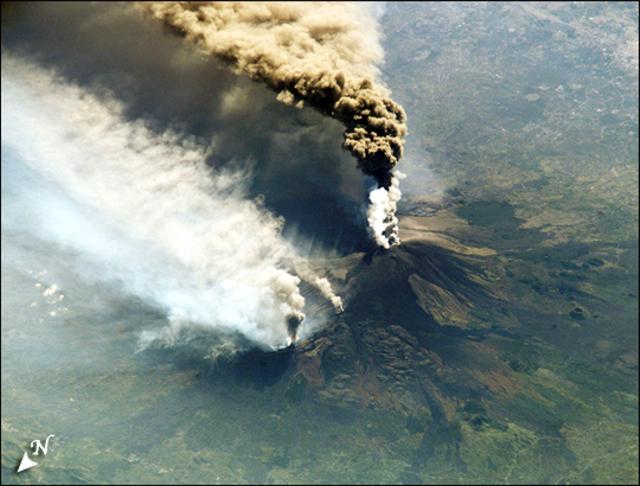 | Figure 102. A photo of Etna during the 2002-2003 eruption looking SE and downward from ~ 400 km altitude on 30 October 2002 from the International Space Station (ISS-5). A large dark tephra column appears in the top center, rising from the upper S flank and then blowing toward the left (E). A much smaller gray-white plume rose just in front of the tephra column; it discharged from the summit craters. Appearing in the central foreground are two distinct white plumes that issued from along the NE Rift, and some lower, dispersed, low-density plumes. Smaller, lower plumes towards the photo's lower-left center came from forest fires. On the ground surface, the youngest lava flows appear darkest; some pyroclastic cones on the outer flanks are also visible. Future studies may disclose whether the brown-colored region beneath the tephra column in the upper-left quadrant of the photo was due to factors such as diffuse clouds, camera angle, and lighting geometry, or due to falling tephra descending from the plume. (Image ISS005-E-19024.) Courtesy of Earth Sciences and Image Analysis, NASA-Johnson Space Center (on their website see "Earth Sciences and Image Analysis Photographic Highlights"). |
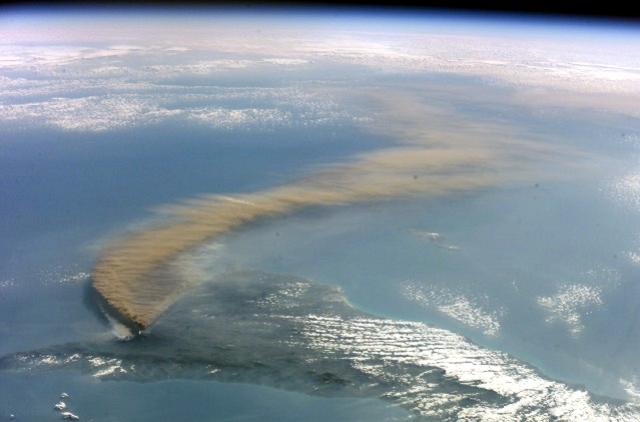 | Figure 103. A broader view of Etna's 30 October ash plume taken looking SE and downward from the International Space Station at ~ 400 km altitude, showing large portions of Sicily in the middle to foreground. According to the NASA Earth Sciences and Image Analysis team, the plume followed a curved path from Etna, first blowing SE, and then blowing S towards Africa at higher altitudes. They also noted that ashfall was reported in Libya, more than 560 km distance from Etna. Note the fainter, lighter-colored plumes from the NE Rift vents, which were also seen in the previous figure. (Image ISS005-E-19016.) Courtesy of Earth Sciences and Image Analysis, NASA-Johnson Space Center (on their website see "Earth Sciences and Image Analysis Photographic Highlights"). |
Behncke puts the eruption's start date a few hours earlier than previously reported, enough to shift the start date from early 27 October to late on 26 October. While mountain guides who visited the craters on Saturday 26 October noted nothing unusual, an intense earthquake swarm at shallow depth within the volcano began at about 2125 that day. Tremors woke hikers at the Hotel "Le Betulle" at Piano Provenzana, a spot at about 1800 m elevation on the NE flank; they abandoned the seriously damaged building. At dawn on 27 October those who still remained at Piano Provenzana noted large E-W trending fractures cutting across the paved parking lot of the tourist complex. According to Behncke, the first eruptive vents to become active during this eruption opened at 2345 h on 26 October, on the upper southern flank, and immediately began to produce intense explosive activity.
Italy ended daylight saving time at 0100 UTC on Sunday 27 October (0200 local time). The change moved the clock back one hour, from 0200 to 0100 local time. Few if any important events were noted during the 60-minute interval of the time change. Later, however, at approximately 0230 h on 27 October a few persons watching the summit of Etna noted the sudden onset of high lava fountaining from the northern base of the Northeast Crater. The fountaining lasted only a few minutes.
Etna's 2002-2003 eruptions have been described as unusual, differing in four key respects. First, this was one of the most explosive eruptions in recent times. Pyroclastic material comprised more than half of the total volume of erupted products, contrasting with Etna's most recent eruptions, which mainly extruded lava.
Second, the 2002-2003 eruption discharged two different types of magma. The fissures on the NE rift produced magma of the sort normally produced by Etna over the past few centuries, while the vents on the S flank produced a magma rich in amphibole, a water-bearing mineral relatively rare in Etna's recent products. Amphibole also clearly appeared in the 2001 lavas (BGVN 26:10), and in products erupted in 1892 at Monti Silvestri, and 1763 at Montagnola. All of these vented on the S flank.
Third, some scientists have correlated large-scale flank slip and magma uprise. Specifically, on 22 September, the E flank of the volcano began to slip toward the Ionian Sea, with movement occurring mainly on the Pernicana fault system (Neri et al., 2003). This displacement is thought to have allowed magma to migrate from the central conduit system into the NE Rift, although a second, larger flank slip event was necessary to permit magma uprise to the surface. This occurred not only on the NE rift, but also on the S flank, where magma came from the eccentric reservoir previously active in 2001. Thus, the eruption can be interpreted as having been triggered by the flank slip, in contrast with the 2001 eruption, which was preceded by the forceful uprise of a dike from the eccentric reservoir, and possibly was triggered by regional tectonic compression (Acocella et al., 2003). One of the most important discoveries during the events of late 2002 and early 2003 was that the Pernicana fault system is not only 9 km long, as previously believed, but extends from the NE rift down to the Ionian Sea, and possibly continues offshore, over a distance of at least 18 km (Neri and others, 2003).
Fourth, N flank lava flows invaded a tourist complex and adjacent forest for the first time in the historic record. An important landmark in this region is the northern Monte Nero, which sits ~ 6 km N of Etna's summit, includes a crater of the 1646 eruption, and is a local high at 2,049 m elevation. It is easily confused with S- and SE-flank features bearing identical or similar names. The northern Monte Nero lies ~ 2 km W of Piano Provenzana and the surrounding forest called Ragabo. These latter environs had not been invaded by lava flows for many centuries. Eruptions on the NE Rift, which looms above the Provenzana plain, had occurred as recently as 1911, 1923, and 1947, but their lava flows had taken a more westerly course, leaving Piano Provenzana and the forest unharmed.
Tourist facilities were constructed at Piano Provenzana during the late 1960s to early 1970s. The associated ski area became popular among locals because, lying on the northern flank of the volcano, it received and preserved more snow than its southern-flank counterpart, and owing to wind patterns, it received fewer tephra falls. On Christmas 1985 an earthquake along the Pernicana fault (a few kilometers to the northeast of Piano Provenzana) destroyed the Hotel "Le Betulle," killing one person. That earthquake accompanied an eruption in the Valle del Bove, but the latter was very small and did no damage. Hotel "Le Betulle" was rebuilt to sustain higher seismic loads and it became the hub of Etna's N-flank tourism.
The 2002-3 eruption produced a number of small scoria cones along the fissure on the NE Rift and a cluster of huge cones at the vents on the S flank. The latter have completely changed the topography of what was once known as the "Piano del Lago" ("Plain of the Lake", indicated as "PDF" on the map in BGVN 26:10). Until 27 October 2002 this area bore the scars of the 2001 eruption, most of it being covered with virtually inaccessible lava flows and various pyroclastic cones. In early November 2002 the formerly rugged surface was transformed into a rolling plain of ash, which facilitated excursions on foot. The area was subsequently covered by rugged new lava flows. Etna's old abandoned cable car station (partially destroyed by an eruption in 1983) was buried by the lowermost of the new cones. A new souvenir shop and bar erected by mountain guides early in 2002 at 2,760 m elevation vanished under the cover of pyroclastics, although the Torre del Filosofo mountain hut at 2,900 m elevation is still standing. In the past, the Piano del Lago offered a splendid panorama of the summit cone complex, but this view became largely concealed by the new cones along the fissure at 2,700 m elevation. The largest of these cones, formed at a spot that was 2,750 m in elevation prior to the eruption, now stands about 200 m higher, and a second cone slightly up slope is nearly as tall. The sheer size of these new cones dwarfs that of Monte Josemaria Escrivà, which formed in 2001 and had been a prominent feature.
Behncke and Neri (2002) presented initial estimates for the volume of products emitted during the 2002 eruption. They indicated ~ 30 million cubic meters of lava, nearly two-thirds of which was emitted on the S flank. They also indicated that 40 million cubic meters of pyroclastics, were nearly exclusively emitted from the S-flank vents. In terms of magma volume, this is not an enormous eruption for Etna, but it ranks among the more significant of recent decades.
Outlook and interpretations. The 2002-2003 eruption came 1.27 years after the beginning of the 2001 eruption. Between 1971 and 1993 flank eruptions occurred at a mean interval of 1.7 years (Behncke and Neri, 2003). Etna's historical eruptive behavior has undergone significant fluctuations during the 400 years of reasonably complete documentation. It seems that flank eruptions tend to occur in series, and the 2001 eruption could be interpreted as the first in a new eruptive series, analogous to the sequence of 13 flank eruptions witnessed between 1971 and 1993. According to this interpretation, more such eruptions will occur at relatively brief intervals over a period of 10-20 years. By this model, the 2002-2003 eruption was the second in the new series, implying a third in the not too distant future.
The volcano was extensively fractured during both eruptions, which may allow magma to rise much more easily under the flanks of the edifice, and has grown progressively more active during the past 50 years. It is erupting more frequently and more vigorously than during the 280 years before 1950, and its productivity, or output, is increasing. Flank eruptions must thus be expected to occur at intervals ranging from 1 to 3 years, and some of them might be much more voluminous and potentially hazardous than the latest two eruptions.
The 2002-2003 eruption was one of the most explosive flank eruptions in the past 150 years, and it shows that Etna is a potentially explosive volcano, as it has been historically. Nearly all of the flank eruptions of the past 100 years have been relatively benign with mostly lava emissions; thus the local population has been lured into the belief that Etna is a "good volcano." But a short look at the record of its historically documented eruptions shows that the rather effusive, non-explosive behavior of the 20th century was, in fact, unusual.
Part of the explosivity of the 2002-2003 eruption might be due to the water-rich nature of the magma rising from a reservoir located below the S flank. This magma was comparatively gas rich, in contrast to the magma erupted from the central conduit system (and on the NE flank), which had degassed to some degree during the months before the eruption. The fact that this magma has appeared for the second consecutive time might be taken as an indicator that future eruptions will be fed from the same reservoir and therefore could be as explosive. However, an additional factor controlling the explosivity of an eruption is the interaction of magma with external water, such as a shallow aquifer. This was the case during the 2001 eruption (at Monte Josemaria Escrivà), and it was probably again the case at the new cones at 2750 and 2800 m elevation on the S flank. In fact, ash from the first day of the 2002-2003 eruption that arrived on the Greek island of Cefalonia during the following 24 hours was determined to be of phreatomagmatic origin (Dellino and Kyriakopoulos, 2003)
Eruptive activity at Etna quieted on 28 January, but in terms of seismicity, the volcano remained restless. Some of the continuing seismic activity was due perhaps to the adjustment of the edifice to the major displacements at the beginning of the eruption, or it may have started to recharge for its next eruption. Seismicity dropped to relatively low levels in the spring of 2003, but since mid-June 2003 was again slightly elevated.
References. Acocella, V., Behncke, B., D'Amico, S., Maiolino, V., Neri, M., Ursino, A., and Velardita, R., 2003, The 2001 and 2002-2003 eruptions of Mount Etna (Italy): Evidence for different triggering mechanisms: Abstract presented at the Annual Workshop 2003, Pantelleria, Sicily (23-28 September 2003) on Seismic phenomena associated with volcanic activity.
Behncke, B., and Neri, M., 2003, Cycles and trends in the recent eruptive behaviour of Mount Etna (Italy): Canadian Journal of Earth Sciences, v. 40, p. 1-7.
Behncke, B., and Neri, M., 2003, The July-August 2001 eruption of Mt. Etna (Sicily): Bulletin of Volcanology, v. 65, p. 461-476.
Branca, S., Carbone, D., and Greco, F., 2003, Intrusive mechanism of the 2002 NE-Rift eruption at Mt. Etna (Italy) inferred through continuous microgravity data and volcanological evidence: Geophysical Research Letters, v. 30, p. 2077.
Dellino, P., and Kyriakopoulos, K., 2003, Phreatomagmatic ash from the ongoing eruption of Etna reaching the Greek island of Cefalonia: Journal of Volcanology and Geothermal Research, v. 126, p. 341-345.
Neri, M., Acocella, V., and Behncke, B., 2003, The role of the Pernicana Fault System in the spreading of Mt. Etna (Italy) during the 2002-2003 eruption: Bulletin of Volcanology (in press but published on-line 5 November 2003).
Information Contacts: Boris Behncke, Dipartimento di Scienze Geologiche (Sezione di Geologia e Geofisica), Palazzo delle Scienze, Corso Italia 55, 95129 Catania, Italy; Earth Sciences and Image Analysis, NASA-Johnson Space Center (URL: http://eol.jsc.nasa.gov/).
March 2004 (BGVN 29:03)  Cite this Report
Cite this Report
Ashfall with juvenile components, emitted gases, and seismic patterns imply magma ascent
Since the cessation of the last eruption of Mount Etna on 28 January 2003, no further eruptive activity has been observed. Summit activity has been limited to pulsating gas emissions from the Northeast Crater (NEC) and from one of the two vents within Bocca Nuova (BN). The other central crater vents and the Southeast Crater (SEC) were essentially blocked and only producing extremely weak gas emissions.
The first significant variation from this very low level of activity was seen between 12 and 14 February 2004, when a weak ash emission was observed within the summit crater plume. A fresh ash sample was collected in Pedara, a village about 10 km SE from the summit. Del Carlo and Andronico (2004) reported that the sample was made up of material with a grain-size less than 0.125 mm. Components comprising the sample consisted of sideromelane (41.5%), tachylite (24.7%), loose crystals of clinopyroxene, olivine, and plagioclase (4%), and lithics (29.7%). The clasts of sideromelane were very vesiculated and made of light-brown, transparent and shiny glass. There were also a few strands of Pele's hair. Tachylites were black or gray, shiny, sub-angular clasts. Lithics comprised fragments of weathered scoria, lavas, or secondary minerals. The high amount of juvenile components within the ash were taken to suggests an uprise of magma into the summit feeder conduit, the first to occur since the end of the 2002-2003 flank eruption.
The INGV-CT Geochemistry group performed regular remote-sensing measurements of volcanic gas flux and chemical composition on Etna using COSPEC and FTIR instruments. Such measurements demonstrated that the upper conduit system of Mt Etna has been weakly supplied with magma since the end of the 2002-2003 eruption, an observation supported both by relatively low fluxes of SO2 and low molar ratios of SO2/HCl. Occasional discrete injections of magma into the upper conduit system have been observed, however, as sharp increases in both SO2 flux and SO2/HCl ratios. These inputs occurred in August 2003, December 2003, and in late January 2004.
The INGV-CT permanent seismic network consisted of ~ 40 stations, 10 of which were installed in October 2003 and have broad-band, 40-second-period sensors. After the end of the 2002-2003 flank eruption, seismicity was mainly concentrated along Etna's E and NE flanks, appearing in two main phases. Until the end of May 2003, earthquakes were localized along the same structures that were activated during the 2002-2003 eruption, suggesting a relaxation phase. During this phase, several swarms occurred mainly between 3 and 7 km depth, showing a progressive decrease in seismic energy. After June 2003, several shallow earthquakes were recorded along the upper eastern part of the volcanic edifice near Zafferana, and along the Pernicana fault on the NE flank. This second phase was characterized by a renewal of seismic activity, with several seismic swarms characterized by progressive release of seismic energy. In particular, during the last two months, the Pernicana Fault has been very active (UFS Weekly Reports, 2003 and 2004).
References. Del Carlo, P., and Andronico, D., 2004, Rapporto cenere Etna del 13-14/02/04: INGV-CT Internal Report, Prot. Int. no. UFVG2004/024, p 1. UFS INGV-CT Weekly Internal Reports, 2003 and 2004.
Information Contacts: Sonia Calvari, Istituto Nazionale di Geofisica e Vulcanologia, Piazza Roma 2, 95123 Catania, Italy (URL: http://www.ct.ingv.it/).
September 2004 (BGVN 29:09)  Cite this Report
Cite this Report
New effusive eruption begins on 7 September and spreads to several fissure vents
At about 1030 on 7 September 2004 a new effusive eruption started from the summit of Mount Etna. A N110°E-trending eruptive fissure about 230 m long opened at the base of the SE Crater without any significant seismic activity. A degassed lava flow poured from the base of the fissure, spreading towards the Valle del Bove. The lava flow had very low output rate (between 0.2 and 0.5 m3/s), and was ~ 1 m thick, 10 m wide, and up to 250 m long. On the morning of 8 September the lava flow appeared to lack new input from its source, but the eruptive fissure continued to advance down slope. These events were not accompanied by seismicity or explosive activity.
After two days of slow expansion of the fracture field, a new effusive vent opened at a lower elevation, 2,650 m, on the upper western flank of the Valle del Bove. This occurred between 0600 and 0700 on 10 September. Lava poured from this vent, spreading over the upper wall of the Valle del Bove. No explosive activity accompanied the emission of lava, but some phreatic explosions were triggered by lava intersecting a thick cover of snow. The lava flow was degassed and flowed out at a rate of about 2-4 m3/s. It spread E to the Serra Giannicola Piccola before splitting in two branches. At about 0930 the longest branch was about 300 m long and 50 m wide. Due to the high slope-angle, the front of the N lava flow breached. Hot blocks rolled down slope, causing the flow front to expand due to the collapse of hot debris rather than by flowage. At 1400 the lowest elevation of the lava flow front was about 2,250 m elevation within the upper Valle del Bove. At that time, no villages were threatened by the lava flows since they had spread out over a deserted zone at least 10 km away from the nearest village.
Activity appeared similar on 14-15 September 2004, when Mike Burton, Enza Longo, and Margherita Polacci had clear views of the Valle Del Bove in fair weather. Their first observations were carried out at the Southeast Crater (SEC), where the team saw a conspicuous plume emitted from a fumarole field on the SEC's SE rim. This activity, not seen prior to the eruption, had been consistently observed during the previous 3-4 days.
A visit to a vent at 2,830 m elevation revealed behavior similar to previous days, consisting of continuous high-pressure degassing in the absence of explosive activity (figure 104). At this vent, in contrast to the one at 2,630 m (which emitted lava), incandescence was limited to a circular zone at the vent area. No recent scoria were observed near the degassing vent. At this degassing vent the peak temperature, measured with a thermal camera, was ~ 900°C (see thermal image, figure 8).
 | Figure 104. A vent emitting high-pressure gas at 2,830 m on Etna, 15 September 2004, with thermal image of the vent's mouth (at right). Courtesy of Mike Burton, Enza Longo, and Margherita Polacci. |
The team also visited the lava flow at 2,630 m (figure 105). Fresh scoria had fallen along the path leading to the lava flow, and samples were collected. The estimated flux rate of the lava flow was between 2 and 4 m3/s, using an estimated flow velocity of 1 m/s, a width of 2 m, and a depth of 1-2 m. Estimates were obtained by observing the lava flow just above the rock island seen in figure 9. This flux was roughly equal to that seen on 13 September.
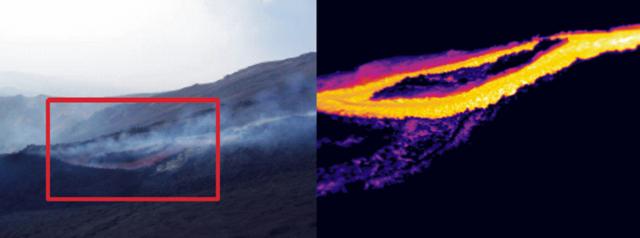 | Figure 105. Lava flow witnessed at 2,630 m elevation on Etna on 15 September 2004. The image at right is a closer view of the indicated area taken with a thermal camera. The thermal image shows the lava flow splitting and skirting around a small rock island. Courtesy of Mike Burton, Enza Longo, and Margherita Polacci. |
A pair of hornitos lay up slope of the lava flow originating at 2,630 m elevation. One hornito sat just behind the spot where lava was first observed on the surface. The second hornito was larger and resided about 20-30 m farther up slope (figure 106). It released gas at high pressure, creating noise. No scoria were emitted during their observation.
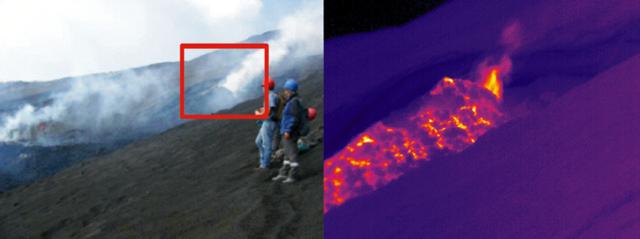 | Figure 106. A hornito seen at Etna on 14-15 September up slope from the lava flow at 2,630 m elevation. The indicated area appears in an enlarged thermal image at right. Courtesy Mike Burton, Enza Longo, and Margherita Polacci. |
Polacci and Burton then walked down to the lava flow that began on 13 September (figure 107). The lava flow's flux rate was low. The team estimated an outflow rate of ~ 1 m3/s, using a width of 2 m, a flow velocity of 0.5 m/s, and a depth of 1 m, dimensions noted near the lava flow's source. The lava flow emanated from a small depression; no scoria deposits were seen nearby. GPS established the flow's source at 2,340 m elevation. The team observed several distinct overflows escaping from the principal lava flow, which originated at 2,630 m elevation (figure 108).
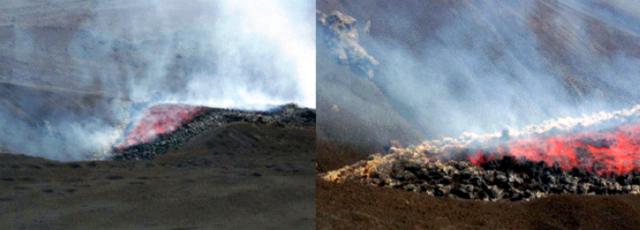 | Figure 107. The source of an Etna lava flow at 2,340 m elevation, as seen in two photographs taken on 14 or 15 September. Courtesy of Mike Burton, Enza Longo, and Margherita Polacci. |
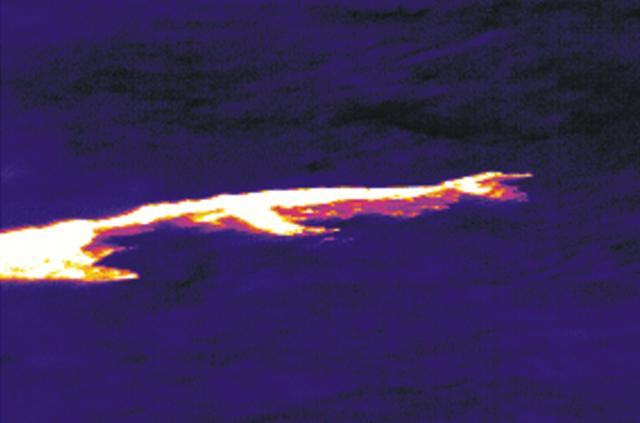 | Figure 108. The lava flow that originated at 2,630 m elevation as seen in a thermal image on 14 or 15 September. The advancing lava flow broke into a series of branches. Courtesy of Mike Burton, Enza Longo, and Margherita Polacci. |
Information Contacts: Sonia Calvari, Mike Burton, Enza Longo, and Margherita Polacci, Istituto Nazionale di Geofisica e Vulcanologia (INGV), Piazza Roma 2, 95123 Catania, Italy.
January 2005 (BGVN 30:01)  Cite this Report
Cite this Report
7 September eruption continues on W wall of Valle del Bove, includes lava tubes, multiple vents
The effusive eruption that started on 7 September 2004 on the W wall of the Valle del Bove continued. Lava escaped at a very low effusion rate from two main vents at 2,620 and 2,320 m elevation. Lava tubes developed downslope of these vents, forming a complex lava-flow field with ephemeral vents at the base of the W wall of the Valle del Bove. After December 2004, effusive vents were mainly located at the lower end of the tube network below 2,000 m elevation. Lava flows were up to 2.5 km long, and the lava-flow field did not change significantly since the end of October 2004 (figure 109).
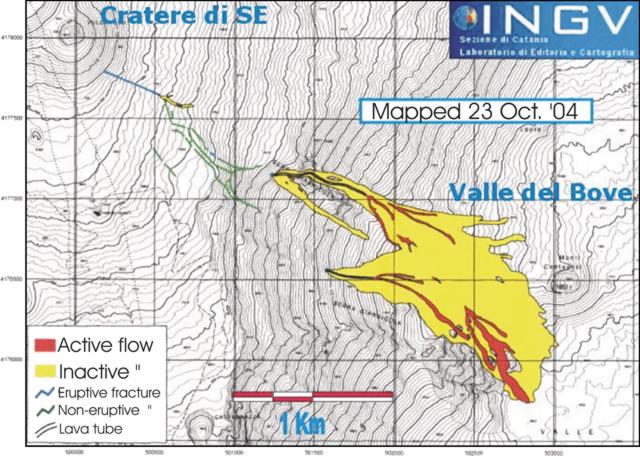 | Figure 109. A map of Etna emphasizing features associated with the lava flow field as they appeared 4 October 2004. Courtesy of INGV. |
On 8 January 2005 an ash plume formed above the summit of SE crater and lasted a few hours. Analysis of the ash components revealed that it consisted of lithic material. This episodic ash emission was probably caused by collapse within the crater into the void left after three months of lava output.
On 18 January the INGV-CT web camera located 27 km S of the summit craters revealed a dense, pulsating gas plume rising above the summit of NE crater and lasting a few minutes. This was probably caused by snow vaporization due to hot gas emission from the main crater vent.
During the afternoon of 18 January a new lava flow formed upslope along the 2,620-m-long eruptive fissure, at ~ 2,450 m elevation. The lava flow spread for about 200 m SE on the snow and along the middle wall of the western Valle del Bove. This flow front moved slowly and completely stopped after about 24 hours. The emission of lava from the ephemeral vents below 2,000 m stopped during the effusion from the 2,450-m vent. The lower ephemeral vents again started to emit lava on 19 January. During the afternoon of 22 January two new lava flows erupted from vents at 2,400 m elevation, along the same tube system fed by the 2,620-m-elevation vent. Two parallel, fast-moving flows spread E. They were still evident on 27 January from the images recorded by the INGV-CT webcam at Milo, together with a number of ephemeral vents and small lava flows at the lower end of the lava tube.
The opening of effusive vents upslope along the tube system of a complex lava-flow field has usually indicated the final stages of expansion, an effect observed several times at lava-flow fields on Etna and Stromboli. Decreased effusion from the main vent causes the tube system to drain, so the lava tube walls collapse. Obstruction at the lower end of the tube then causes accumulation of lava farther upslope and the opening of new vents at higher elevations.
Since the start of the eruption on 7 September 2004 (BGVN 29:09), there has been no significant explosive activity at the summit craters or the eruptive fissures.
Information Contacts: Sonia Calvari, Istituto Nazionale di Geofisica e Vulcanologia, Piazza Roma 2, 95123 Catania, Italy (URL: http://www.ct.ingv.it/).
December 2005 (BGVN 30:12)  Cite this Report
Cite this Report
Late degassing, summit explosion and ash release in December 2005
The previous report on Mount Etna (BGVN 30:01) described what turned out to be the final activity of the 2004-05 eruption, which ended by March (Burton and others, 2005). From March 2005 until November there was only a low and quiet degassing at the summit craters. Between the end of November and early December 2005 a significant increase in the SO2 output was accompanied by an increase of volcanic tremor and a minor deformation of the summit part of the volcanic cone.
On 16 December 2005 an explosive sequence was recorded by the INGV-CT seismic network, localized at the summit. This was accompanied by an increase in SO2 emission, which reached peaks 10 times the background flux levels. On 22 December the increase in gas pressure was accompanied by a dilute emission of juvenile ash from the Bocca Nuova crater. This vent had been blocked since the end of the previous summit eruption. However, the very fine-grained nature of the ash suggested a deep level of the magma column within the conduit.
Reference. Burton, M., Neri, M., Andronico, D., Branca, S., Caltabiano, T., Calvari, S., Corsaro, R.A., Del Carlo, P., Lanzafame, G., Lodato, L., Miraglia, L., Muré, F., Salerno, G., and Spampinato, L., 2005, Etna 2004-05: an archetype for geodynamically-controlled effusive eruptions: Geophysical Research Letters, v. 32, L09303, doi:10.1029/2005GL022527.
Information Contacts: Sonia Calvari, Istituto Nazionale di Geofisica e Vulcanologia Sezione di Catania, Piazza Roma 2, 95123 Catania, Italy (URL: http://www.ct.ingv.it/).
July 2006 (BGVN 31:07)  Cite this Report
Cite this Report
An upper E-flank fissure eruption lasting from 14 to 24 July 2006
This report covers the new eruption from an E-flank fissure during mid July 2006. Previously, on 7 September 2004, an eruptive period began that lasted until March 2005 (BGVN 29:09, 30:01). From March 2005 until November quiet degassing took place at the summit craters; on 16 December 2005 an explosive sequence at the summit was accompanied by an ash emission from the Bocca Nuova crater (BGVN 30:12). This report is from Sonia Calvari of the Istituto Nazionale di Geofisica e Vulcanologia (INGV) and covers the interval through 26 July. Brief mention is made at the end of the report about another episode starting on 31 August and going into at least mid-September.
On 14 July 2006 at 2330 a fissure opened on the E flank of the Southeast Crater (SEC) summit cone. Two vents along the fissure produced a lava flow spreading E to the Valle del Bove (figure 110). A helicopter survey carried out on 16 July at 0730 showed a braided lava flow field up to 1.7 km long. Based on the surface area and approximate volume of this lava flow field, workers estimated a mean output rate of ~ 2.6 m3/s during the first 32 hours of eruption. During the opening phase of the eruptive fissure, moderate strombolian emissions occurred at a third upper vent, located at about 3,100 m on the E flank of the SEC, just below the wide depression that cuts its eastern flank. It produced minor ash fallout on Catania. The composition of the ash was 80% juvenile, with small amount of lithics probably due to the opening phase of the vents.
 | Figure 110. Lava flows descending from vents near Etna's summit cone. Reuters photo. |
On 17 July, the lava flow field was situated on the W wall of the Valle del Bove, and the two main flow fronts reached about 2,100 m elevation, spreading N of the Serra Giannicola Piccola ridge. The lava discharge peaked on 20 July (figure 111), when an effusion rate of ~ 10 m3/s drove the lava flow advance to a maximum distance of ~3 km within the Valle del Bove. The lava flow front widened at the base of Monte Centenari, at 1,800 m elevation, located at least 15 km from the closest villages. The effusion rate on 23 July decreased to ~3 m3/s. At that time the lava channels had narrowed and levees had partially collapsed. The eruption appeared to end on 24 July.
 | Figure 111. On 21 July 2006, the Moderate Resolution Imaging Spectroradiometer (MODIS) flying onboard NASA's Terra satellite captured this image as Etna emitted a faint ash plume that blew SW. MODIS also detected a hotspot near the summit, where surface temperatures were much higher than in the surrounding area (red outline). Courtesy the MODIS Rapid Response Team, NASA GSFC. |
On 26 July, observers on the rim of the NE Crater heard strong explosions, and saw lapilli fall. This crater, together with the south pit within Bocca Nuova, showed significant thermal anomalies during a helicopter survey carried out on 24 July.
In the early morning of 31 August, Strombolian activity resumed at SEC's summit. In the next two weeks SEC was the scene of a series of dramatic events. By 11 September, lava from the SE flank of the SEC had advanced to reach ~3 km ESE. The resulting ribbon of lava was in places over 200 m wide. More details will follow in a subsequent report.
Information Contacts: Sonia Calvari, Istituto Nazionale di Geofisica e Vulcanologia Sezione di Catania, Piazza Roma 2, 95123 Catania, Italy (URL: http://www.ct.ingv.it/); Reuters (URL: http://today.reuters.com/).
August 2006 (BGVN 31:08)  Cite this Report
Cite this Report
Changes in morphology of SE Crater and the emission of lava flows to the SSE
Strombolian eruptions, which had resumed in late August 2006, continued into September and took place in conjunction with lava flows escaping towards the ESE and reaching over 1 km in length by mid-September. A large circular depression had grown along the SE side of the cone at Southeast Crater (SEC) during 2004-5. The wall between the depression and the SEC's established central crater became increasingly eroded. On 10 September 2006 that weak zone failed. Lava erupted in the SEC's central crater soon filled the depression and then moved SSE.
The following report was supplied by Sonia Calvari and other members of the Istituto Nazionale di Geofisica e Vulcanologia (INGV). The INGV website featured several reports on this time interval (including Lodato and Consoli, 2006; and Neri and others, 2006).
After the short eruptive phase of 14-24 July 2006 (BGVN 31:07) and the renewal of explosive activity at the Northeast Crater at the end of July, Strombolian activity resumed at SEC's summit in the early morning of 31 August. This activity was mild, with fallout of lapilli and bombs mainly within the crater. The ejecta eventually filled the SEC, and between 1900 and 2000 on 5 September an overflow from the summit formed spectacular lava falls along the breached E side. The descending lava accumulated within the prominent circular depression (figure 112) on the SEC's eastern flank.
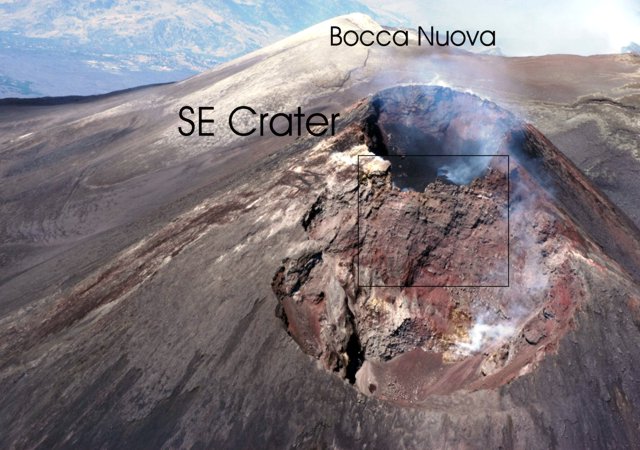 | Figure 112. A view of the E side of Etna's SEC with Bocca Nuova (crater) in the background, 5 September 2006. The frame is drawn around the area that failed on 10 September. The depression, larger in diameter than the central SEC crater, had carved away material backing the eventual zone of failure. Photo taken from the report of Lodato and Consoli (2006). |
Figure 113 presents plan views of Etna's SEC and vicinity, indicating the large depression that grew on the cone's SE side. The scene during July 2006 (left panel) provides a size comparison between the SEC's established central crater and the recent depression immediately to its SE. The 12 September 2006 scene (figure 113, right) shows the lava's eventual path. After lava flows escaped the central crater, they ponded in the adjacent depression. They later crossed the rim of the depression, and went on to advance over 1 km E.
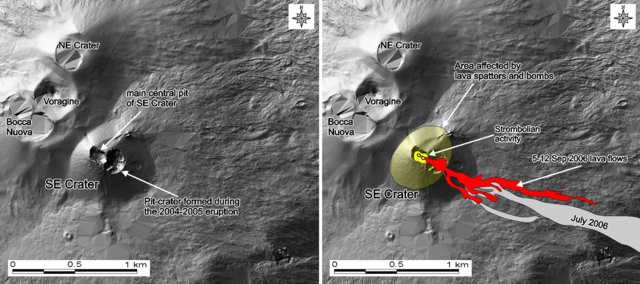 | Figure 113. (Left) 2005 digital elevation map at Etna, including two key features: the established SEC crater and the adjacent (larger, circular) depression that grew to its SE during the 2004-05 eruption. This was the scene prior to the collapse of the wall between the two features. (Right) A schematic map discussing eruptive activity during July through 12 September 2006. Base map from M.T. Pareschi (INGV- Sezione di Pisa) and right-hand panel from Neri and others (2006). |
The overflow from the SEC's central crater that began on 5 September continued to spread within the depression until about 0645 on 7 September, when it overflowed the SEC's eastern rim and started to spread on the outer E flank and from there towards the Valle del Bove rim. The flow was extremely viscous, slow, thin, and cold, mainly propagating through collapses and breaching of the `a`a flow front. Explosive activity continued at the SEC summit with variable intensity and lava blocks falling as far down as the base of the SEC's cone.
The failure of the SEC's upper wall (figure 112) took place late in the evening of 10 September, due to the pressure of magma accumulating within the summit crater. A new rock fall occurred at the wall dividing the SEC summit crater from the eastern depression, and was suddenly covered by the lava flow spilling from the summit crater. An ash plume rose from the failed material and blew W. No significant ash fallout was observed on the ground, but a lava flow spread E, advancing slowly towards the Valle del Bove rim. After the wall had fallen Strombolian emissions continued at the SEC (figure 114).
 | Figure 114. Etna's SEC seen during the evening of 11 September 2006. Note the large breach of the SE side of the SEC's wall, permitting a direct view of strombolian eruptions within the summit crater in the SEC and channeling of the lava flow toward the SSE (towards the viewer and in the direction of the observatory). From the report by Neri and others (2006). |
On 12 September the lava-flow length reached ~1.5 km E of the vent at SEC's crater. Both lava effusion and explosive Strombolian activity continued until 27 September, when both stopped following a sudden decrease in volcanic tremor.
References. Neri, M., Behncke, B., and Norini, G., 12 September 2006, Forma e strutture del Cratere Sud-Est (Etna) tra l'eruzione di luglio 2006 e l'attivit? eruttiva in corso, aggiornata al 12 settembre 2006 ['Forms and structures of the SEC from the eruption of July 2006 and ongoing eruptive activity, updated 12 September 2006']: Prot. int., WKRVGFTR20060913.pdf [UFVG2006/107].
Lodato, L., and Consoli, O., 11 September 2006, Aggiornamento attivit? Etna ['Etna activity update']: INGV, Catania, U.F. Vulcanologia e Geochimica, 20060911.pdf [UFVG2006/107].
Information Contacts: Sonia Calvari, Marco Neri, Luigi Lodato, Boris Behncke, Gianluca Norini, and Orazio Consoli, Istituto Nazionale di Geofisica e Vulcanologia (INGV), Sezione di Catania, Piazza Roma 2, 95123 Catania, Italy.
October 2006 (BGVN 31:10)  Cite this Report
Cite this Report
Lava flows from multiple vents during 22 September to 4 November
The following Etna report from Sonia Calvari and Boris Behncke is based on daily observations by numerous staff members of the Istituto Nazionale di Geofisica e Vulcanologia (INGV). As previously reported here (BGVN 31:08), a 10-day-long eruption vented from the base of the Southeast Crater (SEC) in mid-July 2006. Eruptive activity then shifted to the crater's summit vent during 31 August-15 September, leading to lava overflows and repeated collapse on the SEC cone (BGVN 31:08).
This report discusses the time period 22 September to 4 November, an interval with multiple episodes of eruptive activity (roughly eight in all, seven of which involved a return of activity at the SEC summit). The activity typically included lava flows and Strombolian eruptions. In general, the eruptive episodes became increasingly brief and vigorous. Eruptions came from the SEC's summit as well as from multiple vents along fractures on the SEC's sides or adjacent to it that developed during the reporting interval.
As mentioned above, in general, during the reporting interval, the renowned SEC summit area was only episodically active. Since the SEC's collapse of September 2006, it has had a breached E wall. During this reporting interval, lava flows escaped the crater through the breach to form narrow rivulets down the steep upper SE flank. Ash from SEC fell on Catania on 30 October.
On 12 October a fissure opened at ~ 2,800-m elevation on the ESE base of the SEC cone, ~ 1 km from SEC's summit. Lava from this vent traveled SE, and a map showing the vents and pattern of flows through 20 November indicated lava extending ~ 2 km from the 2,800-m vent (Behncke and Neri, 2006). The 2,800-m vent also sits along the path of some of the SEC lavas from the summit crater. By late November, a complex flow field from both SEC summit and the 2,800-m vents lay on the SE side of the SEC. The field extended from the summit ~ 3 km, and its distal ends reached the W wall of the Valle del Bove.
Two other important vents began erupting in late October. One was on the SEC's upper S flank. The other, at 3,050 m elevation, stood ~ 1 km SW of the SEC's crater and at a spot ~ 0.5 km from the nearest margin of Bocca Nuova's crater. Although lava emissions from this vent at 3050-m elevation stopped, they later restarted and by 20 November the vent had created a large SW-trending field of lava flows roughly the size of those from the SEC summit and 2800-m vent.
Eruptive behavior 22 September-4 November. During this time interval, the seven episodes determined by eruptive activity at the SEC occurred as follows.
The first episode, which was five days long, started late 22 September from the summit of the SEC. Activity during the first two days was limited to mild Strombolian explosions, but lava began to overflow the SEC's crater on 24 September, spilling onto the cone's SE flank. This activity ceased sometime on 27 September.
The 2nd episode began late the afternoon of 3 October with Strombolian explosions from the SEC summit, which increased in vigor during the following hours. Late that evening lava began to spill down the SE side of the SEC cone adjacent to flows of the previous two episodes. Following a sharp decline in tremor amplitude on the afternoon of 5 October, the activity ended sometime between midnight and the early morning of 6 October.
The 3rd eruptive episode occurred between the evening of 10 October and the evening of the following day. The SEC's summit produced vigorous Strombolian activity and lava again descended the SEC cone's SE flank. A sharp drop in tremor amplitude on the afternoon of 11 October indicated the eruptions imminent cessation.
At the tail end of the 3rd episode, a short eruptive fissure opened with vents at ~ 2,800-m elevation. Monitoring cameras fixed the start of this activity at 2328 on 12 October. The SEC's summit was quiet throughout the following eight days, leaving this burst to be considered as activity late in the 3rd episode, rather than representing the start of the 4th episode in the SEC's sporadic on-and-off behavior.
Trending N90°E-N100°E, the new fissure resided on the ESE flank at the base of SEC, a spot also on the Valle del Bove's W wall. For the first few days, lava was emitted non-explosively, quietly spreading in the upper Valle del Bove and advancing a few hundred meters downslope. Mild spattering on 17 October resulted in the growth of three hornitos on the upper end of the eruptive fissure.
Summit SEC activity marked the 4th episode since 22 September. As lava effusion continued from the fissure vents at 2,800 m elevation, the SEC started a powerful eruption at 0600 on 20 October. Accompanied by a rapid increase in tremor amplitude, vigorous Strombolian eruptions occurred in the central portion of the SEC's summit. A vent near the E rim of the SEC's crater, in the notch created by the collapse events of early September, produced large explosions every few minutes and quickly built a new pyroclastic cone. Lava once more flowed down the SEC's SE side, stopping N of the 2,800-m fissure. At that fissure vent, lava emission continued but appeared reduced compared to the previous days. The SEC ceased issuing lava the same day it began, 20 October.
The 5th episode involving the SEC was preceded on 22 October with a few isolated bursts of ash from the SEC. The episode began with strong activity at 0700 the next day, when the SEC's summit generated vigorous Strombolian discharges and pulsating lava fountains from two vents. The new pyroclastic cone grew rapidly. Lava spilled down the ESE flank of the cone, to the N of the flows formed in the previous episodes.
Coincident with the above eruptions, INGV researchers noted an increased lava emission from the 2,800-m vents. This led to several lava overflows (in an area adjacent to the hornitos formed 17 October).
Although Strombolian activity and fountaining at the SEC diminished on the afternoon of 23 October, strong ash emissions began at around 1700, producing an ESE-drifting plume. Pulsating ash emissions and occasional bursts of glowing tephra continued and, at about 1750, the SEC cone's S flank fractured. Lava escaped from the fracture's lower end, forming two small lobes. The longer lobe reached the base of the cone and then traveled SE, ultimately to reach ~ 1 km from their source at the new fissure. The smaller lobe took a path down the cone slightly to the W, but halted before reaching the base of the cone. The new fissure's lava supply diminished early on 24 October, stopping around noon.
Coincident with the above events, effusive activity continued without significant variations at the 2,800-m vents. The farthest flow fronts reached an elevation of ~ 2,000 m to the NW of Monte Centenari, and extended ~ 2.5 km from their source.
Field observations made on 24 October revealed that part of the new pyroclastic cone had subsided and a new collapse pit, ~ 50 m wide, had opened on the SE flank of the SEC cone, roughly in the center of the largely obliterated collapse pit of 2004-2005.
The 6th episode of SEC activity began in the late afternoon on 25 October. Initially there was an increase in tremor amplitude, as well as both ash emissions and weak Strombolian activity from the SEC's summit. Both the tremor and Strombolian discharges decreased late that evening, but at 0054 on 26 November lava was emitted from a new fissure. This fissure, on the SEC cone's SSE flank, was active only for a few hours and produced a very small lava flow. As has often been the case during the reporting interval, the 2800-m vents continued to discharge lava toward the Valle del Bove.
What was to later become another important effusive vent opened at 0231 on 26 October. The vent developed at ~ 3,050 m elevation in an area ~ 700 m S of the center of Bocca Nuova's crater and ~ 500 m SW of the center of SEC's crater. This spot sits at the S base of the central summit cone below the Bocca Nuova, and ~ 700 m to the W of the fissure that had erupted 2 hours earlier.
Fieldwork carried out on 26 October by INGV researchers revealed that the vent at 3,050 m elevation had formed at the southern end of a fracture field. That field extended across the SE flank of Etna's central summit cone to the W flank of the SEC cone. Lava extruding at the 3050-m vent poured out at a decreasing rate before a pause began on the evening of 26 October.
The 7th episode, 27 October and into early November, was first associated with a new increase in tremor amplitude and corresponding SEC ash emissions on the afternoon of the 27th. These emissions were followed at 0206 on the 28th by the reactivation of the vent at 3050-m elevation. Ash emissions and Strombolian activity occurred from the SEC between 0830 and 1100, but no lava overflows were produced. On the evening of 28 October, both effusive vents at 3,050 and 2,800 m were active.
29 October ash emissions from the SEC became more vigorous during the early morning of the 30th and fine ash fell over inhabited areas to the S, including Catania (27 km from the SEC). Intermittent bursts of glowing tephra were recorded by INGV-CT surveillance cameras, although later analysis revealed that most of the tephra was lithic rather than juvenile. Ash emissions gradually diminished and ceased at around 0800 on 29 October.
Ash was again emitted from the SEC shortly before 1300 on 31 October, and in minor quantities at least once per day through 5 November. No incandescent ejections occurred from this crater after 28 October until the evening of 4 November (during 1830-2005) when weak Strombolian explosions were recorded by the INGV-CT surveillance cameras.
The vent at 3050-m elevation continued to emit lava on 29 October. The effusion rate was estimated as 1 to 5 m3 per second. Emitted lava descended SW to ~ 2,400 m elevation.
Lava also continued to flow from the 2,800-m vents on the 29th, but the associated lava flow front advancing from these vents had moved little since 24 October. Lava continued to flow from both vents during the first days of November, but the effusion rate had clearly dropped by the 3rd when active flows had retreated upslope from the distal fronts. Similarly, a helicopter overflight on the morning of 5 November disclosed actively flowing lava confined to the uppermost parts of the lava flow fields.
References. Behncke, B., and Neri, M., 2006, Mappa delle colate laviche aggiornata al 20 Novembre 2006 (PDF file on the INGV website).
Information Contacts: Sonia Calvari and Boris Behncke, Istituto Nazionale di Geofisica e Vulcanologia (INGV), Sezione di Catania, Piazza Roma 2, 95123 Catania, Italy (URL: http://www.ct.ingv.it/).
December 2006 (BGVN 31:12)  Cite this Report
Cite this Report
Changing lava chemistry after 24 October 2006
Roberto Clocchiatti and colleagues have provided information on the chemical composition of Etna lavas discharged during the recent eruptive period. Results of 18 major-element analyses on lavas erupted beginning 24 October 2006 are presented below.
The violent 2001 and 2002-2003 flank eruptions were fed by both trachybasaltic ("hawaiite") and basaltic magmas from various erupting vents (e.g. Clocchiatti and others, 2004). Conversely, the summit activity resuming from September 2004 to March 2005 produced only trachybasalt, which came from the upper levels of the magmatic system (Corsaro and Miraglia, 2005). After 16 months of calm characterized by mild gas venting, new lava emission began on 14 July 2006 at the summit SE Crater (SEC), lasting 10 days (BGVN 31:07). Since 31 August the SEC area exhibited a number of Strombolian episodes and lava flows, either from the SEC cone itself or from fissure vents which opened eastward at 2,800 m elevation (13 October), then southward at 3,000 m (23, 25 October), and finally westward at 3,050 m (26 October) and 3,180 m (8 November, internal reports from the INGV-Catania and the Omega-Acireale observatory) (figure 115).
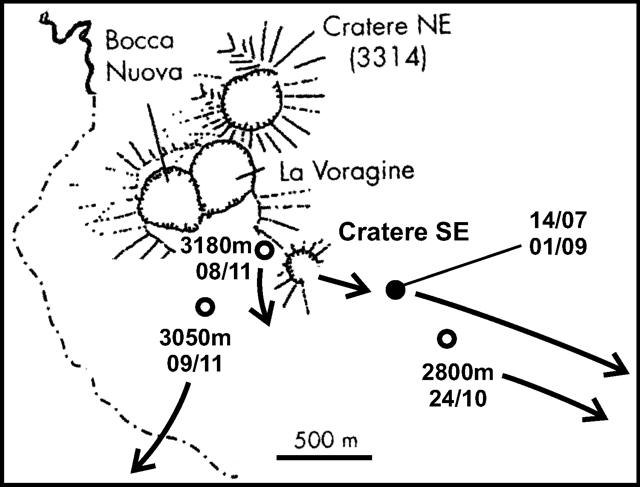 | Figure 115. Location and elevation of various fissure vents that appeared in the area of Etna's SE Crater during October and November 2006. Samples were collected from the SEC flow on 14-23 July and 1 September, the 2,800-m flow on 24 October, 3,180-m flow on 8 November, and the 3,050-m flow on 9 November 2006. Courtesy of Roberto Clocchiatti and colleagues. |
Whole-rock analyses from 24 October onward show a significant increase of the MgO content and of the CaO/Al2O3 ratio (figure 116). The higher MgO and CaO, as compared to lower Al2O3 and alkalis, indicate a larger content of olivine and Ca-rich clinopyroxene at the expense of less plagioclase, so that the last analyzed lava is very close to a basalt composition (5.7% MgO, 10.7% CaO, 11.6% total Fe as Fe2O3, and 5.8% Na2O + K2O).
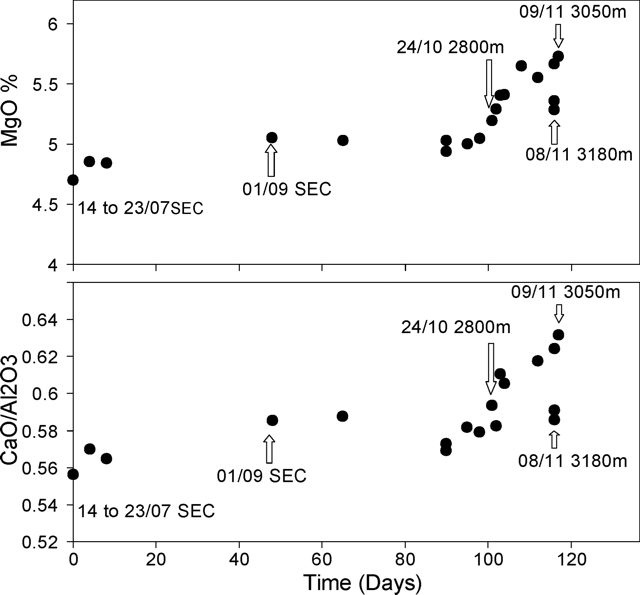 | Figure 116. Plots showing increases through time of the MgO content and the ratio of CaO to Al2O3 at Etna beginning on 24 October 2006. Courtesy of Roberto Clocchiatti and colleagues. |
References. Clocchiatti, R., Condomines, M., Guénot, N., and Tanguy, J.C., 2004, Magma changes at Mount Etna: the 2001 and 2002-2003 eruptions: Earth Planet. Sci. Lett. 226, p. 397-414.
Corsaro, R.A., and Miraglia, L., 2005, Dynamics of the 2004-2005 Mt. Etna effusive eruption as inferred from petrologic monitoring: Geophys. Res. Lett. vol. 32, L13302.
Information Contacts: Roberto Clocchiatti, CEN Saclay, 91191 Gif-sur-Yvette Cedex, France; Gilles Chazot, Observatoire de Physique du Globe Clermont, 63038 Clermont Ferrand, France; Jean-Claude Tanguy, IPGP, Observatoire de St. Maur, 94107 St. Maur des Fossés, France; Giovanni Tringali, Osservatorio Meteorologico, Geodinamico e Ambientale (Omega), 95024 Acireale, Italy.
February 2007 (BGVN 32:02)  Cite this Report
Cite this Report
Episodes of eruptions continue between 4 November and 14 December 2006
The 10-day-long eruption of Etna's Southeast Crater (SEC) in mid-July 2006 (BGVN 31:08 and 31:10) was considered by scientists at the Istituto Nazionale di Geofisica e Vulcanologia (INGV) to represent a distinct phase of 2006 activity for Etna. They identified a very different phase when eruptive activity shifted to SEC's summit vent between 31 August and early 15 September 2006. The latter activity led to lava overflows and repeated collapse on SEC's E side. The seven eruptive activity episodes previously described (BGVN 31:10) have since been renumbered slightly, with Episode 1 taking place between 31 August and 16 September.
The following report was compiled from recent reports by Boris Behncke and Sonia Calvari, based on daily observations by numerous staff members of the INGV Catania (INGV-CT). This issue overlaps with our previous Bulletin reports and then goes on through the end of 2006.
Overview of the 31 August to 14 December eruption. Figure 117 indicates key vents and lava flows during the period 4 September-7 December 2006. It excludes lavas emitted during the short but intense final episode (Episode 20, 11-14 December 2006), but they did not significantly extend beyond flow margins shown here. The longest lava flows of the reporting interval reached ~ 4.7 km SE from their source vent (figure 117).
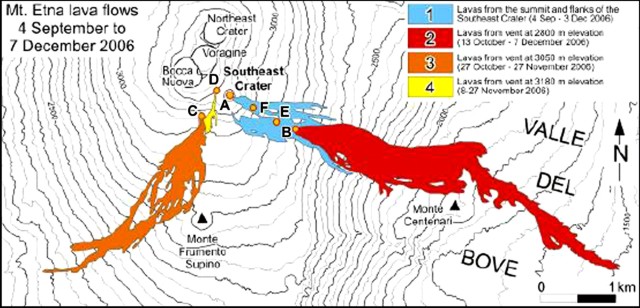 | Figure 117. Map Etna showing lava flows and their corresponding periods of activity: (1) lavas from the summit and flanks of the SEC, 4 September-3 December 2006; (2) lavas from the 2,800-m vent, 13 October-7 December 2006; (3) lavas from the 3,050-m vent, 27 October-27 November 2006; and (4) lavas from 3,180-m vent, 8-27 November 2006. The capital letters indicate the most persistent eruption sources: (A) SEC summit; (B) 2,800?m vent; (C) 3,050-m vent; (D) 3,180-m vent; (E) 3,100-m vent (active between 30 November and 3 December 2006); and (F) the foundation crater of the 23 October 2006 activity (which developed a pit that was also active between 24 November and 7 December 2006). Courtesy of INGV-CT; Behncke, Branca, Neri, and Norini (2006). |
Table 9 summarizes the 20 episodes of recent eruptive activity, as currently identified by the INGV staff. Note, however, that episode numbers have changed since discussed in BGVN 31:10. One earlier episode has been added (31 August-15 September). Former Episodes 1-7 as listed in BGVN 31:10 based on earlier INGV reports, have been renumbered to Episodes 2-8. Subsequent episodes (9 through 20) are the main subject of this report.
Table 9. List of eruptive episodes (1-20) at Etna as reported by INGV-CT for the interval 31 August-December 2006. "Former number" refers to the episode numbers stated in BGVN 31:10 but here revised. Geberal morning and afternoon times are indicated by am and pm, respectively. Courtesy of INGV-CT.
| Episode (former number) | Dates (2006) | Comments on onset of episode |
| 1 (new) | 31 Aug-15 Sep 2006 | Eruptive activity shifted to SEC's summit vent (see BGVN 31:10). |
| 2 (1) | 22 Sep (pm)-27 Sep (am) | Mild Strombolian explosions for first 2 days. |
| 3 (2) | 03 Oct (pm)-6 Oct (am) | Started with Strombolian explosions from SEC summit, increasing in vigor during the following hours. |
| 4 (3) | 10 Oct (late pm)-11 Oct (late pm) | Vigorous Strombolian activity and lava descending SE flank of SEC cone. |
| 5 (4) | 20 Oct (0500-late) | Rapid increase in tremor amplitude, vigorous Strombolian activity in the central SEC summit and isolated large explosions from a vent near the E rim. |
| 6 (5) | 23 Oct (0600-?) | Vigorous Strombolian activity and pulsating lava fountained from two vents at the summit of the SEC. |
| 7 (6) | 25 Oct (late pm)-26 Oct (late pm) | Marked increase in tremor amplitude and ash emissions from the summit of the SEC, which produced only weak Strombolian activity. |
| 8 (7) | 27 Oct (pm) | Increase in tremor amplitude and ash emissions from the SEC (see text for 26 Oct-4 Nov). |
| 9 | 29-30 Oct | Pulse of activity. |
| 10 | 05 Nov (2004)-06 Nov (am) | Strong eruptive episode started at SEC summit vent and continued with some fluctuations and intermittent ash emissions. |
| 11 | 08 Nov (until 2200) | Ash emissions from summit of SEC, followed by vigorous Strombolian activity. |
| 12 | 10 Nov (2100)-11 Nov (1100) | Tremor amplitude rapidly increased, bad weather hampered visual observations. |
| 13 | 16 Nov (0500-late pm) | Lava issued from the 3,180-m vent, sharp increase in tremor amplitude, vigorous ash emissions at the SEC summit, these gradually replaced by intense Strombolian bursts. |
| 14 | 19 Nov (0400)-20 Nov (am) | Strombolian activity at SEC occurred from two vents at the summit, lava flowed through the 16 November trench. |
| 15 | 21 Nov (1200)-23 Nov (0000) | Inclement weather, a black ash plume rose to 1.5 km above the summit. |
| 16 | 24 Nov (0219-1530) | Ash emissions mixed with Strombolian explosions at the SEC. |
| 17 | 27 Nov (0410-pm) | SEC monitoring camera recorded thermal anomaly and an ash plume. |
| 18 | 31 Nov (1600)-03 Dec (am) | Rising lava fountains followed 2 hours later by the '23 October pit' emitting dense ash and Strombolian explosions. |
| 19 | 06 Dec | Increased tremor implied weak Strombolian activity and ash emission at SEC. |
| 20 | 11 Dec (0330)-14 Dec (pm) | Strombolian explosions and voluminous lava flows from 2,800-m vent, ash from '23 October pit'. |
Episode 9. Although there were no real paroxysms of Strombolian activity or lava fountaining at the SEC during 26 October-4 November, clear pulses of activity occurred at the effusive vents at 2,800 and 3,050 m elevation, accompanied by ash emission or weak Strombolian explosions at the SEC. These events defined Episode 8, on 27 October, and Episode 29, which took place during 29-30 October. The clear pattern of distinct paroxysms from the SEC finally returned on 5 November and lasted through late that month, before the activity became again more continuous early in December.
Episode 10. Following one week of intermittent ash emissions and weak Strombolian activity on late 4 November, a new strong eruptive episode started at the SEC summit vent at 2004 on 5 November and continued with some fluctuations and intermittent ash emissions for the next 9.5 hours. Light ashfalls occurred over populated areas to the SE. At about 2147 on 5 November, the effusion rate increased at a vent at 3,050 m elevation at the S base of the central summit cone (C on figure 117) which had been continuously active since 27 October. A new lobe of lava traveled S of the summit cone complex across a flat area known as the Cratere del Piano.
An apparent increase in the effusion rate was also noted at the effusive fissure at 2,800 m elevation on the ESE flank (B on figure 117), with active lava lobes extending downslope. Lava effusion from the 3,050-m vent ended during the morning of 6 November, and for the following 48 hours, lava emission continued only at the 2,800-m vent.
Episode 11. Ash emissions from the summit of the SEC occurred on 8 November 2006, followed by vigorous Strombolian activity that continued until about 2200. Around 1600, lava started to flow from a new vent located in the saddle between the SEC cone and the adjacent main summit cone, at an elevation of ~ 3,180 m (D on figure 117). The lava reached the SW base of the SEC cone in a few minutes, where it bifurcated into several short lobes, the largest and westernmost lobe stopping at the E margin of the lava flow field from the 3,050-m vent. Lava from the 3,180-m vent had ceased flowing by about 1845, whereas spattering and lava effusion continued at the 3,050-m vent for some time. Spattering ended at that vent around 1930, but lava continued to flow for another 24 hours.
Episode 12. At 2100 on 10 November 2006, tremor amplitude rapidly increased. Bad weather hampered visual observations until 11 November, when it became evident that this episode was quite similar to its predecessor, with lava emission occurring from both the 3,050-m and 3,180-m vents. Strombolian activity from the SEC summit ceased at 1100 on 11 November. Lava emission from the 3,050-m vent continued until the following night, and the associated lava flow field grew mainly on its W side, with flow fronts descending to ~ 2,800 m. For the next five days, lava emission continued unabated from the 2,800-m-vent, whereas the SEC and all other vents remained inactive.
Episode 13. Following a sharp increase in tremor amplitude at 0500 on 16 November, vigorous ash emissions started at the SEC summit at 0507 and were gradually replaced by intense Strombolian bursts, marking the onset of this eruptive episode.
Very early during the episode, lava issued from the 3,180-m vent, forming a lobe ~ 100 m long before activity at this vent ceased.
Lava effusion from the summit started at 0615 on 16 November and triggered a series of rockfalls down the SE flank of the SEC cone, before the lava descended on the same flank. At 0626, brownish ash was emitted from a spot next to the effusive vent, and major rockfalls and avalanches started shortly thereafter. These originated at the S rim of what remained of the 2004/2005 collapse pit on the E flank of the SEC (see BGVN 30:01 and 30:12). Plumes rising from the descending avalanches contained both brownish ash and white steam. Avalanching was most intense between 0631 and 0640, after which the new lava flow rapidly descended the lower SE flank of the cone and began to extend beyond its base toward the area of the 2,800-m vent. At the same time, strong emissions of black ash marked the opening of another explosive vent next to the summit, and a third explosive vent became active in the same area. For the next several hours, the vents continued to eject ash and occasionally bombs, and to produce vigorous Strombolian activity.
At 0700 on 16 November emissions of white vapor occurred from the SE flank of the SEC cone; a few minutes later large rock avalanches started to descend that flank. Simultaneously a fissure began to open near the summit to downslope on the SSE flank, triggering local rockfalls and dust avalanches. This fissure initially propagated ~ 100 m downslope, then it temporarily stopped; but at 0720, it propagated another 150 m downslope. During the following 15 minutes, another fissure perpendicular to the earlier one cut SE across the flank, generating more rockfalls and dust avalanches. The resulting fissure system had the form of an inverted Y delimiting a block that was actively pushed outward by magma intruding into the cone's flank.
Lava began to issue from the lower end of the W branch of the fissure system at about 0810 on 16 November. At approximately the same time, the 3,050-m vent started to emit lava. By this time, the upper portion of the fissure cutting the SSE flank of the SEC cone had significantly enlarged and became a deep trench. Dense volumes of steam were emitted from this trench at 0831 and were followed a few minutes later by another series of rockfalls and avalanches. Direct observation from ~ 700 m showed that the most energetic of these avalanches resulted from the collapse of low fountains of gas and tephra at the lower end of the large trench. The avalanches and rockfalls lasted about 15 minutes, then a voluminous surge of lava issued from the lower end of the opening trench.
Over the next few hours this sequence of events (vapor emission?rockfalls and avalanches?lava emission) was repeated several times as the trench widened and propagated further downslope. During the few moments when steam and dust clouds cleared and the interior of the trench became visible, a cascade of very fluid lava was seen in the center of the trench. Apparently, the lava issued from a source high in the head wall of the trench, and at times spurted from the vent like a firehose.
At 1100 on 16 November, white steam plumes, rockfalls, and dust avalanches appeared high on the SE flank of the SEC cone, in the area where the summit lava flow was emitted. These phenomena marked a major collapse of the E wall of the trench, which eventually cut into the descending summit lava flow, diverting it into the trench. The original flow, which had descended immediately S of the 2,800-m vent down to ~ 2,600 m elevation, rapidly stopped, although lava continued to drain from the main flow channel and accumulated in a thickening lobe at the cone's base.
At about 1425 on 16 November, several vertical jets of black tephra shot upward from an area at ~ 150 m distance from the cone's base. These emissions were very distinct in color from the brownish dust clouds, which at the same time descended from the trench. The activity at the new site appeared to migrate rapidly both toward the SEC as dark plumes began to rise closer to the cone, while a ground-hugging plume of white vapor shot in the opposite direction. A few ten's of seconds later, very dense clouds of dark brown material began to appear at the base of the surging white cloud and formed a distinct flow that rapidly overtook the front of the white cloud while speeding toward SE. At the slope break along the W rim of the Valle del Bove (~ 2,800 m elevation), both clouds disappeared from view in weather clouds, but at the site where the activity had originated, a huge plume of white vapor soared skyward. White vapor continued to rise from the area and from the path of the white and dark brown clouds for more than 15 minutes.
Another explosive emission of white steam and dark brown plumes occurred at about 1455. Like the 1425 event, it generated ground-hugging clouds of steam and dark brown material, the latter again traveling faster. During the following hours, activity at the SEC gradually decreased, with several spectacular cascades of lava descending through the trench on the cone's SSE side. Steam explosions and rock avalanches occurred at the lower termination of the trench at 1525. Strombolian activity ceased at 1500 on 16 November, but lava emission continued until about midnight. This lava does not seem to have extended far from the base of the SEC cone, since investigation during the following day failed to reveal any fresh lava on top of the debris deposits emplaced during the major explosive events at 1425 and 1455. A minor lava flow was also fed from a new short fissure ~ 80 m E of the 3,050-m vent. During the evening a small lobe of lava was emitted from the accumulation at the SEC cone's base.
Fieldwork and aerial surveys during the two days following 16 November revealed that the 1425 and 1455 explosions and related volcaniclastic density currents (figure 118) had left two main types of deposit. One was of lobate shape and extended a few hundred meters from the source of the explosions to the SE, covering a footpath established by mountain guides to allow tourists to approach the persistently active 2,800-m vent.
 | Figure 118. One of the peculiar density currents at Etna that occurred during Episode 13, 16 November 2006. The photo was taken from the N side of the large 2002-2003 cone complex, ~ 1.3 km S of the SEC. Seen in the photo are strong emissions of dark gray ash from two vents at the summit (a third caused intense Strombolian activity, but not in the moment shown in the photo). A huge gash carved out of the near right side of the cone emitted a lot of white vapor, with lava flowing from its lower end, and a ground-hugging brownish ash cloud spilling downslope on top of the flowing lava. Photo courtesy of INGV-CT. |
On the ground the deposit consisted of very fine grained reddish-brown ash made up almost exclusively of lithic fragments. To the N the deposit gradually thickened and larger clasts were found on its surface, some of which represented fresh magmatic material. Close to the 2,800-m vent, the deposit abruptly graded into a sort of debris flow rich in lithics but with up to 25% of fresh magmatic clasts. These latter showed a peculiar flattened-out morphology. Where this deposit overlay the tourist path near the 2,800-m vent it was 1.52 m thick. In one place the flow had surrounded a plastic-coated sign warning tourists to stay on the path. The plastic lacked evidence of strong heating, indicating that the flow was relatively cool at this point along its path.
Volcanic tremor amplitude began to increase during the late afternoon of 18 November and, during a helicopter flight at 1800, the 2,800-m vent showed vigorous spattering. Active lava from the vent traveled ~ 3 km to Monte Centenari. Bright incandescence was also noted within the 3,180-m vent during this overflight.
Episode 14. At 0400 on 19 November, Strombolian activity at the SEC occurred from 2 vents at the summit while lava flowed through the 16 November trench and divided into numerous braiding lobes on top of the debris deposited 3 days earlier. The longest lobe traveled along the prominent channel in the main debris flow, passing immediately to the S of the 2,800-m vent and extending to an elevation of ~ 2,600 m. This episode was much less violent than its predecessor and lacked the explosions, surges, and flows characteristic of that event. Strombolian activity continued until the late evening, while lava effusion ended early on 20 November. As during previous episodes, lava had also briefly issued from the 3,050-m and 3,180-m vents. In addition, a flow of a few meters in length started from another fissure that opened at ~ 3,200 m, on the saddle between Bocca Nuova and SEC. This upper flow merged with the flow coming out from the 3,180-m vent.
Episode 15. This eruptive episode at the SEC started at 1200 on 21 November 2006, but direct observations were thwarted by inclement weather through nightfall. At about 1500, a black ash plume was seen rising above the cloud cover to ~ 1.5 km above the summit. Light ashfalls occurred along the Ionian coast near Giarre and further N, while at Rifugio Citelli (~ 6 km NE of the SEC), ash deposition was nearly continuous.
After 1900, the cloud cover gradually opened, allowing direct views of the strong Strombolian explosions generating jets sometimes over 300 m high. Lava once more flowed through the 16 November trench on the cone's SSE flank toward the 2,800-m vent. Likewise, the 3,050-m and 3,180-m-vents reactivated, although the latter apparently ceased erupting early during the episode. Lava flowed from the trench until shortly after midnight on 22 November. Bad weather precluded observations until the evening, when all activity was again limited to the 2,800-m vent.
Episode 16. At 0219 on 24 November, there began ash emissions mixed with Strombolian explosions. These were recorded by the INGV-CT thermal camera in Nicolosi (~ 15 km S of the SEC) with a significant anomaly occurring at the SEC summit. Strombolian activity at 0320 was accompanied by voluminous ash emission, which formed a plume that rose ~ 2 km above the summit before being blown to SE.
Two particularly powerful explosions occurred at 0452 and 0455. The latter was followed by lava extruding from a vent presumably located within the 16-November trench. At around 0535, lava began to issue from the 3,050-m vent, forming a small flow on the W side of the lava flow field emplaced since 26 October. A second minor flow issued from another vent located ~ 80 m SE of the 3,050-m vent. Vigorous ash emission from the summit of the SEC caused light ashfalls over populated areas between Zafferana and Acireale (figure 119).
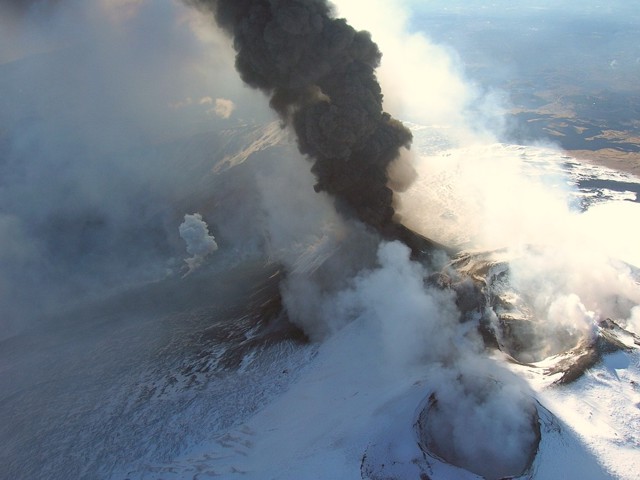 | Figure 119. Dark ash plume rising from Etna's SEC during eruptive Episode 16 on the morning of 24 November, photographed from a helicopter provided by the Italian Department of Civil Protection (Dipartimento di Protezione Civile) during that day's particularly explosive episode. A small steam plume at left rises from the area of the 2,800-m vent. More diffuse gas emitted from active lava flows engulfs the photo's extreme left. Etna's other summit craters (Northeast Crater foremost, with Voragine and Bocca Nuova behind) are in the lower right corner of the image, showing normal degassing activity. View is approximately to the S. Courtesy of INGV-CT. |
A fracture opened at about 0817 at the SSE base of the SEC cone, producing a violent explosion and a rock avalanche that descended at a speed of several ten's of km/h toward the Valle del Bove, following the path of similar avalanches that had occurred on 16 November. Lava effusion continued from vents at the cone's base, where mild spattering was observed. Upslope from the effusive vent at 2,800 m elevation, a second fracture formed and commenced spattering and lava emission.
During the early afternoon a change in the wind direction drew the plume from its earlier SE-ward course toward Catania and adjacent areas, forcing the closure of the Fontanarossa International airport of Catania. The activity began to diminish, and by 1530 all explosive phenomena ceased. For several more hours lava continued to issue from two vents at the SEC cone's base.
Late in the afternoon of 24 November, weak sporadic Strombolian explosions occurred from a pit located on the E flank of the SEC cone, which had formed during the 23 October eruptive episode (hereafter, '23 October pit' identified as F on figure 117). On 25 November this vent produced pulsating ash emissions that continued intermittently for the next two days.
Episode 17. At around 0410 on 27 November, eruptive activity occurred at the SEC and the thermal monitoring camera at Nicolosi began to record a significant thermal anomaly at the crater and a W-drifting ash plume. Visual observations were hampered by inclement weather. Around 0730, the thermal camera at Nicolosi disclosed lava emission on the W side of the SEC cone, possibly from the vent at 3,180 m elevation in the saddle between the SEC and the Bocca Nuova. About 45 min later, lava emission became evident at the cone's SE base. No further visual observations were available after 0845, but the tremor amplitude remained high until the afternoon, when a sharp drop indicated the end of this eruptive episode.
Bad weather persisted until early on 29 November when observers saw ash emissions from the '23 October pit.' These emissions became more intense after 0545, and the tremor amplitude began to increase rapidly during the late morning. Intermittent, weak Strombolian activity from the '23 October pit' was visible after nightfall; this became notably stronger shortly after 0100 on 30 November and reached its highest intensity around 0130, after which there was a notable decrease. Ash emissions occurred from the same pit at dawn and again from 1240 onward, producing low ash plumes.
Episode 18. At around 1600 on 30 November 2006, lava fountains began to rise from the 2,800-m vent. Two hours later the '23 October pit' emitted a dense ash plume, and Strombolian explosions reached up to 150 m above the vent. At 2045, a fissure opened at ~ 3,100 m elevation, venting spatter several ten's of meters high and releasing a short lava flow towards the 2,800-m vent. After about 10 min the effusion rate at this new fissure diminished, but lava continued to escape at a decreasing rate for ~ 1 hour. The '23 October pit' remained vigorously active for the next 5 hours, producing incandescent jets and a dense tephra plume.
The new fissure at 3,100 m elevation revived around 0115 on 1 December, with vigorous spattering and a new surge of similarly directed lava. At the same time, the '23 October pit' emissions strongly increased. Like on the evening before, the new fissure at 3,100 m elevation remained active only for a short time; lava emission ceased by 0200 on 1 December.
The 2800-m vent produced the largest lava flows during the entire period of activity, in this episode extending lava flows to ~ 1,500 m elevation on the Valle del Bove floor, to a distance of ~ 4.7 km from their source.
Between 1-3 December, the '23 October pit' remained active with nearly continuous emissions of ash interspersed with Strombolian activity. This was accompanied by the 3,100-m fissure emitting low fountaining and lava; lava flows from that fissure were generally short and did not extend far beyond the 2,800-m vent. The last observed activity at the 3,100-m vent occurred during the morning of 3 December. Ash emissions from the '23 October pit' continued for another few days but became progressively weaker; likewise the lava emission at the 2,800-m vent diminished gradually.
Episode 19. Weak Strombolian activity and ash emission occurred at the SEC on the afternoon of 6 December, evidenced by increased tremor, but the amplitude dropped rapidly to very low levels implying that the SEC ceased erupting late on 6 December. Minor lava emissions continued from the 2,800-m vent. On the morning of 8 December, no eruptive activity was visible at any of the numerous vents of the previous weeks. Following several days of very low tremor amplitude, it began to increase again late on 10 December.
Episode 20. Eruptive activity resumed around 0330 on 11 December 2006 from the '23 October pit' on the SEC, with Strombolian explosions documented by INGV-CT's monitoring cameras. Simultaneously, lava emission started from the area of the 2,800-m vent, forming a flow that slowly descended toward the Valle del Bove. Bad weather hampered observations during the following days, but occasional clear views revealed ash emissions from the '23 October pit.' In addition, there were voluminous lava emissions from the 2,800-m vents, feeding a broad lava flow adjacent the N margin of the lava flowfield produced from the same vent between mid-October and early December. The 2,800-m vents generated vigorous Strombolian explosions from two vents that built up a pair of large hornitos, and lava emissions came from a third vent located on the lower E flank of the larger, more easterly of the hornitos. No activity occurred from any other of the numerous vents that had been active during the previous weeks at the summit and in the vicinity of the SEC. Late in the afternoon of 14 December, a sharp drop in tremor amplitude indicated that the end of this final eruptive episode was imminent, and field observations made on the following morning revealed the absence of eruptive activity.
INGV considered Etna's 2006 summit eruptions during 14 July-14 December and made a rough estimate of erupted lava volumes. The total volume produced during those 5 months amounted to ~ 15-20 x 106 m3.
There was a single, relatively small ash emission from Bocca Nuova on 19 March 2007, discharged without an associated seismic signal. This was followed ten days later by a brief episode of violent lava fountaining and tephra emission from the SEC. Details on that and subsequent activity will be reported in a future Bulletin.
References. Behncke, B., and Neri, M., 2006, Mappa delle colate laviche aggiornata al 20 Novembre 2006 (1 page PDF file on the INGV website) and Carta delle colate laviche emesse dall'Etna dal 4 Settembre al 7 Dicembre 2006 (Map of lava flow emissions at Etna from 4 September to 7 December 2006).
Behncke, B., Branca, S., Neri, M., and Norini, G., 2006, Rapporto eruzione Etna: mappatura dei campi lavici aggiornata al 7 Dicembre 2006 (Report of Etna eruption: map of lava flows up to 7 December 2006): INGV report WKRVGALT20061215.pdf.
Information Contacts: Sonia Calvari and Boris Behncke, Istituto Nazionale di Geofisica e Vulcanologia-Catania (INGV-CT), Sezione di Catania, Piazza Roma 2, 95123 Catania, Italy (URL: http://www.ct.ingv.it/).
March 2007 (BGVN 32:03)  Cite this Report
Cite this Report
Eruptions continue in April 2007
Recent eruptive episodes occurred between 4 November and 14 December 2006, with small eruptions on 19 and 29 March 2007 (BGVN 32:02). According to the Istituto Nazionale di Geofisica e Vulcanologia Sezione di Catania (INGV), there were other noteworthy eruptions on 11 and 29 April 2007.
The eruption of 19 March was captured on video as well as a thermal monitoring system. The thermal data appear on figure 120, which also includes data from a reference site away from the eruption (lower panel). Both sites underwent similar diurnal variations due to solar warming and night-cooling effects. The 19 April 2007 eruption appears as a 37°C upward spike in apparent temperature (computed from the sensor system).
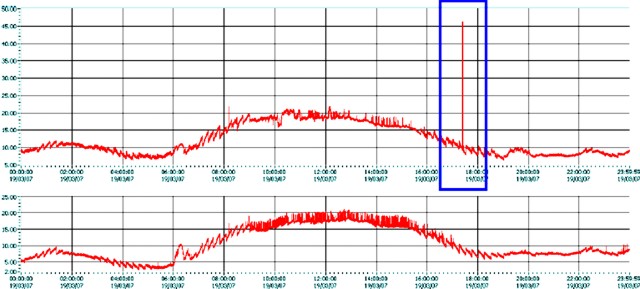 | Figure 120. Time-series plot showing the apparent temperatures (in degrees C) at Etna recorded by the NEW SARATER monitoring system during the explosive event at the Bocca Nuova on 19 March 2007. The upper graph shows the thermal data from the summit crater zone (rectangular inset), where the increase in temperature related to the explosive event stands out boldly. The lower graph shows the thermal data for the same period but from a region outside of the summit crater area and notes solely the daily oscillation of apparent air temperature tied to solar warming. Time shown is UTC. Courtesy of INGV. |
The INGV reported that the 29 March eruption took place at Bocca Nuova. Two new lava streams emerged near the summit, one at 3,180 m elevation, and the other at 3,050 m elevation. The lava flows advanced initially but ultimately halted after related emissions only lasted several hours (ceasing at 1500 local time).
INGV's report on the 11 April event noted an increase in volcanic tremor, followed by lava fountaining. That eruption lasted about 5 hours. A resultant ash plume drifted E with ashfall reported as far as Zafferana, about 10 km E. Two lava flows were observed at the summit of Etna, one to the E within the large depression on the side of the volcano known as the Valle del Bove and the second to the S. The E lava flow stopped 3 km away at the base of the Serra Giannicola Grande, within the W Valle del Bove. The second flow stopped near Mt. Frumento Supino (less than 1 km S of the summit).
A new summit eruption began on 29 April 2007 with a general increase in tremor followed by fire fountaining and a vertical ash cloud. The INGV-CT monitoring webcams showed the evolution of this eruptive phase that lasted about 8-9 hours. At 1600 the thermal webcam at Nicolosi registered a thermal anomaly at the Southeast Crater (SEC); there were also reports of rumbling from the summit craters. At 1834, explosions of lapilli and ash were observed almost continuously, together with lava emission very near the explosive vent (figures 121 and 122). A lava flow followed the fissure on the SE flank of the SEC, which had opened during November 2006. Another flow moved E within the Valle del Bove.
 | Figure 121. Activity at Etna's Southeast Crater at 1834 on 29 April 2007, seen from the S at Torre del Filosofo. Courtesy of INGV. |
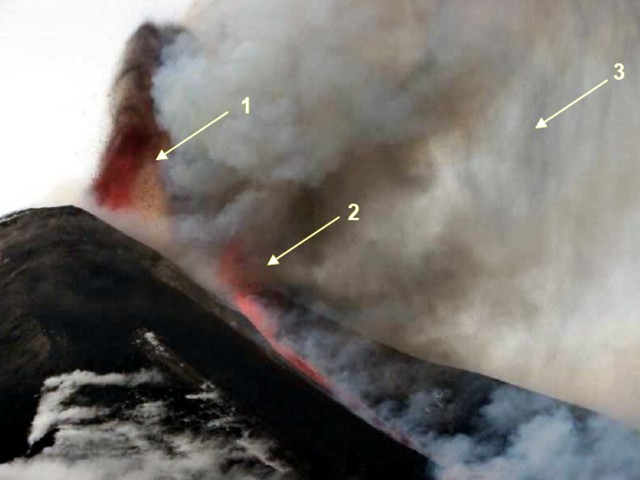 | Figure 122. Etna in eruption on 29 April 2007. Arrows denote strong explosive Strombolian activity (1), spattering (2), and lapilli and ashfall (3). The spattering and related extrusions fed a lava flow descending as an incandescent ribbon. Courtesy of INGV. |
Information Contacts: Sonia Calvari, Istituto Nazionale di Geofisica e Vulcanologia, Sezione di Catania, Piazza Roma 2, 95123 Catania, Italy (URL: http://www.ct.ingv.it/).
July 2007 (BGVN 32:07)  Cite this Report
Cite this Report
Ash emissions started 15 August and built a small cinder cone on SEC's E flank
According to Sonia Calvari of the Istituto Nazionale di Geofisica e Vulcanologia Sezione di Catania (INGV-CT), on 15 August the Southeast Crater (SEC) at the summit of Mount Etna began to produce ash emissions. They emerged at the depression that cuts the SEC's E flank. The ash cloud was very diffuse, rising for just a few ten's of meters above the source, and it was quickly dispersed by the wind. Reddish-colored ashfall deposits were observed only on the flanks of the SEC cone.
During the night of 21 August the summit web-camera of INGV-CT recorded incandescent blocks erupted during the most energetic emissions. A field survey on 22 August observed few very energetic events (about 20% of the total), cases where the ejection of hot, lithic blocks fell on the E flank of the cone. On 24 August, researchers from INGV on the summit with a thermal camera recorded the first short Strombolian sequence. Strombolian explosions increased in intensity and became more common through August, slowly amassing material to create a cinder cone within the depression on the SEC's E flank. Etna's emissions continued through August (figure 123) and into at least early September. Later INGV reports noted a strong eruption during 4-5 September.
 | Figure 123. Cropped images from the INGV-CT webcamera of a night eruption at Etna at 0300 on 31 August 2007 showing a Strombolian eruption (left) and a daylight photo five hours later (0800 on 31 August) of the same region (right). The arrow indicates the point of emission. Courtesy of INGV-CT. |
Information Contacts: Sonia Calvari, Istituto Nazionale di Geofisica e Vulcanologia Sezione di Catania, Piazza Roma 2, 95123 Catania, Italy (URL: http://www.ct.ingv.it/).
August 2007 (BGVN 32:08)  Cite this Report
Cite this Report
Explosive activity and lava fountains during 4-5 September 2007
A report by members of the Istituto Nazionale di Geofisica e Volcanologia di Sezione Catania (INGV-CT), Behncke and Neri (2007), discussed Etna's 4-5 September eruption. On 6 September field work on the eastern zone of the Southeast Crater (SEC) revealed profound morphologic changes. The SEC's eastern pit crater was the source of lava flows.
The erupted material was distributed mostly to the E, covering the plateau between the base of the SEC and the western rim of the Valle del Bove with a thickness ranging from a few meters to more than 25 m (figure 124). The accumulation of welded scoria formed a mound more than 700 m long.
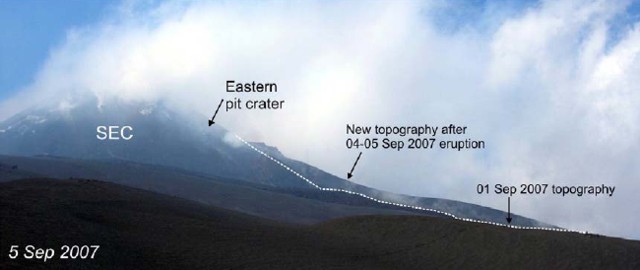 | Figure 124. The Southeast Crater cone at Etna seen from the SSE. The white dotted line shows the eruption topography before the 4-5 September 2007 eruption. The photo highlights significant new material over the old topography. From Behncke and Neri (2007). |
The scoria mound, which formed by falling material, was composed primarily of extremely light and vesicular scoria, of varying size, from less than a centimeter to meters, oxidized and reddish in color. The thickness of the scoria deposits varied from over 25 m at the base of the SEC to about 8 m in the area around the western rim of the Valle del Bove, behind hornitos at ~ 2,800 m elevation, which formed during the 2006 eruption.
The scoria appeared to have moved after landing. In addition, localized movement also occurred along some wide-opening fracturing.
During the formation of the scoria mound, lava descended as three principal streams. The streams emerged from the SE sector of the eruptive crater (venting at the Eastern pit crater) (figure 125).
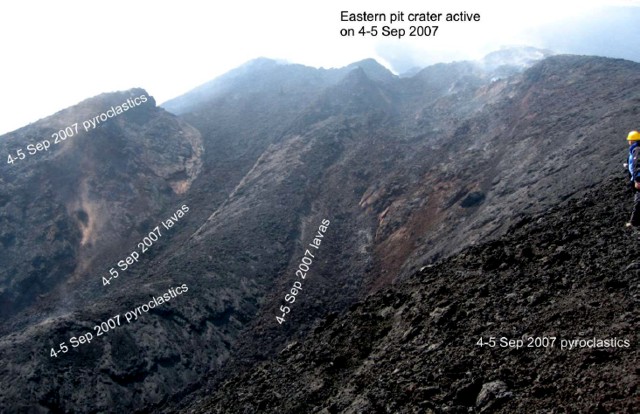 | Figure 125. Lava flows and pyroclastic materials on the E flank of Etna's Southeast Crater from the 4-5 September 2007 eruption. Labels indicate lithologies. The observer (right) is on the mound of larger scoria, about 150 m from the crater. Photo from Behncke and Neri (2007). |
The field observers saw the southern rim of the eruptive crater and the zone beneath it. To an elevation of about 2,800 m, these rocks emitted fumarolic vapors and contained hot fractures. The position of this fissure field appeared to coincide, at least in part, with what had already been identified by thermal telecamera during the helicopter survey carried out by the governmental Regional Civil Protection. Inside the 4-5 September eruptive vent (Eastern pit crater seen in figures 125 and 126), the team also saw a point of continuous and pulsating gas emissions.
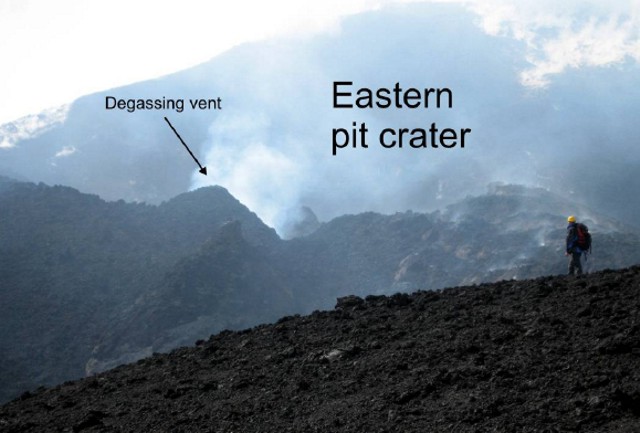 | Figure 126. At Etna's SEC, this photo shows the degassing vent inside the active crater. Courtesy of INGV. |
Reference. Behncke, B. and Neri, M., 2007, L'eruzione del 4-5 settembre 2007 al Cratere di Sud-Est (Etna): osservazioni di terreno in prossimit? della bocca eruttiva; copyrighted report of the INGV-CT (posted on their website and accessed October 2007).
Information Contacts: Sonia Calvari, Boris Behncke, and Marco Neri, Istituto Nazionale di Geofisica e Vulcanologia (INGV), Sezione di Catania, Piazza Roma 2, 95123 Catania, Italy.
September 2007 (BGVN 32:09)  Cite this Report
Cite this Report
4-5 September eruption emitted long-duration fountains; lava flows extend 4.6 km
Although BGVN 32:08 discussed the eruption of 4-5 September 2007, this report goes on to more fully describe Etna's lava fountaining at the Southeast Crater (SEC) observed during that eruption, and also adds other details such as a map of the resulting lava flow. The fountain associated with the eruption was spectacular, though by far not the tallest seen on Etna (that was 8 years earlier, on 4 September 1999, at the Voragine, when a fountain rose over 2 km high). The fountaining lasted a full 10 hours, whereas most other recent fountains on Etna only lasted 15-20 minutes.
As background, Etna became active on 15 August 2007 following four eruptive episodes on these dates: 29 March 2007, 11 April, 29 April, and 6-7 May 2007. At the end of August, ash emissions were nearly entirely replaced by Strombolian activity.
The header at the top of this report contains a new summit elevation corrected to the latest LIDAR (light detection and ranging) data, which was acquired in the Spring of 2007. It revises an older estimate of 3,350 m to 3,330 m.
A significant increase in tremor amplitude took place at ~ 1600 on 4 September. After that, a sustained lava fountain rose from the SEC's August-September vent, jetting to 400-600 m above the vent for the next ~ 10 hours (figure 127). A dense tephra plume blew E toward the Ionian Sea. Lava flowed over the vent's E and SE rims, initially forming three branches that coalesced at a short distance from the SEC and descended as a single flow toward the Valle del Bove, to a distance of 4.6 km (figure 128).
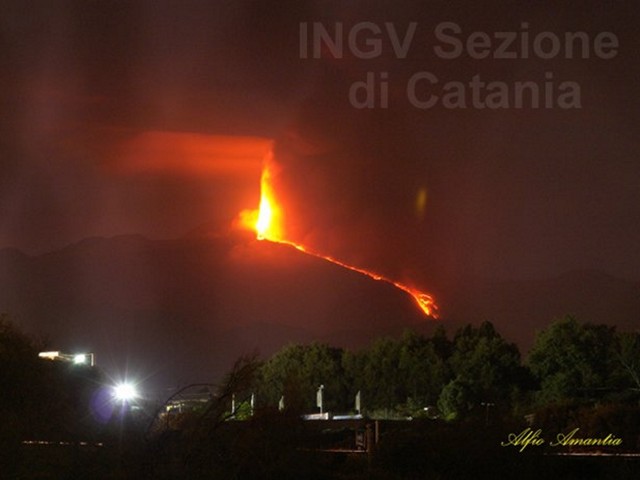 | Figure 127. Lava fountain and flow emitted at the SEC on 4 September 2007. The photo was taken from the Acireale in Catania, ~ 20 km SE of Etna. Courtesy of INGV-CT and Alfio Amantia (credit on the photo). |
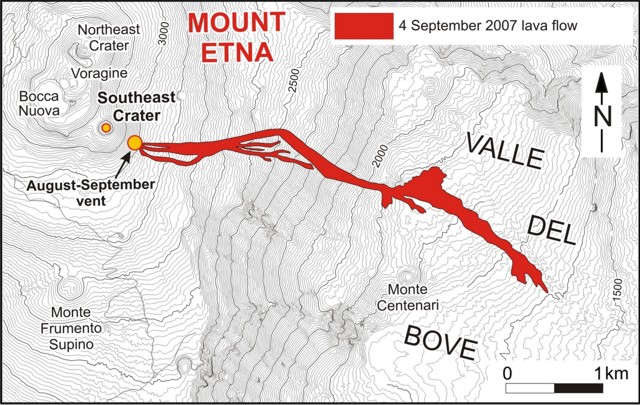 | Figure 128. Preliminary map of Etna's lava flow emitted during the 4-5 September 2007 lava fountain of the Southeast Crater. The eruptive August-September vent is indicated on the eastern slope of the Southeast Crater cone. Courtesy of Boris Behncke and Marco Neri (INGV). |
Heavy showering of tephra occurred on the E flank in the areas between the towns of Fornazzo, Milo, and Giarre. As a precaution, the International Airport of Catania was closed for a few hours early on 5 September.
Renewed activity at Etna in late September and early October was similar to that seen in mid-August; incandescence was noted in some of the emissions in early-mid October. Observations were frequently hampered by bad weather, but as of 22 October, sporadic emissions continued without significant variations in their intensity.
References. Behncke, B., and Neri, M., 2007, L'eruzione del 4-5 settembre 2007 al Cratere di Sud-Est (Etna): osservazioni di terreno in prossimit? della bocca eruttiva. Report published on-line at: http://www.ct.ingv.it/Report/RPTVGSTR20070906.pdf.
Calvari, S., and Behncke, B., 2007, Rapporto sull'attivit? eruttiva dell'Etna. Aggiornamento del 26 agosto 2007. Report published on-line at: http://www.ct.ingv.it/Report/RPTVGREP20070826.pdf.
Information Contacts: Boris Behncke and Marco Neri, Istituto Nazionale di Geofisica e Vulcanologia (INGV), Sezione di Catania, Piazza Roma 2, 95123 Catania, Italy.
January 2008 (BGVN 33:01)  Cite this Report
Cite this Report
Tall sustained lava fountains, lava flows, and tephra blanket on 22-24 November 2007
After the 10-hour-long episode of sustained lava fountaining from the Southeast Crater (SEC) on 4-5 September 2007 (BGVN 32:09), Etna remained quiescent for about three weeks. Ash emissions then resumed from the vent on the eastern flank of the SEC cone, which had been the main focus of activity since mid-August 2007. During October, ash emissions occurred intermittently, at times with minor incandescent ejections. This activity persisted until mid-November, after which there was a week-long pause until the early morning of 22 November. That day around 0500, weak Strombolian activity and ash emission started from the vent on the E flank of the SEC and continued with increasing strength for the following 36 hours.
A series of explosions occurred at the Bocca Nuova between 1658 and 1705 on 23 November, ejecting dark gray ash plumes, and producing strong seismic signals on nearby stations. During the following hours, Strombolian explosions occurred from the SEC vent, ejecting incandescent bombs to several tens of meters high.
After 2020, the vigor increased, with bursts of bombs rising to 100 m high, accompanied by a sharp rise in tremor amplitude. By 2130, a broad, pulsating lava fountain rose from the vent. Then, 15 min later, observers saw sustained fountaining up to 600 m high. The fountains discharged from what appeared to be two closely spaced sources within the depression, often making a V-shape.
Lava spilled over the vent's rim in at least three locations (figure 129), feeding three narrow branches of lava that ran E and coalesced, before spreading down the steep W slope of the Valle del Bove. A fourth lava flow started from an area ~ 150 m NE of the active vent, where fountain-fed spatter rapidly accumulated and ultimately began to flow. This flow joined the main lava flow toward the Valle del Bove at about 2,500 m elevation.
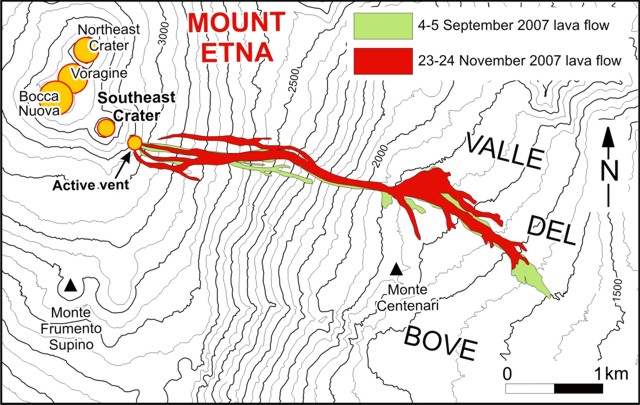 | Figure 129. Preliminary map of the lava flows emitted during Etna's lava-fountaining episodes of and 4-5 September 2007 and 23-24 November 2007. Both sets of flows discharged from the active vent on the E flanks of Southeast Crater (SEC). Courtesy of INGV-Catania. |
The November lava flowed mostly on top of, or immediately adjacent to, the lava emitted during the eruption of early September 2007 (figure 129). At the base of the Valle del Bove slope, the November eruption's lava fanned out to form several minor lobes, the longest of which advanced to 1,670 m elevation, 4.2 km from the vent (figure 130; Burton and Neri, 2007).
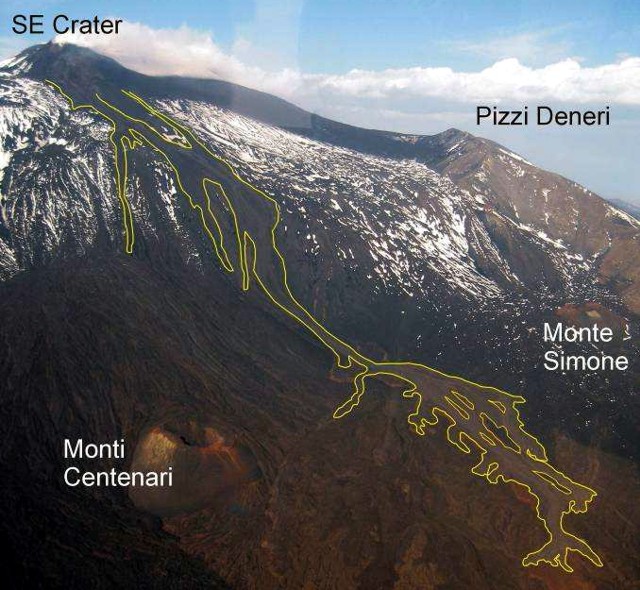 | Figure 130. Aerial view, taken on 25 November 2007 from a helicopter of the Italian Civil Protection, of the lava flows erupted at Etna during 23-24 November 2007. View is from SE across the Valle del Bove (foreground). From Burton and Neri (2007), courtesy of INGV-Catania. |
The explosive activity fed a dense tephra plume. It blew NE and caused ash and lapilli falls as far as 80 km away in southern Calabria, (Andronico and Cristaldi, 2007). At Piano Provenzana (~ 6.5 km NNE of the summit), the deposit was about 3 cm thick. Coarse scoriae, up to 5 cm across, fell ~ 10 km NNE from the SEC (in Linguaglossa) during the first hour of the eruption. During the following hours, finer ash fell in areas adjacent Etna and to the W.
Shortly after 0300 on 24 November, the eruptive activity and volcanic tremor amplitude began to diminish gradually, and during the next 20 min the fountain height dropped from ~ 600 m to under 200 m. Subsequently, the fountaining gave way to a series of powerful explosions, which showered the entire SEC cone with meter-sized bombs. The last of these explosions occurred at 0338, and for another 45 min after this, only minor explosive ejections occurred from the vent.
During the following hours, material continued to crumble and collapse on the steep slopes around the vent, exposing incandescent rock in countless spots. By 0600, the tremor amplitude had dropped to background levels, and no further eruptive activity was noted at the vent.
For several days after the eruption, gravitational instability of the new pyroclastic deposit, which had accumulated to thicknesses of several tens of meters, especially on the N side of the vent, caused occasional slides of material, exposing the still-incandescent interior of the deposit. A particularly large collapse from the overhanging W rim of the vent at 1713 on 27 November may have been accompanied by minor explosive activity, with incandescent material rolling to the base of the SEC cone (Calvari, 2007).
Ash emissions from the same vent occurred on 10 January 2008 and again on 1-3 February (figure 131). In mid-February such emissions became more frequent; some produced plumes several hundreds of meters high.
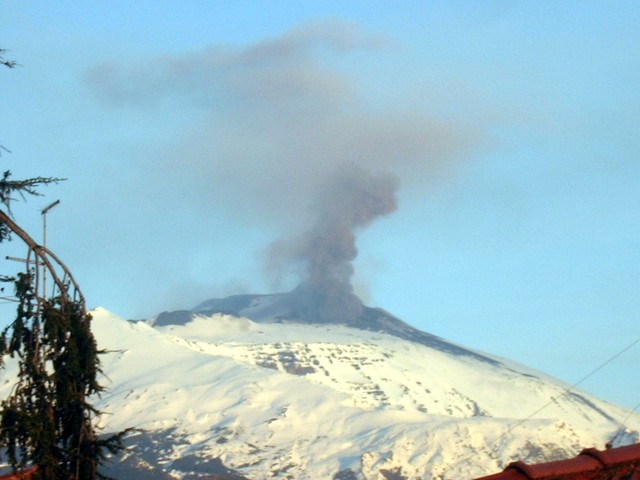 | Figure 131. Ash plume rising about 1 km high above the active vent on the eastern slope of Etna's Southeast Crater cone, on the morning of 10 January 2008. View is from Trecastagni, ~ 16 km SSE of the active vent. Courtesy of INGV-Catania. |
References. Andronico, D. and Cristaldi, A., 2007, Il parossismo del 23-24 novembre 2007 al Cratere di SE: caratteristiche del deposito di caduta. Report published on-line at: http://www.ct.ingv.it/Report/RPTVETCEN20071123.pdf
Burton, M. and Neri, M., 2007, Stato attuale e osservazione dell'Etna 25 novembre 2007. Report published on-line at: http://www.ct.ingv.it/Report/WKRVGREP20071125.pdf
Calvari, S., 2007, Rapporto sull'attivit? dell'Etna del 27 novembre 2007. Report published on-line at: http://www.ct.ingv.it/Report/WKRVGREP20071127.pdf
Information Contacts: Boris Behncke, Sonia Calvari, and Marco Neri, Istituto Nazionale di Geofisica e Vulcanologia (INGV), Sezione di Catania, Piazza Roma 2, 95123 Catania, Italy.
May 2008 (BGVN 33:05)  Cite this Report
Cite this Report
6-km-long lava flow; ash emissions; 13 May 2008 opening of a new eruptive fissure
After several months of eruptive activity at the summit craters, on 13 May a new eruptive fissure opened between 3,050 and 2,650 m elevation on Etna's upper E side, feeding lava flows into the Valle del Bove (figure 132). This took place without threatening inhabited areas. It was preceded by several months of sporadic ash emissions, a brief period of Strombolian activity, and a powerful eruptive phase from Southeast Crater (SEC) on 10 May. As of 20 June, modest Strombolian activity continued from two vents along the fissure at approximately 2,800 m elevation, accompanied by lava emission from a third vent, with lava advancing ~ 5 km to the E.
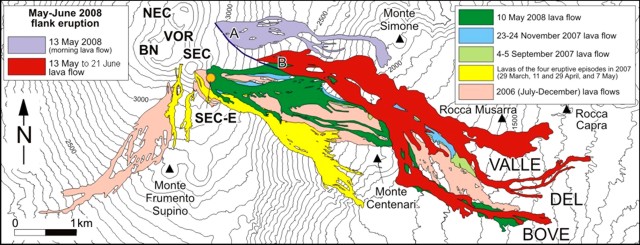 | Figure 132. Map showing extent of lava flows from Mount Etna, 2006-2008, including the lava flow field of the 2008 flank eruption as of 21 June 2008. Summit craters are Northeast Crater (NEC), Voragine (VOR), Bocca Nuova (BN), and Southeast Crater (SEC), whose recently active vent on the E flank is labelled SEC-E. The upper E flank fissure system is distinguished by two segments: one (A) active on 13 May morning; and the other (B) starting on the afternoon of 13 May and continuing through June. Courtesy of INGV-CT. |
This report was compiled from contributions by the staff of the Istituto Nazionale di Geofisica e Vulcanologia, sezione di Catania (INGV-CT), which are available as pdf files on the Institute's website (see Information Contacts).
Activity during January-April 2008. During this time interval, periodic emissions of ash occurred from a vent located on the E flank of the SEC cone (hereafter named SEC-E), which had been the site of two strong eruptive episodes on 4-5 September and 23-24 November 2007 (see BGVN 32:08, 32:09 and 33:01). This activity apparently ejected mostly lithic ash, and no incandescence was seen through mid-April. A period of weak Strombolian activity occurred between 23 and 28 April (figure 133), when explosions ejected incandescent bombs up to 100 m above the vent, and some material fell to the base of the SEC cone. The area was quiet between 29 April and 10 May.
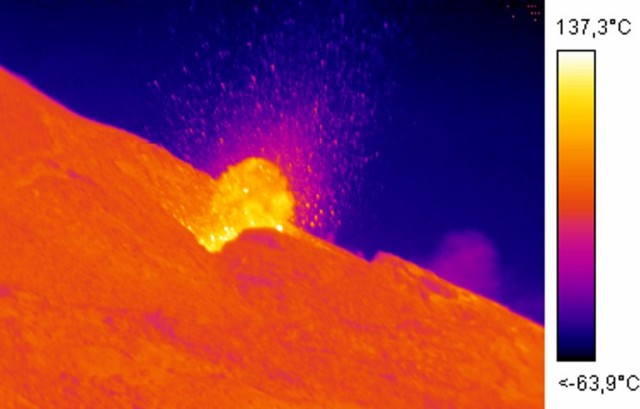 | Figure 133. Thermal camera image of a Strombolian explosion from the active eastern vent of the Southeast Crater (SEC-E) on 23 April 2008. Courtesy of INGV-CT. |
Event of 10 May 2008. A sharp increase in the volcanic tremor amplitude at 1400 UTC on 10 May announced the onset of a new paroxysmal eruptive episode at the SEC. Observation was difficult, due to inclement weather conditions. During the first stages of activity, eyewitnesses in the summit area observed explosive activity at several locations within and around SEC-E, and lava overflows feeding several branches of lava toward the Valle del Bove (figure 134). While lava descended very rapidly into the Valle del Bove, explosive interaction with patches of remaining snow repeatedly occurred along the path of the lava flows. The lava advanced across the Valle del Bove floor toward Monte Calanna down to an elevation of ~ 1,370 m, reaching a total length of 6.4 km from its source. This is one of the longest lava flows fed by a summit eruption of Etna in recorded history. A preliminary estimate of the lava volume yields ~ 4.5 x 106 m3, which was emitted at peak rates exceeding 300 m3/s (in comparison, peak eruption rates calculated for the violent fire-fountaining episodes at the SEC in 2000 were consistently below 200 m3/s; Behncke et al. 2006). Tephra fallout occurred mostly to the N and later to the NE (Andronico et al. 2008). The activity came to an abrupt halt at about 1800, after which no appreciable activity occurred for the following 2.5 days. Figure 134 is an aerial view of the SEC with its SEC-E vent, taken during a period of complete quiescence on 28 May.
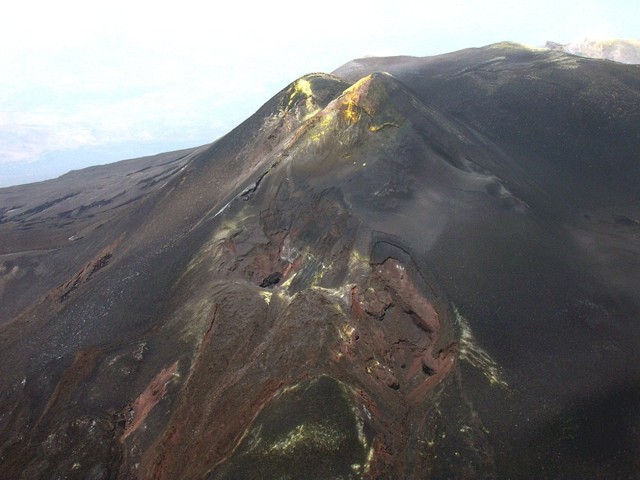 | Figure 134. Oblique aerial view of the Southeast Crater and its E flank vent (SEC-E, in the foreground) in a state of total quiescence, taken from a helicopter of the Italian Civil Protection Department on 28 May 2008. Courtesy of INGV-CT. |
Start of flank eruption, 13 May 2008. The intrusion of a dike into the upper portions of the Etna's edifice was marked by a seismic swarm starting at 0840 UTC (Unit? Funzionale Sismologia, 2008). Eruptive activity started from a fissure segment ("A" in figures 132 and 136 and shown close-up in figure 135) located roughly at 3,000 m elevation at the E base of the Northeast Crater (NEC) cone, where fire-fountaining produced a thick scoria deposit and generated sheet flows 2.5 km E toward Monte Simone. This activity probably lasted only a few hours and was followed by the propagation of new fissures to the SE ("B" in figures 132 and 136), down to an elevation of ~ 2,650 m, into the Valle del Leone, in the opposite direction of the initial dike intrusion, which apparently came to a halt during the early afternoon.
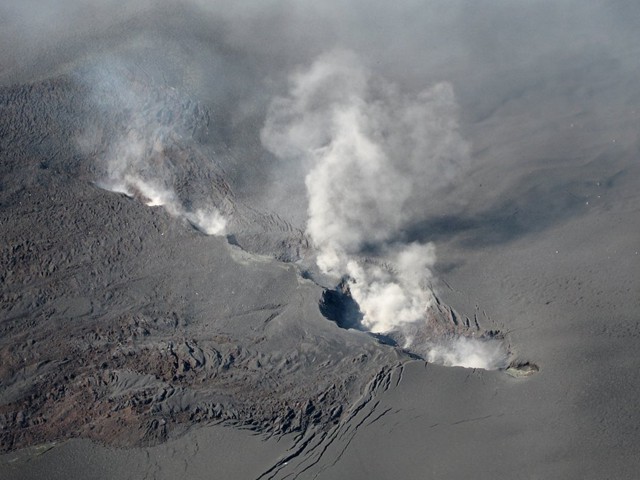 | Figure 135. Close-up aerial view of fissure segment "A," formed on the morning of 13 May 2008, and its rheomorphic lavas, taken from a helicopter of the Italian Civil Protection Department on 15 May 2008. Lava fountaining from this fissure segment lasted only for a few hours at the start of the eruption, but weak ash emissions continued for several days. Note fracture pattern created by the dragging along of freshly fallen tephra deposits along the margins of moving lava flows. Courtesy of INGV-CT. |
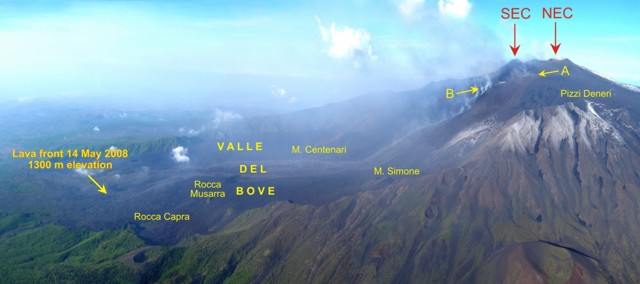 | Figure 136. Photomosaic composed of about 10 frames taken from a helicopter of the Italian Civil Protection Department on 15 May 2008, showing eastern sector of Etna with the active eruptive fissure just below the summit craters at right, and extent of active lava flows in the Valle del Bove, in the center and at left. Courtesy of INGV-CT. |
Visual observations were severely hampered by poor weather conditions, but heavy scoria falls were noted on the N flank during the early afternoon, and satellite imagery showed a narrow plume extending NNE (Coltelli et al. 2008). INGV staff visiting the summit area later that day stated that explosive activity occurred from multiple vents along an eruptive fracture to the E of the summit, and lava was flowing toward the Valle del Bove. Fieldwork carried out during the following days revealed that an extensive fracture field had formed around the NEC and beyond toward the upper N flank of Etna (Neri, 2008).
Continuing activity, 14 May to present. Improved weather conditions on 14 and 15 May permitted the first overviews of the eruption area (figure 136), and revealed that lava flows from the still active fissure segment at ~ 2,700-2,800 m elevation had descended approximately 6 km to 1,300 m elevation, but movement of the lava flow fronts had slowed significantly. Intense Strombolian activity occurred from a number of vents, and lava issued from at least two main locations. The uppermost fissure segment, first active on the morning of 13 May, showed little activity except for degassing and occasional emissions of dilute ash plumes. Ash was also emitted periodically from SEC-E.
On 16 and 17 June, ash emissions from that vent became more vigorous, and ash was also emitted from several vents in the upper portion of the still-active fissure segment on the upper E flank. The active lava flows, however, showed a significant reduction in their length compared to the first few days of eruption. During the following days, the ash emissions at the SEC stopped, and activity at the E flank fissure showed a marked diminution. Throughout late May and into early June, Strombolian activity was confined to one or two vents at about 2,800 m elevation, and lava emission from a single vent located a few tens of meters downslope fed small flow lobes that advanced to ever decreasing distances, reaching a minimum of ~ 0.4 km on 4 June.
A gradual but clear increase in the volcanic tremor amplitude and changes in the gas geochemistry heralded a revival of both the explosive and effusive activity on 8 June, which created a fresh surge of lava into the Valle del Bove. On 18 June, little more than one month after the start of the flank eruption, the lava fronts reached an elevation of about 1,350 m between Rocca Musarra and Rocca Capra (figure 132) and a distance of 5 km from the vents. Mild Strombolian activity continued from two vents located at ~ 2,800 m elevation.
After extending 5 km down through the Valle del Bove in mid-June, lava flows remained much shorter until the last few days of the month, when a new lobe advanced 4.8 km E, somewhat southward of the mid-June lava lobe. The late-June lobe was seen stagnant on 1 July. On the afternoon of 4 July, ash emissions from a point of the eruptive fissure upslope from the recently active vents (at 2,800 m elevation) marked the reactivation of a vent that had been inactive since mid-May. Vigorous Strombolian activity occurred from this vent during the following days, alternating with periods of ash emission. As of 6 July, lava was traveling further S, extending less than 4 km from the vents.
References. Andronico, D., Coltelli, M., Cristaldi, A., Lo Castro, D., and Scollo, S., 2008, Il parossismo del 10 maggio 2008 al Cratere di SE: caratteristiche del deposito di caduta (URL: http://www.ct.ingv.it/Report/RPTVETCEN20080510.pdf).
Behncke, B., Neri, M., Pecora, E., and Zanon, V., 2006, The exceptional activity and growth of the Southeast Crater, Mount Etna (Italy), between 1996 and 2001: Bulletin of Volcanology, v. 69, p. 149-173.
Budetta, G., Ciraudo, A., Currenti, G., Del Negro, C., Ganci, G., Greco, F., Herault, A., Napoli, R., Scandura, D., Sicali, A., and Vicari, A., 2008, Aggiornamento dello stato di attivit? dell'Etna: Osservazioni gravimetriche e magnetiche, (URL: http://www.ct.ingv.it/Report/UFGMET20080513.pdf ).
Coltelli, M., Prestifilippo, M., Scollo, S., and Spata, G., 2008, Rapporto tecnico del 13 Maggio 2008 ? Osservazione da satellite e simulazione dell'emissione di cenere (URL: http://www.ct.ingv.it/Report/Rapporto_UPNV_CT_ 20080513.pdf )
Neri, M., 2008, Eruzione dell'Etna: Fratture non eruttive sul fianco settentrionale del Cratere di Nord-Est; Aggiornamento al 28 Maggio 2008 (URL: http://www.ct.ingv.it/Report/RPTVGSTR20080528.pdf ).
Puglisi, G., Gambino, S., Mattia, M., and Aloisi, M., 2008, Monitoraggio Geodetico delle Deformazioni del suolo all'Etna: Aggiornamento 14 maggio 2008 ? 09:00 (URL: http://www.ct.ingv.it/Report/UFDG-RA_2008-08.pdf ).
Unit?Funzionale Sismologia (edited by D. Patanè), 2008, Quadro di sintesi e aggiornamento al 19 Maggio 2008 sullo stato di attivit?sismica dell'Etna (URL: http://www.ct.ingv.it/Report/REPUFS20080519.pdf ).
Information Contacts: Boris Behncke and Sonia Calvari, Istituto Nazionale di Geofisica e Vulcanologia, Sezione di Catania, Piazza Roma 2, 95123 Catania, Italy (URL: http://www.ct.ingv.it/).
May 2011 (BGVN 36:05)  Cite this Report
Cite this Report
Ongoing effusive fissure eruption that began on 13 May 2008 ends on 4 July 2009
A new eruptive fissure opened on W flank at ~2,800 m elevation on 13 May 2008 (BGVN 33:05)). Effusive eruptions there continued until 4 July 2009. There was some degassing at some of the summit craters degassed, while others were quiet. Figure 137 presents a map made in 2009 showing summit craters and the eruptive fissure. The following account was compiled from reports of the Istituto Nazionale di Geofisica e Vulcanologia, Sezione di Catania (INGV-CT) surrounding events from 16 July 2008 through 10 November 2009.
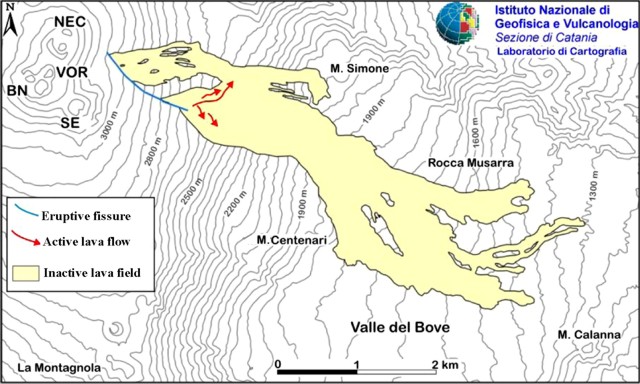 | Figure 137. Schematic map of the eruptive fissure at Etna that opened on 13 May 2008, as updated on 22 May 2009, showing the lava field that emanated from it. In colored versions of this Bulletin, the fissure is a thin blue line, the lava field appears in yellow, and red arrows show some of the near-source flow directions. Summit crater abbreviations (SEC, NEC, and BN) defined in text. From the 25-31 May 2009 report by INGV-CT's Marco Neri (with reference to report WKRVG20090526). |
2008. On 15 July 2008 INGV-CT scientists inspected the summit craters at 2,800 m and found degassing from the Northeast Crater (NEC) and to a lesser degree from the Bocca Nuova (BN) crater BN-1. Eruptions issued from Vent 2 of the active NW-trending fissure located E of the summit craters. The activity consisted mainly of weak Strombolian and diffuse ash emissions.
During 15 and 17 July lava flows occurred in the Valle del Bove. During 11-17 August, there was less intense activity and reduced emissions. During 18-24 August NEC and, to lesser degree, one of two craters at the BN degassed. The other summit craters, many obstructed with eroded debris, degassed from the walls and fumaroles along fissures. Although the Southeast Crater (SEC) appeared obstructed with debris, it emitted both diffuse and occasionally intense fumarolic emissions from its walls and crater floor. During 25-31 August the eruptive activity at the fissure at 2,800 m elevation showed little change, with only weak degassing.
A lull in activity ended in mid-October. On 13-20 October, observers saw increased degassing on the NW flanks, including at NEC and BN-1. During 27 October-2 November, the NEC continued with intense degassing. The other summit craters, all obstructed by detritus, showed degassing diffused from the walls and localized fumarolic fields along fissures. The SEC showed diffused and occasionally intense fumarolic activity from its walls and the crater floor.
During 17-23 November, the fissure at 2,800 m continued to show modest effusive activity, producing a small lava flow along the high part of the western wall of the Valle del Bove. On 19 November the lava flow front had reached the elevation of ~2,500-2,600 m.
During 1-7 December the degassing at summit craters was particularly intense at NEC, while at SEC, fumarolic degassing was observed along the flanks of the cone and the crater rim. Observations on 5 December showed small sporadic ash emissions at the upper portion of the eruptive fissure at 2,800 m. Images recorded on 5 December near Mt. Zoccolaro revealed two lava flows trending parallel to the eruptive fissure to the W of the Valle del Bove. Between 29 December 2008 and 19 January 2009 weak degassing continued.
2009. During 19-25 January lava flows from the fissure at 2,800 m fanned out at elevations between ~2,600 m and ~2,450 m. During the same week, the SO2 flux increased. During 26 January-2 February effusive activity at the eruptive vents along the W rim of the Valle del Bove continued in the lava field that has been active since May 2008. During 16-22 March eruptive activity continued along the high flanks of the volcano. At times observers saw intense degassing at the NEC and BN (figure 137).
During 6-12 April the level of activity remained constant and unchanged from the preceding time period.
During 18-31 May and 29 June-5 July 2009 the level of activity remained substantially unchanged, although in the earlier interval there were at least three lava flows, the foremost of which reached ~2,400 m elevation. The SO2 fluxes increased and on 27 and 28 May became particularly elevated, to 8,000 and 6,000 metric tons per day (t/d), respectively. For the later interval, the SO2 fluxes often remained more modest, ~2,900 t/d, with a maximum of ~3,500 t/d recorded 30 June. On 1, 3 and 5 July instruments measured higher peaks, to 7,000 t/d.
Although the explosive eruptive phases ceased in early July, ongoing degassing continued. Throughout August, the activity level remained unchanged, although roaring sounds emerged at SEC. Activity during 28 September-4 October showed little variance, but elevated SO2 fluxes became elevated, with average values ranging between 1,500 and 4,500 t/d, with a peak on 4 October 2009 at 8,000 t/d.
A 10 November message from INGV's Sonia Calvari explained that the effusive fissure eruption that began on 13 May 2008 ended 4 July 2009. There was thereafter an absence of significant explosive activity at the summit craters for a few months before deep explosive activity resumed once again at SEC on 6 November. The INGV monitoring web cameras detected pulsating red glowing from SEC's eastern floor, venting within the depression that cuts its E flank. However, as late as 10 November, no ejecta were found on the summit's snow cover.
Information Contacts: Istituto Nazionale di Geofisica e Vulcanologia, Sezione di Catania (INGV-CT), Piazza Roma 2, 95123 Catania, Italy (URL: http://www.ct.ingv.it/).
February 2012 (BGVN 37:02)  Cite this Report
Cite this Report
Sporadic summit activity and pit crater collapse in late-2009 and 2010
This report, summarized by the Istituto Nazionale de Geofisica e Vulcanologia - Osservatorio Etneo, Catania (INGV-OE), covers the time interval from 10 November 2009 through 31 December 2010 and discusses activity at Etna since our last Bulletin report (BGVN 36:05), which covered activity through 10 November 2009.
For six months following the end of the May 2008 to July 2009 flank eruption, Etna passively degassed from the summit craters. Beginning in the evening of 6 November 2009, a pulsating red glow was observed from a small pit that had opened at the eastern base of the South-East Crater (SEC) at 3,050 m elevation. This continued for several months, visible only at night from the INGV web camera, and was interpreted as being related to Strombolian activity entirely confined to the interior of the pit (and thus not directly visible). The incandescence was sometimes accompanied by small lithic ash emissions from the pit, probably associated with inner collapses.
For about 30 minutes during the afternoon of 8 April 2010, the stations of the Permanent Seismic Network recorded 12 large low-frequency events located at Etna's summit. At the same time, the pit crater at the eastern base of the SEC collapsed, producing a dark-colored plume of volcanic ash that rose to ~1 km and dispersed to the NE. Mainly lithic ash fell at distances of up to 6 km from the volcano, and the pit widened from ~40 m to ~80 m in diameter. An explosive component in this event was evidenced by a small pyroclastic density current that moved a few hundred meters to the NE from the pit. All other summit craters of Etna displayed only passive degassing.
At about 1840 on the same day, dark emissions were also observed at the central crater, the location of two active vents, Bocca Nuova and La Voragine ("The Chasm"). The phenomenon was observed by INGV-OE staff in the Pernicana-Linguaglossa area of the volcano, who also reported the fallout of ash in the Rocca Campana area, between Milo and Fornazzo. Photos taken by R. Azzaro showed an initial ash emission from the pit crater at Etna's SEC at 1800 (figure 138a), followed at about 1840 by emissions also from the central crater, and ash fallout on the NE flank.
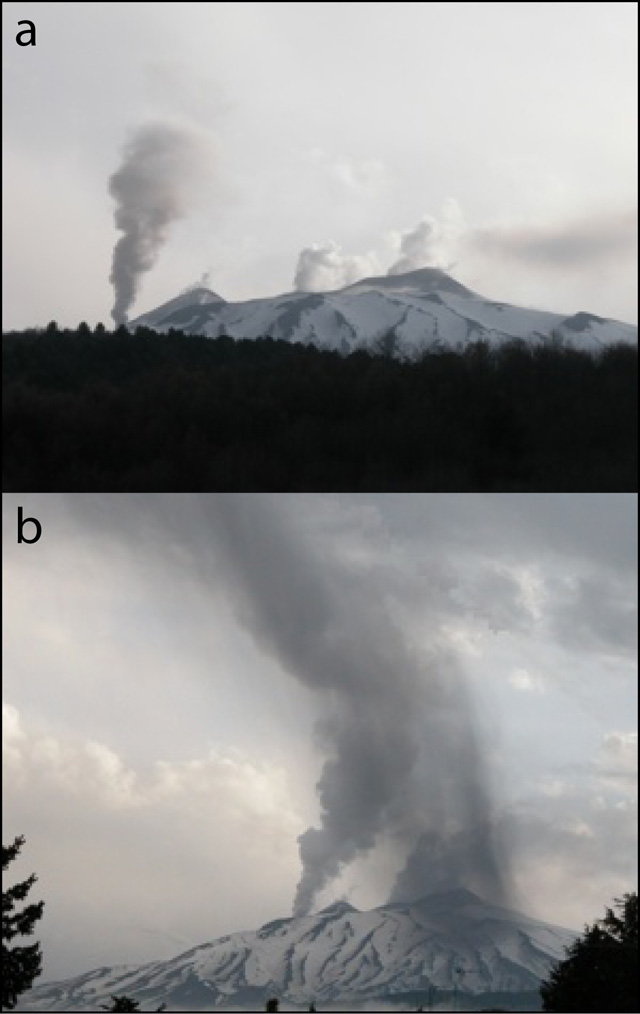 | Figure 138. An initial emission of ash from the pit crater at Etna's SEC: (a) at about 1800; and (b) at 1842 on 8 April 2010. Both photographs were taken from the NE (the area of Linguaglossa). Courtesy Raffaele Azzaro, Istituto Nazionale de Geofisica e Vulcanologia - Osservatorio Etneo (INGV-OE). |
On 9 April intense gas emissions were noted at the pit crater, but without ash emission.
INGV-OE reported a series of landslides on 19 June from the NW rim of the pit crater located on the lower E side of the SEC. The collapses generated small ash clouds that drifted NE and changed the pit crater's morphology. Data from a fixed thermal monitoring camera showed thermal anomalies over 180°C, indicating that the landslide material was hot. Fumarolic activity was seen in the landslide source area during an inspection on the previous day. The events on 19 June also formed a large gap on the NW side of the crater rim.
INGV-OE reported that at 1509 on 25 August 2010 a powerful explosion occurred at the Bocca Nuova. This explosion initiated a period of ash emission that continued, at diminishing strength, for about 20 minutes. As seen in figure 139, the onset of the explosion was characterized by the emission of hot material, which was recorded as a thermal anomaly up to 170°C by the new thermal camera on La Montagnola, ~3 km S of Etna's summit craters. The visible camera on La Montagnola recorded the rapid uprise of a cauliflower-shaped, dark gray ash plume that rose to ~1 km before being blown to the E.
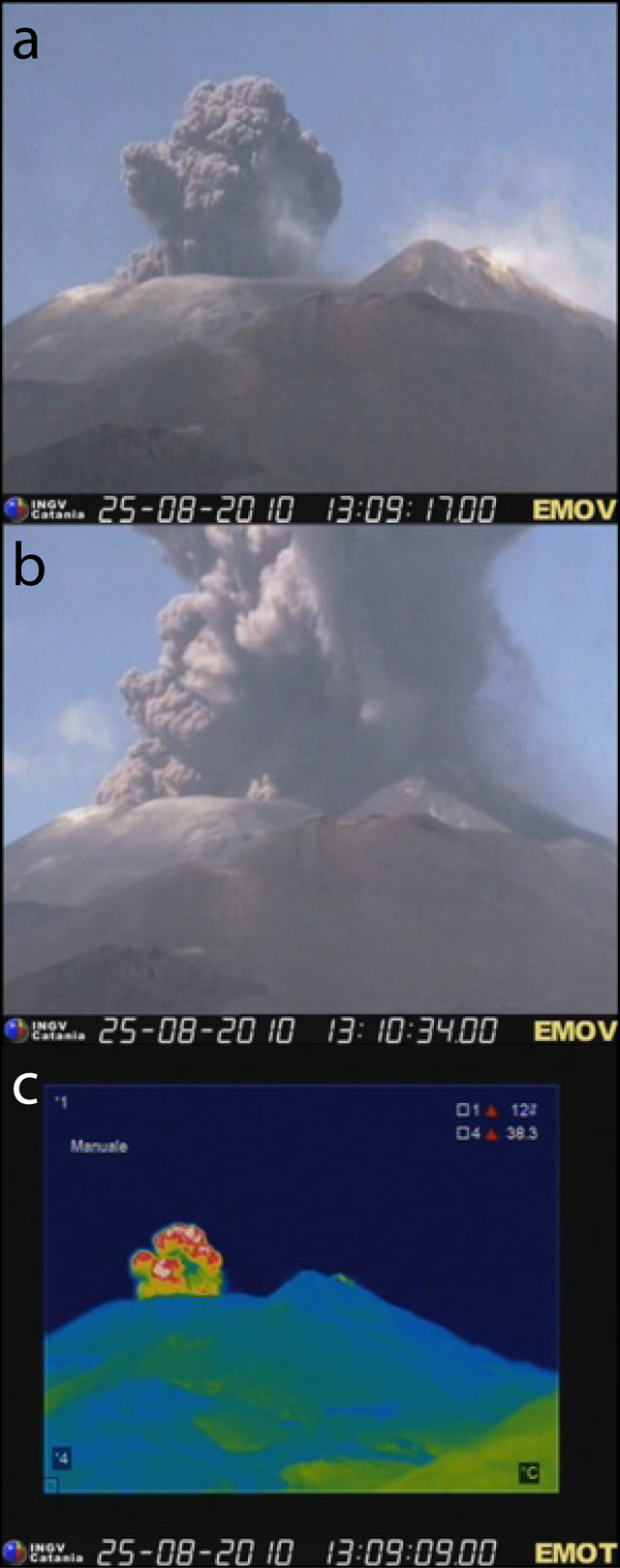 | Figure 139. Views from video (a, b) and thermal (c) monitoring cameras at La Montagnola, taken 3 km S of the summit craters, during the beginning of the explosive events of 25 August 2010. Courtesy of INGV-OE. |
The explosion on 25 August 2010 was the strongest in a series of similar explosions of the western vent of the Bocca Nuova forming a sequence that began on 5 July 2010. There was no evident change in the activity of the other summit craters; deep explosions within the active pit of the NEC had been occurring continuously for several months.
The 25 August events led to ashfall reported in areas SE of Etna, including the town of Catania (27 km S). An inspection the next morning revealed that the W wall of the BN-1 crater of Bocca Nuova had collapsed. During 25-29 August 2010, a total of seven explosions were recorded.
During the first days of October 2010, INGV-OE reported that Etna's activity levels remained fairly stable. Explosions continued deep inside the NEC, but with significant fluctuations. The western depression at the Bocca Nuova was the source of an explosive event that occurred at 1127 on 7 October and generated a small ash emission. Ashfall was observed shortly thereafter at the Rifugio Sapienza, on the high southern flank of the volcano at ~1,900 m a.s.l. The event was of short duration and formed a discontinuous deposit of very fine ash. The depression crater on the lower E flank of the SEC cone emitted gas more or less continuously, sometimes in a pulsating manner. There were no significant changes at La Voragine, the E vent of the central crater.
A field inspection on the morning of 8 October revealed a low level of gas emissions without explosive activity at the NEC, the Voragine and the Bocca Nuova. In contrast, the pit crater on the E flank of the SEC cone showed dramatic degassing from an open vent on its floor, which had opened during the first half of September. The degassing took place in a pulsating manner and was accompanied by loud hissing sounds, possibly produced by deep explosive activity. The walls of the pit crater were seen to be highly unstable, and small landslides were observed during the inspection, generating small red ash clouds. There were no "fresh" juvenile products either outside or inside the crater depression, however, on the crater floor there was clearly visible coarse material (meter-sized blocks) from areas that had collapsed in recent weeks.
Following several days of minor ash emissions at the NEC, on the morning of 14 November 2010 there was a significant increase in both the frequency and the volume of ash emissions (figure 140). These emissions generated narrow plumes to a few hundred meters high, which were then dispersed by the wind to the SW on 14 November, then NE on the night of 14-15 November, and finally E on 15 November. The ash emissions occurred intermittently, alternating with periods of white gas and vapor emissions.
 | Figure 140. Aerial view of Etna's Northeast Crater taken about 1200 on 14 November 2010. A dilute ash plume can be seen rising from the crater, and patches of snow on crater rims are covered with thin ash deposits. Photo courtesy of Alfio Amantia, INGV-OE. |
On 15 November INGV-OE staff visited the NEC and observed that near the cone, particularly to the S, in the northern portion of La Voragine, a few millimeters of brown ash were present on the ground. On the rim of the NEC, the deposit was up to 1 cm thick and thickest on the eastern side. The NEC's ash emissions were then rather modest, and were accompanied by nearly continuous deep rumblings, which sometimes increased.
For more than a year there had been an open degassing vent on the NEC's crater floor, which up until the previous visit to the NEC in October had a diameter of ~25 m. On 15 November, this vent was seen to be much larger, with a diameter of at least 75 m. Ash emissions from this vent were often minor, but at other times more vigorous. The NEC's inner walls were covered by reddish brown ash deposits. No coarse-grained material was observed, either in the deposits, or in the emissions. Microscopic analysis revealed much of the ash to consist of juvenile glass shards.
After more than one month of relative quiet at Etna, at 0446 GMT on 22 December, a strong explosion occurred at the western vent of the Bocca Nuova. This event generated an ash plume a few hundred meters high that blew NE, resulting in light ash falls more than 10 km away, as far as the town of Linguaglossa. Video recorded by the thermal cameras of the Montagnola (EMOT) and Nicolosi (ENT) clearly showed the emission of hot material with temperatures exceeding 60°C (figure 141a, b). A thermal anomaly was also evident in the footage recorded by the thermal camera of Nicolosi (ENT; figure 141c, d). The visible-light footage recorded by other INGV monitoring cameras did not reveal any incandescent material.
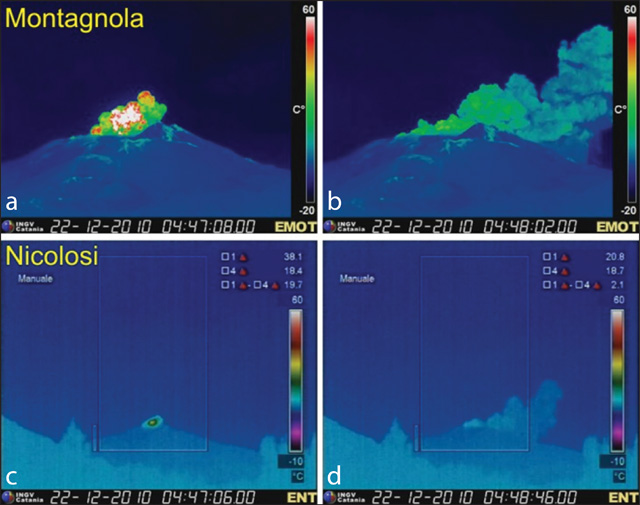 | Figure 141. Explosion from the Bocca Nuova on 22 December 2010, seen in frames recorded by the thermal video cameras of the Montagnola (EMOT; a, b), and Nicolosi (ENT; c, d). The emission of hot - though non-incandescent - expanding material is well evident as a thermal anomaly in the images, which also show the subsequent evolution of the ash plume rising a few hundred meters above the summit of Etna, and drifting NE. Courtesy of INGV-OE. |
The 22 December 2010 explosion at the Bocca Nuova was probably less powerful than the one on 25 August 2010, but certainly stronger than the numerous subsequent events between late-August and late-October. Smaller emissions of reddish-brown ash continued to occur during the forenoon of 22 December.
On 23 December 2010, an intense glow from the pit crater on the E flank of the SEC cone was recorded by the visible-light monitoring camera at the Schiena dell'Asino (6 km SE of the summit craters) during a brief interval of partial visibility amidst weather clouds. At the same time, the volcanic tremor amplitude recorded by the summit seismic network of the INGV-OE showed a brief, but sharp increase. Very small and brief emissions of hot material from the pit crater were again noted on 29 December and continued for the next few days.
Information Contacts: Boris Behncke, Istituto Nazionale di Geofisica e Vulcanologia (INGV), Sezione di Catania, Piazza Roma 2, 95123 Catania, Italy (URL: http://www.ct.ingv.it/).
September 2013 (BGVN 38:09)  Cite this Report
Cite this Report
46 paroxysms and birth of the New Southeast Crater (NSEC)
Since our last report on Etna (BGVN 36:05), which covered activity through 29 December 2010, intervals of vigorous activity (paroxysms) have continued, with 18 paroxysms in 2011, 7 in 2012, and 21 in 2013. During this reporting interval, 30 December 2010-31 December 2013, the activity can be viewed as a series of paroxysms detailed in a chronology shown below. Activity at the Northeast Crater (NEC) remained minor during the reporting interval. The Bocca Nuova produced activity in July and December 2011, and then in January 2013 where two episodes of intense Strombolian activity occurred on the evenings of 16 and 18 January.
In addition, during this reporting interval, there emerged a "New" Southeast crater (NSEC). The "old" SEC was last active in May 2007. NSEC formed at a large pyroclastic cone that grew alongside the SEC's active crater. The cone's early growth took place during seven paroxysmal episodes between January and July 2011, and continued to grow though the end of 2013.
Paroxysms at Etna. The term paroxysm, and its use in the phrase 'paroxysmal episode,' has become common in describing Etna's eruptive outbursts, particularly in the past few decades. INGV's Boris Behncke has described the behavior associated with these terms, employing both photos and videos widely available online. Paroxysm is a short-hand for Etna's often intense Strombolian discharges that frequently include lava fountaining, lava flow emission, and tephra columns, which erupted at the summit craters.
Behncke notes that Etna's typical paroxysm consists of three main phases: (1) prelude and waxing, (2) climax, and (3) waning and cessation. The climactic phase 2 part of the behavior represents the true paroxysm. To describe a collective set of all three phases at Etna, Behncke prefers that they be called "paroxysmal episode," "paroxysmal eruptive episode" or "eruptive episode."
Summary and chronology. Table 10 contains a 2011-2013 chronology of Etna's paroxysmal episodes at the NSEC as reported by INGV. There were 46 such episodes during the interval shown in the table. There are clear cases where the description of a single paroxysm glosses over complexities of the eruptive process (see, for example, the 30 July discussion in the next section).
Table 10. A list of NSEC paroxysmal episodes from Etna's New Southeast Crater and their numbering for 2011- 2013. The column at far right contains occasional notations of interesting or extraordinary events taken from INGV reporting. In some cases there are minor variations in dates and numbering.
| Paroxysm number | Date | Notes |
| 2011 | ||
| 1 | 13 Jan 2011 | 1-7 correspond to strong growth of NSEC; At irregular intervals small landslides occurred within the crater depression |
| 2 | 18 Feb 2011 | -- |
| 3 | 10 Apr 2011 | -- |
| 4 | 12 May 2011 | -- |
| 5 | 09 Jul 2011 | A dense eruptive plume rose several kilometers and drifted S and SE, causing ash-and-lapilli fall in populated areas and forcing the closure of the Fontanarossa international airport in Catania. |
| 6 | 19 Jul 2011 | -- |
| 7 | 25 Jul 2011 | -- |
| 8 | 30/31 Jul 2011 | See figure 142 (30 July 2011) The event was essentially a repetition of the previous paroxysms, with the emission of a lava flow W toward the Valle del Bove, lava fountains rising to maximum heights of 450-500 m, and an ash plume that was blown E by the wind. |
| 9 | 08 Aug 2011 | -- |
| 10 | 12 Aug 2011 | -- |
| 11 | 20 Aug 2011 | -- |
| 12 | 29 Aug 2011 | -- |
| 13 | 08 Sep 2011 | -- |
| 14 | 19 Sep 2011 | This event, which occurred during rather poor weather conditions, produced lava fountains from various vents within the crater and on its southeastern flank, lava flows that descended the western slope of the Valle del Bove, and an ash cloud that was bent by the strong wind to the NE. |
| 15 | 28 Sep 2011 | -- |
| 16 | 08 Oct 2011 | -- |
| 17 | 23 Oct 2011 | -- |
| 18 | 15 Nov 2011 | This episode has in nearly all details been a repetition of its predecessors, though with a few minor variations; the culminating phase lasted about one hour and terminated rather abruptly. Ash-and-lapilli falls affected the SE flank, including the towns of Zafferana, Etnea and Acireale. |
| 2012 | ||
| 1 / 19 | 05 Jan 2012 | -- |
| 2 / 20 | 09 Feb 2012 | This event was less violent than its predecessors, but lasted more than 5 hours. A lava flow descended toward the Valle del Bove, stagnating before it reached the valley floor. |
| 3 / 21 | 04 Mar 2012 | -- |
| 4 / 22 | 18 Mar 2012 | Tall lava fountains, a tephra and vapor column several kilometers high (leading to ash and lapilli falls over the E sector of the volcano), and lava flows that descended into the Valle del Bove, locally interacting explosively with thick snow cover on the ground. |
| 5 / 23 | 01 Apr 2012 | -- |
| 6 / 24 | 12 Apr 2012 | -- |
| 7 / 25 | 24 Apr 2012 | This event, which occurred after a relatively quiet interval of 11.5 days, repeated in virtually all details the preceding episodes, with lava fountains, copious emission of ash and lapilli, and lava flows that descended into the Valle del Bove. |
| 2013 | ||
| 1 / 26 | 20 Jan 2013 | The two episodes of Strombolian activity at the New Southeast Crater during 20 and 22-23 January represented the first emission of new magmatic products after a quiet interval of nearly nine months. |
| 2 / 27 | 22-23 Jan 2013 | -- |
| 3 / 28 | 19-20 Feb 2013 | Starting the morning on 19 February, with 3 more paroxysms during the next 54 hours. Pronounced cone growth at NSEC. Lava flows emitted from base of NSEC ongoing between paroxysms. |
| 4 / 29 | 21 Feb 2013 | -- |
| 5 / 30 | 23 Feb 2013 | Very active event. See figure 143 (23 Feb). Ash plume trending ESE, lava flows from the fissure cutting the SE crater rim and also from a new eruptive fissure, and small lahars. The second paroxysm of the day produced an ash cloud that drifted E; new lava flows descended toward the Valle del Bove, following the paths of their predecessors. The rapid succession of three paroxysmal eruptive episodes in less than 36 hours is quite notable; the only known historic precedent of three paroxysms occurring in such a short time interval at Etna was the series of eruptive episodes in 2000 |
| 6 / 31 | 28 Feb 2013 | -- |
| 7 / 32 | 5/6 Mar 2013 | -- |
| 8 / 33 | 16 Mar 2013 | This event, one of the most intense of the current series of paroxysms, was preceded by a long "prelude" (Strombolian activity) that started on the afternoon of 15 March, and was followed by weak, discontinuous activity at the Voragine. |
| 9 / 34 | 3 Apr 2013 | -- |
| 10 / 35 | 12 April 2013 | Lava fountaining; high column of pyroclastic material; The eruption formed a pyroclastic cloud directed to the SE, initially producing lapilli and ash, which fell mostly near the inhabited centers of Zafferana Etnea, Santa Venerina e Acireale; later including the communities of Giarre and Milo situated slightly to the N. |
| 11 / 36 | 18 Apr 2013 | -- |
| 12 / 37 | 20 Apr 2013 | Very powerful episode: lava fountains reached heights of 800-1000 m above the crater, whereas the cloud of pyroclastic material expanded toward ESE, leading to heavy fall of ash and lapilli over the areas of Zafferana Etnea, Milo, Santa Venerina and further downslope, in the area of Giarre. |
| 13 / 38 | 27 Apr 2013 | -- |
| 14 / 39 | 26 Oct 2013 | A gas plume laden with pyroclastic material rose several kilometers above the summit and drifted SW, affecting population centers as far as the Caltanissetta area. Activity caused the closure of airspace near Catania airport before dawn through the early morning. |
| 15 / 40 | 11 Nov 2013 | -- |
| 16 / 41 | 17 Nov 2013 | -- |
| 17 / 42 | 23 November 2013 | Very powerful episode: rapid evolution from Strombolian activity to lava fountains. The eruption column, several kilometers high, was charged with pyroclastic material that was dispersed by the wind to the NE. |
| 18 / 43 | 28 Nov 2013 | – |
| 19 / 44 | 02 Dec 2013 | See Figure 144 (2 December) This event produced tall lava fountains, lava flows, and an eruption column charged with pyroclastic material, which drifted NNW, causing ash and lapilli to fall in the area of Bronte. Several lava flows were emitted to the SSE, SE, NE and S. The flow traveled SE and reached the base of the W headwall of the Valle del Bove. |
| 20 / 45 | 14-16 Dec 2013 | Ash emissions caused the cancellation of more than 20 flights in and out of the Catania airport on 15 December. |
| 21 / 46 | 29-31 Dec 2013 | -- |
 | Figure 142. A photo of NSEC in eruption during a paroxysm on the evening of 30 July 2011. The photo shows lava fountaining activity, ash plume, and lava flow from the new and actively growing cone on the E flank of Etna's old Southeast Crater (barely discernible at extreme left). The photo was taken from a point about 1 km to the SE of SEC but the height of the lava fountains were undisclosed. Photo taken by Marco Neri, INGV-Catania. |
Regarding paroxysm number 8 (30-31 July 2011), INGV featured photos (e.g., figure 142) and made comments such as the following.
"About 19.00 h local time (= UTC-1), the mean amplitude of the volcanic tremor started to increase again, and so did the Strombolian activity. At around 19.30, a dilute gas and ash plume was again blown eastward by the wind. The Strombolian activity progressively gained in intensity, quite more rapidly than during the morning's activity, and the incandescent jets became continuous around 21.30 local time. At the same time, renewed lava overflow toward east showed a rapid increase in effusion rate, forming a multilobate flow down the western slope of the Valle del Bove, which traveled approximately 3 km down reaching about 2,000 m elevation by 2300 local time. The ash plume became denser and was blown eastward by the wind, generating ash falls in the Ionian sector of the volcano.
"During the phase of maximum intensity, fragments of fluid lava were violently thrown to heights of about 450-500 m above the crater rim, causing heavy fallout onto the external flanks of the pyroclastic cone to a distance of 200-300 m. Lava fountains were jetting from at least two vents located within the crater and on its upper east flank, roughly aligned west-northwest - east-southeast."
2013. There were two main phases of activity during 2013. The first occurred during January-April; the second, after a 6-month quiescence, began on 26 October (table 10).
Figure 143 shows a view of the paroxysmal event of 23 February 2013. Of the events listed during the first phase of 2013 (table 10), this was a particularly active one.
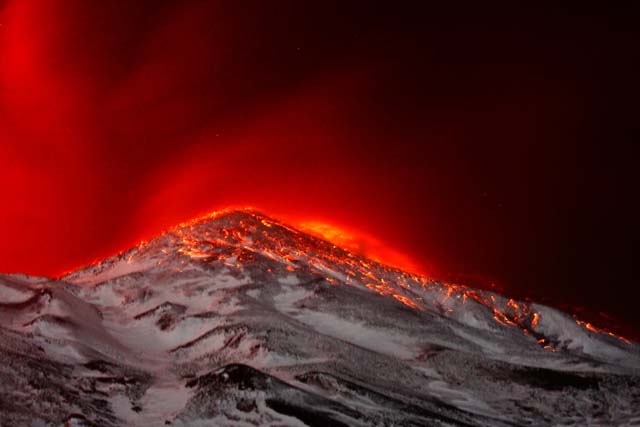 | Figure 143. View of the Pizzi Deneri area in the aftermath of incandescent bombs falling during the peak of the 23 February 2013 paroxysm at the NSEC. Photo taken from the Rifugio Citelli, on Etna's NE flank. Photo taken by Daniele Pennisi and taken from INGV report. |
INGV reported that eight eruptive events occurred between 26 October and 31 December 2013. The largest of these events occurred on 23 November 2013 and stood out as a noteworthy event in terms of amplitude. Figure 144 shows a scene from the episode on 2 December 2013.
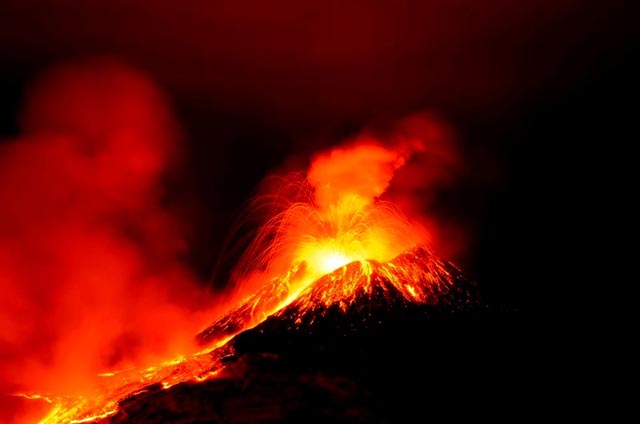 | Figure 144. Strong explosions at the end of the lava fountaining during the paroxysm of 2 December 2013 at Etna's New Southeast Crater, and lava flow directed toward the SE (at left). Note also the beginning of the formation of a small lava flow toward the NW, more to the right, forming a more luminous point on the cone's flank. Ballistics rose hundreds of meters. Photo taken from Macchia di Giarre by Walter Contarino, and INGV report. |
Paroxysmal activity at Etna caused significant disruptions regionally during the reporting period; the Catania airport cancelled flights in and out of the airport several times. On 9 July 2011, Strombolian explosions turned into a continuous lava fountain; a dense eruptive plume rose several kilometers and drifted S and SE. Ash and lapilli from the plume fell in populated areas including Trecastagni, Viagrande, and Acireale (SE), and between Nicolosi and Catania (S), forcing the closure of the Fontanarossa international airport in Catania. In 2013, according to a news article, a representative from Catania airport noted activity at Etna prompted the closure of nearby airspace from before dawn through the early morning of 26 October 2013. According to another news article, the ash emissions caused the cancellation of more than 20 flights in and out of the Catania airport on 15 December 2013.
The New SEC (NSEC). The old SEC cone was last active in May 2007. The NSEC cone grew substantially between 12 January and 25 July 2011 (episodes 1-7) (table 10) and thereafter. Figure 145 shows a photo of the NSEC taken on 29 July 2011.
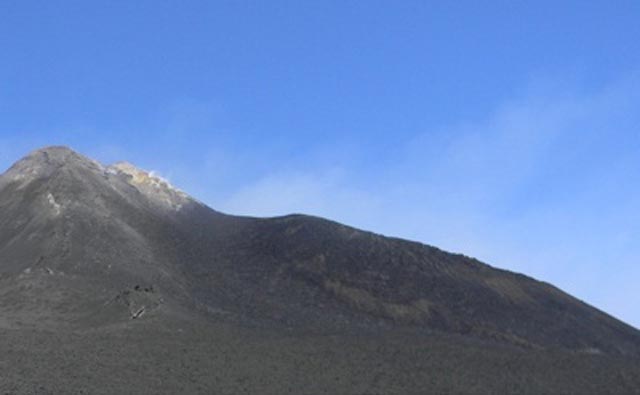 | Figure 145. A photo of Etna's Southeast Crater (SEC) taken on 29 July 2011 from 1 km S of the SEC. The photo shows the large pyroclastic cone that has grown around the active crater, located on the E flank of the old SEC cone, during the seven paroxysmal episodes between 12 January and 25 July 2011. Photo taken by Boris Behncke, INGV-Catania. |
Since its emergence in 2011, the NSEC grew substantially, especially in 2013. The size of NSEC can be seen relative to the old SEC in figure 146. Smaller and farther left (E) is the low cone Sudestino ('little southeast'), which grew during several paroxysmal episodes during the spring of 2000 just beyond the SEC's S side (BGVN 25:03; 25:09). The right upper half of the image is dominated by the NSEC cone, which grew entirely during the previous 10 months. INGV noted that during 2013 the NSEC cone expanded both in height and width.
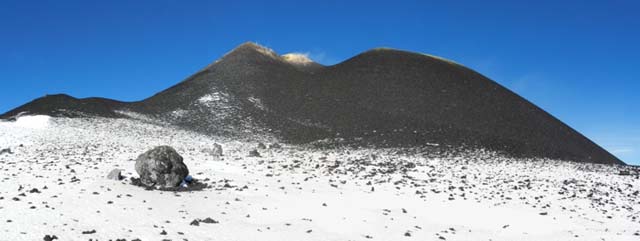 | Figure 146. A view of the Southeast Crater (SEC) complex at Etna as seen from the S on 14 December 2011. The "old" SEC cone is in the center and contains the conspicuous light colored area with wisps of fumarolic vapor and yellow sulfur deposits. The right half of the image shows the New SEC cone, which grew entirely during the previous 10 months. The large bombs and blocks in the foreground, with some clasts 3-5 m in diameter, were deposited during the paroxysmal episode of 15 November 2011. Mosaic composed of 3 photos taken by Boris Behncke, INGV-Osservatorio Etneo (Catania). |
The October -December phase of Etna's 2013 activity is summarized in an INGV report from 22 January 2014 (B. Behncke & E. De Beni). Figure 147 shows a map of lava flows emanating from the NSEC during this phase of activity (26 October - 31 December 2013).
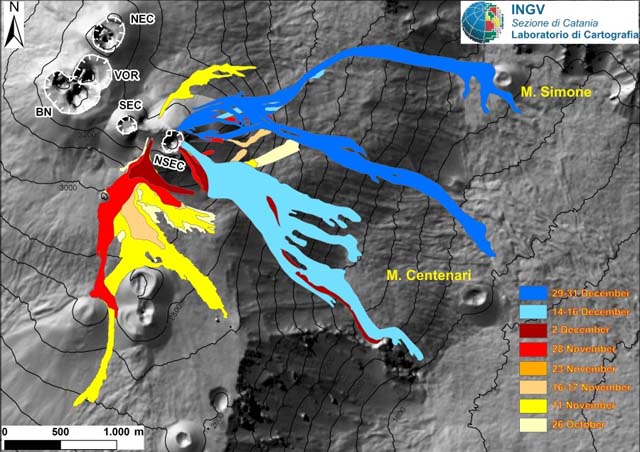 | Figure 147. Map of the lava flows emitted at the NSEC from 26 October to 31 December 2013 and morphology of the NSEC cone updated in January 2014 (base map, August 2007). BN=Bocca Nuova; SEC = Southeast Crater; NSEC = New South East Crater. Taken from UFGV Report of 22 January 2014, (INGV, by B. Behncke and E. De Beni). |
Information Contacts: Boris Behncke, Istituto Nazionale di Geofisica e Vulcanologia (INGV), Sezione di Catania, Piazza Roma 2, 95123 Catania, Italy (URL: http://www.ct.ingv.it/).
November 2014 (BGVN 39:11)  Cite this Report
Cite this Report
January–13 June 2014: NSEC emits lava and 11 Feb landslide with ground-hugging reddish cloud
Our last report on Etna covered activity through 31 December 2013 (BGVN 38:09) and described activity in terms of a series of paroxysms, including the emergence of a new South East Crater (NSEC; see figure 147 in BGVN 38:09).
This report covers subsequent activity from 1 January-13 June 2014 and summarizes first-hand accounts by Istituto Nazionale di Geofisica e Vulcanologia (INGV-Catania). The key events of this reporting interval were ongoing emissions of E-directed lavas from a vent area on the lower E flank of the NSEC. That same vent area at NSEC generated an unusual, reddish, ground-hugging cloud associated with a landslide on 11 February. It left a swath of pyroclastic deposits mapped for over 2 km.
A sketch map shows lava and pyroclastic emissions from October 2013 through February 2014 (figure 148). It thus gives an overview of Etna's products during the first part of this reporting interval (January through February 2014). Flows on figure 148 emitted during 2013 were discussed in the previous report (see map, figure 147, in BGVN 38:09). During January-February 2014 lava flows vented in an area on the NSEC's lower E flank. That same general area was the source of a landslide and pyroclastic deposits emplaced on 11 February 2014 (shaded in light tan with triangles or dots conveying coarser and finer deposits). The deposits were laid down by fast-moving, reddish, ground-hugging emissions.
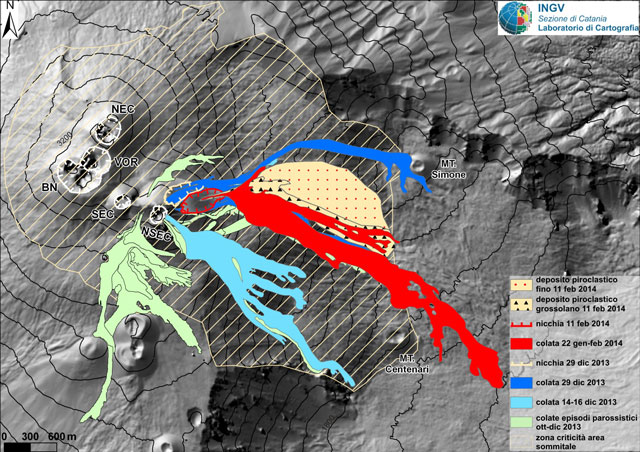 | Figure 148. Map of Etna's summit area highlighting volcanic deposition during the interval October 2013 through 11 February 2014. Lavas of October 2013-December 2014 are shown in pale green; lavas of 14-16 December 2013, in light blue; lavas of 29 December 2013, in blue; lavas of 22 January-February 2014, in red. The 11 February 2014 pyroclastic deposits (tan) as mapped here stretch ~2.3 km W from their source at a depression (inside the hachured red line) on the lower E side of NSEC. These pyroclastic deposits are mapped into two adjacent map units on the basis of grain size. Both the pyroclastic deposits and the lava flows descended the steep W headwall of the broad valley called Valle del Bove. The valley's headwall area extends to ~2-3 km to the SE of NSEC before the slope gradient drops and the slope starts to make the transition to the valley floor. Courtesy of INGV (Etna Cartographic Laboratory). |
Figure 148 also shows the important vent on NSEC's E flank (red hachured circle). Abbreviations for other summit vents: (SEC (Southeast crater), BN (Boca Nuova), VOR (Voragine), NEC (North East crater), as similarly defined in previous Bulletin reports). These other vents issued little in the way of deposits as late as the end of February 2014 (based on the map) and INGV reporting did not disclose much in the way of other deposits either.
Activity during January 2014. INGV reported that during 31 December 2013-1 January 2014 lava flows from a vent located on the NSEC continued to travel toward the N part of the Valle de Bove; the lava flows had been active since activity resumed on 29 December 2013. A 1 January web camera photo near midday showed a dense black plume emerging from NSEC. By 3 January 2014 the lava effusions stopped. Meanwhile at NEC during 4-13 January 2014 this vent released pulsating and almost continuous reddish ash emissions. Tremor remained at low amplitude into at least late January.
On the evening of 21 January after ~20 days absence (since an increase seen during 29-31 December 2013), strombolian emissions returned at NSEC. These emissions were weak. Sparse ash also discharged, barely rising over NSEC's rim.
Late on 22 January a small lava flow emerged from the vent on NSEC's upper E flank advancing over a few hundred meters in a few hours. This was the start of the lava flow shown in red on figure 148. Strombolian explosions ejected glowing pyroclasts onto NSEC's flanks. The explosions declined early on 23 January, and the lava flow stopped advancing. At 0105 that day a small puff emerging from the E base of the cone heralded the start of a new W-trending lava flow. On 26 January, strombolian emissions occurred and an ash plume drifted E. By evening the strombolian eruption declined in terms of both the amount of ash emitted and the eruptive intensity. The lava flow (red, figure 148) had by this time reached ~4 km long. Also, a new lava flow advanced on top of the earlier one.
Regarding NSEC, INGV reported that on 27-28 January it underwent a gradual but steady decrease of activity. Lava flows from two vents at the E base of the NSEC cone continued to effuse at a very low rate. Weather conditions almost entirely prevented visual and optical observations during early on 30 January until the evening of 3 February.
Activity during February 2014. Late on 3 February INGV noted a lava flow from one of the NSEC's vents along its E base remained active and had extended several hundred meters. Almost continuous ash emissions from NSEC began at about 1300 on 4 February and continued into the night; about 5-10 ash puffs were separated by steam emissions. Ash plumes drifted E. After sunset, jets of hot material were observed rising 100 m above the crater rim. At 2000 the ash emissions and injection of incandescent material ceased, but the lava flow continued and reached 1 km long. Into 5 February, lava escaped from one or two vents at the NSEC cone's E margin. Lava flows advanced several kilometers to the base of the Valle del Bove's W slope. On 6 February ash emissions ceased. Nevertheless, small Strombolian explosions ejected incandescent pyroclastic material 100 m above the crater. On 7 February Strombolian explosions ejected material onto the flanks of the NSEC; the next day ash puffs were observed.
INGV noted that the ongoing activity at NSEC that began 21 January 2014 represents a notable deviation from the behavior of the NSEC over the last three years. In the context of the last few decades of Etna activity, they viewed this as a completely normal eruptive occurrence. It is similar to emissive activity from January to March 2001 on the N flank of the old SEC, and other episodes of long duration observed in the past.
During 9-10, February activity continued to be characterized by Strombolian activity, periodic ash emissions, and advancing lava flows. On 9 February venting shifted to NSEC's W portion and included ash emissions. On 10 February at least one new eruptive vent opened upslope of the vents feeding the active flows.
At 0707 on 11 February a large, dense, reddish-brown ash cloud discharged from a lower E-flank vent area at NSEC (figure 149). Rather than rising much distance, the ash-charged cloud moved rapidly downslope. The cloud consisted of a dense hot avalanche or landslide that INGV also said looked very much like a pyroclastic flow. The ash laden cloud took about a minute to reach the base of the W wall of the Valle del Bove only stopping after it encountered less steep terrain. After this event, reddish brown ash emissions continued. The mapped portions of the 11 February pyroclastic deposits are shown on figure 148, but the ash cloud itself continued farther downslope (figure 149).
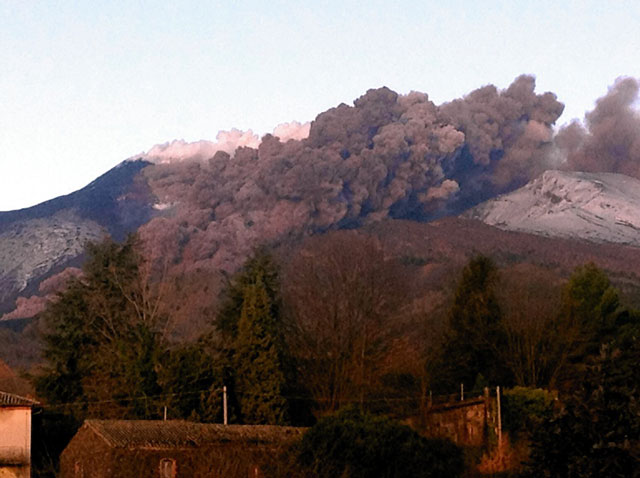 | Figure 149. The reddish ash cloud generated the morning of 11 February 2014 associated with a landslide and related eruption in the active vent area on the NSEC's E flank (upper left). This is a view from ~11 km E of NSEC (at Sant'Alfio, located on the Valle del Bove floor ~5.5 km from the closest point to the coast). Photo taken from INGV reporting on the 11 February event. They credit the photo to Casa di paglia Felcerossa-Permacultura. |
Prior to the 11 February 2014 eruption, the area of collapse at the NSEC vent had contained unstable heated rock. In the past weeks, multiple vents in this area had been active. One vent near the E rim of the vent area was hot enough to glow. The presence of molten rock (e.g., magma and lava), hot gases, and the glowing vent were interpreted by INGV to have contributed to destabilizing the area that failed during the eruption.
Although the mapped area is smaller, the reddish cloud of 11 February expanded as it advanced over the lava field of 2008-2009, covering it almost entirely, and reaching the Valle del Bove with a front about 1 km wide. Shortly after reaching the level ground at the base of the W wall of the Valle del Bove, the flow stopped in an area about 3.5-4 km away from source vent. A cloud of ash rose up and drifted NE.
Lava flows also continued to erupt on 11 February. Those were associated with bluish clouds. During and after the 11 February event, the NSEC still generated persistent strombolian eruptions accompanied by small ash emissions. At 1800 on February 11 this was in progress, showing no change compared to the activity of the last days. During 11-12 February the amplitude of tremor remained slightly higher than normal but it dropped back to normal levels after that, and the average amplitudes generally remained at modest levels through mid-March.
NSEC's strombolian emissions slightly intensified on 12 February. An unstable part of the lower E flank of the vent that collapsed on 11 February continued to produce small collapses and reddish ash clouds. Lava continued to flow from the cone towards the Valle del Bove, and by nightfall had reached the base of the steep W wall of the valley. It then advanced on the flat land to the N of Mount Centenari (figure 148).
Strombolian activity continued during 12-28 February. Lava emissions declined, but produced lava flows a few hundred meters long. Lava emissions continued also from an effusive vent from the interior of the portion of the recess formed 11 February, which continued through 17 February. On 15 February an explosion generated a vapor-and-ash plume, and was then followed by more explosions from the same area. Later on 15 February a small lava flow emerged from a new vent at the N base of the NSEC cone, which traveled 100 m towards the W wall of the Valle del Bove, and remained active the next day. During 16-17 February strombolian activity continued to produce small quantities of ash. Lava continued to flow from the vent at the base of the cone.
Activity during March 2014. During 1-10 March generally weak though persistent strombolian activity and diffuse ash emissions continued at NSEC. Tremor was generally low. An unstable part of the lower E flank of the cone that collapsed on 11 February (figure 150) continued to produce small collapses with reddish ash clouds, and thermal anomalies. Lava continued to flow from a vent on the lower part of the NSEC cone to the W wall of the Valle del Bove, and during 2-3 March the flows reached the base of the wall (figure 150).
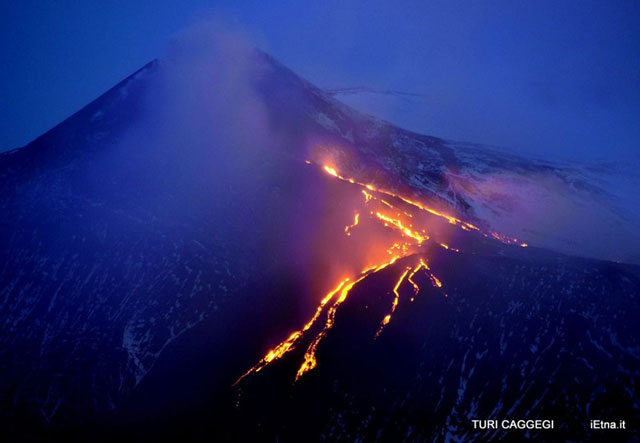 | Figure 150. Glowing Etna lava flows seen from the SE on the evening of 3 March 2014. The flows continued to vent from the lower flank of the NSEC cone. The vent was in the same area associated with the collapse of 11 February 2014. Photo credit Turi Caggegi. |
After several days of lava emissions from a vent on the lower part of the NSEC cone, during 5-6 March lava flows originated only from a higher vent and traveled 1.5 km towards the lower part of the W wall of the Valle del Bove. The lava flow fed by the vent on the inside of the unstable lower portion of the lower E flank remained active on 5 March. A second flow was fed a few hundred meters downslope , with an active front on the upper margin of the 2008-2009 lava field (directly to the NE, in the direction of Monte Simone and following the lava flow of 30-31 December 2013). On 8 March BN (Bocca Nuova) issued sporadic emissions of hot material with small amounts of volcanic ash.
INGV reported that during 12-25 March strombolian activity with occasional diffuse ash emissions continued from one or two vents at the base of Etna's NSEC cone. Lava flows originating from a vent on the upper wall traveled towards the upper part of the W wall of the Valle del Bove. Strombolian activity intensified during 18-22 March, producing more ash, and then decreased; no ash was emitted on 23 March. Lava flows originating from a vent on the upper wall traveled towards the upper part of the W wall of the Valle del Bove and also NE in the direction of Monte Simone. Tremor amplitude rose slightly on 24 March but declined on 26 March to low values similar to those seen prior to the episode of persistent NSEC eruptions that began on 21 January.
Strombolian activity at the NSEC cone ceased during the night of 26-27 March, after 64 days of persistent activity. Lava emissions from the lower side of the NSEC significantly decreased; on the evening of 28 March a small lava flow continued to advance but had stopped and was cooling the next day.
Activity during April 2014. During the night of 1-2 April emissions of minor lava flows from the NE base at NSEC cone decreased. Strombolian activity gradually intensified during the evening of 2 April, along with tremor, and then both decreased. Some collapses from the E flank of the NSEC cone took place that morning. Poor weather conditions prevented views of Etna for a few days, but by 7 April the lava flows had ceased and strombolian activity had sharply declined. No activity was observed on 8 April.
No eruptive activity at Etna was observed thereafter until the early hours of 22 April, when sporadic and weak strombolian activity resumed at the NSEC and continued for the next few days. Some explosions ejected incandescent pyroclastic material out of the crater and onto the upper S and SE flanks of the cone. A few small collapses occurred on the cone's unstable E flank. Late in the evening on 30 April the frequency and intensity of Strombolian explosions slightly increased. Degassing at the NEC also increased and thermal anomalies were detected by a camera.
Activity during May-13 June 2014. During the night of 2-3 May INGV attributed incandescence to weak, high-temperature gas emissions or strombolian explosions or both. The activity intensified on 4 May; some of the explosions ejected incandescent pyroclastic material high onto NSEC's S and SE flanks. Although tremor amplitude generally remained at low levels since early April; tremor on 1 May registered in episodes (banded tremor). Weak strombolian activity at NSEC continued through at least 10 June and no noteworthy eruptions were highlighted through 13 June.
Information Contacts: Istituto Nazionale di Geofisica e Vulcanologia (INGV), Sezione di Catania, Piazza Roma 2, 95123 Catania, Italy (URL: http://www.ct.ingv.it).
February 2015 (BGVN 40:02)  Cite this Report
Cite this Report
Strombolian eruptions, ash emissions, and new effusive vents through February 2015
Our last report (BGVN 39:11) covered activity at Etna through 13 June 2014, which consisted primarily of ongoing emissions of E-directed lavas from a vent area on the lower E flank of the New South East Crater (NSEC). This report, summarizing first-hand accounts by the Istituto Nazionale di Geofisica e Vulcanologia (INGV-Catania), covers the subsequent interval from 14 June 2014 through 2 February 2015. INGV described several eruptive episodes, including strombolian eruptions, ash emissions, and the appearance of new effusive vents at the E base of the North East Cone (NEC) and on the high E flank of the NSEC cone.
Activity during June-December 2014. On 14 June a new eruptive episode began within the NSEC, with near-continuous strombolian explosions and lava fountaining. Fine ash emissions were concurrent with lava that began to overflow the edge of the South East Crater (SEC), forming a flow that continued downhill on the W wall of Valle del Bove. During the morning of 15 June the overflowing lava followed the fissure that had been formed on 28 November 2013. Explosive activity occurred from three vents inside the crater. A spatter cone also formed in the NSEC's E sector, partially filling the fissure formed on the high NE flank during eruptions of late December 2013, and January–March 2014. During 14-15 June tremor increased sharply and remained moderately high until 18 June, when it returned to normal levels.
INGV noted that this lively strombolian activity over the course of four days was similar to the episode of effusive lava emissions observed during 14-16 and 19-31 December 2013 in terms of duration and intensity.
After images of a thermal anomaly in webcam images from Monte Cagliato, located on the E flank of Etna, a new, small fissure (tens of meters long) at the E base of the North East Crater (NEC) was observed by INGV Etna observatory personnel during 5-6 July. The vent was located between 3,015 and 3,025 m elevation. Weak spattering from this vent fed a lava flow that extended ~100 m within the saddle of the NSEC and SEC cones. Weak and sporadic strombolian explosions and small ash emissions were observed during 6-7 July from NSEC, but by 11 July this activity had ceased. Activity from the new fissure continued through 11 July with frequent strombolian explosions that were audible in nearby towns. The lava flow diverged; the longer of the two branches extended ~1.5 km, reaching the bottom of Valle del Leone.
On the morning of 25 July about 1114 local time, a new eruptive vent opened near the same eruptive fissure. This new vent ("25 July vent"), located at a distance of about 150-200 m to the N of the one from 5 July, was a source of strombolian explosions, accompanied at times by modest quantities of ash. This activity continued through 31 July. The strombolian explosions occurred at intervals of about 2-5 seconds and were often accompanied by visible compression waves ("flashing arcs") and audible rumblings up to a few tens of meters away, mostly in the E and NE sectors of the volcano. As previously observed, for example during the paroxysmal episode at the NSEC during 14-16 December 2013, the rumblings were interpreted as the result of explosions of gas bubbles inside the eruptive vent. Emissions of bombs and scoria occasionally rose 200 m high and fell within a few hundred meter radius around the vent. In a few instances, the explosions were accompanied by small quantities of ash. The lava flows, which had reached ~1.8 km during the preceding week, (halting on the saddle between the Valle del Leone and the Valle del Bove), had in the recent days overlapped the earlier ones, with active fronts at least 1 km from the effusive vent.
On 9 August INGV reported a strong decrease in volcanic tremor. From the 25 July vent, there began a gradual increase in the ash emissions that formed an ash plume, which rose to 1 km above the vent area and renewed strong strombolian activity in the evening. Strombolian activity increased at NSEC and was accompanied by small emissions of black ash that remained within the crater.
With the intensification of activity at the NSEC, the eruptive activity at the E flank of the NEC diminished. At 0645 on 9 August an effusive vent opened on the high E flank of the NSEC cone, which caused a small landslide and emitted a lava flow that after an hour had reached the E base of the cone. During the first 24 hours of activity, a small pyroclastic cone in the W portion of the NSEC summit appeared, increasing the height of the NSEC structure that began to grow in 2011. On 13 August INGV reported continued strombolian explosions, accompanied by modest emissions of ash and lava from a single vent on the high E flank of the NSEC. The lava flows emitted from the effusive vent to the E had almost ceased to advance the evening before, but two new branches were overlapping the earlier flow. The longest flow changed direction to later descend about 3 km NE toward Monte Simone. INGV reported that the eruption at NSEC had ended on 15 August and that the lava flow activity had ceased by 16 August (figure 151).
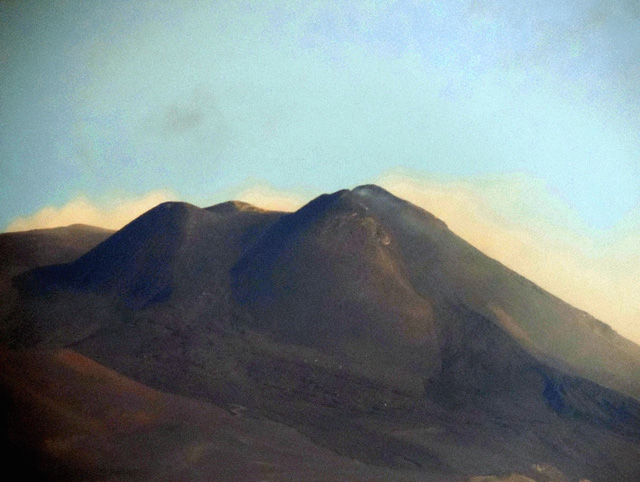 | Figure 151. This photo was taken on the morning of 16 August 2014 from the town of Tremestieri Etneo (from 20 km S of Etna). It shows Etna's NSEC (at right) with its new peak formed during the eruptive episode of 9-15 August. The old SEC cone (which appears lower) resides at left. Courtesy of Istituto Nazionale di Geofisica e Vulcanologia (INGV-Catania). |
Beginning in the afternoon of 7 October through 16 October the NSEC produced weak and intermittent explosive activity; small ash puffs were rapidly dispersed by the wind. During some nights small strombolian explosions ejected incandescent material a few tens of meters above the crater rim.
Starting at 1850 on 28 December the NSEC produced a short but intense eruption characterized by lava fountains, lava flows, and an ash plume that drifted E, and caused ash and lapilli fall in the nearby towns of Milo, Fornazzo, Sant'Alfio, and Giarre. It was the first typically "paroxysmal" event at the NSEC since 2 December 2013. Inclement weather prevented observations of the summit area, so the erupting crater was not identifiable. Two lava flows traveled E and NE, towards the Valle del Bove. Tremor began to decrease at 2030, and indicated that the eruption was over at 2200 (figure 152).
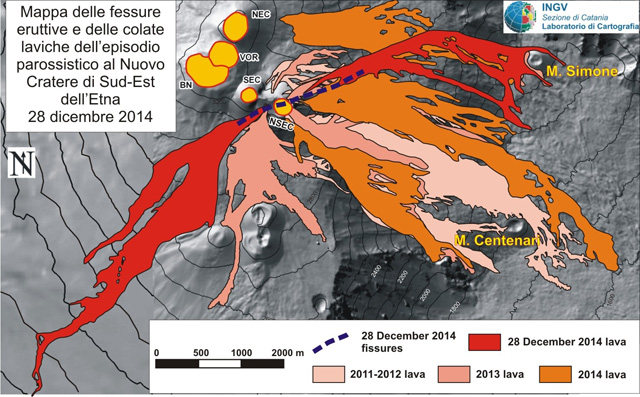 | Figure 152. Lava flows deposited associated with Etna's large 28 December 2014 eruption (red). N is towards the top. The NSEC vented on a fissure developed a few hundred meters to the SE of the SEC (NNW-trending dashed blue line). Courtesy of INGV. |
On 29 December, cameras viewing Etna recorded small ash emissions from the NSEC and persistent glow from the saddle between the SEC and NSEC cones at dusk. INGV indicated that this paroxysmal episode occurred at a series of eruptive vents along a NE-SW fissure that cut across the NSEC and the southern flank of the old SEC. From the two extremities of this fissure lava flows emerged, traveling SW toward the area of Milia-Galvarina and NW toward the northern part of the Valle del Bove near Monte Simone, reaching lengths of about 4.5 and 3.3 km, respectively (figure 152).
Activity during January 2015. During the night on 1 and 2 January, cameras recorded intermittent flashes from Voragine Crater (one of four summit craters), indicating strombolian activity there for the first time in nearly two years. At 0730 on 2 January explosions at NSEC generated ash plumes that drifted SW. Emissions ejected pyroclastic materials up to ~150 m above the crater rim, which intensified during the evening of 3 January.
At night during 6-7 January the frequency of strombolian explosions at the Voragine Crater decreased; however, some of the explosions ejected incandescent pyroclastic material outside of the crater and onto the W and SW flanks. On 7 January many of the small explosions generated brown ash plumes that rose a few hundred meters above Etna's summit and quickly dissipated. Strombolian activity increased on 8 January, possibly from two vents within the crater. Pyroclastic material continued to be ejected out of the crater. Early on 9 January strombolian activity again decreased and gave way to ash emissions that rose several hundred meters. During the evening on the same day some ash emissions were accompanied by incandescent pyroclastic material that at times fell on the external flanks of the central summit. Ash emissions continued the next morning, decreased, and had almost completely ceased by late morning. Ash emissions rapidly resumed in the afternoon and were sometimes accompanied by strombolian explosions. During the morning of 13 January, new ash emissions began at the Voragine. For some hours, these emissions were continuous, but successively diminished in the afternoon to every 5-10 minutes. Marco Neri, of the INGV- Osservatorio Etneo, during a helicopter overflight on 14 January, captured a clear view of these emissions and of the summit crater area (figure 153).
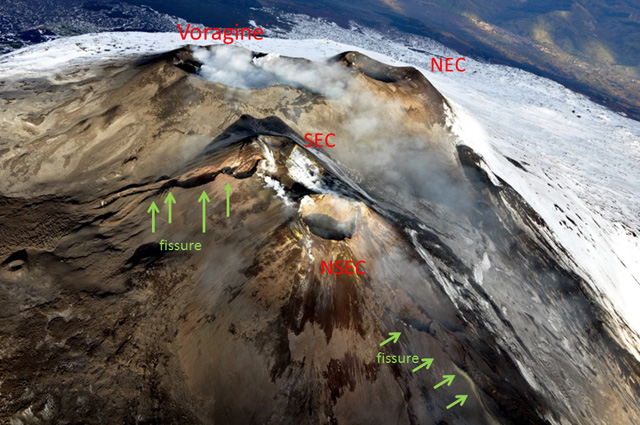 | Figure 153. Summit craters of Etna seen from helicopter on the morning of 14 January 2015, looking NW. In the foreground is the cone of the New South East Crater (NSEC), its summit vent being much enlarged after the 28 December 2014 paroxysm, and the old South East Crater (SEC), with an extensive fumarolic area on the saddle between the two cones. Note the two conspicuous eruptive fissures (labeled), one on the NE flank of the NSEC (in the lower right portion of the image), and the other on the S flank of the old SEC (which opened on 28 December 2014). In the background are the Bocca Nuova (at left), the Voragine (center, emitting a dense white vapor plume), and the North East Crater (NEC) (at right). The town visible in the distance at upper right is Randazzo, on the N-NW flank of Etna. Photo and caption courtesy of Marco Neri, INGV-Osservatorio Etneo. |
In the evening on 14 January weak strombolian activity was recorded at the Voragine Crater and NEC. The next day, occasionally pulsating ash emissions rose from the NEC and drifted SE. Ash emissions continued through 17 January; cloud cover prevented observations of the summit area on 18 January.
A new eruptive episode began on 31 January and continued through the morning of 2 February. Poor meteorological conditions prevented views of the summit area during the first 36 hours of the eruption. During improved viewing conditions on the evening of 1 February, volcanologists observed lively strombolian activity from a single vent in the saddle between the SEC and NSEC cones. Explosions occurred every few seconds and ejected incandescent bombs 200 m high, which fell on the S flank of the SEC. At the same time, from a vent at the southern base SEC cone corresponding to the lowest part of the SE eruptive fissure from 28 December, a lava flow issued that traveled 2 km S, dividing into two branches. At dawn on 2 February the strombolian activity produced a dense ash cloud that drifted E. At about 0750 emissions stopped, and volcanic tremor suddenly decreased.
Information Contacts: Istituto Nazionale di Geofisica e Vulcanologia (INGV), Sezione di Catania, Piazza Roma 2, 95123 Catania, Italy (URL: http://www.ct.ingv.it/).
May 2017 (BGVN 42:05)  Cite this Report
Cite this Report
Major eruptions with lava fountains, ash plumes, and lava flows during January-February, May, and December 2015
Italy's Mount Etna on the island of Sicily has recorded eruptions for the past 3,500 years. Lava flows, and explosive eruptions with ash plumes and lava fountains, commonly occur from its four major summit crater areas, the North East Crater, the Voragine-Bocca Nuova complex, the South East Crater (formed in 1978), and the newest, the New South East Crater (formed in 2011). The Etna Observatory, which provides weekly reports and special updates on activity, is run by the Catania Branch of Italy's Istituo Nazionale di Geofisica e Vulcanologica (INGV). This report uses information from INGV to provide a brief summary of the major events during 2011-2014, and a detailed summary of events between January 2015 and March 2016. Major eruptions took place during 28 December 2014-2 January 2015, 31 January-2 February 2015, 11-16 May 2015, and 3-7 December 2015.
Summary of 2011-2014 activity. Most of the 44 eruptive episodes at Etna reported by INGV between 12 January 2011 and 2 December 2013 occurred at the New South Crater (NSEC) (figure 154) at the SE edge of the summit crater area. These eruptive events generally lasted for less than an hour and were characterized by sustained lava fountains accompanied by dense ash emissions and ejected pyroclastic material. Eruptive episodes occurred at Bocca Nuova (BN) in July 2011, July-August and October 2012, and January-February 2013. In addition, two weeks of intense Strombolian activity took place at Voragine (VOR) between late February and mid-March 2013. After an episode on 27 April 2013, Etna was quiet for six months until a large explosion on 26 October 2013 sent pyroclastic material several kilometers above the summit and caused a brief closure at the Catania airport. Two other episodes at NSEC during the middle and end of December 2013 were characterized by strong Strombolian activity, but without sustained lava fountains and fewer ash emissions.
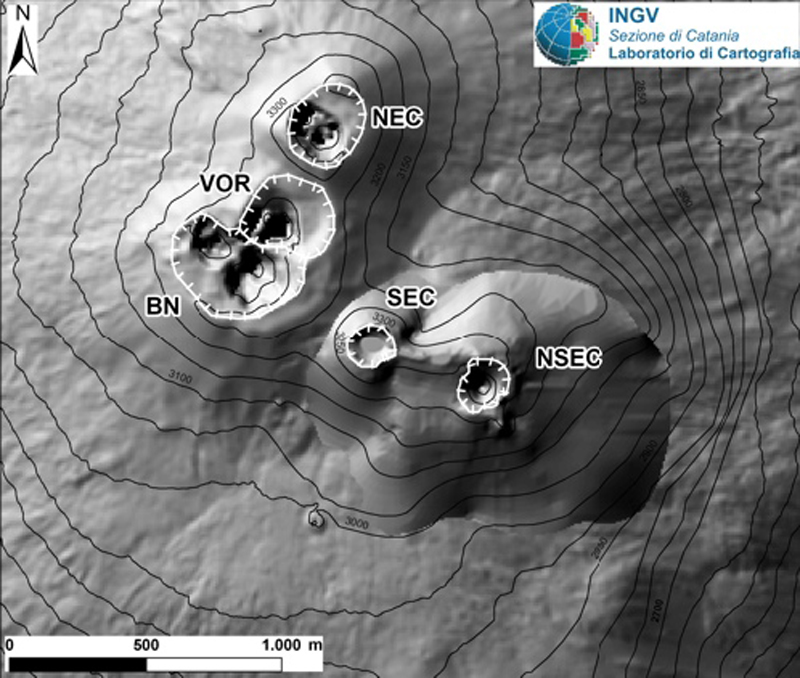 | Figure 154. DEM (Digital Elevation Model) of the summit crater area at Etna, August 2007, updated with GPS measurements at NSEC in January 2014, and annotated by INGV. The white hatched lines outline the crater rims. BN = Bocca Nuova; VOR = Voragine; NEC = North East Crater; SEC = South East Crater; NSEC = New South East Crater. Courtesy of INGV (Bollettino settimanale sul monitoraggio, volcanico, geochimico e sismico del volcano Etna, 6 January 2015, No. 2). |
During 2014, major activity was characterized by four events: 1) modest Strombolian activity and lava flows from the NSEC between 21 January and around 7 April; 2) intense Strombolian activity at NSEC accompanied by a lava flow to the SE during 14-18 June; 3) strong Strombolian explosions and lava flows from several vents between NSEC and the E flank of the North East Crater (NEC) between 5 July and 10 August; and 4) intense Strombolian activity at NSEC accompanied by a lava flow during 10-15 August. Weak explosive activity was also reported from NSEC during the second week of October.
Summary of December 2014-March 2016 activity. Activity from NSEC during 28-29 December 2014 created two major lava flows and an ash plume. During 31 January-2 February 2015 NSEC produced a new lava flow and several ash plumes. A minor ash emission from the BN crater took place on 12 April 2015. A large Strombolian eruption began at NSEC during the night of 11-12 May 2015, followed by a lava flow down the E flank on 13 May. Activity continued until 16 May. Minor ash emissions were reported from the NEC on 20 May, and again during 16, 18, and 19 July 2015.
The VOR crater released minor ash emissions on 20 and 24 August 2015, and again on 18 September. Small amounts of ash were also observed in a plume from NEC on 4 October. This was followed the next week by sporadic ash emissions from VOR which grew into persistent Strombolian explosions by the end of October and continued into mid-November. Strombolian activity at a new crater on the E flank of NSEC began on 25 November; ash emissions began there on 2 December 2015.
A major lava fountaining event from VOR began on 3 December 2015 which generated an ash plume that dispersed ash 70 km NE. This was followed by a 7-km-high (over 10 km altitude) ash plume the next day that sent ash to the E. Three more lava-fountain episodes took place at VOR over the next two days. After this the activity decreased at VOR but increased at NSEC with a 3.5-km-long lava flow on 6 December, followed by ash emissions and Strombolian activity. Sporadic ash emissions continued from VOR, NSEC, and NEC during December 2015-March 2016.
Activity during December 2014-February 2015. After four and a half months of relative quiet, with only minor ash emissions during 7-16 October 2014, the NSEC began a new eruptive episode on 28 December 2014 (BGVN 40:02). This was the 45th major episode at Etna since January 2011, according to INGV, and was characterized by lava fountains, lava flows in two different directions from a NE-SW trending fissure that crossed the NSEC (see figure 152, BGVN 40:02), and a tephra plume that drifted to the E. INGV calculated a volume of lava from the 28-29 December event, based on a lava thickness of 1.5-2 m, of about 3 x 106 m3. Coarse ash and lapilli as large as 4-5 cm were reported in Fornazzo (9 km E), and mostly coarse ash and fine lapilli were deposited in Giarre (15 km E). Fine ash was also reported in Linguaglossa 17 km NE.
Explosive activity at NSEC resumed on 2 January 2015 with dense continuous ash emissions lasting until the next day that dispersed SW (figure 155). During the night of 1-2 January, INGV also observed new Strombolian activity from VOR for the first time in two years. During the next week, incandescent pyroclastic material rose up to 150 m above the crater rim and occasionally fell outside the crater onto the W and SW flanks; this was accompanied by minor ash emissions rising a few hundred meters. MODVOLC thermal alerts were issued nine times between 5 and 10 January. Strombolian and ash plume activity resumed at the NEC on 14 January for a few days (figure 156), but clouds obscured the summit area for most of the rest of the month. Intense degassing and minor ash was seen during clear weather through 31 January.
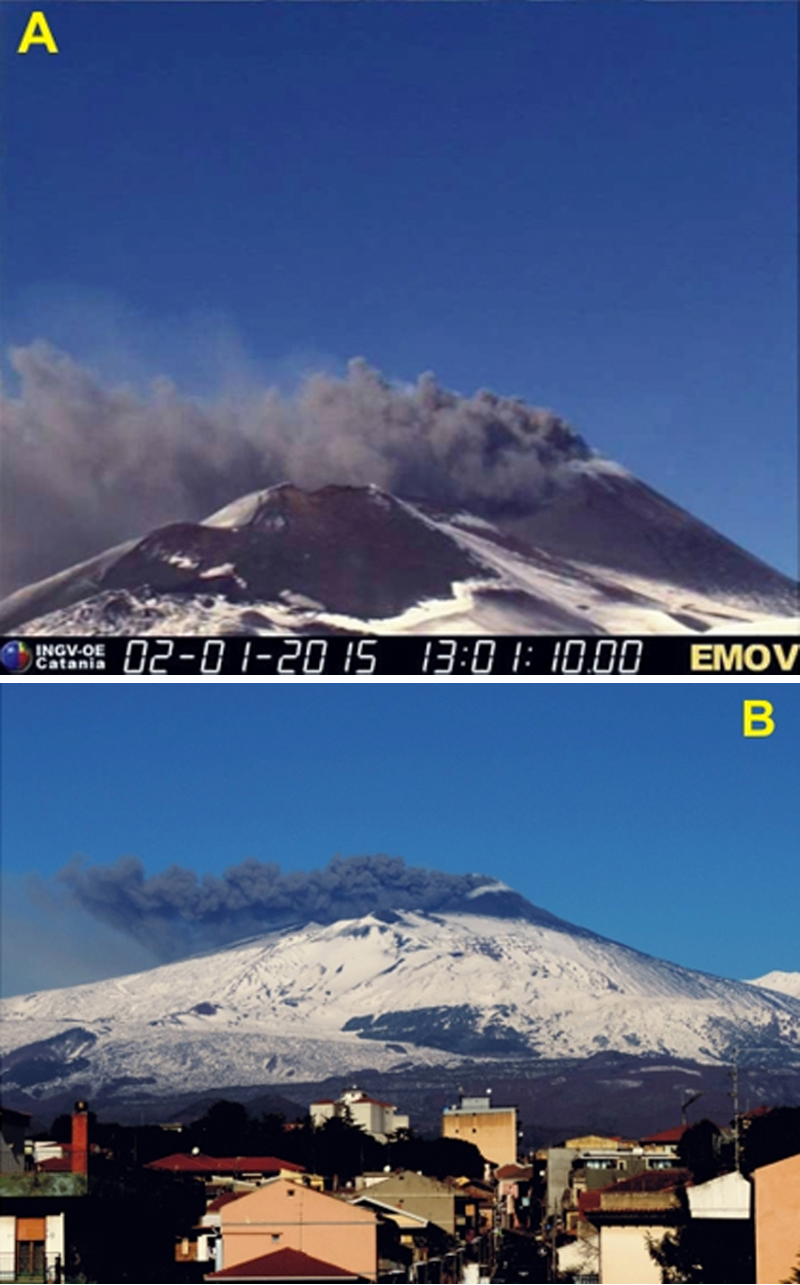 | Figure 155. Dense ash cloud from the New Southeast Crater (NSEC) at Etna that dispersed to the SW on 2 January 2015. A) taken from the webcam at La Montagnola (EMOV) 3 km S of the summit, and B) from the town of Tremestieri Etneo, 20 km S of Etna. Photo by Boris Behncke; courtesy of INGV (Il Parossismo dell'Etna del 28 Dicembre 2014 e la Susseguente Attivita al Crateri Sommitale, INGV). |
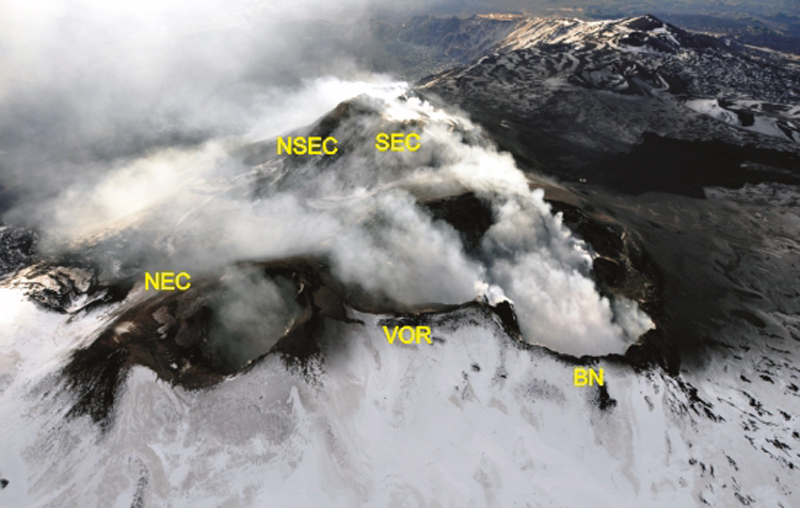 | Figure 156. The summit area of Etna on 14 January 2015, observed from a Coast Guard AW139 helicopter. Minor gray ash was emitting from the Northeast Crater (NEC) and the Voragine (VOR). Dense steam plumes are visible coming from Bocca Nuova (BN) and the fumarolic vents at Southeast (SEC) and NSEC. Photo by Marco Neri; courtesy of INGV (Bollettino settimanale sul monitoraggio, volcanico, geochimico e sismico del volcano Etna, 20 January 2015, No. 4). |
A sudden increase in volcanic tremor amplitude in the early morning of 31 January 2015 indicated a new ash emission from the summit which was obscured from view by clouds. Later in the morning, fine ash fell over the snow in Rifugio Citelle (6 km NE). Strombolian activity was observed, along with a new lava flow moving to the SW, from the NSEC the next day. Sixteen MODVOLC thermal alerts were issued during 1-2 February while the lava flow was active. A field survey on 2 February determined that the lava front had stopped at 1,950 m elevation near the Monte Scavo area on the SW flank (figure 157). An ash emission occurred at NSEC in the early morning of 2 February; only persistent degassing was observed from the summit craters for the remainder of February.
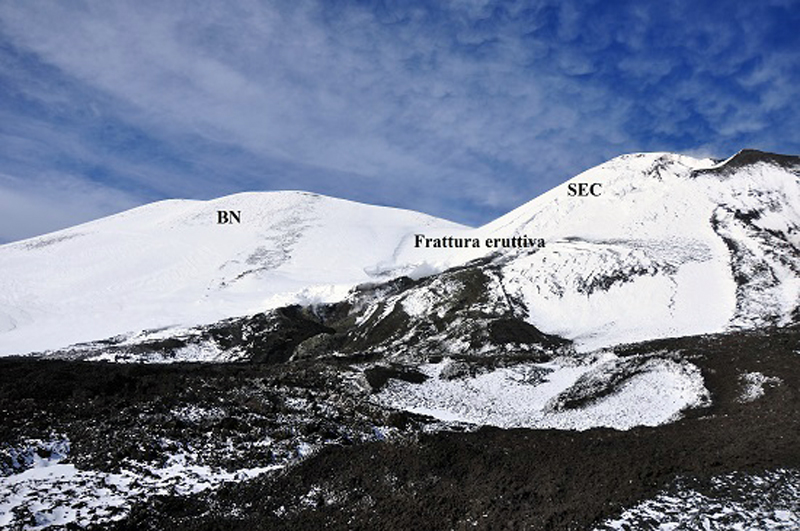 | Figure 157. The 1 February 2015 lava flow at Etna observed on 2 February from the base of the S flank of the New Southeast Crater (NSEC). BN = Bocca Nuova, SEC = South East Crater. The NSEC is at the top right of photo. Courtesy of INGV (Bollettino settimanale sul monitoraggio, volcanico, geochimico e sismico del volcano Etna, 10 February 2015, No. 7). |
Activity during March-September 2015. Degassing continued from the summit craters through March 2015 as viewed during limited clear weather. A high-temperature fumarole was observed in an infrared camera image on the E edge of NSEC on 29 March. The next ash emission occurred on 12 April from Bocca Nuova; it produced a plume a few tens of meters high that drifted SE, leaving fallout of fine reddish ash on the snow covering the western wall of the Bove Valley above 2,000 m elevation. A second smaller emission later in the day quickly dissipated.
A visit to the summit on 29 April 2015 confirmed persistent degassing from the craters. INGV scientists noted that the narrow septum separating the BN and VOR craters was much lower in height and broken through at the base, compared with earlier visits (figure 158). A small brownish-red ash plume on 1 May rose from BN; it likely resulted from a collapse inside the NW crater wall.
 | Figure 158. A view from the SE rim looking into the Bocca Nuova (BN) crater at Etna on 29 April 2015. In the foreground (a) is the SE pit crater which is blocked with debris, and in the background (b), the NW pit crater is degassing. The red arrow indicates the portion of the septum (setto) between Bocca Nuova (BN) and Voragine (VOR) that has collapsed. Courtesy of INGV (Bollettino settimanale sul monitoraggio, volcanico, geochimico e sismico del volcano Etna, 5 May 2015, No. 19). |
A Strombolian eruption began during the night of 11-12 May 2015 from the central part of NSEC. By midnight, the activity was strong enough to send tephra out of the crater and onto the flanks. A new lava flow appeared from a fracture just below the rim on the NE side early on 13 May; it generally followed the path of the 28 December 2014 flow to the NE. This was followed by increased ash emissions later in the day. The lava flow continued to advance NE during 14 May, into the Valle del Leone, and crossed near Monte Rittmann, flowing rapidly down the steep slope connecting the Valle del Leone with the Valle del Bove, headed towards Monte Simone (figure 159). By the end of the day it had traveled 3.5 km and was at 2,000 m elevation.
 | Figure 159. Early morning on 14 May 2015 reveals the lava flow on the NE flank of Etna from a fissure on the E flank. Photo by Emanuela/Volcano Discovery Italia; courtesy of Volcano Discovery. |
Intense Strombolian activity continued the next day at NSEC along with intermittent ash emissions. The lava flow split and flowed down the central part of the Valle del Bove, travelling 4.5 km to just below 1,800 m elevation. During the morning of 15 May a series of strong ash emissions lasting 2-3 minutes each continued from BN for about two hours. By the evening, the lava flow had traveled about 5 km and was at 1,700 m elevation (figure 160). Between 12 and 16 May, MODVOLC issued 103 thermal alerts for Etna.
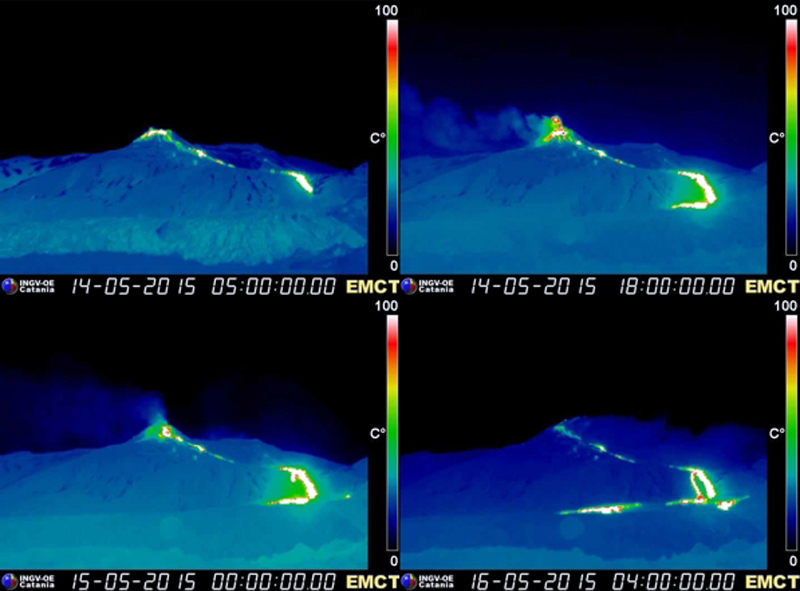 | Figure 160. Images from the Monte Cagliato thermal camera (8.3 km ESE) taken on 14, 15, and 16 May 2015 at Etna show the summit from the E. The 13-16 May lava flow is seen progressively expanding into Valle del Bove until reaching the vicinity of Rocca Musarra and Serracozzo. Courtesy of INGV (Bollettino settimanale sul monitoraggio, volcanico, geochimico e sismico del volcano Etna, 19 May 2015, No. 21). |
By the morning of 16 May, volcanic tremor had diminished and Strombolian activity had ceased, but magma was still feeding the lava flow until the afternoon, when it tapered off. During the morning of 20 May there were sporadic brown ash emissions from the NEC. After this, variable amounts of degassing continued at the summit craters for a few months, with the NEC being the most active. This period of relative quiet permitted INGV scientists to make several surveys of the summit during July to document the effects of the recent eruptions on the craters (figures 161 and 162).
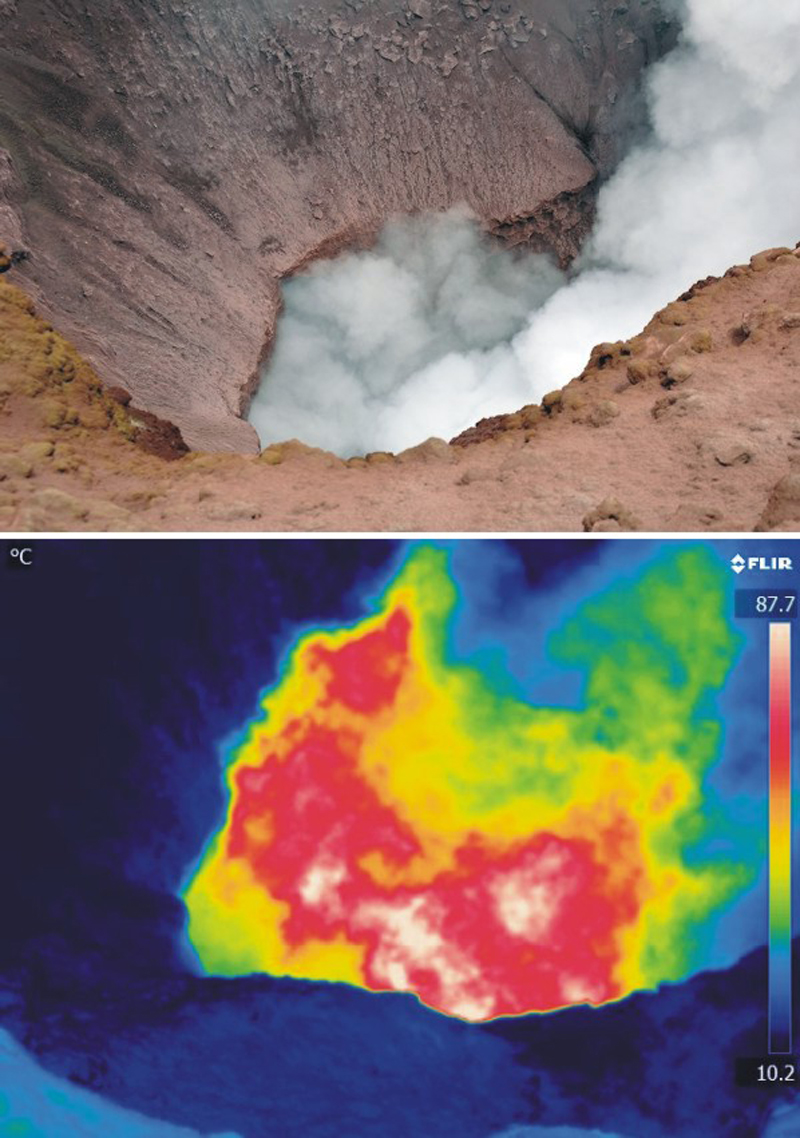 | Figure 161. The vent at the bottom of the Northeast Crater (NEC) at Etna is viewed with both visible (top) and thermal (bottom) images on 2 July 2015. Courtesy of INGV (Bollettino settimanale sul monitoraggio, volcanico, geochimico e sismico del volcano Etna, 7 July 2015, No. 28). |
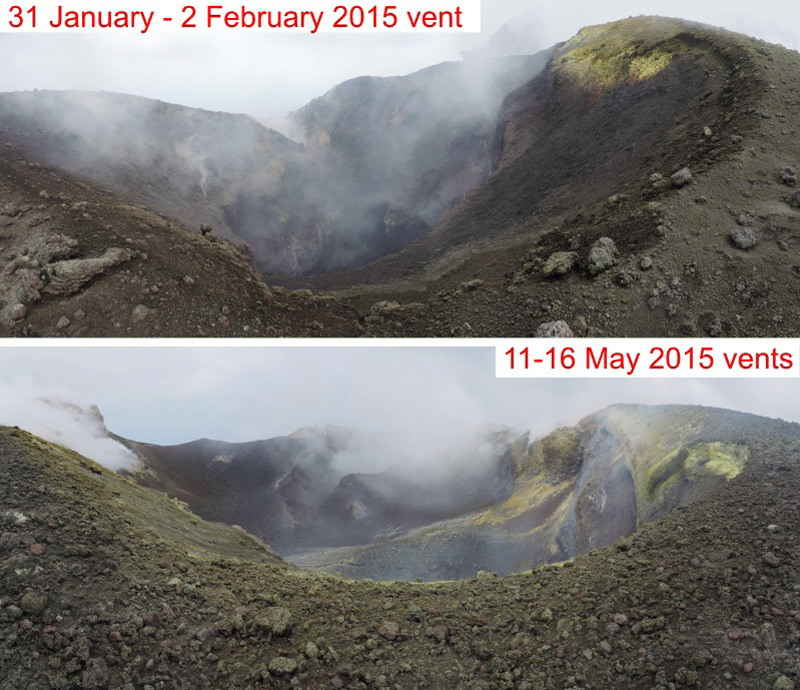 | Figure 162. Views of the multiple vents at Etna's New Southeast Crater (NSEC) on 8 July 2015 showing changes caused by the 2014 and 2015 activity. Top: Vent on the S side of NSEC formed during the 31 January-2 February 2015 episode, looking SW. Bottom: The NSEC, looking SE at the main crater formed during the 28 December 2014 episode. Inside of this are several vents that were active during the 11-16 May 2015 episode. Photo by B. Behncke; courtesy of INGV (Bollettino settimanale sul monitoraggio, volcanico, geochimico e sismico del volcano Etna, 14 July 2015, No. 29). |
During a field visit on 16 July 2015, INGV scientists witnessed intense pulsating gas emissions and loud noises at NEC; the gas often contained small amounts of reddish fine-grained ash. Increased gas emissions on 18 and 19 July rose a few hundred meters above the summit and occasionally released appreciable amounts of reddish ash that covered the W flank of the crater. Small puffs with minor ash were intermittent for the next several days. Only degassing from the summit craters was observed until 20 August when minor ash emissions were noted from VOR. The next day increased seismicity was recorded at the summit area, but there were no visible surface effects. Frequent gas emissions that included minor ash were observed at the summit during a visit on 24 August (figures 163 and 164).
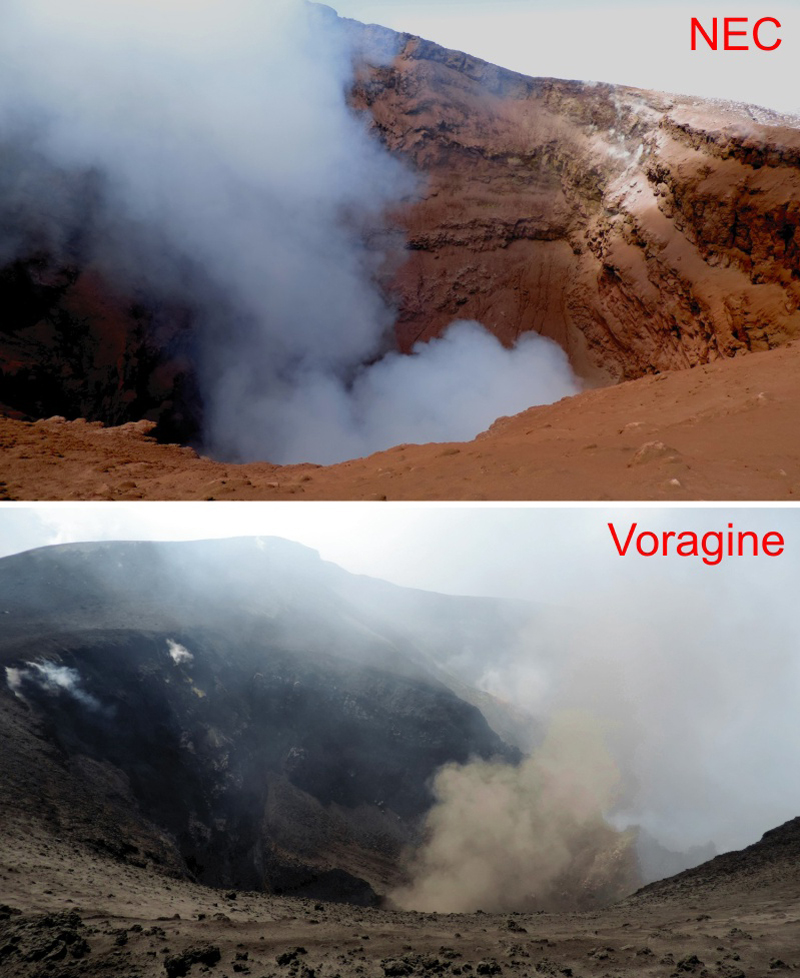 | Figure 163. Emissions from Etna's summit crater on 24 August 2015. Steam emissions from the Northeast Crater (NEC) viewed from the N edge of the crater (top) and a weak ash emission from the Voragine (bottom), seen from the NW edge of the crater. Photos by B. Behncke; courtesy of INGV (Bollettino settimanale sul monitoraggio, volcanico, geochimico e sismico del volcano Etna, 1 September 2015, No. 36). |
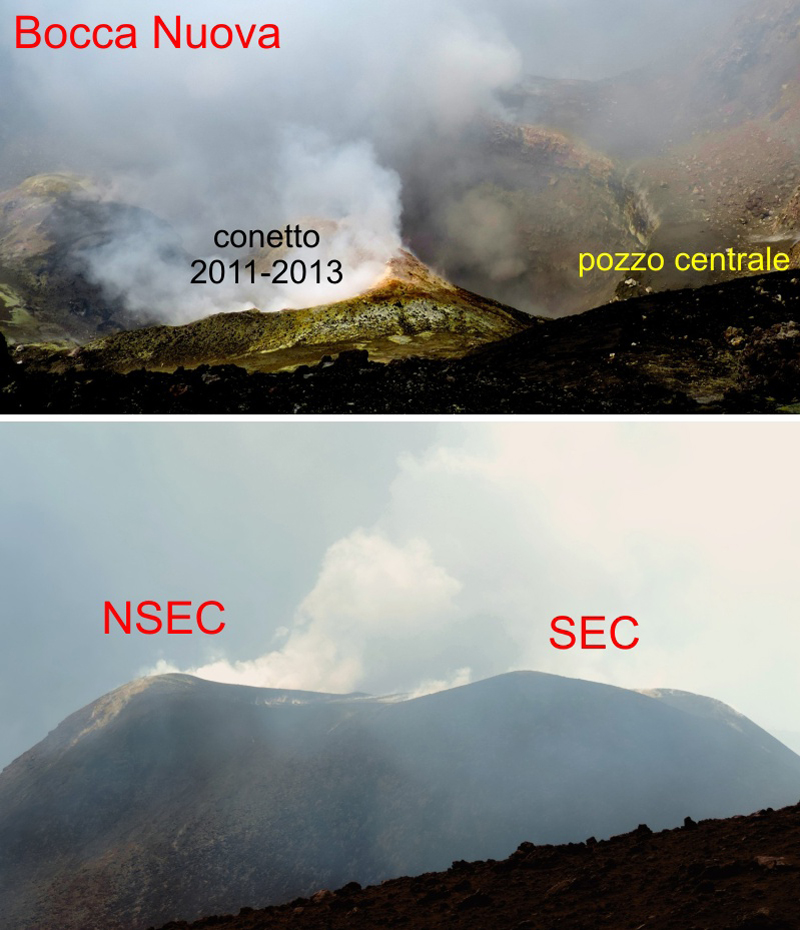 | Figure 164. Activity at the summit craters at Etna on 24 August 2015. Top: The Bocca Nuova seen from its E rim, with vapor emitting from the cone (conetto) that formed during 2011-2013 activity, and darker emissions of gas and small amounts of fine-grained ash from the pit located in the center of the crater floor (pozzo centrale). Bottom: fumarolic activity at the Southeast Crater (SEC) and New Southeast Crater (NSEC), viewed from the E edge of the Voragine. Photos by B. Behncke; courtesy of INGV (Bollettino settimanale sul monitoraggio, volcanico, geochimico e sismico del volcano Etna, 1 September 2015, No. 36). |
Degassing continued at the summit craters during September. The Montagnola webcam captured a minor ash emission from VOR on 18 September 2015. A glowing fumarole was observed inside the NSEC during a summit visit on 23 September 2015 (figure 165).
 | Figure 165. A glowing fumarole inside Etna's New Southeast Crater (NSEC) observed on 23 September 2015. Photo by B. Behncke; courtesy of INGV (Bollettino settimanale sul monitoraggio, volcanico, geochimico e sismico del volcano Etna, 29 September 2015, No. 40). |
Activity during October-November 2015. Small but appreciable amounts of reddish ash which quickly dissipated were contained in a gas plume from NEC on 4 October 2015. Activity the following week (12-18 October) was characterized by sporadic, minor ash emissions from VOR; they were brownish-red, and were ejected during pulsating events that lasted for a few tens of seconds, repeating for as long as a few hours. Explosive activity was witnessed by a field crew at the bottom of VOR on 19 October. Lithic fragments and ashes were ejected in the immediate area of the crater. Activity increased at VOR during the end of October. During an inspection on 27 October, Strombolian explosions every 5-10 minutes sent incandescent pyroclastic material around the crater and produced minor ash emissions. A few bombs fell along the NW crater rim (figure 166).
 | Figure 166. Activity at Etna's Voragine Crater on 27 October 2015. a) DEM of the summit crater area at Etna (DEM 2012, Aerogeophysical Laboratory - Section 2). The red circle indicates the position of the vent inside Voragine. BN = Bocca Nuova; VOR = Voragine; NEC = Northeast Crater; SEC = Southeast Crater; NSEC = New Southeast Crater. b) The vent on the N side of the Voragine; c) detail of a Strombolian explosion from the vent. Photo by B. Ragonese (Group Guide Etna Nord, 27 October 2015); courtesy of INGV (Bollettino settimanale sul monitoraggio, volcanico, geochimico e sismico del volcano Etna, 3 November 2015, No. 45). |
On the morning of 2 November, after stormy weather conditions had blocked views of the summit for several days, volcanic ash was observed on the camera lens of the Montagnola (EMOV) webcam that was later washed away by rain. During a 4 November field survey, an ash deposit was discovered within layers of snow that fell between 31 October and 2 November on the upper part of the S flank (figure 167). The source of the ash remains unknown.
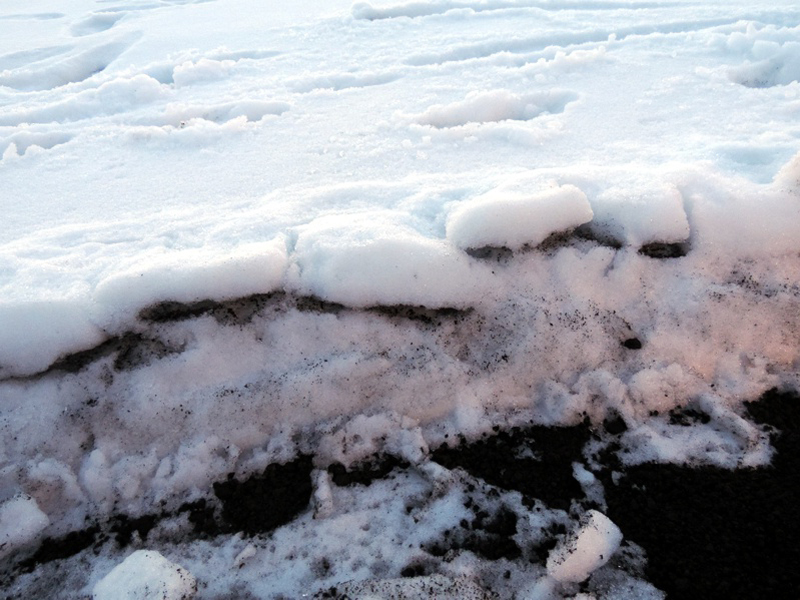 | Figure 167. Ash deposit at Etna interlayered in the snow that fell between 31 October and 2 November 2015, exposed along the track leading from the cable car station at Torre del Filosofo, at an elevation of approximately 2,800 m. Photo taken on 4 November 2015. Courtesy of INGV (Bollettino settimanale sul monitoraggio, volcanico, geochimico e sismico del volcano Etna, 10 November 2015, No. 46). |
Modest Strombolian activity continued from the bottom of VOR during November 2015. A single small explosion occurred at the NSEC in the early hours of 8 November. During a 14 November field visit, INGV scientists observed intracrater explosive activity continuing at VOR which included several explosions with abundant ash emissions, interspersed with periods of strong spattering. On the E rim of the crater, several fresh, large (40 cm) clasts of volcanic debris had fallen as far as 12 m from the edge of the rim (figure 168).
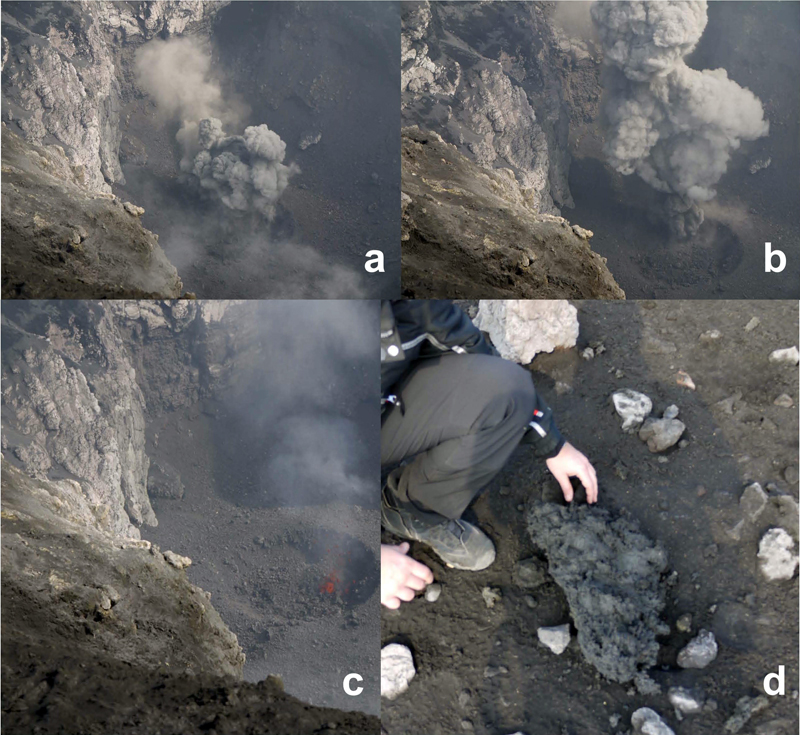 | Figure 168. Explosive activity at the Voragine crater (VOR) at Etna on 14 November 2015. a and b) volcanic ash explosions; c) an episode of strong spattering of ejecta without ash emissions; d) a recent bomb from the eastern edge of the pit inside the crater. Courtesy of INGV (Bollettino settimanale sul monitoraggio, volcanico, geochimico e sismico del volcano Etna, 17 November 2015, No. 47). |
By the third week in November 2015, ash emissions from VOR were more frequent and reached high enough levels to be visible from the webcams on the S slope. Lapilli and bombs rising more than 10 m above the northern edge of VOR were observed on a site visit on 19 November. During 20 and 21 November, a slow and gradual increase in the magnitude of volcanic tremor was noted, but there was no visible change at the summit. Weak Strombolian activity began at NSEC on 25 November and was observed in the Montagnola webcam. This led to the formation of a new "pit crater" located a few tens of meters below the E edge of the NSEC, with a diameter of 15-20 m.
Eruption of 2-8 December 2015. While on a site visit to VOR on 2 December 2015, INGV observed continuing Strombolian explosions with material ejected tens of meters above the crater rim; the cone at the bottom of the crater had continued to grow from the previous week. An explosion at the NSEC pit crater in the afternoon generated minor ash emissions, and Strombolian activity at VOR increased in the evening. A progressive increase in explosive activity began at VOR on 3 December. In the early morning, a lava fountain reached heights well over 1 km (figure 169) above the crater rim.
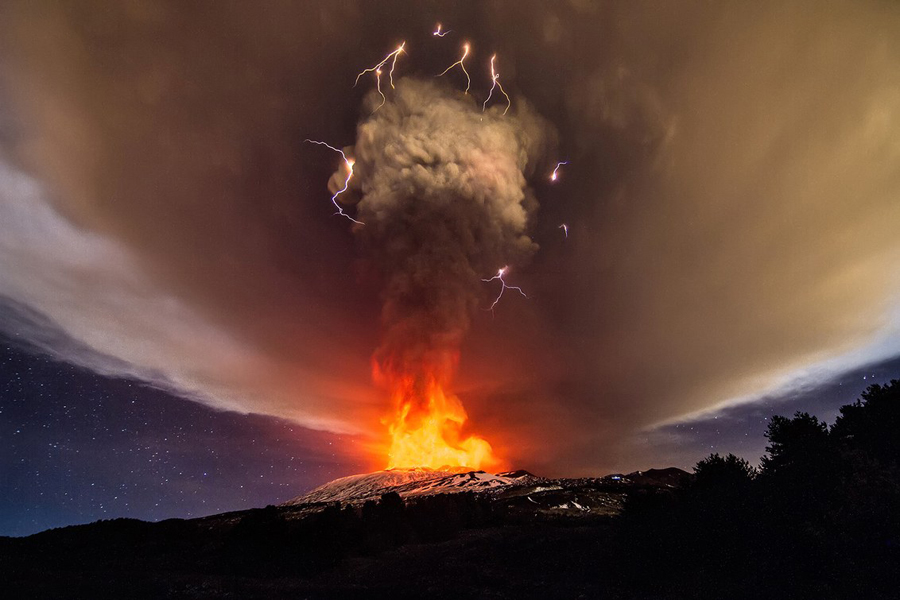 | Figure 169. Eruption from the Voragine crater (VOR) at Etna during the early morning of 3 December 2015. Witnesses reported the lava fountain as over 1 km in height. Photo by Marco Restivo/Demotix/Corbis; courtesy of Erik Klemetti. |
An ash plume from this eruption initially drifted NE; ashfall was reported in Linguaglossa (17 km NE), Francavilla di Sicilia (20 km NE), Milazzo, Messina (70 km NE) and Reggio Calabria (70 km NE) (figure 170). Weak and sporadic ash emissions also occurred from the NSEC pit crater. INGV reported this as one of the most intense and among the largest eruptions from Etna in the last twenty years, similar to events on 22 July 1998 and 4 September 1999. After about one hour, activity diminished and returned to less intense Strombolian activity.
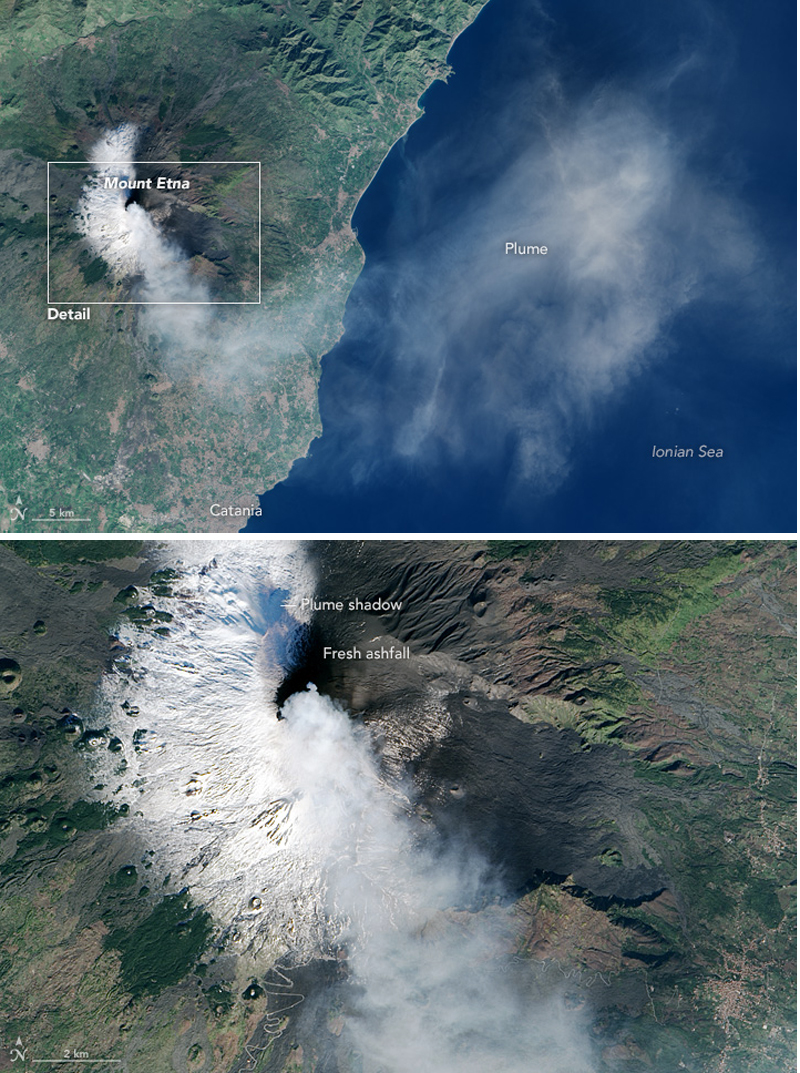 | Figure 170. The OLI instrument on Landsat 8 collected this natural-color view of the ash plume from Etna on 3 December 2015 drifting SE after initially drifting NE. The close-up image (bottom) reveals abundant fresh ashfall on the NE quadrant of the volcano. Courtesy of NASA Earth Observatory. |
The explosive activity at VOR intensified again around 0900 UTC on 4 December, with renewed lava fountains and an ash plume that rose 7-8 km above the summit (10-11 km altitude); this episode lasted until about 1025 UTC (figure 171). Ash emissions continued throughout the day from the NSEC as well. Bombs and lapilli were deposited high on the SW slope above 2,000 m elevation. Ashfall was reported in the Giarre-Zafferana area 17 km E. Strombolian activity continued for much of the day at VOR until 2000 UTC, when the third lava fountain (since 3 December) erupted that lasted for about 90 minutes before subsiding again to less intense Strombolian activity.
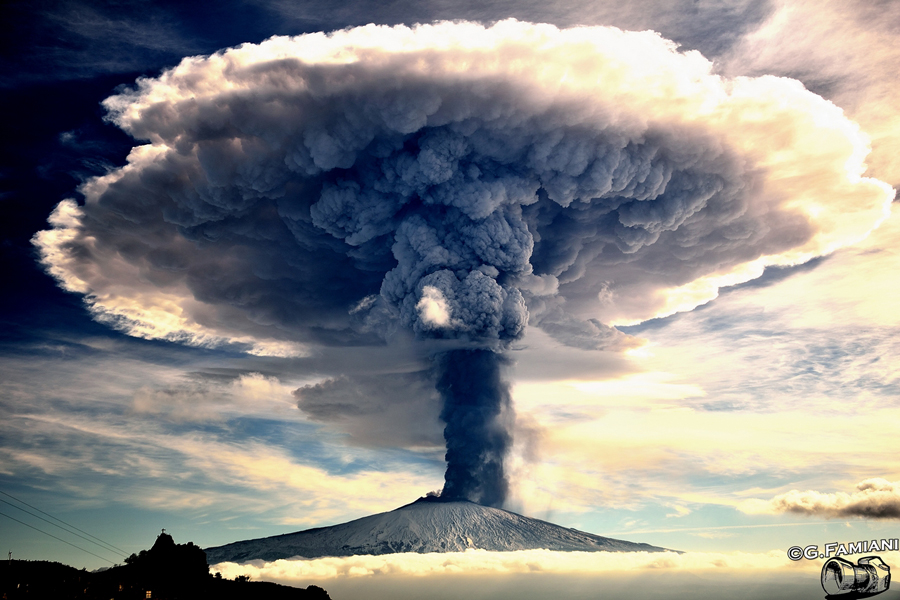 | Figure 171. Eruption at Etna from the Voragine crater (VOR) in the morning of 4 December 2015, viewed from Cesaro, province of Messina (27 km NW). Copyrighted photo by Giuseppe Famiani, used with permission. |
A fourth episode of lava fountaining from VOR took place mid-afternoon on 5 December 2015 and lasted for about 60 minutes. After this, activity decreased (both ash emissions and Strombolian explosions) from VOR, but increased at the NSEC pit crater, which grew due to continuous activity. In the early morning the following day two pyroclastic flows descended a few hundred meters toward the Valle del Bove. Around 1700 UTC, INGV personnel observed two lava flows, fed from the NSEC, headed toward Valle del Bove; one headed E for 3.5 km and reached 2,100 m elevation, and the other advanced ENE a few hundred meters to 2,600-2,700 m elevation. The easternmost vent at NSEC began emitting dark ash plumes on 7 December along with Strombolian activity that evening (figure 172). Activity at NSEC lasted for about 48 hours, ending in the morning of 8 December.
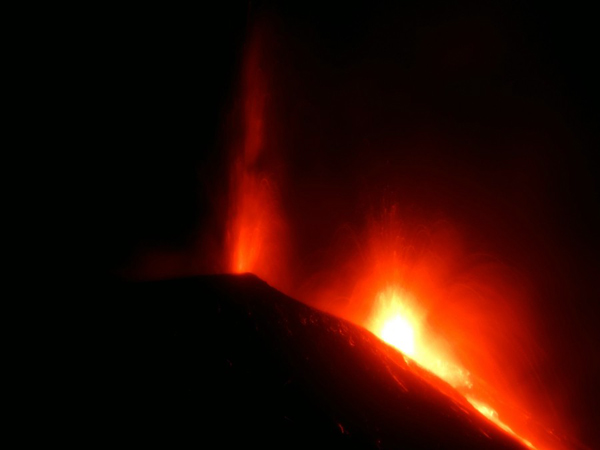 | Figure 172. Lava flows and Strombolian activity at Etna on the evening of 7 December 2015 from the new vent on the E side of the New Southeast Crater (NSEC) that formed in late November. Photo by B. Behncke, taken from Piano del Vescovo, on the SE flank. Courtesy of INGV (Etna Update, 8 December 2015). |
Activity during December 2015-March 2016. Ash plumes accompanied by sporadic Strombolian activity were ejected from the NEC beginning on 7 December, and lasting intermittently through 14 December. Renewed explosions on 13 December at NSEC produced ash emissions, minor incandescence, and thermal anomalies. MODVOLC reported 84 thermal anomalies at Etna between 2 and 9 December.
INGV scientists observed on a 12 December visit that the BN and VOR craters were essentially joined into a larger, single crater after the early December explosions, similar to the former Central Crater at Etna. VOR was covered with tens of meters of pyroclastic debris. The debris also covered much of the rest of the summit area, including the lava flows from the previous winter. The parking lot of the visitor area, located 0.5-1 km W and NW of VOR, was marked with numerous impact craters several meters in diameter.
Two minor ash emissions occurred at VOR on 19 December. After that, only steam emissions were observed at the summit until 28 December when a new series of ash emissions with minor incandescence were ejected from the vent on the E flank of NSEC. They were sporadic over the next several days and had ceased by 8 January 2016. Trace amounts of ash were again reported from the E flank vent during the last days of January 2016 and on 6 February. During this time, emissions from NEC often contained trace amounts of ash. Modest amounts of brown ash were observed from the NEC in the morning of 9 February.
An explosive event at NEC on 23 February created an ash plume tens of meters high which drifted N and rapidly dissipated. Lightning was observed in the ash cloud. Ashfall was reported in Linguaglossa, Gaggi, and Santa Teresa Riva (40 km NE) from this event. A new emission on 25 February consisted of several pulses of medium-low intensity that produced a very dilute ash plume a few meters above the crater. During March 2016, sporadic ash emissions at NEC accompanied persistent degassing, but there were no reports of ashfall other than in the immediate area of the crater.
Sulfur dioxide data. Numerous images of SO2 emissions from Etna during this period were captured by the Aura instrument on NASA's OMI satellite. Emissions during the four major eruptive events discussed in this report (28-29 December 2014, 31 January-2 February 2015, 11-16 May 2015, and 2-7 December 2015) were the largest (figure 173).
 | Figure 173. Sulfur dioxide plume data for Etna during the four major eruptive episodes covered in this report. Clockwise from top left: 29 December 2014, SO2 plume drifts E; 1 February 2015, SO2 plume drifts ENE; 15 May 2015 SO2 plume drifts SW, E and NE; the largest, from 6 December 2015, shows a detached plume drifting NNE and another plume moving NW that is truncated by the row-anomaly shadow. Courtesy of NASA/GSFC. |
Information Contacts: Sezione di Catania - Osservatorio Etneo, Istituto Nazionale di Geofisica e Vulcanologia (INGV), Sezione di Catania, Piazza Roma 2, 95123 Catania, Italy (URL: http://www.ct.ingv.it/it/); Hawai'i Institute of Geophysics and Planetology (HIGP), MODVOLC Thermal Alerts System, School of Ocean and Earth Science and Technology (SOEST), Univ. of Hawai'i, 2525 Correa Road, Honolulu, HI 96822, USA (URL: http://modis.higp.hawaii.edu/); NASA Earth Observatory, EOS Project Science Office, NASA Goddard Space Flight Center, Goddard, Maryland, USA (URL: http://earthobservatory.nasa.gov/); NASA Goddard Space Flight Center (NASA/GSFC), Global Sulfur Dioxide Monitoring Page, Atmospheric Chemistry and Dynamics Laboratory, 8800 Greenbelt Road, Goddard, Maryland, USA (URL: https://so2.gsfc.nasa.gov/); Erik Klemetti Eruptions Blog, Wired (URL: https://www.wired.com/author/erikvolc/); Tom Pfeiffer, Volcano Discovery (URL: http://www.volcanodiscovery.com/).
September 2017 (BGVN 42:09)  Cite this Report
Cite this Report
Lava flows during May 2016 followed by new fracture zones and major subsidence at the summit craters
Italy's Mount Etna on the island of Sicily has had historically recorded eruptions for the past 3,500 years. Lava flows, explosive eruptions with ash plumes, and lava fountains commonly occur from its major summit crater areas, the North East Crater (NEC), the Voragine-Bocca Nuova complex (VOR-BN), the South East Crater (SEC) (formed in 1978), and the New South East Crater (NSEC) (formed in 2011). The Etna Observatory, which provides weekly reports and special updates on activity, is run by the Catania Branch of Italy's Istituo Nazionale di Geofisica e Vulcanologica (INGV). This report uses information from INGV to provide a detailed summary of events between April 2016 and January 2017.
Summary of April 2016-January 2017 activity. A new eruptive episode at Etna began on 15 May 2016 and included activity around all four major summit cones; Strombolian activity began at NSEC on 15-16 May, from a pit on the E flank of the cone. The following night, thermal webcams suggested Strombolian activity at NEC. This ceased on 18 May when Strombolian activity started at VOR that also produced a large ash plume. Lava then overflowed the W rim of BN and headed W multiple times during the next few days. A different flow emerged from a fracture on the SE side of VOR near SEC on 21 May. Activity from all of the active vents had ended by 26 May. New fracture zones trending N-S and NE-SW, and extensive subsidence within VOR were observed at the summit craters at the end of May after the episode ceased.
Intermittent weak ash emissions during late May and July and intense degassing from several craters were the primary activity until explosive activity at VOR began on 7 August and opened a new vent along the inner wall of the NE rim. Strong subsidence followed at VOR and BN during August and September, creating a single large crater that included both areas. Dense ash emissions from the vent on the upper E flank of NSEC in mid-October and a few modest ash emissions from VOR and NSEC were observed. There was also persistent incandescence from the new vent at VOR and its continued subsidence through early January 2017. After the spike in activity during May 2016, heat flow diminished, but was persistent throughout the period (figure 174).
 | Figure 174. MIROVA log radiative power thermal anomaly graph of activity at Etna from late May 2016 through early January 2017. A major effusive eruptive event with lava flows and Strombolian activity caused a spike in heat flow during late May 2016, but heat flow was persistent throughout the period. Courtesy of MIROVA. |
Activity during March-April 2016. After the major lava fountains and ash plumes of the first week of December 2015 (BGVN 42:05), eruptive activity was lower through March 2016. Sporadic ash emissions and minor incandescence were reported a few times each month. The largest event was an explosion on 23 February 2016; it produced an ash plume that drifted NE and caused ashfall in communities as far as 40 km away.
Continuous degassing accompanied dense ash emissions from the North East Crater (NEC) and the New South East Crater (NSEC) during 31 March-1 April 2016. Winds sent material to the SW, and then changed direction to the N the following day, dispersing pyroclastic material around the crater area. Ash emissions continued to be weak but persistent for the rest of April from NEC and NSEC, while only minor degassing was observed from the Voragine-Bocca Nuova complex (VOR-BN). A new pit crater was observed near the center of BN from the gradual collapse of the crater between 19 February and 15 April 2016.
Activity during May 2016. Although visibility was limited due to weather in early May 2016, discontinuous explosive activity with minor ash emissions was observed over several days from NEC and NSEC near the top of Valle del Bove (a large valley SE of the summit crater area). Weak incandescence from NSEC was detected by the high-resolution webcam at Monte Cagliato for the first time in several months during the night of 16 May, and marked the beginning of a new eruptive episode that lasted until 25 May 2016, involving activity at all four summit crater areas (figure 175).
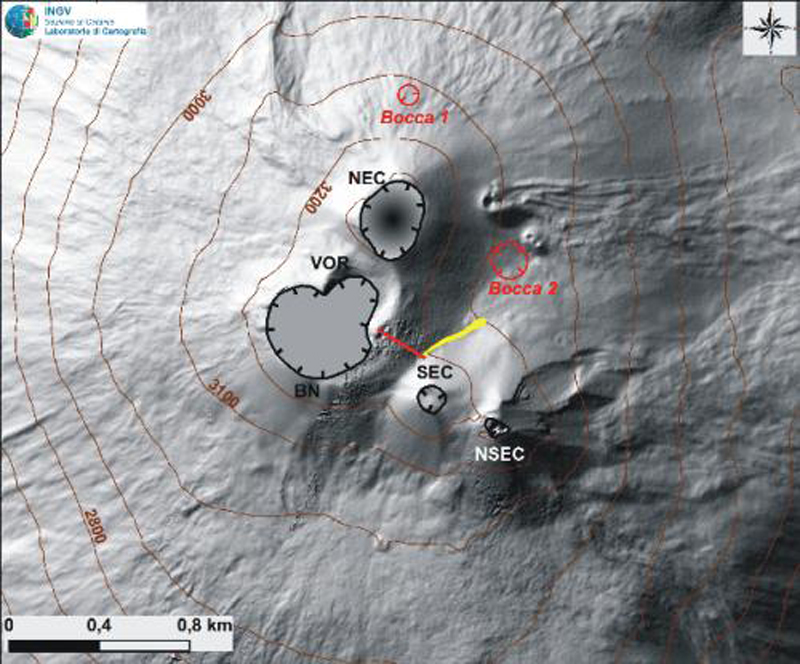 | Figure 175. The four summit craters at Etna shown in a DEM from 2014 created and modified by INGV's Aerogeophysical Laboratory. The black hatched lines outline the rims of the craters. BN = Bocca Nuova, VOR = Voragine; they are delimited by a single crater rim after the explosive activity of December 2015; NEC = North East Crater; SEC = South East Crater with cone of the New South East Crater (NSEC) on its SE flank. Activity from the 17-25 May 2016 episode is shown in red and yellow and discussed in the text. Courtesy of INGV (Bollettino settimanale sul monitoraggio vulcanico, geochimico e sismico del vulcano Etna, 16/05/2016-22/05/2016, Reporte No. 21/2016). |
Explosive activity first observed during the night of 15-16 May 2016 at NSEC came from a pit on the E flank of the cone. The following night, webcams also showed a thermal anomaly at NEC, interpreted by INGV as probable Strombolian activity. At first light on 17 May, intense degassing was observed from NEC which lasted throughout the day and included minor ash emissions. Strong explosions from NEC were heard about 10 km from the crater. Strombolian activity rising tens of meters above the rim was first observed around 2000 UTC. During the night of 17-18 May, intermittent flashes, likely from explosive activity, originated from the pit on the E flank of NSEC.
Continued explosions at NEC during the morning of 18 May produced an ash cloud that drifted ESE. This activity ceased around 1050 UTC, when Strombolian activity began at VOR that rapidly evolved into a lava fountain. The activity also created an ash plume that rose to an altitude of 7 km and drifted due E. The lava fountain continued until about 1430 UTC. Shortly after the Strombolian activity began at VOR (around 1100 UTC), lava overflowed the W rim of BN and headed W towards Monte Nunziata. It traveled for about 2 km and stopped at an elevation of around 2,100 m based on observations from the Bronte thermal webcam. Also at 1100 UTC, a small explosive vent opened at the base of the N side of NEC (Bocca 1 in red, figure 175) that spattered for a few minutes. Around 1530 UTC, an improvement in weather conditions permitted observation of a new lava flow in the Valle del Bove. The flow, fed by a vent at the base of the E side of NEC (Bocca 2 in red, figure 175), headed E towards Monte Simone, and stopped at an elevation of approximately 2,400 m.
By the morning of 19 May, although adverse weather conditions prevented observations, a sudden increase in the amplitude of tremor and loud explosions heard in communities E and S of the volcano suggested another explosive episode at VOR. A dense eruptive cloud drifted E. A new lava flow emerged from the W rim of BN, and headed W on top of the flow from the previous day. It divided into several arms, the longest of which flowed about 1,800 m, near Monte Nunziata, without reaching the nearby highway. Strombolian activity was again observed at VOR beginning around 1900 UTC on 20 May when weather conditions improved.
Beginning around 0140 UTC on 21 May 2016, a rapid escalation of the amplitude of volcanic tremor occurred together with increased explosions from VOR. Around 0200 a small lava flow was observed from a fracture at the base of the SE side of the cone of VOR near the base of SEC (the yellow flow marked on figure 175). The intense explosive activity at VOR generated a plume that drifted S. Tremor amplitude decreased suddenly around 0600. Lava was observed overflowing the W rim of BN around 0700, covering the flows of the previous days. Strombolian activity was again observed from VOR during the night of 21-22 May. Sporadic ash emissions from the pit on the E flank of NSEC during the early morning of 22 May quickly dissipated. That afternoon, renewed Strombolian activity began at NEC which intensified and then ended during the following night (figure 176).
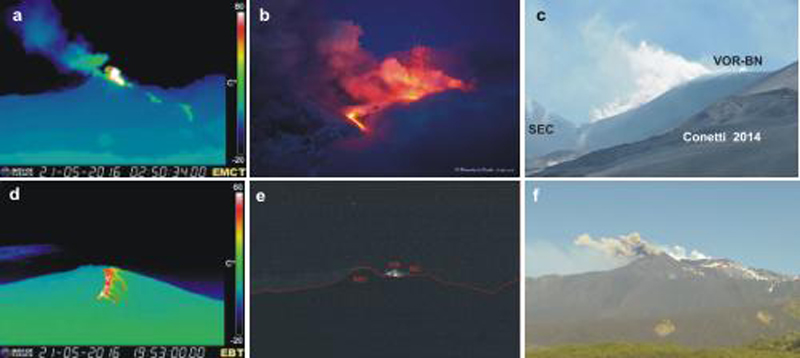 | Figure 176. Volcanic activity at Etna during 20-22 May 2016. a) intense explosive activity of 21 May at VOR, taken from the thermal webcam at Monte Cagliato; b) the lava flow from the fracture on the SE side of VOR during the explosive activity of 21 May, photo by Alessandro Lo Piccolo; c) intense degassing on 20 May from the fracture that fed the lava flow shown in (b) the following day, taken from the Piano delle Concazze; d) the overflow from the western edge of BN during 21 May, taken from Bronte's thermal webcam; e) Strombolian activity at VOR taken by the high definition camera of Monte Cagliato at 1845 UTC on 22 May; f) ash emission from the pit on the E flank of the NSEC, taken with the camera at Monte Cagliato on 22 May at 0630 UTC. Courtesy of INGV (Bollettino settimanale sul monitoraggio vulcanico, geochimico e sismico del vulcano Etna, 16/05/2016-22/05/2016, Reporte No. 21/2016). |
A new round of weak Strombolian activity began at VOR around 1900 on 23 May 2016. Activity continued until 1750 on 24 May when explosive activity increased sharply. Vigorous Strombolian activity peaked during the night of 24-25 May. Incandescent material rose a few hundred meters into the air, and mostly fell back into the crater. It was not accompanied by a lava flow or ash plume. Activity began decreasing during the afternoon of 25 May, and ceased sometime during the following night. Both ground-based and aerial observations by INGV personnel on 26 and 27 May confirmed the end of the eruptive episode and documented its effects (figure 177).
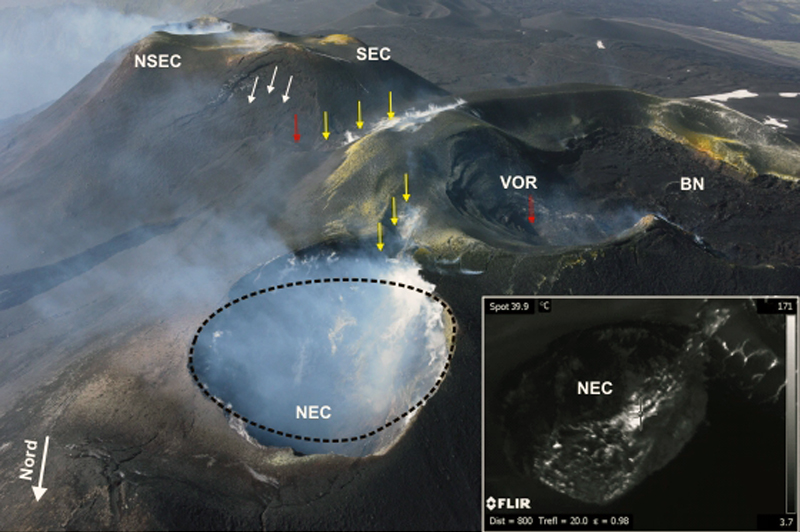 | Figure 177. The summit area of Etna seen from the north on 27 May 2016 after the eruptive episode of 15-25 May. At the North East Crater (NEC), the black dashed line shows the position of its rim prior to the eruptive phase that started on 15 May. Large areas of the crater rim collapsed on both the N and S sides. The S side of the collapsed NEC rim intersects a fracture zone that forms a graben (yellow arrows) that trends N-S and cuts across the E rim of the VOR. A second graben trends SE from the VOR. Fumarolic activity is visible in both structures. Degassing is also visible from a vent at the bottom of VOR (red arrow within VOR). The NW-SE trending graben that extends between VOR and SEC appears to terminate at the eruptive vent created on 21 May (red arrow between NSEC and SEC). However, slope failure on the N flank of the SEC cone (white arrows) suggests to INGV geologists that the structural zone continues SE towards NSEC. Inset photo is an image of NEC captured with the thermal camera by Sonia Calvari, showing the NEC crater bottom filled with the detritus from the collapse of the southern crater wall. Courtesy of INGV (Bollettino settimanale sul monitoraggio vulcanico, geochimico e sismico del vulcano Etna, 23/05/2016-29/05/2016, No. 22/2016). |
A N-S trending fracture zone about 400 m wide and 1,300 m long was observed extending S beginning at the northern side of NEC, crossing the E rim of the Central Crater (the combined VOR-BN complex), where it changes direction and extends SE toward the SEC (figure 178). A vent at the base of the saddle between SEC and VOR fed weak effusive activity on 21 May. Tens of meters of collapse within the graben contributed to the destruction of the S rim of NEC, significantly changing its shape and filling it with debris.
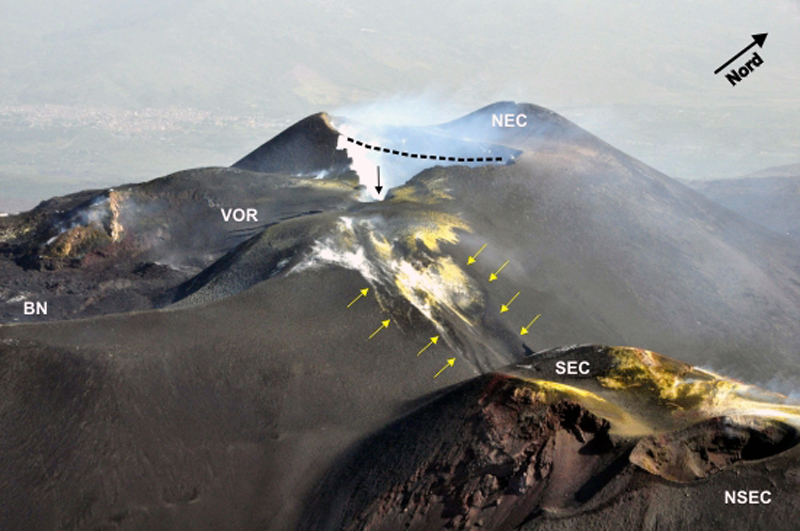 | Figure 178. The summit area of Etna seen from the SE on 27 May 2016. The yellow arrows highlight a new NW-SE trending fracture system that produced a near-symmetrical graben on the E side of the Central Crater (the combined VOR-BN complex). It then veers to the N and joins with another graben (the black arrow) that breaches the rim of the NEC. The dotted black line highlights the portion of collapsed NEC rim during the recent eruptive period. Courtesy of INGV (Bollettino settimanale sul monitoraggio vulcanico, geochimico e sismico del vulcano Etna, 23/05/2016-29/05/2016, No. 22/2016). |
Major subsidence at VOR after the end of the Strombolian activity of 23-26 May 2016 created numerous sub-circular concentric fractures within the crater with a vent degassing at the base (figure 179). The BN area was filled with the eruptive material that had overflowed the W rim (figure 180).
 | Figure 179. Detail of the Central Crater (CC), comprising the VOR and BN craters at Etna. View is from the NW on 27 May 2016. The concentric subcircular fractures with a degassing vent located at the bottom of the crater (red arrow) formed during collapse immediately after the end of the Strombolian activity at VOR from 23 to 26 May 2016. The yellow arrows (above) show the position of the graben responsible for the collapse of part of the NEC. The white arrows (bottom) highlight the western portion of the N-S oriented fracture zone, which affects NEC, VOR, and BN. Courtesy of INGV (Bollettino settimanale sul monitoraggio vulcanico, geochimico e sismico del vulcano Etna, 23/05/2016-29/05/2016, No. 22/2016). |
 | Figure 180. View of the summit of Etna from the WSW on 27 May 2016. In the foreground is the Central Crater, consisting of VOR and BN. The two white arrows point to the overflow area of the lava flows from the W edge of BN during 18-21 May. The yellow arrows highlight the main fractures bordering the E side of the crater area, extending from NEC to SEC. The dotted black line highlights the portion of collapsed NEC during the recent eruptive period. The three red arrows highlight the locations of the recent eruptive vents: north of NEC (far left), within the VOR, and at the base of the saddle between the Central Crater and the SEC. Courtesy of INGV (Bollettino settimanale sul monitoraggio vulcanico, geochimico e sismico del vulcano Etna, 23/05/2016-29/05/2016, No. 22/2016). |
Activity during June 2016-January 2017.A weak ash emission from VOR on the morning of 31 May 2016 was the only additional eruptive activity during May. INGV volcanologists making ground observations on 3 June noted about 10 m of subsidence of the lava surface filling BN and continued collapse at the center of VOR. Intense degassing of mostly water vapor occurred from the fracture on the SE side of VOR. Strong degassing continued from all the new fracture zones at the summit during June and July. Ground-based thermal imagery recorded on 16 June indicated temperatures as high as 300°C around the fractures within the Central Crater. A helicopter overflight on 14 July showed few changes in the graben system first documented at the end of May, except for continued collapse near the S rim of NEC. Minor ash emissions resumed at NSEC; they were observed during 10-14, 19-21, and 26-28 July. Explosions were heard from the W side of BN during a visit by INGV scientists on 28 July.
Intense and persistent degassing continued during August 2016 from NEC and from the fractures between NEC and VOR (figure 181). Incandescence was observed within the fractures on 4 August. NSEC produced minor ash emissions again during 4-5 August. Low intensity explosive activity began at VOR on 7 August, but no material was ejected beyond the crater rim. An incandescent vent was observed within the collapsed inner wall of VOR on 10 August (figure 182). Explosive activity and incandescence was intermittent from this vent during 7-22 August. The apparent temperature at the vent as measured by thermal camera was greater than 580°C on 22 August. Weak and episodic ash emissions also occurred from a vent on the upper E side of NSEC on 27 and 29 August. Incandescent degassing continued at the 7 August VOR vent throughout September, along with persistent fumarolic emissions from the fracture zones.
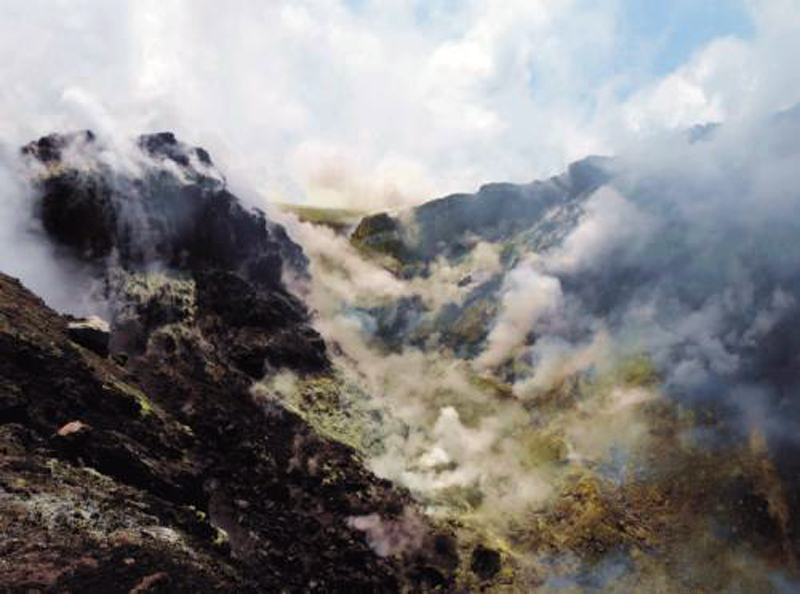 | Figure 181. Intense degassing within NEC and along the fractures between NEC and VOR at Etna on 3 August 2016. This view to the N shows the rim of NEC at the top and the new graben that breaches the rim. Photo by B. Behncke, courtesy of INGV (Bollettino settimanale sul monitoraggio vulcanico, geochimico e sismico del vulcano Etna, 01/08/2016 - 07/08/2016, No. 32/2016). |
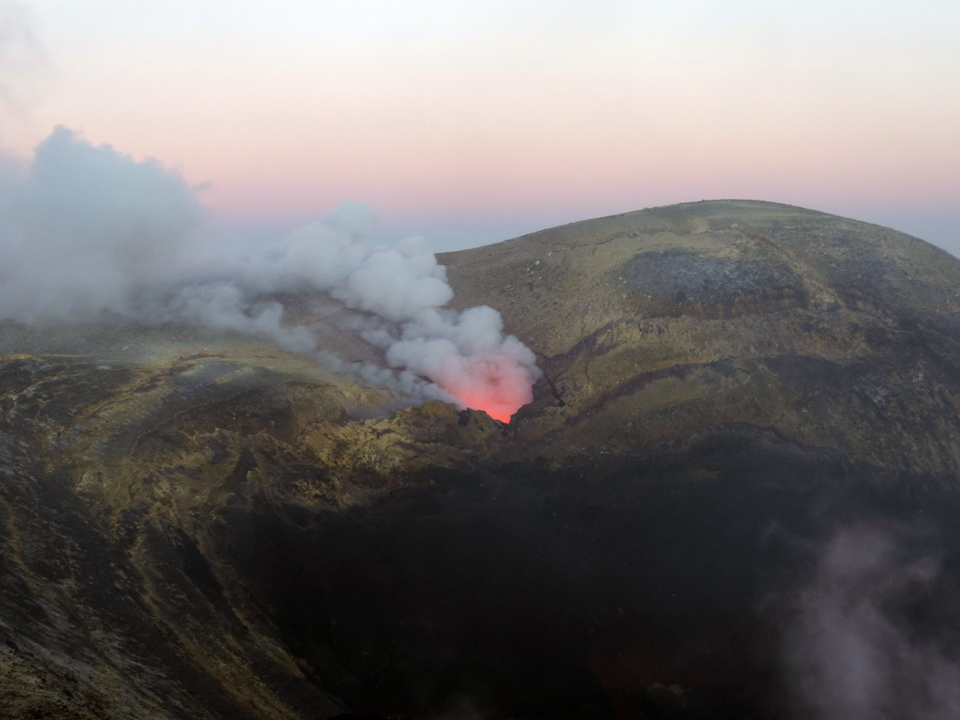 | Figure 182. A new vent opened on 7 August 2016 from the collapse of the inner wall of VOR near its NE rim at Etna. Photo by B. Behncke on 10 August 2016, courtesy of INGV (Bollettino settimanale sul monitoraggio vulcanico, geochimico e sismico del vulcano Etna, 08/08/2016-14/08/2016, No. 33/2016). |
A series of low-frequency seismic events were recorded at the summit on 10 October, some accompanied by explosive sounds. The strongest seismic event produced ash and hot gas that was recorded by two thermal cameras during the early afternoon. The ash rose from the W part of BN about 100 m above the rim and drifted rapidly E. During an inspection on 12 October, INGV scientists noted that subsidence of about 50 m had occurred within the BN, centered near the W crater wall, and was ongoing. They observed the sudden dropping of material along concentric fractures accompanied by reddish ash and modest steam emissions. One of these events exposed an incandescent area within the fresh lava (figure 183).
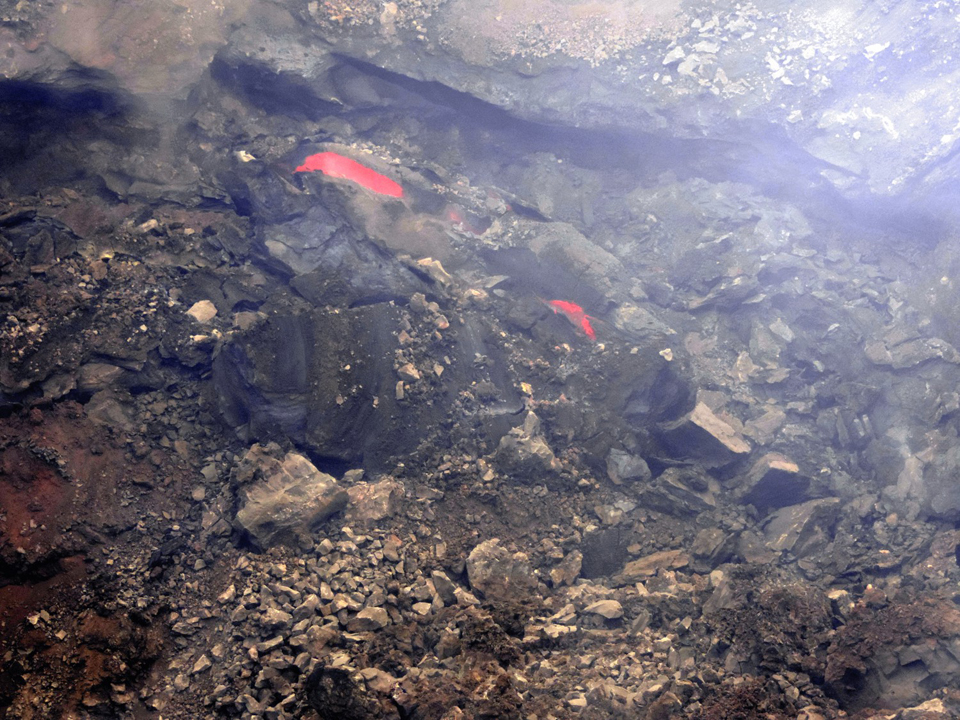 | Figure 183. The bottom of the BN crater at Etna on 12 October 2016 during a collapse within the peak subsidence zone, showing incandescent material under the fresh lava. Photo by B. Behncke, courtesy of INGV (Bollettino settimanale sul monitoraggio vulcanico, geochimico e sismico del vulcano Etna, 10/10/2016-16/10/2016, No. 42/2016). |
Dense ash emissions were produced on 17 October from the 25 November 2015 vent on the upper E flank of the NSEC (figure 184). A diffuse brown ash plume was observed the next day during a field inspection of the area. Intermittent diffuse brown ash emissions were again observed on 6 November. Persistent fumaroles from the vent at VOR and bottom subsidence at BN continued during November where two distinct areas of subsidence (BN-1 and BN-2) were visible (figure 185).
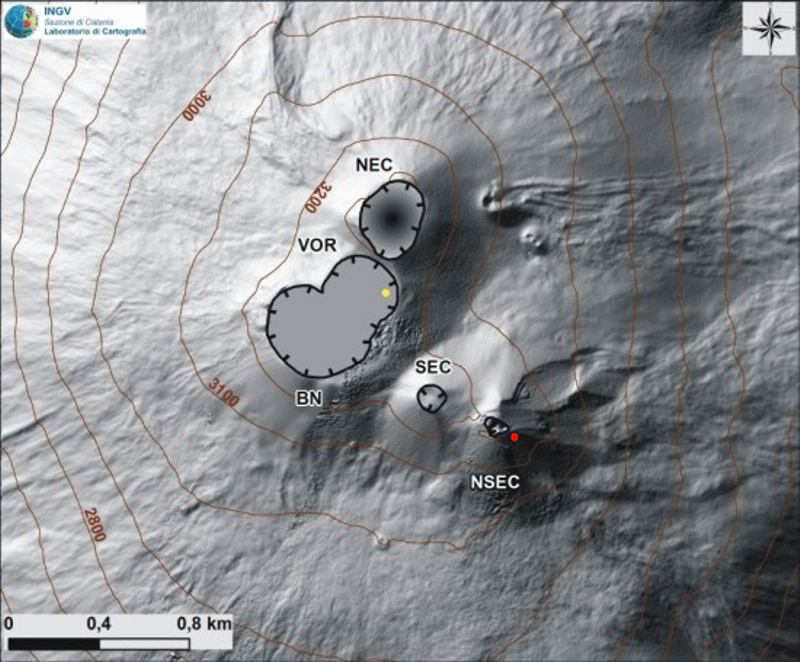 | Figure 184. A Digital Elevation Map of the summit crater area at Etna (DEM 2014, Aerogeophysics Laboratory - Section 2 modified) showing the active degassing areas during August-December 2016. The yellow dot shows the position of the vent opened on 7 August 2016 in the upper part of the E wall of the VOR; the red dot indicates the location of the vent opened in November 2015 on the upper E flank of the NSEC, from which minor ash emitted during October and November 2016. Courtesy of INGV (Bollettino settimanale sul monitoraggio vulcanico, geochimico e sismico del vulcano Etna, 31/10/2016-06/11/2016, No. 45/2016). |
 | Figure 185. An aerial view from the W of the summit crater area of Etna on 13 November 2016 annotated with areas of activity. The Central Crater (CC), highlighted by the dashed yellow line. Inside, the VOR and BN have coalesced; two depressions (BN-1 and BN-2) were undergoing constant, slow subsidence (especially BN-1) with enough heat released to prevent snow buildup. The subsidence of BN-1 and BN-2 began on 10 October 2016. Near the E edge of the VOR, gas emissions continued from the 7 August 2016 vent 'Bocca attiva dal 7 Agosto 2016'. Photo by Piero Berti, courtesy of INGV (Bollettino settimanale sul monitoraggio vulcanico, geochimico e sismico del vulcano Etna, 07/11/2016-13/11/2016, No. 46/2016). |
Intermittent, low-intensity incandescence at the VOR vent appeared during the night of 28-29 November 2016. Sporadic, minor ash emissions occurred from the saddle area between SEC and NSEC during 15 December. Incandescence that evening from the VOR vent was also recorded on the webcams. A light coating of ash and a few lithic blocks appeared the next morning in the fresh snow on the flank of the SEC. Modest ash emissions from the same area continued intermittently through the end of December. On 31 December, a diffuse ash plume was also noted from the vent on the upper E flank of NSEC. Sporadic incandescence continued from the VOR vent during early January 2017.
Information Contacts: Sezione di Catania - Osservatorio Etneo, Istituto Nazionale di Geofisica e Vulcanologia (INGV), Sezione di Catania, Piazza Roma 2, 95123 Catania, Italy (URL: http://www.ct.ingv.it/it/); MIROVA (Middle InfraRed Observation of Volcanic Activity), a collaborative project between the Universities of Turin and Florence (Italy) supported by the Centre for Volcanic Risk of the Italian Civil Protection Department (URL: http://www.mirovaweb.it/).
October 2017 (BGVN 42:10)  Cite this Report
Cite this Report
Extensive lava flows during February-May 2017; new summit crater emerges
Italy's Mount Etna on the island of Sicily has had historically recorded eruptions for the past 3,500 years. Lava flows, explosive eruptions with ash plumes, and lava fountains commonly occur from its major summit crater areas, the North East Crater (NEC), the Voragine-Bocca Nuova (or Central) complex (VOR-BN), the South East Crater (SEC) (formed in 1978), and the New South East Crater (NSEC) (formed in 2011). A new crater, the SEC3 or "saddle cone" emerged during early 2017 from the saddle between SEC and NSEC.
After a major explosive event in December 2015 (BGVN 42:05), activity subsided for a few months before renewed Strombolian eruptions and lava flows affected all of the summit craters during late May 2016 (BGVN 42:09). These events were followed by a lengthy period of subsidence and intense fumarolic activity across the summit that lasted until a new eruptive episode began at the end of January 2017. The Osservatorio Etneo (OE), which provides weekly reports and special updates on activity, is run by the Catania Branch of Italy's Istituo Nazionale di Geofisica e Vulcanologica (INGV). This report uses information from INGV to provide a detailed summary of events between January and August 2017.
Summary of January-August 2017 Activity. Minor ash emissions began from a new vent in the saddle between NSEC and SEC on 20 January 2017, followed by Strombolian activity a few days later. Activity intensified at the end of February when the first of several lava flows emerged from this vent, and then from several other vents on the S flank of the new, rapidly growing cone during March and April. By mid-March 2017, Strombolian activity, ash emissions, and lava flows had created a cone higher than the adjacent NSEC and SEC cones. The last effusive episode at the end of April 2017 sent flows down both the N and S flanks of the new cone from multiple vents. Intermittent weak Strombolian activity at the new summit area was associated with abrupt tremor amplitude increases during May, but no additional flows were reported. During June-August, fumarolic activity persisted at several crater areas, and minor ash emissions were observed a few times, but no major eruptive activity took place. The sharp increase in heat flow resulting from the lava flows of March and April 2017 are clearly visible in the MIROVA thermal anomaly plot of log radiative power for the year ending on 12 October 2017 (figure 186).
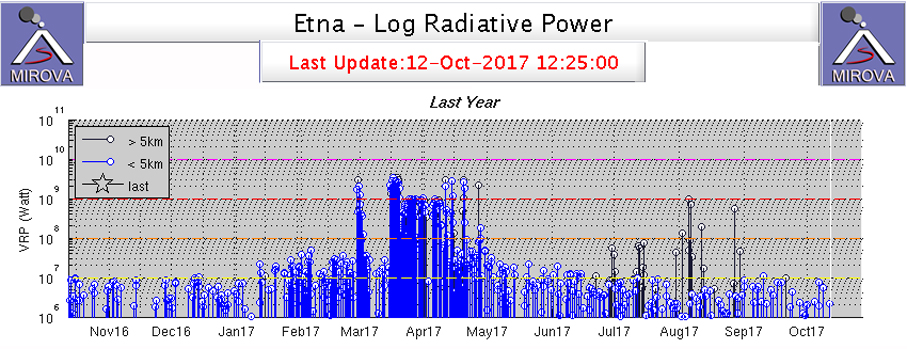 | Figure 186. Thermal anomalies at Etna (log radiative power) identified by the MIROVA system for the year ending on 12 October 2017. Major effusive eruptive events with lava flows and Strombolian activity occurred from late February through April 2017. Courtesy of MIROVA. |
Activity during January-February 2017. Sporadic incandescence continued from the 7 August 2016 vent on the E side of VOR during January 2017, and minor ash plumes rose from the NSEC "saddle" vent on 20 January. Modest Strombolian activity began at the saddle vent that on 23 January and continued into February (figure 187). Small bombs were ejected onto the flank of NSEC and minor ash plumes quickly dissipated in the high winds near the summit. Also during February, steady subsidence continued at BN, especially in the BN-1 area (see figure 185, BGVN 42:09), where active degassing with minor amounts of ash was observed on 1 February (figure 187). Debris deposits from Strombolian activity at the saddle vent covered the S side of the pyroclastic cone and travelled to its base during the end of February.
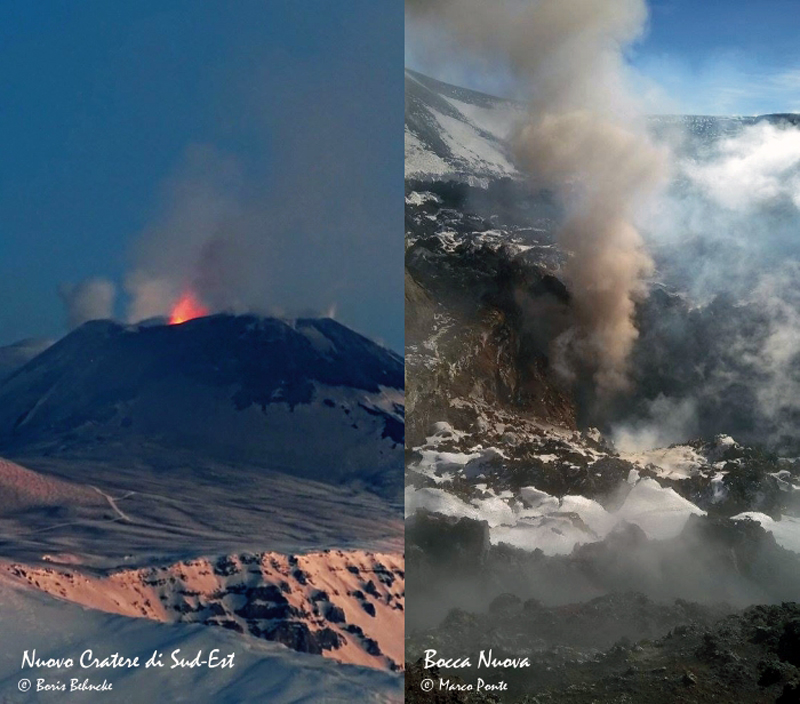 | Figure 187. Activity at Etna during the first week of February 2017. Left: Strombolian activity at the NSEC saddle vent; photo by B. Behncke. Right: degassing with minor ash emissions from the vent at the bottom of BN-1; photo by M. Ponte. Courtesy of INGV (Bollettino settimanale sul monitoraggio vulcanico, geochimico e sismico del vulcano Etna, 30/01/2017-05/02/2017, No. 6/2017). |
During the late afternoon of 27 February, the Strombolian activity that began on 20 January from the saddle vent between SEC and NSEC rapidly intensified, and lava emerged from the vent and flowed down the S flank of SEC (figure 188). It slowed after reaching the flat ground at the base of the cone, and expanded slowly SE toward the older cones of Monte Frumento Supino. Intense activity that evening sent shards and bombs 200 m above the vent while the flow continued. Ash from the Strombolian activity dispersed NE, with minor ashfall reported in Linguaglossa and Zafferana. A new cone of pyroclastic material that formed around the saddle vent quickly grew to about the same elevation as the NSEC and SEC crater rims, approximately 3,290 m (figure 189). The lava continued to flow until 2 March 2017, when it stopped at about 2,750 m elevation with an overall length of 2,180 m, covering an area of 306 x 103 m2, for a total volume of slightly less than 1 x 106 m3.
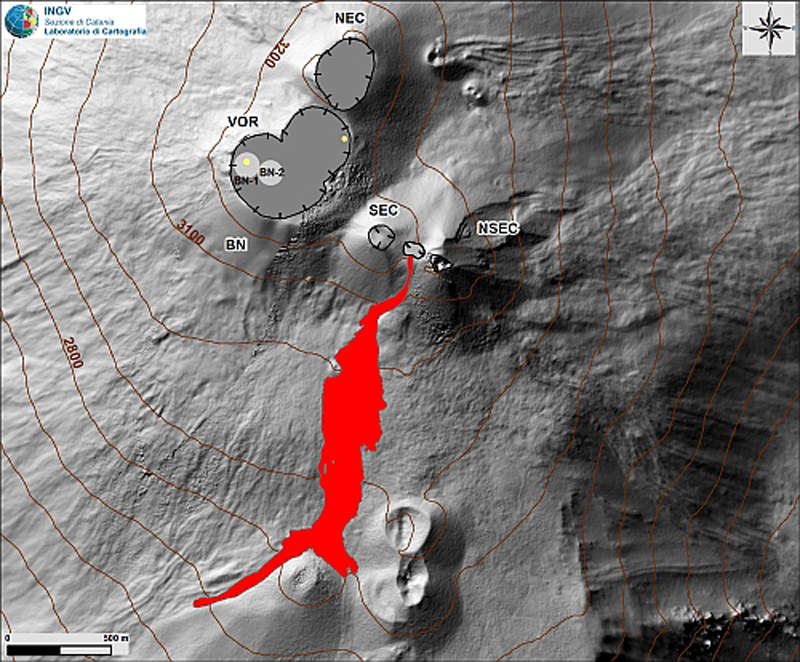 | Figure 188. An outline of the new lava flow at Etna that emerged from the saddle vent located between NSEC and SEC on 27 February 2017. It rapidly advanced down the steep S flank of SEC. Base map is a DEM image created by the INGV Cartography Laboratory. Courtesy of INGV (Bollettino settimanale sul monitoraggio vulcanico, geochimico e sismico del vulcano Etna, 27/02/2017-05/03/2017, No. 10/2017). |
 | Figure 189. Strombolian activity, the 27 February lava flow, and ash and vapor emissions from the new NSEC/SEC saddle vent at Etna on 28 February 2017 around 1730 local time. Photo by F. Ciancitto; courtesy of INGV (Bollettino settimanale sul monitoraggio vulcanico, geochimico e sismico del vulcano Etna, 27/02/2017-05/03/2017, No. 10/2017). |
Activity during March 2017. Sporadic ash emissions continued from the new saddle vent during early March 2017, accompanied by weak Strombolian activity during the night of 12-13 March. Intense degassing continued from VOR during March as well, with incandescent bursts visible on many clear nights. On the morning of 15 March the Montagnola webcam recorded a lava overflow from the saddle vent down the S flank of NSEC, and an intensification of explosive activity that caused the flow to reach the base of the complex at about 3,000 m elevation. During the day, it advanced towards Monte Frumento Supino; it had reached elevation 2,800 m by the late evening, overlapping significantly with the earlier flow from 27 February. Strombolian eruptions were nearly constant until late afternoon, and continued intermittently, along with ash emissions, for several days.
Shortly before 2300 UTC on 15 March (0100 on 16 March local time), a second new flow emerged from a vent near the base of the S flank of the new NSEC/SEC cone (at about 3,200 m elevation) and travelled SE (figure 190), splitting into two lobes. INGV personnel in the summit area reported a series of phreato-magmatic explosions at 0043 (just after midnight) along the lava front at an elevation of approximately 2,700 m along the W edge of the Valle del Bove. The contact of the active flow with the underlying snow caused several explosions. An INGV volcanologist suffered minor injuries during one of the explosions. Increased emissions also caused minor ashfall in Adrano and Santa Maria di Licodia (both about 17 km SW).
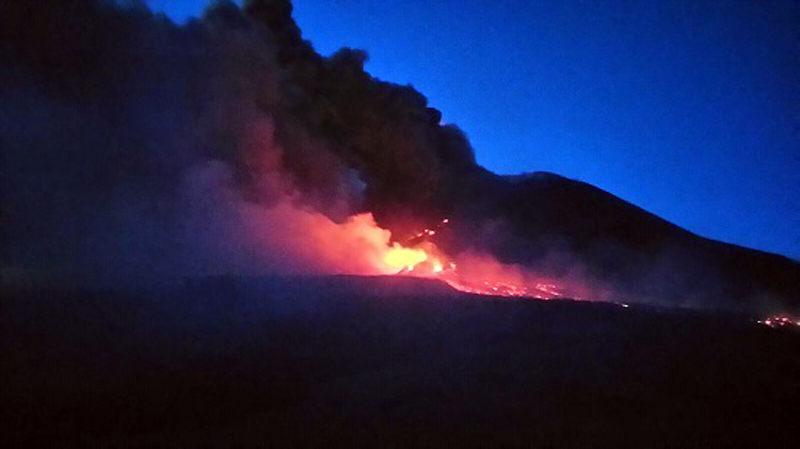 | Figure 190. Explosions at Etna from a vent at the base of the new NSEC/SEC cone complex during the early morning of 16 March 2017 viewed from the Torre del Filosofo, 1 km S. Courtesy of INGV (Bollettino settimanale sul monitoraggio vulcanico, geochimico e sismico del vulcano Etna, 13/03/2017-19/03/2017, No. 12/2017). |
By the afternoon of 17 March 2017, the second flow had reached an elevation of about 2,600 m, near the base of the W slope of the Valle del Bove. INGV personnel at Monte Zoccolaro (1.5 km S) spotted a third flow on 18 March, located S of the other two (figure 191). The front had reached about 2,200 m elevation, and was responsible for some phreato-magmatic explosions during 18 and 19 March. Several avalanches of incandescent material reached the base of the slope at the edge of Valle del Bove as the flow fronts collapsed during 18 March. Two Landsat 8 Operational Land Imager images on 18 and 19 March captured evidence of the lava flows, an ash plume, and Strombolian activity during this episode (figure 192). By 19 March, the advance had slowed as the flows began to spread out over the valley floor. The flows into the Valle del Bove ceased on 20 March.
 | Figure 191. Thermal image of the W wall of the Valle del Bove at Etna on 18 March 2017, viewed from Monte Zoccolaro showing the activity of the three lava flows. Courtesy of INGV (Bollettino settimanale sul monitoraggio vulcanico, geochimico e sismico del vulcano Etna, 13/03/2017-19/03/2017, No. 12/2017). |
 | Figure 192. The eruption from Etna's NSEC/SEC cone on 18 and 19 March 2017 as captured from space. The upper image was taken on 18 March by the Operational Land Imager (OLI) on Landsat 8 as a natural-color image, and shows an ash plume and two columns of gas and steam drifting SE. The more northerly steam and gas plume and the ash plume are rising from the summit vent of the new NSEC/SEC cone, and the more southerly steam and gas plume is rising from the effusive vent at the base of the S flank of the NSEC/SEC cone. The lower image shows the thermal glow of active lava flows on the SE flank on 19 March 2017, and the Strombolian activity at the summit of the new cone (the yellow spot directly below the Mt. Etna label) surrounded by the city lights of Catania and the surrounding communities. An astronaut aboard the International Space Station took this image. Courtesy of NASA Earth Observatory. |
Strombolian activity and ash emissions ceased at the summit vent of the NSEC/SEC cone between 20 and 22 March 2017 leaving a new pyroclastic cone that rose above the adjacent NSEC and SEC cones (figure 193). Once the Strombolian activity had ended, yet another lava flow emerged from the base of the cone at an elevation of about 3,010-3,030 m, and spread into several segments, one of which flowed W around Monti Barbagallo (near the former Torre del Filosofo) and then turned SW following the valley between Monti Barbagallo and Monte Frumento Supino. By 26 March the front of this flow segment had reached an elevation of 2,300 m and travelled about 2.5 km from the vent. A second segment of the flow travelled E of Monti Barbagallo, following the earlier flows that had been active along the W slope of the Valle del Bove; it slowed and broke into several additional segments, reaching 1.3 km from the vent on 26 March, and advancing through the first week of April.
 | Figure 193. The new pyroclastic cone 'cono di scorie' between the SEC and NSEC rises above and between both older craters at Etna shortly after 22 March 2017. It first emerged during the eruption of 27 February to 1 March 2017, and then continued to increase in size until 22 March 2017 from extensive Strombolian activity. The dotted white line separates the South East Crater (SEC) from the New South East Crater (NSEC). "Bocca effusive" is the effusive vent that fed the lava flows beginning on 22 March, and the new lava is the dark material with fumarolic emissions in the foreground. Courtesy of INGV (Bollettino settimanale sul monitoraggio vulcanico, geochimico e sismico del vulcano Etna, 20/03/2017-26/03/2017, No. 13/2017). |
Activity during April 2017. The active lava flow continued WSW towards the cones of the 2002-2003 eruption from the vent at the base of the NSEC/SEC cone until it stopped advancing sometime during the night between 8 and 9 April (figure 194). Another new flow then emerged from the same vent on 10 April and was active for just over 24 hours. This flow travelled SE to the W edge of the Valle del Bove and moved a few hundred meters along the edge before stopping during the day of 12 April.
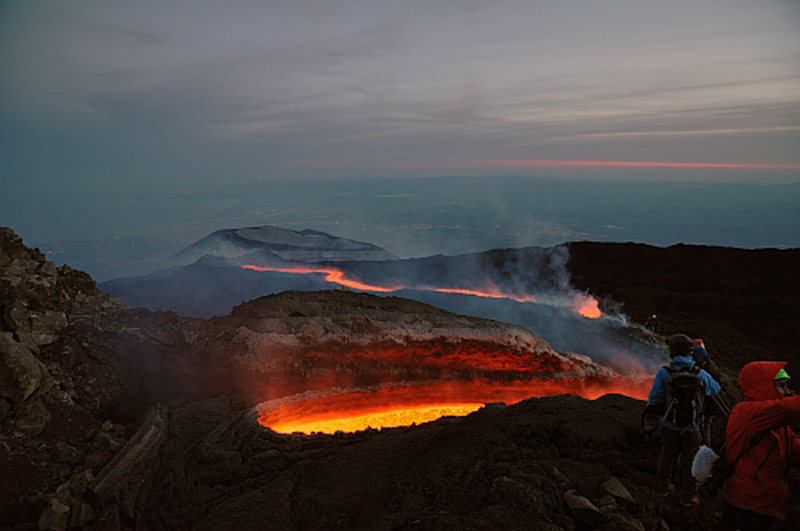 | Figure 194. The lava flow at Etna that emerged from the base of the NSEC/SEC cone complex on 22 March 2017 flows WSW towards the cones of the 2002-2003 eruption during the first week of April 2017. Courtesy of INGV (Bollettino settimanale sul monitoraggio vulcanico, geochimico e sismico del vulcano Etna, 27/03/2017-02/04/2017, No. 14/2017). |
During the evening of 13 April 2017, Strombolian activity at the summit crater of the NSEC/SEC cone accompanied the emergence of flows from three vents along the S flank at elevations of approximately 3,200 m, 3,150 m, and 3,010 m which headed S and SE. The upper flows were active for only a few hours, but the lower flow continued SE towards the Valle del Bove and had overlapped the 10-11 April flow by the next day. The active front of the flow was at an elevation of 2,400 m on the western slope of the Valle del Bove, just north of the Serra Giannicola Grande. A flyover on 14 April revealed the extent of the fracture system on the flank of the NSEC/SEC complex from which the numerous flows emerged (figure 195). The flow rate diminished during the day of 15 April, and the flow stopped sometime during the next night.
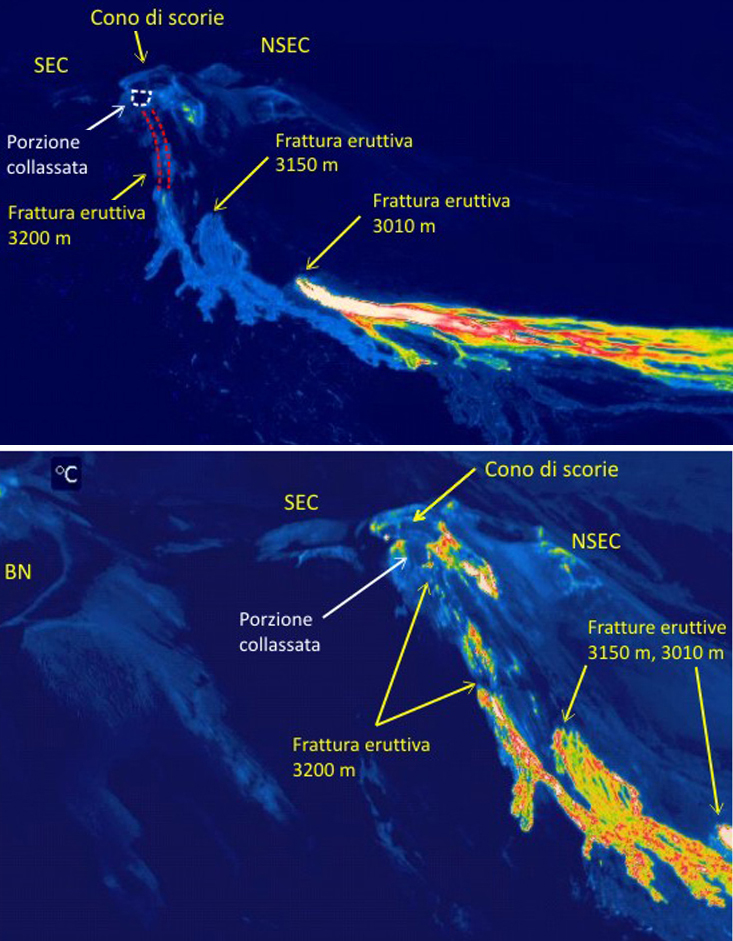 | Figure 195. Thermal images of the fracture system affecting the S flank of the NSEC/SEC cone at Etna on 14 April 2017 showing the pyroclastic cone 'Cono di scorie', a collapsed portion of the cone 'Porzione collassata', and the three eruptive vents 'Frattura eruttiva' that opened on 13 April (at 3,200 m, 3,150 m and 3,010 m elevation). Courtesy of INGV (Bollettino settimanale sul monitoraggio vulcanico, geochimico e sismico del vulcano Etna, 10/04/2017-16/04/2017, No 16/2017). |
A thermal anomaly appeared at the S edge of the NSEC/SEC summit vent, which INGV began calling SEC3, on the morning of 19 April. Weak Strombolian activity from the vent was followed by the emergence of a lava flow from the S side of the crater rim that flowed down the S flank of the cone. Dense, brown ash emissions about an hour later accompanied the re-opening of three vents on the S flank from which new lava flows emerged (figure 196). Lava jets rose tens of meters above the crater rim for about an hour in the afternoon. The lava flows from the three vents formed into two branches moving down the S flank (figure 197), then turned E and spread over the W slope of the Valle del Bove; by 20 April they had reached an elevation of 1,950 m. Explosive activity ceased at SEC3 that afternoon, and the flows stopped advancing sometime during the night of 20-21 April. Observations of the summit of SEC3 on 22 April revealed a N-S trending graben formed in the S rim of the summit crater about 100 m long, 10 m wide, and several tens of meters deep.
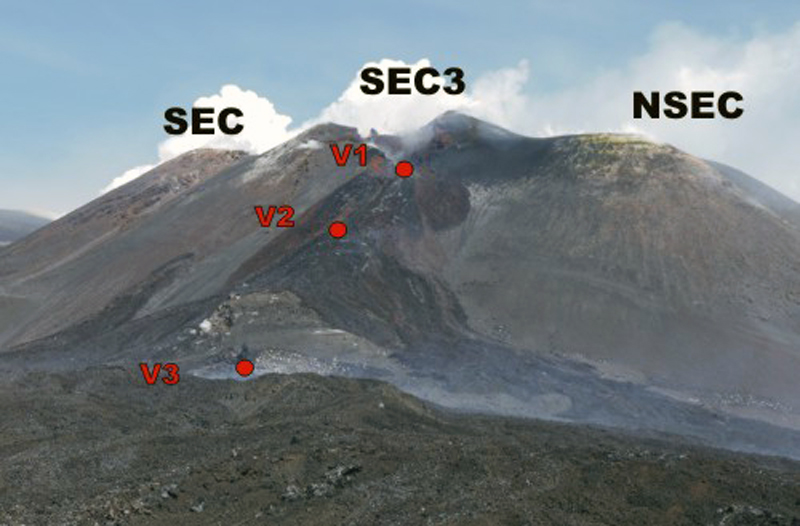 | Figure 196. The new SEC3 cone at Etna lies in the former saddle between SEC and NSEC. The red circles indicate the positions of the three eruptive vents (V1, V2, and V3) that opened on 19 April 2017 on the S flank of the cone. Lava from the vents is flowing E toward the Valle del Bove in this N-looking photo taken by Mauro Coltelli on 20 April 2017. Courtesy of INGV (Bollettino settimanale sul monitoraggio vulcanico, geochimico e sismico del vulcano Etna, 17/04/2017-23/04/2017, No. 17/2017). |
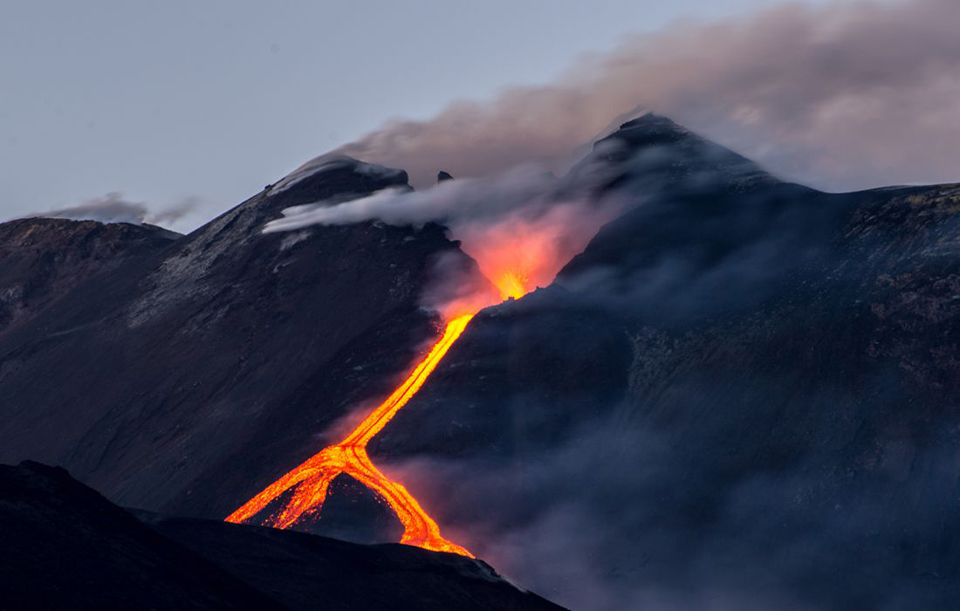 | Figure 197. Lava flows from the summit crater of the new cone (SEC3) at Etna on 20 April 2017. Photo by Salvatore Allegra/Anadolu Agency/Getty Images/CFP, published in Globaltimes, 20 April 2017. |
The next eruptive episode began late in the day on 26 April 2017, with a slow-moving lava flow that emerged from the summit vent of SEC3. The flow made it part way down the S flank before another flow from the same vent covered it and reached the base of the flank. Strombolian activity began at the summit vent during the late evening while the flow continued to spread SE toward the Valle del Bove (figure 198). Strombolian activity intensified during the early hours of 27 April and a new vent opened at the summit immediately N of the first one. At around 0220, two new eruptive fractures opened on the N flank of SEC3, from which lava flowed N toward the Valle del Leone (figure 199). At daybreak, an ash plume was visible about 1.5 km above the summit drifting E. Phreato-magmatic explosions were observed in the Valle del Leone when the northern lava flow encountered snow on the ground. Strombolian activity ceased around noon and the flows on both the N and S flanks had ceased by the following morning.
 | Figure 198. Lava flows down the S flank of SEC3 at Etna during the early morning of 27 April 2017, heading SE towards the Valle del Bove. Strombolian activity occurred from both of the summit vents, and an ash plume rose from the summit. Photo taken from the roof of the INGV-Osservatorio Etneo located 27 km S of the volcano. Courtesy of INGV (Attivita' dell'Etna, 20 Aprile-14 Giugno 2017). |
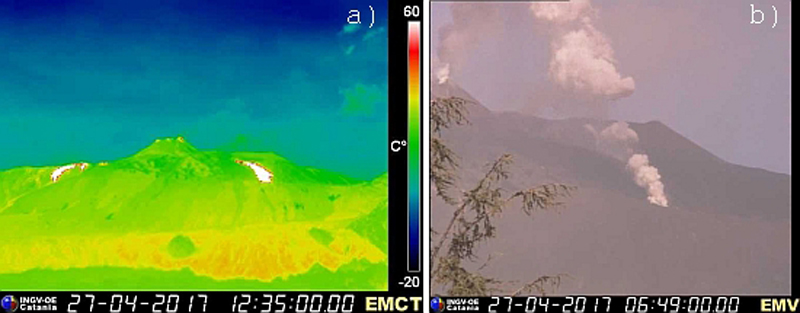 | Figure 199. Lava flows from both the N and S flanks of SEC3 at Etna on 27 April 2017. a) the two lava flows are clearly visible from the Monte Cagliato thermal camera (EMCT) in this view looking W. b) a phreato-magmatic explosion in the Valle del Leone from the lava flow encountering snow on the N side of SEC3. Courtesy of INGV (Bollettino settimanale sul monitoraggio vulcanico, geochimico e sismico del vulcano Etna, 24/04/2017 - 30/04/2017, No. 18/2017). |
Activity during May-August 2017. Intense degassing with incandescence at night continued from the vent at VOR throughout April and into May 2017. At NEC, degassing continued from the large fumarole field at the bottom of the summit crater. No further lava flows erupted during May 2017, however, there were several short, high-energy tremor episodes in the area around SEC3. During May, more than 35 episodes of transient increases in tremor amplitude were recorded by INGV seismic instruments (figure 200). During 15-18 May, there were 11 episodes of Strombolian activity from the northern SEC3 summit vent, repeated at regular intervals of about every 8-9 hours. Lava fragments were ejected outside the crater rim and rolled down the flanks (figure 201). Each episode was accompanied by a sharp increase in volcanic tremor amplitude. Eight additional episodes of weak and discontinuous Strombolian activity occurred between 25 and 28 May at intervals ranging from 3 to 14 hours, each lasting about an hour, and accompanied by increased tremor amplitude. A short sequence of dense ash emissions from BN-1 on the morning of 31 May was the only ash plume reported during May.
 | Figure 200. During the month of May 2017, more than 35 episodes of transient increases in the amplitude of tremor were recorded by the seismic instruments at Etna. Some, but not all, of these episodes were accompanied by Strombolian activity at the N vent at the SEC3 summit. Courtesy of INGV (Attivita' dell'Etna, 20 Aprile-14 Giugno 2017). |
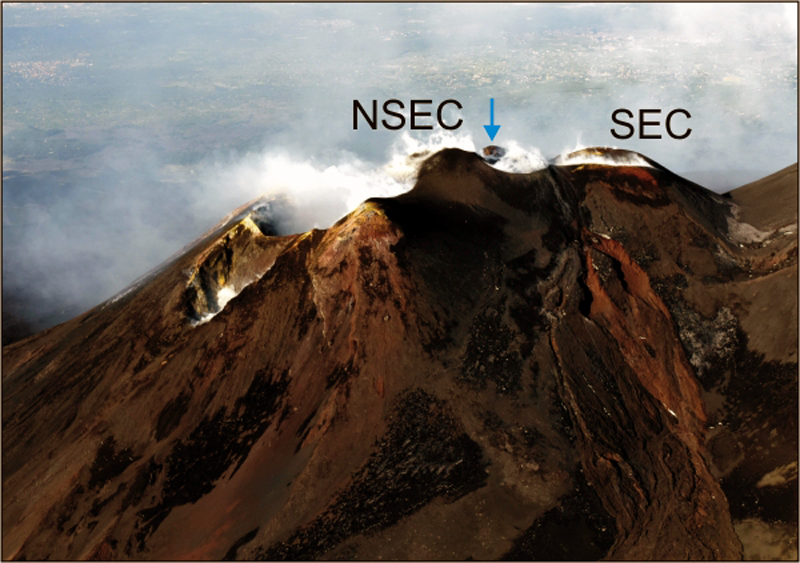 | Figure 201. The summit of the new NSEC/SEC complex at Etna on 16 May 2017 as viewed from the NW. The blue arrow indicates the eruptive vent that produced discontinuous Strombolian activity during May. Photo by M. Cantarero; courtesy of INGV (Bollettino settimanale sul monitoraggio vulcanico, geochimico e sismico del vulcano Etna, 15/05/2017-21/05/2017, No. 21/2017). |
Weak and discontinuous Strombolian activity resumed at NSEC on 6 June 2017, along with a sudden increase in tremor. The activity lasted until 9 June and included four episodes of roughly one hour each. Very little material fell outside the crater rim during these events. Vigorous degassing and nighttime incandescence continued at the VOR vent during June. INGV-OE personnel inspected the summit on 23 and 29 June, and 2 July 2017. High temperatures (around 600°C) were recorded at the VOR vent on 23 June. The other fumarolic areas, especially in the fracture field between NEC and VOR, were around 250°C, cooler than when last measured on 31 August 2016. Occasional weak ash emissions began on 24 June from SEC3; they lasted for a few days and quickly dissipated near the top of the cone. They ceased late in the evening of 28 June.
In a survey by drone on 4 July 2017, INGV-OE personnel noted widespread degassing along the rim and E side of the SEC3 crater. The vent that had formed during 27 February-26 April appeared to be blocked (figure 202). During the late morning of 9 July, the vent that had formed during 26-27 April emitted a small amount of red-gray ash. The next day a small amount of ash emerged from the base of BN-1. Incandescence was frequently observed at night from the VOR vent and from the NSEC. Degassing was observed regularly throughout the month at the VOR vent, the bottom of BN-1, and NEC (figure 203).
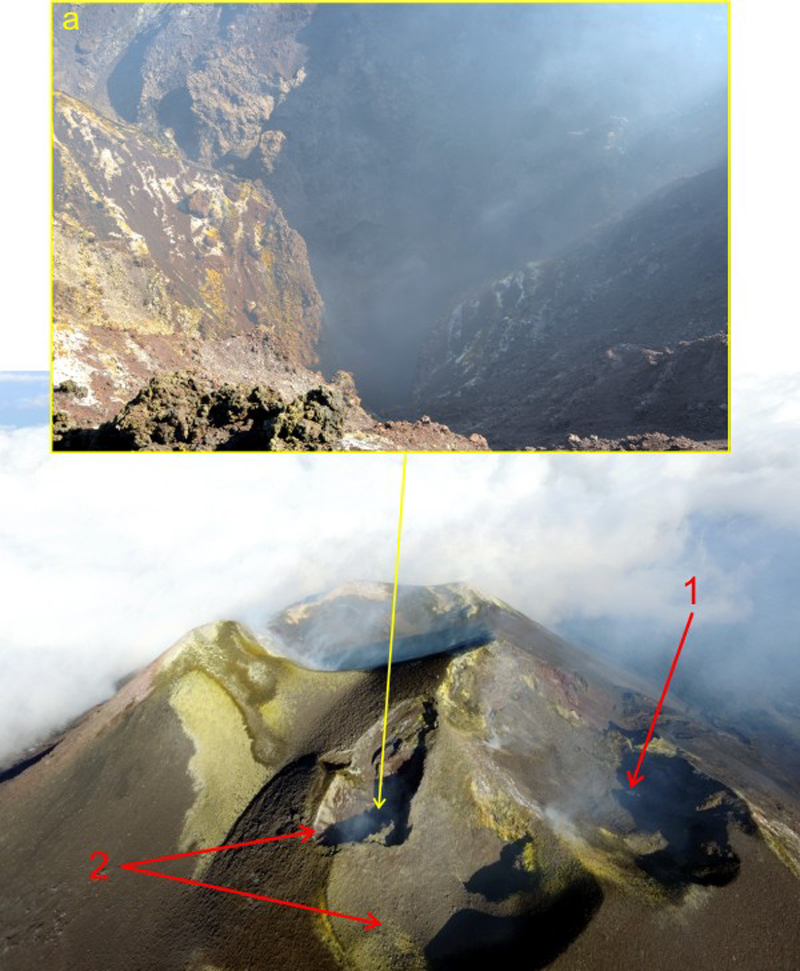 | Figure 202. Detailed view of the summit of the new SEC3 cone at Etna on 4 July 2017 taken by an INGV-OE drone. 1) eruptive vent active during 27 February-26 April; 2) eruptive vents active during 26-27 April; a) closeup of the bottom of one of the 26-27 April vents, from which a small amount of reddish-gray ash emerged on 9 July. Courtesy of INGV (Bollettino settimanale sul monitoraggio vulcanico, geochimico e sismico del vulcano Etna, 3/07/2017-9/07/2017, No. 28/2017). |
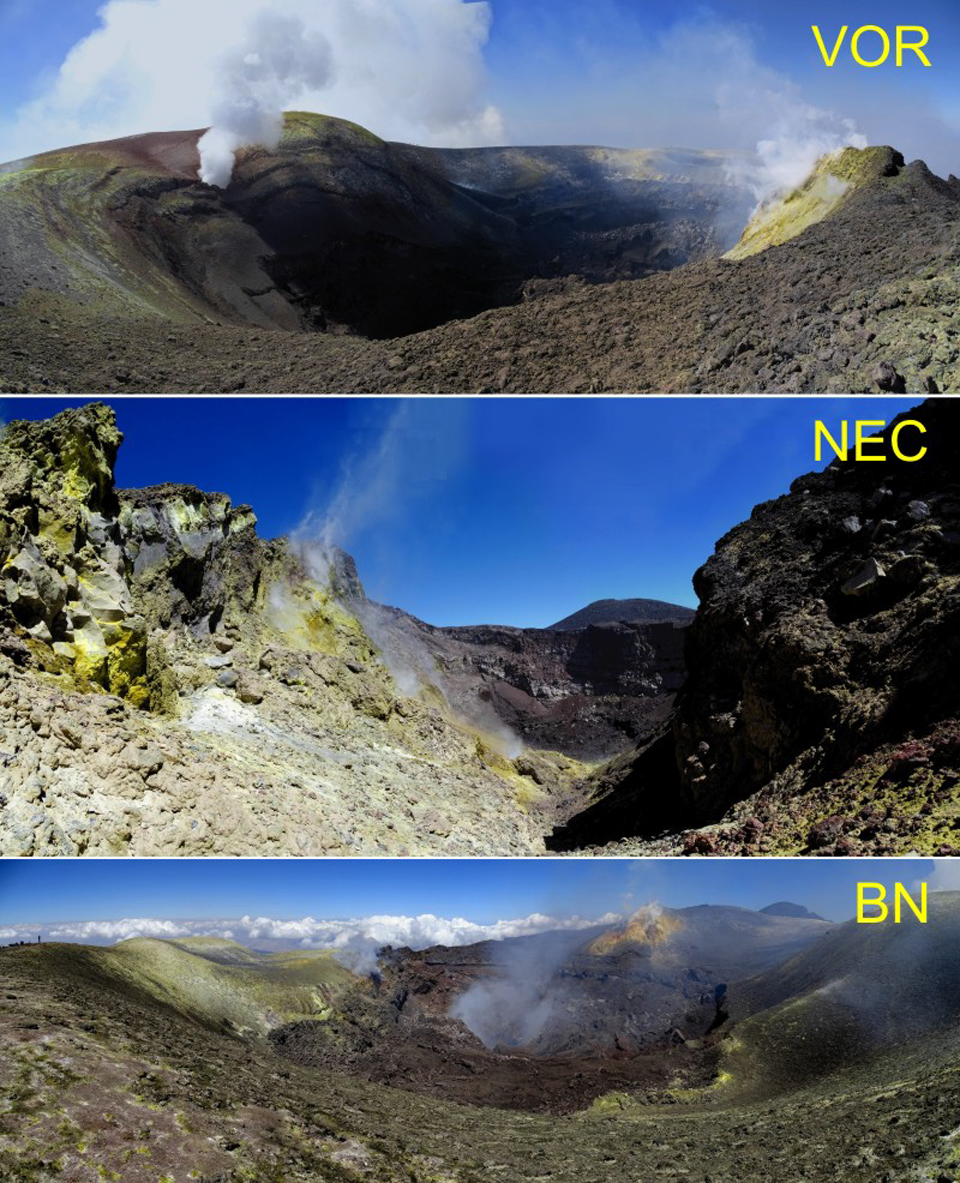 | Figure 203. Panoramic photos of the summit craters of Etna on 27 July 2017. VOR, seen from the northwestern edge, continued with strong degassing from the 7 August 2016 vent on the E rim; the NEC, seen from the fracture that cuts the southern rim, had modest, diffuse degassing from the fracture zone within the crater; and BN, seen from the eastern edge, had moderate degassing occurring from the vent at the base of BN-1 throughout the month. Courtesy of INGV-OE (Bollettino settimanale sul monitoraggio vulcanico, geochimico e sismico del vulcano Etna, 24/07/2017-30/07/2017, No. 31/2017). |
Occasional weak, diffuse ash emissions continued during August 2017 from the bottom of BN-1. INGV-OE scientists attributed this to collapse at the base of the crater. Limited degassing was noted at NEC, but persistent degassing continued from the 7 August 2016 vent at VOR, and from a vent on the E side of NSEC in addition to a vent at the SEC3 summit (figures 204 and 205).
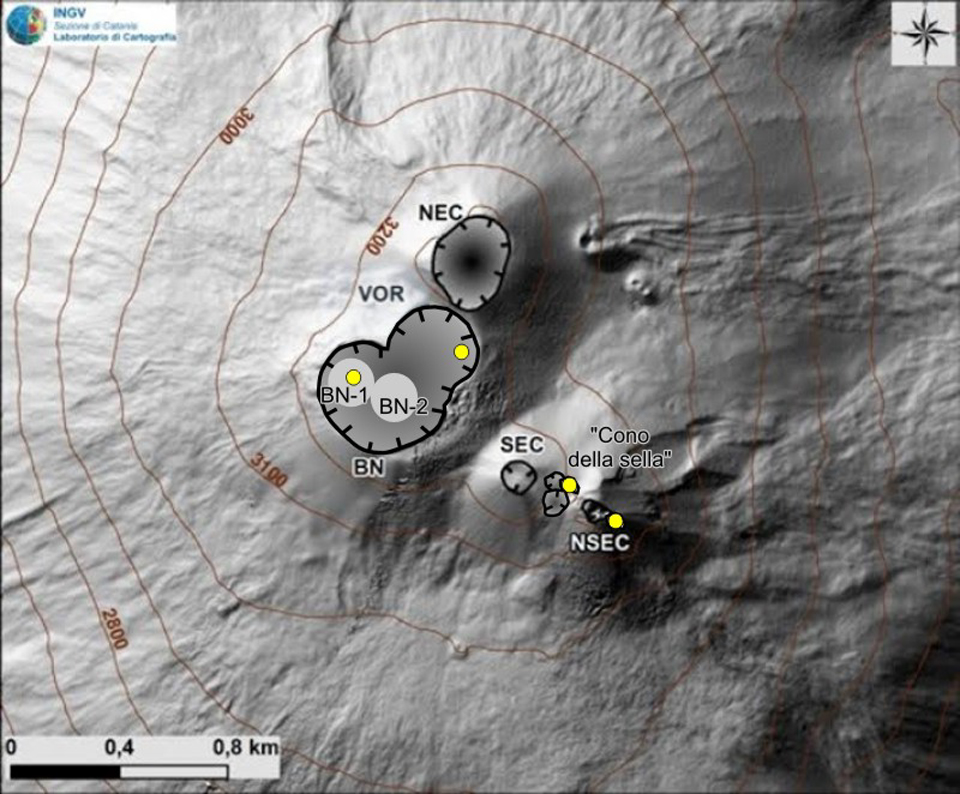 | Figure 204. Areas of persistent degassing and fumarolic activity at Etna during August 2017. The black hatch lines outline the crater rims: BN = Bocca Nuova, which contains the NW vent (BN-1) and the SE vent (BN-2); VOR = Voragine; NEC = North East Crater; SEC = South East Crater; NSEC = New South East Crater. Yellow circles indicate the locations of the degassing mouths of VOR, BN, and both the "Cono della sella" (saddle cone, or SEC3) and the E vent at NSEC. The base map is from a 2014 DEM of the summit from INGV Aerogeophysics Laboratory - Section 2. Courtesy of INGV (Bollettino settimanale sul monitoraggio vulcanico, geochimico e sismico del vulcano Etna, 31/07/2017-06/08/2017, No. 32/2017). |
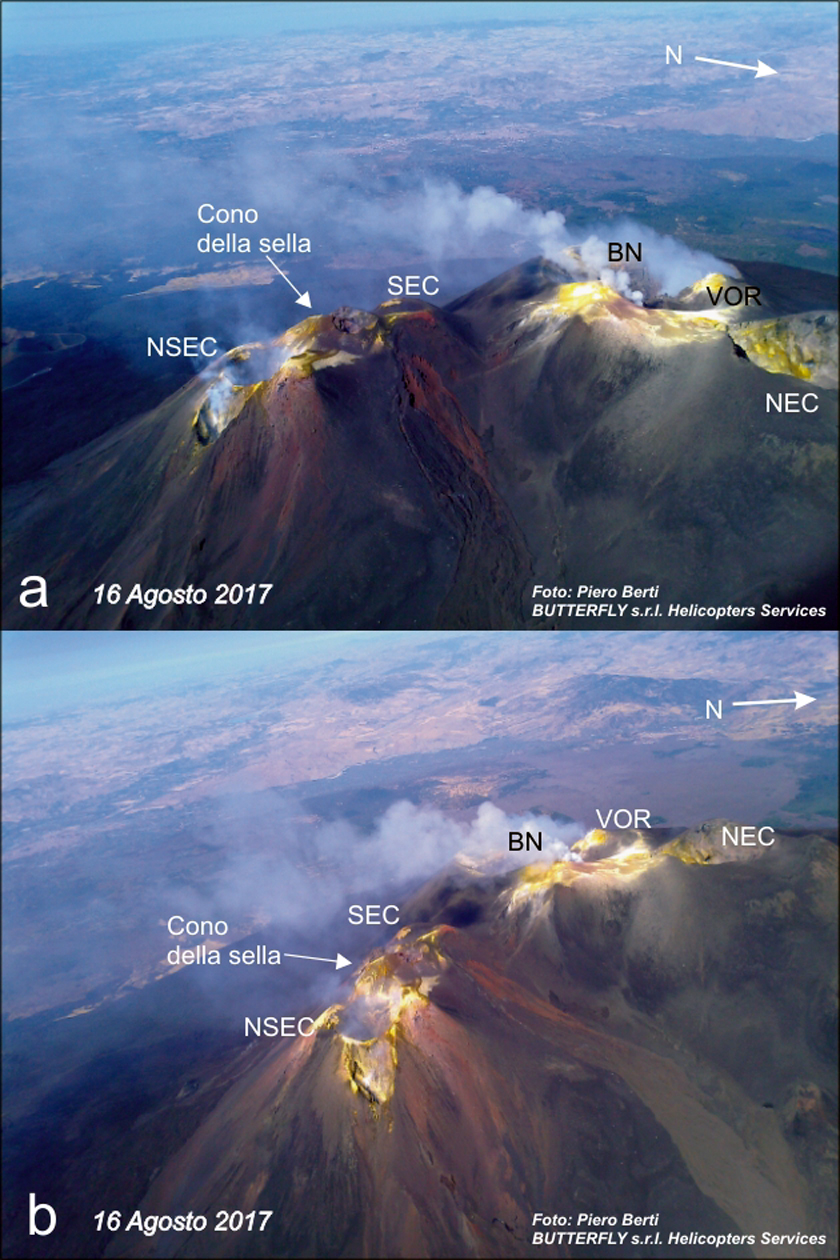 | Figure 205. Aerial photographs of the summit crater area of Etna taken on 16 August 2017. a) view from ENE; b) view from the SE. Weak fumarolic activity is visible from the E vent of the New South East Crater (NSEC). More intense and continuous degassing emerges from the Central Crater (VOR and BN). See figure 204 for additional label explanations. Photos by Piero Berti; courtesy of Butterfly Helicopter Services and INGV-OE (Bollettino settimanale sul monitoraggio vulcanico, geochimico e sismico del vulcano Etna, 14/08/2017-20/08/2017, No. 34/2017). |
Information Contacts: Sezione di Catania - Osservatorio Etneo, Istituto Nazionale di Geofisica e Vulcanologia (INGV-OE), Sezione di Catania, Piazza Roma 2, 95123 Catania, Italy (URL: http://www.ct.ingv.it/it/); NASA Earth Observatory, EOS Project Science Office, NASA Goddard Space Flight Center, Goddard, Maryland, USA (URL: http://earthobservatory.nasa.gov/); MIROVA (Middle InfraRed Observation of Volcanic Activity), a collaborative project between the Universities of Turin and Florence (Italy) supported by the Centre for Volcanic Risk of the Italian Civil Protection Department (URL: http://www.mirovaweb.it/); Global Times, http://www.globaltimes.cn/galleries/774.html.
April 2018 (BGVN 43:04)  Cite this Report
Cite this Report
Persistent degassing from multiple vents; minor ash emissions and pyroclastic ejecta, September 2017-March 2018
Italy's Mount Etna on the island of Sicily has had historically recorded eruptions for the past 3,500 years and has been erupting continuously since September 2013 through at least March 2018. Lava flows, explosive eruptions with ash plumes, and lava fountains commonly occur from its major summit crater areas that include the North East Crater (NEC), the Voragine-Bocca Nuova (or Central) complex (VOR-BN), the South East Crater (SEC) (formed in 1978), and the New South East Crater (NSEC) (formed in 2011). A new crater, referred to as the "Cono della sella" or CdS, emerged during early 2017 in the saddle between SEC and NSEC (figure 206).
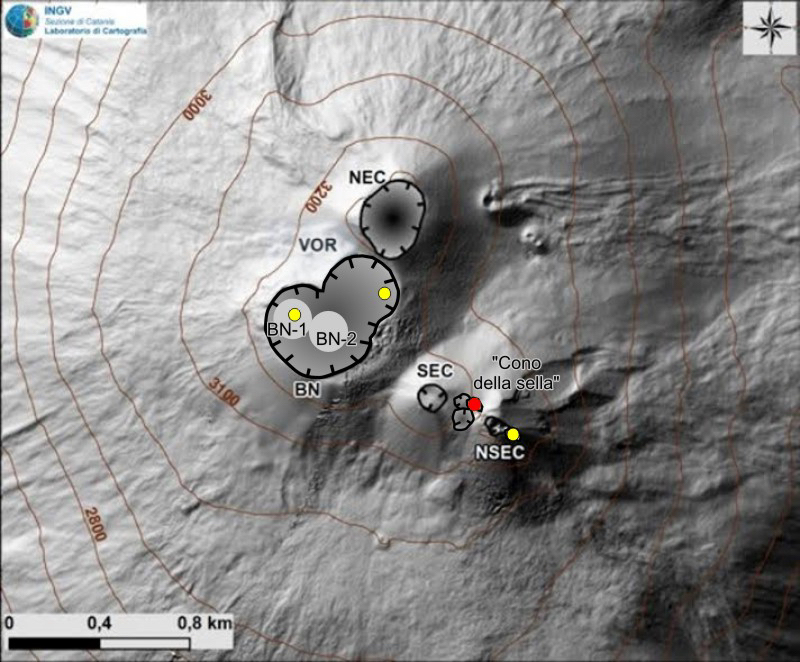 | Figure 206. A modified digital elevation model (DEM) of the summit area at Etna showing the major craters. The hatched black lines highlight the rims of the summit craters: BN = Bocca Nuova, which contains the NW depression (BN-1) and the SE depression (BN-2); VOR = Voragine with an active vent on its E rim that opened in August 2016; NEC = Northeast Crater; SEC = South-East Crater; NSEC = New Southeast Crater; and "Cono della Sella" or CdS, which emerged in early 2017, shown in red. The yellow dots indicate the locations of significant degassing vents at VOR, BN, and NSEC. Courtesy of INGV (Report 51/2017, Bollettino settimanale sul monitoraggio vulcanico, geochimico e sismico del vulcano Etna, 11/12/2017-17/12/2017, issue date-19/12/2017). |
The most recent eruptive episode began with ash emissions from a new vent in the saddle between NSEC and SEC on 20 January 2017, followed by Strombolian activity a few days later (BGVN 42:10). Activity intensified at the end of February when the first of several lava flows emerged from this and other adjacent vents. By mid-March 2017, Strombolian activity, ash emissions, and lava flows had created a cone higher than the adjacent NSEC and SEC cones, referred to as the "Cono della Sella" (CdS) or saddle cone. An effusive episode at the end of April 2017 sent flows down both the N and S flanks of the new cone from multiple vents. Intermittent Strombolian activity and persistent fumarolic activity continued from multiple crater areas, and minor ash emissions were observed a few times through August 2017. The Osservatorio Etneo (OE), which provides weekly reports and special updates on activity, is run by the Catania Branch of Italy's Istituo Nazionale di Geofisica e Vulcanologica (INGV). This report uses information from INGV to summarize events between September 2017 and March 2018.
Although still exhibiting intermittent volcanism, activity at Etna was at low levels during September 2017-March 2018. A comparison of the thermal activity of that period with the previous interval of November 2016-August 2017 (figure 186, BGVN 42:10) demonstrates the order of magnitude decrease from the earlier period (figure 207). Persistent degassing occurred throughout this interval, often with incandescent gas and periodic ash emissions resulting from continued subsidence around crater vents and from small explosive events. Ashfall was reported once in the cities S of Etna in mid-January 2018, and a minor episode of Strombolian activity and ash emissions took place at the eastern vent of NSEC in mid-February 2018.
 | Figure 207. Thermal activity at Etna was substantially decreased compared to earlier in 2017 (figure 186, BGVN 42:10) as seen in this MIROVA graph that plots data for the year ending on 12 July 2018. Courtesy of MIROVA. |
Activity during September-December 2017. Active degassing at the beginning of September 2017 occurred from the vent at the E rim of the Voragine crater (VOR), and from the NW vent of Bocca Nuova (BN-1) (figure 208). At the Northeast Crater (NEC) and the SE Crater (SEC)-New South East Crater (NSEC) complex, which included the new "Cono del Sella" (CdS), there was widespread degassing from the fumarolic fields located in the bottoms and walls of the craters. Minor explosive activity was reported on 19 September 2017 from BN and NSEC, and nighttime incandescence was reported from the other craters. On 20 September small sporadic ash emissions were noted from NSEC and VOR. Incandescence at night was observed at the SEC-NSEC complex for the remainder of the month, and strong degassing continued at the VOR vent.
 | Figure 208. Active degassing was evident at the summit craters of Etna on 24 August 2017. a) degassing from Bocca Nuova (BN). b) the active vent on the E rim of Voragine (VOR) was mostly steam. Courtesy of INGV (Report 35/2017, Bollettino settimanale sul monitoraggio vulcanico, geochimico e sismico del vulcano Etna, 21/08/2017-27/08/2017, issue date 29/08/2017). |
Occasional ash emissions were observed during the second week of October 2017 from the Cono della Sella (CdS) (figure 209). A minor ash emission was also reported on 16 October from the SEC-NSEC complex. Minor emissions of brown ash were reported from BN-1 during the last week of October. In the late afternoon of 26 October, a single explosion occurred at one of the three mouths of the Cono della Sella crater. The explosion generated a short jet of incandescent material and a small ash plume that quickly dispersed.
 | Figure 209. An ash emission occurred on 13 October 2017 from the Cono della Sella (CdS) at Etna. These images were taken from the M. Cagliato (left) and La Montagnola (right) webcams. Intense degassing from VOR was also visible in the La Montagnola image. Courtesy of INGV (Report 42/2017, Bollettino settimanale sul monitoraggio vulcanico, geochimico e sismico del vulcano Etna, 09/10/2017-15/10/2017, issue date 17/10/2017). |
Cloudy weather during November resulted in limited visibility for much of the month. A small, isolated explosion containing minor ash occurred at SEC on 14 November 2017. During the third week of November, a new pit crater appeared at the bottom of NEC that measured 70 x 50 m (figure 210), and intense degassing was observed from BN-1. Frequent small ash emissions were reported from CdS during 24-26 November. In the last week of the month, pulsating degassing from the craters could be detected during periods of limited visibility, as well as a series of explosions with ash emissions from SEC.
 | Figure 210. A new pit crater opened at the bottom of NEC at Etna during the third week of November 2017. A) Map of the summit crater area (DEM 2014) showing the pit crater location at the bottom of the NEC and one of the main fumaroles at the bottom (orange arrow). B) View of the bottom of NEC from the S on 23 November 2017, the orange arrow is the fumarole and the white hatched line indicates the rim of the new pit crater. C) The S flank of the NEC, showing the locations of the thermal cameras that created the images of the new pit in images D and E. Courtesy of INGV, (Report 48/2017, Bollettino settimanale sul monitoraggio vulcanico, geochimico e sismico del vulcano Etna, 20/11/2017-26/11/2017, issue date 28/11/2017). |
Degassing from the summit craters persisted throughout December 2017 with intermittent incandescence observed from fumaroles at NSEC. A few ash emissions were recorded from CdS, including overnight on 14-15 December (figure 211).
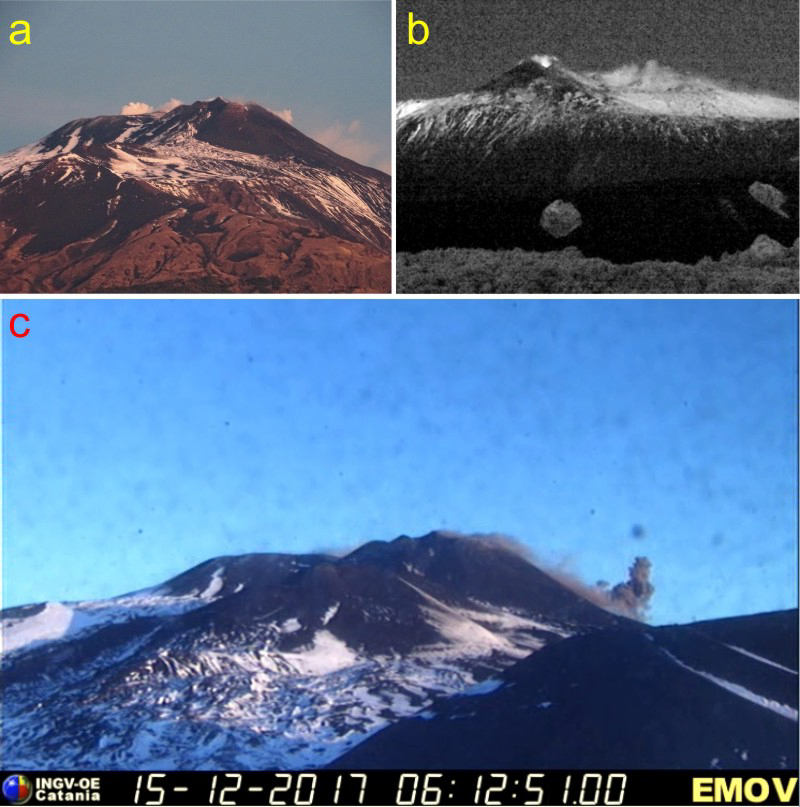 | Figure 211. Minor degassing, fumaroles, and incandescence were recorded at the summit craters of Etna in early December 2017. a) Degassing from BN and VOR on the morning of 13 December 2017, seen from the S. b) Image taken from the high-resolution webcam at Monte Cagliato (EMCH, E side of Etna) showing incandescence at the E vent of NSEC in the early hours of 12 December 2017. c) Puff of ash emitted by CdS on the morning of 15 December 2017, recorded by the Montagnola (EMOV) webcam. Courtesy of INGV (Report 51/2017, Bollettino settimanale sul monitoraggio vulcanico, geochimico e sismico del vulcano Etna, 11/12/2017-17/12/2017, issue date 19/12/2017). |
Activity during January-March 2018. Similar activity continued throughout January 2018; a small ash emission was observed from CdS on 5 January, and a puff of brown ash emerged from NSEC the next day. Incandescence degassing also continued from the NSEC vents. During the second week of the month, 20 small explosive events were observed from the eastern vent at NSEC, although cloud cover obscured the summit for much of the time. Minor ash emissions continued from NSEC for the rest of the month, along with nighttime incandescence, especially strong from BN-1. On 22 January a modest ashfall affected the communities S of Etna including the city of Catania (27 km S); the lack of visibility prevented identification of which crater produced the ash. By the end of the month, the pit crater at the base of NEC had expanded, causing erosion of the inner E wall (figure 212). In spite of the low level of activity during this period, SO2 emissions were occasionally recorded with satellite instruments. The most significant SO2 plumes were measured during the last few days of January (figure 213).
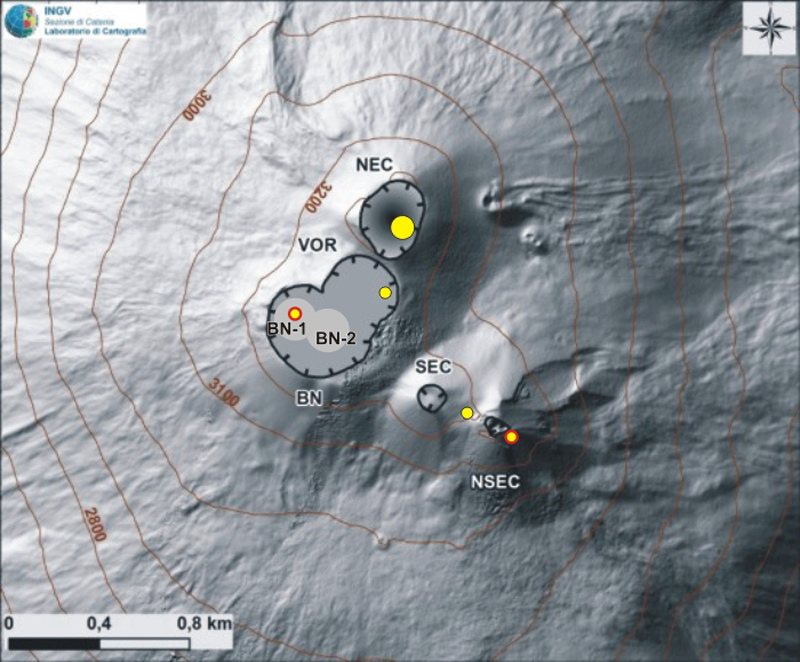 | Figure 212. Activity during January 2018 at Etna included strong incandescence from BN-1, numerous small explosive events from NSEC, and expansion of the pit crater at the base of NEC. The hatched black lines highlight the edge of the summit craters: BN = Bocca Nuova, including the NW depression (BN-1) and the SE depression (BN-2); VOR = Voragine; NEC = Northeast Crater; SEC = South-East Crater; NSEC = New Southeast Crater. The yellow dots indicate the positions of the degassing vents of VOR, NEC and NSEC (E vent and "Cono della Sella"). The yellow dots with a red border indicate the vents characterized by strong incandescence (BN-1) and occasional ash emissions (NSEC, E vent). Courtesy of INGV, Report 06/2018, Bollettino settimanale sul monitoraggio vulcanico, geochimico e sismico del vulcano Etna, 29/01/2018-04/02/2018, issue date, 06/02/2018). |
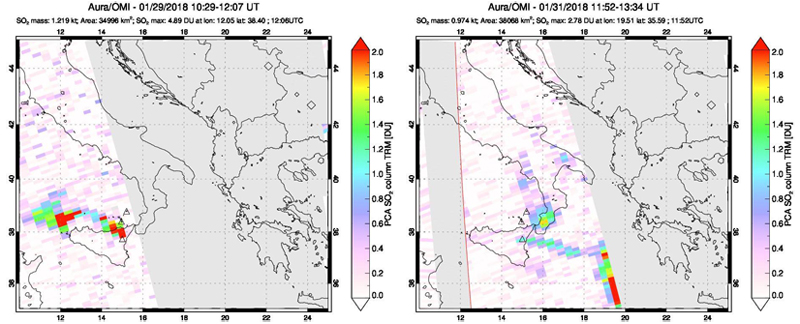 | Figure 213. Significant SO2 plumes were measured from Etna on 29 (left) and 31 (right) January 2018 by the OMI instrument on NASA's Aura satellite. Courtesy of NASA Goddard Space Flight Center. |
Two weak ash emissions occurred at NSEC during the first week of February 2018. The frequency of explosions increased during 15-16 February to 1-2 events per hour, producing moderate amounts of brown-gray ash and incandescent pyroclastic material (figure 214); heightened activity lasted for several days. The explosions were heard 20 km E and S from the summit. Faint, non-explosive emissions of gray ash were observed on the morning of 17 February 2018 from NEC (figure 215).
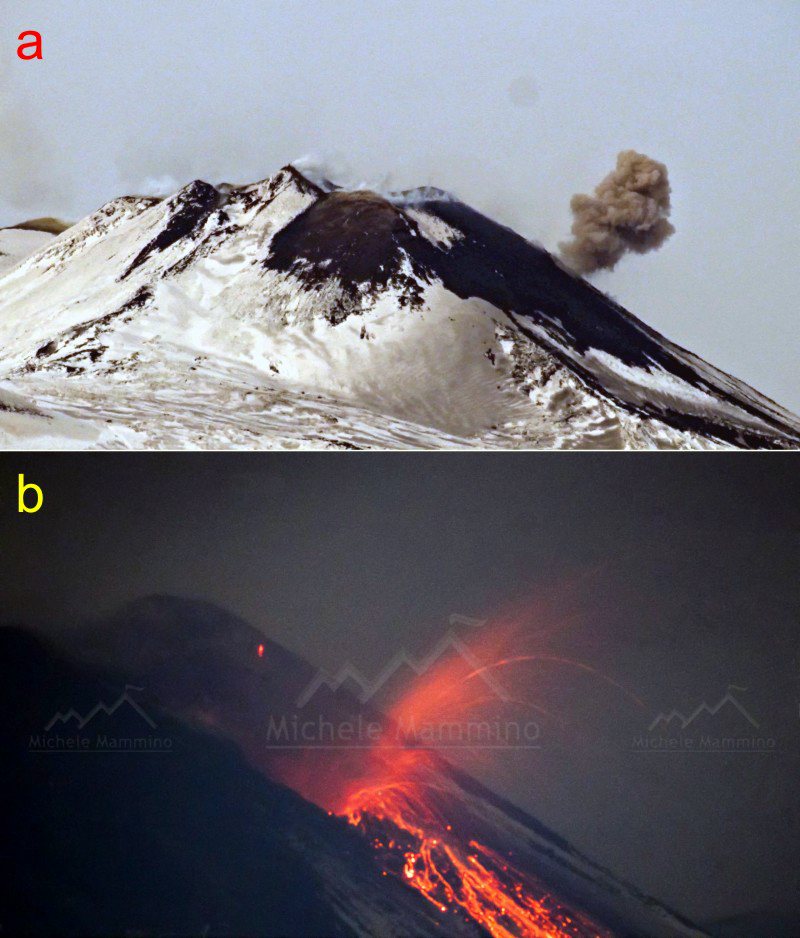 | Figure 214. Ash and incandescent material were ejected from the E vent of NSEC at Etna during 17 February 2018. a) Ash emission from the E vent at NSEC viewed by the Tremestieri Etneo webcam from the S flank on the morning of 17 February 2018. b) Incandescent material ejected during one of the explosions from the same vent, on the evening of 17 February 2018. Photo by Michele Mammino, used by INGV with permission of the author. Courtesy of INGV (Report 08/2018, Bollettino settimanale sul monitoraggio vulcanico, geochimico e sismico del vulcano Etna, 12/02/2018-18/02/2018 (issue date 20/02/2018). |
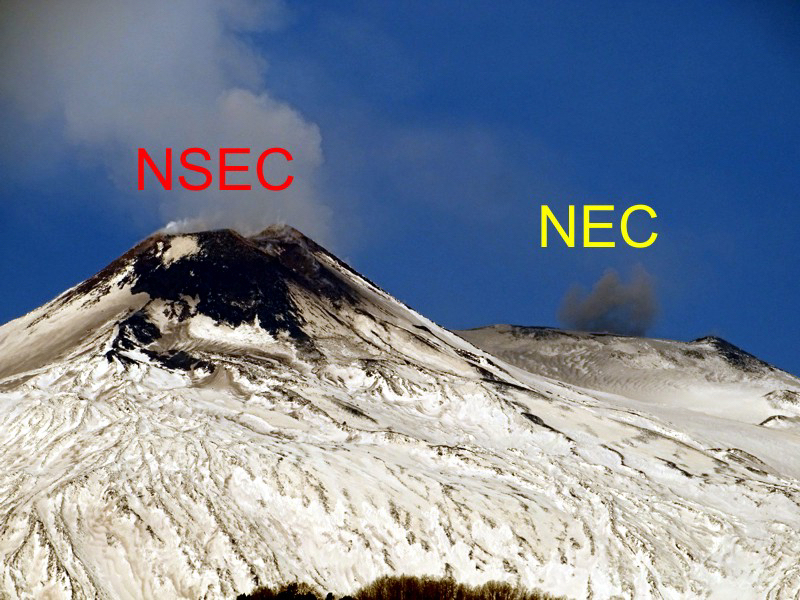 | Figure 215. A weak ash emission rose from Etna's NEC at 1005 local time on 17 February 2018, as seen by the Zafferana Etnea webcam. Courtesy of INGV, Report 08/2018, Bollettino settimanale sul monitoraggio vulcanico, geochimico e sismico del vulcano Etna, 12/02/2018-18/02/2018, issue date 20/02/2018). |
Degassing continued at the summit craters for the remainder of February and throughout March 2018. During an inspection by INGV on 10 March, the expansion of the pit crater at the bottom of NEC was noted, as was continuing collapses of the internal walls which produced minor ash emissions. Activity at the E vent of NSEC included a minor ash emission on 2 March 2018; occasional ejection of incandescent pyroclastic material and modest ash emissions continued throughout the month (figure 216). The ash emissions occurred at irregular intervals, varying from a few tens of minutes to a few hours, more frequently in the last days of the month.
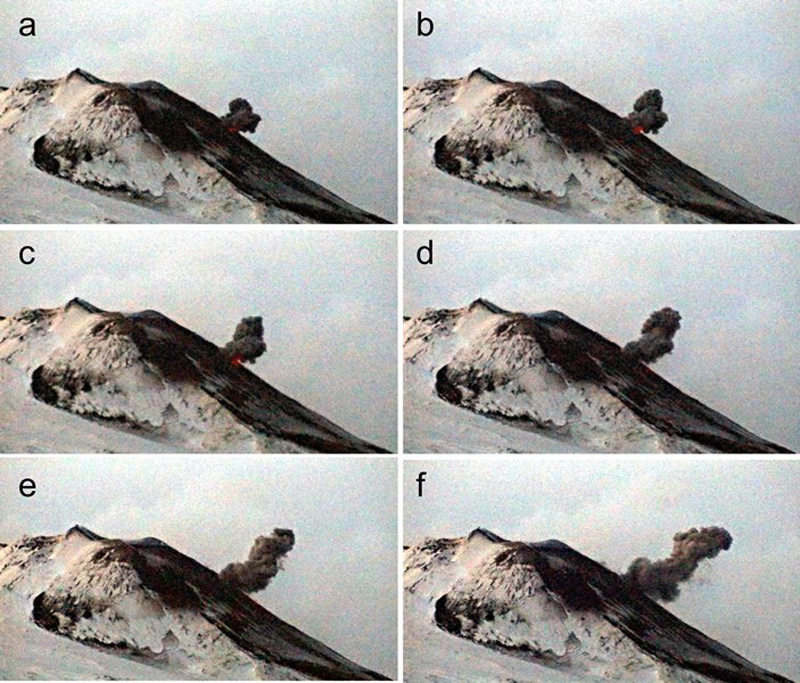 | Figure 216. Explosive activity from the vent on the E side of NSEC at Etna, taken from the Tremestieri Etneo webcam on the S flank on 8 March 2018. Ash emissions were accompanied by incandescent tephra that landed on the flanks. Photographic sequence by B. Behncke. Courtesy of INGV, Report 11/2018, Bollettino Settimanale, 05/03/2018-11/03/2018, issue date 13/03/2018). |
Information Contacts: Sezione di Catania - Osservatorio Etneo, Istituto Nazionale di Geofisica e Vulcanologia (INGV), Sezione di Catania, Piazza Roma 2, 95123 Catania, Italy (URL: http://www.ct.ingv.it/it/ ); MIROVA (Middle InfraRed Observation of Volcanic Activity), a collaborative project between the Universities of Turin and Florence (Italy) supported by the Centre for Volcanic Risk of the Italian Civil Protection Department (URL: http://www.mirovaweb.it/); NASA Goddard Space Flight Center (NASA/GSFC), Global Sulfur Dioxide Monitoring Page, Atmospheric Chemistry and Dynamics Laboratory, 8800 Greenbelt Road, Goddard, Maryland, USA (URL: https://so2.gsfc.nasa.gov/).
August 2018 (BGVN 43:08)  Cite this Report
Cite this Report
Degassing continues, accompanied by intermittent ash emissions and small Strombolian explosions in June and July 2018
Etna is the tallest active volcano in continental Europe with persistent activity at multiple summit craters and vents. The active craters are Bocca Nuova and Voragine within the Central Crater, the Northeast Crater, Southeast Crater, and the New Southeast Crater (figure 217). This report summarizes activity from April to July 2018 and is based on reports by the Istituto Nazionale di Geofisica e Vulcanologia (INGV).
 | Figure 217. The active summit craters of Etna volcano: the Bocca Nuova and Voragine craters that occupy the older Central Crater, the Northeast Crater (Cratere di Nord-Est), Southeast Crater (Cratere di Sud-Est), and the New Southeast Crater (Nuovo Cratere di Sud-Est). The years given in parentheses indicate when the craters formed. Photo by Marco Neri, courtesy of INGV (19 July 2018 blog). |
Activity through April was characterized by degassing at the summit craters (figure 218), with modest ash emissions from the New Southeast Crater and Northeast Crater in the first week, and occasional small ash emissions at the end of the month. Reduced activity dominated by degassing continued into May with modest ash emission from the Southeast and Northeast craters during the second week, and isolated ash emissions from the Northeast Crater in the second half of the month continuing into June.
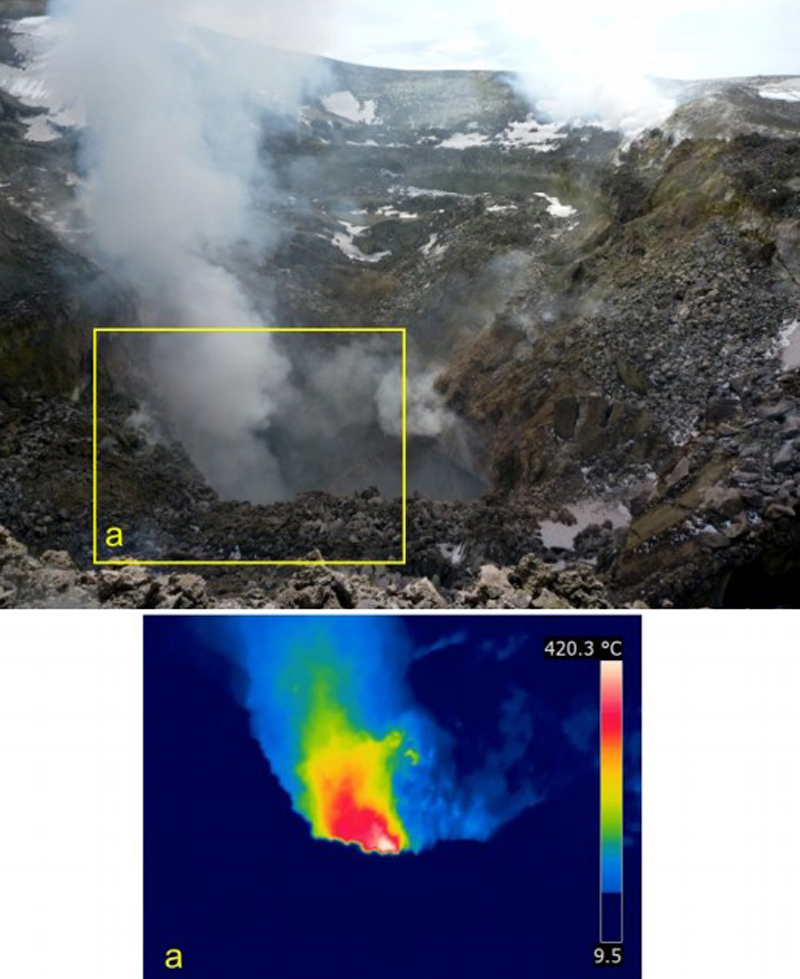 | Figure 218. Degassing at the Bocca Nuova crater at the summit of Etna in late April. The top image is a photograph of the crater with the location of the bottom image, which is a thermal image showing the degassing and temperature at the vent reaching over 400°C. Courtesy of INGV (Weekly report No. 18/2018 for 24 to 30 April 2018, issued on 2 May 2018). |
Throughout June the activity consisted of degassing at the summit craters with isolated diffuse ash emission from Northeast Crater (figure 219). This continued through to July until low-energy Strombolian activity commenced in the Bocca Nuova (from two vents) and Northeast craters (figures 220 and 221). The Strombolian explosions were small, lasting up to several tens of seconds, and were sometimes accompanied by red-brown ash emission. The ejected material was confined to within the craters. More energetic bursts were visible from the INGV surveillance camera located in Milo.
 | Figure 219. Photos of isolated dilute red-brown ash emissions from the Etna Northeast Crater on the 6 and 8 June. Courtesy of INGV (Report No. 24/2018 for the period 4 to 10 June 2018, issued on 12 June 2018). |
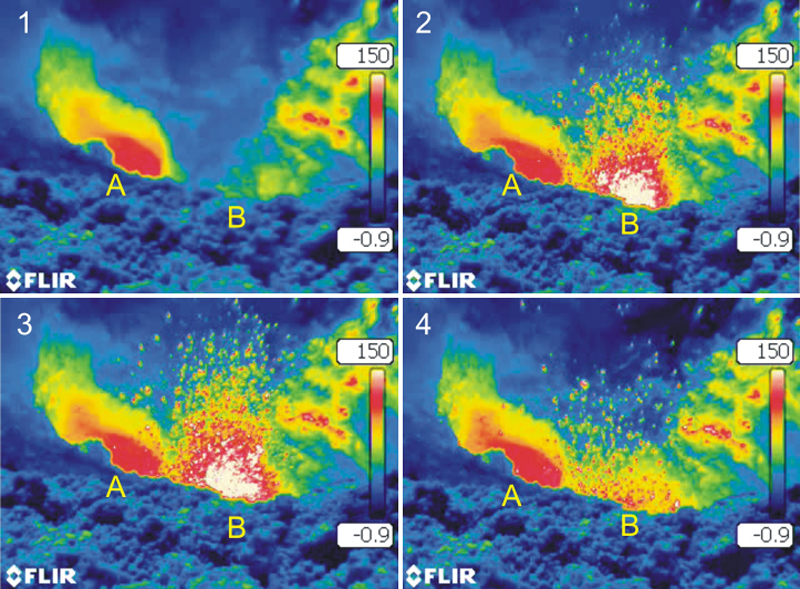 | Figure 220. A sequence of thermal infrared images of a Strombolian explosion at the Etna Bocca Nuova crater on 17 July 2018. Two vents are active (A and B), with vent B ejecting lava up to a few tens of meters above the vent. The color scale on the right of the images indicates the temperature in Celsius. Images taken by Giuseppe Salerno, courtesy of INGV (24 July 2018 INGV blog). |
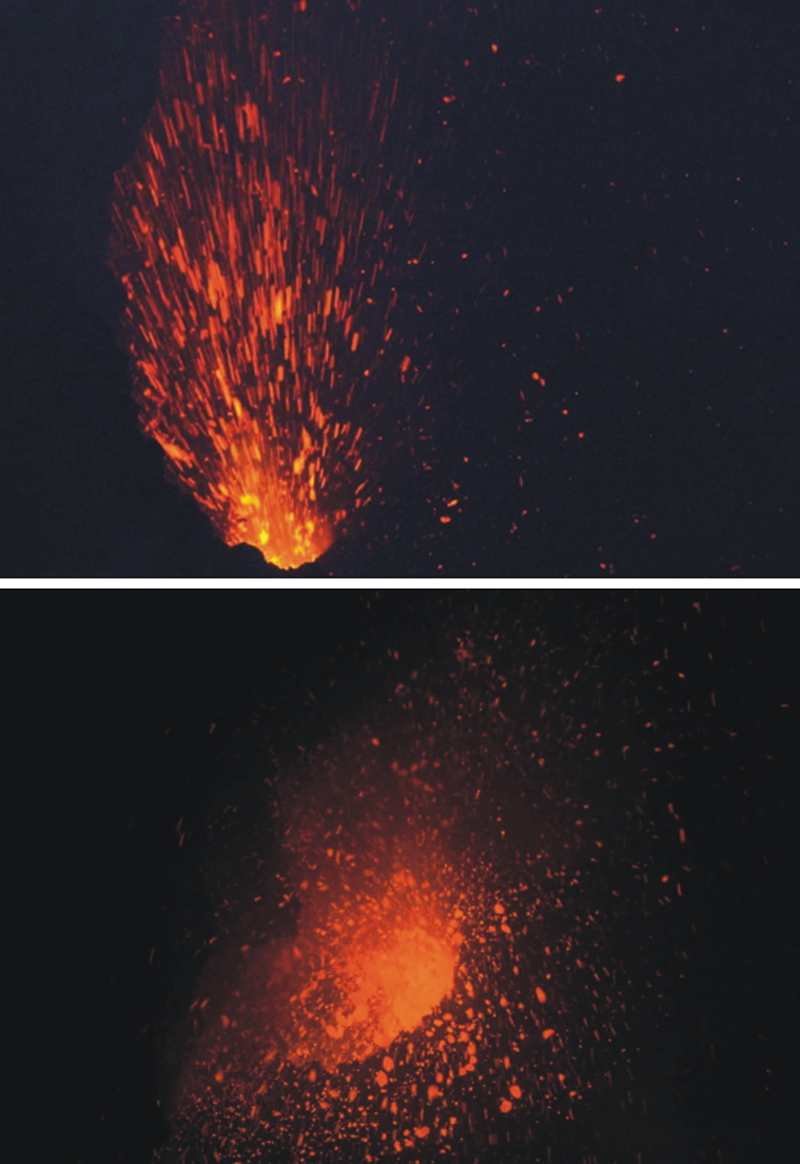 | Figure 221. Photos of Strombolian explosions at the base of the Etna Northeast Crater on 20 and 21 July 2018. The explosions occur when gas pockets burst and eject incandescent fluid lava above the vent. Photo by Michele Mammino, courtesy of INGV (24 July 2018 blog). |
Information Contacts: Sezione di Catania - Osservatorio Etneo, Istituto Nazionale di Geofisica e Vulcanologia (INGV), Sezione di Catania, Piazza Roma 2, 95123 Catania, Italy (URL: http://www.ct.ingv.it/it/); Blog INGVvulcani, Istituto Nazionale di Geofisica e Vulcanologia (INGV) (URL: http://ingvvulcani.wordpress.com).
December 2018 (BGVN 43:12)  Cite this Report
Cite this Report
Lava flows emerge from NSEC in late August and late November 2018; Strombolian activity continues from multiple vents
Italy's Mount Etna on the island of Sicily has had historically recorded eruptions for the past 3,500 years and has been erupting continuously since September 2013 through at least November 2018. Lava flows, explosive eruptions with ash plumes, and Strombolian lava fountains commonly occur from its summit areas that include the Northeast Crater (NEC), the Voragine-Bocca Nuova (or Central) complex (VOR-BN), the Southeast Crater (SEC) (formed in 1978), and the New Southeast Crater (NSEC) (formed in 2011). A new crater, referred to as the "cono della sella" (saddle cone), emerged during early 2017 in the area between SEC and NSEC and has become the highest part of the SEC-NSEC complex. Activity during late 2017 and early 2018 consisted mostly of sporadic Strombolian activity with infrequent minor ash emissions from multiple vents at various summit craters. Lava flow activity resumed in late August 2018 and again in late November and is covered in this report with information provided primarily by the Osservatorio Etneo (OE), part of the Catania Branch of Italy's Istituo Nazionale di Geofisica e Vulcanologica (INGV).
After several months of low-level activity in early 2018, increases in Strombolian activity at several vents began in mid-July (BGVN 43:08). This was followed by new lava flows emerging from the saddle cone and the E vent of the NSEC complex in late August. Discontinuous low-intensity Strombolian activity and intermittent ash emissions were reported from multiple vents at various summit craters during September through November. In late November, renewed Strombolian activity and a new, small flow emerged from a small scoria cone inside the E vent of the NSEC crater and persisted through the end of the month. The MIROVA thermal anomaly correspond to ground observations of increased thermal activity at Etna beginning in mid-July, peaking in late August, and increasing again at the end of November 2018 (figure 222).
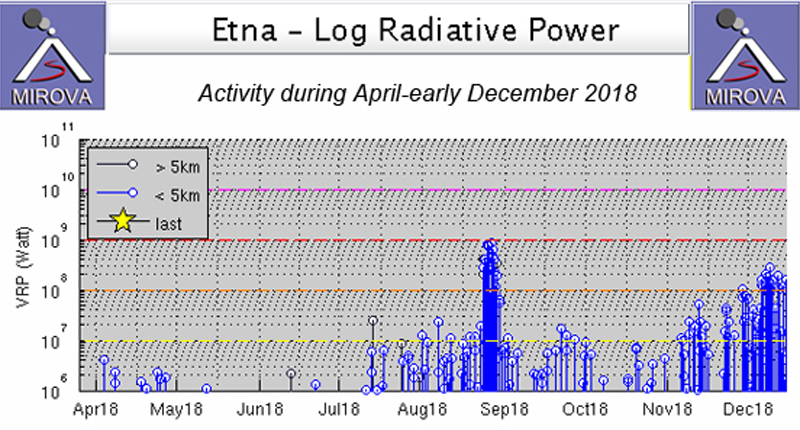 | Figure 222. MIROVA thermal anomaly graph for Etna from April through early December 2018 shows the increases in thermal activity from lava flows and increased Strombolian activity in late August and late November. Courtesy of MIROVA. |
Low-energy Strombolian activity resumed at both of the Bocca Nuova BN-1 vents as well as the vents in the Northeast Crater (NEC) during the second week of July 2018 and continued throughout the month. The activity from BN-1 was nearly continuous, but not always visible; occasionally, lava fragments rose 100 m and could be seen outside of the crater rim. Intermittent ash emissions accompanied the Strombolian activity. Activity at NEC was characterized by strong and prolonged explosions (up to several tens of seconds), sometimes with reddish-brown ash emissions (figure 223). Three vents on the floor of NEC continued to widen due to collapse of the inner walls. A seismic swarm on 18-19 July was located between 4 and 9 km depth.
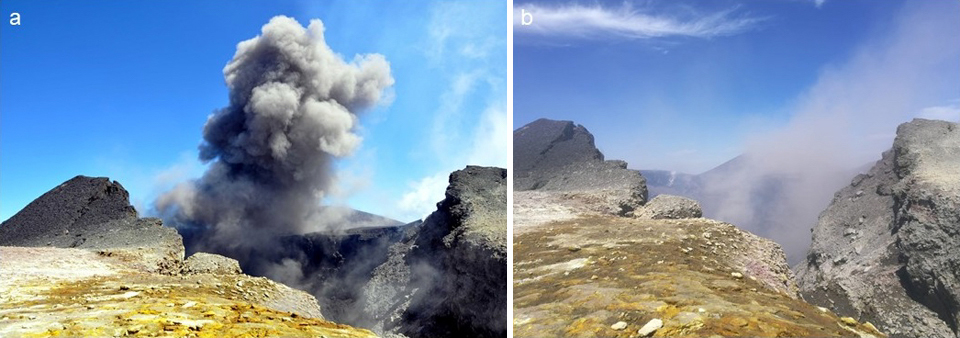 | Figure 223. Ash emissions from the Northeast Crater of Etna on a) 27 July and b) 28 July 2018 rose a few tens of meters and quickly dispersed. Left image by INGV personnel, right image by volcanology guide Francesco Ciancitto. Courtesy of INGV (Rep. 31/2018, ETNA, Bollettino Settimanale, 23/07/2018 - 29/07/2018, data emissione 31/07/2018). |
During a field inspection on 30 July INGV personnel noted activity at the three vents at the bottom of Northeast Crater; the farthest west produced ash emissions, the center produced steam, and the vent under the NE crater wall produced Strombolian activity that sent ejecta as high as the crater rim. Frequent ash emissions from NEC were observed on 3, 4, and 5 August. During the first week of August 2018 Strombolian activity also continued at BN-1 (figure 224). The webcam at Montagnola (EMOH) recorded incandescence at night from Bocca Nuova.
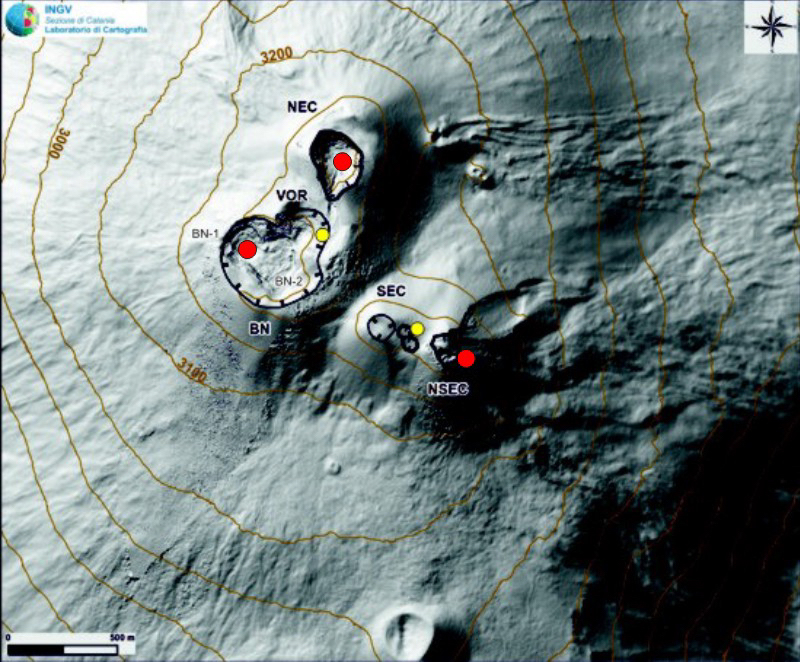 | Figure 224. Activity during the first half of August 2018 at Etna was concentrated at BN-1, the Northeast Crater (NEC), and the E vent of the New Southeast Crater (NSEC), shown in red. Courtesy of INGV (Rep. 33/2018, ETNA, Weekly Bulletin, 08/06/2018 - 12/08/2018, issue date 08/14/2018). |
After several months of calm, explosive activity also resumed at the E vent of the of the New Southeast Crater, high on the E flank, in early August. An explosion in the early morning of 1 August 2018 generated a gray-brown ash plume that rose several hundred meters above the summit (figure 225). Smaller emissions occurred throughout the day, and the EMOH camera recorded sporadic Strombolian explosions at night, which continued through the first week of August.
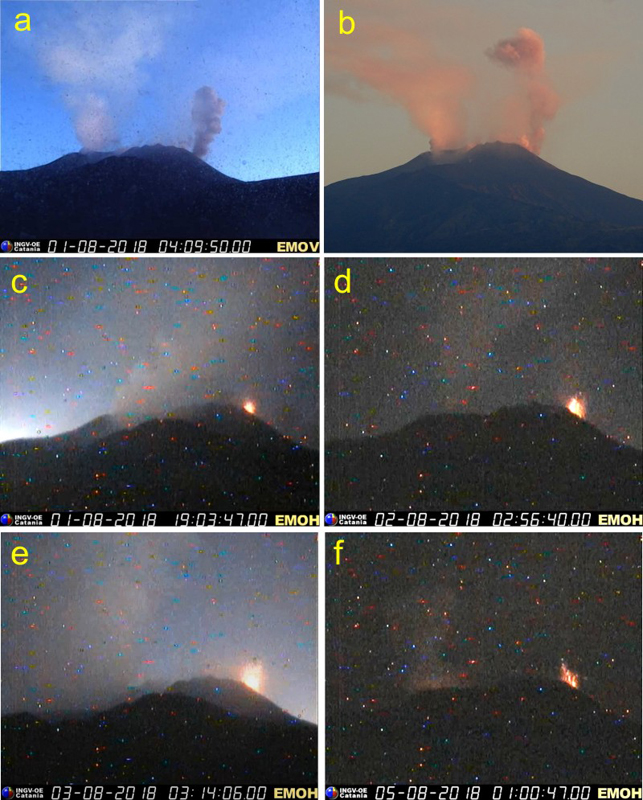 | Figure 225. After several months of calm, a resurgence of explosive activity was observed at the E vent (formed 25 November 2015) on the high E flank of the New Southeast Crater. The activity started with an explosion at 0408 UTC (= local time -2 hours), and generated a gray-brown ash plume that rose several hundred meters above the top of the volcano (a, b). In the following hours other smaller ash emissions occurred, and in the evening, the EMOH camera recorded sporadic Strombolian explosions (c). This activity continued, with fluctuations in the frequency and magnitude of the explosions, for the rest of the month (d, e, f). Courtesy of INGV (Rep. 32/2018, ETNA, Bollettino Settimanale, 30/07/2018 - 05/08/2018, data emissione 07/08/2018). |
Similar activity at BN-1, NEC, and the reactivated vent at NSEC continued through the second and third weeks of August. On 16 August 2018 a new vent opened in the BN-2 area on the E side of the Voragine (inactive since December 2015) and exhibited both degassing and Strombolian activity (figure 226). During that week Strombolian activity also continued at the NEC, but activity became more sporadic at the E vent of NSEC. During the last week of August, Strombolian activity and intense degassing continued in the western sector of Bocca Nuova (BN-1). Occasionally, lapilli fragments a few centimeters in diameter were ejected onto the S rim of the crater. Strombolian activity also continued from multiple vents at the bottom of NEC. The frequency and intensity of explosions was variable and increased significantly during 22 August, ejecting coarse pyroclastic material outside the crater rim.
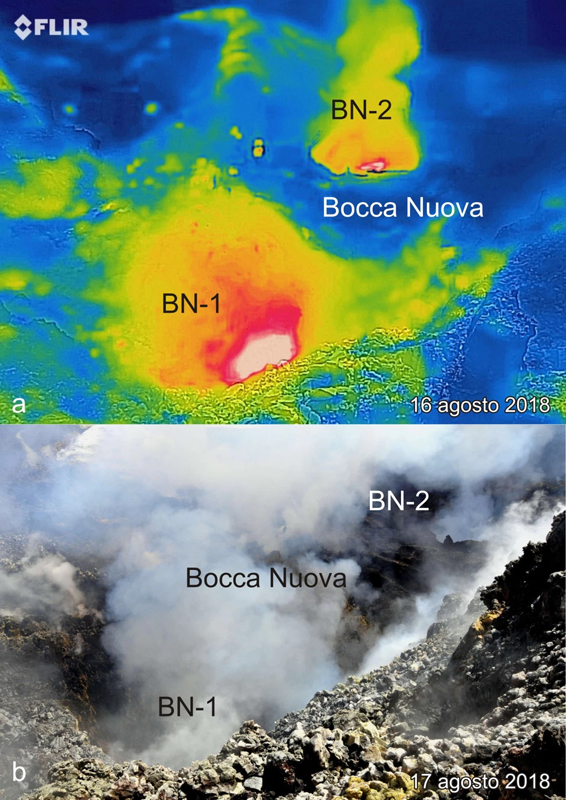 | Figure 226. The crater floor of Bocca Nuova at Etna on 16 and 17 August 2018 with thermal (a) and visible (b) images. The incandescent areas are highlighted with colors ranging from yellow to red and white in the thermal image. BN-1 (reactivated in November 2016) is in the foreground, and vent BN-2, which re-opened on 16 August in the south-eastern sector of the Bocca Nuova, is in the back (upper right). Thermal image by Francesco Ciancitto, photograph by Marco Neri. Courtesy of INGV (L'Etna non va in vacanza: aumenta di intensità l'attività eruttiva sommitale, 23 Agosto 2018, INGV Blog). |
Beginning on 23 August 2018 about 1800 UTC, activity resumed at the saddle cone located between the old cone of the Southeast Crater (SEC) and the new cone (NSEC). Strombolian activity, initially modest, quickly became more intense, producing almost continuous explosions with the launch of coarse ejecta up to a height of 100-150 m. At 1830 UTC, while Strombolian explosions of modest intensity were also taking place at the E vent of NSEC, a small lava flow emerged from the E vent and traveled a few hundred meters E towards the Valle del Bove. Shortly after 1830 UTC another lava overflow was also observed moving N from the saddle cone (figures 227 and 228).
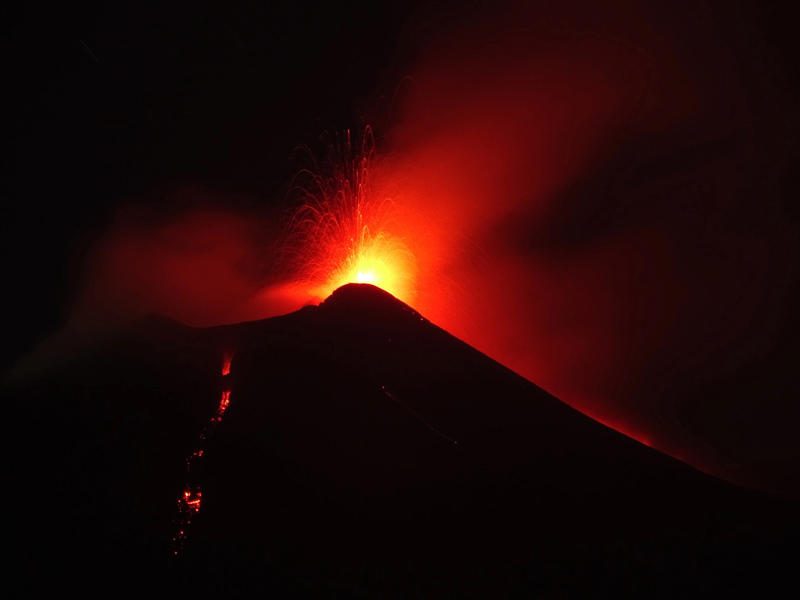 | Figure 227. Strombolian ejecta rose 100 m from the cono della sella (saddle cone) at the New Southeast Crater of Etna and lava flowed from both the E vent (left) and N from the saddle cone (right), shortly before midnight on 23 August 2018. Photo by Boris Behncke, courtesy of INGV blog 25 August 2018 (L'Etna fa gli straordinari: attività eruttiva al Nuovo Cratere di Sud-Est). |
 | Figure 228. Map of the summit crater area (DEM 2014, Aerogeophysics Laboratory - Rome Section 2, modified). BN = Bocca Nuova; VOR = Voragine; NEC = Northeast Crater; SEC = Southeast Crater; NSEC = New Southeast Crater. The yellow dots indicate the position of the degassing vents and those in red are the vents with Strombolian activity. The map also shows the flows produced by the saddle cone and the E vent of NSEC through 27 August 2018. Courtesy of INGV (Rep. N° 35/2018, ETNA, Bollettino Settimanale, 20/08/2018 - 26/08/2018, data emissione 28/08/2018). |
Strombolian explosions of moderate intensity continued throughout the night from the saddle cone. The following morning (24 August) a small lava overflow emerged from the vent and stopped after traveling a few tens of meters towards the S flank of the NSEC cone (figure 228, small orange flow within saddle, and figure 229b). The Strombolian activity was accompanied by an abundant and continuous emission of ash, whichformed a small plume that rose a few hundred meters from the vent (figure 229c). The Strombolian activity at the saddle cone decreased gradually on 25 August.
 | Figure 229. Eruptive activity at Etna during 23-24 August 2018. a) 23 August shortly before midnight; Strombolian activity from the saddle cone and lava flows from the E vent of the NSEC (white arrow) and from the cone of the saddle northwards (red arrow). Photo by B. Behncke taken from Fornazzo. b) 24 August, Strombolian activity and small lava overflow southward taken by the thermal camera of La Montagnola. c) 24 August, ash emitted during the Strombolian activity from the cone of the saddle, taken by the visible camera of La Montagnola. Courtesy of INGV (Rep. 35/2018, ETNA, Bollettino Settimanale, 20/08/2018 - 26/08/2018, data emissione 28/08/2018). |
Strombolian activity was continuing on 27 August 2018 at NSEC, and the flow to the N into the Valle del Leone began cooling after lava stopped feeding it that evening. The same day, a new lava overflow emerged from the E vent of NSEC (figure 230) and flowed E towards the Valle del Bove for about 24 hours (figure 231).
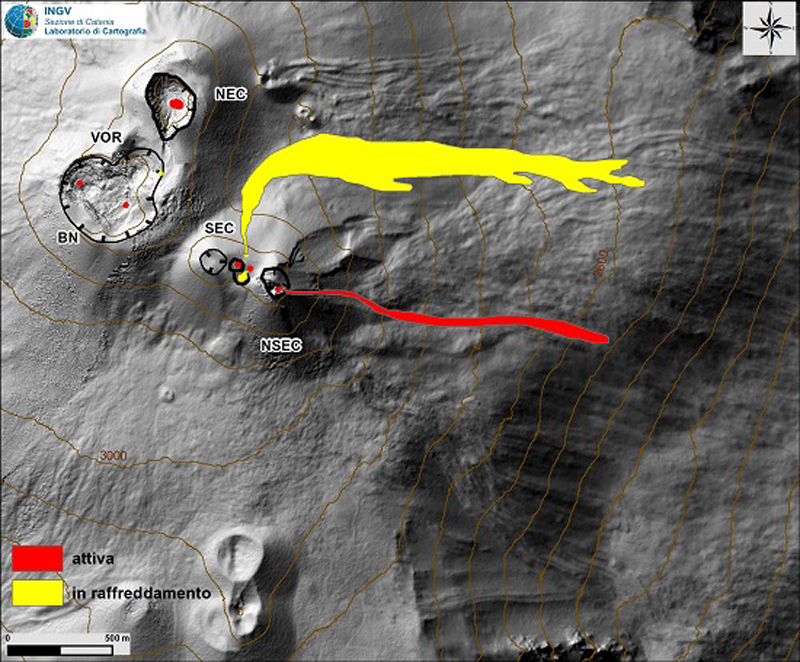 | Figure 230. Map of the summit crater area of Etna (DEM 2014, Aerogeophysics Laboratory - Rome Section 2, modified). BN = Bocca Nuova; VOR = Voragine; NEC = Northeast Crater; SEC = Southeast Crater; NSEC = New Southeast Crater. The yellow dots are degassing vents and those in red have Strombolian activity. The map also shows the flows produced by NSEC during the last two weeks of August 2018. The yellow flow was cooling by 27 August when the new red flow emerged from the E vent of NSEC and lasted for about 24 hours. Courtesy of INGV (Rep. 36/2018, ETNA, Bollettino Settimanale, 27/08/2018 - 02/09/2018, data emissione 04/09/2018). |
 | Figure 231. A thermal image taken by Pizzi Deneri on 27 August 2018 at Etna shows the two flows on the flanks of NSEC. View is from the N. The flow labelled in red flows E from the E vent, and the other flow travels N from the Cono della sella (saddle cone) into the Valle del Leone and then moves east. Courtesy of INGV (Rep. 36/2018, ETNA, Bollettino Settimanale, 27/08/2018 - 02/09/2018, data emissione 04/09/2018). |
Discontinuous Strombolian activity continued from NSEC after the effusive activity ended in late August. Several loud explosions from NSEC were reported by people living near the E flank of Etna during the first week of September. Strombolian activity, modest ash emissions, and significant gas emissions were also produced by BN-1; BN-2 exhibited only continuous degassing activity. Explosive activity declined during the second week of September. Discontinuous low-intensity Strombolian activity and intermittent ash emissions from Bocca Nuova, New Southeast Crater, and Northeast Crater characterized activity for the remainder of September. During the last week of the month, NEC produced frequent gray-brown ash emissions from a vent located in the western part of the crater floor, and included jets of ash, blocks, and volcanic bombs (figure 232).
 | Figure 232. Ash emissions from Etna's Northeast Crater in late September 2018. The four top images are explosions from a vent at the bottom of NEC on 24 September 2018; the bottom image is one of the many ash emissions observed on 30 September. Courtesy of INGV (Rep. N° 40/2018, ETNA, Bollettino Settimanale, 24/09/2018 - 30/09/2018, data emissione 02/10/2018). |
Discontinuous low-intensity Strombolian activity and intermittent ash emissions from the Bocca Nuova, the New Southeast Crater, and Northeast Crater characterized activity during all of October 2018. Two vents remained active at the bottom of Bocca Nuova (BN-1). During a visit on 16 October, INGV-OE geologists noted that the northernmost vent produced nearly continuous Strombolian activity with frequent explosions; occasionally fragments exceeded the crater rim in height but still fell within the crater. The southernmost vent, on the crater floor about 130 m from the edge, was characterized by explosive activity that produced mainly spattering which covered both the crater floor and walls (figure 233). On 25 October the webcam at Bronte recorded an ash emission from Bocca Nuova that resulted from three closely-spaced explosions. The ash was red and dispersed rapidly to the S causing ashfall near Torre del Filosofo and Rifugio Sapienza.
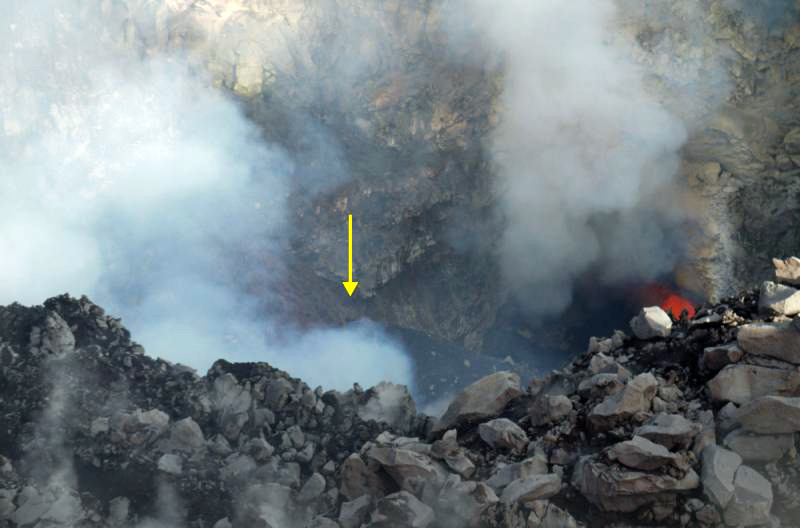 | Figure 233. Inside the Bocca Nuova BN-1 crater at Etna on 16 October 2018, two vents were active. The northernmost vent (yellow arrow) had Strombolian activity; the southernmost vent, visible on the right, produced mostly "spattering". Photo by M. Coltelli, courtesy of INGV (Rep. N° 43/2018, ETNA, Bollettino Settimanale, 15/10/2018 - 21/10/2018, data emissione 23/10/2018). |
Strombolian activity at NSEC gradually intensified during the first week of November 2018 and was sometimes accompanied by ash emissions that rapidly dispersed, falling mainly near the vent and in the Valle del Bove to the E. Audible explosions from the activity were heard in Zafferana Etnea on the E flank. Several clear views of the summit and details of the active vents were well exposed during an overflight on a clear 9 November day (figure 234).
 | Figure 234. An aerial view of the Etna summit craters taken on a clear 9 November 2018 day with the assistance of the 2nd Coast Guard Core of Catania. View is to the NW. BN = Bocca Nuova; VOR = Voragine; NEC = Northeast Crater; SEC = Southeast Crater; NSEC = New Southeast Crater. Courtesy of INGV (Rep. N° 46/2018, ETNA, Bollettino Settimanale, 05/11/2018 - 11/11/2018, data emissione 13/11/2018). |
Three vents were visible at BN-1 during the 9 November 2018 overflight (figure 235); continuous Strombolian activity occurred at vent 1, whose fallout of pyroclastic debris remained within the crater; discontinuous Strombolian activity was observed at vent 2 associated with weak, pulsing ash emissions; only degassing activities were observed at vent 3. At BN-2, intense degassing accompanied discontinuous Strombolian activity that was associated with weak pulsating ash emissions, and several high temperature gas emission points. Scientists also observed a collapse on a portion of the northern inner wall of BN-1 from the explosion on 25 October.
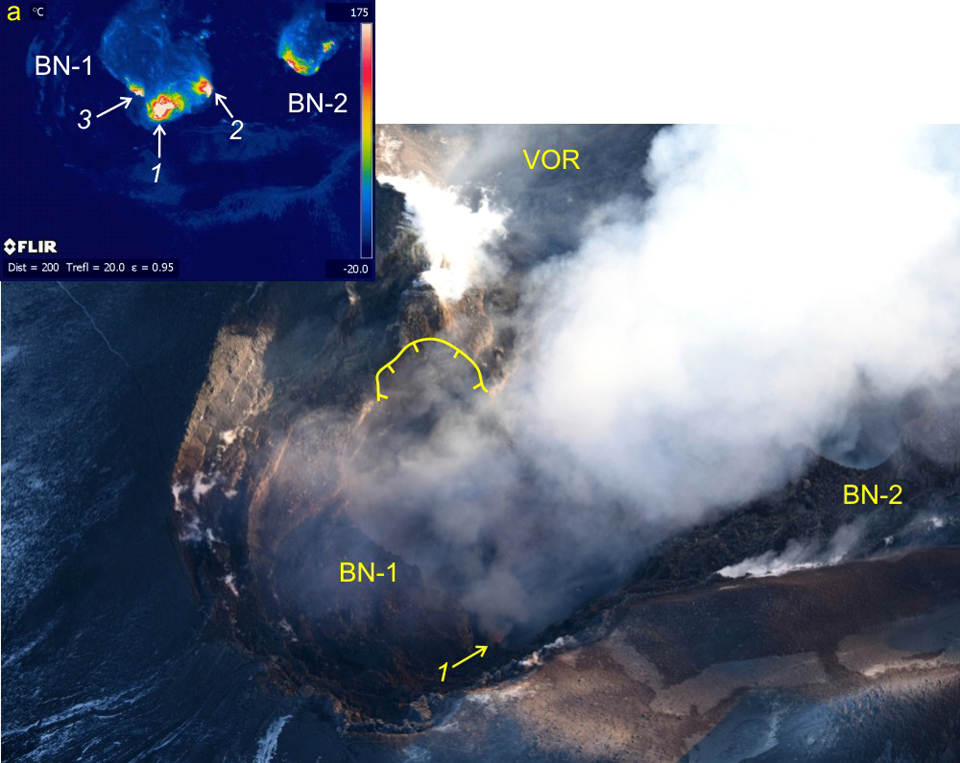 | Figure 235. Aerial view of Bocca Nuova (BN) and Voragine (VOR) at Etna on 9 November 2018 taken with helicopter support of the 2nd Coast Guard Core of Catania. The yellow hatched line indicates the wall of the area that collapsed on 25 October 2018. Inset a) thermal image of Bocca Nuova showing the structure of the three eruptive vents within BN-1 and the eruptive vent within the BN-2. Courtesy of INGV (Rep. N° 46/2018, ETNA, Bollettino Settimanale, 05/11/2018 - 11/11/2018, data emissione 13/11/2018). |
Modest outgassing continued at Voragine (VOR) from the 7 August 2016 vent near the rim during November. At NEC, continuous and intense Strombolian activity from the crater floor caused pyroclastic ejecta to land outside the crater rim (figure 236). At the NSEC complex, high-temperature anomalies were visible at the NW crater edge, and the E vent of NSEC had a small scoria cone that produced discontinuous Strombolian explosions and minor ash emissions (figure 237).
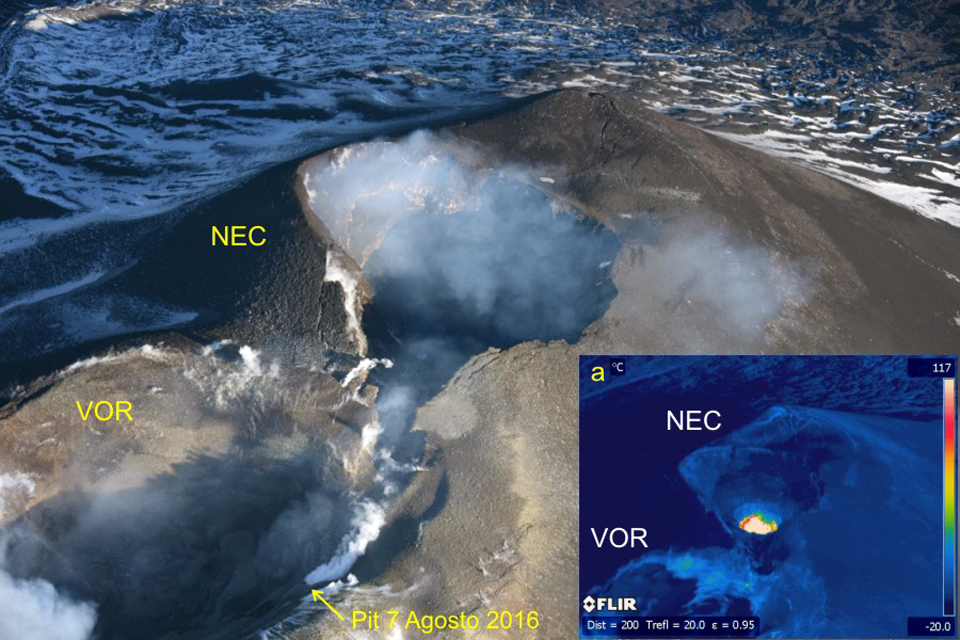 | Figure 236. Aerial view of Voragine (VOR) and the Northeast Crater (NEC) at Etna taken on 9 November 2018 with helicopter support of the 2nd Coast Guard Core of Catania. The 7 August 2016 vent at VOR had a vigorous steam emission (yellow arrow). Inset a) thermal image showed the Strombolian activity in the bottom of NEC. Courtesy of INGV (Rep. N° 46/2018, ETNA, Bollettino Settimanale, 05/11/2018 - 11/11/2018, data emissione 13/11/2018). |
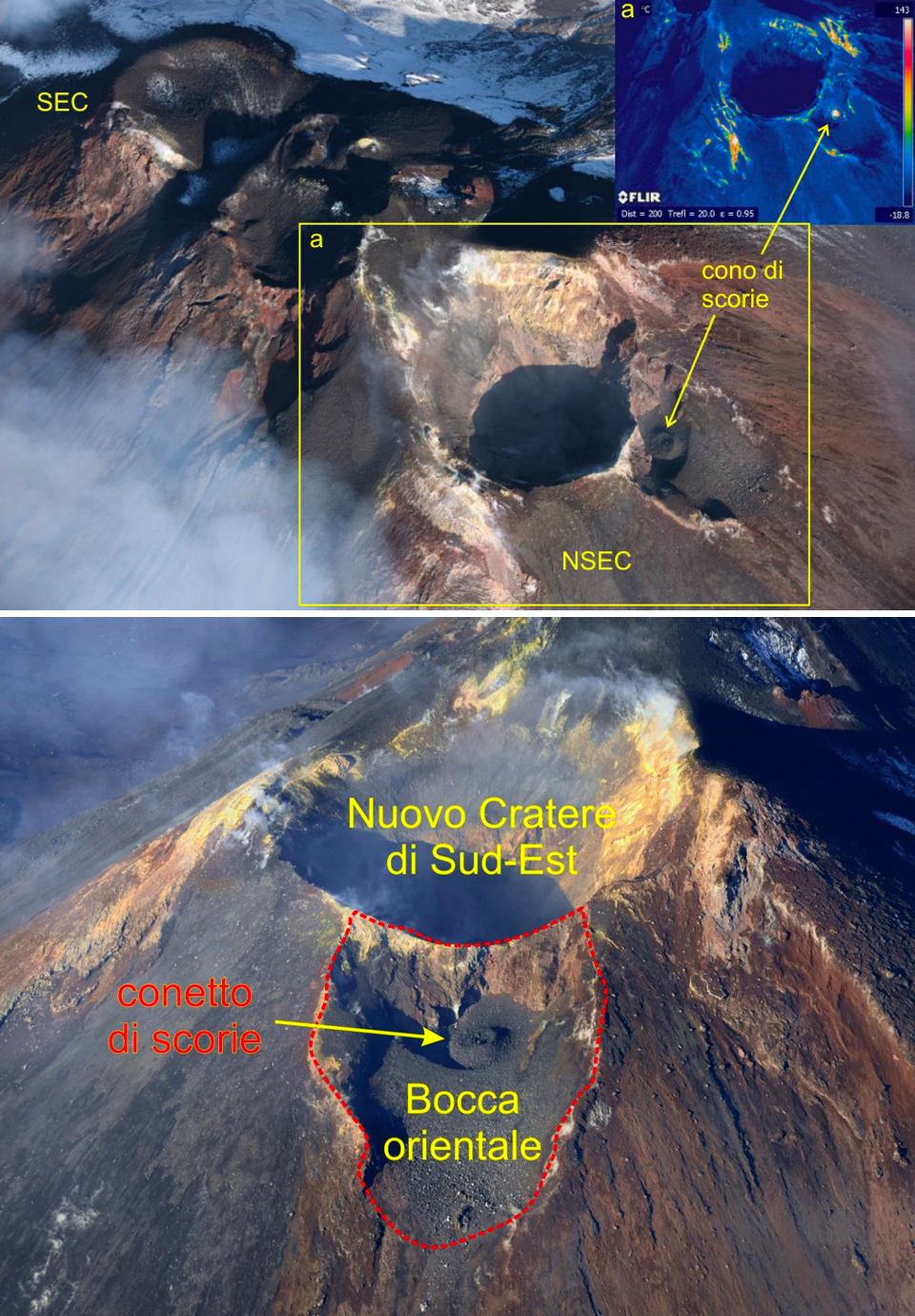 | Figure 237. Thermal activity was evident in several places at the SEC-NSEC complex at Etna during the 9 November 2018 overflight with the helicopter of the 2nd Coast Guard Core of Catania (inset a, upper image). The small scoria cone (conetto di scorie) was visible inside the E vent (Bocca orientale) of the New Southeast Crater, seen from the East on 9 November (lower image). Upper image from INGV weekly (Rep. N° 46/2018, ETNA, Bollettino Settimanale, 05/11/2018 - 11/11/2018, data emissione 13/11/2018), lower image by Stefano Branca (INGV-Osservatorio Etneo) from INGV blog (Piccoli coni crescono: aggiornamento sullo stato di attività dell'Etna al 7 dicembre 2018). |
A seismic swarm with over 40 events affected the W flank of Etna on 20 November 2018; the hypocenters were located between 15 and 27 km depth. A small lava flow also emerged on 20 November from the scoria cone inside the E vent at NSEC. The flow lasted for a few hours and remained inside the E vent. A new flow from the same scoria cone at the NSEC east vent appeared on 26 November accompanied by continued Strombolian activity. The flow remained high on the E flank at an elevation of about 3,200 m. Flow activity continued into the first days of December with frequent incandescent blocks moving down the NSEC E flank (figure 238). Elsewhere at Etna, Strombolian activity continued accompanied by sporadic and modest ash emissions from Bocca Nuova, the New Southeast Crater and the Northeast Crater through the end of November (figure 239).
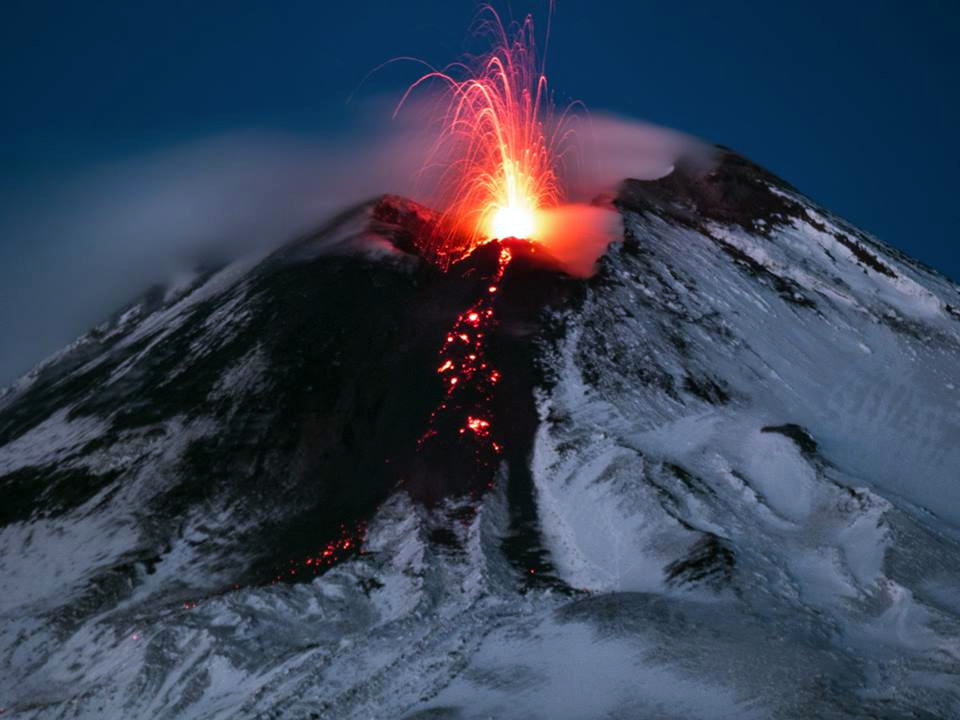 | Figure 238. Strombolian activity and emission of a small lava flow from the E vent of the New Southeast Crater was seen from the E at dawn on 29 November 2018. The lava flow was very short, but the detachment and rolling of numerous incandescent blocks from the front and sides of the flow created the impression that the flow reached the base of the New Southeast Crater cone. The scoria cone inside the E vent grew considerably compared to its size observed on 9 November (figure 237). Photo by Giò Giusa. Courtesy of INGV, INGV Blog (Piccoli coni crescono: aggiornamento sullo stato di attività dell'Etna al 7 dicembre 2018). |
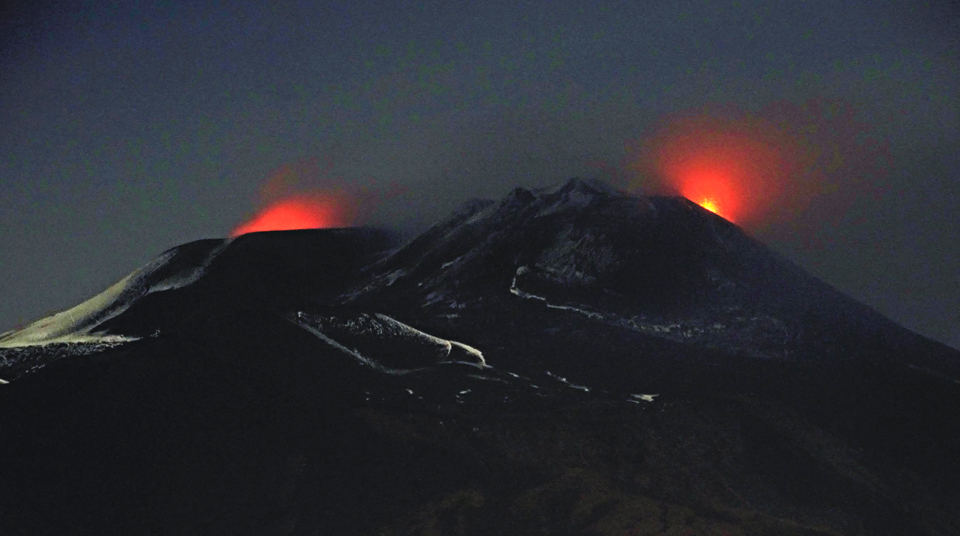 | Figure 239. Incandescence from Strombolian activity was visible inside the NSEC (right) and BN (left) craters at Etna on 22 November 2018 as viewed from Tremestieri Etneo. Photo by B. Behncke, courtesy of INGV (Rep. N° 48/2018, ETNA, Bollettino Settimanale, 19/11/2018 - 25/11/2018, data emissione 27/11/2018). |
Information Contacts: Sezione di Catania - Osservatorio Etneo, Istituto Nazionale di Geofisica e Vulcanologia (INGV), Sezione di Catania, Piazza Roma 2, 95123 Catania, Italy (URL: http://www.ct.ingv.it/it/ ); MIROVA (Middle InfraRed Observation of Volcanic Activity), a collaborative project between the Universities of Turin and Florence (Italy) supported by the Centre for Volcanic Risk of the Italian Civil Protection Department (URL: http://www.mirovaweb.it/).
April 2019 (BGVN 44:04)  Cite this Report
Cite this Report
Lava flows from NSEC scoria cone and SE flank fissure in December 2018; ash emissions through March 2019
Italy's Mount Etna on the island of Sicily has had historically recorded eruptions for the past 3,500 years and has been erupting continuously since September 2013 through at least March 2019. Lava flows, explosive eruptions with ash plumes, and Strombolian lava fountains commonly occur from its summit areas that include the Northeast Crater (NEC), the Voragine-Bocca Nuova (or Central) complex (VOR-BN), the Southeast Crater (SEC, formed in 1978), and the New Southeast Crater (NSEC, formed in 2011). A new crater, referred to as the "cono della sella" (saddle cone), emerged during early 2017 in the area between SEC and NSEC and has become the highest part of the SEC-NSEC complex. After several months of low-level activity in early 2018, increases in Strombolian activity at several vents began in mid-July (BGVN 43:08). This was followed by new lava flows emerging from the saddle cone and the E vent of the NSEC complex in late August and discontinuous Strombolian activity and intermittent ash emissions through November 2018 (BGVN 43:12). An eruption from a new fissure produced a lava flow into the Valle del Bove in late December 2018 and is covered in this report along with activity through March 2019 that included frequent ash emissions. Information is provided primarily by the Osservatorio Etneo (OE), part of the Catania Branch of Italy's Istituo Nazionale di Geofisica e Vulcanologica (INGV).
For the first three weeks of December 2018, Strombolian activity and ash emissions continued from the summit vents. A series of small flows from multiple vents near the scoria cone inside NSEC formed a small flow field on the E flank mid-month. A lateral eruption from a fissure on the SE flank of NSEC opened on 24 December and produced a series of flows that traveled E into the Valle del Bove for three days. Sporadic ash emissions, some with dense plumes and significant SO2 emissions, were typical throughout January and February 2019. Activity declined significantly during March 2019 to minor ash emissions and ongoing outgassing from the summit vents. The MIROVA plot of thermal energy recorded the increased heat from the lava flows during December 2018, along with minor pulses from the ash emissions and Strombolian activity in January and February (figure 240).
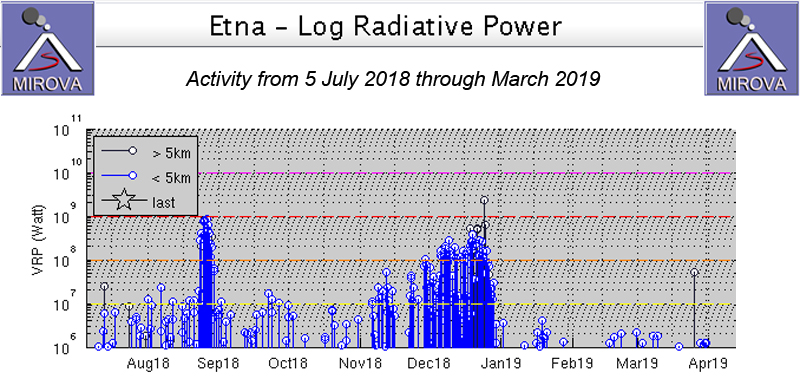 | Figure 240. The Etna MIROVA thermal anomaly data for 5 July 2018 through March 2019 showed a spike in thermal activity from lava flows and increased Strombolian activity in late August and during December 2018. Courtesy of MIROVA. |
Activity during December 2018. Strombolian activity, with modest ash emissions, continued from the Bocca Nuova, NSEC, and NEC during the first three weeks of December. Lava flowed from the scoria cone located within the E vent of NSEC and was associated with incandescent blocks rolling down the E flank of NSEC. Variable Strombolian activity at the scoria cone beginning on 4 December produced continuous overlapping small flows from several vents near the scoria cone for two weeks (figure 241). Intermittent explosions lasted 5-10 minutes with similar length pauses; activity increased on 16 December with near-continuous lava effusion. Several small flows traveled NE, E, and SE down the E flank of NSEC during the second and third weeks of the month (figure 242). A few flows reached the base of the cone at 2,900 m elevation and were almost a kilometer in length. Small collapses of portions of the lava field also produced minor plumes of ash.
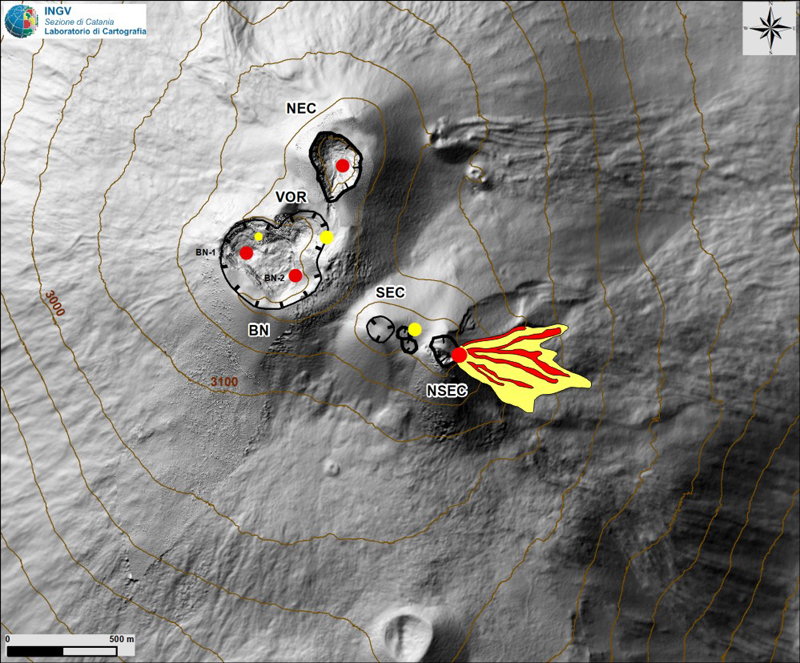 | Figure 241. Map of the summit crater area at Etna (DEM 2014). Black hatch lines outline the edge of the summit craters: BN = Bocca Nuova, with the north-western depression (BN-1) and the south-eastern depression (BN-2); VOR = Voragine; NEC = Northeast Crater; SEC = Southeast Crater; NSEC = New Southeast Crater. Yellow circles are degassing vents, and red circles are vents with Strombolian activity and/or ash emissions. The cooling lava field from the E vent scoria cone at NSEC is shown in yellow; the red flows were active on 17 December 2018. Courtesy of INGV (Report 51/2018, ETNA, Bollettino Settimanale, 10/12/2018 - 16/12/2018, data emissione 18/12/2018). |
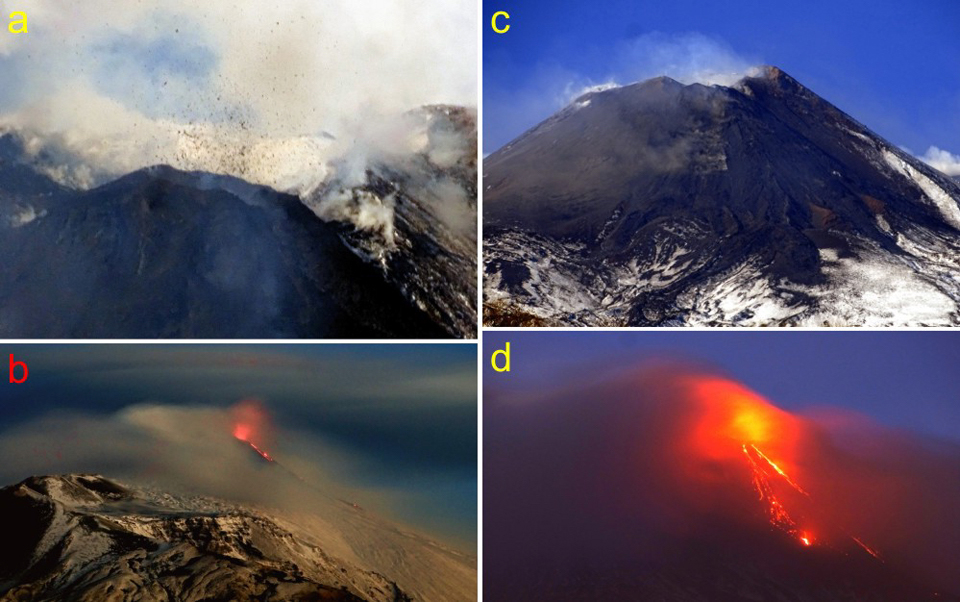 | Figure 242. The scoria cone inside the E vent of NSEC at Etna produced multiple small lava flows and Strombolian explosions for most of the first half of December 2018. (a) Strombolian activity at the scoria cone inside the E vent of the New Southeast Crater, seen from Milo (on Etna's eastern slope) on 11 December 2018. (b) Summit area of Etna seen from the south on 11 December 2018. (c) Eastern flank of the New South-East Crater seen from Fornazzo (eastern slope of Etna), with Strombolian activity and lava flows on 16 December 2018. (d) Active lava flows seen from Zafferana (eastern slope of Etna) on 16 December 2018. Courtesy of INGV (Report 51/2018, ETNA, Bollettino Settimanale, 10/12/2018 - 16/12/2018, data emissione 18/12/2018). |
A lateral eruption and intense seismic swarm began on 24 December 2018 from a nearly 2-km-long fissure trending NNW-SSE on the SE flank of NSEC; it produced a flow into the Valle del Bove and covered about 1 km2 (figures 243). The other summit craters produced intense Strombolian activity and abundant ash emissions during 24-27 December. Beginning around 0800 local time on 24 December, degassing intensity from the summit craters increased significantly. In the following hours, intermittent reddish-gray ash emissions rose from Bocca Nuova and NEC becoming continuous by late morning. Shortly after noon, an eruptive fissure opened up at the southeastern base of NSEC, releasing intense Strombolian activity which rapidly formed a dense plume of dark ash. A second smaller fissure located between NSEC and NEC also opened at the same time and produced weaker Strombolian activity that lasted a few tens of minutes. Over the following two hours, the main fissure spread SE, crossing over the western edge of the Valle del Bove and reaching down to 2,400 m elevation. Continuous Strombolian activity of variable intensity occurred at NEC and Bocca Nuova. The ash cloud created by the multiple eruptive vents generated a dense plume that drifted SE, producing ashfall mainly in the area around Zafferana Etnea and Santa Venerina (figure 244).
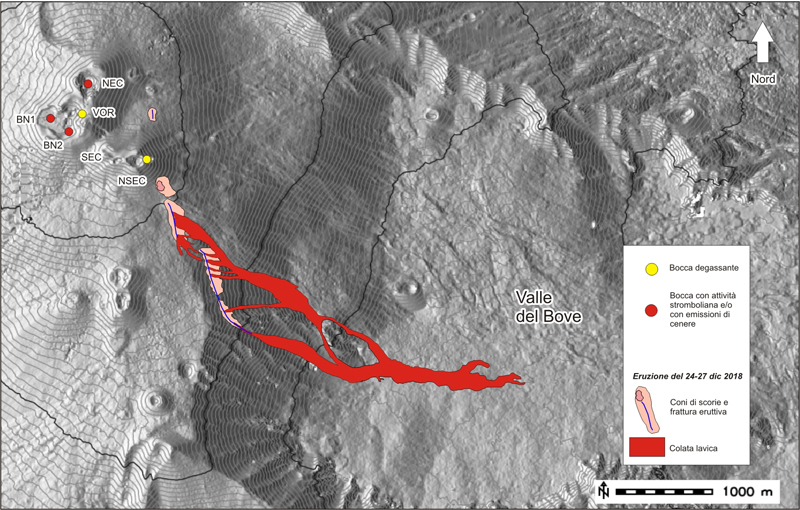 | Figure 243. Preliminary map of the lava flows and scoria cones at Etna active during the eruption of 24-27 December 2018. The topographic base used was provided by TECNOLAB of the INGV Catania Section Observatory Etneo, Laboratory for Technological Advances in Volcano Geophysics. The abbreviations at the top left identify the various summit craters (NEC = North-East Crater, VOR = Voragine, BN = Bocca Nuova, SEC = South-East Crater, NSEC = New South-East Crater). Courtesy of INGV (Report 01/2019, ETNA, Bollettino Settimanale, 24/12/2018 - 30/12/2018, data emissione 01/01/2019). |
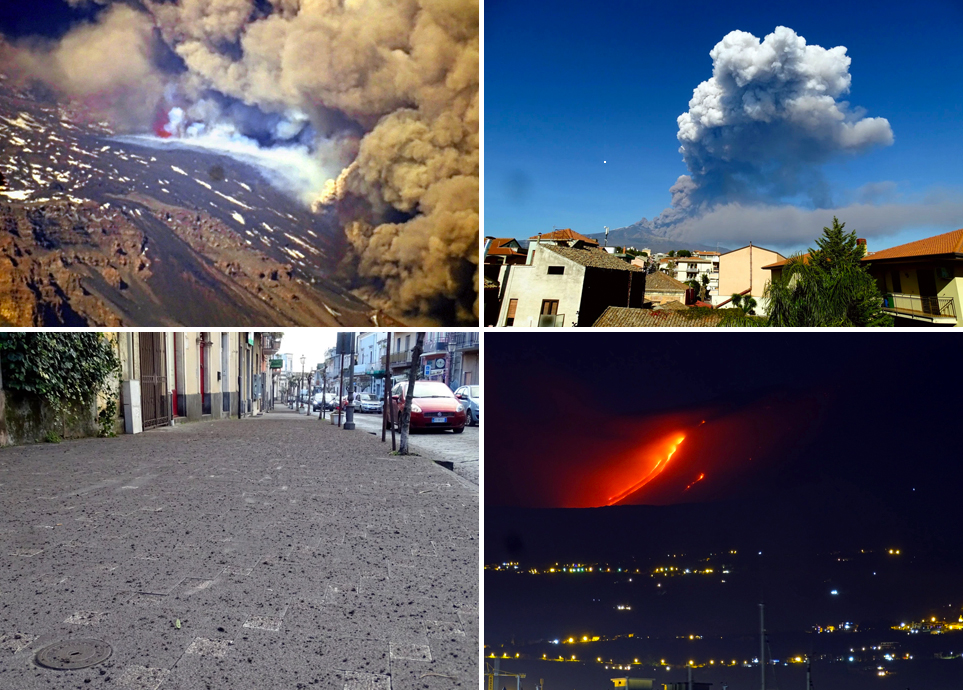 | Figure 244. Eruptive activity from the fissure at Etna that opened on 24 December 2018 included multiple flows, Strombolian explosions, and a significant ash plume that caused ashfall in nearby communities. Top left: The eruptive fissure opened near the edge of the western wall of the Valle del Bove. Top right: An ash and steam plume produced by the opening of the fissure, taken from the south. Bottom left: Ash fall on a sidewalk in Zafferana Etnea. Bottom right: Multiple lava flows were fed by an eruptive fissure that opened along the western wall of the Valle del Bove. Images taken on 24 December by B. Behncke. Courtesy of INGV (25 dicembre 2018, Redazione INGV Vulcani, L'eruzione laterale etnea iniziata il 24 dicembre 2018). |
As the fissure opened it fed several flows that descended the W face of the Valle del Bove (figure 245), past Serra Giannicola Grande, merged into a single flow at the base of the wall, and continued E across the valley floor. Ash emissions decreased significantly from Bocca Nuova and NEC after 1430 on 24 December. By 1800 the fissure was active mainly at the lower end where it continued to feed the flow in the Valle del Bove with strong Strombolian activity and abundant ash emissions. Around 1830 intense Strombolian activity resumed at Bocca Nuova along with abundant ash emissions which gradually decreased overnight. Effusive activity from the fissure continued through 26 December when it decreased significantly; new lava feeding the flow ended on 27 December, but the flow front continued to move slowly (figure 246). Degassing continued at Bocca Nuova, forming a dilute ash plume that drifted hundreds of km S before dissipating. A persistent SO2 plume was measured with satellite instruments drifting SSE during 25-30 December while the eruptive fissure was active (figure 247).
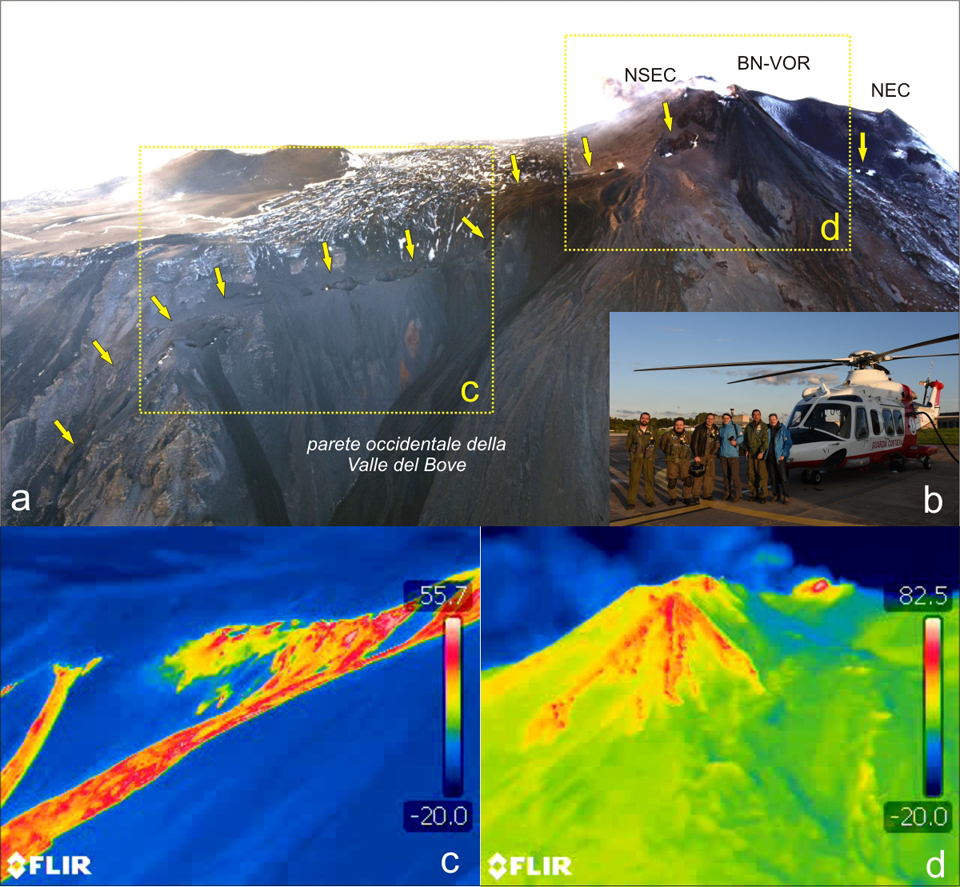 | Figure 245. Visual and thermal images of the 24-27 December 2018 fissure vent at Etna taken on 26 December 2018. (a) The eruptive fissure (yellow arrows) opened on 24 December 2018 along the W wall of the Valle del Bove and sent fresh lava down the wall (black areas), the yellow dashed rectangles indicate the areas shown with thermal images in c and d. (b) The crew that carried out the overflight on 26 December, using the helicopter of the 2nd Coast Guard Air Force in Catania. (c) and (d) are thermal camera images of the eruptive fissure that highlight the flows moving down the W wall of Valle del Bove. Visible image photo by Marco Neri. Thermal images by Stefano Branca. Courtesy of INGV (Report 01/2019, ETNA, Bollettino Settimanale, 24/12/2018 - 30/12/2018, data emissione 01/01/2019). |
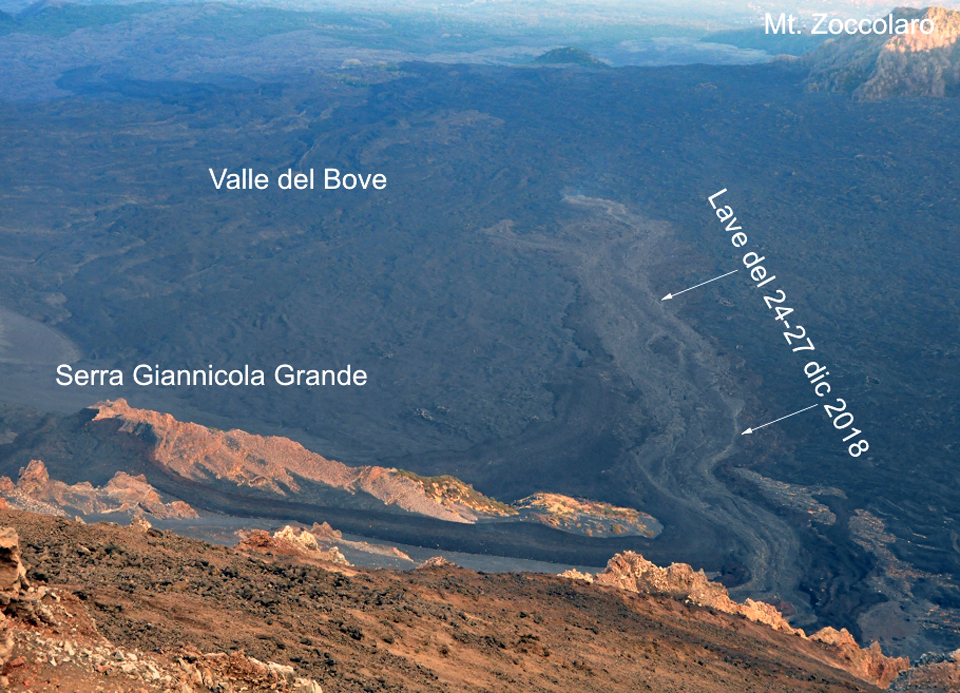 | Figure 246. The flow from the fissure eruption at Etna traveled past Serra Giannicola Grande and E into the Valle del Bove during 24-27 December 2018. By the time of this image at 1600 on 27 December, the lava flows were no longer being fed with new material and were almost stationary within the Valle del Bove. Photo by Marco Neri, courtesy of INGV (Report 01/2019, ETNA, Bollettino Settimanale, 24/12/2018 - 30/12/2018, data emissione 01/01/2019). |
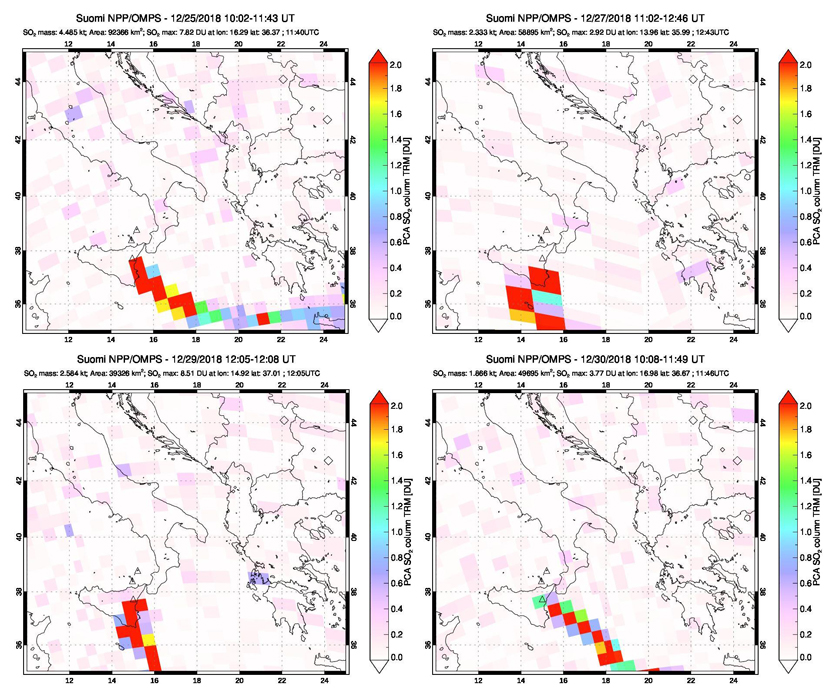 | Figure 247. The OMPS instrument on the Suomi NPP satellite measured significant SO2 plumes from Etna during the December eruptive episode, shown here by data on (clockwise from top left) 25, 27, 29, and 30 December 2018. The SO2 plumes on these days all drifted SSE from Etna. Courtesy of NASA Goddard Space Flight Center. |
A significant increase in the release of seismic strain and frequency of earthquakes began around 0830 on 24 December 2018. Around 300 events occurred during the first three hours of increased seismicity which continued throughout the week, with over 2,000 events recorded in different areas around Etna. The initial swarm was located in the summit area near the fissure with events located 0-3 km below sea level; subsequent seismicity was located in the Valle del Bove and included multiple earthquakes with magnitudes greater than M 4.0. The E and SW slopes of the volcano were also affected by seismic events. The largest earthquake (M 4.8) was recorded on 26 December at 0319 local time, located about 1 km below sea level between the towns of Fleri and Pennisi on the Faglia Fiandaca fault. It was widely felt in many urban centers and caused damage in some areas. INGV noted that it was likely not generated by movement of magmatic material in the epicentral area.
Activity during January 2019. No lava flow activity was reported in January, but sporadic ash emissions and weak Strombolian activity persisted at NEC and Bocca Nuova (figure 248); occasional nighttime incandescent bursts were seen from Voragine. During one of these ash-emission episodes, on the evening of 18 January, fine ashfall was reported on the SE flank in the towns of Zafferana Etnea and Santa Venerina. Slight increases in volcanic tremor amplitude accompanied incandescent flashes from Voragine crater on the evenings of 16 and 18 January and in the early morning of 21 January (figure 249). On 19 January gas emissions and explosions were reported from a new vent near the NE edge of VOR, about 40 m NW from the 7 August 2016 vent (figure 250).
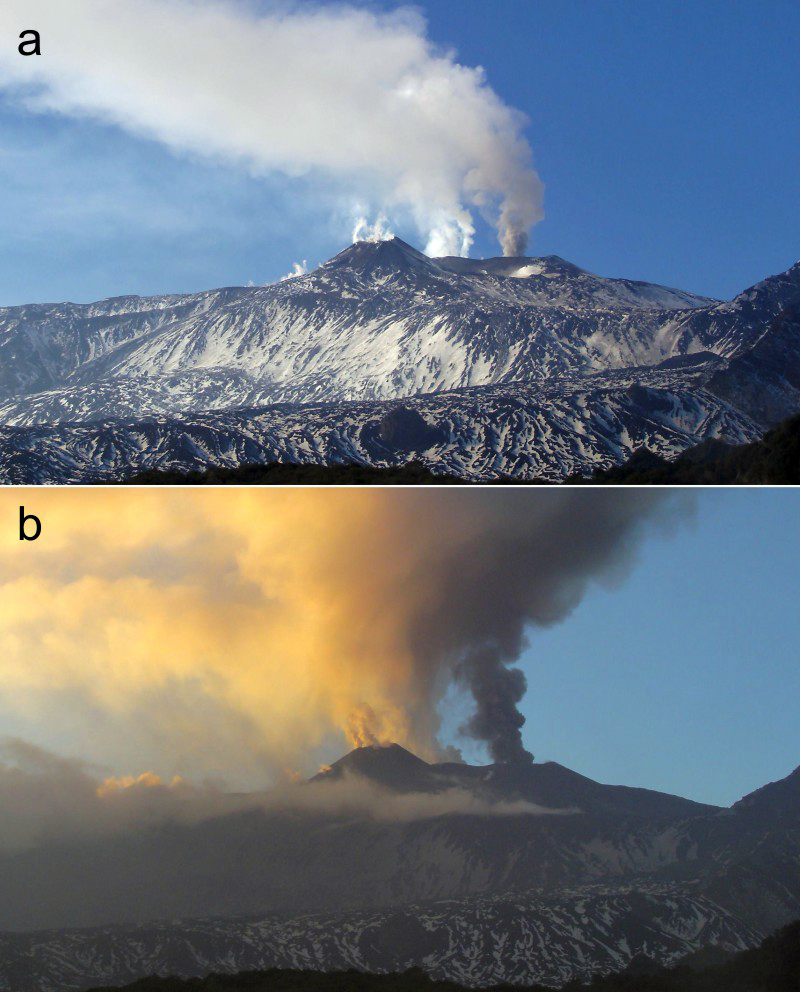 | Figure 248. Strong degassing from the summit craters at Etna was accompanied by ash emissions from NEC on 16 (a) and 19 January 2019 (b). The images were taken with the high-resolution webcam at Monte Cagliato (located E of Etna). Courtesy of INGV (Report 04/2019, ETNA, Bollettino Settimanale, 14/01/2019 - 20/01/2019, data emissione 22/01/2019). |
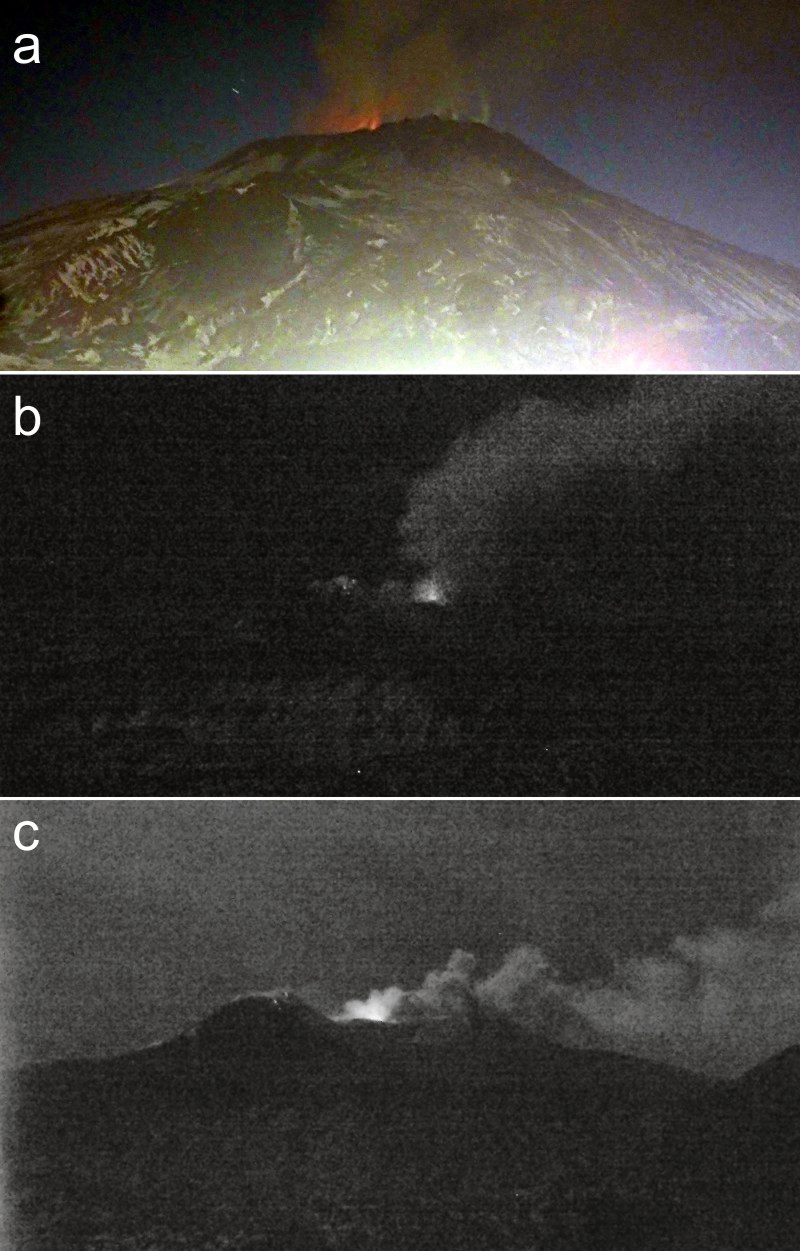 | Figure 249. Episodes of strong incandescence appeared at Etna's Voragine crater at 1710 UTC on 16 January (a), at 1143 UTC on 18 January (b), and at 0307 on 21 January (c). Photo (a) was taken from Tremestieri Etneo (south side of Etna), (b) and (c) were recorded by the high resolution camera in Monte Cagliato (eastern slope of Etna). Courtesy of INGV (Report 04/2019, ETNA, Bollettino Settimanale, 14/01/2019 - 20/01/2019, data emissione 22/01/2019). |
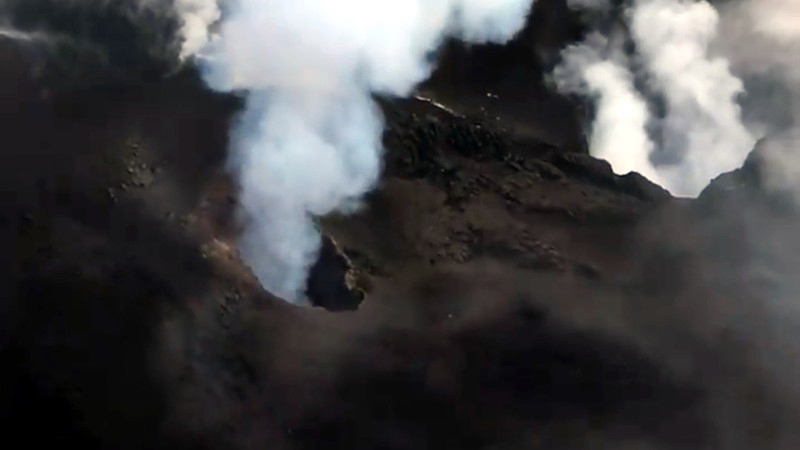 | Figure 250. A newly opened vent under the NE rim of the Voragine crater at Etna was observed on 19 January 2019. Behind it on the right, about 40 m SE, is the 7 August 2016 vent. Video taken by Prof. Carmelo Ferlito, Department of Biological, Geological and Environmental Sciences of the University of Catania. Courtesy of INGV (Report 04/2019, ETNA, Bollettino Settimanale, 14/01/2019 - 20/01/2019, data emissione 22/01/2019). |
Newly available higher resolution SO2 data from the TROPOMI Tropospheric Monitoring Instrument on board the Copernicus Sentinel-5 Precursor (S5P) satellite showed persistent SO2 plumes from Etna that drifted significant distances in multiple directions before dissipating for much of the month. The strongest plumes were recorded during 16-22 January 2019 (figure 251).
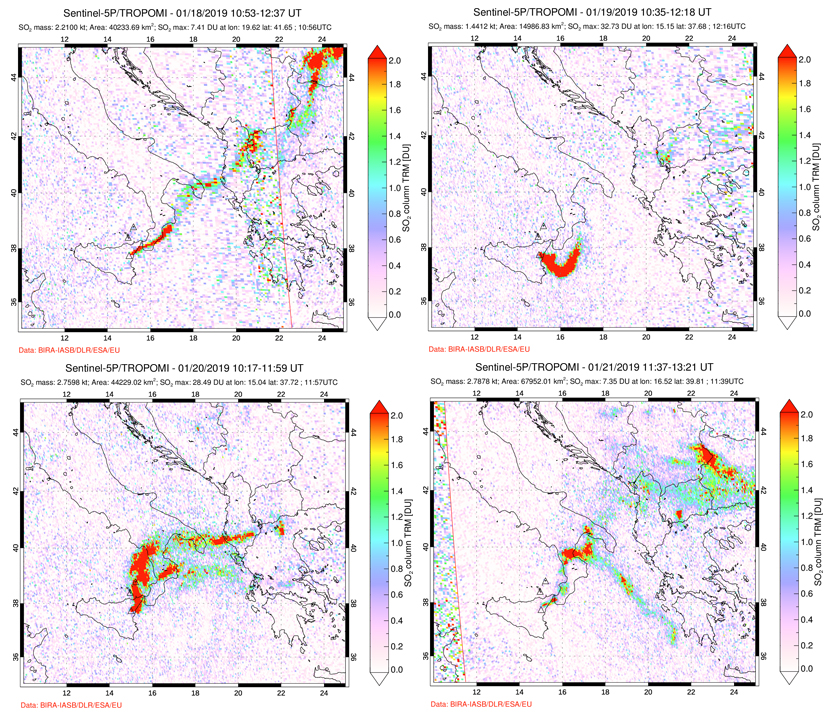 | Figure 251. Sulfur dioxide plumes were recorded from Etna during most days in January 2019 from the TROPOMI Tropospheric Monitoring Instrument on the Copernicus S5P satellite. The densest plumes were recorded during 16-22 January; plumes from 18, 19, 20 and 21 January 2019 are shown here. Courtesy of NASA Goddard Space Flight Center. |
Ash emissions intensified during the last week of January. During the morning of 23 January 2019 a dense ash plume drifted ENE from NEC, producing ashfall on the E flank of the volcano as far as the coast, including in Giarre (figure 252). Discontinuous ash emissions were reported from Bocca Nuova on 25 January; the following morning ash emissions intensified again from NEC and drifted S, producing ashfall in the S flank as far as Catania (figure 253). Emissions persisted until sometime during the night of 26-27 January. The ashfall from 22-23 and 26 January were analyzed by INGV personnel; the components were 95-97% lithic fragments and crystals with only 3-5% juvenile material. An ash plume from Bocca Nuova on 28 January drifted E and produced ashfall in the Valle del Bove. Ash emission decreased from Bocca Nuova on 29-30 January; only dilute ash was observed from NEC during the last few days of the month.
 | Figure 252. Dense ash emissions during the morning of 23 January 2019 at Etna were observed (a) from the Catania camera CUAD (ECV), (b) from the Catania CUAD high resolution camera (ECVH), (c) from the area stop at Linera on the A18 Messina-Catania motorway (photo B. Behncke), and (d) from the hamlet of Pisano, near Zafferana Etnea, on the SE slope of the volcano (photo B. Behncke). Courtesy of INGV (Report 05/2019; ETNA, Bollettino Settimanale, 21/01/2019 - 27/01/2019, data emissione 29/01/2019). |
 | Figure 253. Ash emissions covered the snow on the S flank of Etna on 26 January 2019. Photo was taken from the SS 121 at the Adrano junction, on the SW flank of the volcano. Photo by R. Corsaro, courtesy of INGV (Report 05/2019; ETNA, Bollettino Settimanale, 21/01/2019 - 27/01/2019 ,data emissione 29/01/2019). |
Activity during February 2019. Typical degassing and discontinuous explosive activity from the summit characterized Etna during February. An explosion was observed at NEC at 0230 UTC on 2 February which initially produced a dense ash plume that drifted NE, producing ashfall in the summit area and the Piano Provenzana. Ash emission decreased throughout the day. Repeated ash emissions were visible beginning in the afternoon of 6 February from NEC after several days of cloudy weather. Continuous ash emissions were observed overnight on 7-8 February, producing a dilute plume that drifted S then SE. A similar dilute ash emission was observed on 9 February; the plume drifted SW. Analysis of the ash by INGV indicated a similar composition to the samples measured two weeks prior. Webcams captured numerous pulsating ash emissions from NEC in mid-February, many of which produced substantial SO2 plumes (figure 254). Emissions increased in intensity and frequency and were nearly continuous during most of the third week, with plumes drifting W, S, and SE resulting in ashfall in those directions, and also led to temporary air space closures in Catania and Comiso (figures 255 and 256). Also during the third week, Strombolian activity took place at BN-1, while pulsating degassing was observed at BN-2. Incandescent degassing continued at the vent located on the N edge of Voragine. Irregular ash emissions that rapidly dispersed near the summit were produced by BN on 26 and 27 February.
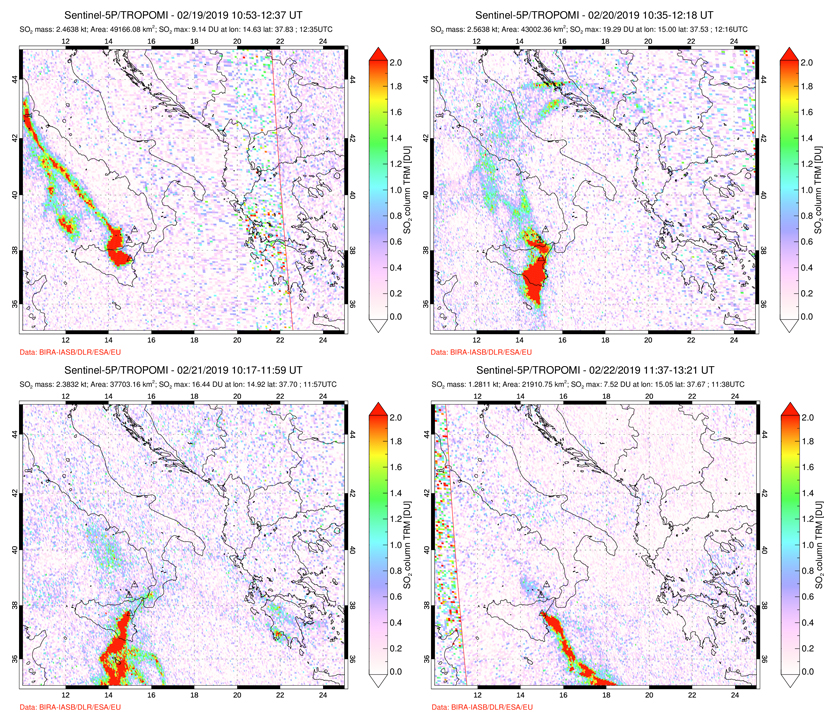 | Figure 254. Substantial SO2 plumes accompanied ash emissions from Etna during many days in February 2019. The largest plumes were captured with the TROPOMI instrument on the Sentinel-5P satellite on 19, 20, 21, and 22 February. Courtesy of NASA Goddard Space Flight Center. |
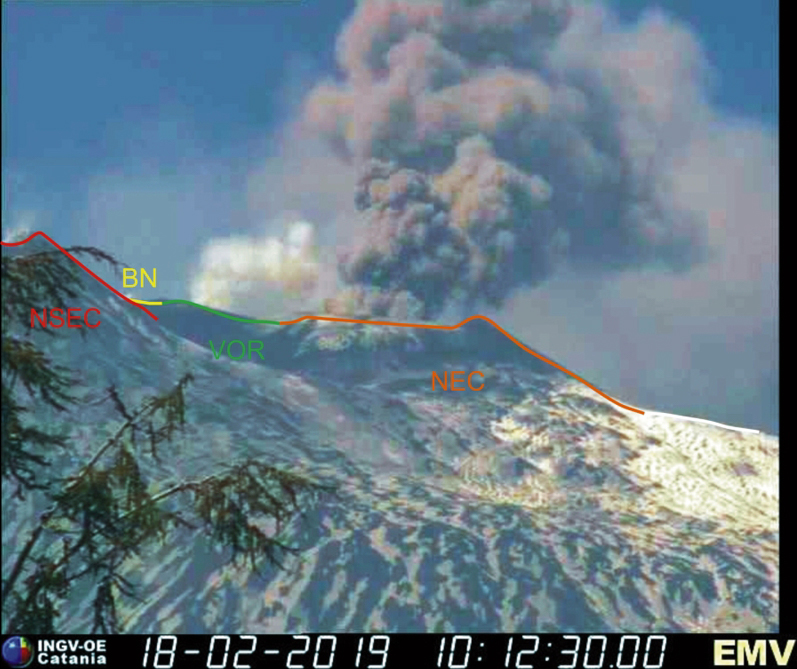 | Figure 255. Ash emission from Etna's North-East Crater (NEC) on the morning of 18 February 2019 was captured by the INGV-OE webcam in Milo. The different colored lines roughly indicate the topographic profiles observable from that position of the various summit craters of Etna: NSEC = New South-East Crater; BN = Bocca Nuova; VOR = Voragine. Courtesy of INGV (Report 09/2019, ETNA, Bollettino Settimanale, 18/02/2019 - 24/02/2019, data emissione 26/02/2019). |
 | Figure 256. An ash emission drifted W from Etna's NEC on 19 February 2019 as viewed from Tremestieri Etneo, located 20 km S of the volcano. Photo by Boris Behncke, courtesy of INGV-OE (Report 09/2019, ETNA, Bollettino Settimanale, 18/02/2019 - 24/02/2019, data emissione 26/02/2019). |
Activity during March 2019. Discontinuous and moderate outgassing characterized activity at all the summit vents of Etna throughout March 2018 after an ash plume from Bocca Nuova on 2 March reached 4 km above the crater. The ash plume was accompanied by seismic activity that INGV concluded was likely related to an intra-crater collapse. The discontinuous degassing was interrupted on 16 March by a single small emission of brown ash from Bocca Nuova which rapidly dissipated (figure 257). During a site visit on 30 March, INGV personnel noted pulsating degassing with apparent temperatures above 250°C from the new vent formed in mid-January at the E rim of Voragine (figure 258). At NEC, low-temperature pulsating degassing was occurring at the vent at the bottom of the crater and from fumaroles along the inner walls (figure 259).
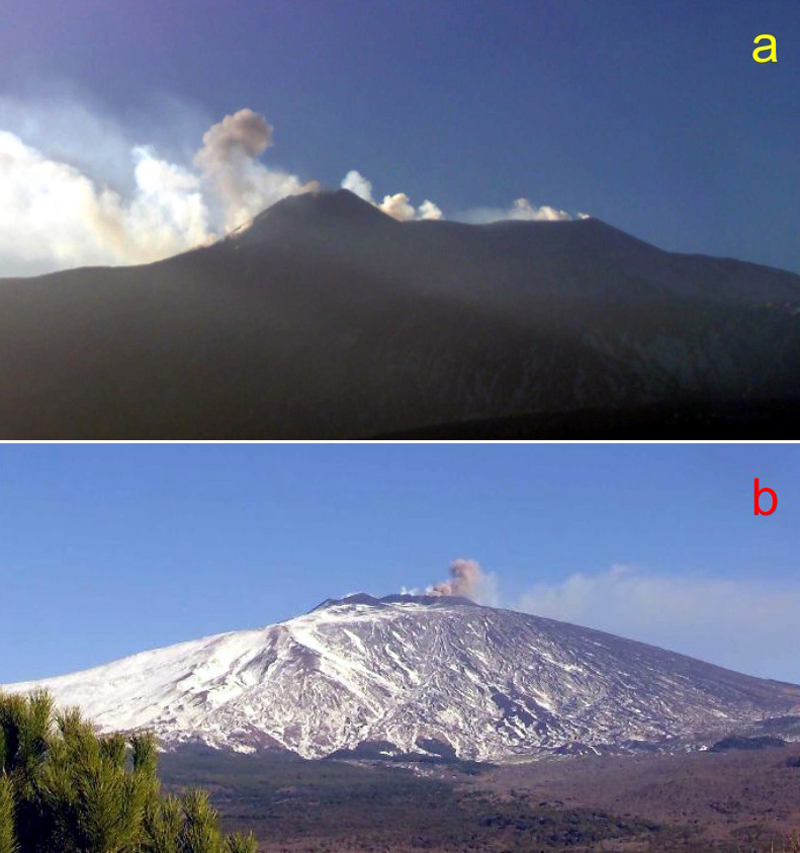 | Figure 257. A small ash emission from the BN crater on 16 March 2019 was recorded by the high-resolution webcams in Monte Cagliato, on the eastern slope of Etna (a) and in Bronte, on the west side (b). Courtesy of INGV (Report 12/2019, ETNA, Bollettino Settimanale, 11/03/2019 - 17/03/2019, data emissione 19/03/2019). |
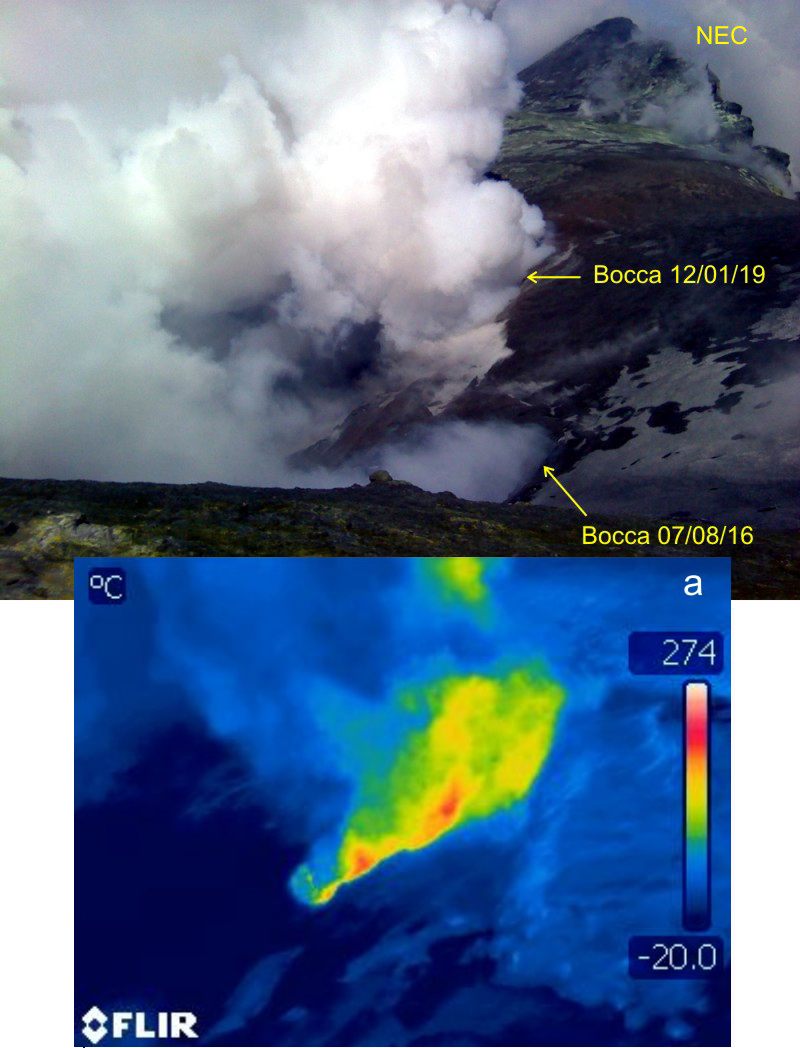 | Figure 258. Degassing continued at the vents along the E edge of Voragine crater at Etna on 30 March 2019, producing temperatures in excess of 250°C. In the background is the NE Crater (NEC) whose southern edge was affected by modest collapses in March 2019. Courtesy of INGV (Report 14/2019, ETNA, Bollettino Settimanale, 25/03/2019 - 31/03/2019, data emissione 02/04/2019). |
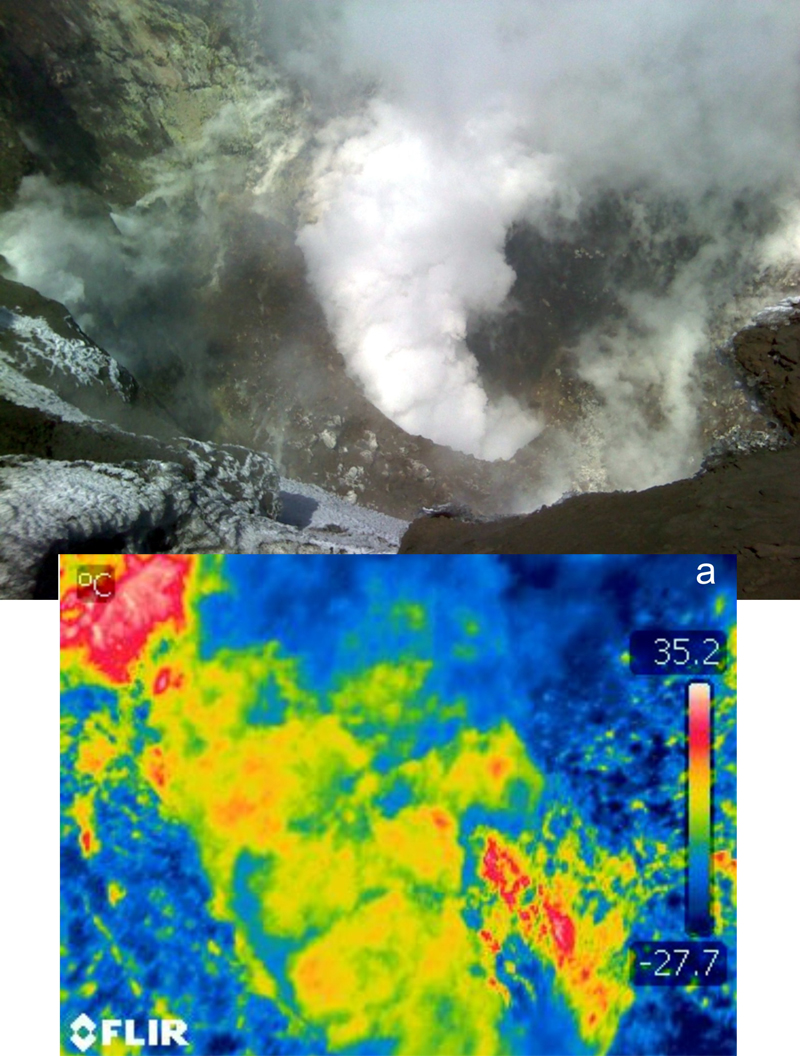 | Figure 259. Degassing continued from the vents located on the bottom of the NE Crater at Etna on 30 March 2019 as seen from the eastern edge with visual and thermal images. Courtesy of INGV (Report 14/2019, ETNA, Bollettino Settimanale, 25/03/2019 - 31/03/2019, (data emissione 02/04/2019). |
Information Contacts: Sezione di Catania - Osservatorio Etneo, Istituto Nazionale di Geofisica e Vulcanologia (INGV), Sezione di Catania, Piazza Roma 2, 95123 Catania, Italy (URL: http://www.ct.ingv.it/it/ ); Blog INGVvulcani, Istituto Nazionale di Geofisica e Vulcanologia (INGV); (URL: http://ingvvulcani.wordpress.com); MIROVA (Middle InfraRed Observation of Volcanic Activity), a collaborative project between the Universities of Turin and Florence (Italy) supported by the Centre for Volcanic Risk of the Italian Civil Protection Department (URL: http://www.mirovaweb.it/); Global Sulfur Dioxide Monitoring Page, Atmospheric Chemistry and Dynamics Laboratory, NASA Goddard Space Flight Center (NASA/GSFC), 8800 Greenbelt Road, Goddard, Maryland, USA (URL: https://so2.gsfc.nasa.gov/).
October 2019 (BGVN 44:10)  Cite this Report
Cite this Report
Five lava flows and numerous ash plumes and Strombolian explosions, April-September 2019
Italy's Mount Etna on the island of Sicily has had historically recorded eruptions for the past 3,500 years and has been erupting continuously since September 2013 through at least September 2019. Lava flows, explosive eruptions with ash plumes, and Strombolian lava fountains commonly occur from its summit areas that include the Northeast Crater (NEC), the Voragine-Bocca Nuova (or Central) complex (VOR-BN), the Southeast Crater (SEC, formed in 1978), and the New Southeast Crater (NSEC, formed in 2011). The newest crater, referred to as the "cono della sella" (saddle cone), emerged during early 2017 in the area between SEC and NSEC. Varying activity that included several lava flows, Strombolian activity, and numerous ash plumes from most of the active summit vents and several flank fissures occurred during April-September 2019, the period covered in this report, with information provided primarily by the Osservatorio Etneo (OE), part of the Catania Branch of Italy's Istituo Nazionale di Geofisica e Vulcanologica (INGV).
Degassing of variable intensity was typical activity from all the vents at Etna during much of April 2019. Intermittent ash emission and Strombolian activity occurred at Bocca Nuova, especially during the last week. Minor ash emissions were reported from NEC and NSEC the last week as well. Most of the activity at the summit during May 2019 was focused around the New South East Crater (NSEC); repeated Strombolian activity was witnessed from the E vent near the summit throughout the month. Beginning on 30 May, two fissures opened on the N and SE flanks of NSEC and produced lava flows that traveled E and SE across the W wall of the Valle del Bove. The flows ceased during the first week of June; activity for the rest of that month consisted of intermittent explosions with small ash plumes from Voragine and Bocca Nuova. Discontinuous Strombolian explosions and isolated ash emissions from NEC, NSEC, and Bocca Nuova characterized activity during the first half of July 2019; the explosions intensified at NSEC later in the month. A lava flow emerged from the lower NE flank of NSEC on 18 July that lasted for several days. Explosions produced substantial ash plumes from the NSEC summit crater, causing ashfall nearby, and a new flow emerged from a fissure on the S flank of NSEC on 27 July.
Explosions with intermittent ash emissions during August 2019 were focused primarily on the North East Crater (NEC), with occasional ash emissions from Bocca Nuova. These continued into early September. Activity increased to include Strombolian explosions with the ash emissions at NEC, Bocca Nuova, and Voragine where a scoria cone formed deep within the crater from continued Strombolian activity. A lava flow emerged from the base of the scoria cone on 18 September and was active for about four days, sending branches of lava into multiple areas of the adjacent Bocca Nuova crater. Ash emissions at NEC continued during the end of the month. The multiple episodes of varying activity during the period were reflected in the MIROVA thermal energy data; spikes of thermal activity that corresponded to periods of lava effusion were apparent late May-early June, multiple times in July, and during the second half of September (figure 260).
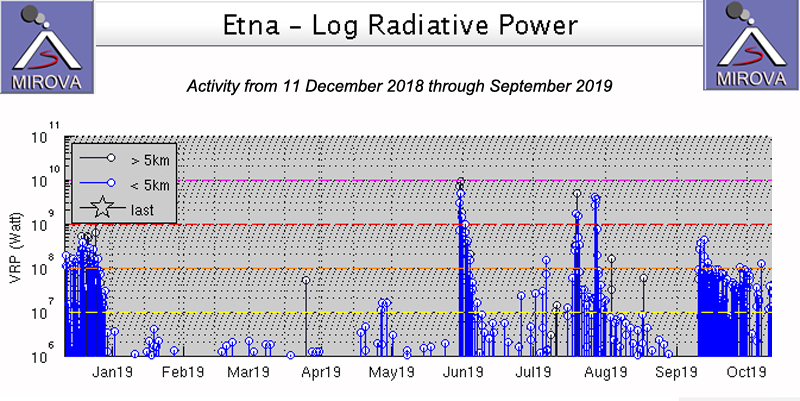 | Figure 260. The multiple episodes of varying activity at Etna from 11 December 2018 through September 2019 were reflected in the MIROVA thermal energy data; spikes of thermal activity were apparent in late April, late May-early June, multiple times in July, and during the second half of September. The largest energy spikes correlated with lava flows. Courtesy of MIROVA. |
Activity during April-May 2019. During a site visit to the summit on 1 April scientists from INGV noted weak degassing from both pit craters, BN-1 and BN-2, within Bocca Nuova (BN); the Voragine (VOR) and North East Crater (NEC) were emitting abundant steam and gas emissions. The New Southeast Crater (NSEC) also had significant fumarolic activity concentrated primarily on the crater rim along with gas plumes visible from both the E vent and the 24 December 2018 flank fissure (figure 261). A brief episode of ash emission was observed from BN on the morning of 8 April. Persistent pulsating flashes of incandescence were noted at the E vent of NSEC during the second week. A new vent was observed in the inner wall of the Voragine crater during an inspection on 19 April, located immediately below the vent which formed on 12 January 2019 (figure 262). During the last week of April there were ten episodes of ash emission from BN, two from NEC, and one produced by the E vent at NSEC. Strombolian activity was observed on the morning of 28 April at BN-1, and persistent incandescence was visible from the E vent of NSEC. Early on 30 April both BN-1 and BN-2 were producing explosions every few seconds. Coarse ejecta (lapilli and bombs) rose higher than the crater rim; most fell back within the crater, but some material was observed on the rim the following day.
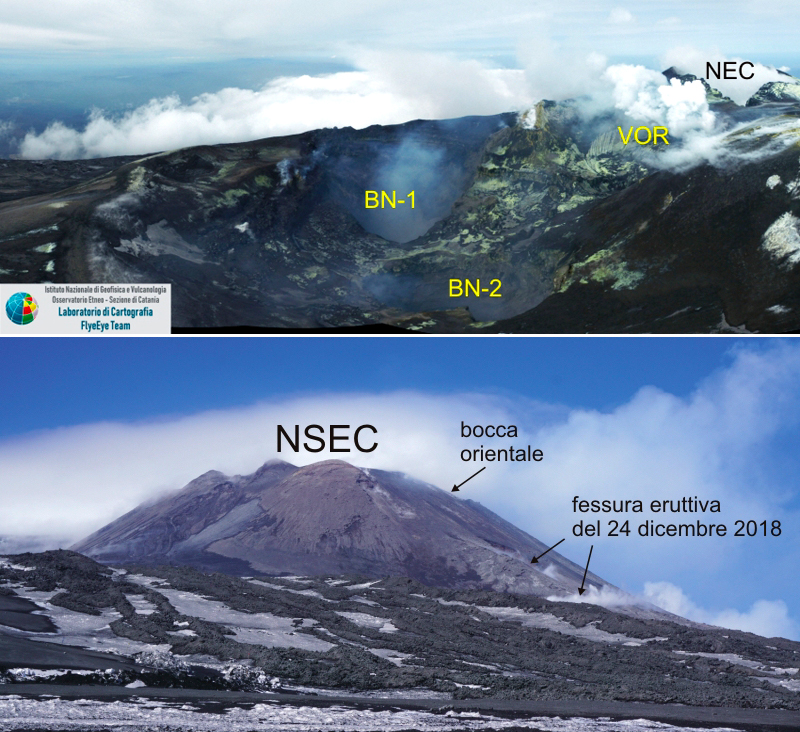 | Figure 261. During a site visit to the summit of Etna on 1 April 2019 scientists from INGV noted weak degassing from both pit craters, BN-1 and BN-2, within Bocca Nuova (BN); Voragine (VOR) and North East Crater (NEC) were emitting abundant steam and gas emissions, and the New Southeast Crater (NSEC) also had significant fumarolic activity concentrated primarily on the crater rim along with gas plumes visible from both the E vent (bocca orientale) and the 24 December 2018 flank fissure. Courtesy of INGV, photos by Laboratorio di Cartografia FlyeEye Team (Report 15/2019, ETNA, Bollettino Settimanale, 01/04/2019 - 07/04/2019, data emissione 09/04/2019). |
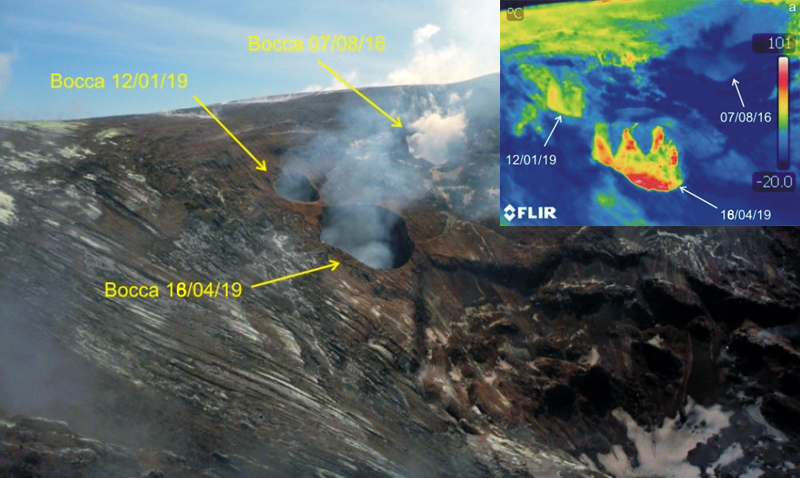 | Figure 262. A new vent was observed at the W rim of Etna's Voragine crater on 19 April 2019. INGV scientists concluded that it likely formed during 17-18 April. It was located immediately below a pit crater that opened on 12 January 2019. Inset shows thermal image of the vents. Courtesy of INGV (Report 17/2019, ETNA, Bollettino Settimanale, 15/04/2019 - 21/04/2019, data emissione 24/04/2019). |
Activity at the summit during May 2019 was focused around the New South East Crater (NSEC). Discontinuous Strombolian activity was observed at the E vent of NSEC early on 2 May accompanied by ash emissions from the summit vent that rose about 1,000 m (figure 263). Explosion frequency increased beginning on 5 May with weak and discontinuous ash emissions reported from the NSEC summit for the next several days; ash emissions were also observed from the Saddle vent and the NSEC E vent during 6-8 May. In addition to ash emissions and Strombolian activity continuing from both the summit and E vents at NSEC during the third and fourth weeks, overnight on 17-18 May several larger Strombolian explosions sent pyroclastic ejecta tens of meters above the crater rim (figure 264). The explosion intervals ranged from a few minutes to a few hours. The new vent that had formed at Voragine in mid-April coalesced with the 12 January vent during the second week of May; dilute ash was observed from the BN-1 vent on 23 May.
 | Figure 263. Strombolian activity at the E vent of NSEC at Etna was accompanied by ash emission on 2 May 2019. Left image is from the thermal camera at La Montagnola and the right image is from Tremestieri Etneo, taken by B. Behncke. Coutesy of INGV (Report 19/2019, ETNA, Bollettino Settimanale, 29/04/2019 - 05/05/2019, data emissione 07/05/2019). |
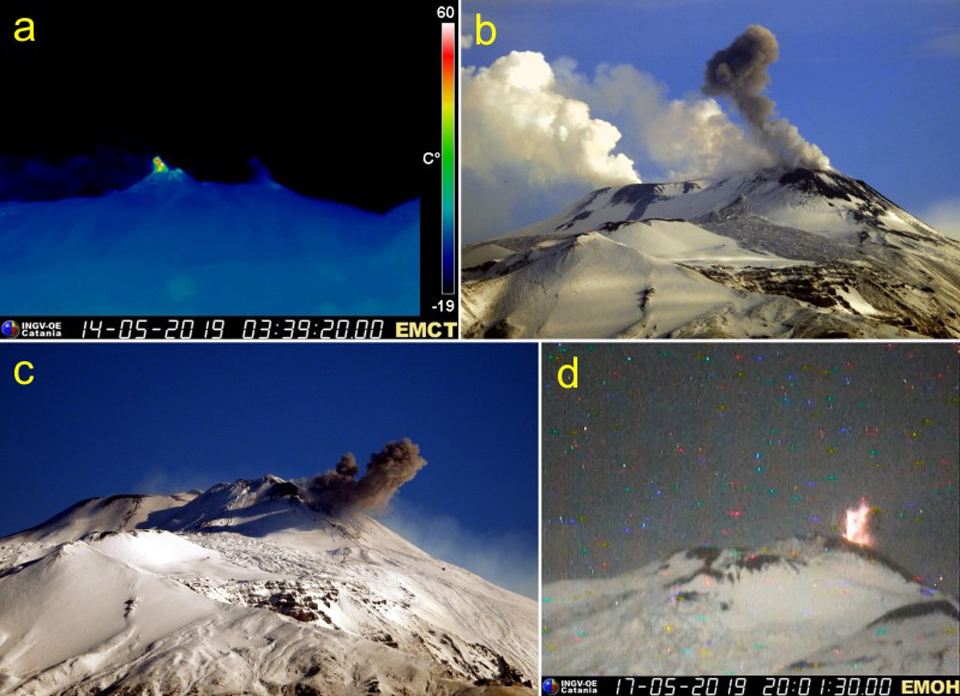 | Figure 264. Strombolian activity sent ejecta from a vent at Etna's NSEC crater on 14 May 2019 (a) and was captured by the Monte Cagliato thermal camera. Ash emission from the same vent was also visible that day (b) and on 17 May (c). Strombolian explosions from the E Vent of NSEC on 17 May (d) were captured by the EMOH (Montagnola) webcam. Courtesy of INGV (Report 21/2019, ETNA, Bollettino Settimanale, 13/05/2019 - 19/05/2019, data emissione 21/05/2019). |
A fissure opened at the base of the N flank of NSEC shortly after midnight on 30 May 2019 at an elevation of about 3,150 m (figure 265). It produced mild explosive activity and a lava flow that spread towards the W wall of the Valle del Bove. By 0800 UTC the flow had reached an elevation of 2,050 m. A second fissure opened at 0335 the same morning at the base of the SE flank of NSEC at an elevation of 3,050 m. The lava flowed along the W wall of the Valle del Bove towards Serra Giannicola Grande and had reached an elevation of 2,260 m by 0815. Strong winds dispersed ash emissions from the fissures to the NE for much of the day; ashfall occurred in Linguaglossa (figure 266). The Toulouse VAAC reported an ash plume drifting ENE at 3.9 km altitude on 30 May. Samples of the ash that were collected and analyzed were shown to be about 70% lithic clasts, 25% crystals, and about 5% juvenile material. It became clear the next day that two vents along the SE-flank fissure initially produced separate flows that coalesced into a single flow which expanded along the W wall of Valle del Bove. By 0830 on 31 May that flow had reached an elevation of 1,700 m at the base of Serra Giannicola Grande. The fissure at the base of the N flank continued to propagate along the W wall of Valle del Bove also, and had reached an elevation of 2,050 near Monte Simone by 1030 on 31 May (figure 267). When the new eruptive activity began on 29 May, inclinometers measured slight but prolonged deflation of the volcano.
 | Figure 265. Two fissures opened at Etna during the early morning of 30 May 2019. One started from the base of the N flank of the NSEC/SEC complex and flowed E towards the Valle del Bove, and a second fissure with two vents opened on the SE flank of NSEC and flowed SE towards Serra Giannicola Grande. Mapping of the lava flows were done with drones, using the Sentinel 2 satellite images of 30 May and thermal images from 2 June taken at the Schiena dell'Asino. Courtesy of INGV (Report 23/2019, ETNA, Bollettino Settimanale, 27/05/2019 - 02/06/2019, data emissione 04/06/2019). |
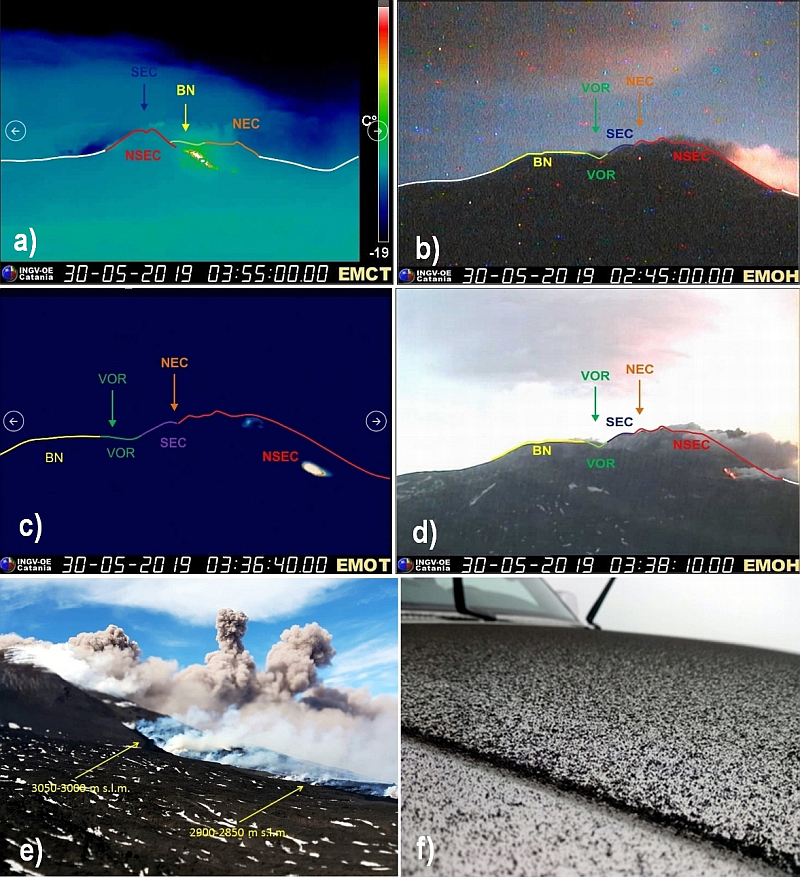 | Figure 266. Lava flows broke out at Etna on both the N and SE flanks of NSEC on 30 May 2019. Ash emissions were also produced from the fissures. The northern flank fissure is seen from the (a) Monte Cagliato thermal camera (EMCT) and (b) the Montagnola high definition camera (EMOH). The fissure on the SE flank was seen from the Montagnola thermal (c) and high definition (d) (EMOH) webcams. Ash emissions and lava flows were visible on the flank (e) and ashfall was recorded in Linguaglossa (f). Courtesy of INGV (Report 23/2019, ETNA, Bollettino Settimanale, 27/05/2019 - 02/06/2019, data emissione 04/06/2019). |
 | Figure 267. Images of the active lava flows at Etna on 31 May 2019 indicated the extent of the flow activity. Lava was flowing from two vents along a fissure on the SE flank (a and b, drone images courtesy of the FlyEye Team OE). The thermal image of the flow (c) is from Schiena dell'Asi, the visible photo (d) is also taken from Schiena dell'Asi by L. Lodato. The thermal (e) and visual (f) images of the active lava fields were taken from the Monte Cagliato (EMCT) thermal webcam and the Monte Cagliato (EMCH) high definition webcam. Courtesy of INGV (Report 23/2019, ETNA, Bollettino Settimanale, 27/05/2019 - 02/06/2019, data emissione 04/06/2019). |
Activity during June-July 2019. The flow from the N flank of NSEC ceased advancing on 1 June 2019, but the active spattering continued from the fissure on the SE flank for a few more days. The SE-flank flow had reached 1,700 m elevation in the Valle del Bove by the afternoon of 2 June (figure 268). The intensity and frequency of the explosions decreased over the next few days, with the active flow front receding back towards the vent until it stopped moving on 6 June. The NE rim of the summit cone at NSEC appeared lowered by several meters after the eruption ceased. The lava flows and explosions of 30 May-2 June produced persistent SO2 emissions that drifted E and N for over 800 km (figure 269).
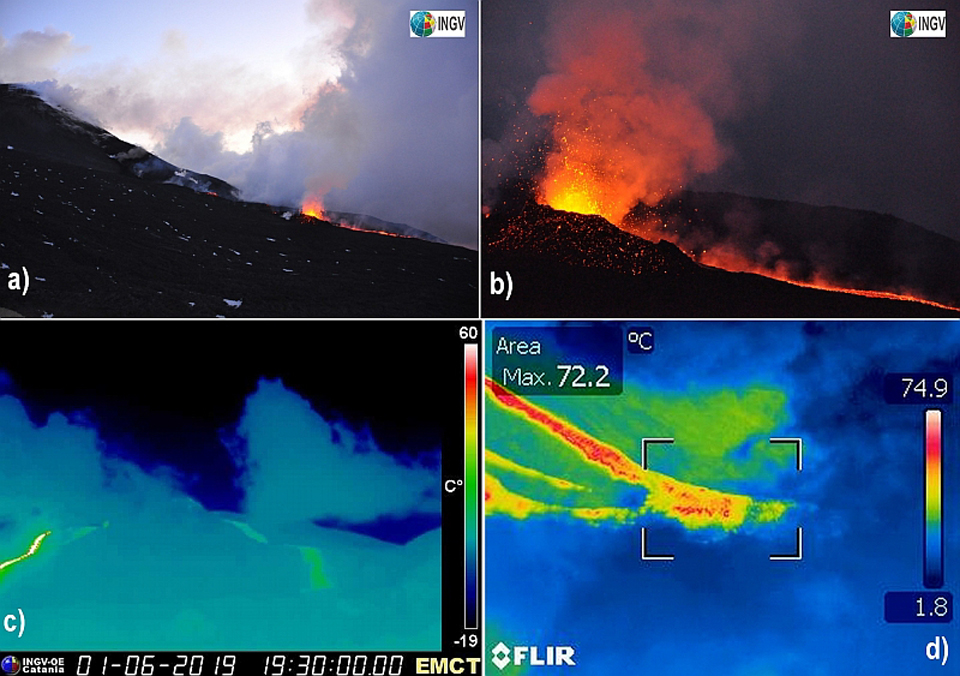 | Figure 268. During the morning of 1 June 2019 Strombolian and effusive activity at Etna continued from the fissure on the SE flank of NSEC (a and b, photos by M. Neri). By the evening of 1 June there was only one remaining arm of the flow that was active (c) as seen in the Monte Cagliato (EMCT) thermal webcam. The following evening, 2 June, another thermal image(d, photo by S. Scollo) showed the remaining active arm. Courtesy of INGV (Report 23/2019, ETNA, Bollettino Settimanale, 27/05/2019 - 02/06/2019). |
 | Figure 269. Active lava flows and Strombolian activity at Etna during 30 May-2 June 2019 contributed to significant SO2 plumes that drifted E and NE from the volcano during this time, extending as far as 800 km from the source. Captured by the TROPOMI instrument on the Sentinel 5P satellite, courtesy of NASA Goddard Space Flight Center. |
Activity for the rest of June 2019 moved to the other craters, mainly Voragine, after the flows ceased at NSEC. On the morning of 6 June there were sporadic ash emissions from NEC that quickly dissipated. A small ash plume appeared from Bocca Nuova (BN) on 11 June. An explosive sequence that began on 13 June from the crater floor of Voragine continued intermittently through the third week of the month (figure 270) and produced several small ash plumes. A new vent opened on the crater floor and produced a small ash plume; ejecta also landed on the crater rim several times. On 22 June small, discontinuous ash emissions were produced from BN-1; they dispersed rapidly, but intermittent explosions continued during the following week. By the end of the month, only BN was exhibiting activity other than degassing; incandescence from the crater was seen during the night of 24 June and three isolated ash emissions were seen in the webcams on 26 June.
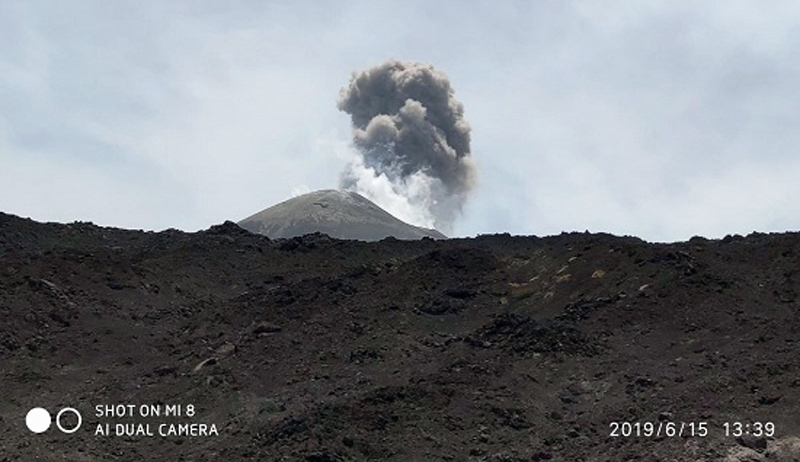 | Figure 270. An ash plume at Etna rose from the Voragine crater on 15 June 2019 during a series of intermittent explosions. Image taken from the Torre del Filosofo by M. Coltelli. Courtesy of INGV (Report 25/2019, ETNA, Bollettino Settimanale, 10/06/2019 - 16/06/2019, data emissione 18/06/2019). |
Discontinuous Strombolian explosions and isolated ash emissions characterized activity during the first half of July 2019. Pulsating degassing from NEC produced ash emissions on 2 and 3 July (figure 271), and incandescence on 4 and 5 July. Intense degassing was observed at NSEC during 1-5 July, this turned into isolated ash emissions and Strombolian activity on 5 and 6 July from the E vent with explosions occurring every 1-5 minutes; the ejecta landed on the upper E flank. Dilute ash emissions were observed from Bocca Nuova on 6 July. NEC produced two major ash emissions on the evening of 8 July and the late morning of 13 July. The ash plumes quickly dispersed in the summit area. Strombolian activity at the E vent of NSEC was witnessed on 14 July. Explosive activity at Bocca Nuova remained deep within the crater during mid-July. Steam produced by the 13 June 2019 vent on the floor of Voragine occasionally contained dilute ash. During 15-17 July sporadic explosions were observed at NSEC accompanied by small puffs of ash that rapidly dispersed.
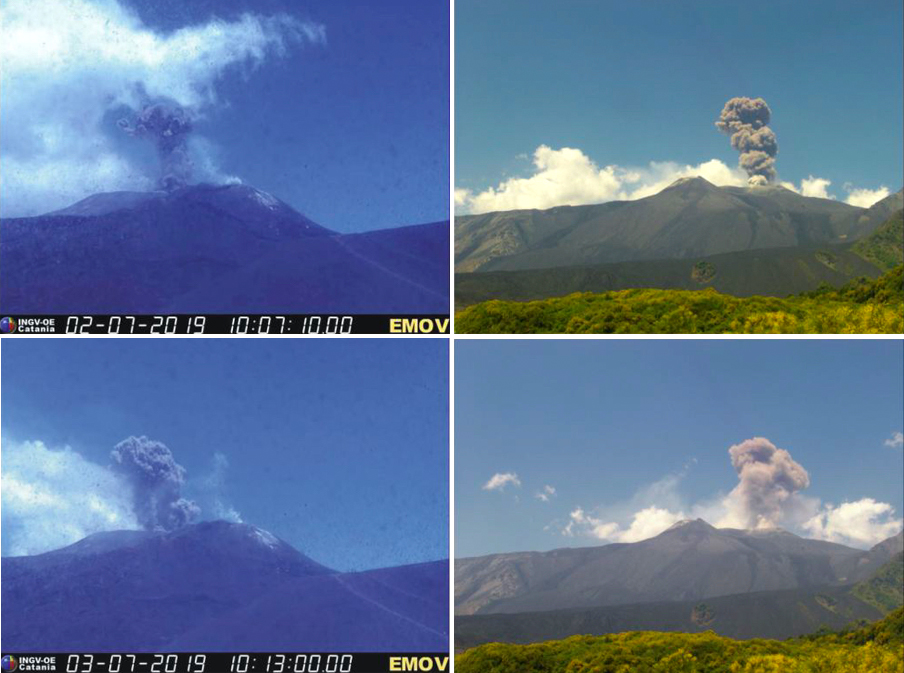 | Figure 271. Surveillance cameras at Etna captured images of explosions with ash emissions from NEC on 2 (top) and 3 (bottom) July 2019. The left images are from Montagnola and the right images are from Monte Cagliato. Courtesy of INGV (Report 28/2019, ETNA, Bollettino Settimanale, 01/07/2019 - 07/07/2019, data emissione 09/07/2019). |
Beginning early on 18 July, Strombolian activity increased at NSEC from an explosion every 1-2 minutes to multiple explosions per minute in the following hours. Continuous activity during the evening decreased sharply around 2200. About an hour later visual and thermal surveillance cameras on Monte Cagliato recorded the opening of a vent on the lower NE flank of NSEC; lava slowly advanced from the vent towards Valle del Leone (figures 272 and 273). Explosive activity resumed at the NSEC summit a few hours later, accompanied by occasional ash emissions from NEC and Bocca Nuova. Explosions tapered off briefly by noon on 19 July, but a sudden increase in explosive activity during the afternoon of 19 July produced Strombolian activity and sporadic ash emissions from three vents inside the NSEC crater. Ashfall was reported that evening in communities on the S flank of Etna. The Toulouse VAAC reported significant ash above the summit at 3.7 km altitude. Activity declined again later that evening at NSEC, but abundant ash emission began at NEC that lasted until the morning of 20 July. A new phase of explosive activity began at NSEC around 0700 on 20 July with an ash plume and an increase in lava emission from the vent on the NE flank (figure 274). By the evening of 20 July only a small amount of material was feeding the lava flow; the farthest advanced fronts were at an elevation around 2,150 m, above Monte Simone. A few small ash emissions were observed at Bocca Nuova on 21 July.
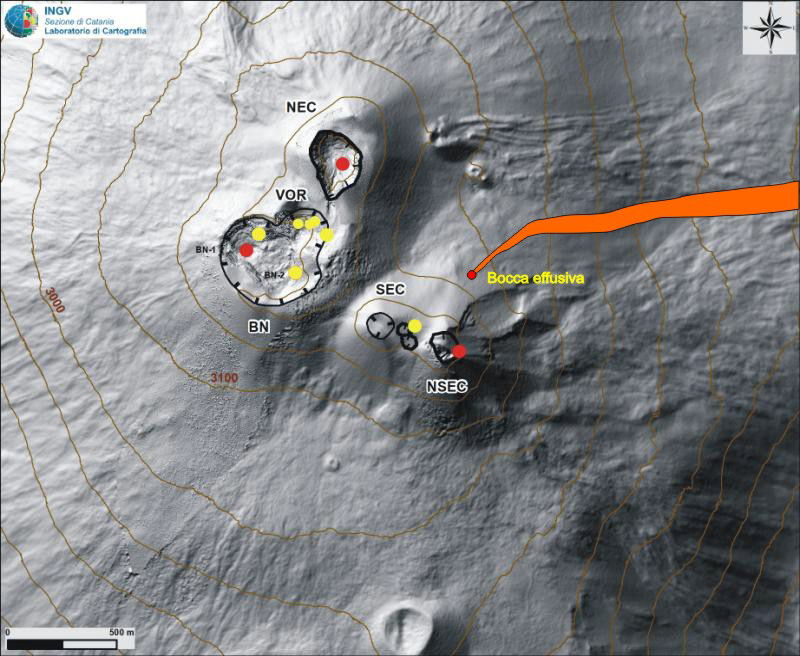 | Figure 272. Map of the summit craters of Etna showing the active vents and the lava flow of 19-21 July 2019. The base is modified from a 2014 DEM created by Laboratorio di Aerogeofisica-Sezione Roma 2. Black hatch marks indicate the crater rims: BN = Bocca Nuova, with NW BN-1 and SE BN-2; VOR = Voragine; NEC = North East Crater; SEC = South East Crater; NSEC = New South East Crater. Red circles indicate areas with ash emissions and/or Strombolian activity, yellow circles indicate steam and/or gas emissions only. Courtesy of INGV (Report 30/2019, ETNA, Bollettino Settimanale, 15/07/2019 - 21/07/2019, data emissione 23/07/2019). |
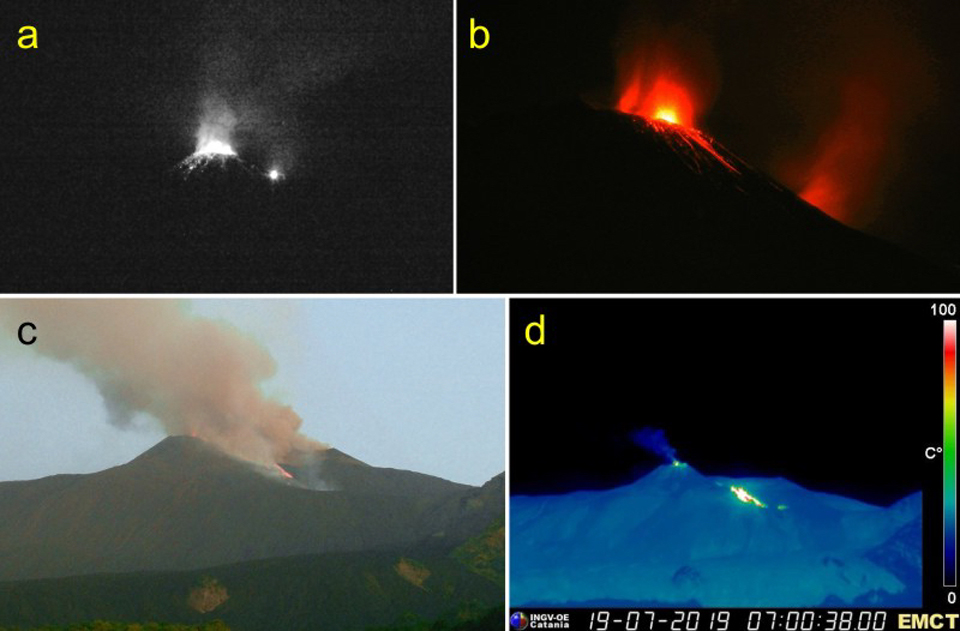 | Figure 273. Activity at Etna on 18 and 19 July 2019 included a new lava flow from a vent on the NE flank of NSEC and Strombolian activity at the NSEC summit vent. (a) Start of the flow from a vent on the NE flank of NSEC seen from the high-resolution camera at Monte Cagliato (EMCH) at 2307 UTC on 18 July. (b) Strombolian activity at the NSEC and glow of the new lava flow on the right seen from Tremestieri Etneo, 2347 that evening. (c) A new advancing lava flow and brown ash emission from NEC seen from the EMCH camera, 0338 on 19 July; (d) lava flow seen from the thermal camera at Monte Cagliato, 0700 on 19 July. Courtesy of INGV (Report 30/2019, ETNA, Bollettino Settimanale, 15/07/2019 - 21/07/2019, data emissione 23/07/2019). |
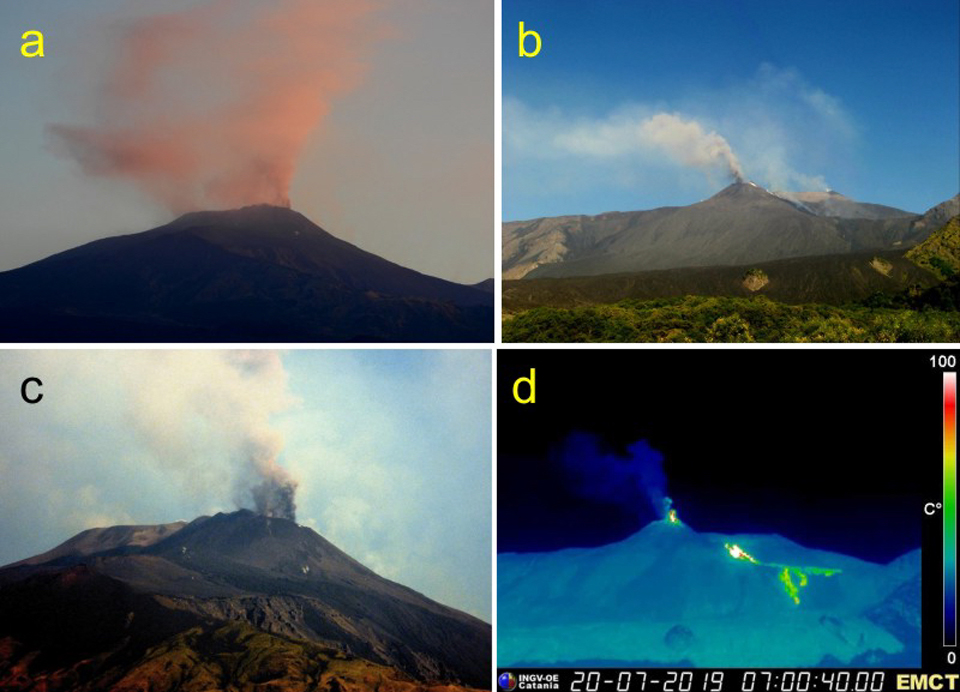 | Figure 274. Activity at Etna on 20 July 2019 included (a) ash emission from both NSEC and NEC craters at 0402 seen from Tremestieri Etneo, (b) ash from NSEC and the active flow on the SE flank at 0608 seen from the Monte Cagliato high-resolution camera, (c) ash emission from NSEC at 0700 seen by Tremesteieri Etneo, and (d) explosive activity at NSEC and the lava flow on the W wall of the Valle del Bove at 0700 seen from the Monte Cagliato thermal camera. Courtesy of INGV (Report 30/2019, ETNA, Bollettino Settimanale, 15/07/2019 - 21/07/2019, data emissione 23/07/2019). |
Visible and thermal images taken on 24 July 2019 indicated only degassing at BN-1 and BN-2, and limited degassing from low-temperature fumaroles from the multiple vents at VOR (figure 275). After a few days of quiet, NSEC resumed discontinuous ash emissions on 25 July. A sudden increase in the amplitude of volcanic tremor was noted early on 27 July, which was followed a few hours later by the opening of a new eruptive fissure on the S flank of NSEC (figure 276). Explosive activity intensified and produced a dense ash-rich plume that dispersed to the E at an estimated altitude of 4.5-5 km. A thin layer of ash was reported in Giarre, Riposto, and Torre Archirafi. A lava flow emerged from the S portion of the fissure and expanded SW and S. By 1135 the most advanced front had reached and passed the N side of the base of the Barbagallo Mountians at an elevation of about 2,850 m. It continued to spread down into the area between Monte Frumento Supino and the pyroclastic cones of 2002-2003 (figure 277). A series of particularly strong explosions occurred from NSEC around midday, producing an ash plume that rose to 7.5 km altitude. By this time the most advanced lava fronts were located at an elevation of about 2,600 m, but they were rapidly advancing SSW towards Monte Nero, surrounding Monte Frumento Supino from the W. Explosive activity decreased significantly early in the morning on 28 July; flow activity also slowed around the same time. Occasional puffs of reddish-brown ash were noted from NEC during the morning as well. The explosions and the lava effusion ceased on the evening of 28 July. An isolated ash emission from Bocca Nuova in the early hours of 31 July was the last activity reported in July. A substantial SO2 plume (6.59 DU) from the explosions on 27 July had drifted to the E coast of the Adriatic Sea by midday on 28 July and was detected in satellite instruments.
 | Figure 275. Degassing was the only activity occurring at the multiple vents at Etna's Voragine crater on 24 July 2019. The joined pit crater from the 12 January and 18 April 2019 vents is at the upper left; the newest vent formed 16 June 2019 is at lower left and appears cool in the thermal image inset a. Photo and annotations by S. Branca. Courtesy of INGV (Rep. N° 31/2019, ETNA, Bollettino Settimanale, 22/07/2019 - 28/07/2019, data emissione 30/07/2019). |
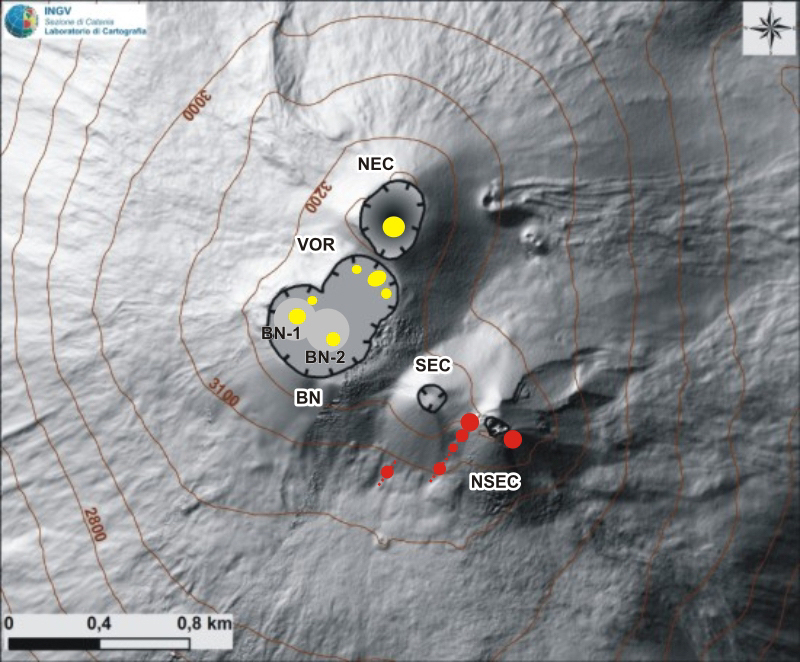 | Figure 276. A new eruptive fissure at Etna opened on the S flank of NSEC on 27 July 2019 (line of red circles). The base map is modified from a 2014 DEM created by Laboratorio di Aerogeofisica-Sezione Roma 2. Black hatch marks indicate the crater rims: BN=Bocca Nuova, with NW BN-1 and SE BN-2; VOR = Voragine; NEC = North East Crater; SEC = South East Crater; NSEC = New South East Crater. Red circles indicate areas with ash emissions and/or Strombolian activity, yellow circles indicate steam and/or gas emissions only. Courtesy of INGV (Report 31/2019, ETNA, Bollettino Settimanale, 22/07/2019 - 28/07/2019, data emissione 30/07/2019). |
 | Figure 277. Lava flows and substantial ash emissions were reported at Etna on 27 July 2019. The lava flow at 1216 was located at about 2,600 m elevation (a). A thermal image of the S flank of NSEC showed the extent of the flow activity (b). A large ash plume formed after several explosions at NSEC at 1221 (c). Thermal images of the emissions were captured by the Montagnola (EMOT) webcam and by an INGV operator (d, e). Photos by S. Branca (a), B. Behncke (c), and E. Pecora (b, e). Courtesy of INGV (Report 31/2019, ETNA, Bollettino Settimanale, 22/07/2019 - 28/07/2019, data emissione 30/07/2019). |
Activity during August-September 2019. Activity during August 2019 was focused primarily on the North East Crater (NEC), with occasional ash emissions from Bocca Nuova. The plumes were occasionally dense and dark brown from NEC. Weak emissions of dilute ash from NEC quickly dispersed on the morning of 4 August, followed by more intermittent ash emissions during 6-10 August; a few had significant concentrations of ash that drifted SE. Part of the N rim of NEC collapsed during the explosions of early August (figure 278). During a site inspection to the summit by INGV personnel on 16 August, continuous degassing at Bocca Nuova was interrupted every 10-15 minutes by explosions, but no ejecta was noted. Discontinuous emissions from NEC formed small ash plumes that rose a few hundred meters and remained in the summit area (figure 279). Thermal surveys that day indicated high temperatures of about 800°C along a 10-m-fracture zone on the northern rim of VOR. Ash emissions from NEC were persistent through 20 August when they decreased significantly; a few explosions had dilute ash emissions from Bocca Nuova that day and the next (figure 280). Sulfur dioxide emissions were notable during 19-22 August, drifting S and W hundreds of kilometers before dissipating. Isolated and dilute ash from NEC early on 28 August was interpreted by INGV as resulting from collapses along the inner crater walls. During site inspections on 27, 28, and 30 August, deep explosions from Bocca Nuova were heard, and degassing was observed at all of the summit vents.
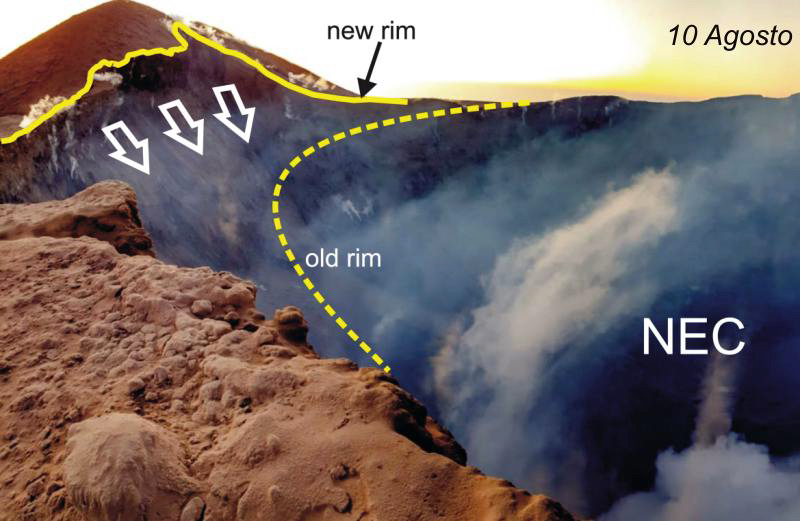 | Figure 278. Part of the N rim of the NEC crater at Etna collapsed during explosions in early August 2019. In this image from 10 August 2019 the collapsed N wall is shown by white arrows, the old crater rim is the dashed yellow line, and the new rim is the solid yellow line. Photo by Michele Mammino, courtesy of INGV (Report 33/2019, ETNA, Bollettino Settimanale, 05/08/2019 - 11/08/2019, data emissione 13/08/2019). |
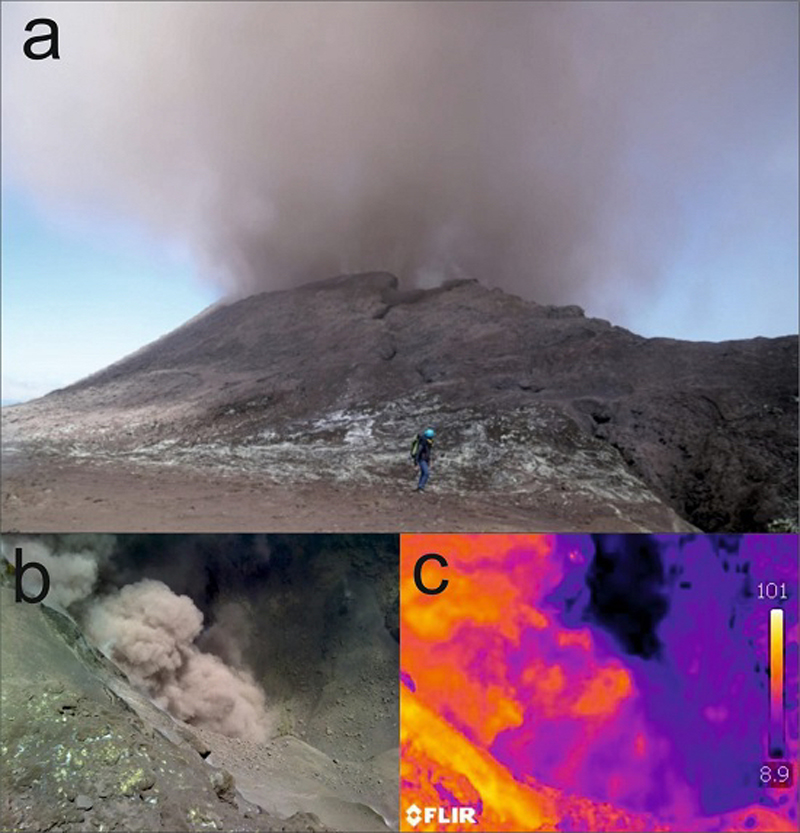 | Figure 279. Discontinuous emissions at Etna on 16 August 2019 from the NEC crater formed small ash plumes that rose a few hundred meters and remained in the summit area (a). Smaller ash plumes remained within the crater (b and c). Courtesy of INGV (Report 34/2019, ETNA, Bollettino Settimanale, 12/08/2019 - 18/08/2019, data emissione 20/08/2019). |
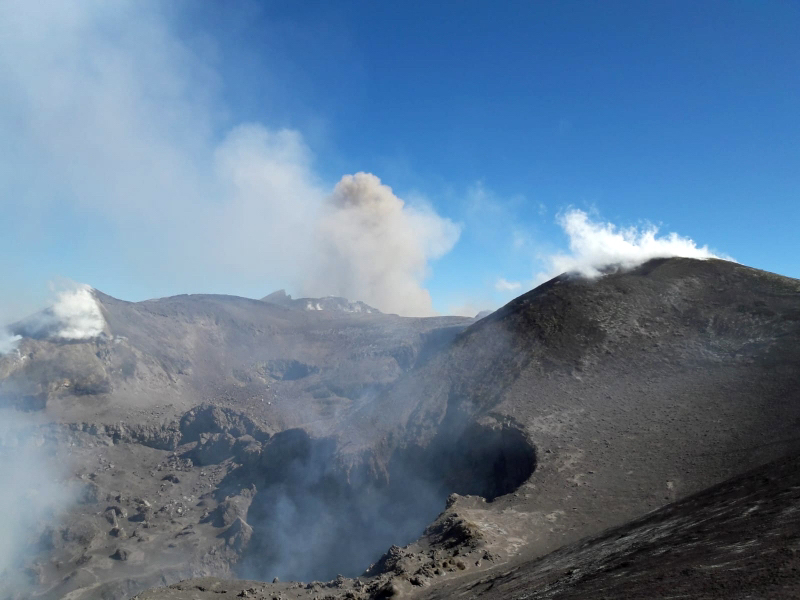 | Figure 280. In the foreground weak degassing occurs on 21 August 2019 at Etna's BN-2 vent inside Bocca Nuova while a small ash plume in the background rises from NEC. Photo by F. Ciancitto, courtesy of INGV (Report 35/2019, ETNA, Bollettino Settimanale, 19/08/2019 - 25/08/2019, data emissione 27/08/2019). |
Activity during September 2019 began with discontinuous and dilute ash emissions from NEC and Bocca Nuova, as well as episodes of Strombolian activity at both vents. This was followed by increased Strombolian activity, ash emissions, and a lava flow at Voragine. Isolated ash emissions occurred at NEC and VOR on 4 and 5 September. Sporadic deep explosions were heard from BN-1 during a site inspection on 7 September. Overnight during 7-8 September the visual webcams recorded incandescence at NEC and pyroclastic ejecta observed outside the crater rim that coincided with increased tremor activity. A more intense episode of Strombolian activity began the following evening at NEC. Activity was continuous from 1800 on 9 September to 0500 on 10 September, and produced dilute ash emissions that quickly dispersed (figure 281). Slight ashfall was reported in Piedimonte Etneo, Giarre-Riposto, and Rifugio Citelli. Continuous puffs of dilute ash were observed beginning at dawn on 11 September with sporadic ejecta again landing outside the crater rim. Significant SO2 plumes were measured by satellite instruments on 10 and 11 September (figure 282).
 | Figure 281. Activity at Etna overnight during 9-10 September 2019 included Strombolian activity and dilute ash emissions from NEC that were observed from webcams on the S, W, and E flanks. Courtesy of INGV (Report 38/2019, ETNA, Bollettino Settimanale, 09/09/2019 - 15/09/2019, data emissione 17/09/2019). |
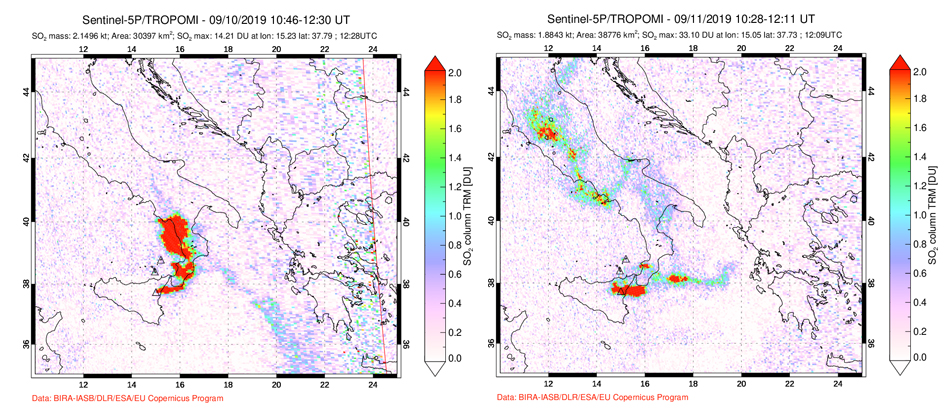 | Figure 282. Significant SO2 plumes from Etna were detected on 10 and 11 September 2019. Increased Strombolian activity was reported by INGV from the NEC crater during 9-11 September. Courtesy of NASA Goddard Space Center. |
In addition to the Strombolian activity at NEC on 12 September, ash emissions began that morning at VOR. They increased in frequency and then transitioned to near-continuous Strombolian activity that produced ejecta which landed in the base of the adjacent Bocca Nuova crater. The explosions from the Strombolian activity were felt in Zafferana Etnea, Aci S. Antonio, Pedara, and neighboring areas. On 13 September the webcams observed multiple periods of continuous ash emissions from NEC and short, intense pulses of ash from VOR that accompanied Strombolian activity; coarse ejecta rose 20 m above and landed outside of the crater rim, producing impact craters on the W side of the summit between VOR and BN. The vent that sourced the Strombolian activity was located in the deepest part of the Voragine crater. By 15 September, continued ejecta had formed a scoria cone around the vent inside VOR (figure 283).
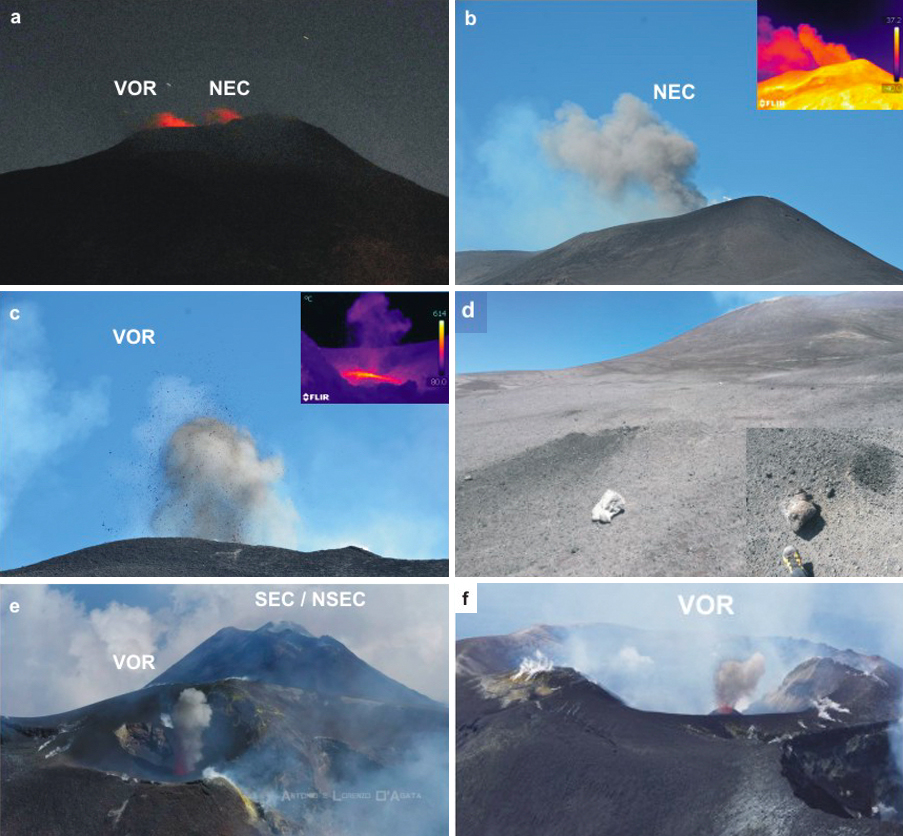 | Figure 283. On 13 September 2019 Strombolian activity at Etna's NEC and VOR craters increased (a). INGV personnel observed an ash emission from NEC (b), a Strombolian explosion with ejecta from VOR (c), and impact craters from the ejecta around the rim (d). The continued activity at VOR produced a scoria cone inside the crater that grew noticeably between 13 (e) and 15 (f) September. Photos (a) and (e) courtesy of L. D'Agata, photo (f) by B. Behncke. Courtesy of INGV (Report 38/2019, ETNA, Bollettino Settimanale, 09/09/2019 - 15/09/2019, data emissione 17/09/2019). |
Explosive activity inside VOR increased on the afternoon of 18 September 2019. Pyroclastic ejecta and ash erupted from several vents and reached heights of several tens of meters. A lava flow emerged from the W base of the scoria cone and headed S, advancing several hundred meters (figure 284). It then flowed over the saddle that divides VOR and BN, split into two branches, and entered Bocca Nuova. One stream poured into BN-1, and another stopped near the edge of the BN-2 pit crater. By 22 September the flow was cooling, but strong Strombolian activity continued inside Voragine. NEC was characterized by large-scale ash emissions during the end of September, including one in the morning of 27 September that sent a plume over the S flank of Etna before dissipating (figure 285). Strombolian activity continued within Bocca Nuova during the last week of the month.
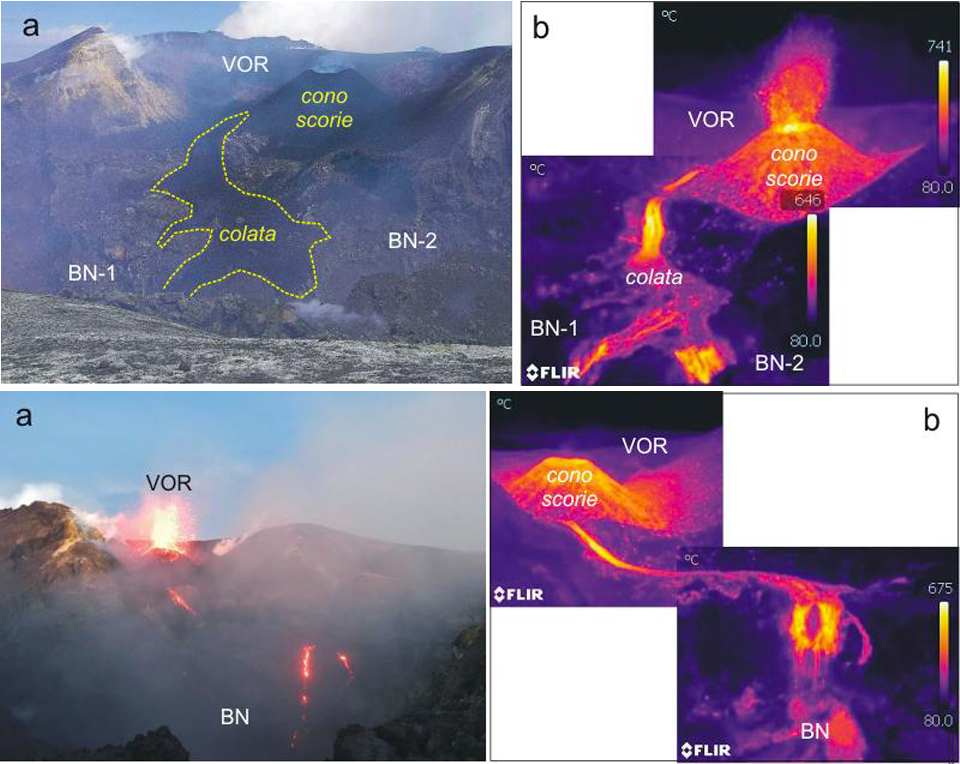 | Figure 284. Significant Strombolian and lava flow activity at Etna affected the Voragine crater on 18 and 19 September 2019. Visible and thermal images of the scoria cone (cono scorie) and lava flow (colata) inside Etna's large Voragine crater on 19 September 2019 (top) were taken from the southern edge of BN. Photo by F. Ciancitto. The bottom images were taken from the SW rim of BN on 18 September (left) by M. Tomasello and (right) 19 September by INGV personnel. Courtesy of INGV (Report 39/2019, ETNA, Bollettino Settimanale, 16/09/2019 - 22/09/2019, data emissione 24/09/2019). |
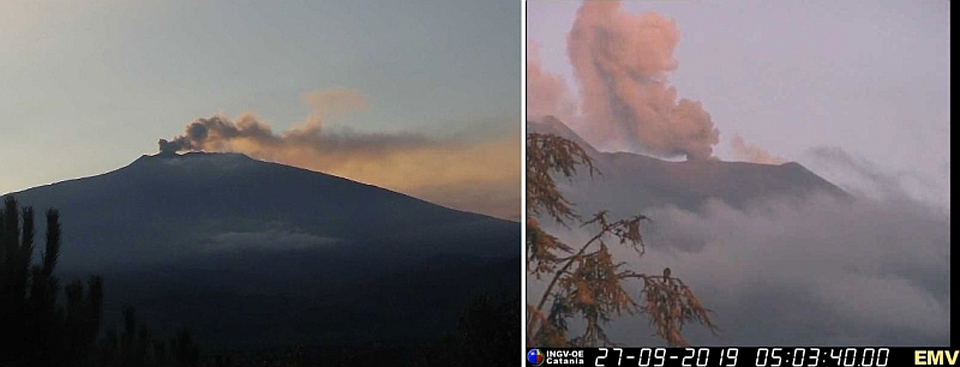 | Figure 285. An ash emission from Etna's NEC crater early on 27 September 2019 sent a plume drifting S before dissipating. It was captured by both the high-definition webcam of Bronte (EBVH, left) and the Milo (EMV) webcam. Courtesy of INGV (Report 40/2019, ETNA, Bollettino Settimanale, 23/09/2019 - 29/09/2019, data emissione 01/10/2019). |
Information Contacts: Sezione di Catania - Osservatorio Etneo, Istituto Nazionale di Geofisica e Vulcanologia (INGV), Sezione di Catania, Piazza Roma 2, 95123 Catania, Italy (URL: http://www.ct.ingv.it/it/ ); MIROVA (Middle InfraRed Observation of Volcanic Activity), a collaborative project between the Universities of Turin and Florence (Italy) supported by the Centre for Volcanic Risk of the Italian Civil Protection Department (URL: http://www.mirovaweb.it/); Global Sulfur Dioxide Monitoring Page, Atmospheric Chemistry and Dynamics Laboratory, NASA Goddard Space Flight Center (NASA/GSFC), 8800 Greenbelt Road, Goddard, Maryland, USA (URL: https://so2.gsfc.nasa.gov/); Toulouse Volcanic Ash Advisory Center (VAAC), Météo-France, 42 Avenue Gaspard Coriolis, F-31057 Toulouse cedex, France (URL: http://www.meteo.fr/aeroweb/info/vaac/).
April 2020 (BGVN 45:04)  Cite this Report
Cite this Report
Strombolian explosions and ash emissions continue, October 2019-March 2020
Mount Etna is a stratovolcano located on the island of Sicily, Italy, with historical eruptions that date back 3,500 years. The most recent eruptive period began in September 2013 and has continued through March 2020. Activity is characterized by Strombolian explosions, lava flows, and ash plumes that commonly occur from the summit area, including the Northeast Crater (NEC), the Voragine-Bocca Nuova (or Central) complex (VOR-BN), the Southeast Crater (SEC, formed in 1978), and the New Southeast Crater (NSEC, formed in 2011). The newest crater, referred to as the "cono della sella" (saddle cone), emerged during early 2017 in the area between SEC and NSEC. This reporting period covers information from October 2019 through March 2020 and includes frequent explosions and ash plumes. The primary source of information comes from the Osservatorio Etneo (OE), part of the Catania Branch of Italy's Istituo Nazionale di Geofisica e Vulcanologica (INGV).
Summary of activity during October 2019-March 2020. Strombolian activity and gas-and-steam and ash emissions were frequently observed at Etna throughout the entire reporting period, according to INGV and Toulouse VAAC notices. Activity was largely located within the main cone (Voragine-Bocca Nuova complex), the Northeast Crater (NEC), and the New Southeast Crater (NSEC). On 1, 17, and 19 October, ash plumes rose to a maximum altitude of 5 km. Due to constant Strombolian explosions, ground observations showed that a scoria cone located on the floor of the VOR Crater had begun to grow in late November and again in late January 2020. A lava flow was first detected on 6 December at the base of the scoria cone in the VOR Crater, which traveled toward the adjacent BN Crater. Additional lava flows were observed intermittently throughout the reporting period in the same crater. On 13 March, another small scoria cone had formed in the main VOR-BN complex due to Strombolian explosions.
MIROVA (Middle InfraRed Observation of Volcanic Activity) analysis of MODIS satellite data shows multiple episodes of thermal activity varying in power from 22 June 2019 to March 2020 (figure 286). The power and frequency of these thermal anomalies significantly decreased between August to mid-September. The pulse of activity in mid-September reflected a lava flow from the VOR Crater (BGVN 44:10). By late October through November, thermal anomalies were relatively weaker and less frequent. The next pulse in thermal activity reflected in the MIROVA graph occurred in early December, followed by another shortly after in early January, both of which were due to new lava flows from the VOR Crater. After 9 January the thermal anomalies remained frequent and strong; active lava flows continued through March accompanied by Strombolian explosions, gas-and-steam, SO2, and ash emissions. The most recent distinct pulse in thermal activity was seen in mid-March; on 13 March, another lava flow formed, accompanied by an increase in seismicity. This lava flow, like the previous ones, also originated in the VOR Crater and traveled W toward the BN Crater.
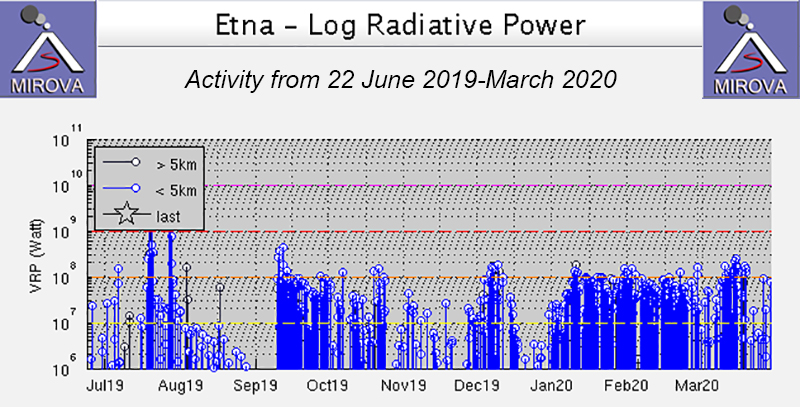 | Figure 286. Multiple episodes of varying activity at Etna from 22 June 2019 through March 2020 were reflected in the MIROVA thermal energy data (Log Radiative Power). Courtesy of MIROVA. |
Activity during October-December 2019. During October 2019, VONA (Volcano Observatory Notice for Aviation) notices issued by INGV reported ash plumes rose to a maximum altitude of 5 km on 1, 17, and 19 October. Strombolian explosions occurred frequently. Explosions were detected primarily in the VOR-BN Craters, ejecting coarse pyroclastic material that fell back into the crater area and occasionally rising above the crater rim. Ash emissions rose from the VOR-BN and NEC while intense gas-and-steam emissions were observed in the NSEC (figure 287). Between 10-12 and 14-20 October fine ashfall was observed in Pedara, Mascalucia, Nicolosi, San Giovanni La Punta, and Catania. In addition to these ash emissions, the explosive Strombolian activity contributed to significant SO2 plumes that drifted in different directions (figure 288).
 | Figure 287. Webcam images of ash emissions from the NE Crater at Etna from the a) CUAD (Catania) webcam on 10 October 2019; b) Milo webcam on 11 October 2019; c) Milo webcam on 12 October 2019; d) M.te Cagliato webcam on 13 October 2019. Courtesy of INGV (Report 42/2019, ETNA, Bollettino Settimanale, 07/10/2019 - 13/10/2019, data emissione 15/10/2019). |
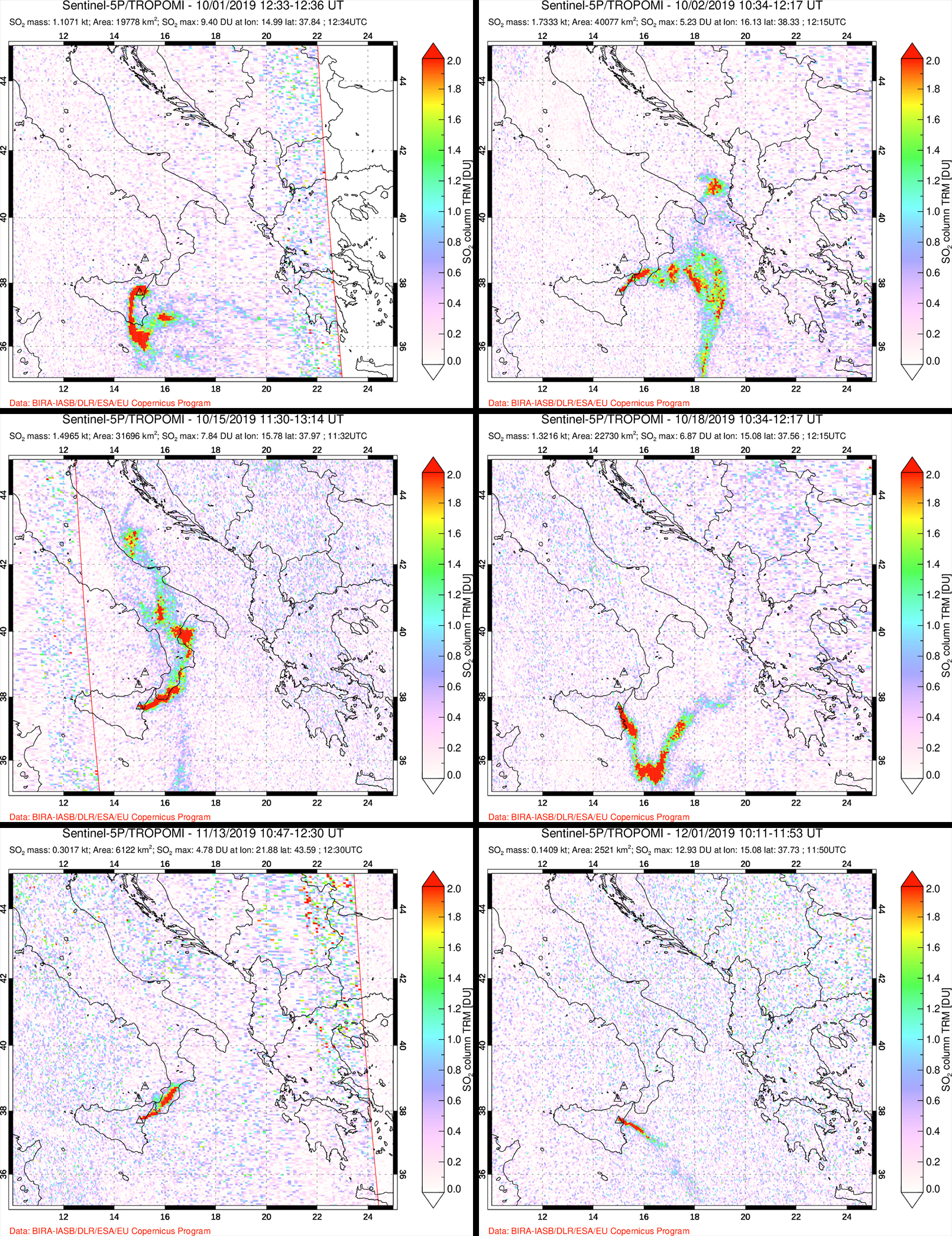 | Figure 288. Strombolian activity at Etna contributed to significant SO2 plumes that drifted in multiple directions during the intermittent explosions in October 2019. Top left: 1 October 2019. Top right: 2 October 2019. Middle left: 15 October 2019. Middle right: 18 October 2019. Bottom left: 13 November 2019. Bottom right: 1 December 2019. Captured by the TROPOMI instrument on the Sentinel 5P satellite, courtesy of NASA Global Sulfur Dioxide Monitoring Page. |
The INGV weekly bulletin covering activity between 25 October and 1 November 2019 reported that Strombolian explosions occurred at intervals of 5-10 minutes from within the VOR-BN and NEC, ejecting incandescent material above the crater rim, accompanied by modest ash emissions. In addition, gas-and-steam emissions were observed from all the summit craters. Field observations showed the cone in the crater floor of VOR that began to grow in mid-September 2019 had continued to grow throughout the month. During the week of 4-10 November, Strombolian activity within the Bocca Nuova Crater was accompanied by gas-and-steam emissions. The explosions in the VOR Crater occasionally ejected incandescent ejecta above the crater rim (figures 289 and 290). For the remainder of the month Strombolian explosions continued in the VOR-BN and NEC, producing sporadic ash emissions. Isolated and discontinuous explosions in the New Southeast Crater (NSEC) also produced fine ash, though gas-and-steam emissions still dominated the activity at this crater. Additionally, the explosions from these summit craters were frequently accompanied by strong SO2 emissions that drifted in different directions as discrete plumes.
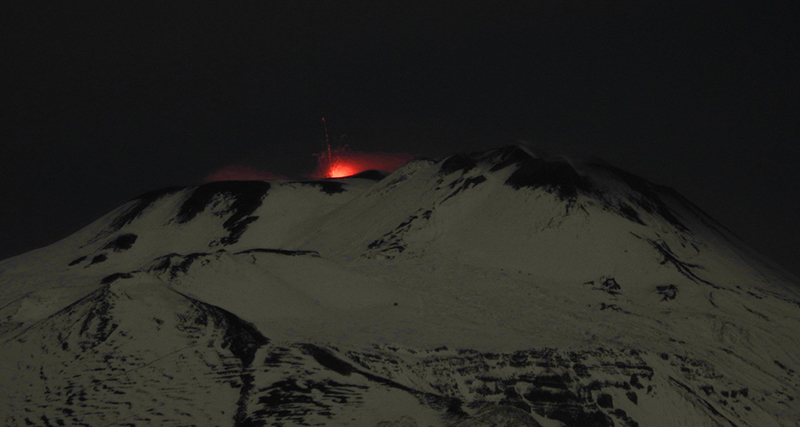 | Figure 289. Photo of Strombolian activity and crater incandescence in the Voragine Crater at Etna on 15 November 2019. Photo by B. Behncke, taken by Tremestieri Etneo. Courtesy of INGV (Report 47/2019, ETNA, Bollettino Settimanale, 11/11/2019 - 17/11/2019, data emissione 19/11/2019). |
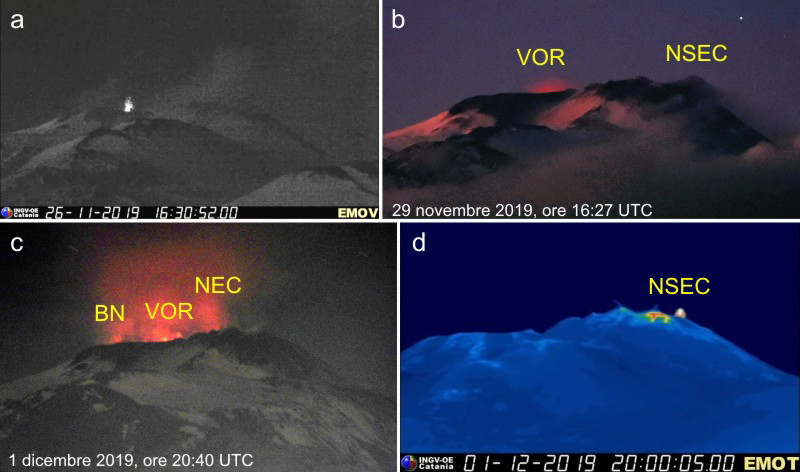 | Figure 290. Webcam images of summit crater activity during 26-29 November and 1 December 2019 at Etna. a) image recorded by the high-resolution camera on Montagnola (EMOV); b) and c) webcam images taken from Tremestieri Etneo on the southern slope of Etna showing summit incandescence; d) image recorded by the thermal camera on Montagnola (EMOT) showing summit incandescence at the NSEC. Courtesy of INGV (Report 49/2019, ETNA, Bollettino Settimanale, 25/11/2019 - 01/12/2019, data emissione 03/12/2019). |
Frequent Strombolian explosions continued through December 2019 within the VOR-BN, NEC, and NSEC Craters with sporadic ash emissions observed in the VOR-BN and NEC. On 6 December, Strombolian explosions increased in the NSEC; webcam images showed incandescent pyroclastic material ejected above the crater rim. On the morning of 6 December a lava flow was observed from the base of the scoria cone in the VOR Crater that traveled toward the adjacent Bocca Nuova Crater. INGV reported that a new vent opened on the side of the saddle cone (NSEC) on 11 December and produced explosions until 14 December.
Activity during January-March 2020. On 9 January 2020 an aerial flight organized by RAI Linea Bianca and the state police showed the VOR Crater continuing to produce lava that was flowing over the crater rim into the BN Crater with some explosive activity in the scoria cone. Explosive Strombolian activity produced strong and distinct SO2 plumes (figure 291) and ash emissions through March, according to the weekly INGV reports, VONA notices, and satellite imagery. Several ash emissions during 21-22 January rose from the vent that opened on 11 December. According to INGV's weekly bulletin for 21-26 January, the scoria cone in the VOR crater produced Strombolian explosions that increased in frequency and contributed to rapid cone growth, particularly the N part of the cone. Lava traveled down the S flank of the cone and into the adjacent Bocca Nuova Crater, filling the E crater (BN-2) (figure 292). The NEC had discontinuous Strombolian activity and periodic, diffuse ash emissions.
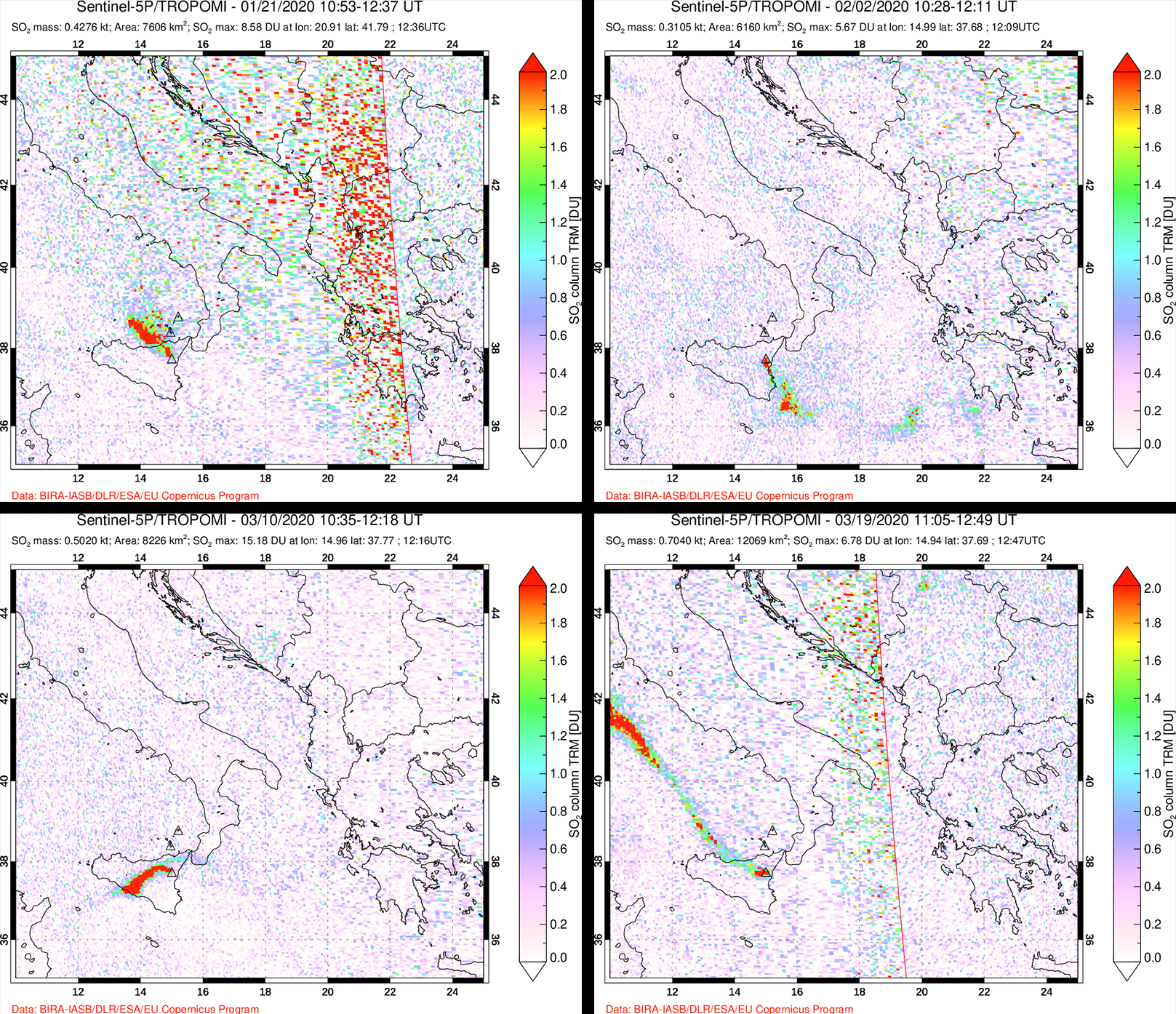 | Figure 291. Distinct SO2 plumes drifting in multiple directions from Etna were visible in satellite imagery as Strombolian activity continued through March 2020. Top left: 21 January 2020. Top right: 2 February 2020. Bottom left: 10 March 2020. Bottom right: 19 March 2020. Captured by the TROPOMI instrument on the Sentinel 5P satellite, courtesy of NASA Global Sulfur Dioxide Monitoring Page. |
 | Figure 292. a) A map of the lava field at Etna showing cooled flows (yellow) and active flows (red). The base of the scoria cone is outlined in black while the crater rim is outlined in red. b) Thermal image of the Bocca Nuova and Voragine Craters. The bright orange is the warmest temperature measure in the flow. Courtesy of INGV, photos by Laboratorio di Cartografia FlyeEye Team (Report 10/2020, ETNA, Bollettino Settimanale, 24/02/2020 - 01/03/2020, data emissione 03/03/2020). |
Strombolian explosions continued into February 2020, accompanied by ash emissions and lava flows from the previous months (figure 293). During 17-23 February, INGV reported that some subsidence was observed in the central portion of the Bocca Nuova Crater. During 24 February to 1 March, the Strombolian explosions ejected lava from the VOR Crater up to 150-200 m above the vent as bombs fell on the W edge of the VOR crater rim (figure 294). Lava flows continued to move into the W part of the Bocca Nuova Crater.
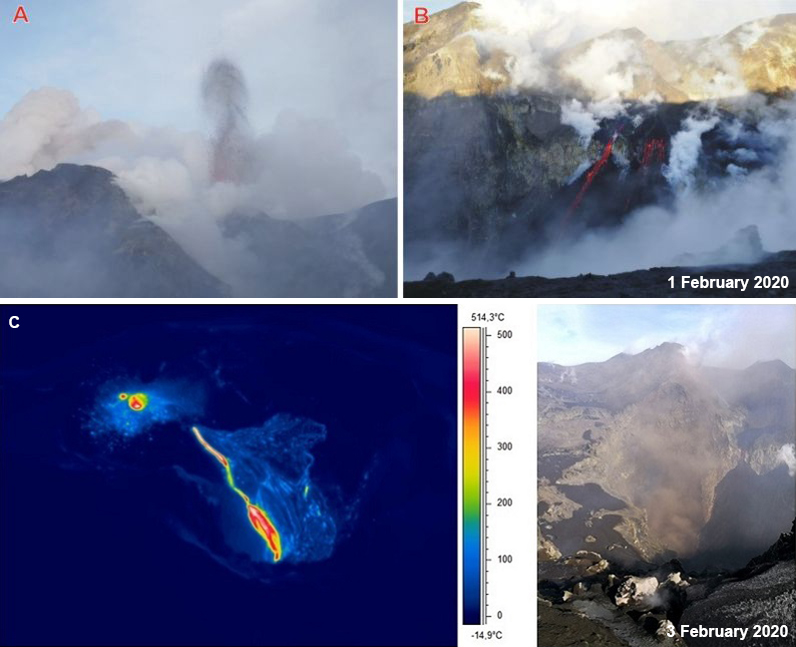 | Figure 293. Webcam images of A) Strombolian activity and B) effusive activity fed by the scoria cone grown inside the VOR Crater at Etna taken on 1 February 2020. C) Thermal image of the lava field produced by the VOR Crater taken by L. Lodato on 3 February (bottom left). Image of BN-1 taken by F. Ciancitto on 3 February in the summit area (bottom right). Courtesy of INGV; Report 06/2020, ETNA, Bollettino Settimanale, 27/01/2020 - 02/02/2020, data emissione 04/02/2020 (top) and Report 07/2020, ETNA, Bollettino Settimanale, 03/02/2020 - 09/02/2020, data emissione 11/02/2020 (bottom). |
 | Figure 294. Photos of the VOR intra-crater scoria cone at Etna: a) Strombolian activity resumed on 25 February 2020 from the SW edge of BN taken by B. Behncke; b) weak Strombolian activity from the vent at the base N of the cone on 29 February 2020 from the W edge of VOR taken by V. Greco; c) old vent present at the base N of the cone, taken on 17 February 2020 from the E edge of VOR taken by B. Behncke; d) view of the flank of the cone, taken on 24 February 2020 from the W edge of VOR taken by F. Ciancitto. Courtesy of INGV (Report 10/2020, ETNA, Bollettino Settimanale, 24/02/2020 - 01/03/2020, data emissione 03/03/2020). |
During 9-15 March 2020 Strombolian activity was detected in the VOR Crater while discontinuous ash emissions rose from the NEC and NSEC. Bombs were found in the N saddle between the VOR and NSEC craters. On 9 March, a small scoria cone that had formed in the Bocca Nuova Crater and was ejecting bombs and lava tens of meters above the S crater rim. The lava flow from the VOR Crater was no longer advancing. A third scoria cone had formed on 13 March NE in the main VOR-BN complex due to the Strombolian explosions on 29 February. Another lava flow formed on 13 March, accompanied by an increase in seismicity. The weekly report for 16-22 March reported Strombolian activity detected in the VOR Crater and gas-and-steam and rare ash emissions observed in the NEC and NSEC (figure 295). Explosions in the Bocca Nuova Crater ejected spatter and bombs 100 m high.
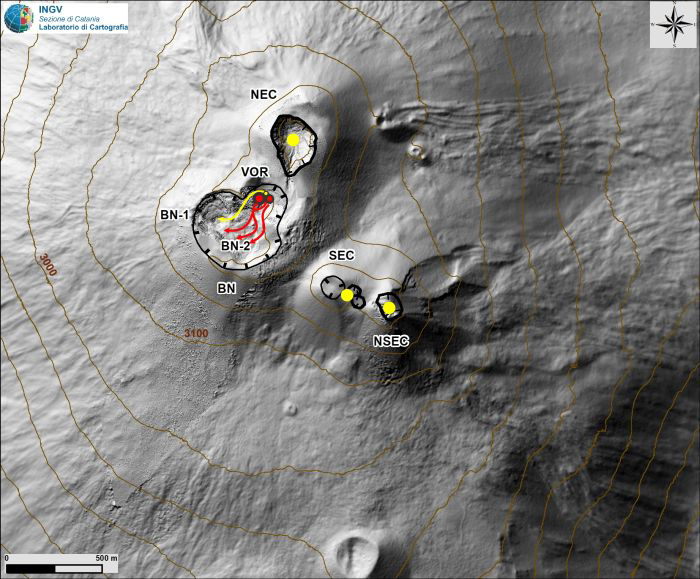 | Figure 295. Map of the summit crater area of Etna showing the active vents and lava flows during 16-22 March 2020. Black hatch marks indicate the crater rims: BN = Bocca Nuova, with NW BN-1 and SE BN-2; VOR = Voragine; NEC = North East Crater; SEC = South East Crater; NSEC = New South East Crater. Red circles indicate areas with ash emissions and/or Strombolian activity, yellow circles indicate steam and/or gas emissions only. The base is modified from a 2014 DEM created by Laboratorio di Aerogeofisica-Sezione Roma 2. Courtesy of INGV (Report 13/2020, ETNA, Bollettino Settimanale, 16/03/2020 - 22/03/2020, data emissione 24/03/2020). |
Information Contacts: Sezione di Catania - Osservatorio Etneo, Istituto Nazionale di Geofisica e Vulcanologia (INGV), Sezione di Catania, Piazza Roma 2, 95123 Catania, Italy (URL: http://www.ct.ingv.it/it/); Toulouse Volcanic Ash Advisory Center (VAAC), Météo-France, 42 Avenue Gaspard Coriolis, F-31057 Toulouse cedex, France (URL: http://www.meteo.fr/aeroweb/info/vaac/); MIROVA (Middle InfraRed Observation of Volcanic Activity), a collaborative project between the Universities of Turin and Florence (Italy) supported by the Centre for Volcanic Risk of the Italian Civil Protection Department (URL: http://www.mirovaweb.it/); Global Sulfur Dioxide Monitoring Page, Atmospheric Chemistry and Dynamics Laboratory, NASA Goddard Space Flight Center (NASA/GSFC), 8800 Greenbelt Road, Goddard, Maryland, USA (URL: https://so2.gsfc.nasa.gov/); Sentinel Hub Playground (URL: https://www.sentinel-hub.com/explore/sentinel-playground); Boris Behncke, Sonia Calvari, and Marco Neri, Istituto Nazionale di Geofisica e Vulcanologia (INGV), Sezione di Catania, Piazza Roma 2, 95123 Catania, Italy (URL: https://twitter.com/etnaboris, Image at https://twitter.com/etnaboris/status/1183640328760414209/photo/1).
September 2020 (BGVN 45:09)  Cite this Report
Cite this Report
Effusive activity in early April; frequent Strombolian explosions and ash emissions during April-July 2020
Etna, located on the island of Sicily, Italy, is a stratovolcano that has had historical eruptions dating back 3,500 years. Its most recent eruptive period began in September 2013 and has continued through July 2020, characterized by Strombolian explosions, lava flows, and ash plumes. Activity has commonly originated from the summit areas, including the Northeast Crater (NEC), the Voragine-Bocca Nuova (or Central) complex (VOR-BN), the Southeast Crater (SEC, formed in 1978), and the New Southeast Crater (NSEC, formed in 2011). The newest crater, referred to as the "cono della sella" (saddle cone), emerged during early 2017 in the area between SEC and NSEC. Volcanism during this reporting period from April through July 2020 includes frequent Strombolian explosions primarily in the Voragine and NSEC craters, ash emissions, some lava effusions, and gas-and-steam emissions. Information primarily comes from weekly reports by the Osservatorio Etneo (OE), part of the Catania Branch of Italy's Istituo Nazionale di Geofisica e Vulcanologica (INGV).
Summary of activity during April-July 2020. Degassing of variable intensity is typical activity from all summit vents at Etna during the reporting period. Intra-crater Strombolian explosions and ash emissions that rose to a maximum altitude of 5 km on 19 April primarily originated from the Voragine (VOR) and New Southeast Crater (NSEC) craters. At night, summit crater incandescence was occasionally visible in conjunction with explosions and degassing. During 18-19 April small lava flows were observed in the VOR and NSEC craters that descended toward the BN from the VOR Crater and the upper E and S flanks of the NSEC. On 19 April a significant eruptive event began with Strombolian explosions that gradually evolved into lava fountaining activity, ejecting hot material and spatter from the NSEC. Ash plumes that were produced during this event resulted in ashfall to the E of Etna. The flows had stopped by the end of April; activity during May consisted of Strombolian explosions in both the VOR and NSEC craters and intermittent ash plumes rising 4.5 km altitude. On 22 May Strombolian explosions in the NSEC produced multiple ash plumes, which resulted in ashfall to the S. INGV reported that the pit crater at the bottom of BN had widened and was accompanied by degassing. Explosions with intermittent ash emissions continued during June and July and were primarily focused in the VOR and NSEC craters; mild Strombolian activity in the SEC was reported in mid-July.
MIROVA (Middle InfraRed Observation of Volcanic Activity) analysis of MODIS satellite data shows multiple episodes of thermal activity throughout the reporting period (figure 296). In early April, the frequency and power of the thermal anomalies began to decrease through mid-June; in July, they had increased in power again but remained less frequent compared to activity in January through March. According to the MODVOLC thermal algorithm, a total of seven alerts were detected in the summit craters during 10 April (1), 17 April (1), 24 April (2), 10 July (1), 13 July (1), and 29 July (1) 2020. These thermal hotspots were typically registered during or after a Strombolian event. Frequent Strombolian activity contributed to distinct SO2 plumes that drifted in different directions (figure 297).
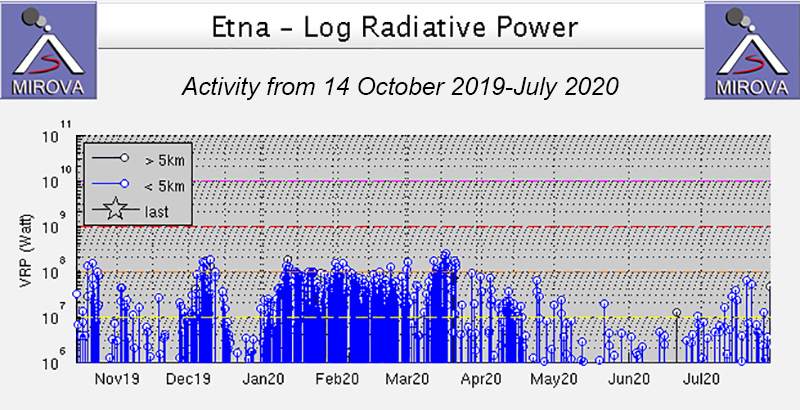 | Figure 296. Multiple episodes of varying thermal activity at Etna from 14 October 2019 through July 2020 were reflected in the MIROVA data (Log Radiative Power). In early April, the frequency and power of the thermal anomalies decreased through mid-June. In July, the thermal anomalies increased in power, but did not increase in frequency. Courtesy of MIROVA. |
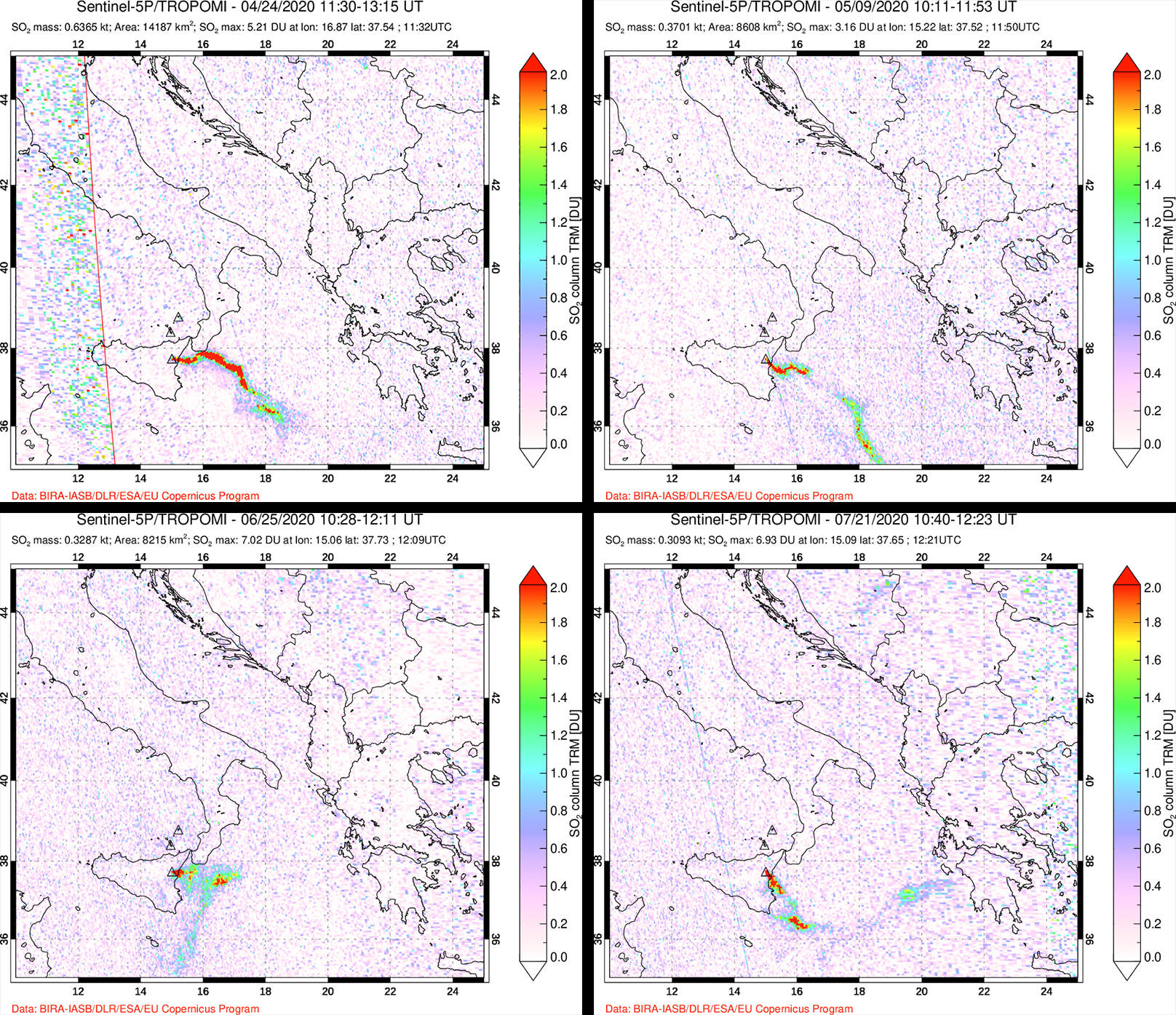 | Figure 297. Distinct SO2 plumes from Etna were detected on multiple days during April to July 2020 due to frequent Strombolian explosions, including, 24 April (top left), 9 May (top right), 25 June (bottom left), and 21 July (bottom right) 2020. Captured by the TROPOMI instrument on the Sentinel 5P satellite, courtesy of NASA Global Sulfur Dioxide Monitoring Page. |
Activity during April-May 2020. During April, INGV reported Strombolian explosions that produced some ash emissions and intra-crater effusive activity within the Voragine Crater (VOR) and abundant degassing from the New Southeast Crater (NSEC), Northeast Crater (NEC), and from two vents on the cono della sella (saddle cone) that were sometimes accompanied by a modest amount of ash (figure 298). At night, summit crater incandescence was observed in the cono della salla. The Strombolian activity in the VOR built intra-crater scoria cones while lava flows traveled down the S flank of the largest, main cone. On 18 April effusive activity from the main cone in the VOR Crater traveled 30 m toward the Bocca Nuova (BN) Crater; the pit crater at the bottom of the BN crater had widened compared to previous observations. A brief episode of Strombolian explosions that started around 0830 on 19 April in the NSEC gradually evolved into modest lava fountaining activity by 0915, rising to 3 km altitude and ejecting bombs up to 100 m (figure 299). A large spatter deposit was found 50 m from the vent and 3-4 small lava flows were descending the NSEC crater rim; two of these summit lava flows were observed at 1006, confined to the upper E and S flanks of the cone. Around 1030, one or two vents in the cono della sella produced a gas-and-steam and ash plume that rose 5 km altitude and drifted E, resulting in ashfall on the E flank of Etna in the Valle del Bove, as well as between the towns of Zafferana Etnea (10 km SE) and Linguaglossa (17 km NE). At night, flashes of incandescence were visible at the summit. By 1155, the lava fountaining had gradually slowed, stopping completely around 1300. The NEC continued to produce gas-and-steam emissions with some intra-crater explosive activity. During the week of 20-26 April, Strombolian activity in the VOR intra-crater scoria cone ejected pyroclastic material several hundred meters above the crater rim while the lava flows had significantly decreased, though continued to travel on the E flank of the main cone. Weak, intra-crater Strombolian activity with occasional ash emissions and nightly summit incandescence were observed in the NSEC (figure 300). By 30 April there were no longer any active lava flows; the entire flow field had begun cooling. The mass of the SO2 emissions varied in April from 5,000-15,000 tons per day.
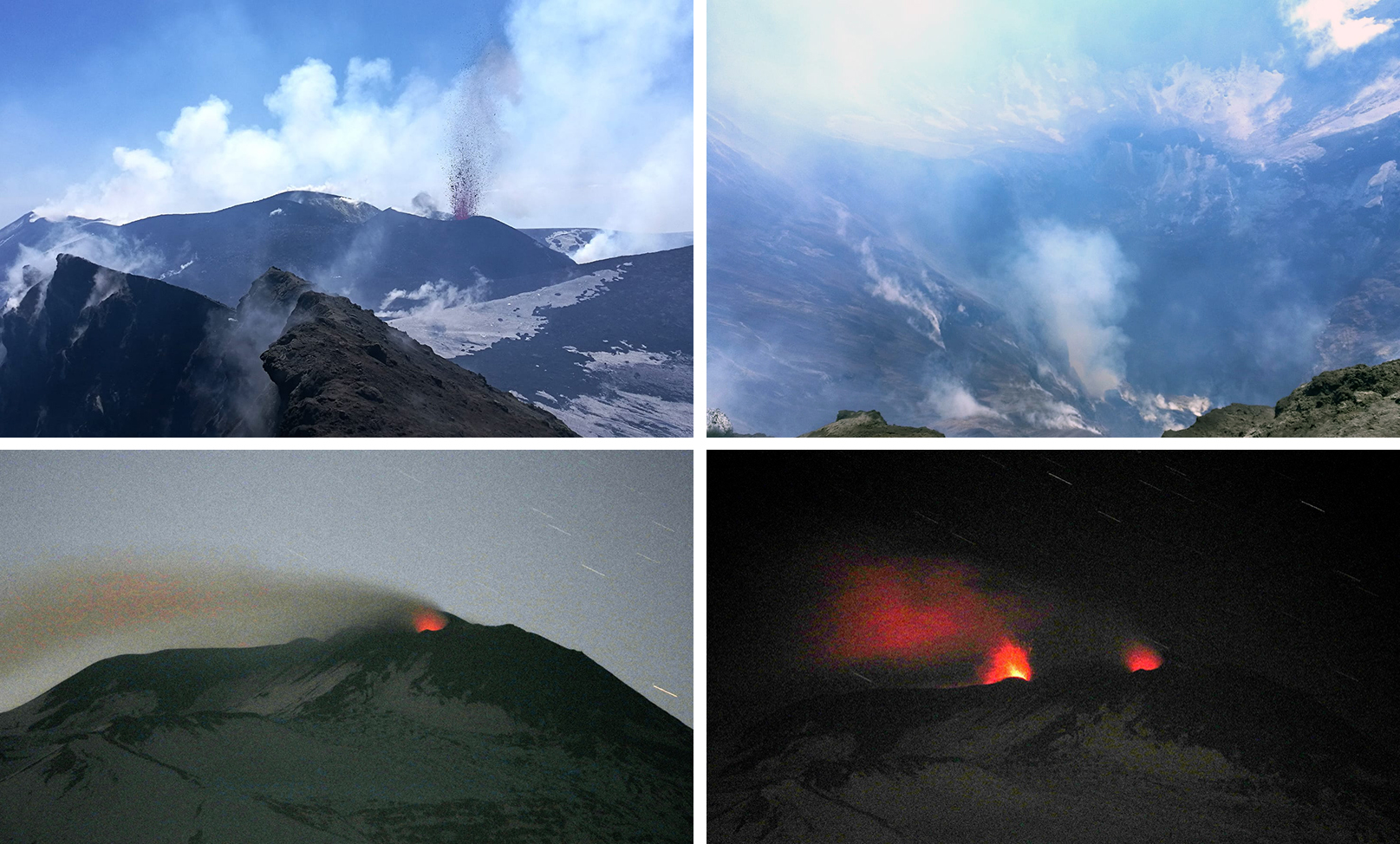 | Figure 298. Photos of Strombolian explosions at Etna in the Voragine Crater (top left), strong degassing at the Northeast Crater (NEC) (top right), and incandescent flashes and Strombolian activity in the New Southeast Crater (NSEC) seen from Tremestieri Etneo (bottom row) on 10 April 2020. Photos by Francesco Ciancitto (top row) and Boris Behncke (bottom row), courtesy of INGV. |
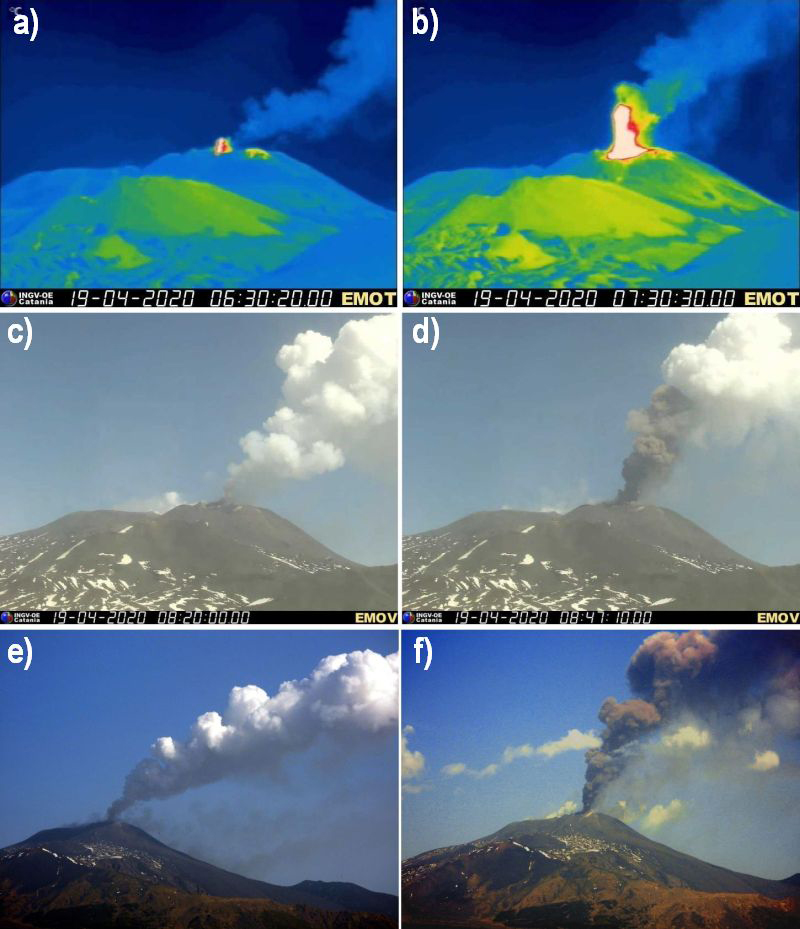 | Figure 299. Strombolian activity at Etna's "cono della sella" of the NSEC crater on 19 April 2020 included (a-b) lava fountaining that rose 3 km altitude, ejecting bomb-sized material and a spatter deposit captured by the Montagnola (EMOV) thermal camera. (c-d) An eruptive column and increased white gas-and-steam and ash emissions were captured by the Montagnola (EMOV) visible camera and (e-f) were also seen from Tremestieri Etneo captured by Boris Behncke. Courtesy of INGV (Report 17/2020, ETNA, Bollettino Settimanale, 13/04/2020 – 19/04/2020, data emissione 21/04/2020). |
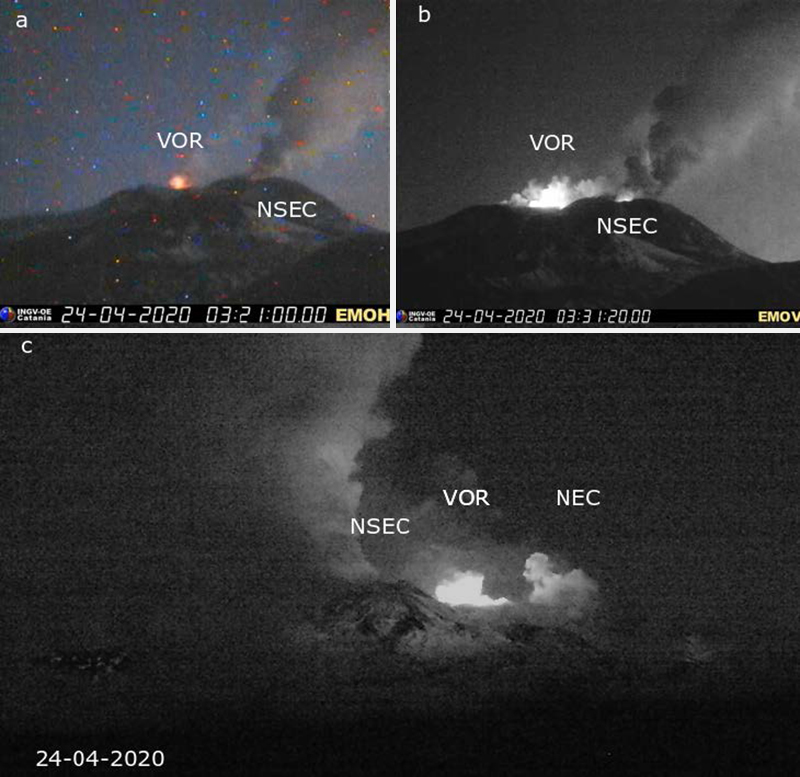 | Figure 300. Webcam images showing intra-crater explosive activity at Etna in the Voragine (VOR) and New Southeast Crater (NSEC) on 24 April 2020 captured by the (a-b) Montagnola and (c) Monte Cagliato cameras. At night, summit incandescence was visible and accompanied by strong degassing. Courtesy of INGV (Report 18/2020, ETNA, Bollettino Settimanale, 20/04/2020 – 26/04/2020, data emissione 28/04/2020). |
Strombolian explosions produced periodic ash emissions and ejected mild, discontinuous incandescent material in the VOR Crater; the coarse material was deposited onto the S flank of BN (figure 301). Pulsating degassing continued from the summit craters, some of which were accompanied by incandescent flashes at night. The Strombolian activity in the cono della sella occasionally produced reddish ash during 3-4 May. During 5 and 8 May, there was an increase in ash emissions at the NSEC that drifted SSE. A strong explosive event in the VOR Crater located E of the main cone produced a significant amount of ash and ejected coarse material, which included blocks and bombs measuring 15-20 cm, that fell on the W edge of the crater, as well as on the S terrace of the BN Crater (figure 302).
 | Figure 301. Photos of Strombolian explosions and summit incandescence at Etna on 4 May (left) and during the night of 11-12 May. Photos by Gianni Pennisi (left) and Boris Behncke (right, seen from Tremestieri Etneo). Courtesy of INGV. |
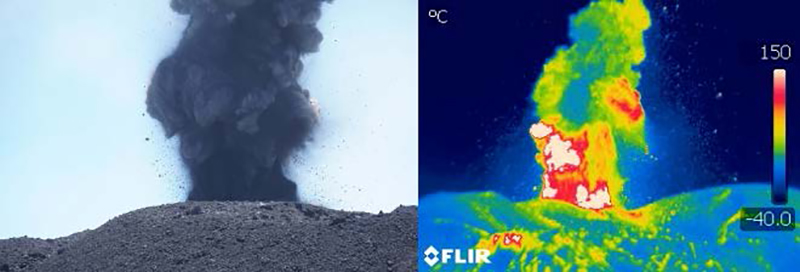 | Figure 302. A photo on 5 May (left) and thermal image on 8 May (right) of Strombolian explosions at Etna in the Voragine Crater accompanied by a dense, gray ash plume. Photo by Daniele Andronico. Courtesy of INGV (Report 20/2020, ETNA, Bollettino Settimanale, 04/05/2020 – 10/05/2020, data emissione 12/05/2020). |
On 10 May degassing continued in the NSEC while Strombolian activity fluctuated in both the VOR and NSEC Craters, ejecting ballistics beyond the crater rim; in the latter, some of the blocks fell back in, accumulated on the edge, and rolled down the slopes (figure 303). During the week of 11-17 May, eruptive activity at the VOR Crater was the lowest observed since early March; there were 4-5 weak, low intensity pulses not accompanied by bombs or ashfall in the VOR Crater. Degassing continued in the BN Crater. The crater of the cono della sella had widened further N following collapses due to the Strombolian activity, which exposed the internal wall.
 | Figure 303. Map of the summit craters of Etna showing the active vents, the area of cooled lava flows (light green), and the location of the widening pit crater in the Bocca Nuova (BN) Crater (light blue circle) updated on 9 May 2020. The base is modified from a 2014 DEM created by Laboratorio di Aerogeofisica-Sezione Roma 2. Black hatch marks indicate the crater rims: BN = Bocca Nuova, with NW BN-1 and SE BN-2; VOR = Voragine; NEC = North East Crater; SEC = South East Crater; NSEC = New South East Crater. Red circles indicate areas with ash emissions and/or Strombolian activity, yellow circles indicate steam and/or gas emissions only. Courtesy of INGV (Report 29/2020, ETNA, Bollettino Settimanale, 06/07/2020 – 12/07/2020, data emissione 14/07/2020). |
On 18 May an ash plume from the NSEC rose 4.5 km altitude and drifted NE. Strombolian explosions on 22 May at the NSEC produced multiple ash plumes that rose 4.5 km altitude and drifted S and SW (figure 304), depositing a thin layer of ash on the S slope, and resulting in ashfall in Catania (27 km S). Explosions from the VOR Crater had ejected a deposit of large clasts (greater than 30 cm) on the NE flank, between the VOR Crater and NEC on 23 May. INGV reported that the pit crater in the BN continued to widen and degassing was observed in the NSEC, VOR Crater, and NEC. During the week of 25-31 May persistent visible flashes of incandescence at night were observed, which suggested there was intra-crater Strombolian activity in the SEC and NSEC. The mass of the SO2 plumes varied between 5,000-9,000 tons per day.
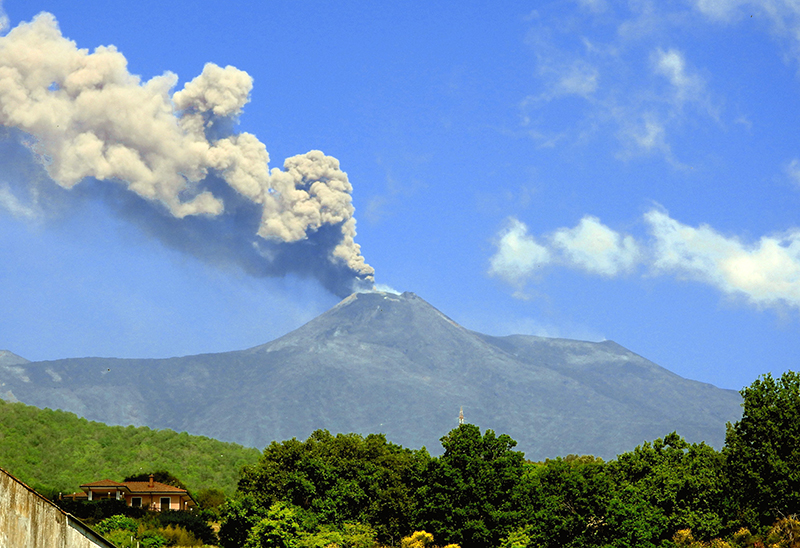 | Figure 304. Photo of repeated Strombolian activity and ash emissions rising from Etna above the New Southeast Crater (NSEC) on 22 May 2020 seen from Zafferana Etnea on the SE flank at 0955 local time. Photo by Boris Behncke, INGV. |
Activity during June-July 2020. During June, moderate intra-crater Strombolian activity with intermittent ash emissions continued in the NSEC and occurred more sporadically in the VOR Crater; at night, incandescence of variable intensity was observed at the summit. During the week of 8-14 June, Strombolian explosions in the cono della sella generated some incandescence and rare jets of incandescent material above the crater rim, though no ash emissions were reported. On the morning of 14 June a sequence of ten small explosions in the VOR Crater ejected incandescent material just above the crater rim and produced small ash emissions. On 25 June an overflight showed the developing pit crater in the center of the BN, accompanied by degassing along the S edge of the wall; degassing continued from the NEC, VOR Crater, SEC, and NSEC (figure 305). The mass of the SO2 plumes measured 5,000-7,000 tons per day, according to INGV.
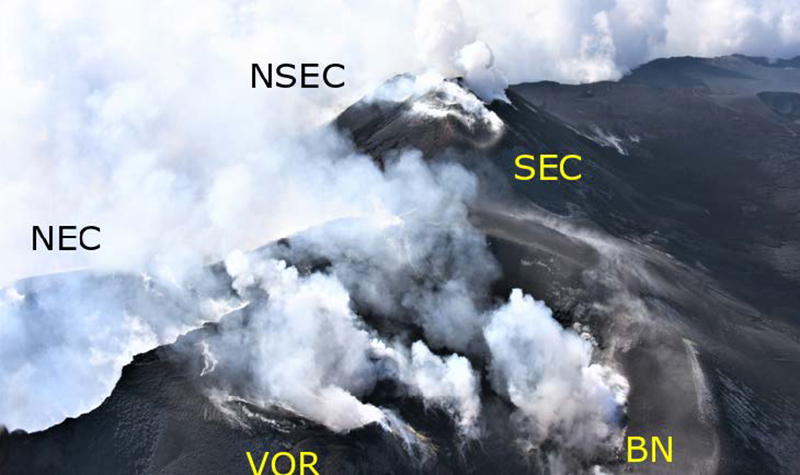 | Figure 305. Aerial photo of Etna from the NE during an overflight on 25 June 2020 by the Catania Coast Guard (2 Nucleo Aereo della Guardia Costiera di Catania) showing degassing of the summit craters. Photo captured from the Aw139 helicopter by Stefano Branca. Courtesy of INGV (Report 27/2020, ETNA, Bollettino Settimanale, 22/06/2020 – 28/06/2020, data emissione 30/06/2020). |
Similar modest, intra-crater Strombolian explosions in the NSEC, sporadic explosions in the VOR Crater, and degassing in the BN, VOR Crater, and NEC persisted into July. On 2 July degassing in the NEC was accompanied by weak intra-crater Strombolian activity. Intermittent weak ash emissions and ejecta from the NSEC and VOR Crater were observed during the month. During the week of 6-12 July INGV reported gas-and-steam emissions continued to rise from the vent in the pit crater at the bottom of BN (figure 306). On 11 July mild Strombolian activity, nighttime incandescence, and degassing was visible in the SEC (figure 307). By 15 July there was a modest increase in activity in the NSEC and VOR Craters, generating ash emissions and ejecting material over the crater rims while the other summit craters were dominantly characterized by degassing. On 31 July an explosion in the NSEC produced an ash plume that rose 4.5 km altitude.
 | Figure 306. Photos of the bottom of the Bocca Nuova (BN) crater at Etna on 8 July 2020 showing the developing pit crater (left) and degassing. Minor ash emissions were visible in the background at the Voragine Crater (right). Both photos by Daniele Andronico. Courtesy of INGV (Report 29/2020, ETNA, Bollettino Settimanale, 06/07/2020 – 12/07/2020, data emissione 14/07/2020). |
 | Figure 307. Mild Strombolian activity and summit incandescence in the "cono della sella" (saddle vent) at the Southeast crater (SEC) of Etna on 11 July 2020, seen from Piano del Vescovo (left) and Piano Vetore (right). Photo by Boris Behncke, INGV. |
Information Contacts: Sezione di Catania - Osservatorio Etneo, Istituto Nazionale di Geofisica e Vulcanologia (INGV), Sezione di Catania, Piazza Roma 2, 95123 Catania, Italy (URL: http://www.ct.ingv.it/it/); MIROVA (Middle InfraRed Observation of Volcanic Activity), a collaborative project between the Universities of Turin and Florence (Italy) supported by the Centre for Volcanic Risk of the Italian Civil Protection Department (URL: http://www.mirovaweb.it/); Hawai'i Institute of Geophysics and Planetology (HIGP) - MODVOLC Thermal Alerts System, School of Ocean and Earth Science and Technology (SOEST), Univ. of Hawai'i, 2525 Correa Road, Honolulu, HI 96822, USA (URL: http://modis.higp.hawaii.edu/); Global Sulfur Dioxide Monitoring Page, Atmospheric Chemistry and Dynamics Laboratory, NASA Goddard Space Flight Center (NASA/GSFC), 8800 Greenbelt Road, Goddard, Maryland, USA (URL: https://so2.gsfc.nasa.gov/); Boris Behncke, Istituto Nazionale di Geofisica e Vulcanologia (INGV), Sezione di Catania, Piazza Roma 2, 95123 Catania, Italy.
December 2020 (BGVN 45:12)  Cite this Report
Cite this Report
Strombolian explosions and ash plumes persist from multiple craters during August-November 2020
Etna, on the island of Sicily, Italy, and has had documented eruptions dating back 3,500 years. Its most recent eruptive period began in September 2013 and has continued through November 2020, characterized by frequent Strombolian explosions, effusive activity, and ash plumes. Activity has commonly originated from the summit areas, including the Northeast Crater (NEC), the Voragine-Bocca Nuova (or Central) complex (VOR-BN), the Southeast Crater (SEC, formed in 1978), and the New Southeast Crater (NSEC, formed in 2011). The newest crater, referred to as the "cono della sella" (saddle cone), emerged during early 2017 in the area between SEC and NSEC. This report from August through November 2020 updates activity consisting of frequent Strombolian explosions, ash plumes, summit crater incandescence, degassing, and some ashfall based on information primarily from weekly reports by the Osservatorio Etneo (OE), part of the Catania Branch of Italy's Istituo Nazionale di Geofisica e Vulcanologica (INGV).
Summary of activity during August-November 2020. Intra-crater Strombolian explosions that varied in frequency and intensity throughout the reporting period, and the accompanying ash emissions that rose to a maximum altitude of 4.5 km, primarily originated from the Northeast Crater (NEC), the New Southeast Crater (NSEC), and intermittently from the Voragine Crater (VOR). Degassing of variable intensity typically occurred at the VOR and the Bocca Nuova (BN) Crater. At night, occasional summit crater incandescence was visible in webcam images, accompanied by explosions and gas-and-ash emissions. On 14 August strong Strombolian explosions produced an ash plume that rose to 4.5 km altitude and drifted SE, resulting in ashfall between Pedara, Trecastagni, and Viagrande. INGV reported that the central pit crater at the bottom of BN continued to widen, and on 9 September scientists observed that a new pit crater had formed NW of the central depression and was widening due to crater wall collapses. During late October to 1 November, INGV reported that small lava flows originated from scoria cones in the NEC and were visible from the edge of the crater but did not spill over.
MIROVA (Middle InfraRed Observation of Volcanic Activity) analysis of MODIS satellite data shows frequent thermal activity of varying strength throughout the reporting period (figure 308). In late October, the frequency of the thermal anomalies increased, and continued through November. According to the MODVOLC thermal algorithm, a total of 31 alerts were detected in the summit craters during August through November; thermal anomalies were reported for five days in August, four days in September, four days in October, and eight days in November. Frequent Strombolian activity contributed to distinct SO2 plumes that drifted in multiple directions (figure 309).
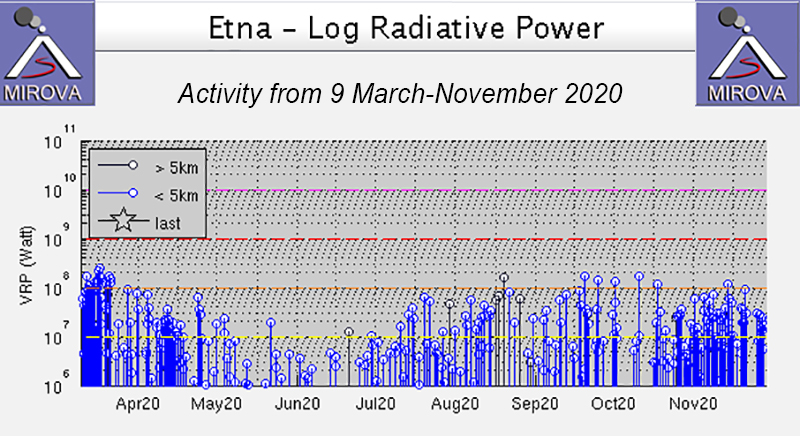 | Figure 308. Strong and frequent thermal activity at Etna was detected during August through November 2020, as reflected in the MIROVA data (Log Radiative Power). Beginning in late October, the frequency of the thermal anomalies increased compared to the previous months. Courtesy of MIROVA. |
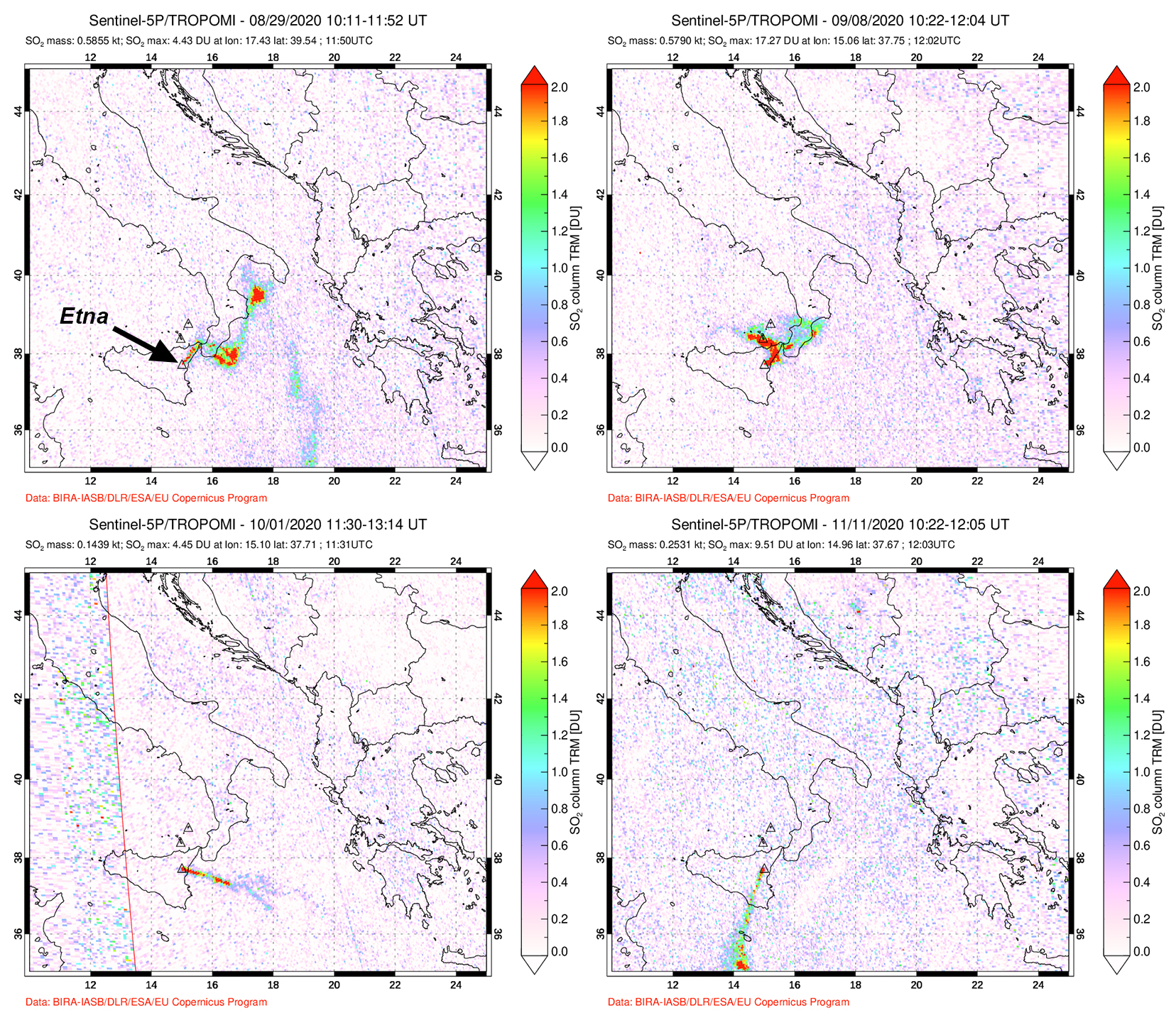 | Figure 309. Distinct SO2 plumes from Etna were detected on multiple days during August to November 2020 due to frequent Strombolian explosions, including 29 August (top left), 8 September (top right), 1 October (bottom left), and 11 November (bottom right) 2020. SO2 plumes were observed drifting in multiple directions. Captured by the TROPOMI instrument on the Sentinel 5P satellite, courtesy of NASA Global Sulfur Dioxide Monitoring Page. |
Activity during August-September 2020. During August, INGV reported intra-crater Strombolian explosions in the NEC, VOR, and NSEC (including the cono della sella) craters, which produced discontinuous ash emissions rising above each crater (figure 310). Gas-and-steam emissions were the dominant activity in the BN crater. INGV noted that the central pit crater on the floor of BN had been gradually widening since April. On 2 August a slight increase in explosivity resulted in minor ashfall in Trecastagni and Acicastello. Explosive activity occasionally ejected material above the crater rim up to several tens of meters. On the morning of 7 August incandescent Strombolian activity was visible in the NSEC (figure 311). During the evening of 10-11 August surveillance cameras showed the explosions ejecting incandescent material on the surrounding flanks. On 14 August intense Strombolian activity in the saddle cone of the NSEC produced an ash plume that rose to 4-4.5 km altitude and drifted SE, resulting in ashfall between Pedara, Trecastagni, and Viagrande. By the evening activity had sharply declined, according to a VONA (Volcano Observatory Notice for Aviation) report, though sporadic ash emissions continued. A new series of ash emissions associated with explosions of varying intensity began on 15 August in the NSEC. A resulting ash plume rose to 4-4.5 km altitude and drifted ESE. On 17 August gas-and-steam emissions were seen rising above the VOR crater, accompanied by persistent Strombolian explosions. Between the afternoon and early morning of 20-21 August surveillance cameras showed an increased intensity and frequency of ash emissions above the NSEC and NEC that rose to 4-4.5 km altitude and drifted SSE. INGV-OE scientists reported minor ashfall in Trecastagni, Viagrande, and Catania. During 24-30 August ground observers reported that the intra-crater explosions in the NEC originated from two explosive vents; the BN crater exhibited gas-and-steam emissions from the central pit crater, which continued to widen. During 25-26 August explosive activity increased at the NSEC with ash emissions rising to 4.5 km and drifting SSE, which resulted in modest ashfall in Catania, Viagrande, and Trecastagni; by morning, the volume of ash emissions had decreased, though explosions persisted. During 28-29 August discontinuous and modest ash emissions originating from the NSEC rose 4.5 km altitude drifting E and ENE but did not result in ashfall. Emissions had stopped by 1747 on 29 August, though intense gas-and-steam emissions continued, occasionally accompanied by mild explosive activity (figure 312).
 | Figure 310. An ash plume accompanied Strombolian explosions at Etna on 3 August (top left) and 4 August (top right) and as seen from the Montagnola (EMOV) thermal camera in the NSEC. Continuous Strombolian activity and summit crater incandescence was observed on 7 August (bottom left); an ash plume was visible in the Monte Cagliato surveillance camera during the day on 9 August (bottom right). Courtesy of INGV (Report 33/2020, ETNA, Bollettino Settimanale, 03/08/2020 – 09/08/2020, data emissione 11/08/2020). |
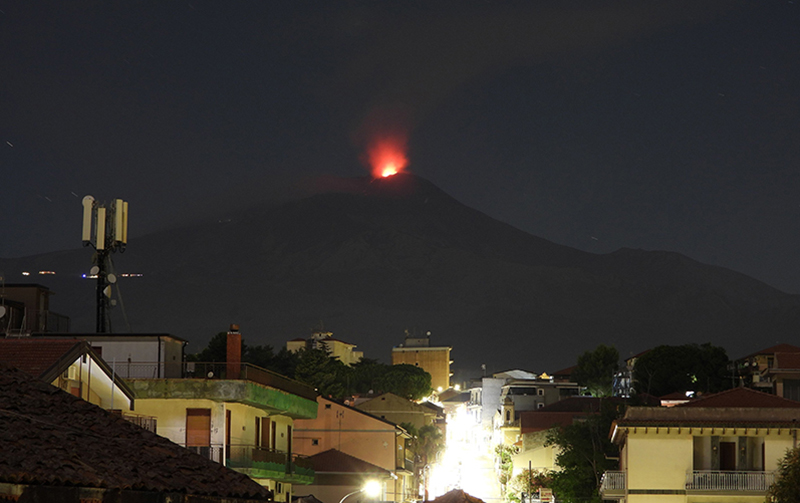 | Figure 311. Strombolian explosions and summit crater incandescence was observed at Etna's New Southeast Crater (NSEC "cono della sella") during the early morning of 7 August 2020 seen from Tremestieri Etneo. Photo by Boris Behncke, INGV. |
 | Figure 312. Photo of the S edge of the Bocca Nuova Crater at Etna on 29 August 2020 showing degassing in the pit crater. The main scoria cone within the Voragine Crater is visible in the background. Courtesy of INGV (Report 36/2020, ETNA, Bollettino Settimanale, 24/08/2020 – 30/08/2020, data emissione 01/09/2020). |
Strombolian activity of varying intensity continued in the NSEC and NEC during September, producing sporadic ash emissions (figure 313). The BN and VOR craters were characterized by gas-and-steam emissions. Explosions in the NSEC ejected coarse pyroclastic material above the crater rim several tens of meters, some of which were deposited on the S flank, and accompanied by sporadic ash emissions; these explosions continued to widen the depression in the saddle cone of the NSEC. Intermittent nighttime crater incandescence was observed in the NSEC. Sporadic and weak ash emissions were observed in the VOR. On 9 September INGV scientists reported intense degassing from the center pit crater in the BN. To the NW of this center depression, a new pit crater had formed and began to widen due to the collapse of the crater walls (figure 314). On 26 September explosions in the NSEC produced an ash plume that rose to 4 km altitude and drifted E, though no ashfall was reported.
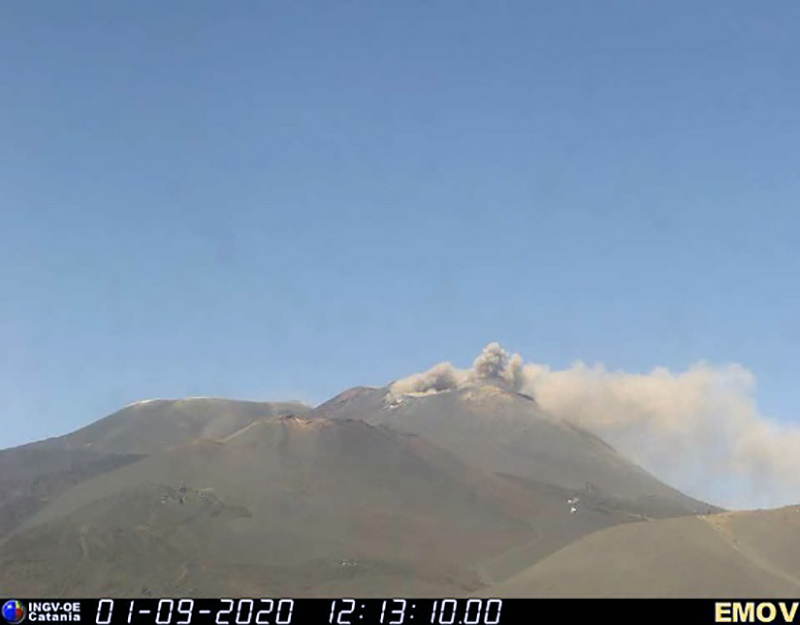 | Figure 313. Webcam image showing explosions in the New Southeast Crater and resulting ash emissions on 1 September 2020. Courtesy of INGV (Report 37/2020, ETNA, Bollettino Settimanale, 31/08/2020 – 06/09/2020, data emissione 08/09/2020). |
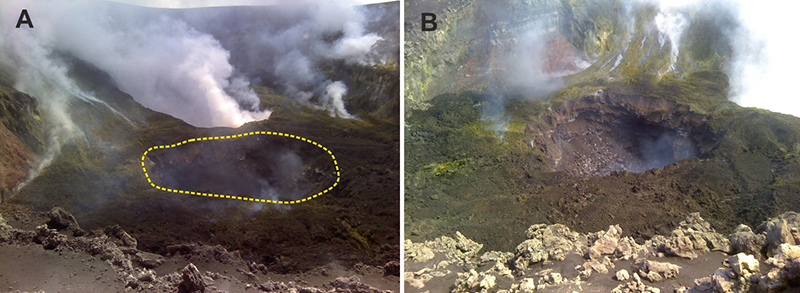 | Figure 314. Photos of the bottom of the W edge of the Bocca Nuova Crater at Etna on 9 September 2020. Gas-and-steam emissions are visible rising above the pit crater in the background. In the foreground a new pit crater had formed to the NW of the central pit crater (yellow dotted line). Photo was taken from the S edge of the BN crater. Courtesy of INGV (Report 38/2020, ETNA, Bollettino Settimanale, 07/09/2020 – 13/09/2020, data emissione 15/09/2020). |
Activity during October-November 2020. Similar variable Strombolian activity continued into October in the NSEC (cono della sella) and NEC; isolated and weak ash emissions were visible in the VOR crater and gas-and-steam emissions continued in both the VOR and BN craters. On 1 October an increase in explosive activity in the NSEC occurred around 0800, which produced an ash plume rising to 4.5 km altitude, drifting E. Ash emissions on 3 October were mostly confined to the summit crater, but some drifted toward the Valle del Bove. On 7 October Strombolian explosions in the NSEC generated an ash plume that rose to 4.5 km altitude drifting E and ESE. INGV personnel reported ashfall as a result in the Citelli Refuge. On 9 October drone observations showed at least three active scoria cones on the floor of the NEC with diameters of 30-40 m and heights of 10 m; a fourth vent was later reported in November (figure 315). INGV reported that activity characterized by Strombolian explosions and spatter was fed by these vents, accompanied by intense intra-crater fumarolic activity.
 | Figure 315. Map of the summit craters of Etna showing the active vents and the area of cooled lava flows (light green) updated on 9 October 2020. The base is modified from a 2014 DEM created by Laboratorio di Aerogeofisica-Sezione Roma 2. The hatch marks indicate the crater rims: BN = Bocca Nuova; VOR = Voragine; NEC = North East Crater; SEC = South East Crater; NSEC = New South East Crater. Red circles indicate areas with ash emissions and/or Strombolian activity, yellow circles indicate steam and/or gas emissions only. Courtesy of INGV (Report 44/2020, ETNA, Bollettino Settimanale, 19/10/2020 – 25/10/2020, data emissione 27/10/2020). |
During 12-18 October surveillance cameras captured incandescence in the NEC and pyroclastic material seen during more intense explosions. During the week of 19-25 October several thermal anomalies were detected on the NEC and BN crater floor. Particularly at night, thermal and surveillance cameras observed incandescent ejecta rising above the NSEC (figure 316). On 23 October a helicopter overflight along the W side of Etna showed continued explosions at the NSEC, which produced both ash emissions and incandescent shreds of lava. An associated ash plume rose to 4.5 km altitude and drifted SSE. Sporadic ash emissions were also observed in the BN crater (figure 316). During 26 October to 1 November occasional Strombolian activity resumed in the VOR which ejected material over the crater rim. The BN crater activity was characterized by small intra-crater collapses and consequent ash emissions. In the NEC, similar explosive activity persisted with the addition of small lava flows from the scoria cones, which were visible from the crater edge, though activity remained confined to the crater.
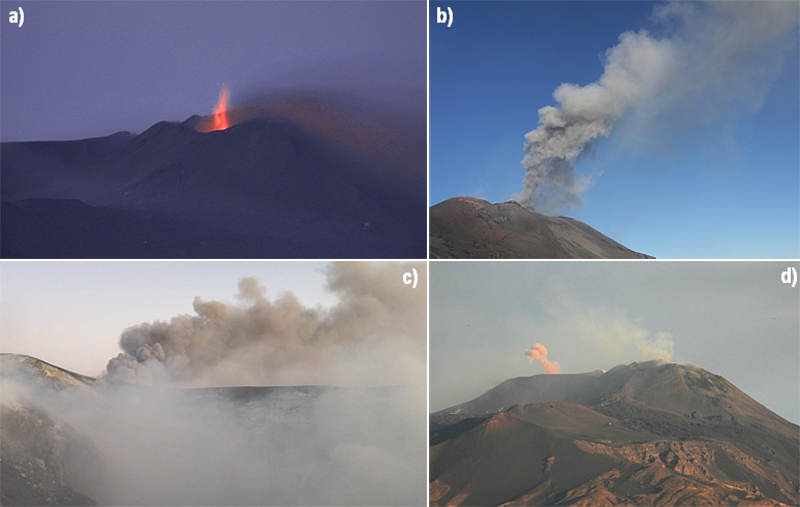 | Figure 316. Photos showing Strombolian activity at the New Southeast Crater at Etna on 25 October 2020 (top left); ash emissions were observed during 22 October 2020 (top right). Ash emissions rose above the Bocca Nuova Crater on 22 October (bottom left) and weak ash emissions were seen above the Voragine Crater on 22 October (bottom right). Courtesy of INGV (Report 44/2020, ETNA, Bollettino Settimanale, 19/10/2020 – 25/10/2020, data emissione 27/10/2020). |
Activity in November continued with variable Strombolian explosions accompanied by discontinuous ash emissions from the NSEC, NEC, and BN. During more intense explosions, ejecta reached several tens of meters above the crater, sometimes falling just outside the crater rim. Intensive degassing in the BN crater revealed occasional reddish ash in the new W pit crater that formed in September. The central pit crater was primarily characterized by intense gas-and-steam emissions and intra-crater wall collapses. Four vents were observed on the bottom of the NEC during 2-8 November, though only three of them produced Strombolian explosions, the fourth was quiet. On 5 November Strombolian explosions in BN originated from the W pit crater; coarser material was ejected above the pit crater rim. By 12 November Strombolian activity had decreased, explosions in the BN had deposited material on the S flank. Out of the three active NEC scoria cones, only one was continuously exploding, the second had discontinuous explosions, and the third was primarily emitting gas-and-steam. On 15 November faint ash emissions from the E side of the NSEC were observed (figure 317). On 20 November sporadic explosive activity continued from the NSEC and BN, the former of which occasionally ejected material above the crater rim (figure 318).
 | Figure 317. Webcam images of the New Southeast Crater at Etna on 14 (left) and 15 (right) November 2020 showing Strombolian activity in the cono della sella (left) and the E vent shown by the black arrow (right). Images were taken by the Montagnola webcam. Courtesy of INGV (Report 47/2020, ETNA, Bollettino Settimanale, 09/11/2020 – 15/11/2020, data emissione 17/11/2020). |
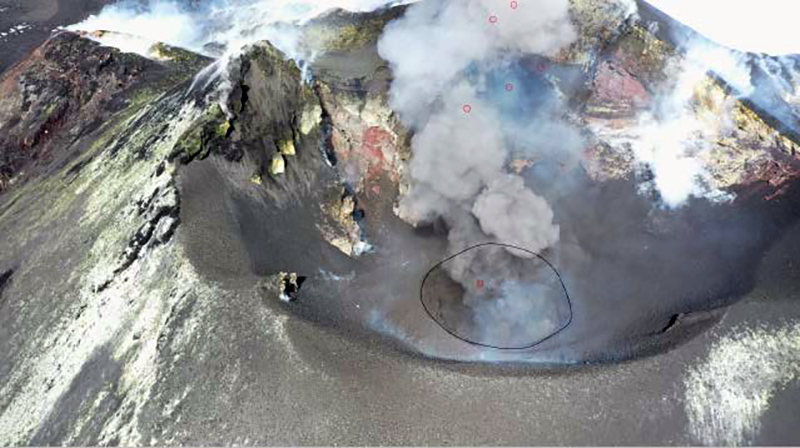 | Figure 318. Drone image of the New Southeast Crater at Etna on 21 November 2020 showing an ash plume rising above the inner crater rim (black line). Fallout is visible within the crater rim (small red circles). Courtesy of INGV (Report 48/2020, ETNA, Bollettino Settimanale, 16/11/2020 – 21/11/2020, data emissione 24/11/2020). |
Information Contacts: Sezione di Catania - Osservatorio Etneo, Istituto Nazionale di Geofisica e Vulcanologia (INGV), Sezione di Catania, Piazza Roma 2, 95123 Catania, Italy (URL: http://www.ct.ingv.it/it/); MIROVA (Middle InfraRed Observation of Volcanic Activity), a collaborative project between the Universities of Turin and Florence (Italy) supported by the Centre for Volcanic Risk of the Italian Civil Protection Department (URL: http://www.mirovaweb.it/); Hawai'i Institute of Geophysics and Planetology (HIGP) - MODVOLC Thermal Alerts System, School of Ocean and Earth Science and Technology (SOEST), Univ. of Hawai'i, 2525 Correa Road, Honolulu, HI 96822, USA (URL: http://modis.higp.hawaii.edu/); Global Sulfur Dioxide Monitoring Page, Atmospheric Chemistry and Dynamics Laboratory, NASA Goddard Space Flight Center (NASA/GSFC), 8800 Greenbelt Road, Goddard, Maryland, USA (URL: https://so2.gsfc.nasa.gov/); Boris Behncke, Istituto Nazionale di Geofisica e Vulcanologia (INGV), Sezione di Catania, Piazza Roma 2, 95123 Catania, Italy (URL: https://twitter.com/etnaboris).
April 2021 (BGVN 46:04)  Cite this Report
Cite this Report
Frequent explosions, ash plumes, fountaining, and lava flows during December 2020-March 2021
Etna is located on the island of Sicily, Italy, and has had eruptions that date back 3,500 years. Its most recent eruptive period began in September 2013 and more recently has been characterized by frequent Strombolian explosions, effusive activity, and ash emissions. Activity has commonly originated from the summit areas, including the Northeast Crater (NEC), the Voragine-Bocca Nuova (or Central) complex (VOR-BN), the Southeast Crater (SEC, formed in 1978), and the New Southeast Crater (NSEC, formed in 2011). Another crater, referred to as the "cono della sella" (saddle cone), developed during early 2017 in the area between SEC and NSEC. This report covers activity from December 2020 through March 2021, consisting of frequent Strombolian explosions of variable intensity, effusive activity, ash emissions, and ashfall. Information for this report comes from weekly and special reports by the Osservatorio Etneo (OE), part of the Catania Branch of Italy's Istituo Nazionale di Geofisica e Vulcanologica (INGV).
Summary of activity during December 2020-March 2021. Intra-crater Strombolian explosions that varied in frequency and intensity throughout the reporting period, and the accompanying ash plumes that rose to a maximum altitude of 11 km, primarily originated from the Southeast Crater (SEC), Voragine Crater (VOR), and occasionally the Northeast Crater (NEC) and Bocca Nuova Crater (BN). Beginning in mid-February a series of short lava fountaining events occurred in the SEC that continued through March. These episodes were also characterized by accompanying ash plumes, incandescent ejecta, and lava flows.
MIROVA (Middle InfraRed Observation of Volcanic Activity) analysis of MODIS satellite data shows strong and frequent thermal anomalies throughout the reporting period (figure 319). Some of these anomalies were markedly high in mid-December, mid-January, and mid-March. According to the MODVOLC thermal algorithm, a total of 190 alerts were detected in the summit craters during December through March; thermal anomalies were reported for nine days in December, eleven days in January, fifteen days in February, and sixteen days in March. Frequent Strombolian activity contributed to distinct SO2 plumes that drifted in multiple directions (figure 320).
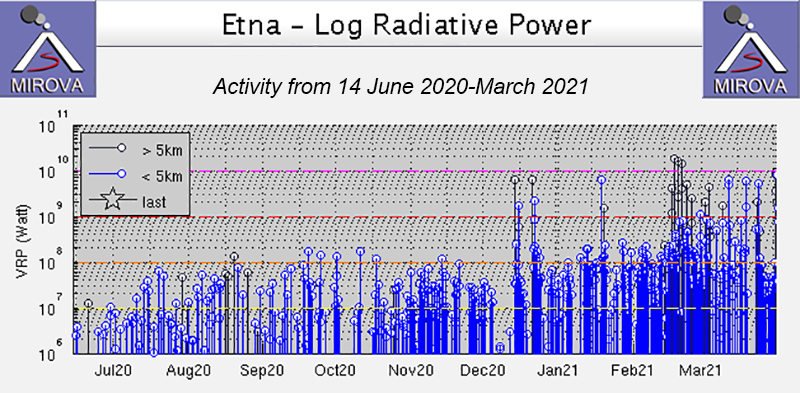 | Figure 319. Strong and frequent thermal anomalies at Etna were detected during December 2020 through March 2021, as reflected in the MIROVA data (Log Radiative Power). Some thermal anomalies were significantly high in mid-December, mid-January, and mid-March. Courtesy of MIROVA. |
 | Figure 320. Distinct SO2 plumes from Etna were detected by the TROPOMI instrument on the Sentinel-5P satellite on multiple days during December 2020 to March 2021 due to frequent Strombolian explosions, including 22 December (top left) 2020, 20 January (top right), 21 February (bottom left), and 7 March (bottom right) 2021. Courtesy of NASA Global Sulfur Dioxide Monitoring Page. |
Activity during December 2020. During December, INGV reported intra-crater Strombolian explosions in the SEC, NEC, and BN. During the more intense SEC explosions material was ejected onto the flanks. Gas-and-steam emissions were reported in the VOR. A field survey on 13-14 December showed that the SEC was an irregular ellipse 150 x 230 m open to the SW. On 13 December Strombolian activity intensified at 2020 and around 2300 evolved to lava fountains which lasted through 2350, though explosions continued. Collapses of the SW part of the SEC at 2315 resulted in pyroclastic flows that traveled up to 2 km, covering the Monte Frumento Supino cone (SSW flank). Around that time two fissures opened on the SW flank of the SEC and produced lava flows until about 2350 (figure 321). A third minor pyroclastic flow went down the SSW flank at 2330. Two lava fountains were seen during 0050-0110 on 14 December.
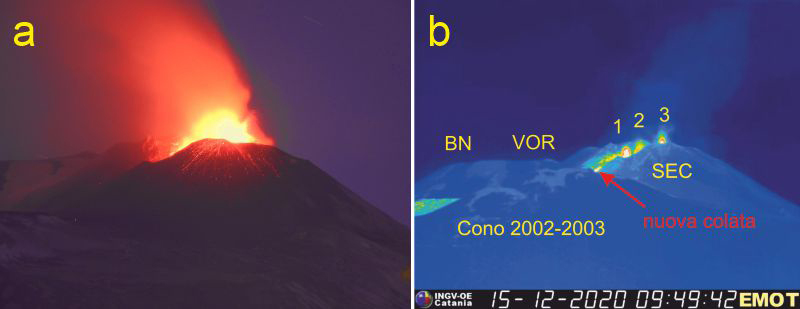 | Figure 321. Photos of Strombolian activity at the Southeast Crater at Etna on the evening of 14 December 2020 (left) seen from Tremestieri Etneo (20 km S) and a thermal image showing the Bocca Nuova, Voragine, and three active vents in the SEC seen from the Montagnola (EMOV) thermal camera at 0949 (UTC) on 15 December (right). Courtesy of INGV (Report 52/2020, ETNA, Bollettino Settimanale, 14/12/2020 – 20/12/2020, data emissione 22/12/2020). |
During a field inspection on 14 December scientists noted that the two lava flows on the S and SW flanks were cooling; the S flow had widened near the base of the SEC and formed four main lobes, one of which had stopped just NW of the cones that formed in 2002-2003 (figure 322). The SW flow traveled SSW, branched, curved around the W part of Monte Frumento Supino, and then stopped. An explosion in the easternmost SEC vent generated an ash plume at 1352 that rose to 4 km altitude and drifted S. Additionally, on 14 December sporadic ash explosions resumed in the VOR; incandescent ejecta was visible at night. On 15 December a new lava flow formed on the SW flank of the SEC at 0924 that advanced a few hundred meters. Eruptive activity briefly stopped in the E vent of the SEC during the afternoon of the 15th and during 16-18 December exhibited strong degassing and nighttime incandescence.
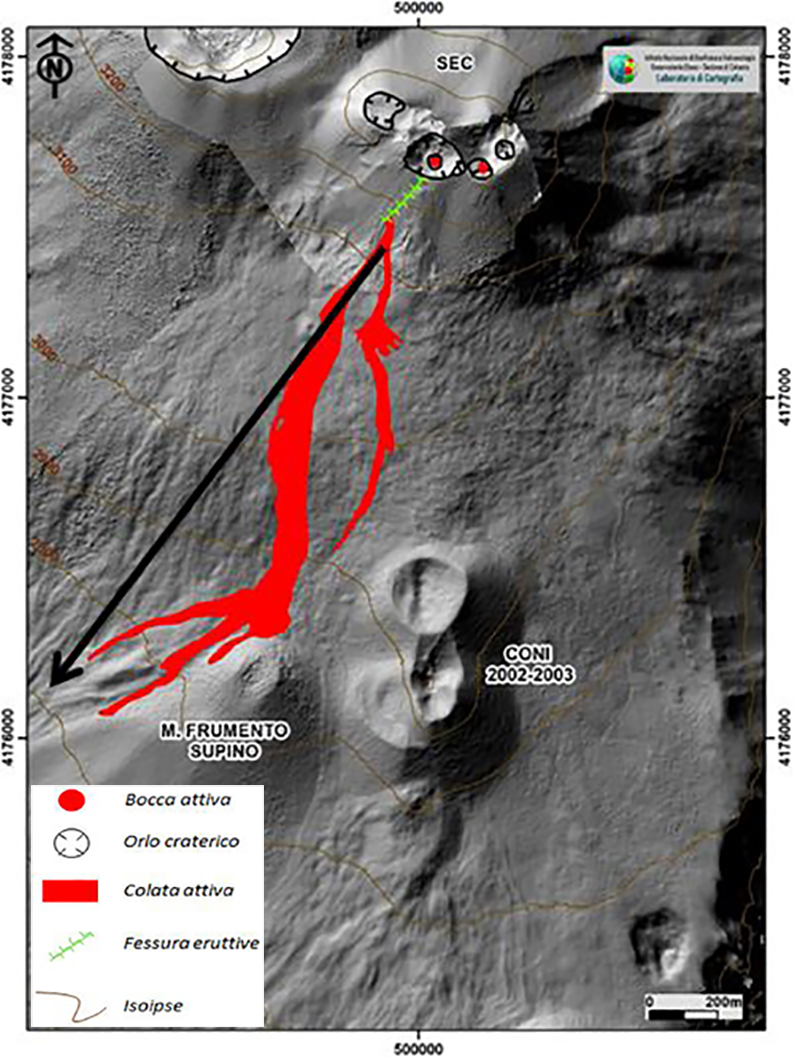 | Figure 322. Map of the Southeastern Crater (SEC) at Etna showing active lava flows and the cono della sella (red dot). The light green hatch mark represents the location of the eruptive fissure that opened on the SEC flank. The lava flow extended about 2 km SW, and by 14 December had formed four main lobes. The black arrow represents the direction of the pyroclastic flow after the collapse of the SW portion of the SEC cone. This map uses ground observations and thermal image analysis on a PlanetScope satellite image. Courtesy of INGV (Report 51/2020, ETNA, Bollettino Settimanale, 07/12/2020 – 13/12/2020, data emissione 15/12/2020). |
Seismic tremor amplitude gradually increased on 20 December, though weather conditions prevented observations. On 21 December at 1008 Strombolian activity increased in the SEC from the central and easternmost vents. Activity evolved to lava fountaining that lasted an hour, as well as an ash plume that rose to 10 km altitude and drifted NE. An active lava flow was still visible on the SW part of the cone which had collapsed on 13 December. A second flow was observed at 1521 on the S slope of the SEC that descended toward the Valle del Bove. Activity continued through the night (figure 323), and on 22 December at 0350 Strombolian activity increased in the central and easternmost vents; around 0415 a lava flow from the SW flank traveled W, overlapping cooling lava from 21 December. Lava fountaining began again at 0519 and fed three lava flows: one from the S flank traveled SW for 2.8 km and was 600 m wide, branching off to the W and E of Monte Frumento Supino, a second that traveled 2.8 km E toward the Valle del Bove, and a third that originated at the E vent of the SEC that traveled 1.3 km ENE toward the Valle del Leone (figure 324). At 0520 a few small phreatic explosions in the Valle del Bove were due to the lava flow interacting with snow. By 0600 the lava fountains gradually subsided and stopped, though Strombolian explosions persisted at varying intensities. On 24 December at 0830 explosive activity in the E vent of the SEC gradually increased, ejecting material above the crater rim and emitting ash that drifted E.
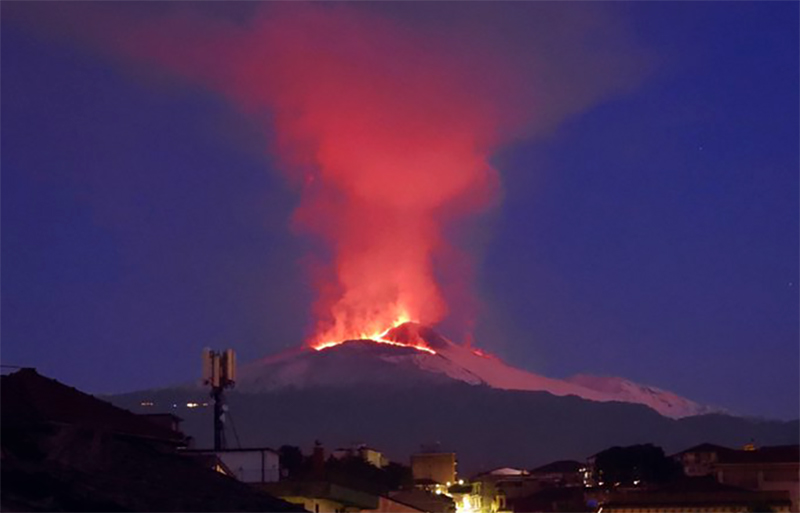 | Figure 323. Photo of Etna's Southeast Crater showing a new episode of lava fountaining during the early morning on 22 December 2020 viewed from Tremestieri Etneo, south of the volcano. Photo by Boris Behncke, INGV. |
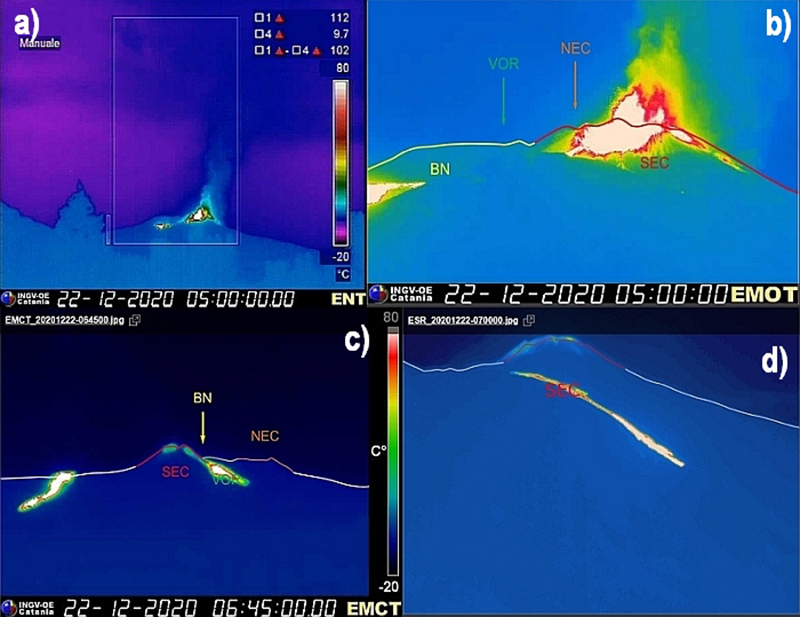 | Figure 324. Thermal webcam images showing (top left) Strombolian explosions and (top right) lava fountaining in the Southeast Crater seen from the Nicolosi (ENT) and Montagnola (EMOT) cameras on 22 December 2020. Lava flows were visible traveling toward the Valle del Bove and Valle del Leone seen from the Monte Cagliato (EMCT) (bottom left) and Schiena della'asino (ESR) (bottom right). Courtesy of INGV (Report 53/2020, ETNA, Bollettino Settimanale, 21/12/2020 – 27/12/2020, data emissione 29/12/2020). |
On 29 December at 0750 there was a gradual increase in explosive activity in the E vent of the SEC, producing ash emissions that drifted ENE. Around 0900 Strombolian activity further intensified, ejecting coarse material onto the E flank of SEC (figure 325), but by 1000 the explosions had decreased. Intra-crater Strombolian activity in the NEC, VOR, and BN continued with sporadic ash emissions through the rest of the month; explosions in the VOR intensified, ejecting material above the crater rim.
 | Figure 325. Photos of the Strombolian activity at the Voragine (left background) and Southeast Crater (right foreground) at Etna on the evening of 28 December (left) and ash emissions rising from the SEC on the morning of 29 December (right) 2020. Photos by Boris Behncke, INGV. |
Activity during January 2021. Activity in January continued with intra-crater Strombolian explosions of variable intensity in the SEC, NEC, VOR, and BN with sporadic ash emissions. On 4 and 6 January at least two episodes of intense Strombolian explosions produced continuous ash plumes that drifted E and ejected coarse pyroclastic material. A lava flow on 17 January breached the SEC at 0740 and traveled to the base of the cone toward the Valle del Bove (figure 326); the lava effusion rate increased at 0819, and the flow reached an elevation of 3 km by 1000. Volcanic tremor amplitude and Strombolian activity intensified at 2000 on 18 January, evolving into lava fountains through 2130. A lava flow emerged in the E vent of the SEC at 2015 and moved 2 km ESE toward the Valle del Bove. Lava fountaining produced a plume that drifted SE, resulting in ashfall in Fleri and Acicastello (figure 327). During 2130-2147 a second lava flow on the N side of the SEC reached a length of 1.3 km. By 19 January the explosions decreased in intensity and the lava flows had begun to cool. On 20 January a new lava flow on the N side of the SEC traveled ENE at 0140, overlapping the previous flow on the 18th; by 1830 it was no longer active. The VOR was characterized by almost continuous Strombolian explosions that ejected material above the crater rim. Satellite imagery from 27 January showed that a small lava flow from a vent in the N section of the VOR was pouring into the BN. The BN also produced Strombolian explosions that often ejected material above the crater rim. At night, summit crater incandescence was observed in the NEC.
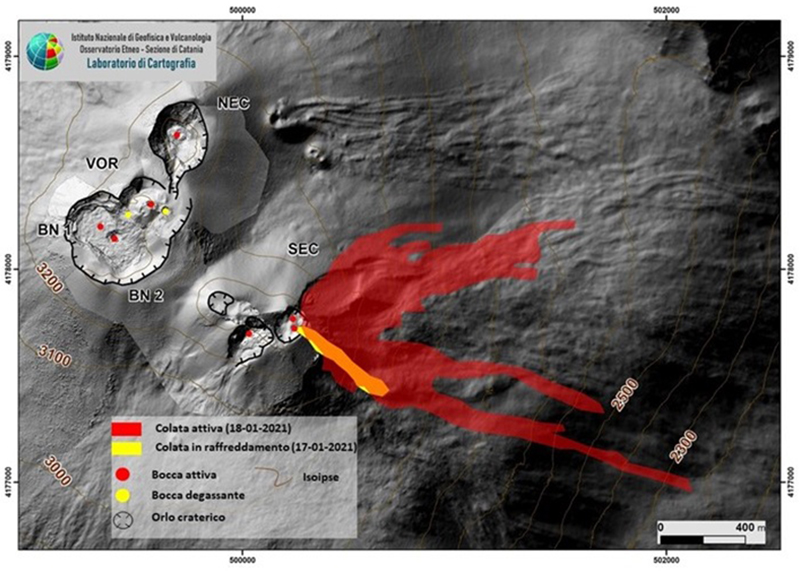 | Figure 326. Map of the summit craters of Etna showing the active vents and lava flow field on 18 January 2021. The base is modified from a 2014 DEM created by Laboratorio di Aerogeofisica-Sezione Roma 2. The hatch marks indicate the crater rims: BN = Bocca Nuova; VOR = Voragine; NEC = North East Crater; SEC = South East Crater. Red circles indicate areas with ash emissions and/or Strombolian activity. Yellow circles indicate steam and/or gas emissions only. The red shape highlights the active lava flow on 18 January and the yellow and orange shape highlights the cooling lava flow from 17 January. Courtesy of INGV (Report 04/2021, ETNA, Bollettino Settimanale, 18/01/2021 – 26/01/2021, data emissione 26/01/2021). |
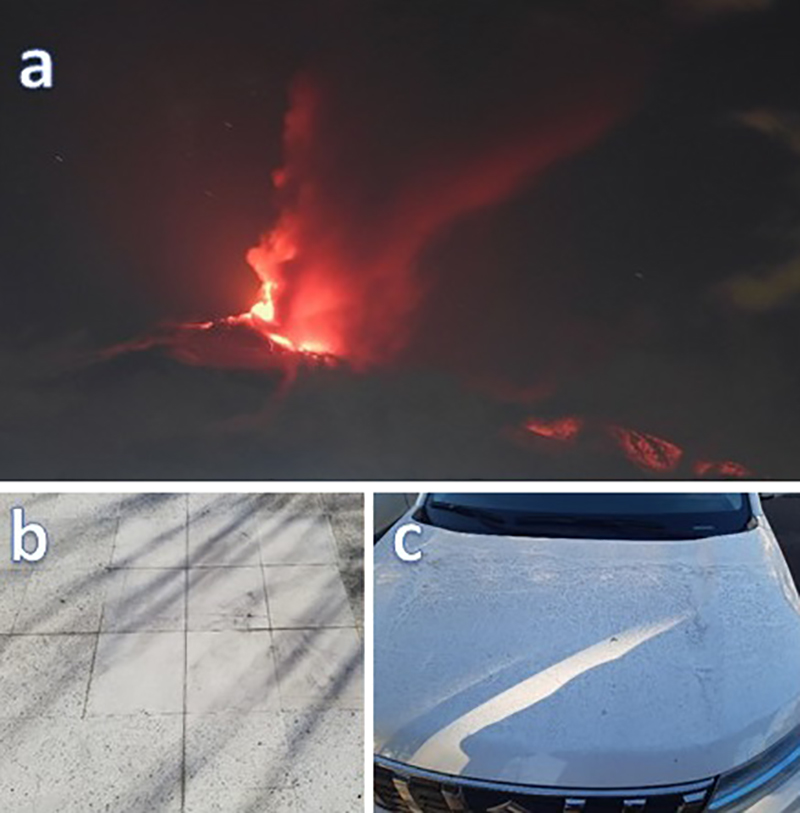 | Figure 327. Photos of lava fountains and an ash plume in the SEC at Etna that resulted in ashfall on the SE flank (top) as well as in Fleri (bottom left) and Acicastello (bottom right). Photo a was taken from Tremestieri on the S side of the volcano. Courtesy of INGV (Report 04/2021, ETNA, Bollettino Settimanale, 18/01/2021 – 26/01/2021, data emissione 26/01/2021). |
Activity during February 2021. Variable Strombolian activity continued into February at all four summit craters; the last time this occurred was during 1998-1999. The most intense, almost continuous, Strombolian explosions at the SEC originated from two vents in the eastern top of the cone; less intense activity occurred at the S vent. Intra-crater Strombolian activity at the NEC sometimes produced nighttime incandescence. Explosions at the BN sometimes ejected coarse material above the crater rim. A field inspection on 5 February showed that three scoria cones had been built around vents at the bottom of the crater. Another nearby cone occasionally produced dense emissions. Intra-crater lava flows continued to spill into the BN from the VOR, overlapping those formed in late January. On 6 February around 0530 Strombolian activity intensified in the E vent of the SEC and produced an ash plume that drifted E.
During the morning of 15 February explosive activity at the SEC intensified, with activity continuing at the E vents. Sporadic and sometimes violent explosions were also observed at the saddle cone; intra-crater explosive activity continued in the BN, VOR, and NEC. On 16 February at 1700 lava began advancing down the E flank of the SEC for a few kilometers. A partial cone collapse at 1705 produced a pyroclastic flow that traveled 1.5 km along the W wall of the Valle del Bove. The activity changed to lava fountains around 1710, rising 500-600 m high and generating an ash plume that rose to 6-10 km altitude and drifted S (figure 328). Centimeter-sized lapilli and ash was observed in Nicolosi (16 km S), Mascalucia (19 km S), and as far as Catania (29 km SSE) while fine ashfall was reported in Syracuse (60-80 km SSE). Lava flows continued to advance into the Valle del Bove, reaching an elevation of 2 km by 1759. Another lava flow from the SEC traveled N toward the Valle del Leone; smaller lava flows traveled N and S, reaching 2.9 km elevation. Explosive activity decreased and lava fountaining stopped between 1800 and 1838, though ashfall continued; by 2025 the lava flows had stopped. Strombolian activity persisted at the SEC overnight during 16-17 February and stopped by 0715 on 17 February, though sporadic explosions were reported in the VOR at 0420, 0435, 0444.
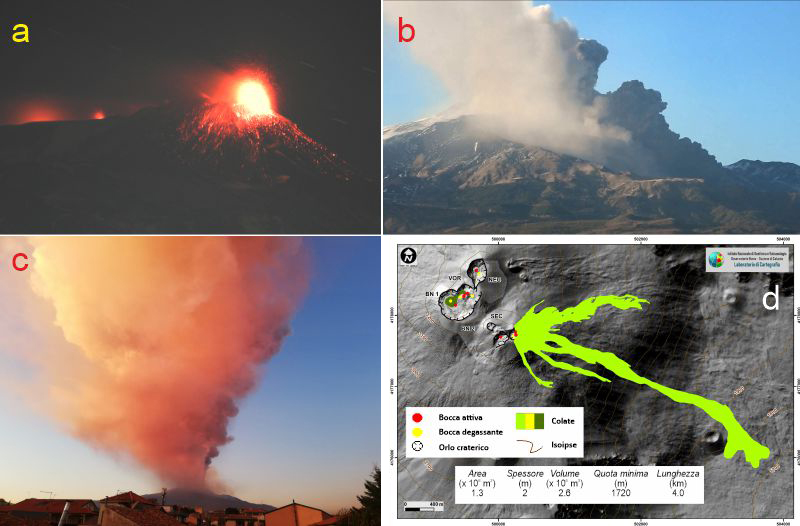 | Figure 328. Photos during 15-16 February of Strombolian activity at the summit craters at Etna on 15 February 2021 (top left); a pyroclastic flow that occurred at the beginning of the eruptive event on 16 February at 1805 (top right); an eruption plume that was a result from the eruptive event on 16 February, seen from the S (bottom left); map of the lava flows on 16 February showing the active vents (red dots), degassing vents (yellow dots), summit craters (black hatch marks), and direction of the lava flows (light green and dark green), as well as the maximum length (4 km) and volume (2.6 million cubic meters) (bottom right). Courtesy of INGV (Report 08/2021, ETNA, Bollettino Settimanale, 15/02/2021 – 21/02/2021, data emissione 23/02/2021). |
An eruptive event began at 2330 on 17 February, about 30 hours after the previous one, with a lava flow from the E vents in the SEC, followed by lava fountaining at 0100 on the 18th that rose 600-700 m (figure 329). The lava flow advanced toward the Valle del Bove, the NE, SE, and SW through the saddle vent ("bocca della sella"), covering an area of about 1 km. A second flow on the N flank of the SEC moving toward the Valle del Leone was about 1 km long. Another flow was reported on the S side of the SEC. The resulting ash plume drifted SE, causing ashfall in Zafferana, Etna, and Acireale. The lava fountains ended between 0140-0155 on 18 February, though the lava flows continued to advance.
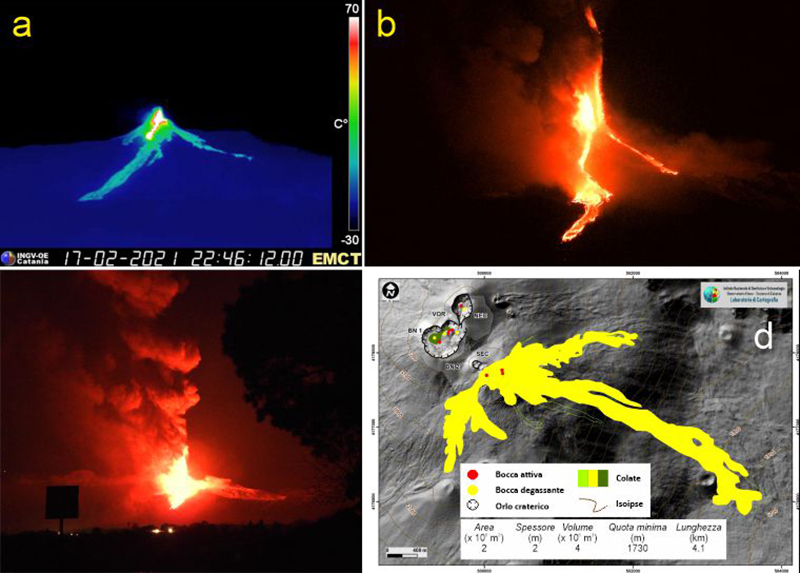 | Figure 329. Activity at Etna during 17-18 February 2021 included lava flows and fountaining. The initial lava flow is seen in a thermal camera image just before midnight from Monte Cagliato on the E side of the volcano (top left). Lava fountains that rose 600-700 m high and lava flows are seen from Milos shortly after midnight (top right). An eruption plume seen from Milos at 0020 on 18 February was accompanied by nighttime incandescence, lava fountains, and lava flows (bottom left). A map of the lava flows on 17-18 February shows the active vents (red dots), degassing vents (yellow dots), summit craters (black hatch marks), and direction of the lava flows (yellow and green), as well as the maximum length (4.1 km) and volume (4 million cubic meters) of the flows (bottom right). Courtesy of INGV (Report 08/2021, ETNA, Bollettino Settimanale, 15/02/2021 – 21/02/2021, data emissione 23/02/2021). |
During the morning of 19 February a lava flow effused from the E vents in the SEC at 0855, followed by a rapid increase in explosions and renewed lava fountaining (figure 330). A line of 4-5 vents produced "fan-shaped" lava fountains at 0953. An ash plume rose to 10 km altitude and drifted SE, causing ashfall in some towns. The lava flow that descended toward the Valle del Bove interacted with snow, causing strong explosions, and were accompanied by rockfalls on the flanks of the SEC. By 1110 the explosive activity had stopped.
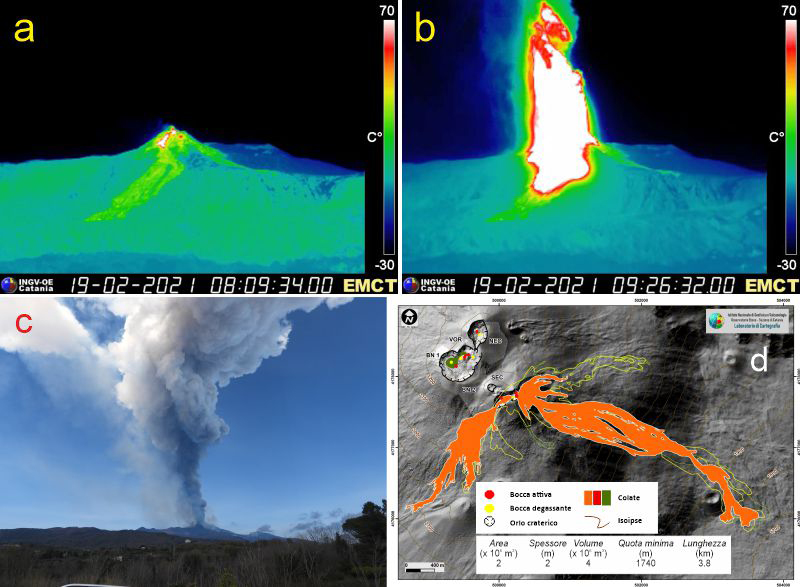 | Figure 330. Thermal images of the lava flow at Etna around 0900 (local) on 19 February 2021 taken with the thermal camera in Monte Cagliato (top left). Later lava fountains reached 600-700 m high, based on the thermal image from Monte Cagliato (top right). A strong ash plume was observed from Pisano (SE) (bottom left). A map of the lava flows on 19 February showing the active vents (red dots), degassing vents (yellow dots), summit craters (black hatch marks), and direction of the lava flows (orange and green), as well as the maximum length (3.8 km) and volume (4 million cubic meters) (bottom right). Courtesy of INGV (Report 08/2021, ETNA, Bollettino Settimanale, 15/02/2021 – 21/02/2021, data emissione 23/02/2021). |
Weak Strombolian activity was visible in the late afternoon of 20 February (figure 331). At 2230 a small lava flow from the E vent in the SEC descended 150-200 m into the Valle del Bove. By 2300 the activity had changed to pulsating lava fountains. Beginning at 0100 on 21 February more western vents became active and the E vents ejected lava 600-800 m high. At 0128 lava fountains were ejecting lava up to 1 km high and were sustained for about 10 minutes (figure 331). At the same time, a lava flow from the saddle vent moved a few hundred meters SW. An ash plume rose to 10 km altitude, resulting in ashfall on the SW flank. At 0200 the lava fountains decreased in intensity and by 0220 explosive activity stopped. Periodic ash emissions rose from both the S and E vents later in the evening. A lava flow in the SEC advanced 1 km toward the Valle del Bove. Lava fountains and Strombolian explosions continued at multiple vents. Activity intensified again during 0218-0220 on the 22nd, with lava fountains over 1 km high sending incandescent material onto the flanks. Lava flows in the Valle del Bove reached 3.5-4 km from the crater. During 0430-0515 about 20 strong explosions from SEC vents ejected incandescent bombs that landed at the base of the cone. The NEC was characterized by strong degassing and crater incandescence, often accompanied by Strombolian activity.
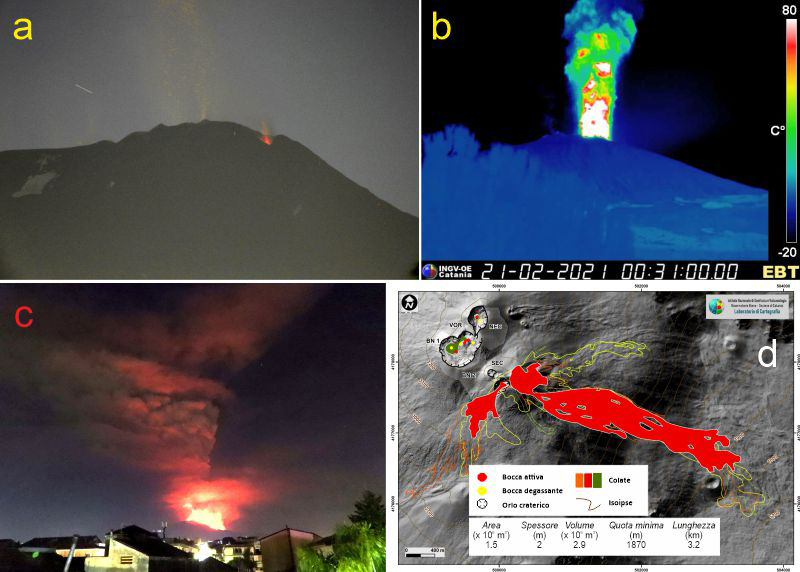 | Figure 331. Images of weak Strombolian activity in the eastern vents of the SEC at Etna at sunset on 20 February 2021 (top left). Thermal image from the Bronte thermal camera showing strong Strombolian activity at 0131 (local) on 21 February (top right). A strong ash plume at 0205 on 21 February was observed from Tremestieri Etneo (bottom left). A map of the lava flows during 20-21 February showing the active vents (red dots), degassing vents (yellow dots), summit craters (black hatch marks), and direction of the lava flows (red and green), as well as the maximum length (3.2 km) and volume (2.9 million cubic meters) (bottom right). Courtesy of INGV (Report 08/2021, ETNA, Bollettino Settimanale, 15/02/2021 – 21/02/2021, data emissione 23/02/2021). |
During the evening on 22 February weak Strombolian explosions were visible in the SEC. The frequency and intensity of the explosions increased and by 2210 material was ejected onto the flanks. Jets of lava were ejected 300 m high at 2305, and by 2327 lava fountains were reported from a second SEC vent. Lava overflowed the crater at 2328 toward the Valle del Bove. Within the first hour of 23 February lava fountains rose more than 1.5 km and an ash plume reached 10 km altitude, causing ashfall to the NW. Lava overflowed the S vent and descended SW. At 0115 the lava fountains decreased. Strombolian activity intensified again at 0450, accompanied by ash emissions. Two lava flows traveled SW and SE, the latter of which reached 1.7-1.8 km elevation. By 1000 the lava flows were no longer active; the flow on the SW flank had traveled a few hundred meters, overlapping the previous flows.
The lava fountaining episodes continued; Strombolian activity at the two vents in the SEC increased during the late afternoon on 24 February that evolved into lava fountains reaching 400 m above the crater. Ash emissions also persisted in the SEC. Lava overflows from the crater headed ESE toward the Valle del Bove as far as 2-4 km and in the S area of the SEC. During 1900-2122 the lava fountains reached 500 m high and a resulting ash plume rose as high as 11 km altitude. A second lava flow traveled SW and at 2100 a pyroclastic flow descended 1 km into the Valle del Bove. The lava fountains in the SEC stopped by 2335, though the lava flow remained active in the SW and E sections.
Weak Strombolian activity on 28 February was visible at 0810 that evolved to lava fountains at 0839, feeding lava flows that traveled E toward the Valle del Bove. The fountains abruptly intensified at 0902 with jets of lava rising 700 m above the crater rim. An ash plume rose as high as 11 km altitude and drifted ESE, resulting in ashfall to the E (figure 332). A small lava flow at the S part of the SEC began at 0909, followed by a pyroclastic flow at 0920. The lava fountains ended abruptly at 0933, though the lava descending E remained active. By 1526 the lava flow in the Valle del Bove was no longer active.
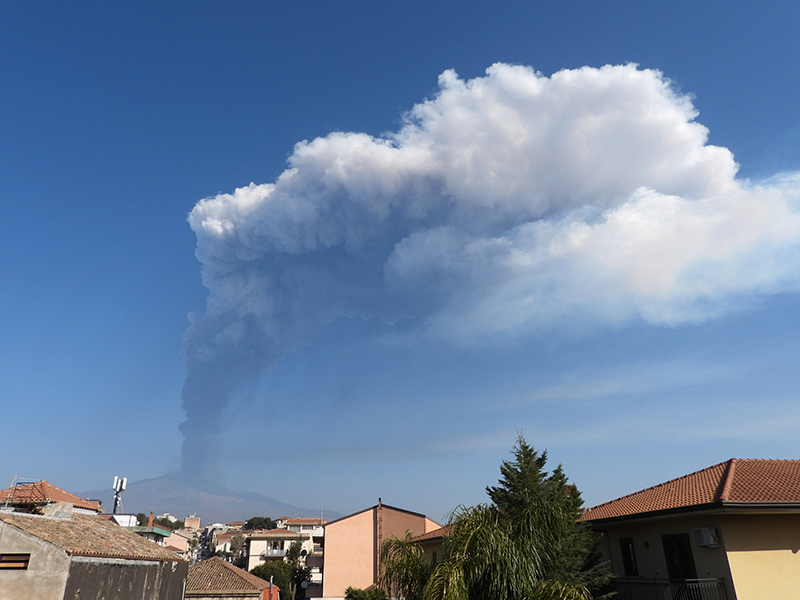 | Figure 332. Photo of a strong ash plume rising above Etna's Southeast Crater on the morning of 28 February 2021 that drifted ESE, with ashfall visible. Taken from Tremestieri Etneo. Photo by Boris Behncke, INGV. |
Activity during March 2021. Weak Strombolian activity resumed on 2 March at 1145 in the SEC, which increased in intensity at 1234 with ash emissions. From 1324 to 1550 lava fountains generated an ash plume 9 km above the crater, depositing ash and lapilli in Nicolosi, Aci San Antonio (18 km SE), Pedara (15 km SSE), and Catania (29 km SSE). On 4 March Strombolian explosions increased at 0200 and produced ash emissions that dispersed NE (figure 333). At the same time, Strombolian activity from VOR ejected material above the crater. Degassing persisted in the NEC. Around 0320 the Strombolian explosions in the SEC evolved to lava fountains and at 0515 a lava flow from the E section of the base of the cone was traveling toward the Valle del Bove. Strombolian activity in VOR changed to lava fountains at 0859 that were 300 m high. An ash plume rose 11 km above the crater, depositing ash and lapilli in Fiumefreddo (19 km ENE), Linguaglossa (17 km ESE), and the area of Reggio Calabria. Lava fountains continued.
 | Figure 333. Photos of the beginning an eruptive episode characterized by an early lava flow originating from Etna's Southeast Crater (right foreground) and an explosion at the Voragine Crater (left background) on 4 March 2021 (left). Dense gray ash plumes and white degassing plumes were visible from several summit vents on 4 March (right). Taken from Tremestieri Etneo. Photos by Boris Behncke, INGV. |
Another eruptive episode on 7 March starting between 0100 and 0200 included Strombolian explosions and minor lava effusions at the E base of the SEC that descended into the Valle del Bove. At 0430 an increase in Strombolian activity generated an ash plume that rose to 5 km altitude and drifted E. The lava reached an elevation of 2.8 km altitude by 0450. Strombolian activity intensified again at 0520 and the lava flow advanced to 2.7 km elevation. Lava fountains at 0720 generated another ash plume that rose to 10 km altitude and drifted E. INGV-OE personnel reported ash and lapilli deposits in Milo (11 km ESE), Fornazzo (10 km ESE), Trepunti (17 km ESE), Giarre (17 km ESE), Macchia di Giarre (16 km ESE), Mascali (18 km E), Riposto (19 km ESE), and Torre Archirafi (20 km ESE). Strombolian activity resumed at 1050 and was over by 1500.
Similar Strombolian activity in the SEC on 10 March changed to lava fountaining and a large eruption plume that rose to at least 9 km altitude and drifted ENE (figure 334). Ash and lapilli were reported in Mascali, Giarre, and Fiumefreddo. A lava flow from the S vent reached an elevation of 1.8 km. By 0430 on 10 March the lava fountaining had stopped, though sporadic ash emissions continued until 0700. On 12 March Strombolian activity in the SEC and accompanying ash emissions began again. As the activity intensified, lava overflowed the E part of the SEC, descending toward the Valle del Bove. Lava fountaining was observed up to 500 m and generating an ash plume that rose to 6 km altitude and drifted E. Within an hour, lava had advanced from an elevation of 2.8 km to 2 km. By 0939 the ash plume had risen to 9-10 km altitude and resulted in ashfall in Fleri, Milo, Fornazzo , Giarre, Santa Venerina (15 km SE), and Torre Archirafi (20 km ESE) (figure 335). Lava fountaining had stopped at 1050, though weak Strombolian activity and ash emissions persisted until 1115. The lava flow advanced as far as 1.7 km elevation while a second lava flow expanded on the W slope of the Valle del Bove for an average length of 3 km and a volume of roughly 1 million cubic meters. Strombolian activity continued in the NEC, BN, and VOR, producing minor ash emissions.
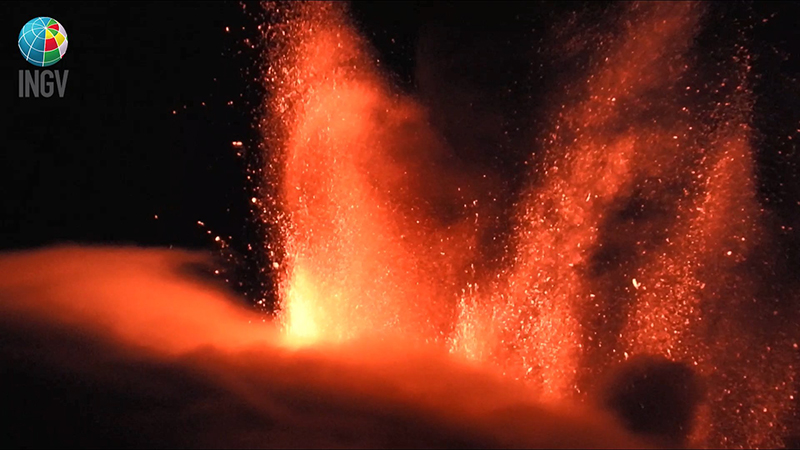 | Figure 334. Photo of the nighttime lava fountaining activity at Etna during 9-10 March 2021. Courtesy of INGV Youtube channel. |
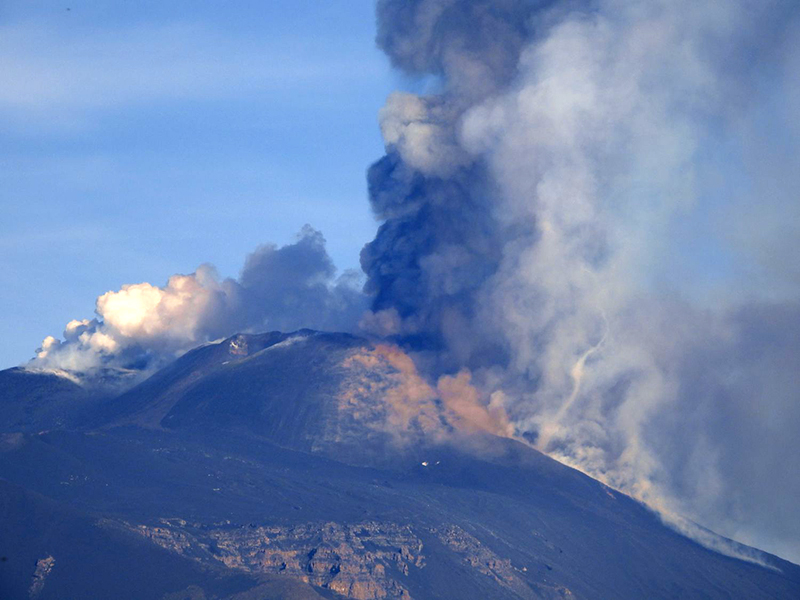 | Figure 335. Photo of an ash plume rising above Etna's Southeast Crater on the morning of 12 March 2021. Taken from Tremestieri Etneo. Photo by Boris Behncke, INGV. |
On 14 March Strombolian activity began at 2110 that evolved into lava fountaining at 0048 on the 15th (figure 336). Lava traveled toward the Valle del Bove as an ash plume drifted E (figure 337). By 0343 lava fountaining had stopped, though weak Strombolian activity and lava flows continued. On 17 March at 0155 weak Strombolian activity was observed, changing into lava fountaining at 0319. An ash plume drifted SE and a lava flow was moving toward the Valle del Bove, the latter of which overlapped the one from 15 March. Due to cloud cover, observations were limited and discontinuous. Fountaining activity stopped at 0717 and was followed by explosive activity. Weather conditions cleared the summit on 18 March at 2142, showing explosions in the SEC and a lava flow in the Valle del Bove. On 19 March at 0734 explosive activity was visible in the SEC, which intensified at 0915, accompanied by ash emissions. Lava fountaining started at 0935 with an accompanying ash plume that drifted ENE. By 1136 lava fountaining had stopped and changed to Strombolian activity, which gradually decreased. Only sporadic explosions were visible with minor ash emissions by 1350; lava flows along the Valle del Bove were reported in the late morning.
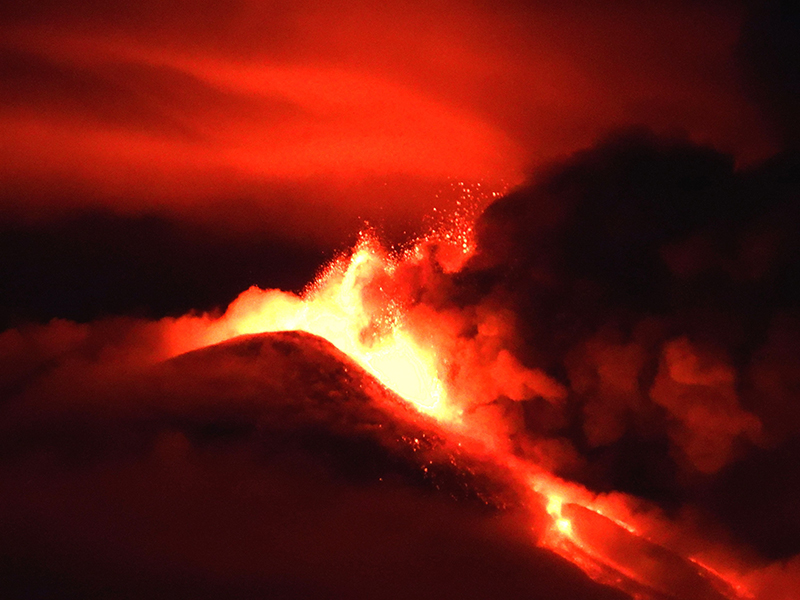 | Figure 336. Photo of a lava fountain episode at Etna's Southeast Crater during the night of 14-15 March 2021. Taken from Tremestieri Etneo. Photo by Boris Behncke, INGV. |
 | Figure 337. A map of the lava flows on 15 March 2021 showing the active vents (red dots), degassing vents (yellow dots), summit craters (black hatch marks), and direction of the lava flows (blue), as well as the maximum length (2.7 km) and volume (1.1 million cubic meters) (bottom right). Courtesy of INGV (Report 12/2021, ETNA, Bollettino Settimanale, 15/03/2021 – 21/03/2021, data emissione 23/03/2021). |
Though weather conditions often prevented a clear view of the summit, weak Strombolian activity was reported in the SEC at 2005 on 23 March, which had evolved into lava fountaining at 0330 on 24 March (figure 338). At 0335 a lava flow from the SEC was seen branching toward the Valle del Bove and the SE. A pyroclastic flow followed the lava at 0336, descending into the Valle del Bove. The lava fountains generated an ash plume that rose to 6-7 km altitude and drifted SSE, resulting in ashfall on the S slope and in Catania. Lava fountaining gradually decreased at 0700 and by 0945, it had stopped; the lava flows continued to advance. Intra-crater Strombolian activity continued in the NEC, BN, and VOR, accompanied by sporadic weak ash emissions. After the fountains stopped, another ash plume was seen rising to 4.5 km altitude and drifting SE. At night, ashfall was reported in Milia and Trecastagni (16 km SE). The explosions had stopped by 1347. By 25 March the two active lava flows had stopped.
 | Figure 338. Photos of the lava fountain episode and incandescent Strombolian activity at Etna's Southeast Crater during 23 (left) and 24 (right) March 2021. Taken from Tremestieri Etneo. Photos by Boris Behncke, INGV. |
On 30 March weak Strombolian activity in the SEC resumed around 0607 with a single ash explosion that quickly dispersed near the summit (figure 339). Over the course of the day activity at the SEC gradually changed from degassing to continuous weak Strombolian activity at about 1830 from at least two active vents. This activity increased during the night, throwing lava above the crater rim accompanied by sporadic ash emissions. Several lava flows effused from the S base vent. The main part of the flow traveled toward the Valle del Bove with other smaller flows descending to the S and SW. Two other vents at the S base had opened by the evening, one of which ejected spatter a few tens of meters high. Throughout the night, periods of lava fountaining were detected while the main lava flow descended the W wall of the Valle del Bove. Strombolian activity intensified at 1850 and produced an ash plume that rose to 4 km altitude and drifted SSW. At 0000 there was a gradual transition from Strombolian activity to lava fountaining.
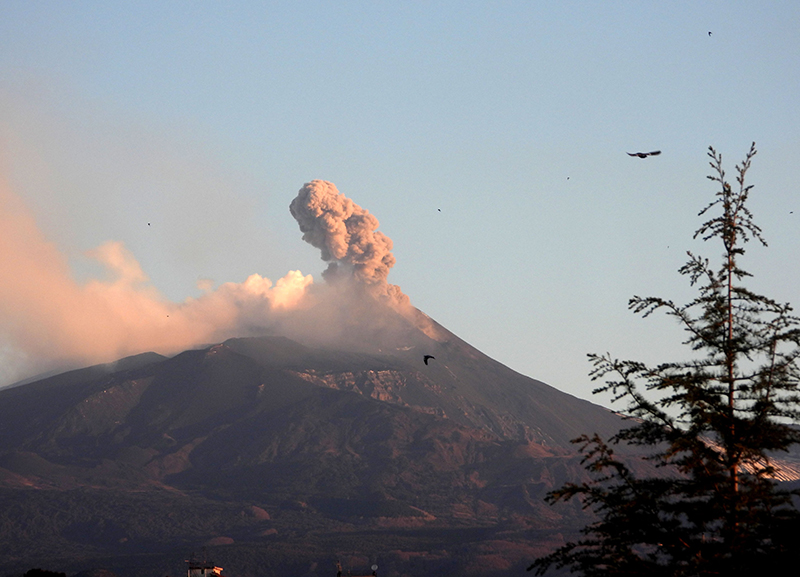 | Figure 339. Photo of an ash plume rising from Etna's Southeast Crater on the morning of 30 March 2021. Photo by Boris Behncke, INGV. |
Information Contacts: Sezione di Catania - Osservatorio Etneo, Istituto Nazionale di Geofisica e Vulcanologia (INGV), Sezione di Catania, Piazza Roma 2, 95123 Catania, Italy (URL: http://www.ct.ingv.it/it/ ); Boris Behncke, Istituto Nazionale di Geofisica e Vulcanologia (INGV), Sezione di Catania, Piazza Roma 2, 95123 Catania, Italy; MIROVA (Middle InfraRed Observation of Volcanic Activity), a collaborative project between the Universities of Turin and Florence (Italy) supported by the Centre for Volcanic Risk of the Italian Civil Protection Department (URL: http://www.mirovaweb.it/); Hawai'i Institute of Geophysics and Planetology (HIGP) - MODVOLC Thermal Alerts System, School of Ocean and Earth Science and Technology (SOEST), Univ. of Hawai'i, 2525 Correa Road, Honolulu, HI 96822, USA (URL: http://modis.higp.hawaii.edu/); NASA Global Sulfur Dioxide Monitoring Page, Atmospheric Chemistry and Dynamics Laboratory, NASA Goddard Space Flight Center (NASA/GSFC), 8800 Greenbelt Road, Goddard, Maryland, USA (URL: https://so2.gsfc.nasa.gov/).
August 2021 (BGVN 46:08)  Cite this Report
Cite this Report
Strombolian explosions, ash plumes, lava fountaining, and flows during April-July 2021
Etna, located on the island of Sicily, Italy, has documented records of historical eruptions dating back to 1500 BCE. Activity has frequently originated from its summit areas, which include the Northeast Crater (NEC), the Voragine-Bocca Nuova (or Central) complex (VOR-BN), the Southeast Crater (SEC, formed in 1978), and the New Southeast Crater (NSEC, formed in 2011). Another crater, referred to as the "cono della sella" (saddle cone), developed during early 2017 between SEC and NSEC. Its most recent eruptive period began in September 2013 and more recently has been characterized by Strombolian explosions, ash plumes, lava fountaining, and flows (BGVN 46:04). This report updates activity from April through July 2021, covering similar eruptive events, based on weekly and special reports by the Osservatorio Etneo (OE), part of the Catania Branch of Italy's Istituo Nazionale di Geofisica e Vulcanologica (INGV) and satellite data.
Summary of activity during April-July 2021. Volcanism was relatively low at Etna during April and mid-May, primarily characterized by Strombolian explosions and white gas-and-steam emissions. Beginning on 19 May 2021, activity intensified and remained high through July. Intra-crater Strombolian explosions varied in intensity and frequency dominantly in the Southeast Crater (SEC), accompanied by ash plumes that rose to a maximum altitude of 10 km, resulting in ashfall in nearby communities, lava flows primarily on the SW flank, and lava fountains that rose up to 1 km above the summit. Occasional isolated ash emissions were observed above the Northeast Crater (NEC) while degassing primarily characterized the Bocca Nuova Crater (BN) and the Voragine Crater (VOR).
MIROVA (Middle InfraRed Observation of Volcanic Activity) analysis of MODIS satellite data shows strong and frequent thermal anomalies during a majority of the reporting period; during April through mid-May there was a notable decline in the intensity of the anomalies, which was followed by a significant strong pulse, representing the lava flows in June and July (figure 340). This stronger thermal activity was also reflected in data from the MODVOLC thermal algorithm, a total of 183 alerts were detected in the summit crater during April through July; thermal anomalies were reported for four days in April, nine days in May, sixteen days in June, and twelve days in July. Additionally, the lava flows were clearly visible in Sentinel-2 infrared satellite imagery during June and July descending the SW and SE flanks from SEC (figure 341). Frequent Strombolian activity contributed to distinct sulfur dioxide plumes that exceeded two Dobson Units (DUs) that drifted generally S and E (figure 342).
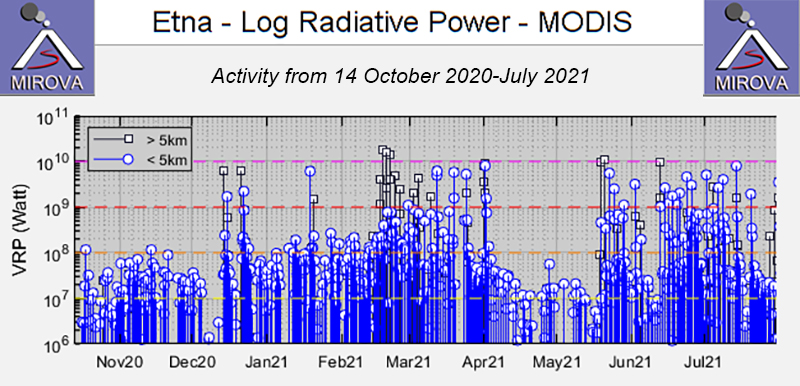 | Figure 340. Strong and frequent thermal anomalies at Etna were detected during April through July 2021, as reflected in the MIROVA data (Log Radiative Power). Briefly during April and mid-May, the intensity of the thermal anomalies markedly decreased before renewed lava flows resulted in significantly high anomalies. Courtesy of MIROVA. |
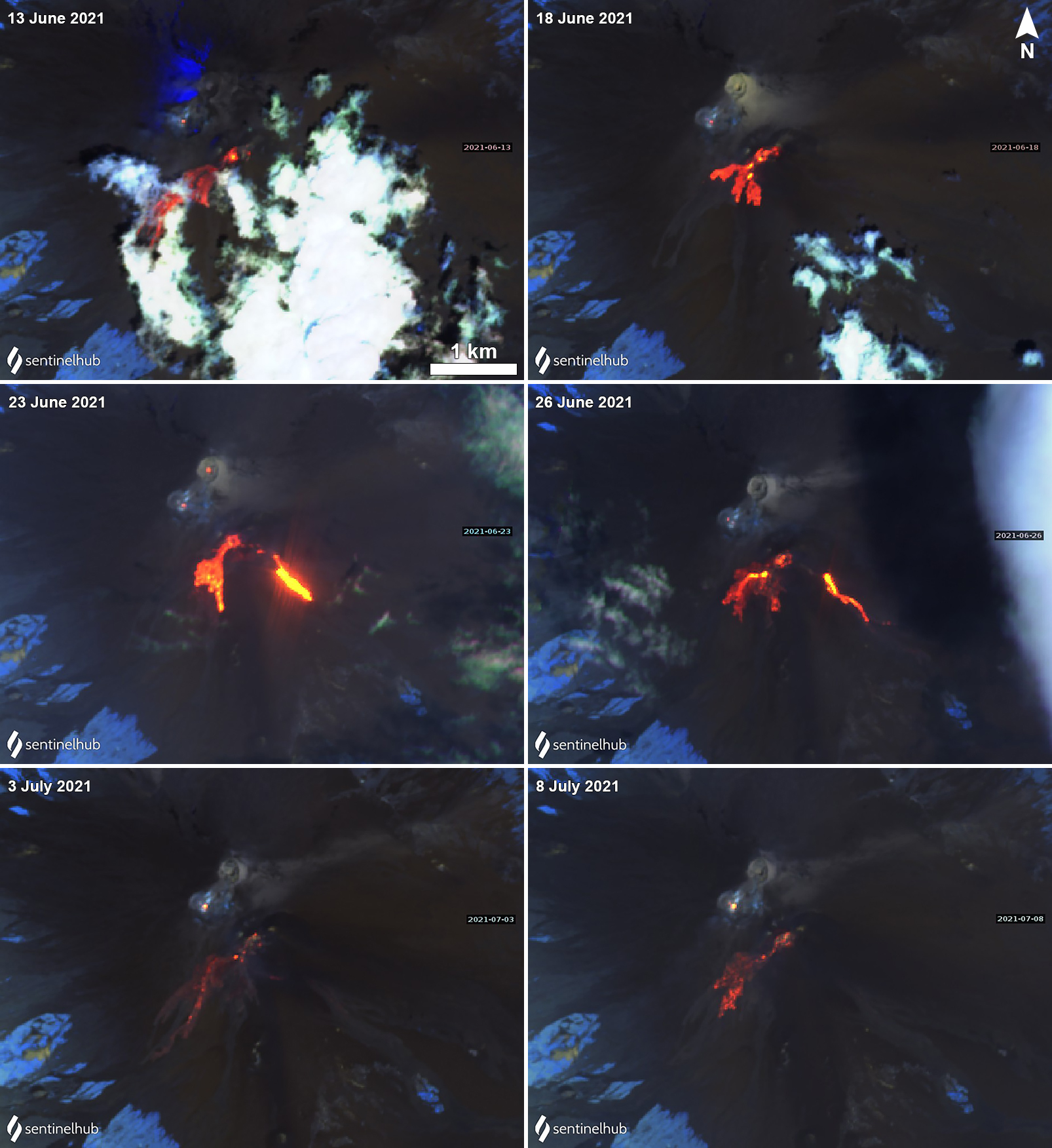 | Figure 341. Sentinel-2 infrared satellite imagery showing the strong lava flows mainly descending the SW and SE flanks of Etna during June-July 2021, frequently accompanied by white gas-and-steam emissions and thermal anomalies in the northern summit craters. The lava flows shown are all originating from the Southeast Crater (SEC). Lava descended the SW flank on 13 June (top left), 18 June (top right), 23 June (middle left), 26 June (middle right), 3 July (bottom left), and 8 July (bottom right) 2021, getting progressively cooler through July. Flows were visible on the SE flank on 23 June and 26 June. Images using "Atmospheric penetration" (bands 12, 11, 8A) rendering. Courtesy of Sentinel Hub Playground. |
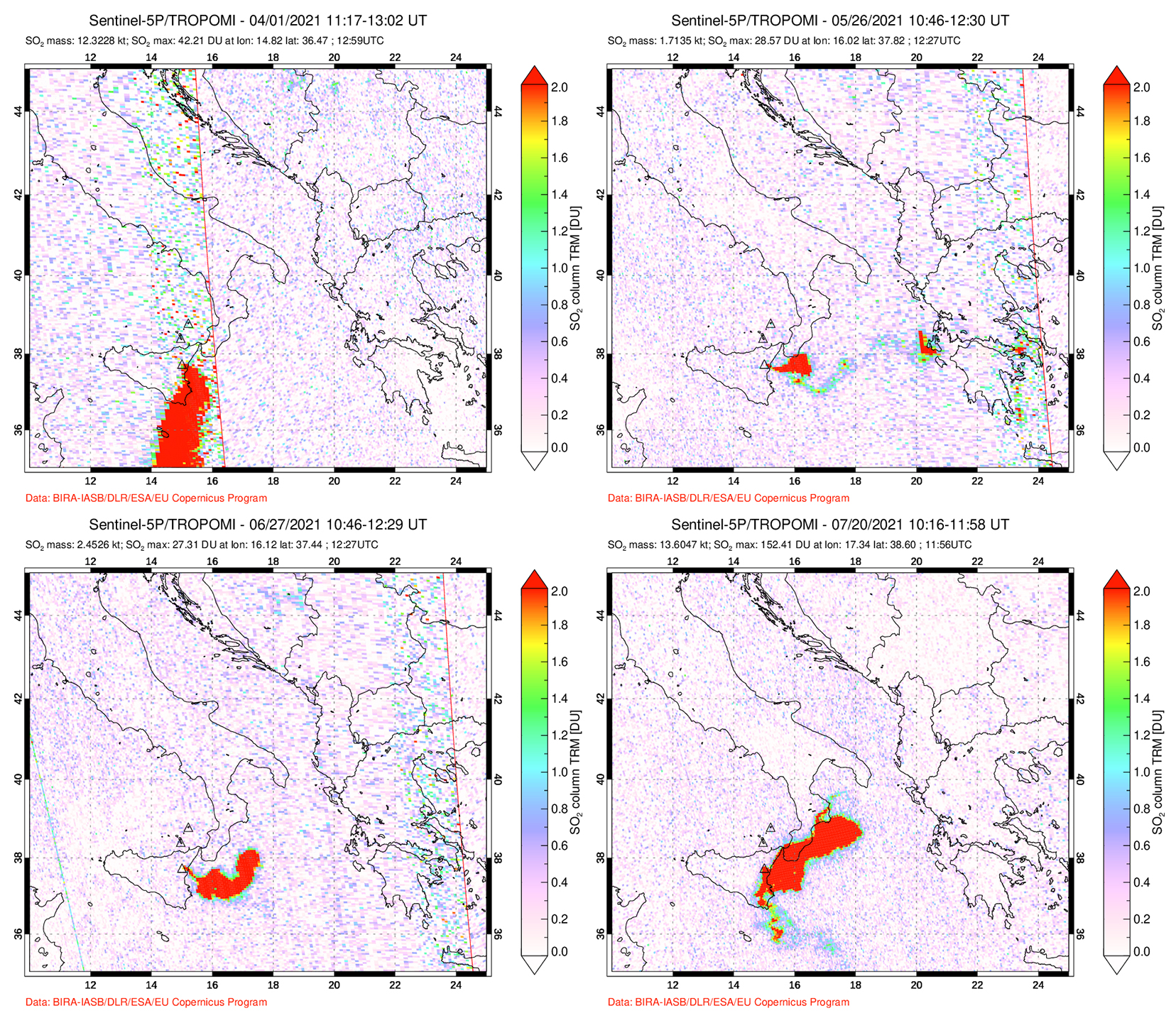 | Figure 342. Sulfur dioxide plumes exceeding 2 Dobson Units (DUs) from Etna were detected by the TROPOMI instrument on the Sentinel-5P satellite on 1 April drifting S (top left), 26 May drifting E (top right), 27 June drifting E (bottom left), and 20 July drifting NE and SE (bottom right) 2021. Courtesy of NASA Global Sulfur Dioxide Monitoring Page. |
Activity during April 2021. During April, INGV reported intra-crater Strombolian explosions in NEC, BN, and SEC. On 1 April around 0100 the SEC explosions transitioned into lava fountaining, generating an ash plume at 0940 that rose to 9 km altitude and drifted SSW. At 0200 a lava flow was reported in the eastern edge of SEC, moving toward the upper part of the VOR-BN complex (Valle del Bove) over the older flows that appeared during March 2021. By 1000 the fountaining had stopped, though explosions continued, producing ash plumes that rose to 5.5-9 km altitude and drifted S and SSW. As a result, ashfall was reported in Milia, Nicolosi, and Catania, and lapilli up to 1 cm was reported in Rifugio Sapienza. A second lava flow appeared at 1040, originating from the same eastern vent and migrating toward VOR-BN. Explosivity gradually declined around 1320 in SEC; by 2300 the lava flows had begun to cool and explosions were no longer observed in the summit crater. During the rest of the month volcanism was relatively low, though intra-crater Strombolian explosions continued in NEC and BN; degassing was prominent in SEC, VOR-BN, and NEC craters. Explosions would eject material tens of meters above the crater rim in NEC, accompanied by some ash emissions. At VOR-BN, an overflight on 13 April noted that activity was focused in the western vents, ejecting reddish ash emissions. An explosion in the eastern vent in SEC at 0030 on 25 April ejected incandescent material 350 m above the crater rim; an ash plume was visible drifting S.
Activity during May 2021. Activity during the first half of May remained similar to the previous month, with degassing at the summit craters and weak, intermittent Strombolian explosions occurring at the eastern vents in SEC, accompanied by ash emissions (figure 343). During the second week of May, INGV reported isolated ash emissions from NEC. On 19 May at 0221 the Strombolian activity in SEC intensified, accompanied by ash emissions, which evolved into lava fountaining by 0234 (figure 344). At the same time, a lava flow was observed traveling down the SW flank, reaching an elevation of 2.8 km. This event lasted three and a half hours, after which the fountains and explosions stopped abruptly. The lava flow was 1.8 km long, 1.5 m thick, and had a volume of 450,000 m3. On 22 May at 0134 Strombolian explosions continued in SEC, generating ash plumes that drifted SE. By 0302 the explosions evolved into lava fountains that ejected material to the NE. A second lava flow developed on the SW flank, overlapping the one from the 19th, advancing to 3 km elevation. It was 1 km long, 1.5 m thick, and had a volume of 150,000 m3. A third lava flow was observed on the E flank was 0.5 km long, 1.5 m thick, and a volume of 70,000 m3. At 0454 the lava fountain and explosive activity had stopped abruptly.
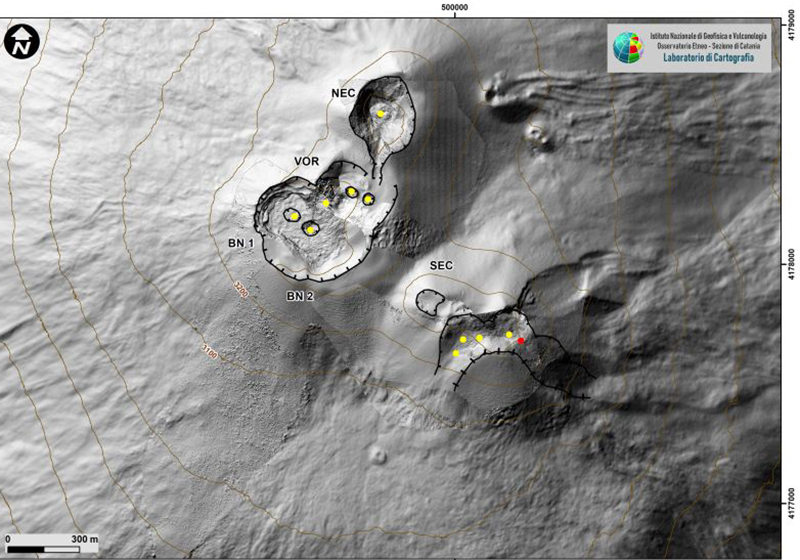 | Figure 343. Map of the summit craters at Etna showing the active vents during early May 2021. The base is modified from a 2014 DEM created by Laboratorio di Aerogeofisica-Sezione Roma 2. The hatch marks indicate the crater rims: BN = Bocca Nuova; VOR = Voragine; NEC = North East Crater; SEC = South East Crater. Red circles indicate areas with ash emissions and/or Strombolian activity. Yellow circles indicate steam and/or gas emissions only; degassing was the dominant activity at the summit craters during April through mid-May. A single vent in the eastern part of SEC was explosive. Courtesy of INGV (Report 19/2021, ETNA, Bollettino Settimanale, 03/05/2021 – 09/05/2021, data emissione 11/05/2021). |
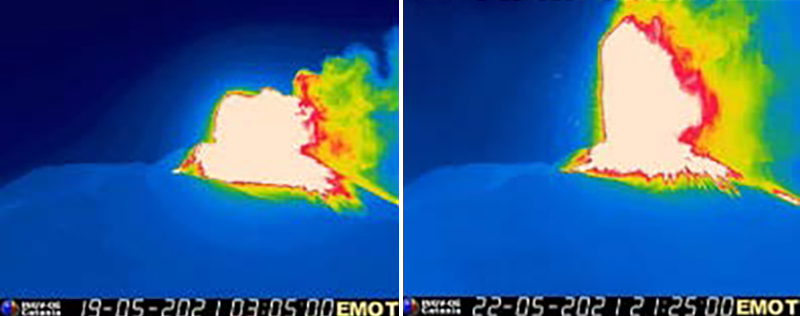 | Figure 344. Thermal images of the intense lava fountaining activity at Etna on 19 May (left) and 22 May (right) 2021 taken with the EMOT thermal camera. Courtesy of INGV (Report 21/2021, ETNA, Bollettino Settimanale, 17/05/2021 – 23/05/2021, data emissione 25/05/2021). |
On 24 May explosions were accompanied by a lava flow on the SW flank that descended to 900 m elevation, was 1.5 m thick, and had an erupted volume of 150,000 m3. The most intense phase of the explosions occurred during 2235 and 2345; activity ended around 0010. On 25 May an ash plume rose to 4 km altitude and drifted ENE at 1020; by 1820 explosive activity resumed. Two eruptive episodes on 26 May with peaks at 0350 and 1300 resulted in fine ashfall in Milo (10 km E). The next day, explosions intensified in SEC at 1450 while tephra fell in Giarre (17 km ESE), Milo, and Fornazzo (10 km ESE), though inclement weather prevents visual observations. On 28 May three explosive events were detected beginning at 0830, reaching a maximum intensity at 0900, and ending at 0930. As a result, ashfall was reported in Giarre. A second explosive episode occurred during 1740 and 1815 and a third, more intense explosive episode occurred during 2115-2350. On 30 May explosions beginning at 0545 lasted for two hours and resulted in fine ashfall in Petrulli (12 km SE).
Activity during June 2021. Variable Strombolian activity persisted during June, mainly in SEC; minor and diffuse ash emissions occurred at BN and ash emissions were reported on 4 June in NEC. Degassing was reported in BN and VOR. Weak Strombolian activity in SEC began at 0850 on 2 June, producing minor and diffuse ash plumes, which intensified around 1000 and transitioned to lava fountains that lasted more than two hours (figure 345). The lava fountains generated ash plumes that rose to 5-6 km altitude and drifted E, resulting in ashfall N of Zafferana, near Petrulli and Santa Venerina (figure 345). A lava flow was observed on the S flank of SEC that traveled SW. Fountains stopped at 1245. During the night and early morning of 3-4 June weak intra-crater explosions continued. On 4 June activity increased at 1530 and was characterized by discontinuous ash emissions and a lava flow descending the S flank of SEC. Lava fountains began at 1820 and generated an ash plume that rose to 6.5 km altitude and drifted SE. Ejecta was deposited in Aci Castello, Aciterzza, San Giovanni, La Punta, Tremestieri, Catania, Viagrande, and between Pedara, Fleri, and Siracusa. By 1930 the fountaining had stopped; webcam images showed that by 2300 the lava flow remained active at an elevation of 2.8 km and was a thickness of 2 m.
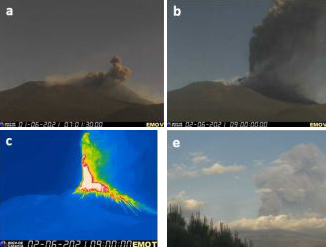 | Figure 345. Webcam and thermal images of the dense ash plumes rising from SEC summit crater at Etna on 1 June (top left), 2 June (top right and bottom left), and 4 June (bottom right) 2021 taken with the EMOV webcam and EMOT thermal camera. Courtesy of INGV (Report 23/2021, ETNA, Bollettino Settimanale, 31/05/2021 – 06/06/2021, data emissione 08/06/2021). |
On 9 June at 0110 intra-crater Strombolian activity was reported in the saddle cone, accompanied by discontinuous ash emissions, which continued through 11 June. Coarse material was ejected tens of meters from the edge of SEC, falling back into the crater. The lava flow descending the SW flank on 12 June reached an elevation of 2.7 km and was 1.7 km long, 1.5 m thick, and had a volume of 700,000 m3. At 2130 explosions transitioned into lava fountains that rose 400-500 m above the crater and produced an ash plume that rose to 5.5 km altitude and drifted SSE. Ashfall was reported in Sapienza, Refuge, Nicolosi, Tremestieri, Belpasso, and Catania. The fountains ended at 2350, alongside a cooling flow on the SW flank, though Strombolian explosions continued in SEC.
Several lava fountaining episodes were reported during 1332-1450 on 16 June, 2220 on 18 June to 0210 on 19 June, 2040-2215 on 19 June, 1131 on 20 June to 0214 on 21 June, overnight during 21-22 June, and during the early hours of 22 and 23 June. Each episode began with Strombolian explosions, followed by fountaining and crater overflows descending the SW and SE flanks toward the Valle del Bove (S) on 16 June while those on 21 June traveled 1 km SW toward Monte Frumento Supino, stopping at 2.9 km elevation (figure 341). Ash plumes rose as high as 8 km altitude, causing ashfall the S and SSE. INGV reported nine lava fountain episodes at SEC occurred during 21-27 June; explosive activity was concentrated in the W part of SEC at three of the four saddle vents, though some weak, isolated explosions were detected in the E vents (figure 346). The episodes generated ash plumes rising 5-10 km altitude while lava flows descended the SW and SE flanks (figure 346). An effusive vent was detected on the SE flank of SEC on 23 June. The lava fountaining events have caused SEC cone to grow significantly.
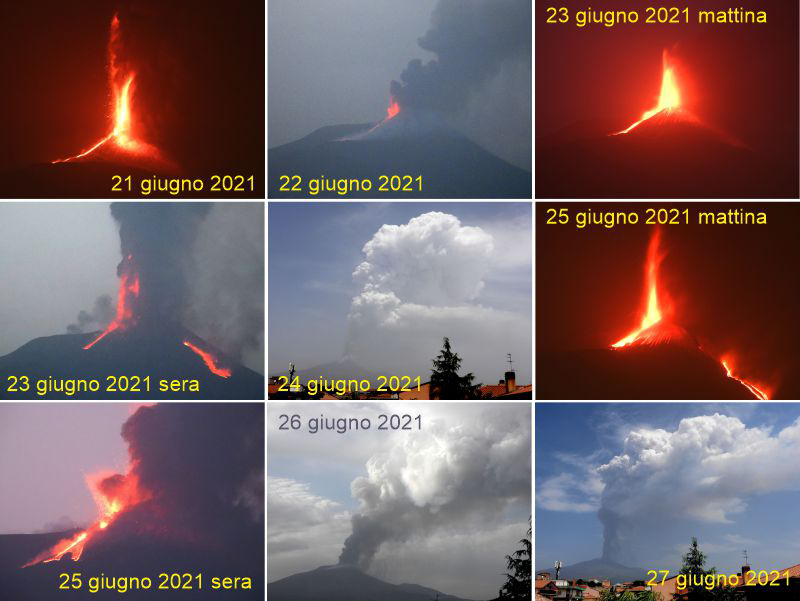 | Figure 346. Webcam images of the incandescent lava fountains and gray ash plumes rising from Etna during 21-27 June 2021. Lava flows could be seen on the flanks of the volcano on 21 June (top left), 23 June (top right and middle left), and 25 June (middle right and bottom left) 2021. All photos were taken by Tremestieri on the S flank 20 km from SEC. Courtesy of INGV (Report 26/2021, ETNA, Bollettino Settimanale, 21/06/2021 – 27/06/2021, data emissione 29/06/2021). |
Activity during July 2021. Strombolian activity, lava fountains, and ash plumes from SEC continued in July, in addition to occasional gas-and-ash emissions in NEC and BN. Three episodes of lava fountains generated ash plumes that rose 5-10 km altitude, resulting in ashfall to the E and SE. The first episode occurred at SEC at 0040 on 2 July, beginning with Strombolian explosions. Resulting ash plumes drifted ESE and within an hour, lava fountains were visible, accompanied by lava flows moving SW; fountaining had stopped at 0250. The second episode began at 1656 on 4 July, producing fountains at 1725 and ash plumes, ending by 1900 (figure 347). Lava flows traveled SW and ENE while the ash plumes drifted ESE. The last episode occurred at 2330 on 6 July; ash plumes rose to 5 km altitude and drifted SE; ash deposits were observed on the S flank. Explosions intensified at 0000 on 7 July with fountaining occurring thirty minutes later, rising as high as 1 km. A small lava flow originated from the S side of the cone and traveled SW, reaching an elevation of 2.8 km.
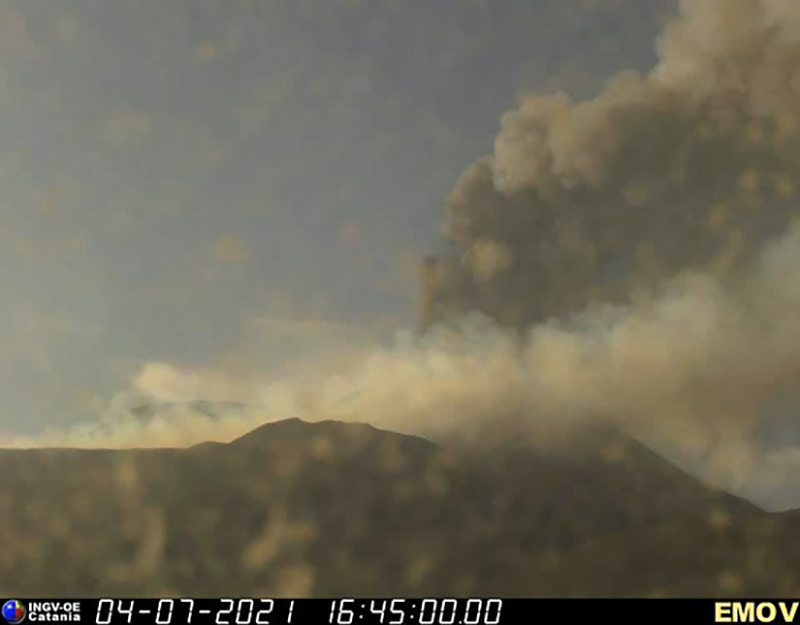 | Figure 347. Webcam image of an ash plume from Etna on 4 July 2021 taken from the EMOV (Montagnola) camera. Courtesy of INGV (Report 30/2021, ETNA, Bollettino Settimanale, 19/07/2021 – 25/07/2021, data emissione 27/07/2021). |
During fieldwork on 7 July scientists observed bombs up to 1 m in diameter on the N side of Mount Barbagallo, while smaller bombs were observed farther away. Lapilli was reported in the S part of Tremestieri, and ash was deposited in Nicolosi, as well as other communities downwind. This episode lasted about two hours. A second episode that began at 2100 on 8 July consisted of Strombolian activity and lava fountains. Ash plumes rose to 3.4 km altitude and drifted SE, resulting in ashfall and the front of the lava flow reached 2.4 km elevation. On 14 July explosions generated an ash plume that rose to 9 km altitude and drifted NE, which resulted in 1-cm-thick lapilli and ash deposits in the Rocca Campana district, as well as in the Rifugio, Citelli, and Presa, with ashfall in Taormina and the S part of Calabria. Another lava flow on the S flank of SEC was moving SW and had begun to cool by 15 July.
On 20 July at 0150 explosions in SEC generated ash emissions that drifted SSE; at 0650 the intensity of these explosions increased and eventually evolved into lava fountains at 0920. At the same time, a lava flow along the side of the SW flank of SEC was reported, as well as deposits of material on the S and E flanks of the volcano. Two lava flows moving SW were detected on the N flank of SEC, stopping at an elevation of 2.9 km. An ash plume drifted E and resulted in ashfall on the E flank and in Zafferana, Milo, and Fornazzo. On 26 July INGV reported continuous ash emissions at NEC that rose to 6 km altitude and drifted N. Strombolian activity intensified again at 0925 on 28 July in SEC, generating discontinuous ash emissions (figure 348); this episode stopped by 2318. Explosions in SEC began again at 1915 on 31 July, producing ash plumes that rose to 5 km altitude and drifted SE, resulting in ashfall in Fornazzo and Milo. At 2115 a lava flow down the SW flank reached 2.8 km elevation.
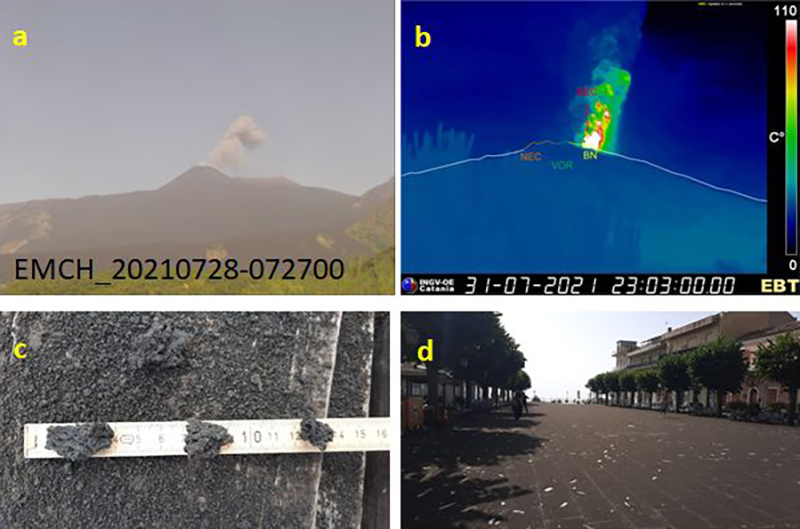 | Figure 348. Webcam images of the Strombolian explosions in the SEC on 28 July 2021 (top left) and the lava fountain activity on 31 July (top right) taken from surveillance cameras in Monte Cagliato and Bronte. Ashfall was observed in Fornazzo (bottom left) and Milo (bottom right). Courtesy of INGV (Report 31/2021, ETNA, Bollettino Settimanale, 26/07/2021 – 01/08/2021, data emissione 03/08/2021). |
Information Contacts: Sezione di Catania - Osservatorio Etneo, Istituto Nazionale di Geofisica e Vulcanologia (INGV), Sezione di Catania, Piazza Roma 2, 95123 Catania, Italy (URL: http://www.ct.ingv.it/it/ ); MIROVA (Middle InfraRed Observation of Volcanic Activity), a collaborative project between the Universities of Turin and Florence (Italy) supported by the Centre for Volcanic Risk of the Italian Civil Protection Department (URL: http://www.mirovaweb.it/); Hawai'i Institute of Geophysics and Planetology (HIGP) - MODVOLC Thermal Alerts System, School of Ocean and Earth Science and Technology (SOEST), Univ. of Hawai'i, 2525 Correa Road, Honolulu, HI 96822, USA (URL: http://modis.higp.hawaii.edu/); NASA Global Sulfur Dioxide Monitoring Page, Atmospheric Chemistry and Dynamics Laboratory, NASA Goddard Space Flight Center (NASA/GSFC), 8800 Greenbelt Road, Goddard, Maryland, USA (URL: https://so2.gsfc.nasa.gov/); Sentinel Hub Playground (URL: https://www.sentinel-hub.com/explore/sentinel-playground).
A Cone Shaped Growth on Back of Hand
Source: https://volcano.si.edu/volcano.cfm?vn=211060